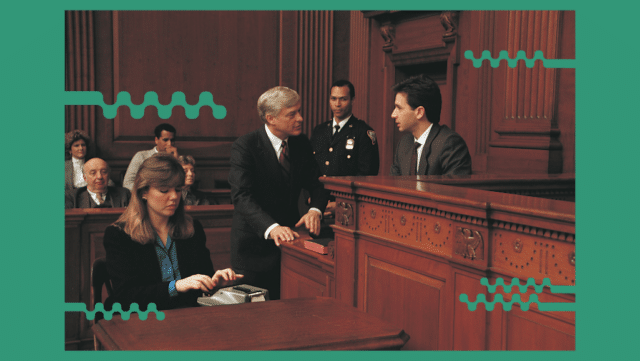From Analysis to Presentation: The Researcher’s Guide to Adding Subtitles for Enhanced Accessibility
In the realm of research, the journey from initial analysis to the final presentation is not just about uncovering new insights; it’s also about effectively communicating those insights to a diverse audience. This is where the power of subtitles comes into play, transforming the accessibility and reach of your presentations. In this comprehensive guide, we will navigate through the significance of subtitles in research presentations, the benefits they offer in terms of accessibility and comprehension, and how Amberscript’s subtitling services can elevate your research to new heights.
Table of Contents
- The Importance of Accessibility in Research
- Subtitles and Comprehension
- Tailored Solutions for Researchers
- The Subtitling Process: From Accuracy to Synchronization
- SEO-friendly Practices for Wider Reach
- The Amberscript Advantage
The Importance of Accessibility in Research
In the domain of academic and professional research, accessibility is not a luxury but a necessity. The true essence of research lies not only in discovering new insights but also in disseminating this knowledge universally. Imagine the scenario where groundbreaking research is presented, but it fails to reach or resonate with a significant portion of the potential audience due to accessibility barriers. This is where subtitles emerge as more than a feature; they serve as a fundamental channel for inclusivity.
Subtitles ensure that your research is not confined to a limited audience. They cater to individuals with hearing impairments, providing them with equal opportunities to engage with and benefit from your findings. Moreover, in our globalized world, your research might attract an international audience. Subtitles in multiple languages break down linguistic barriers, making your work universally understandable and approachable. They also facilitate comprehension in noise-sensitive environments like libraries or public transport, ensuring that your message is not lost amidst the silence.
Subtitles and Comprehension
Subtitles play a pivotal role in reinforcing the viewer’s understanding and retention of information. This is especially crucial in research presentations where the subject matter often involves complex concepts, specialized terminology, or critical data. The visual reinforcement of spoken words through subtitles aids in better absorption and comprehension of the content. It allows viewers to follow along at their own pace, revisiting and processing intricate parts of the presentation that might otherwise be missed or misunderstood.
Furthermore, subtitles can significantly enhance the educational value of your content. They cater to diverse learning styles, particularly benefiting visual learners who grasp information more effectively through reading. Subtitles also support cognitive processing by providing a written context, which helps in better understanding and remembering the information presented.

How to choose your subtitling service for precisely accurate subtitles
Read NowTailored Solutions for Researchers
Recognizing the unique challenges and requirements of the research community, Amberscript and its sub-brands offer bespoke subtitling solutions. Our approach is not a one-size-fits-all but a tailored service that respects the specificity and complexity of your research field. Whether it’s the accurate representation of technical jargon, the meticulous adherence to disciplinary terminology, or the understanding of nuanced content, our subtitling services are designed to meet these precise needs.
Our team of experts is not just proficient in language skills; they possess specialized knowledge in various research domains, ensuring that your content is not just accurately translated but also contextually adapted. This domain-specific expertise ensures that the subtleties and intricacies of your research are preserved and correctly conveyed in the subtitles, maintaining the integrity and credibility of your work.
The Subtitling Process: From Accuracy to Synchronization
The process of subtitling is an art and science that goes beyond mere transcription of audio to text. It involves a deep understanding of the content, precise timing, and synchronization to ensure that the text matches the spoken words not just in meaning but also in pacing and emotion. This synchronization is crucial, especially in research presentations, where the conveyance of data and findings must be precise and timely.
Amberscript’s subtitling process is meticulous and detailed-oriented. We focus on creating subtitles that are not only linguistically accurate but also contextually synchronized with the visual and auditory elements of your presentation. This attention to detail ensures that the subtitles are a seamless, integral part of the viewing experience, enhancing the professionalism and credibility of your research presentation.

SEO-friendly Practices for Wider Reach
In today’s digital age, the visibility of your research can significantly benefit from SEO-friendly practices. Integrating high-volume, relevant keywords into your subtitles can greatly enhance the online discoverability of your presentations. This strategy not only makes your content more accessible but also increases its potential to be cited and referenced within academic and professional communities.
SEO-friendly subtitles can serve as a powerful tool in amplifying the reach and impact of your research. By ensuring that your presentations are easily findable on search engines and academic databases, you are essentially widening the gateway for your research to be accessed, shared, and utilized by a global audience. This not only furthers the reach of your work but also fosters an environment of collaborative knowledge and shared growth.
Each of these aspects underscores the transformative potential of subtitles in making research presentations more accessible, comprehensible, and impactful. By adopting a meticulous approach to subtitling, Amberscript ensures that your work is not just seen and heard but fully understood and appreciated by a global audience.
The Amberscript Advantage
Choosing Amberscript for your subtitling needs means partnering with a service that understands the pulse of the research community. Our experts are not just linguists; they are trained professionals in various fields, ensuring that your subtitles are not just translations, but also interpretations of your work. With Amberscript, you get the assurance of accuracy, the advantage of expertise, and the promise of reaching a global audience.
Why you should use Amberscript
5x average time saving by using AI for Automatic Transcription.
Enabling an accurate flow of audio-to-data, adjustable in our easy to use online text editor. Or 100% accuracy with Human-Made Transcription.
GDPR compliant security and safety.
Embark on your journey from analysis to presentation with the confidence that your research will reach and resonate with everyone. Explore Amberscript’s subtitling services and take the first step towards creating presentations that are not just informative but also inclusive and impactful. Let’s break the sound barriers and make your research universally accessible. Start now and witness your work’s influence grow exponentially.
In conclusion, adding subtitles to your research presentations is not just an add-on; it’s a necessary step towards inclusivity, comprehension, and impact. With Amberscript’s specialized subtitling services, your journey from analysis to presentation is not just about sharing knowledge; it’s about creating a dialogue that transcends linguistic and sensory barriers. Let’s make your research not just seen and heard, but understood and remembered.
The Future of Call Centers: How AI and Transcriptions Are Transforming Customer Interactions
The traditional model of call centers, defined by rows of agents tied to their desks via headsets, is undergoing a significant transformation. Emerging trends, such as Artificial Intelligence (AI) and transcriptions services, are taking centerstage, heralding a new era in customer interactions. AI, with its ability to learn, interpret, and respond, combined with transcription services that convert spoken language into written text, are not just enhancing the efficiency of call centers but also reshaping their very operational structure.
This post delves into the exciting journey of how AI and transcription are revolutionizing the call center industry, creating a customer experience that is seamless, personalized, and above all, highly efficient.
Table of Contents
- The Evolving Landscape of Call Centers
- The Role of AI in Modernizing Customer Interactions
- The Impact of Transcription Services on Call Centers
- The Synergy of AI and Transcriptions in Call Centers
- Challenges and Considerations
- Preparing for the Future
- The Transformative Potential and Future Trajectory
The Evolving Landscape of Call Centers
Call centers have undergone a profound evolution since their inception in the 1960s, when businesses began to centralize customer service operations. In the 1980s, technological advances such as automated call distribution systems and Interactive Voice Response (IVR) systems, allowed call centers to handle large volumes of calls efficiently. Over time, the advent of the internet and digital communication channels widened the scope of call centers, transforming them into contact centers that can engage with customers via:
- email,
- chat,
- social media, and more.
Despite these advancements, traditional call centers today face several challenges.
- One of the most significant is dealing with a high volume of calls. Inefficiencies in handling large call volumes can lead to long wait times, causing customer dissatisfaction and potentially lost business.
- Additionally, the need for multi-language support has become increasingly critical in our globalized world. Call centers service customers across different geographical regions, and the ability to communicate in the customers’ native language is essential for providing excellent customer service.
- Another challenge is the demand for 24/7 service. In a digital age where businesses operate round the clock, customers expect immediate responses and resolutions to their issues, regardless of the time of day. This requires call centers to be staffed and operational all the time, leading to increased operational costs and logistical issues. With these challenges, the need for innovative solutions is clear, and that’s where AI and transcription services come into play.
The Role of AI in Modernizing Customer Interactions

AI is playing a crucial role in transforming customer service interactions. With the integration of AI technology, call centers are evolving into intelligent contact centers, capable of providing personalized and efficient service.
- Artificial Intelligence has been a game-changer in customer service, with its ability to seamlessly integrate with existing systems and manage a multitude of tasks. It can effortlessly handle a high volume of inquiries, freeing human agents to focus on more complex issues.
- Chatbots and virtual assistants are at the forefront of AI-powered customer service, providing instant responses to customer queries, and offering assistance round the clock. They can carry out routine tasks, guide customers through processes, and even troubleshoot basic issues.
AI also enables predictive analytics, whereby customer data is analyzed to gain insights into customer behavior and preferences. This information can be used to customize interactions and provide personalized service, enhancing customer satisfaction.
Benefits of Integrating AI in Call Centers
The integration of AI in call centers offers multiple benefits.
- It significantly increases efficiency and reduces wait times, as AI-powered systems can process requests faster than human agents.
- It offers the ability to provide personalized interactions enhances customer satisfaction.
- From a business perspective, AI allows for cost savings, as it reduces the need for a large workforce.
- AI systems can be easily scaled up or down based on demand, providing a high level of flexibility.

Let us help you transcribe!
Start Now!The Impact of Transcription Services on Call Centers
Transcription services, much like AI, are carving a pivotal role in the modernization of call centers. Transcription, in its simplest form, is the process of converting spoken language into written text. For call centers, this means recording and transcribing all customer interactions – a crucial step toward enhancing customer service.
Transcription services in call centers work in two main ways:
- real-time transcription;
- post-call transcription analysis.
Real-time Transcription
Real-time transcription is a game changer for call center agents. It allows them to focus on the customer’s issues rather than splitting their attention between listening and note-taking. This increased focus invariably leads to improved accuracy in customer communication, resulting in a better overall customer experience.
Post-call Transcription Analysis
Post-call transcription analysis, on the other hand, involves transcribing the call after it has ended. This data becomes a rich resource for analytics and training purposes, as it provides insights into the customers’ needs, preferences, and pain points.
Incorporating transcription services into call center operations offers numerous benefits.
- It improves the accuracy of customer communication, provides valuable data for analysis and training, and aids in compliance and record-keeping.
- By creating a written record of each interaction, businesses can ensure that they meet regulatory requirements and maintain high standards of service.
- The insights gleaned from analyzing these transcriptions can be invaluable in driving improvements in customer service and operational efficiency.
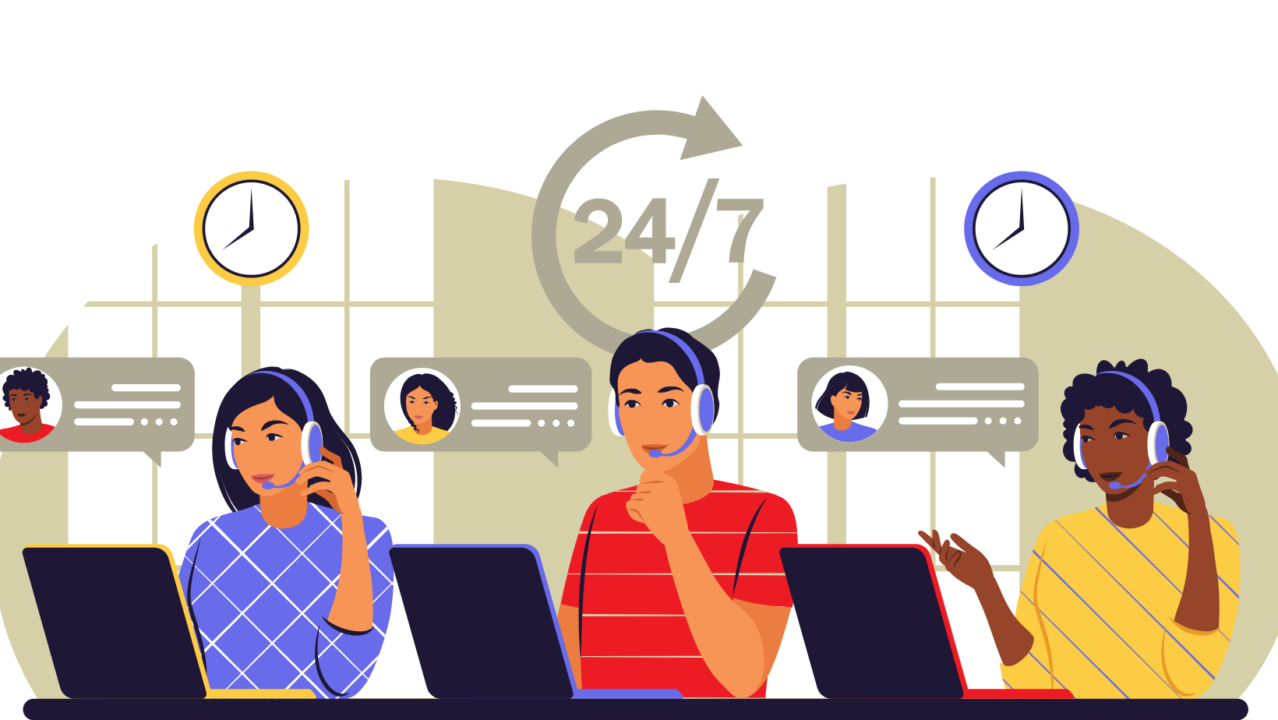
The Synergy of AI and Transcriptions in Call Centers
AI and transcription services, when combined, bring about a significant transformation in call center operations. They complement each other to create an effective, efficient, and customer-centric communication strategy.
Benefits of Incorporating Transcription Services
Artificial Intelligence can analyze the transcriptions of customer interactions, extracting key information, identifying trends, and providing actionable insights. This allows businesses to better understand their customers, enhance customer experience, and make informed decisions.
On the other hand, transcriptions provide the data that AI needs to “learn” and improve, creating an iterative process of continuous improvement.
Case Study: Success through Integration
For instance, a leading telecommunications company employed this strategy and witnessed significant improvements in their customer service. They used AI-powered transcription for all customer interactions, and then used these transcriptions for AI-driven analysis. This resulted in a 30% decrease in call handling time, a 25% increase in first call resolution, and greatly enhanced customer satisfaction scores.
Future Potential: Predictive Models and Real-time Insights
The potential for integrating AI and transcription services in call centers is vast. One particular area with immense potential is the development of predictive models. By analyzing transcriptions, AI can identify patterns and trends, enabling it to predict customer behavior and anticipate needs. This predictive capability allows businesses to proactively address customer issues, thereby providing superior customer service. Moreover, the combination of AI and transcription can provide real-time insights during a call, enabling agents to make instant decisions and provide immediate resolutions. This not only increases customer satisfaction, but also significantly reduces call handling time.
Overall, the synergy between AI and transcription services holds the potential to revolutionize the call center industry, leading to
- improved customer service,
- operational efficiency, and
- business growth.
Challenges and Considerations
AI and transcription services bring immense benefits to call centers. However, certain challenges and considerations need to be addressed for successful implementation.
Addressing Privacy and Data Security Concerns
In an age where data is a valuable commodity, privacy and data security cannot be ignored. Call centers must ensure that the transcription services and AI tools they employ adhere to stringent data security standards. This includes encrypting sensitive data, adopting secure data storage practices, and ensuring compliance with privacy laws.
Overcoming Technical Barriers and Ensuring Reliability
Technical hurdles, such as inaccurate transcriptions and AI biases, need to be overcome for the technology to be effective and reliable. Ensuring the quality of transcriptions and the accuracy of AI predictions is of utmost importance to maintain the trust and satisfaction of customers.
Training and Adaptation for Staff
Introducing new technology in the workplace always comes with a learning curve. Staff must be adequately trained and supported throughout the implementation process to ensure successful adoption. This not only involves understanding how to use the technology but also adapting to the changes it brings in workflow and communication dynamics.
Preparing for the Future

As AI and transcription services continue to evolve, call centers need to stay ahead of the curve to remain competitive. They should develop a strategic blueprint for the integration of AI and transcription services. This strategy should involve:
- careful planning,
- phased implementation,
- regular assessment of effectiveness, and
- necessary revisions based on feedback and outcomes.
Incorporating technology should never come at the expense of losing the human touch. Call centers should strive to use AI and transcription services to enhance their customer-centric approach rather than replace it. The aim should be to use technology to understand and serve customers better.
In a constantly evolving industry, innovation and continuous improvement are key to staying competitive. Call centers should foster a culture of learning and innovation, always looking for ways to improve their services and provide value to their customers. By doing so, they will not only survive in the competitive landscape but thrive.
The Transformative Potential and Future Trajectory
The fusion of AI and transcription services offers unprecedented opportunities to transform call center operations. This powerful duo enhances the ability to understand and serve customers by providing real-time insights, enabling predictive customer service models, and driving operational efficiency. Several case studies have already demonstrated the success of this strategy, with significant improvements in key performance indicators such as call handling time, first call resolution, and customer satisfaction scores.
However, the journey doesn’t end here. The rapidly evolving field of AI promises even more revolutionary changes in the future trajectory of customer service interactions. With advancements such as real-time personalization, emotional intelligence, and voice biometrics on the horizon, the future of call centers looks increasingly exciting.
As we look ahead, it is imperative that call centers embrace AI and transcription technologies to remain relevant and efficient in this competitive landscape. By overcoming the challenges, addressing the considerations, and staying customer-centric, call centers can harness the full potential of these technologies and pave the way for a new era of customer service excellence. So take this opportunity, join the technology-driven revolution, and set your call center on the path to unprecedented success.
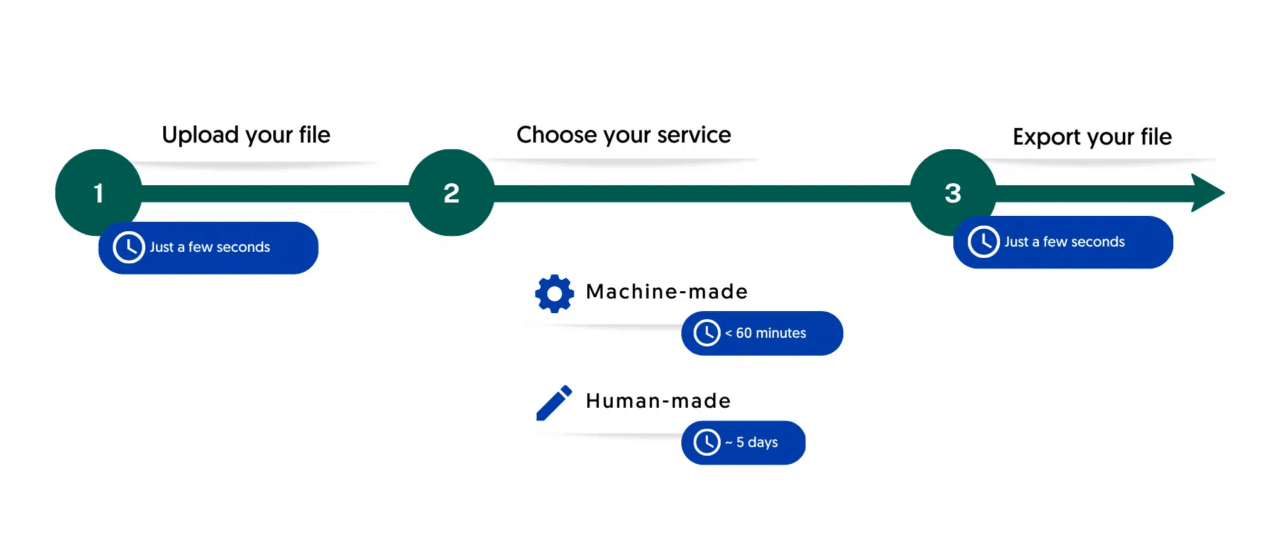
Streamlining Follow-Up: Integrating Transcriptions into Effective Customer Communication
Amberscript‘s transcription services offer a transformative solution in streamlining follow-up procedures which are paramount for effective customer communication, particularly within call center operations. The conversion of spoken language into a detailed written record allows for an accurate, thorough documentation of customer interactions. This practice is a key component in achieving compliance and upholding high service standards. By ensuring every customer interaction detail is captured, transcription services provide an invaluable resource for future reference, facilitates adherence to guidelines, mandates, and can be conveniently reviewed and audited. This integration of transcriptions into customer communication processes enables businesses to refine their operations, augment customer satisfaction, and maintain compliance with regulatory requirements.
Table of content
- Understanding the Role of Transcriptions in Customer Communication
- The Impact of Transcriptions on Customer Follow-Up
- Transcriptions in Different Industries
- Amberscript’s Tailored Transcription Solutions
- Integrating Transcriptions into Business Processes
- Case Studies and Success Stories
- To Wrap It Up
Understanding the Role of Transcriptions in Customer Communication
Transcription services play an essential role in customer communication, especially in the age of digital transformation. With a history of substantial evolution, transcription has shifted from being a mere accessory to a necessary and potent tool in various industries, with special emphasis on customer service and support. Modern transcription services can be segmented into three primary types: Verbatim, Edited, and Intelligent transcriptions.
- Verbatim transcription captures every utterance, stutters, filler words, and even non-verbal cues, providing an exact textual representation of the audio.
- Edited transcriptions, on the contrary, prioritize readability by omitting irrelevant information and filler words.
- Intelligent transcriptions, the most advanced of the three, concentrate on capturing the essence of the conversation.
They focus on the context, and often include advanced features such as speaker identification and time-stamping. The integration of these innovative digital tools has revolutionized customer communication. Transcriptions offer a systematic, accurate way of documenting and analyzing customer interactions, driving business excellence and providing a foundation for strategic decision-making.

The Impact of Transcriptions on Customer Follow-Up
Transcriptions have proven instrumental in facilitating effective customer follow-ups, as evidenced by numerous case studies. By providing a detailed, accurate account of customer interactions, transcriptions offer a comprehensive understanding of customer queries, complaints, feedback, and more – all of which are critical for effective follow-up communications. For instance, a case study on a major telecom company showed that the introduction of transcription services led to a significant improvement in resolving customer complaints in the first interaction. This was largely due to the ability to review the transcribed interactions, gaining invaluable insights, and understanding the core issues at hand.
In the sphere of record-keeping, transcriptions serve an invaluable role. Every detail of the customer interaction is preserved verbatim, ensuring nothing is lost in translation. This not only aids in internal communication and training but also proves useful in legal cases, where adherence to compliance and maintaining a high degree of accuracy is paramount. Transcriptions also drastically improve the process of information sharing among team members, reducing the risk of misunderstandings and fostering a unified approach to problem-solving.
A further benefit transcriptions bring to customer follow-ups is the advantage of time-efficiency. With a written record of interactions, customer support representatives can swiftly refer to specifics, eliminating the need to listen to long audios multiple times. This allows them to respond to customer concerns more promptly and efficiently, thereby improving the overall customer experience.
Transcription services hence stand as a testament to digital innovation, transforming customer service dynamics. They are powerful tools that enhance communication efficacy, optimize customer satisfaction, and ensure legal compliance, offering a transformative solution to businesses seeking to refine their customer follow-up procedures.

Let us help you transcribe
Start Now!Transcriptions in Different Industries
Transcriptions have found extensive applications across varied industries, contributing significantly to their growth and efficiency. In the media industry, they enhance audience engagement by providing accurate subtitles and scripts, ensuring a wider reach and inclusivity. As a result, the content becomes more accessible, catering to a broader demographic, including the hearing impaired community.
- In the healthcare sector, transcription services are pivotal for maintaining accurate medical records. This detailed documentation forms the backbone of effective patient care and successful treatment outcomes. It aids physicians in tracking patients’ medical histories, facilitating informed decision-making, and ensuring continuity of care.
- Journalism, an industry where factual accuracy and consistency of data are the lifeblood, heavily relies on transcriptions. They provide an authentic, verbatim record of interviews, press conferences and other source materials, which in turn guarantees precise reporting and upholds the journalistic standards of truth and accuracy.
- Call centers utilize transcriptions as a tool for quality control and training. By translating customer interactions into text, they can review and assess the performance of their representatives, pinpoint areas for improvement, and devise effective training programs. This leads to enhanced customer service and improved overall call center performance.
- The broadcasting industry employs transcriptions to streamline content creation and distribution. By transcribing shows, interviews, and news broadcasts, they ensure a smooth flow of information, simplify content repurposing, and make their content SEO-friendly.
In conclusion, transcriptions aren’t just a peripheral service. They are a catalyst boosting operational efficiency across various industries, enabling them to deliver higher quality services, maintain compliance, and achieve optimal performance.

Amberscript’s Tailored Transcription Solutions
- Amberscript’s tailored transcription services extend far beyond simple text conversion. It employs advanced speech-to-text technology, supplemented by human expertise for quality assurance. This blend of technology and human touch ensures the highest level of accuracy in transcriptions, even in cases involving multiple speakers, dialects or accents.
- Additionally, Amberscript offers a user-friendly interface, enabling customers to easily upload files, check the progress of transcriptions, and receive completed transcripts in a variety of formats to suit their needs.
- Furthermore, Amberscript is aware of the growing need for multilingual support in today’s globalized business environment. It thus provides transcription services in more than 30 languages, thereby assisting businesses in breaking language barriers and facilitating seamless communication.
- Finally, acknowledging the importance of budget constraints for many companies, Amberscript offers a flexible pricing structure. This ensures businesses of all sizes, from startups to large corporations, can benefit from its services.
Amberscript has positioned itself as a trusted partner for businesses, offering bespoke transcription solutions that are not only accurate, fast, and secure, but also user-friendly, multilingual, and cost-effective. It is this commitment to meeting and surpassing client expectations that sets Amberscript apart in the competitive transcription market.
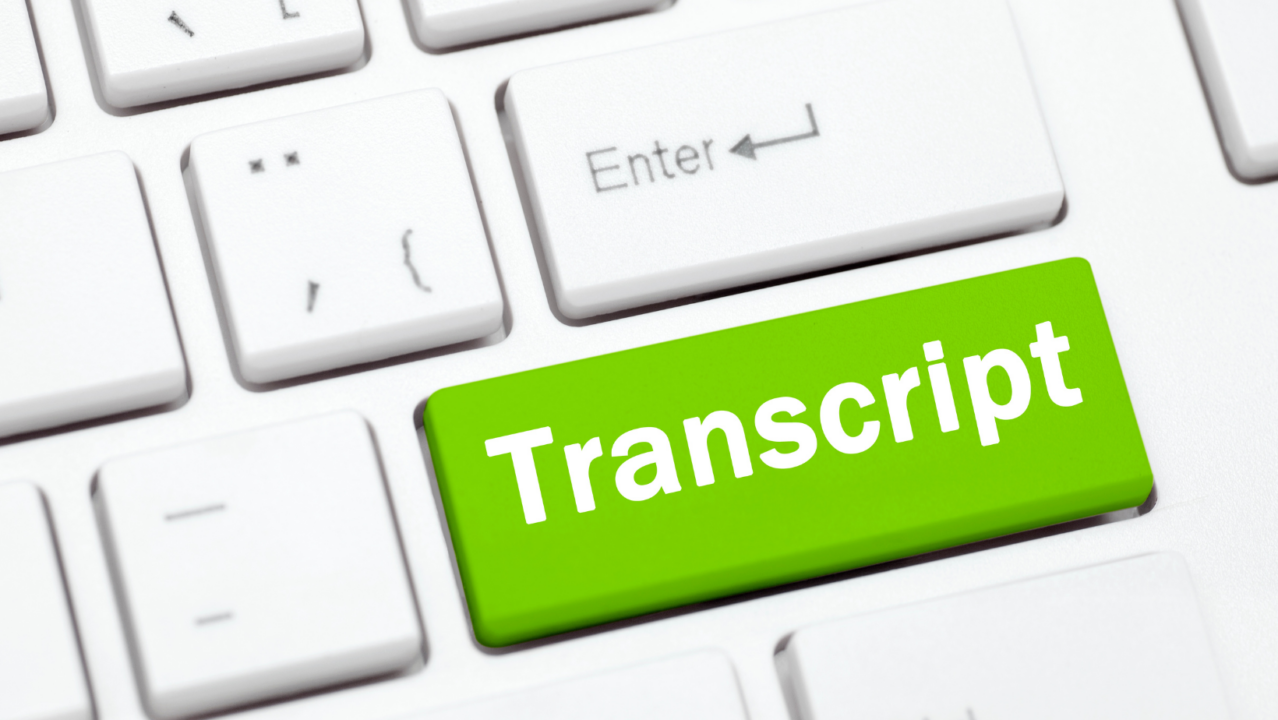
Integrating Transcriptions into Business Processes
Successful integration of transcription services into existing business workflows can lead to a revolutionization of your customer communication strategies.
- The initial step in this process involves pinpointing the touchpoints within your customer interaction process where transcription services can provide an added value. These touchpoints can include customer calls, webinars, interviews, or meetings.
- After these points are identified, Amberscript’s services can then be implemented to transcribe the respective interactions.
Tools such as CRM software and customer support platforms can be integrated with Amberscript’s services for a seamless transition. For example, transcriptions can be directly uploaded into CRM databases, making them easily accessible for review by customer service representatives.
To maximize the benefits of using transcription services, it is crucial to train your teams on how to effectively analyze and utilize the transcribed data. This could involve identifying:
- patterns and trends in the data,
- key points of feedback from customer interactions, that can then be used to tailor your offerings and improve customer satisfaction overall.
This makes transcription services an invaluable tool in your customer communication arsenal.
Case Studies and Success Stories

Real-world examples and success stories in the business realm provide tangible proof of the effectiveness of transcription services. Many businesses have successfully integrated these services into their operations, reaping substantial benefits.
For instance, a broadcasting company reported a significant increase in viewership after implementing accurate transcriptions for subtitles, thereby expanding its reach and accessibility. A healthcare provider noted improved patient care and streamlined workflow following the introduction of medical transcriptions.
Furthermore, interviews with industry professionals further underscore the value of transcription services. A customer service manager at a leading telecom company lauded the role of transcriptions in enhancing their training programs, stating that it allowed them to review and refine their customer interactions.
These testimonials and case studies attest to the transformative power of transcription services across a variety of industries, reinforcing Amberscript’s promise of delivering effective and efficient transcription solutions.
To Wrap It Up
Transcription services are a pivotal cornerstone in the architecture of customer communication across various industries, from healthcare and journalism to broadcasting and more. They enhance internal communication, optimize customer satisfaction, ensure legal compliance, and serve as a catalyst in boosting operational efficiency. As technology evolves, the future of transcription services appears more vibrant than ever, promising significant advancements that will further streamline business processes and customer interactions. With tailored solutions like those offered by Amberscript, businesses can harness the power of transcription to drive growth and success. Amberscript’s commitment to high accuracy, quick turnaround, and stringent confidentiality measures, make it an ideal partner for industries navigating the complex landscape of customer communication. We encourage you to explore Amberscript’s services and discover how our transcription solutions can revolutionize your business operations and customer communication strategies.
Our services are
5x average time saving by using AI.
Enabling an accurate flow of audio-to-data, adjustable in our easy to use online text editor.
GDPR compliant security and safety.
Best Practices for Transcribing Medical Dictations: Ensuring Accuracy and Patient Care
In healthcare, precision is paramount, and no one understands this better than medical transcriptionists. Their meticulous work ensures that medical records are accurate and complete, directly impacting patient care. In this comprehensive guide, we will delve into two critical chapters – “Practical Tips for Active Listening” and “Strategies for Attention to Detail,” revealing how they can elevate the quality of medical transcription.
Table of Contents
- The Significance of Active Listening
- The Role of Attention to Detail
- Practical Tips for Active Listening
- Strategies for Attention to Detail
- Precision and Compassion: The Essence of Medical Transcription
The Significance of Active Listening
Defining Active Listening in Medical Transcription
Active listening transcends mere hearing; it’s a skill that involves total immersion in the spoken word. In the realm of medical transcription, this skill is a linchpin.
How Active Listening Enhances Transcription Accuracy
This chapter unveils the profound impact of active listening on transcription precision. We’ll explore how active listening allows transcriptionists to capture the nuances, tone, and context in dictations, directly enhancing transcription accuracy.
The Impact on Patient Care
The ripple effect of transcription accuracy reaches the core of patient care. We will elucidate how transcription errors can lead to misunderstandings, misdiagnoses, and adverse events, reinforcing the indispensable role of active listening in ensuring optimal patient outcomes.
The Role of Attention to Detail
In the realm of medical transcription, attention to detail is not merely a desirable trait; it is the bedrock upon which transcription accuracy is built. Transcribing medical dictations requires a meticulous eye for detail, as even the smallest oversight can lead to significant errors in patient records and subsequent care. In this chapter, we will explore the multifaceted nature of attention to detail in medical transcription and provide a deeper understanding of its critical role.
Attention to Detail in Medical Transcription
Attention to detail encompasses a spectrum of skills and practices that transcriptionists must cultivate to excel in their role:
- Precision in Spelling and Grammar: Correct spelling and proper grammar are non-negotiable. Transcriptionists must be vigilant in ensuring that every word and punctuation mark is accurately transcribed.
- Formatting Consistency: Consistency in formatting is essential for clarity and readability. Transcriptionists must pay close attention to headings, bullet points, and other formatting elements.
- Numeric Accuracy: Numbers are a frequent component of medical dictations, including dosages, lab results, and patient statistics. A small mistake in a numeric entry can have dire consequences.
- Medical Terminology: Mastery of medical terminology is fundamental. Attention to detail includes correctly deciphering and transcribing complex medical terms and abbreviations.
- Contextual Understanding: It’s not enough to transcribe words; transcriptionists must understand the context in which those words are used. This entails grasping the medical condition, treatment, or procedure being discussed.

Precision in Practice: How Medical Transcription Enhances Clinical Notes
Learn moreExamples of Errors Due to Inattention
To underscore the critical nature of attention to detail, let’s explore some real-life examples of transcription errors that occurred due to inattention:
- Medication Dosage Errors: Inaccurate transcription of medication dosages can lead to under or overdosing, potentially endangering a patient’s health.
- Patient Allergies Omitted: Overlooking a patient’s allergies in a transcription can result in prescriptions for medications that can trigger adverse reactions.
- Missing Critical Information: Failure to transcribe essential details, such as a patient’s medical history or pre-existing conditions, can hinder proper diagnosis and treatment planning.
- Incorrect Lab Values: Misinterpretation or mis-transcription of lab results can lead to incorrect diagnoses and treatment decisions.
- Confusion in Procedures: Transcribing the wrong surgical procedure or medical treatment can lead to the execution of the wrong treatment plan.
These examples highlight the real-world implications of inattention to detail in medical transcription. Errors can compromise patient safety, impact treatment outcomes, and even lead to legal ramifications for healthcare providers.
In the high-stakes environment of healthcare, transcriptionists serve as the crucial bridge between spoken medical information and accurate patient records. Attention to detail is the linchpin that ensures this information is faithfully and meticulously transcribed, contributing to the overall quality of care provided to patients. In the next chapter, we will delve into practical strategies and techniques for honing this vital skill.
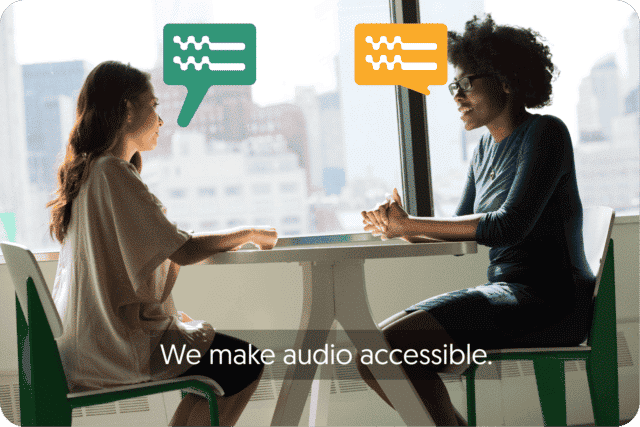
Request a quote for medical transcription
Practical Tips for Active Listening
Creating the Optimal Listening Environment
- Importance of Noise-Free Space: A noise-free environment is non-negotiable. We’ll delve into how to set up a workspace that minimizes auditory distractions.
- Ergonomics and Comfort for Long Transcription Sessions: Prolonged sessions demand ergonomic comfort. We’ll discuss the right equipment and posture to prevent fatigue.
- Quality Headphones and Sound Systems: The right audio equipment can make a substantial difference. We’ll explore headphone and sound system choices that elevate the listening experience.
Techniques for Maintaining Concentration
- Mindfulness Practices: We’ll introduce mindfulness techniques that enhance concentration and reduce mental fatigue during transcription.
- Time Management Strategies: Time management is key to consistent focus. We’ll present strategies to manage transcription tasks effectively.
- Taking Breaks Effectively: Breaks are essential. We’ll discuss the science behind strategic breaks and how they boost productivity.
Understanding Context and Nuances
- Familiarity with Medical Jargon: A deep understanding of medical terminology is vital. We’ll provide resources and strategies for mastering the lexicon.
- Deep Listening: Recognizing Emotion and Intent: Beyond words, understanding emotion and intent is crucial. We’ll explore techniques for interpreting these subtleties accurately.
- Verbatim vs. Contextual Transcription: We’ll discuss when to transcribe verbatim and when to provide contextual information, striking the right balance.
Strategies for Attention to Detail
The Proofreading and Editing Process
- A Step-by-Step Proofreading Checklist: We’ll provide a detailed checklist for a systematic review of transcriptions, covering everything from grammar to medical terminology.
- Utilizing Spelling and Grammar Tools: The role of technology in proofreading. We’ll explore spelling and grammar tools that aid in catching errors.
- Editing for Consistency and Clarity: Ensuring consistency and clarity is paramount. We’ll provide insights into effective editing techniques.

Maximizing Quality Patient Care: The Role of Medical Transcription in Treatment Planning
Read the blogQuality Control Through Peer Reviews
- Setting Up Peer Review Processes: Peer reviews are a game-changer. We’ll guide you on implementing peer review processes within transcription teams.
- Constructive Feedback and Improvement: Effective feedback mechanisms are explored. We’ll emphasize how constructive feedback leads to continuous improvement.
- Collaborative Decision-Making: Real-world examples will showcase the power of collaboration in refining transcriptions and ensuring accuracy.
Utilizing Technology for Enhanced Detail
- Speech Recognition Software Advancements: Technological advancements are transforming transcription. We’ll discuss how speech recognition software is evolving to enhance accuracy.
- The Role of Automated Transcription Assistance: Automated transcription assistance tools are on the rise. We’ll explore how these tools can assist transcriptionists in maintaining detail.
- Digital Dictation Platforms and Accuracy Enhancement: Digital dictation platforms are revolutionizing transcription. We’ll discuss their role in elevating accuracy.
Precision and Compassion: The Essence of Medical Transcription
In transcription for healthcare, active listening and attention to detail are not mere skills; they are acts of devotion to patient welfare. They stand as guardians, ensuring that the narratives of patient health are written with unerring accuracy. These principles uphold the sacred trust that patients place in the hands of healthcare professionals, embodying a commitment to excellence and compassionate care. In them, we find the unwavering pillars of patient-centric healthcare, where precision and empathy converge to ensure the best possible outcomes for medical transcription.
Frequently Asked Questions
-
Where can I find your security and privacy policy?
Amberscript’s security and privacy policy can be found here.
-
Do data remain within the European Union?
Amberscript’s IT infrastructure is designed to ensure full GDPR compliance and the highest levels of data protection. We store all data exclusively in Western Europe, adhering to stringent security measures to protect, store, and handle your data. All data that is processed by Amberscript will be stored and processed on highly secured servers with regular back-ups on the same infrastructure. For transcriptions that are performed in English, Dutch, Swedish, Danish, Norwegian, Finnish, German, Portuguese, Italian and Spanish data will never leave the EU. For other languages, Amberscript might use third-party providers for processing and the data might leave European Servers for processing. For all of our third-party providers, we made agreements that the data will be deleted directly after processing.
-
What does it mean to be EU GDPR-compliant?
GDPR stands for the General Data Protection Regulation, a privacy and security law in the European Union, which came into effect on May 25 2018. To be GDPR compliant means that we as a company have taken the time to review the regulation and are doing everything we can to protect your data and that we have put systems in place in order to protect your privacy.
-
Can I add a glossary with specific words to the transcription job?
Yes, we also offer specialized transcription, which can include jargon or specific vocabulary. To learn more about this or discuss specifics, please contact us.
Achieving Compliance and Documentation: How Amberscript Transforms Call Centre Operations with Transcriptions
Compliance and documentation are of paramount importance in call centre operations. As the industry is constantly growing and evolving, they serve as benchmarks for quality assurance, ensuring adherence to industry regulations and maintaining service standards.
In this context, Amberscript emerges as a transformative tool for call centres. As an innovative transcription service that automatically converts speech into text, it not only facilitates accurate record-keeping and enables transparency, but also offers innovative management and analysis tools, thereby elevating the overall operational efficiency.
In this blog, we explore the significant impact of such transcription services on compliance attainment and documentation enhancement in call centre environments.
Table of Content
- The Importance of Compliance in Call Centres
- The Need for Efficient Documentation in Call Centres
- Amberscript: Revolutionising Call Centre Operations
- Future Trends and Innovations
- Remember This
The Importance of Compliance in Call Centres
Compliance in call centres goes beyond just being a mandatory requirement; it forms a critical component that ensures seamless communication, high-quality service, and customer satisfaction. Regulatory bodies around the globe have established stringent requirements to protect consumer rights, maintain data privacy, and prevent fraudulent activities.
However, call centres often find themselves grappling with unique challenges in maintaining compliance due to:
- high call volumes,
- frequent employee turnover,
- and rapid technological advancements.
These challenges can often result in lapses in the service, which can have significant implications, including legal consequences and damage to the organisation’s reputation. In such scenarios, accurate documentation plays a pivotal role in meeting compliance standards, providing a tangible record of every customer interaction that allows call centres to trace discrepancies, resolve conflicts, and demonstrate compliance during audits.

Moreover, documentation provides an evidence trail that can be critical to resolving disputes or complaints. It serves as a safeguard for both the call centre and the customer, ensuring that the communication is transparent and accountable. Therefore, a tool like Amberscript, which offers automated and accurate transcription, can be instrumental in sustaining the dynamic environment of a call centre while ensuring the highest level of compliance.
By converting spoken language into written text, Amberscript allows for a detailed record of every call, making it easier to
- monitor service quality,
- track employee performance, and
- maintain a high level of operational transparency.
This not only enhances the efficiency of the call centre but also contributes to improved customer relations and satisfaction rates. Therefore, the introduction of transcription services into the call centre environment signifies a major step towards streamlining operations and strengthening compliance measures.
Transformative Impact on Compliance
The impact of Amberscript on compliance in call centres is truly transformative.
By providing an accurate and detailed record of every call, Amberscript enables call centres to consistently meet and often exceed stringent compliance standards. There are numerous case studies that highlight this impact. For instance, a healthcare call centres was able to significantly improve its HIPAA compliance by leveraging Amberscript’s transcription services. The accurate transcripts helped them identify potential compliance concerns early and take corrective actions.
Testimonials from call centre managers and operators further underscore this transformation, highlighting how Amberscript is not just a tool, but a vital partner in maintaining high compliance standards in the demanding call centre environment.
The Need for Efficient Documentation in Call Centres
In the bustling environment of a call centre, the need for efficient and accurate documentation cannot be overstated. Manual documentation processes, although traditional, oftentimes present an excess of challenges that hinder operational agility and precision. These include human error, time inefficiency, and the struggle to keep up with rapid call rates. Furthermore, the complexity and urgency of the situations handled by call centres necessitate impeccable accuracy in documenting each interaction, a standard difficult to maintain manually.
Inadequate documentation could result in a myriad of consequences, such as misinterpretation of information, unresolved customer complaints, and even non-compliance with regulatory standards. In light of these challenges, the introduction of transcription services like Amberscript emerges as a compelling solution.
By converting speech into detailed written text, these services significantly alleviate the pressures of documentation. They allow for a more streamlined, accurate, and efficient record-keeping process that not only bolsters operational efficiency but also serves as a solid foundation for compliance and quality assurance in call centre operations.

Enhancing Documentation Accuracy with Transcriptions
Transcription services like Amberscript convert spoken words into written texts, enabling call centres to maintain clear, precise, and comprehensive records of every interaction. This helps in avoiding the pitfalls associated with manual documentation, such as misunderstandings or omissions. One of the standout features of Amberscript that enhances documentation precision is its state-of-the-art automatic speech recognition technology. This feature ensures that speech is transcribed verbatim, yielding a high degree of accuracy in the written record. When compared with manual documentation, transcription-aided documentation presents a substantial leap in both accuracy and efficiency. Manually documenting conversations can be a laborious process, prone to human error, and time-consuming. However, with transcription services like Amberscript, this task is accomplished in real-time with a degree of accuracy that manual documentation struggles to match.
Our services are
5x average time saving by using AI.
Enabling an accurate flow of audio-to-data, adjustable in our easy to use online text editor.
GDPR compliant security and safety.
Amberscript: Revolutionising Call Centres Operations
Amberscript, an innovative transcription service, is redefining the landscape of call centre operations by providing an automated solution to convert speech into detailed, accurate text. The services offered by Amberscript address the core operational challenges of call centres, particularly in the area of documentation and compliance. The tool’s notable features, such as automatic speech recognition, multi-language support, and an intuitive interface, allow for efficient management and analysis of call data. The speech-to-text technology employed by Amberscript ensures a high level of accuracy in transcribing calls, making it an invaluable asset in maintaining service quality and ensuring regulatory compliance.
Moreover, the integration of Amberscript into call centre operations has proven to yield significant real-world benefits. For instance, a large customer service provider was able to streamline their documentation process, reduce human error, and improve operational efficiency by adopting Amberscript. Not only did it reduce the time and resources spent on manual transcribing, but it also led to improved customer satisfaction due to the enhanced accuracy of records.
Thus, the transformative potential of Amberscript as a transcription service extends far beyond mere convenience. It serves as a powerful tool for improving operational efficiency, ensuring compliance, and enhancing customer satisfaction in call centre environments.
Overcoming Challenges in Call Centres Operations
In call centre operations, the need to track and record every call accurately while ensuring adherence to stringent compliance standards can put immense pressure on the workforce. However, Amberscript emerges as a beacon of operational efficiency in this landscape, addressing these challenges head-on. By providing an automated speech-to-text service, Amberscript aids in maintaining detailed and accurate records of all calls, thereby supporting compliance efforts.
Various testimonials and case studies reflect the positive impact of Amberscript on overcoming these operational hurdles. One such case study involves a telecom call centre that, after integrating Amberscript, saw a marked improvement in record-keeping accuracy, subsequently leading to smoother and more confident compliance procedures.

Implementation Strategies for Call Centres
Implementing Amberscript seamlessly into call centre operations requires a strategic and well-executed approach.
- The first step, integration, involves setting up a connection between the call centre’s telephony system and Amberscript’s transcription platform. This process is usually straightforward, thanks to Amberscript’s robust API and compatibility with a variety of telephony systems. After integration, the next phase is training and onboarding. Call centre agents must be trained to understand and utilise the features of Amberscript effectively. This encompasses learning how to initiate transcription for calls, how to access and review the transcriptions, and how to leverage these transcriptions in their day-to-day tasks.
- Finally, to optimise the use of Amberscript for compliance and documentation purposes, it is advised to develop a standard procedure for using transcriptions in audits and reviews. Additionally, identifying common issues in call recordings that lead to compliance violations can help in creating a targeted approach for review and correction. By following these strategies, call centres can seamlessly integrate Amberscript into their operations, unlocking a new level of efficiency and compliance adherence.

Future Trends and Innovation
In the ever-evolving landscape of call centre operations, the future holds promising trends and innovations in transcription technology that are poised to redefine the industry.
- Looking ahead, predictions for the call centre industry indicate a continued emphasis on stringent compliance standards and an increased reliance on advanced documentation methods. As these trends unfold, Amberscript remains committed to staying at the forefront of these developments, by refining and expanding their speech recognition capabilities, enhancing user-friendly features, and integrating more seamlessly with call centre operations.
- The platform is poised to adapt and integrate emerging technologies seamlessly, ensuring that call centres leveraging Amberscript are not only equipped to meet future compliance and documentation standards but are also positioned as pioneers in embracing cutting-edge innovations that drive operational excellence.
As the industry marches towards an increasingly sophisticated future, Amberscript stands as a reliable partner, ready to usher call centres into a new era of efficiency and technological advancement.
Remember this!

The deployment of transcription services like Amberscript has proven to be transformative for call centre operations as a beacon of efficiency and innovation in an industry marked by the critical importance of compliance and documentation. From its advanced transcription capabilities to its suite of features tailored for seamless integration into call centre workflows, Amberscript has proven to be a catalyst for positive change. It addresses the challenges of compliance and documentation head-on, offering solutions that not only meet but exceed industry standards. The essential role of accurate documentation in dispute resolution, training, and strategic decision-making is underscored, emphasising its significance in maintaining operational integrity.
As showcased in real-world examples and testimonials, Amberscript’s influence extends beyond overcoming challenges to reshaping the operational landscape of call centres. The future of call centre operations holds promising trends in transcription technology, and Amberscript stands committed to staying at the forefront of these advancements, adapting to emerging technologies, anticipating industry shifts, and positioning call centres for sustained success.
In light of these transformative capabilities and the evolving landscape, the call to action is clear. By embracing innovative solutions and prioritising the integrity of their operations, call centres can navigate regulatory complexities with confidence, setting the stage for a new era of excellence in customer service and industry leadership.
Transcription Techniques: Enhancing Qualitative Data Analysis
In the world of research, qualitative data holds significant value as it provides a detailed, in-depth perspective on the subject matter. Unlike quantitative data that answers ‘how much’ or ‘how many,’ qualitative data delves into the ‘why’ and ‘how,’ thereby revealing insights that numbers alone cannot capture.
Table of contents
- Understanding the Significance of Transcription in Qualitative Research
- Core Transcription Techniques for Qualitative Data
- Leveraging Technology in Transcription
- Transcription as a Tool for In-Depth Analysis
- Best Practices for Effective Transcription
- The Future of Transcription in Qualitative Research
The process of transcription plays a pivotal role in preserving the richness of qualitative data. Transcription acts as the bridge between the raw audio or video data collected from interviews, focus groups, or observations, and the written text that researchers analyse. The accuracy of this transcription process directly impacts the richness and reliability of the qualitative data.
Effective transcription techniques are indeed crucial for capturing nuances and ensuring a comprehensive qualitative data analysis. The following sections will further delve into this relationship, offering practical advice for enhancing transcription and thereby improving the overall quality and depth of qualitative research.
Understanding the Significance of Transcription in Qualitative Research

Qualitative research is a methodology that focuses on understanding human behaviour, attitudes, and experiences in a naturalistic setting. It can bring forth a thorough understanding of complex phenomena that quantitative research might not fully capture.
Definition and Importance of Qualitative Research

Qualitative research aims to inspect the ‘why’ and ‘how’ behind human interactions and behaviours. It enables the researcher to delve deeper, capturing the nuances and contexts that might otherwise remain unnoticed in quantitative research. The richness of information obtained through qualitative research is often instrumental in forming hypotheses and theories.
Role of Transcription in Qualitative Data Collection
Transcription is the process of converting spoken language into written form, a crucial step in qualitative data analysis. Without accurate transcription, valuable insights could be lost, eroding the richness of the qualitative data. It helps in ensuring the data’s credibility and reliability, allowing researchers to revisit and analyse again the data multiple times.
Challenges of Accurately Capturing Verbal and Non-Verbal Cues
- Capturing non-verbal cues such as tone, pauses, and inflections can be challenging but are often crucial for interpreting the data accurately in qualitative research.
- Verbatim transcriptions can be tedious and time-consuming, especially when dealing with lengthy interviews or focus groups.
- Transcribing colloquial language or jargon might pose a challenge in ensuring the transcription’s accuracy and comprehensibility.
Understanding these aspects can help researchers navigate the complex process of transcription, thereby enhancing the depth and quality of their qualitative data analysis.
Core Transcription Techniques for Qualitative Data
Understanding the different transcription techniques used in qualitative research can significantly improve the quality of data and the subsequent analysis.
Verbatim vs. Non-verbatim Transcription: Pros and Cons
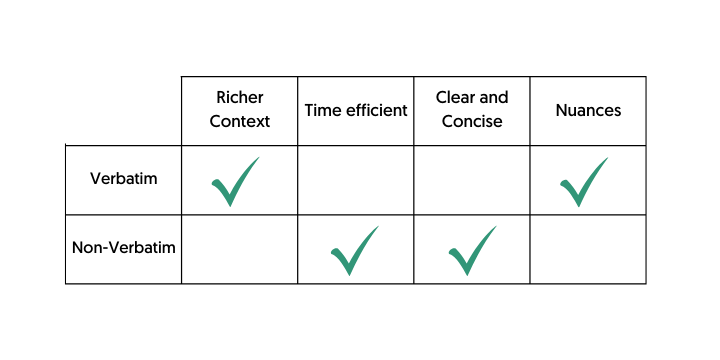
- Verbatim Transcription: This detailed method involves transcribing every utterance, including fillers, repetitions, and false starts, offering a comprehensive account of the dialogue. While it provides a richer context, it can be time-consuming and might sometimes clutter the data with unnecessary information.
- Non-verbatim Transcription: This approach omits certain details like fillers and repetitions, focusing on the core content. Although quicker and easier to read, it might miss out on subtle nuances that could be vital in qualitative analysis.
Importance of capturing non-verbal cues (pauses, laughter, intonation)
- Non-verbal cues provide deeper insights into a respondent’s emotions and attitudes, adding a layer of depth to the data.
- Pauses could indicate hesitation or deep thought, laughter could reveal discomfort or joy, and changes in tone or intonation could help interpret the respondent’s feelings.
- Capturing these cues can be challenging but are integral to a comprehensive qualitative analysis.
Time-stamping and its relevance in qualitative analysis
- Time-stamping involves marking the points in the transcript that correspond to the specific time in the audio or video recording.
- It enables easy referencing and tracking of data, improving the efficiency of the analysis process.
- Time-stamping also aids in accurately associating non-verbal cues and contextual details with the corresponding dialogue, thereby enhancing the richness of the data.
While there are multiple transcription techniques, choosing the right one depends on the research requirements. A balanced approach that captures the necessary details without overwhelming the data is often most effective in qualitative research.

Open-Ended Questions in Qualitative Research: Strategies, Examples, and Best Practices
Read NowLeveraging Technology in Transcription

Overview of Technological Tools Aiding Transcription:
- Automatic Speech Recognition (ASR): ASR is a technology that converts spoken language into written text, significantly speeding up the transcription process. However, it’s important to note that ASR may struggle with understanding accents, colloquialisms, and background noise, requiring human review for accuracy.
- AI-Driven Transcription Software: AI-powered software can transcribe audio and video files with impressive accuracy and speed. These tools often come with features such as speaker identification and timestamping, which can be invaluable in qualitative research.
Balancing Technology and Human Judgment for Accuracy:
While technology offers speed and convenience, it cannot completely replace human judgment, particularly in determining context, interpreting nuances, and recognising emotional cues. Combining automated transcription with human review allows for greater precision and reliability in the qualitative data analysis process.
Ethical Considerations in Automated Transcription:
The use of automated transcription raises certain ethical issues that researchers must consider. Privacy concerns are paramount, as sensitive information may be processed and stored by third-party software. It’s crucial to ensure that any transcription tool used complies with data protection regulations and maintains a high standard of data security. In addition, researchers should remain transparent about their use of automated transcription with interviewees or participants, obtaining their consent whenever necessary.

3 ways automated speech recognition (ASR) can foster digital inclusion
Read NowTranscription as a Tool for In-Depth Analysis
In the context of qualitative research, transcription serves as a powerful tool for in-depth analysis. It lays the groundwork for various analytical methods, aiding researchers in uncovering intricate patterns and themes.
How Transcription Facilitates Thematic Analysis and Coding
- Thematic analysis, a widely used method in qualitative research, involves identifying, analysing, and reporting patterns within the data. Transcripts provide the raw material for this process, enabling researchers to comb through the data with a fine-toothed comb, identifying recurring themes and categories.
- Coding, an essential step in thematic analysis, involves assigning labels to data segments that represent distinct themes or patterns. An accurate and detailed transcript facilitates efficient coding, enabling the researcher to highlight and categorise key sections of the data.
Enhancing Interpretive Phenomenological Analysis Through Detailed Transcripts
- Interpretive phenomenological analysis (IPA) seeks to understand the lived experiences of individuals and how they make sense of these experiences. A detailed transcript, capturing the nuances of language, emotion, and thought processes, can significantly enhance the richness and depth of IPA.
- Verbatim transcripts, in particular, can help capture the uniqueness of individual experiences, enabling researchers to delve deeper into the subjective world of the participants.
Case Studies: Success Stories of Transcription in Qualitative Research
- A study exploring the lived experiences of cancer survivors benefitted immensely from transcription. Verbatim transcription captured the emotional undertones and personal expressions of the participants, revealing deep insights into their coping mechanisms and emotional resilience.
- In a qualitative study exploring customer behaviour in a retail environment, transcription played a critical role. The transcribed customer interviews provided a wealth of data that was then coded and categorised, revealing emerging patterns in customer preferences and shopping behaviour.
Precise transcription not only aids in data organisation but also adds depth to the data interpretation, making it an essential tool in qualitative research. The right transcription techniques can unveil hidden subtleties, leading to a more sophisticated understanding of the research subject.
Best Practices for Effective Transcription
Adhering to best practices can make the process of transcription more efficient and yield higher quality results. Here are some tips for preparing and conducting interviews, guidelines for transcribers, and insights on training and skill development.

Tips for Preparing and Conducting Interviews to Ease Transcription
- Prepare a script: Having a prepared set of questions for your interview can ensure a focused and organized discussion. This not only streamlines the conversation but also simplifies the subsequent transcription process.
- Use quality recording equipment: High-quality audio is critical for effective transcription. Using good recording equipment reduces the risk of audio issues such as background noise or low volume, making the transcription process smoother and more accurate.
- Clarify responses during the interview: If a response is unclear during the interview, don’t hesitate to ask for clarification. This can save time during the transcription process and ensure the accuracy of the data.
Guidelines for Transcribers: Accuracy, Consistency, and Confidentiality
- Accuracy: Transcribers should aim for the highest level of accuracy, transcribing exactly what is said without adding, omitting, or altering words. Even seemingly minor errors can significantly distort the meaning of the data.
- Consistency: Transcribers should be consistent in their transcription style, following the same conventions throughout the document. This makes the data easier to analyze and interpret.
- Confidentiality: Transcribers often handle sensitive data. They must respect the confidentiality of the information and adhere strictly to privacy practices and regulations.
Training and Skill Development for Transcribers
- Develop strong typing skills: Fast and accurate typing is a crucial skill for efficient transcription. Regular practice can help improve typing speed and accuracy.
- Improve listening skills: Good transcribers are also good listeners. Improving listening skills can help transcribers catch nuances and subtleties that may be missed otherwise.
- Learn to use transcription software: There are many transcription tools available that can streamline the process. Transcribers should familiarize themselves with these tools and learn to utilize them effectively.
Remember, transcription is not just about converting spoken words into written text. It’s about capturing the essence of the conversation, the emotions, and the context. It’s a crucial part of qualitative research that requires skill, patience, and dedication.
The Future of Transcription in Qualitative Research
Looking ahead, transcription is set to play an increasingly integral role in qualitative data analysis. Developments in technology are paving the way for more efficient, precise, and nuanced transcription techniques, promising exciting potentials for qualitative research.

Emerging Trends and Future Prospects in Transcription Technology
- Automation and AI: With the advent of advanced speech recognition technology, we are moving towards more automated transcription processes. While these technologies can increase efficiency, it’s important to note that they are not yet capable of capturing the nuances that a human transcriber can.
- Integration with Analytics Tools: Future transcription tools may offer seamless integration with qualitative data analysis software, facilitating immediate and insightful analysis of transcribed data.
The Evolving Role of Transcribers in the Digital Age
- Despite advances in technology, the role of human transcribers remains critical. Their ability to capture emotional nuances, contextual cues, and subtle meanings distinguishes them from AI and automated systems.
- As technology evolves, so does the role of transcribers. They may find themselves working in tandem with AI, leveraging the speed of automated transcription while adding the human touch of nuanced understanding.
Anticipating the Changing Needs of Qualitative Data Analysis
- As qualitative research methodologies evolve and diversify, so too will the requirements for transcription. Future trends may include more flexible transcription styles, allowing for the capture of non-verbal cues and the dynamics of conversation.
- Researchers and organisations will need to stay abreast of these trends, adapting their transcription practices to meet the changing needs of qualitative data analysis.
Transcription is not merely a mechanical process, but a critical tool in the quest to unlock the full value of qualitative data. With the right techniques and an emphasis on capturing nuances, transcription can provide rich, detailed data, serving as a bedrock for insightful analysis. In an era of rapidly evolving technology, the importance of skilled, dedicated transcribers cannot be overstated.

Get a customized offer
Request a quote for your transcription needs
For researchers and organisations seeking to maximise the value of their qualitative data, investing in advanced transcription techniques and training is a logical step. With the right skills and tools, transcribers can transform raw conversation into a gold mine of insights, helping drive informed decision-making and innovative research conclusions. Don’t let the nuances of your data slip away, elevate your qualitative research with effective transcription !
The University’s Guide to Implement Subtitles: Enhancing Accessibility in Higher Education
Table of contents
- Subtitles in Academic Settings
- Exploring Subtitling Services: Types and Educational Use Cases
- Implementing Subtitles in University Curricula: A Step-by-Step Guide
- Technological Advancements in Subtitling
- Best Practices in Creating and Integrating Subtitles
- Educating Faculty and Staff: Training and Support
- Assessing the Impact of Subtitles on Educational Outcomes
- Navigating Challenges in Subtitle Implementation
- Amberscript: Your Partner in Enhancing Educational Accessibility
Enhancing accessibility in higher education has never been more critical, as it ensures that every student, regardless of their circumstances, can access and benefit from learning opportunities. One transformative tool in bridging this accessibility gap is the use of subtitles. Subtitles not only cater to learners with hearing impairments but also boost comprehension for non-native language speakers and enhance concentration.
- The prevalence of multi-modal learning styles makes subtitles an integral part of the education landscape.
- They reinforce auditory learning with visual reinforcement, enhancing information retention.
In this guide, we will delve into the mechanics of effectively implementing subtitles in university settings, a step toward accessible, inclusive education for all.
Subtitles in Academic Settings
The need for subtitles in academic settings reaches far beyond a simple nice-to-have add-on; it’s a crucial tool for improving access and comprehension.

According to the National Center for Education Statistics, approximately 19.4% of undergraduates reported having some form of disability in the academic year 2015–16. Among these, 11.5% reported a hearing disability. This significant portion of the student body faces added academic challenges due to their hearing disabilities, highlighting the critical role of subtitles in making course content more accessible and digestible.

Legal frameworks mandating accessibility in education: Legal frameworks like the Americans with Disabilities Act (ADA) and Section 504 of the Rehabilitation Act mandate equal access to education for all students, including those with hearing impairments. These statutes require educational institutions to provide necessary accommodations, such as subtitles, to ensure accessible learning experiences.

Broader benefits of subtitles: Beyond aiding those with hearing impairments, subtitles offer a host of benefits to a wider student population:
- Aiding non-native speakers: For students whose first language is not English, subtitles can enhance comprehension, reinforcing spoken words with text to provide a more in-depth understanding of the material.
- Catering to diverse learning styles: Subtitles cater to visual learners and reinforce auditory learning with written words, aiding information retention.
- Improving focus: For students prone to distraction, subtitles can offer an additional focus point, helping maintain concentration during lectures and multimedia presentations.
The use of subtitles in higher education is more than a mere compliance exercise. It is a transformative step towards establishing an inclusive, accessible learning environment for all students.
Exploring Subtitling Services: Types and Educational Use Cases
Subtitling services offer a diverse array of tools to enhance learning accessibility. Here we explore the different types of subtitling and their educational use cases.
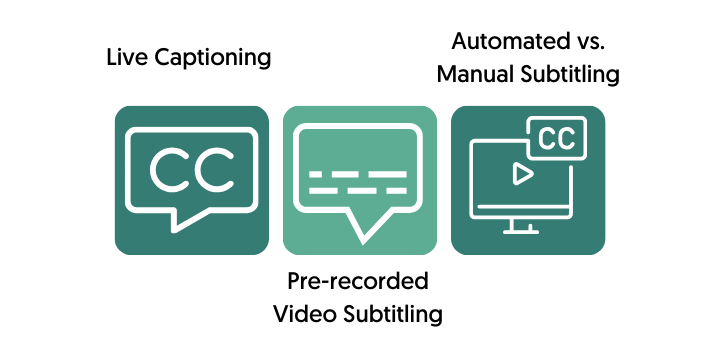
- Live Captioning: Live captioning is a real-time transcription service that provides subtitles for live lectures, webinars, or discussions. This tool is vital for students with hearing impairments attending real-time classes.
- Pre-recorded Video Subtitling: This service adds subtitles to pre-recorded lectures or educational videos. Pre-recorded subtitling gives educators the chance to ensure that their content is accurately transcribed and synchronised, benefiting students with hearing impairments, non-native English speakers, and visual learners.
- Automated vs. Manual Subtitling: Automated subtitling uses speech recognition software to generate captions, while manual subtitling involves a human transcriber. Automated subtitling is faster and more cost-effective but might lack accuracy, especially in technical or specialized courses. Manual subtitling, while more time-consuming, ensures higher accuracy and context understanding.
Educational Use Cases: Successful Adoption of Subtitling
- University of Washington (UW): UW has become a leading example of the power of captioning services. They’ve implemented a robust captioning policy, mandating all publicly shared video content to have captions. This initiative, coupled with a strong commitment to accessibility, has made education at UW more inclusive.
- Massachusetts Institute of Technology (MIT): MIT’s OpenCourseWare, a web-based publication of virtually all MIT course content, has been a strong advocate of subtitling. Most of the video-based courses provide subtitles, ensuring global accessibility and comprehension.
Through these methods, universities can make significant strides towards enhancing accessibility. The implementation of subtitling is not just about compliance; it’s about providing equal opportunities for all to learn and grow.
Implementing Subtitles in University Curricula: A Step-by-Step Guide

In order to ensure an inclusive and accessible academic environment for all students, the integration of subtitles in university curricula is a vital initiative. Here’s a step-by-step guide to implementing this essential tool in your institution:
Evaluating Current Accessibility Levels at Your Institution: The first step in this process is to conduct a thorough review of your existing academic resources, investigating the level of accessibility currently available. This includes assessing the availability of subtitles in video resources, the accessibility of online platforms, and the overall ease of access to educational content for students with diverse needs.
Pinpointing Courses and Resources Ripe for Subtitling: Some courses may naturally lend themselves more towards the use of multimedia resources than others. Identifying these courses and the associated materials that are used most frequently can help determine where subtitling efforts should be concentrated. This step also involves identifying live events and classes that could benefit from real-time captioning.
Criteria for Selecting the Optimal Subtitling Service: Several factors should be considered when selecting the appropriate subtitling service for your institution. These include but are not limited to:
- Accuracy: The precision of the subtitles is critical for comprehension. This is particularly important for technical subjects where the misuse of a term can lead to misunderstanding.
- Speed: Speed is essential when it comes to live captioning. The minimal delay between the spoken words and their transcription ensures a smooth learning experience.
- Cost: Universities should weigh the cost of the subtitling service against the potential benefits it brings in terms of accessibility and inclusivity.
- Language Diversity: In our globalized world, universities host students from diverse linguistic backgrounds. Therefore, the ability of the subtitling service to accommodate different languages is a valuable feature.
Embarking on this journey towards improved accessibility is not merely about regulatory compliance; it’s a commitment to providing an equally enriching educational experience for all students. By following this guide, universities can effectively implement subtitles and contribute significantly to global education access.
Remember, there is no one-size-fits-all solution. Your institution may need to leverage a combination of services to best meet the diverse needs of your student body.

How to choose your subtitling service for precisely accurate subtitles
Read NowTechnological Advancements in Subtitling

The landscape of subtitling services has been considerably transformed by technological advancements, particularly in the realm of Artificial Intelligence (AI) and Machine Learning (ML). These cutting-edge technologies have revolutionised the efficiency and accuracy of subtitle generation, providing more reliable and precise transcription services.
- AI and Machine Learning: AI and ML algorithms can analyze spoken language and translate it into written text more accurately and swiftly than ever before. They continuously learn from their past transcription experiences, further enhancing their precision and efficiency over time. This evolution of subtitling technology is a powerful tool for increasing accessibility in higher education.
- Amberscript and Related Brands: A standout example of these advancements in the subtitling industry is the work of companies like Amberscript and its sister brands mistranscripciones.es and transkripto.de. Offering specialized solutions for educational content, these companies utilize state-of-the-art technology to provide accurate, rapid, and affordable subtitling services.
- Amberscript: Pioneering in the field of automated transcription and subtitling, Amberscript leverages AI to provide quick and precise subtitle generation. Its solutions cater to a range of formats, including lectures, webinars, and other e-learning materials.
- Mistranscripciones.es and Transkripto.de: These platforms, as part of the Amberscript group, offer services tailored to the Spanish and German markets, respectively. They maintain the same commitment to quality, accuracy, and speed, providing universities with reliable subtitling services that enhance accessibility for non-English speaking students.
The adoption and application of these advanced subtitling technologies are pivotal in breaking down barriers in education. They enable universities to offer an inclusive, accessible learning experience to all students, further contributing to global education access.
Best Practices in Creating and Integrating Subtitles
For universities to maximise the potential of subtitles as a tool for enhancing accessibility, they must adhere to a set of best practices in their creation and integration. These guidelines ensure that the subtitles produced are clear, precise, and accurate, thereby supporting the comprehension and engagement of all students.
Creating Clear and Precise Subtitles
- Accuracy: The text must precisely represent the spoken dialogue, including important details and nuances. Misrepresentations can lead to confusion and misinformation.
- Brevity: Subtitles should be succinct while capturing the essence of the spoken content. Overly long subtitles can be challenging to read within the time frame they appear on screen.
- Readability: The language used should be easily understandable. Avoid complex sentence structures and jargon wherever possible.
- Synchronization: Subtitles must coincide with the audio. This synchronisation is crucial for a seamless learning experience.
Integrating Subtitles into Educational Materials
- Inclusivity: Subtitles should be integrated into all video and audio educational materials where possible, including recorded lectures, webinars, and multimedia presentations.
- Visibility: Subtitles should be displayed in a clear, readable font and contrasting color to ensure visibility. Additionally, the positioning of subtitles should not obscure important visuals.
- Flexibility: Universities should offer the option to turn subtitles on or off, catering to the varied preferences of the student body.
Accessibility Features
- Font and Color: The choice of font and color for subtitles can greatly impact their readability. Consider using sans-serif fonts and colors that contrast strongly with the background for optimal visibility.
- Synchronization: The timing of subtitles is a crucial aspect of their effectiveness. Subtitles should closely match the audio, neither lagging too far behind nor appearing too prematurely.
- Language Support: Subtitling services should cater to the diverse linguistic needs of the global student body, offering subtitles in multiple languages where possible.
By adhering to these best practices, universities can create and integrate subtitles that enhance the accessibility and inclusivity of their curricula, contributing significantly to global education access. Remember, the goal is to foster a learning environment where all students, regardless of their abilities or linguistic background, can thrive.
Educating Faculty and Staff: Training and Support
To facilitate the implementation of subtitles and promote an inclusive learning environment, it’s crucial to invest in the training and support of faculty and staff. Educational institutions should consider the following strategies:
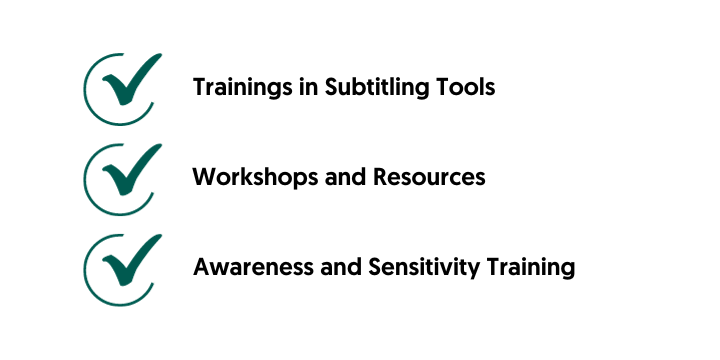
- Training in Subtitling Tools: Understanding the technical aspects of subtitle creation is essential for educators. Training sessions should be provided on how to use subtitling software and platforms, with hands-on demonstrations and practical exercises to ensure full comprehension. It’s a step towards equipping educators with the skills needed to create accurate and effective subtitles.
- Workshops and Resources for Subtitles Creation and Editing Skills: Alongside training in subtitle tools, workshops should be conducted to hone educators’ subtitle creation and editing skills. These interactive sessions can focus on the best practices of subtitling outlined above and provide educators with resources such as style guides and checklists to help them adhere to these guidelines.
- Awareness and Sensitivity Training: It’s essential to foster a culture of inclusivity within the university. Faculty and staff should undergo regular awareness and sensitivity training sessions that highlight the importance of subtitles as an accessibility tool. This training can help to instill a sense of responsibility and commitment towards enhancing global education access.
By educating faculty and staff, universities can create a supportive, inclusive environment that leverages subtitles to the fullest potential. Remember, the goal is not only to provide subtitles, but also to ensure they are clear, precise, and beneficial for all students.
Assessing the Impact of Subtitles on Educational Outcomes
An integral component of implementing subtitles in higher education is evaluating their impact on student engagement and achievement. Universities should consider the following techniques and approaches:
Techniques to Evaluate the Effectiveness of Subtitles in Education
- Surveys and Questionnaires: Conducting regular surveys and questionnaires among students can provide insights into their experiences with subtitled educational materials. It can reveal if the subtitles are enhancing understanding, maintaining engagement, and aiding in retention of information.
- Academic Performance Metrics: The comparison of academic performance metrics before and after the introduction of subtitles can help assess their impact. Improvements in grades, test scores, and other performance indicators can signify the effectiveness of subtitles.
Gathering Feedback from Students and Faculty
Sensitive to the benefits and challenges of using subtitles in education, students and faculty can provide invaluable feedback. Universities should consider:
- Setting up Feedback Channels: Establish channels for students and faculty to express their thoughts and experiences with subtitled content. This feedback can be used to improve the quality and integration of subtitles.
- Conducting Focus Group Discussions: Engage students and faculty in focus group discussions to delve deeper into their experiences. These discussions can provide nuanced insights into the functionality and usefulness of subtitles.
Demonstrating the Positive Influence of Subtitles on Student Engagement and Achievement
To showcase the benefits of subtitles, universities can:
- Highlight Success Stories: Share stories and testimonials of students who have benefited from subtitled content. These stories can demonstrate how subtitles can enhance the learning experience.
- Publish Impact Studies: Conduct and publish studies that illustrate the positive impact of subtitles on student engagement and achievement. Research findings can strengthen the case for adopting subtitles as a standard practice in higher education.
By assessing the impact of subtitles, universities can ensure they’re effectively enhancing accessibility and inclusivity in their classrooms, thus contributing significantly to global education access.

The Impact of Subtitles and Closed Captioning for Deaf and Hard of Hearing Viewers
Read NowNavigating Challenges in Subtitle Implementation
While subtitles can significantly enhance accessibility in higher education, implementing them can present its own set of challenges. Recognising these hurdles and adopting proactive strategies to overcome them is crucial to successful subtitle integration.
Several common issues can arise during the process of implementing subtitles in educational content, such as:
- Technical Difficulties: This could range from problems with synchronization to issues with text formatting or video-player compatibility.
- Quality Control: Ensuring the accuracy and readability of subtitles is a constant challenge, especially with complex academic topics.
- Resource Allocation: Subtitle creation and editing require time and human resources, which can be a challenge for institutions with tight budgets or limited staff.
- Language Variations: Catering to a diverse student body often means providing subtitles in multiple languages, which can be difficult to manage.
Strategies to Resolve These Issues
Confronting these challenges involves strategic planning and resource management. Universities can consider:
- Investing in Quality Subtitling Software: High-quality software can alleviate many of the technical difficulties associated with subtitle creation.
- Training and Upskilling Staff: Regular training sessions can equip staff with the skills to create and edit accurate, high-quality subtitles.
- Collaborating with Professional Subtitling Services: This can ensure quality and consistency, particularly for multilingual subtitles.
- Allocating Sufficient Resources: Implementing subtitles should be seen as an investment in education access. Allocating resources to this initiative is crucial to its success.
By anticipating these challenges and planning accordingly, universities can make the process of implementing subtitles more efficient and effective, thereby enhancing the accessibility of their educational content.
Amberscript: Your Partner in Enhancing Educational Accessibility
In the journey towards enhancing educational accessibility, Amberscript stands as a committed partner with tailored solutions for the educational sector. For universities striving to implement effective subtitling, Amberscript provides an optimal blend of technology and expertise.
Why you should use Amberscript
5x average time saving by using AI for Automatic Transcription.
Enabling an accurate flow of audio-to-data, adjustable in our easy to use online text editor. Or 100% accuracy with Human-Made Transcription.
GDPR compliant security and safety.
Tailored Solutions for the Educational Sector
Amberscript’s services are designed to simplify the process of implementing and managing subtitles. Here’s how:
- Robust Technology: Amberscript’s advanced speech-to-text technology delivers fast and accurate transcription, providing a reliable foundation for high-quality subtitles.
- Ease of Integration: Our services integrate seamlessly with a variety of digital platforms, ensuring a smooth subtitling process across diverse educational content.
- Comprehensive Support: Our team offers comprehensive support, from the initial stages of setup to ongoing management, alleviating the burden from university staff.
Benefits of Partnering with Amberscript
The value of partnering with a specialized service provider like Amberscript extends beyond just efficient subtitling. Here’s why:
- Quality Assurance: With our team of professional linguists and state-of-the-art subtitling software, we ensure the delivery of precise, readable subtitles for all your educational content.
- Time and Resource Optimization: Our services can save universities significant time and resources that can be reinvested in enhancing other aspects of education access.
- Improved Student Engagement: High-quality subtitles can enhance student engagement, comprehension, and retention, contributing to improved educational outcomes.
By partnering with Amberscript, universities can streamline their subtitle implementation, enhance the accessibility of their educational content, and thereby contribute more effectively to global education access.

Get a customized offer
Request a quote for your transcription needs
Maximising Engagement: How Subtitles and Transcriptions Improve Multilingual Student Participation
Table of contents
- Understanding Multilingual Student Challenges
- The Power of Subtitles
- Transcriptions: A Comprehensive Solution
- Amberscript: Transforming Transcriptions for Students
- How Subtitles and Transcriptions Improve Multilingual Student Participation
- Technological Advancements
- Potential Drawbacks and Mitigation Strategies
- Case Studies: Success Stories
Student engagement is a cornerstone of academic success in universities. It refers to the degree of attention, curiosity, interest, and passion that students show when they are learning or being taught. This involvement goes beyond mere participation, inspiring students to take an active role in their education, leading to better learning outcomes and overall academic performance.
In our increasingly globalised society, classrooms are becoming more diverse. As such, universities are tasked with ensuring educational equity for students from different linguistic backgrounds. One method that has shown tremendous promise in this regard is the use of subtitles and transcriptions.
Subtitles and transcriptions are powerful tools for promoting student engagement, particularly among those whose first language is not English. By providing a written version of spoken language, these tools help eliminate linguistic barriers and promote understanding, thereby fostering an inclusive and engaging learning environment.
As we delve into this topic, we will uncover how subtitles and transcriptions can be transformative for multilingual student participation, thereby maximising engagement in our diverse educational landscape.
Understanding Multilingual Student Challenges
Multilingual students in higher education face numerous challenges that can impede their academic success and engagement. These obstacles range from understanding complex academic language to participating in classroom discussions.

Challenges Faced by Multilingual Students
- Language proficiency: While multilingual students may be proficient in conversational English, they often struggle with academic English, which is rich in discipline-specific jargon and complex grammatical structures.
- Cultural differences: Cultural nuances and unspoken rules can lead to misunderstandings and feelings of exclusion, thus affecting the students’ willingness to engage.
- Participation in classroom discussions: Due to fear of miscommunication or making mistakes, these students may be reluctant to participate in class discussions, limiting their engagement and learning opportunities.
Importance of Addressing Language Barriers
Addressing these language barriers is crucial to ensure an inclusive and equitable learning environment. By eliminating these barriers, we enable multilingual students to fully engage in their education, fostering academic success and personal growth. Moreover, this can lead to increased diversity of thoughts and ideas, enriching the learning experience for all students.
Supporting Data and Statistics

The significance of addressing these challenges is reinforced by data. The National Center for Education Statistics (NCES) reports that in 2019, nearly 10% of undergraduate students in the U.S. were non-native English speakers. Additionally, a study in the Journal of Multilingual and Multicultural Development found that providing linguistic support to these students led to a significant increase in their academic performance and engagement. This emphasises the importance and effectiveness of tools like subtitles and transcriptions in addressing the challenges faced by multilingual students.
The Power of Subtitles

Subtitles are textual representations of dialogue or narration displayed on screen during a video or film, usually at the bottom. They can be in the same language as the audio or translated into another language. When it comes to multilingual education, subtitles serve as a bridge that links the spoken content to students who may struggle with understanding it.
Understanding Subtitles
Subtitles, essentially, give a written version of the spoken language in a video. They can be key in helping students follow along, especially if the speaker has a thick accent or speaks at a fast pace. They also allow students to see the written form of new vocabulary words, aiding in their language learning process.
Benefits of Subtitles
- Enhanced comprehension for non-native speakers: By giving non-native speakers the chance to read what’s being spoken, subtitles enable them to better understand the concepts being taught. This is particularly beneficial when dealing with complex academic terms that may be difficult to grasp audibly.
- Improved retention of information: Research shows that subtitles can significantly improve the retention of information. By catering to both auditory and visual learners, they reinforce the learning process and help students remember the material better.
- Inclusivity for hearing-impaired students: For students with hearing impairments, subtitles are not just an enhancement but a necessity. They ensure these students aren’t left behind and have the same opportunities to learn and engage as their peers.
Case Studies of Effective Subtitle Implementation

- University of Michigan: Implemented a program where all their online courses offer subtitles in English and several other languages. They reported an increase in engagement and course completion rates among non-native English speakers.
- Monash University: This Australian university introduced an initiative requiring all course material to be subtitled. Student feedback showed that this significantly improved comprehension and engagement, particularly among international students.
- University of Edinburgh: Successfully integrated subtitles in all their online courses. As well as improving engagement, Edinburgh found that the presence of subtitles also reduced drop-out rates among non-native English speakers.
Transcriptions: A Comprehensive Solution
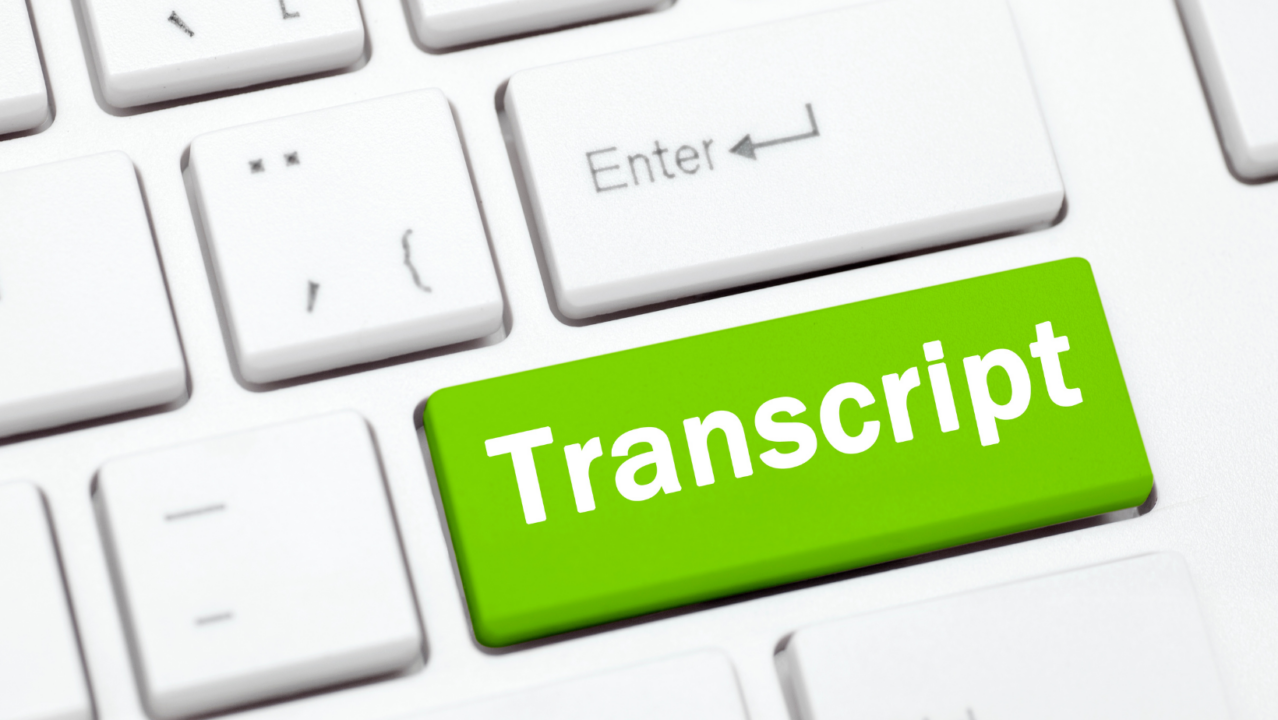
Transcriptions are written or printed versions of dictated or recorded speech. In the context of education, transcriptions often refer to the process of converting lectures, discussions, or audiovisual content into written format. This textual representation of spoken materials serves as an invaluable resource, providing an alternative way to access and engage with educational content.
Advantages of Transcriptions for Multilingual Student Engagement
Transcriptions offer several key advantages in enhancing multilingual student engagement:
- Accessibility for students with disabilities: Transcriptions provide a critical accessibility feature. For students with hearing impairments, or those with learning disabilities such as dyslexia, transcriptions can make educational material more accessible and comprehensible.
- Facilitating note-taking and study aids: Transcriptions can serve as a valuable study aid. By providing a written account of lectures or discussions, they allow students to focus on understanding the content during class, rather than struggling to take extensive notes. This particularly benefits multilingual students who might need more time to process information.
- Aiding in language learning: By seeing words written out, multilingual students can better understand new vocabulary, idiomatic expressions, or complex syntactical structures in English. A written format allows them to revisit and study these aspects at their own pace.
Universities and Institutions Leading in Transcription Integration
Several forward-thinking institutions recognise the value of transcriptions and are leading the way in their implementation:
- Harvard University: Known for their commitment to inclusive education, Harvard University incorporates transcriptions in their online course offerings, supporting not only their diverse student population but also their global learning community.
- California State University: This institution has spearheaded efforts to integrate transcription services across their virtual learning platform, improving accessibility for multilingual and disabled students alike.
- University of Toronto: As part of their accessibility services, the University of Toronto offers lecture transcriptions, ensuring all students have equal access to academic content.

Transcription for e-learning: How to make online courses more engaging
Read BlogAmberscript: Transforming Transcriptions for Students
In the world of academic transcription services, Amberscript holds a prestigious position. We are a leading global service provider that utilises advanced technology to convert spoken language into written text. Catering to a diverse clientele, including students, educators, and researchers, Amberscript is paving the way for more inclusive and accessible education.
Leveraging Amberscript’s AI-Powered Technology to Benefit Students
Amberscript’s strength lies in its cutting-edge AI-powered technology, offering students numerous advantages:
- Accurate and Efficient Transcription Services: Amberscript’s AI-based system ensures high levels of accuracy, capturing even complex academic terms or phrases efficiently. This speed and accuracy facilitate real-time transcriptions, making it possible for students to access lecture content soon after it takes place.
- User-friendly Platform for Easy Access and Customisation: The platform is designed with user-friendliness at its core. It allows students to easily navigate, access and customize their transcriptions as per their requirements. This flexibility allows users to focus more on their studies rather than grappling with a complex interface.
How Subtitles and Transcriptions Improve Multilingual Student Participation
Incorporating subtitles and transcriptions into the educational process can sound intimidating, but with a step-by-step approach and the right resources, it becomes a manageable task.
Here is how:
- Choosing the right tools and software: The first step involves selecting a reliable transcription and subtitling service. One needs to consider factors such as accuracy, speed, and user-friendliness. In this regard, Amberscript stands out as an ideal choice. Its AI-powered technology ensures high levels of accuracy, providing real-time transcriptions that enhance lecture accessibility for multilingual students.
- Training faculty and staff: The second step is to train faculty and staff on how to best use these services. This could involve workshops or online training sessions, where educators are shown how to upload their lecture recordings, use the transcription software, and incorporate the transcriptions into their teaching materials.
Cost-Efficiency of Amberscript’s Solutions
One of the biggest advantages of Amberscript is its cost-efficiency. While some may assume that transcription services are expensive, this isn’t necessarily the case. Amberscript provides high-quality transcription services at competitive prices. Moreover, the benefits of increased student engagement and improved learning outcomes far outweigh the costs, making it a worthwhile investment for institutions.
Addressing Common Concerns and Misconceptions
Some common misconceptions surrounding transcription services include the fear of technology replacing educators, or the assumption that all students will solely rely on transcriptions and neglect attending lectures. However, it’s important to dispel these misconceptions by emphasising that transcription services are not replacements for traditional teaching methods. Instead, they complement these methods by offering alternative ways to access and understand educational content. As for the concern about students skipping lectures, studies have shown that transcriptions actually improve lecture attendance as students feel more engaged and supported in their learning.
Technological Advancements

The field of automatic transcription and translation is one that is constantly evolving, spurred on by the rapid advancements in technology. A number of emerging technologies promise to increase the efficiency and accuracy of these services. For instance, machine learning algorithms and Natural Language Processing (NLP) techniques are being deployed to increase the accuracy of transcription services. Amberscript, a frontrunner in this domain, heavily leverages AI technology to transcribe and translate spoken language into written text, catering to multiple languages and dialects with impressive precision.
Future Trends and Improvements in Subtitle and Transcription Services
Looking ahead, we can expect several exciting trends in transcription and subtitling services:
- Improved Accuracy: With growing technological advancements, we can anticipate further improvements in the accuracy of transcriptions, even in the face of complex academic language or regional accents.
- Real-Time Transcriptions & Translations: As processing speeds increase, more services might offer real-time transcription and translation, making it easier for non-native students to follow along during lectures.
- Integration with Learning Management Systems: We may see tighter integration between transcription services like Amberscript and Learning Management Systems, creating a seamless learning experience for students.
The Imperative for Universities to Stay Up-to-Date with Technology
In a world that is increasingly digitized, it is crucial for universities to keep pace with advancements in technology. The integration of transcription and translation services represents one such opportunity. Not only do these services support non-native and hearing-impaired students, but they also promote better engagement among all students. Amberscript’s advanced transcription services provide a cost-effective, user-friendly solution that can significantly boost student engagement and participation. By staying up-to-date with innovations like Amberscript, universities can ensure they are providing an inclusive, accessible, and engaging learning environment for all students.

How Universities Are Using Subtitles and Transcriptions to Bridge Language Gaps
Read BlogPotential Drawbacks and Mitigation Strategies
While subtitles and transcriptions hold immense potential in fostering multilingual student engagement, it is imperative to address the potential drawbacks of over-reliance on these tools:
- Dependency: Over-reliance on transcriptions could lead to an excessive dependency among students, potentially hindering their active listening skills and their ability to understand spoken language in real-time.
- Socio-cultural nuances: Subtitles and transcriptions, despite being accurate, might miss out on conveying the socio-cultural nuances embedded in verbal communication.
- Technical glitches: As with any tech-based services, there could be instances of technical issues or downtime, affecting the availability of transcriptions.
Mitigating Potential Issues
Amberscript, with its advanced features, aids in mitigating these potential issues:
- Balancing dependency: To avoid over-dependency, faculty can use transcriptions as a supplementary tool rather than a primary resource. For example, during a lecture, educators can encourage students to first listen and understand the spoken language, using the transcription as a reference for clarification or review.
- Cultural context: Amberscript’s translation services account for cultural context to a certain extent by accommodating regional dialects and language variations.
- Reliable service: Offering high uptime and reliable performance, Amberscript ensures that technical issues have a minimal impact on student learning.
Encouraging a Balanced Approach
While embracing the benefits of subtitles and transcriptions, it is vital to maintain a balanced approach. It’s not about replacing traditional learning methods but supplementing them with technology. Transcriptions should act as a support structure for understanding lectures and not become the sole method of learning. A balanced blend of listening, note-taking, and reviewing transcriptions can help maximise student engagement while ensuring well-rounded language development.
Case Studies: Success Stories
Several universities globally have embraced transcription and subtitling services, enhancing accessibility and student engagement. Here are a few notable examples:
- University of Amsterdam: Adopting Amberscript’s services, this university significantly improved the learning experience for its multilingual student body, with greater comprehension of lectures and increased participation in class discussions.
- University of Barcelona: Implementing subtitles and transcriptions through Amberscript resulted in higher rates of student engagement, particularly among international students who found the features invaluable for understanding complex academic content.
 |
|
 |
|
A Doctor’s Guide to Effective Medical Transcription: Elevating Documentation Quality
Medical transcription is a crucial aspect of healthcare documentation that often goes unnoticed by the general public. For healthcare professionals, the importance of accurate and timely medical transcription cannot be overstated. We will discuss the significance of medical transcription in healthcare and provide valuable tips for enhancing its quality.
Table of Contents
- The Importance of Medical Transcription in Healthcare
- Benefits of High-Quality Medical Transcription
- Strategies for Improving Transcription Quality
- Utilizing Technology for Superior Transcription
- Best Practices for Enhancing Medical Transcription
- Fostering Excellence in Documentation
The Importance of Medical Transcription in Healthcare
Medical transcription is the process of converting medical notes and dictations into written documents that become part of a patient’s permanent health record. These records serve as a vital source of information for healthcare professionals, allowing them to make informed decisions about a patient’s diagnosis, treatment, and care plan.
Benefits of High-Quality Medical Transcription
Accurate and high-quality medical transcription has numerous benefits for both healthcare professionals and patients. Let’s explore some of these advantages in more detail.

Improved Patient Care
Timely and precise documentation is crucial for providing quality patient care. With accurate transcriptions, healthcare professionals can access a patient’s complete medical history and make informed decisions about their treatment. This leads to better patient outcomes and improved overall healthcare quality.
Legal and Ethical Compliance
Inaccurate or incomplete medical transcription can have serious legal and ethical implications for healthcare professionals. By ensuring high-quality transcriptions, healthcare providers can avoid potential legal issues and maintain ethical standards in their practice.
Time and Cost Savings
Efficient and accurate medical transcription can also save time and costs for healthcare facilities. With well-transcribed documents, healthcare professionals spend less time correcting errors and searching for information, allowing them to focus on providing quality care to patients. This can lead to significant cost savings in the long run.
Strategies for Improving Transcription Quality
Medical documentation is the backbone of quality healthcare, and as a doctor, ensuring accurate and comprehensive records is crucial. One powerful tool in achieving this is medical transcription. In this guide, tailored specifically to you, we’ll explore distinctive guidelines to help you improve your documentation through transcription, ultimately enhancing patient care and streamlining your practice.
1. Clear and Articulate Dictation
When dictating, as a healthcare professional, you understand the complexity of medical terminology. Ensure you speak clearly and enunciate words, especially complex medical terms and names. This ensures that transcriptionists can accurately capture your notes.
2. Provide Context
Given your expertise, always offer context when using medical jargon or abbreviations. This helps transcriptionists understand the meaning behind the terminology and reduces the risk of misinterpretation.
3. Foster Effective Collaboration
Establish open lines of communication with your transcriptionists. As a doctor, you understand the importance of teamwork. Regularly discuss concerns, provide constructive feedback, and maintain a collaborative relationship to enhance transcription accuracy.
4. Develop Templates and Guidelines
Consider creating templates and guidelines for commonly used phrases or terms in your practice. This not only saves time but also ensures consistency in your documentation, minimizing errors.
5. Rigorous Document Review
Dedicate time to thoroughly review transcribed documents. Your medical expertise is invaluable in identifying and promptly correcting any errors or omissions to uphold the accuracy of your final records.
6. Embrace Technological Advancements
Given your commitment to staying at the forefront of healthcare, explore the benefits of speech recognition software, natural language processing (NLP) tools, and electronic health record (EHR) integration. These technologies streamline the transcription process, reduce manual errors, and enhance efficiency.
7. Stay Informed and Educated
As a dedicated medical professional, commit to continuous learning. Stay updated on best practices in medical transcription and remain informed about advancements in technology and transcription software to maintain a competitive edge.
8. Training and Quality Control
Your leadership extends to your transcriptionists. Train them in your specific dictation preferences and provide regular quality control checks to ensure that your documentation meets high standards.
9. Legible Handwriting
If you rely on handwritten notes before transcription, ensure that your handwriting is clear and legible to minimize transcription errors.
10. Regular Template Updates
Given your commitment to excellence, periodically review and update your templates and guidelines to reflect changes in medical terminology, guidelines, or regulations, ensuring your documentation remains accurate and current.
Utilizing Technology for Superior Transcription
Advancements in technology have revolutionized the medical transcription process, making it more efficient and accurate. Here are some ways healthcare professionals can utilize technology to enhance their medical transcriptions.
Speech Recognition Software
Speech recognition software uses artificial intelligence (AI) to convert spoken words into text automatically. This technology has significantly improved the accuracy and speed of medical transcriptions, reducing the need for manual transcription.
How to Order Transcriptions from Amberscript

Natural Language Processing (NLP) Tools
NLP tools analyze written or spoken text to identify patterns and extract meaningful information. These tools can help healthcare professionals ensure consistency in their transcriptions by identifying potential errors or inconsistencies.
Electronic Health Records (EHR) Integration
Integrating medical transcription with electronic health records (EHR) streamlines the process and eliminates the need for physical paperwork. This not only saves time but also reduces the chances of errors during data entry.
Best Practices for Enhancing Medical Transcription
Accurate and high-quality medical transcription is vital in ensuring that patient records are precise and complete. Here are some detailed best practices to follow:
Clear Dictation Practices
Effective dictation is the cornerstone of accurate medical transcriptions. Healthcare professionals should:
- Articulating Pronunciations and Spelling: Take the time to enunciate words clearly, especially when dealing with complex medical terminology. Spell out any difficult terms or names to ensure their correct representation in the document.
- Providing Context for Medical Jargon: Recognize that medical jargon can be challenging for transcriptionists, particularly those not familiar with specific terminology. Provide context for any technical terms or abbreviations used to help transcriptionists understand the information better and transcribe it accurately.
Collaboration with Transcriptionists
Collaboration and communication between healthcare professionals and transcriptionists are crucial for achieving high-quality medical transcriptions. Here are some tips to foster a productive working relationship:
- Communication and Feedback: Regularly communicate with transcriptionists and provide feedback. Discuss any concerns or questions, as this can significantly improve the quality of transcriptions and address any misunderstandings.
- Establishing Templates and Guidelines: Create templates and guidelines for commonly used phrases or terms. This streamlines the transcription process, ensures consistency in documenting medical information, and reduces the chances of errors.
Why you should use Amberscript
Audio transcription has never been this simple. Start now and save hours of time!
Transcribe audio and video to text without errors and receive a perfect export.
GDPR compliant security and safety. Your files are confidentially stored in a secure environment.
Proofreading and Quality Control
Proofreading and quality control are critical steps in ensuring the accuracy of medical transcriptions:
- Reviewing Transcribed Documents: Healthcare professionals should carefully review transcribed documents to catch any mistakes, omissions, or inaccuracies. Thoroughly checking the transcriptions ensures that the final document is reliable and complete.
- Identifying and Correcting Errors: In case of any errors or missing information, healthcare professionals should correct them promptly and communicate with the transcriptionist to prevent similar mistakes in the future. This proactive approach helps maintain high standards of accuracy in medical transcriptions.
Fostering Excellence in Documentation
Medical transcription is pivotal for precise healthcare documentation. Healthcare professionals can enhance transcription quality and patient care through best practices and technology adoption. Emphasizing clear dictation, effective collaboration with transcriptionists, and rigorous proofreading is essential. Integrating speech recognition software and NLP tools can further boost transcription accuracy and efficiency. As healthcare providers, it’s our duty to deliver accurate medical documentation, ultimately improving patient care. Let’s aim for excellence in our documentation practices by continually learning and improving for the highest accuracy in medical transcriptions.
Frequently Asked Questions
-
Where can I find your security and privacy policy?
Amberscript’s security and privacy policy can be found here.
-
Do data remain within the European Union?
Amberscript’s IT infrastructure is designed to ensure full GDPR compliance and the highest levels of data protection. We store all data exclusively in Western Europe, adhering to stringent security measures to protect, store, and handle your data. All data that is processed by Amberscript will be stored and processed on highly secured servers with regular back-ups on the same infrastructure. For transcriptions that are performed in English, Dutch, Swedish, Danish, Norwegian, Finnish, German, Portuguese, Italian and Spanish data will never leave the EU. For other languages, Amberscript might use third-party providers for processing and the data might leave European Servers for processing. For all of our third-party providers, we made agreements that the data will be deleted directly after processing.
-
What does it mean to be EU GDPR-compliant?
GDPR stands for the General Data Protection Regulation, a privacy and security law in the European Union, which came into effect on May 25 2018. To be GDPR compliant means that we as a company have taken the time to review the regulation and are doing everything we can to protect your data and that we have put systems in place in order to protect your privacy.
-
Can I add a glossary with specific words to the transcription job?
Yes, we also offer specialized transcription, which can include jargon or specific vocabulary. To learn more about this or discuss specifics, please contact us.
-
Do you offer on-premise transcription services?
We do have an on-premise service, which is deployed in customized high volume cases. Please reach out to [email protected] to find out more.
-
Does the app offer live transcription?
Yes, you can see a preview of the transcription on the screen of your phone. The text file will be created on your account a few minutes after the recording is complete.
-
Can I use an external microphone?
Yes, you can plug in an external microphone to your mobile phone to conduct interviews or record lectures. This is recommended to increase the quality of the audio and the accuracy of the transcription.
-
Do you edit words (e.g. umm, uhh)?
We can, but this depends on the type of transcription you have ordered with us, “clean” or “verbatim”. To learn more about the difference between the two, read our blog.
Learn How to Integrate Transcriptions for Inclusive Education
Table of Contents
- Inclusivity in Online Education
- Transcriptions: A Key to Accessible Learning
- Amberscript’s Contribution to Inclusive Online Education
- Transcription in Action: Real-World Applications
- Tackling Transcription Challenges in E-Learning
- Success Stories: Universities and Amberscript
- The Evolving Landscape of Transcription in Education
Inclusivity in Online Education
Online learning platforms and courses in higher education have transformed the landscape of education, enabling increased access to educational resources globally. This digital revolution has contributed to the democratization of education, breaking down traditional geographical and financial barriers.
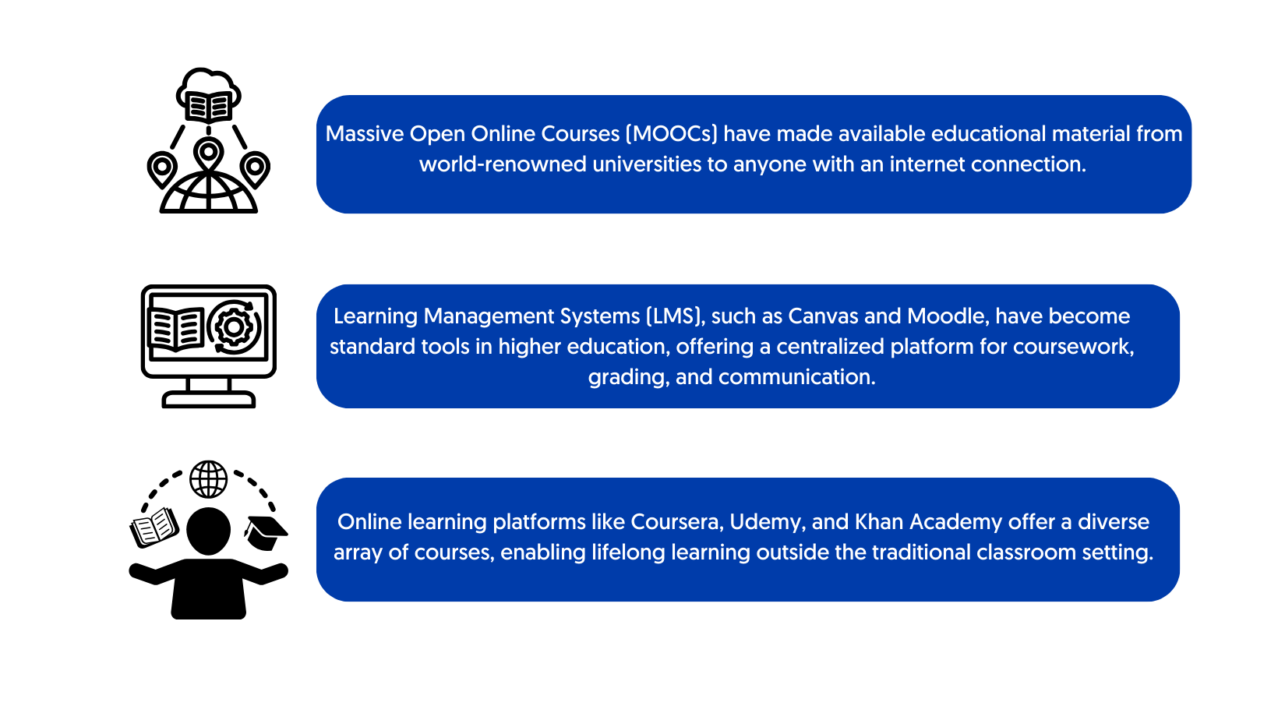
However, with this surge comes the critical need for inclusivity in digital learning environments. Inclusion is not merely about offering access but ensuring that everyone, regardless of their abilities, can fully participate and succeed in these settings.
- Inclusivity involves designing courses that are accessible to learners with disabilities, such as providing closed captions for video content or ensuring that course materials are compatible with screen readers.
- Inclusivity also means considering the diverse backgrounds of learners, incorporating culturally responsive teaching practices, and ensuring all students feel seen and valued in the digital classroom.
Transcription services play a crucial role in promoting inclusivity in online education. By converting spoken language into written text, these services ensure that course content is accessible to a broader audience, including those with hearing impairments or non-native speakers who may find written text easier to understand.
- Transcription services also support learning preferences, allowing learners who prefer reading to listening to engage with content in their preferred format.
- Implementing transcription services supports inclusive practices by ensuring every student has equal access to information, fostering a learning environment in which everyone can thrive.
Transcriptions: A Key to Accessible Learning
Transcriptions are textual records of spoken language. In the context of online learning, transcriptions often accompany video or audio lectures, providing a written version of the content that students can read at their pace.
- Transcriptions make it possible for individuals to access information in multiple formats, supporting diverse learning styles and preferences.
- They also facilitate ease of reference. Students can revisit specific sections of a lecture easily by referring to the transcription, without needing to rewind or fast-forward through video or audio content.
- Transcriptions serve as a valuable resource for students who want to review course material, supplement their notes, or study for assessments.
The use of transcription services significantly enhances learning accessibility.
- Transcriptions ensure that course content is accessible to individuals with hearing impairments, allowing them to engage fully with the material.
- Students for whom the content language is not their first language may find written text easier to understand than spoken language. Transcriptions support these students by providing them with a text-based version of the course content.
- Also, transcriptions assist in breaking down barriers for students with learning disabilities, such as dyslexia, who might find reading a transcription easier than following along with spoken language.
The value of transcriptions extends beyond accessibility, catering to students with different learning preferences.
- For visual learners, who comprehend information best when they see it, transcriptions provide an excellent tool for engagement and understanding.
- Kinesthetic learners, who learn best by doing, can benefit from transcriptions by highlighting, annotating, and taking notes directly on the text.
- Transcriptions also facilitate self-paced learning. Students can read at their own speed, pause to reflect, and review as necessary, enhancing their overall comprehension of the material.

Transcription for e-learning: How to make online courses more engaging
Read BlogAmberscript’s Contribution to Inclusive Online Education
Amberscript, a leading provider of transcription services, is revolutionising online education by making it more accessible and inclusive. Using state-of-the-art technology, Amberscript delivers highly accurate transcriptions, crucial for ensuring that all learners can access and fully engage with course content.
- Servicing educational institutions worldwide, Amberscript strives to support diversity and inclusion in the digital learning environment.
- Their advanced transcription services facilitate access to information in a text-based format, encouraging a more inclusive learning landscape.
Amberscript’s transcription services are powered by sophisticated speech-to-text technology capable of accurately transcribing audio and video content in real-time.
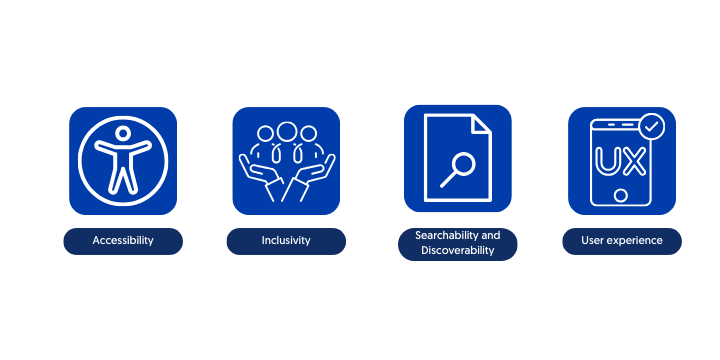
- This technology employs deep learning models, which have been trained on vast amounts of data, resulting in highly precise transcriptions.
- Despite the complexity behind the scenes, Amberscript’s interface is user-friendly, allowing educators to upload their audio or video files with ease.
- The technology also supports multiple languages, accounting for the global nature of online education.
Transcription in Action: Real-World Applications

Transcriptions can significantly enhance student engagement in online lectures and seminars. They serve as an interactive guide that students can readily refer to, helping to keep their focus and attention on the course material.
With the ability to highlight, underline, and make notes directly on the transcribed text, students actively participate in the learning process, contributing to a more profound and lasting understanding of the subject matter. Transcriptions also alleviate the stress of note-taking, freeing students to listen more attentively during the lecture or seminar. This transforms the learning experience from a passive reception of information to an active and immersive exploration of knowledge.
- In complex subject areas, such as Science, Technology, Engineering, and Mathematics (STEM), transcriptions can be invaluable. These fields often involve complicated terminologies and intricate concepts that can be difficult to grasp when delivered orally.
- Transcriptions provide students with a written record of these terminologies and concepts, allowing them to revisit, dissect and comprehend them at their own pace.
- By offering a visual representation of spoken content, transcriptions help clarify ambiguities and foster a deeper understanding of the subject matter, resulting in improved academic performance.
Additionally, transcribed materials play a crucial role in supporting research and academic development. They provide a textual record of interviews, lectures, and seminars that researchers can easily search, analyze, and reference.
- This is especially beneficial for qualitative research, where transcriptions enable researchers to capture the nuances of spoken language, such as tone and emphasis, providing richer data for analysis.
Finally, transcriptions serve as a valuable study aid, allowing students to review and consolidate their knowledge, reinforcing their academic development. In essence, transcription services are not just a tool for accessibility, but a strategic asset for academic success.
Tackling Transcription Challenges in E-Learning
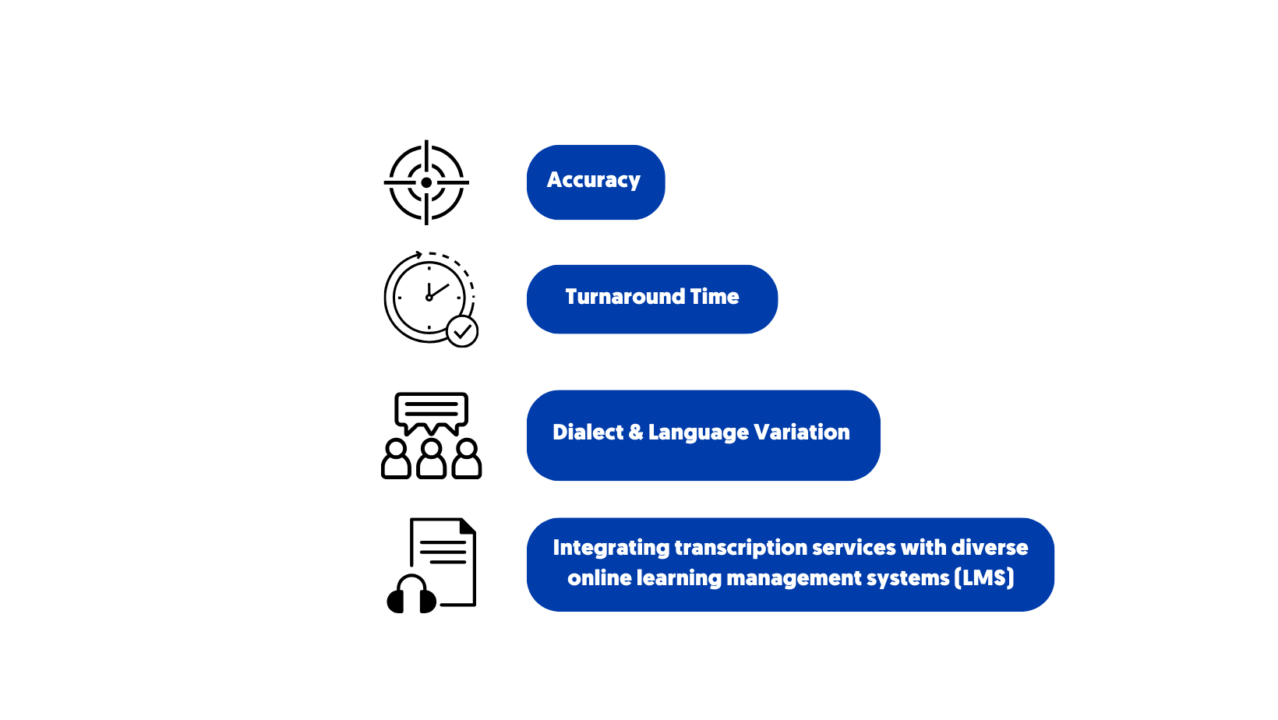
- One of the principal challenges in e-learning transcriptions is maintaining high levels of accuracy. Misinterpretations or inaccuracies in transcriptions can lead to confusion or misinformation, detracting from the educational experience.
- Turnaround time is another concern. Delays in transcription services can throw off course schedules and hinder the timely progression of educational modules.
To face these issues, Amberscript utilises an innovative speech recognition technology that not only ensures more than 95% accuracy but also provides transcriptions in near real-time, ensuring course continuity and comprehensive understanding for all learners.
- Dialects and language variations pose a significant challenge in transcribing educational content. Distinct regional accents or colloquial phrases can often be misunderstood or misinterpreted by conventional transcription services.
Amberscript addresses this issue by training its machine learning models on a vast array of speech data, encompassing various dialects and languages. This robust training allows the technology to recognize and accurately transcribe a wide spectrum of language nuances, ensuring that no learner is disadvantaged due to their regional accent or dialect.
- Integrating transcription services with diverse online learning management systems (LMS) can be complex. Each platform has its unique architecture and functionalities, requiring a versatile and adaptive transcription solution.
Amberscript’s transcription services are designed with flexibility in mind. The technology can integrate seamlessly with a wide array of LMS, including Moodle, Blackboard, and Canvas, among others.
This adaptability ensures that educators can incorporate Amberscript’s transcription services into their chosen LMS with ease, thereby enhancing the learning experience for students across various platforms. Ultimately, this contributes to a more inclusive and accessible e-learning landscape.
Benefits of using Amberscript
Amberscript’s services are:
Edit your text in minutes or leave the work to our experienced transcriptionists.
Our experienced transcriptionists and thorough quality controls ensure 100% accuracy of transcripts.
Through a series of integrations and API interfaces, you can fully automate your workflows.
Your data is in safe hands. We are GDPR compliant + ISO27001 and ISO9001 certified.
Success Stories: Universities and Amberscript
In addition to the previously mentioned institutions, the University of Amsterdam, a prominent European university, has also adopted Amberscript’s services. The university has fully integrated Amberscript’s transcription services into its e-learning programs, demonstrating the adaptability and utility of Amberscript’s technology in diverse academic settings.
 |
|
The introduction of Amberscript’s services has led to measurable improvements in academic outcomes at the University of Amsterdam. Examination scores have seen an upward trend, and course completion rates have improved.
Students at the University of Amsterdam have demonstrated increased engagement with course materials and more active participation in online discussions since the implementation of Amberscript’s services. This indicates the potent role that accurate transcriptions play in driving an immersive and interactive e-learning experience.

Choosing the Right Transcription Service for Universities
Read BlogThe Evolving Landscape of Transcription in Education
- The integration of transcription technology in online education is set to evolve dramatically in the coming years. Emerging trends include real-time transcription and translation services, which will further enhance the accessibility of e-learning for students across the globe.
- Artificial Intelligence (AI) and Machine Learning (ML) are poised to revolutionize transcription services, providing unparalleled accuracy and efficiency. These advanced technologies will be capable of adapting and learning from their mistakes, constantly refining their capabilities to deliver more accurate transcriptions.
- Another promising trend is the use of voice recognition technology to personalize learning experiences. This technology can adapt to individual learner’s speech patterns, accents, and language preferences, ensuring a more personalized and inclusive learning experience.
Amberscript is committed to championing these new developments in transcription technology. The team is consistently innovating and adapting its services to stay abreast of the evolving landscape of online education through:
- Continuous refinement of its machine learning algorithms to ensure the highest levels of accuracy, even as language and dialects evolve.
- Partnerships with educational institutions and LMS providers to further integrate and streamline its services within the online learning environment.
- Expanding collaborations with academic institutions and other stakeholders in the e-learning sector. This will enable the team to gain valuable insights into the evolving needs of the e-learning community and ensure that its services continue to support and enhance online education globally
- Leveraging emerging technological trends such as AI and voice recognition to further enhance its transcription services.
- Investing in research and development to refine and expand its technological capabilities.
How Universities Are Using Subtitles and Transcriptions to Bridge Language Gaps
The issue of language barriers in higher education is a topic that is becoming more and more important in today’s globalized world. As universities continue to attract diverse student populations from all over the world, it becomes crucial for institutions to address the challenges that come with such diversity. A major challenge that universities face is bridging the language gap between students and faculty members. This barrier not only affects international students but also non-native English speakers within the same country. In this blog, we will explore how universities are utilizing technology such as subtitles and transcriptions to overcome language barriers and create a more inclusive learning environment.
Table of contents
- Language Barriers In Education Today
- Subtitles and Transcription in Education
- Enhancing Learning Experience through Subtitles
- Transcription as a Tool for Academic Inclusivity
- Practical Applications in Diverse University Settings
- Overcoming Challenges and Implementing Solutions
- How Amberscript Can Assist Universities
- The Future of Educational Technology
Language Barriers In Education Today
Accessibility and inclusivity are crucial elements of a successful university. By creating an inclusive learning environment, universities can provide equal opportunities for all students to excel. This not only benefits the student body but also the institution as a whole in terms of diversity and global perspectives. With technology advancements, it has become easier for universities to ensure accessibility and inclusivity for all students, including those with language barriers. This not only helps students understand the course material better but also promotes a more diverse and accepting campus culture.

Subtitles and transcriptions have been traditionally used to aid individuals with hearing impairments, but their benefits go beyond that. These tools have now become essential for bridging language gaps in higher education. With the help of subtitles and transcriptions, universities can provide a more inclusive learning experience for all students, regardless of their native language or level of proficiency in the course language. Let’s explore how universities are leveraging these technologies to create a more accessible and inclusive learning environment.
Subtitles and Transcriptions in Education
Subtitles and transcriptions are both tools used to make audio or video content more accessible. Subtitles refer to written text displayed on-screen that corresponds with the spoken dialogue, while transcriptions are a written record of what is said in an audio or video recording. The main difference between the two is that subtitles are specifically timed to appear on screen during the corresponding audio, while transcriptions are a full written record of the spoken content.
These technologies have evolved significantly in educational settings over the years. Initially, subtitles were used mainly for foreign language films or shows, but now they are being utilized for educational videos and lectures as well. Similarly, transcriptions were primarily used for recording legal proceedings or interviews, but they are now being incorporated into online learning platforms to enhance accessibility.

Transcription Services for Universities: Enhancing Accessibility, Learning, and Research
Read the BlogThe need for accessible content in universities is evident, with the growing diversity of students on campuses. In the US alone, there are over one million international students and countless non-native English speakers enrolled in higher education.
Therefore it has now become crucial to provide solutions for individuals with language barriers, and subtitles and transcriptions have become essential tools to achieve this goal.
Enhancing Learning Experiences through Subtitles
For non-native speakers, subtitled lectures and videos can significantly improve their comprehension of course material. By having the spoken dialogue displayed on screen, students can better understand the content as they read along. This is especially helpful for individuals with lower proficiency in the course language.
Moreover, subtitles also facilitate language learning and bilingual education. By providing subtitles in both the native and target languages, universities can assist students in expanding their language skills. This not only benefits international students but also non-native speakers who are looking to improve their proficiency.
Several universities have successfully implemented subtitled content in their courses and have seen positive results. For instance, the University of Iowa has incorporated subtitled lectures for their foreign language courses, resulting in improved student understanding and retention of course material. Similarly, the University of Nottingham has seen success with providing subtitles in both English and Mandarin for their business courses, catering to their diverse student population from China.
Transcriptions as a Tool for Academic Inclusivity
For students with hearing impairments, transcriptions can be transformative, enabling equal access to educational content. The transcription of lectures, seminars, or other academic events means that these students won’t miss out on critical information. It allows them to engage with the material on their own terms, at their own pace, and revisit complex points, making the learning process less stressful and more effective. Besides, having access to transcribed course content can positively impact their note-taking skills, as they can focus on understanding and processing the information rather than rushing to write down every word. By combining transcriptions with other assistive technologies, universities can foster an inclusive learning environment that respects and supports the needs of students with hearing impairments.
Additionally, transcriptions can also be used for research interviews and academic presentations. These tools can assist any kind of students in taking thorough notes and understanding complex concepts better. For individuals with learning difficulties such as dyslexia, transcriptions can be a game-changer in their academic journey.
Some universities have embraced transcriptions as part of their commitment to inclusive education. The University of California, Berkeley provides real-time transcription services for students with hearing impairments, facilitating their participation in lectures and discussions. Similarly, the University of Leeds has a dedicated team that provides transcription services for students with diverse learning needs. These examples show how universities are actively utilizing transcriptions to create a more inclusive learning environment.
Practical Applications in Diverse University Settings
Universities around the globe are breaking down linguistic barriers in international webinars and guest lectures by using subtitles. When speakers and attendees come from various linguistic backgrounds, subtitles can act as a universal language that brings everyone onto the same page. They are a powerful tool that ensures everyone can participate fully and derive the maximum benefit from these academic events, regardless of their language proficiency.
Online courses and MOOCs often attract a diverse, expansive audience, creating the need for universal accessibility. Transcriptions of lecture materials serve this purpose, providing an accessible format that can be understood by non-native English speakers and individuals with hearing impairment. Additionally, the advantage of self-paced learning is amplified by transcriptions, as learners can revisit and digest complex information at their comfort, enhancing the learning experience and overall comprehension.
Multilingual support in the form of subtitles and transcriptions can significantly improve the efficiency and inclusivity of group projects and discussions in a multicultural academic environment. A subtitled presentation can help students learn their second language, ensuring effective communication and comprehensive understanding. Moreover, transcriptions of group discussions allow students to capture every detail of the conversation, revisit the discussion, and clarify any misunderstandings. These practices foster an inclusive environment in education, where everyone can contribute equally and collaborate effectively.
Overcoming Challenges and Implementing Solutions
While subtitles and transcriptions play a crucial role in ensuring inclusivity and global accessibility, ensuring their accuracy and timeliness poses a considerable challenge. Misinterpreted words or phrases can alter the meaning of the content, leading to misunderstandings. To mitigate this, universities can leverage advanced speech recognition technologies and AI to generate accurate subtitles and transcriptions in real-time. Periodic reviews and edits by human moderators can further enhance the precision of the content, ensuring a seamless academic experience for all students.
Translating educational content is not just about word-for-word conversion; it also involves capturing the cultural and contextual nuances to maintain the essence of the original message. This can be challenging when catering to an international audience with diverse cultural backgrounds. To tackle this, universities can employ skilled translators who understand the cultural context and can translate academic content while preserving its original intent and meaning. Further, employing localization techniques can help institutions adapt the content to suit the cultural and linguistic preferences of their global student body.
For successful integration of these technologies, universities need to adopt a strategic and systematic approach. Firstly, assessing the needs and challenges of their diverse student population can help universities identify the areas where subtitles and transcriptions are most required. Secondly, incorporating regular training for faculty and staff on using these technologies can ensure their optimal utilization. Lastly, a continuous evaluation process to review the effectiveness and accuracy of the subtitles and transcriptions will ensure that these tools meet their objective of promoting inclusivity and global accessibility.
How Amberscript Can Assist Universities
Amberscript is at the forefront of providing advanced speech recognition technology that aids in making educational content more accessible. Our services are tailored to meet the distinct needs of universities, ensuring a more inclusive academic environment.
Amberscript offers a range of solutions specifically designed for educational institutions. Among these are automatic and manual transcription services, automatic and human-made subtitling, as well as translation services. These tools aid in the creation of accessible content for online courses, webinars, group discussions, and more, ensuring every student has equal opportunities for academic success.
AI-driven speech recognition technology is especially useful to generate accurate subtitles and transcriptions in real-time. This technology is capable of capturing and converting spoken language into written words with remarkable precision. Additionally, human-made services are also available, where transcriptions and subtitles are reviewed and edited by skilled professionals, ensuring ultimate accuracy and context preservation.
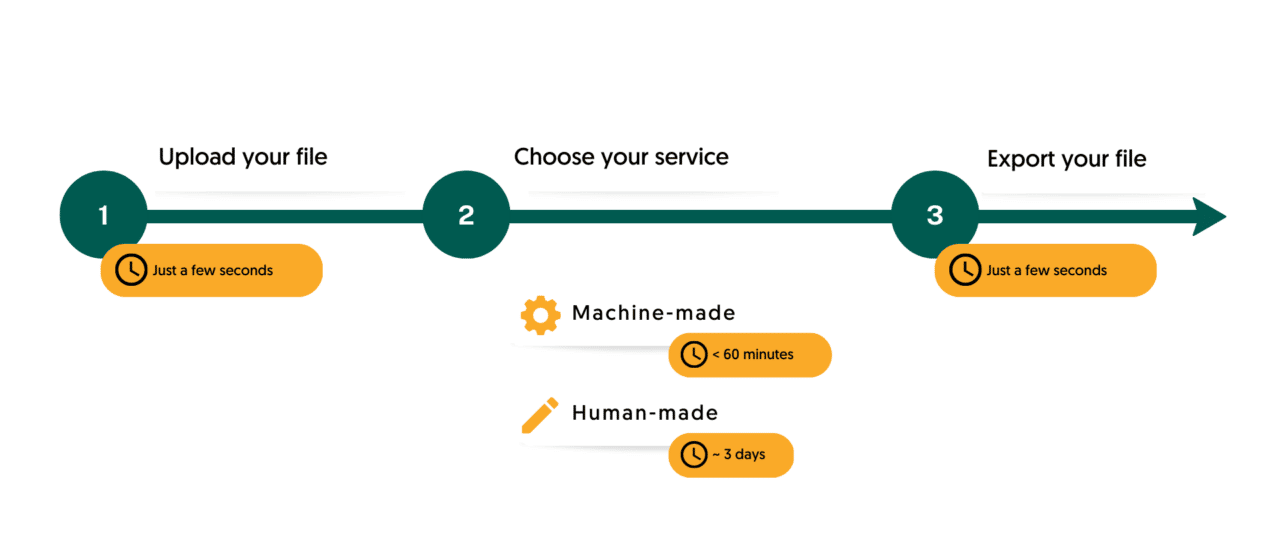
Numerous universities have benefited from Amberscript’s solutions. For instance, Maastricht University in the Netherlands has been using Amberscript’s services to transcribe their lectures and seminars, making them accessible to a wider student population. Moreover, the University College London employed Amberscript’s automatic subtitling service for their online course materials, improving accessibility and comprehension for international students and those with hearing impairments.
Universities seeking to enhance their language accessibility can partner with Amberscript to benefit from their industry-leading solutions. The partnership process is simple and collaborative, involving an initial consultation to understand the university’s specific needs, followed by the deployment of tailored services. Amberscript’s dedicated customer support ensures a seamless implementation process and continuous assistance for optimal utilization of their services. Through this partnership, universities can significantly improve their language accessibility, fostering an inclusive and globally accessible academic environment.
The Future of Educational Technology
As we look to the future, educational technology continues to evolve at an impressive pace. Universities must stay abreast of these advancements to provide inclusive, accessible, and high-quality education to their students.
Emerging trends include real-time subtitles and transcriptions, which allow instant conversion of spoken words into written form during live lectures or webinars. There’s also the potential for biometric voice recognition, where the technology would recognise and adapt to individual speakers, resulting in a more personalised and accurate transcription. These technologies are becoming more sophisticated and accurate, providing immense potential to make education more accessible and engaging.
Artificial Intelligence (AI) and Machine Learning (ML) have a profound impact on language accessibility. AI-driven software can learn and adapt to different dialects, accents, and speech patterns, enhancing the accuracy of translations, subtitles, and transcriptions. Additionally, ML algorithms can understand context, detect errors, and make corrections, providing precise and high-quality content. These technologies are continuously learning and improving, promising a future where language barriers in education become obsolete.
To stay ahead, universities must foster a culture of innovation and open-mindedness towards technology. Encouraging faculty and staff to embrace these technologies and providing them with the necessary training is vital. Universities should also establish partnerships with tech companies like Amberscript to leverage their expertise and innovative solutions. Regular evaluation of the effectiveness of these technologies and seeking feedback from students and faculty can ensure they are meeting their objectives. Proactively seeking out and investing in emerging technologies in their nascent stages can also give universities a competitive edge. In this rapidly evolving landscape, those who are forward-thinking and adaptive will lead the way in providing globally accessible and inclusive education.
Best Practices for Subtitling University Lectures: Creating Accessible Video Content
With the advent of digital technologies, video content has become an indispensable tool in university education. It paves the way for interactive, engaging, and flexible learning experiences, enabling students to learn at their own pace and revisit complex topics.
Table of Contents
- Video Content Accessibility
- Fundamentals of Subtitling in Academic Settings
- Improving Learning through Subtitles
- Best Practices in Educational Subtitling
- Technology’s Role in Subtitling
- Amberscript’s Solutions for University Lectures
- Case Studies: Universities and Amberscript
- Navigating Subtitling Challenges
- Looking Forward: Subtitles in Future Education
Video Content Accessibility
Equally important is the creation of accessible video content, considering the diverse learning needs of students. Accessibility isn’t just about adhering to legal standards; it’s about cultivating an inclusive learning environment where every student, irrespective of their abilities, can thrive.
Subtitling plays a significant role in this regard. It ensures that hearing-impaired students can comprehend the lecture content, and also aids those for whom English may not be their first language. Subtitles, thus, make video content more accessible and inclusive, reinforcing the university’s commitment towards equal educational opportunities for all.
Fundamentals of Subtitling in Academic Settings
Effective subtitles for educational videos should:
- Be accurate and true to the original spoken word
- Be synchronized with the audio, ensuring it aligns with the speakers on screen
- Use simple language to cater to non-native English speakers and those who use reading aids
- Include relevant non-verbal cues or environmental sounds for the hearing impaired
While educational and entertainment subtitling aim to make content accessible, their focus differs in the following ways:
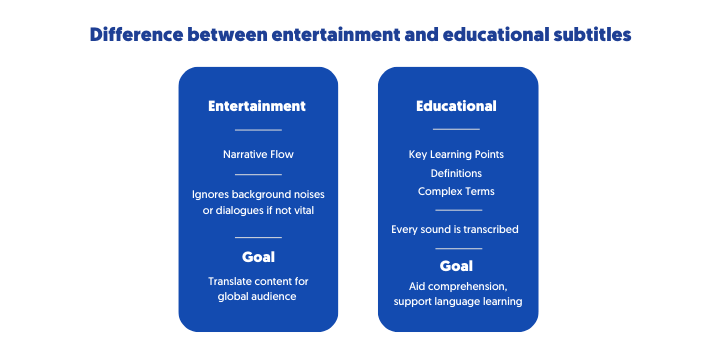
These different kind of subtitles offer various formats and tools:
- Popular formats include SubRip (SRT), which is widely compatible, and WebVTT, optimized for web use
- Tools like Aegisub or Subtitle Edit offer comprehensive features for creating and editing subtitles
- Platforms like YouTube or Vimeo have built-in subtitling features, while universities might use specialized e-learning platforms that integrate subtitling
Improving Learning through Subtitles
Subtitles in educational videos are a lifeline for students with hearing impairments. These students, who may face significant challenges in a traditional lecture environment, can experience inclusivity through subtitled content.
- Facilitates comprehension: Subtitles provide a textual representation of the spoken content, enabling students with hearing impairments to follow and understand the lectures.
- Enhances engagement: With subtitles, these students can actively participate in discussions and assessments, thereby enhancing their learning experience.
Additionally, subtitles have become crucial in breaking down language barriers for students for whom English isn’t their first language.
- Assists in understanding: Subtitles in English can aid these students in comprehending complex academic content that they might otherwise struggle to follow.
- Improves language skills: Regular exposure to subtitled videos can help non-native speakers enhance their English vocabulary, grammar, and language proficiency.
Finally, for all students, subtitles can provide a powerful boost to their learning experience.
- Reinforces auditory learning: Subtitles can help students recapitulate what they’ve heard, leading to better retention and understanding.
- Encourages active learning: By reading along with the spoken word, students engage both their auditory and visual senses, promoting active learning.
- Supports revision: Subtitles can serve as a useful tool during revision, enabling students to quickly skim through the video content and focus on key points.

Subtitles for the creation of educational content in different languages
Learn more !Best Practices in Educational Subtitling
In the field of educational subtitling, accuracy and clarity are paramount. This necessitates several key principles:
- Thorough transcription: Every spoken word, non-verbal cue, and relevant environmental sound should be transcribed for maximum comprehension.
- Simplicity: The language should be simple and easy to understand. Complex technical jargon should be explained or replaced with more understandable terms whenever possible.
- Use of proper punctuation and grammar: Proper use of commas, periods, and other punctuation aids readability and comprehension.
Additionally, educational subtitling requires adherence to certain language norms and standards:
- Formal language: The language style should align with the academic rigor of the content, which is typically more formal than conversational language.
- Consistent terminology: Consistency in the use of terms, especially technical or subject-specific terms, is essential to avoid confusion.
- Text readability: Subtitles should be easy to read, meaning that the font size, color, and positioning should favor readability over aesthetic considerations.
Finally, timing and synchronization in educational videos are of utmost importance to ensure comprehension and engagement:
- Synchronization: The subtitles should accurately align with the spoken words. Any delay or advancement can lead to confusion.
- Display time: The time a subtitle stays on the screen should be long enough for viewers to read and comprehend it. This is typically calculated based on the reading speed.
- Transition: Subtitles should smoothly transition from one to the next, ensuring there is no disruption in understanding the content.

Enhancing University Education with AI-Driven Transcription & Subtitling
Learn more !Technology’s Role in Subtitling
There are many softwares and tools available that significantly aid the subtitling process.
- Subtitle Edit: This is open-source software that supports a wide range of subtitle formats. It includes features like spell checking, translation mode, and time adjustment.
- Aegisub: Advanced subtitling editor that supports the creation of complex subtitles. It offers features such as real-time preview of subtitles, and a powerful scripting environment for automation.
- Amara: A web-based platform ideal for collaborative subtitling efforts, allowing users to create and edit subtitles together.
As for the advent of AI and automation technology, it has brought about significant changes in the subtitling industry.
- Efficiency and speed: AI can generate subtitles at a rapid pace, significantly reducing the turnaround time.
- Speech recognition: AI technologies can automatically transcribe audio into text, paving the way for auto-generated subtitles.
- Translation: AI can also facilitate automatic translation of subtitles into various languages, making content more accessible to a global audience. However, it’s important to note that AI translations may not always capture the nuances of language and culture.
While technology has certainly been an asset for the subtitling industry, it is also essential to assess the effectiveness and limitations.
- Accuracy: While AI and automation have increased efficiency, they might not always guarantee accuracy. Human intervention is often required to ensure that the subtitles accurately represent the spoken words.
- Cultural nuances: Tech-driven subtitles can sometimes miss cultural nuances, slang, or colloquial language, which might be crucial for the intended audience’s understanding.
- Integration with platforms: The technology used for subtitling needs to be compatible with various content platforms, such as YouTube, Netflix, or various e-learning platforms. This integration can sometimes be challenging.
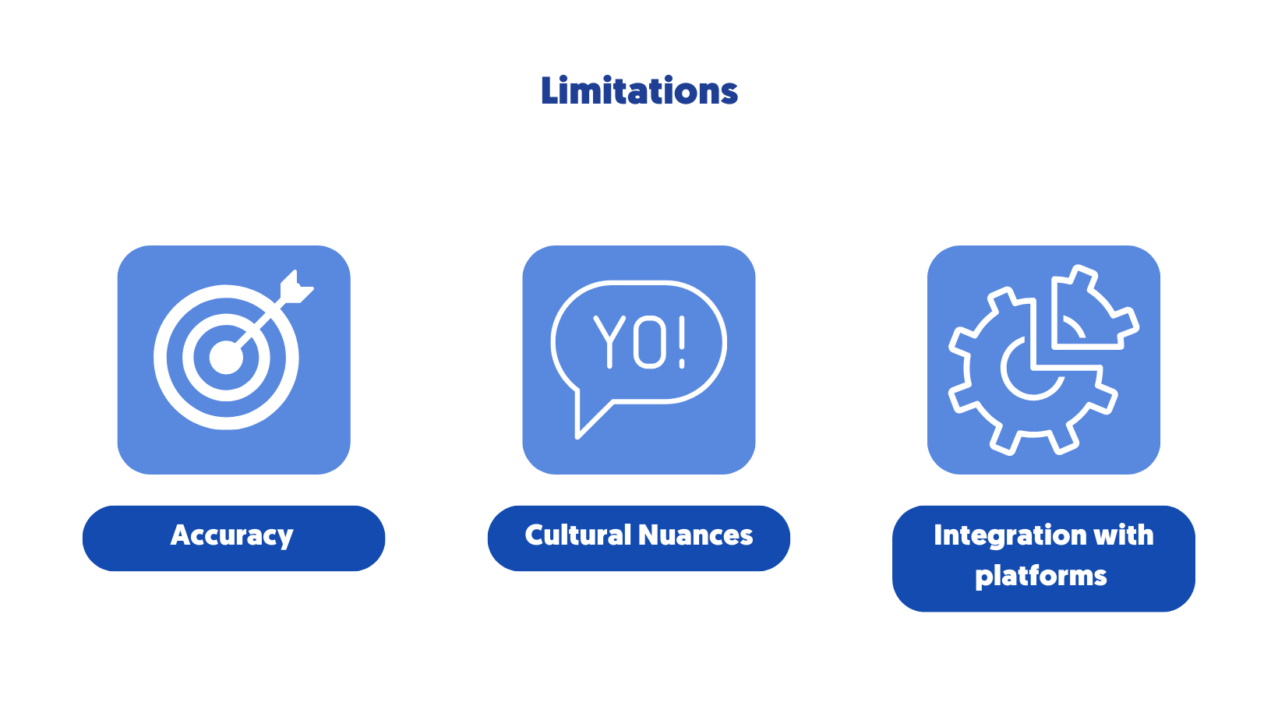
Amberscript’s Solutions for University Lectures
Amberscript, a prominent player in the industry of automated transcription and subtitling services, offers solutions tailored for educational content. Leveraging state-of-the-art speech recognition technology, it delivers high-quality, accurate subtitles for a diverse array of educational materials, including university lectures.
Amberscript’s advanced AI-driven technology ensures the generation of precise and timely captions for university lectures:
- High Accuracy: The speech-to-text algorithms are trained on a vast array of datasets, enabling them to proficiently handle various accents, dialects, and technical terminologies.
- Fast Turnaround: The automation capabilities of Amberscript expedite the subtitling process, delivering results in a fraction of the time taken by traditional methods.
- Sync and Edit: The platform provides tools for checking and adjusting the synchronization of subtitles, ensuring they align perfectly with the audio.
- Easy Integration: Amberscript allows users to export the subtitles in various formats, making it easy to integrate with multiple platforms.
Choosing Amberscript for subtitling your educational content provides a host of advantages over other alternatives:
- Cost-effective: Outsourcing to Amberscript eliminates the need for in-house expertise in subtitling, thereby saving on training and operational costs.
- Scalability: Amberscript’s solutions are designed to handle large volumes of content, making it ideal for institutions with extensive lecture material.
- Efficiency: With Amberscript, the focus can stay on core educational tasks, leaving the audio-to-text conversion and subtitling to the experts.
- Quality: Despite the rapid turnaround times, the quality of the subtitles is maintained, ensuring the content remains accessible and comprehensible to all students.
Case Studies: Universities and Amberscript
The University of Amsterdam integrated Amberscript’s subtitling services to enhance the accessibility of their online course materials.
Subtitles were added to a wide range of digital lectures, seminars, and educational videos across multiple disciplines which led to a significant increase in engagement from international students and those with hearing impairments.
|  |
 |
|
The collaborations between these universities and Amberscript have led to several insights and best practices.
- Continuous Feedback Loop: Regular feedback from users – faculty, students, and administrative staff – is critical in refining and improving the services.
- Customization: Recognizing the unique requirements of each institution and customizing the services accordingly leads to better results.
- Training: Though Amberscript’s solutions are intuitive, providing adequate training to users ensures they can make the most of the features.
- Integrations: Smooth integration with the existing Learning Management System (LMS) and other educational platforms is key to streamlining the content creation and distribution process.
Navigating Subtitling Challenges
Common Challenges in Subtitling Academic Content
Technical Terminology: Academic lectures often contain complex, discipline-specific language which can be difficult to transcribe accurately.
Accent Diversity: Academic institutions often host a diverse faculty base, which can lead to a wide variety of accents that can be challenging to transcribe.
Long Duration: Academic lectures can run for extended periods, making the task of subtitling more demanding and time-consuming.
Contextual Understanding: Grasping and transcribing the context accurately in academic content is crucial, yet challenging.
Strategies for Maintaining High-Quality Subtitles
Ensuring high-quality subtitles requires adopting certain strategies:
- Training the AI: The AI used for transcription and subtitling should be trained on diverse datasets to handle various accents, dialects, and technical terminologies effectively.
- Thorough Review: Before finalizing, subtitles should be reviewed and edited for accuracy, context understanding, and proper synchronization with the audio.
- Continuous Learning: The AI should be designed to learn from its errors and improve over time.
- Employing Human Experts: In cases where the AI struggles, human transcriptionists or translators should be used for reviewing and refining the subtitles.
Cost, Efficiency, and Quality Balance in Subtitling
Balancing cost, efficiency, and quality in subtitling involves:
- Automation: Implementing AI-driven solutions can expedite the subtitling process and bring down costs.
- Quality Assurance: Despite the use of automation, maintaining a human review system can ensure the quality of subtitles.
- Scaling: A scalable solution not only keeps costs in check but also maintains efficiency, even when the volume of content increases.
- Investment in Technology: An initial investment in robust, cutting-edge technology can result in long-term savings, delivering high-quality subtitles efficiently.
Looking Forward: Subtitles in Future Education
The Evolving Importance of Subtitles in Educational Content
The role of subtitles in education is evolving rapidly with the rise of digital learning platforms. As educational content becomes more diversified and accessible, the importance of subtitles grows.

- Increasing Accessibility: Subtitles make content accessible to a wider audience, including non-native speakers and the deaf or hard of hearing community.
- Enhancing Comprehension: Subtitles can improve comprehension and retention of information, especially in complex academic lectures.
- Facilitating Multimodal Learning: Subtitles cater to visual learners, complementing auditory learning and enhancing the overall learning experience.
Future Trends in Subtitling and Educational Technology
AI and Machine Learning: AI subtitling will become more sophisticated, with machine learning algorithms improving the accuracy and speed of transcription and translation.
Integration with AR/VR: Subtitles may be integrated with augmented and virtual reality platforms to provide immersive learning experiences.
Personalized Learning: Future subtitling solutions may offer personalization options; learners could adjust the speed, font, or language of subtitles to suit their preferences.
Encouraging Universities to Embrace Subtitling for Inclusive Education
Emphasizing the Benefits: Showcasing the success stories of other universities and the positive impact on student learning can encourage initial uptake.
Providing Training and Support: Universities may need support in implementing and using subtitling tools, so offering training and ongoing support is essential.
Establishing Policies: Governments and educational authorities can play a part by establishing policies that mandate or incentivize the use of subtitles for educational content.
Creating a Multilingual-Friendly Campus: Best Practices for Implementing Subtitles and Transcriptions
Table of Contents
- Global Education Trends
- The Role of Subtitles and Transcription in University Education
- Implementing Subtitles and Transcription in University Settings
- Amberscript Tailored Solutions for Universities
- Industry-Specific Challenges and Solutions
- Enhancing University Reputation and Global Reach
Global education trends
In today’s interconnected world, universities are becoming melting pots of cultures and languages. This diversity enriches our campuses but also highlights a crucial need: effective multilingual support. It’s not just about fostering inclusivity; it’s about equipping our students and faculty with the tools they need to thrive in a global educational environment. Recognizing and addressing this need is key to staying ahead in the dynamic landscape of higher education.
Let’s talk about a practical solution – subtitles and transcriptions. In a classroom buzzing with diverse linguistic backgrounds, these tools are invaluable. They go beyond just aiding non-native speakers; they enhance overall comprehension, aid in note-taking, and ensure that students with hearing challenges are not left behind. The result? A more inclusive, effective learning environment where every student has the opportunity to excel.
Amberscript understands the unique challenges faced by universities in this multilingual era. Tailored solutions have been created to meet these needs head-on. With advanced AI technology, Amberscript provides precise and efficient subtitles and transcriptions, making educational content accessible to all. It’s about breaking down language barriers and opening up a world of knowledge to every student and educator on your campus. Let’s explore how Amberscript can transform your university’s approach to multilingual education.
The Role of Subtitles and Transcriptions in University Education
Breaking down language barriers
For non-native speakers, understanding every word in a lecture can be challenging. Subtitles and transcriptions bridge this gap. They transform spoken language into readable text, making it easier for these students to follow along, comprehend the material, and fully participate in their educational journey.
Ensuring Accessibility
Accessibility in education is a must. Students with hearing impairments can feel isolated in a traditional lecture setting. Subtitles and transcriptions ensure they have equal access to information, promoting an inclusive learning environment where every student has the opportunity to succeed.
Improving focus and comprehension
Visual aids like subtitles can significantly enhance focus and understanding, especially in courses involving complex or technical subjects. They provide a visual reinforcement of spoken words, aiding memory retention and making complicated concepts easier to grasp.
Study Aids
Transcriptions are also invaluable efficient tools for note-taking and revision. They allow students to revisit lectures at their own pace, ensuring they can absorb and understand the material thoroughly. This not only aids in better preparation for exams but also fosters a deeper understanding of the subject matter.
Implementing Subtitles and Transcriptions in University Settings
Subtitles and transcriptions are essential tools in the world of education, especially in university settings. These technologies help improve accessibility for students and enhance the overall learning experience. In this document, we will explore the various aspects of implementing subtitles and transcriptions in universities.
Essential Technologies and Tools
To effectively implement subtitles and transcriptions in universities, certain technologies and tools are necessary. These include:
- Captioning and transcription software: This is the core technology needed to create subtitles and transcriptions. There are various software options available, each with its own features and capabilities.
- Audiovisual equipment: Universities must have the necessary equipment for recording lectures, presentations, and other educational materials that require subtitling or transcription. This includes microphones, cameras, and recording devices.
- Storage and distribution platforms: Once the subtitles and transcriptions are created, they need to be stored and distributed to students. Universities can use content management systems or learning management systems for this purpose.
- Accessibility tools: As mentioned earlier, the main purpose of subtitling and transcription is to improve accessibility for students. Therefore, universities must have accessibility tools in place, such as screen readers or captioning software for students with hearing impairments.
Quality and Accuracy
While implementing subtitles and transcriptions is important, ensuring their quality and accuracy is equally crucial. In an educational setting, where students rely on these tools to understand and learn, any errors or inaccuracies can greatly impact their learning experience. Therefore, it is essential to follow best practices to maintain high-quality and accurate subtitles and transcriptions. These can include:
- Proofreading: Before distribution, it is important to thoroughly proofread subtitles and transcriptions to catch any errors or typos.
- Quality checks: Implementing quality checks during the creation process can help identify and fix any mistakes early on.
- Transcription guidelines: Following established transcription guidelines, such as those set by the National Court Reporters Association (NCRA), can help maintain consistency and accuracy.
- Collaboration with subject matter experts: In some cases, collaborating with subject matter experts can ensure that technical or specialized terminology is transcribed accurately.
Best Practices in Workflow Integration
Efficiently integrating subtitling and transcription services into existing university systems and processes is crucial for seamless and effective implementation. Here are some best practices to keep in mind:
- Establish a clear workflow: Defining a clear workflow that outlines the steps involved in creating and distributing subtitles and transcriptions can help streamline the process.
- Assign roles and responsibilities: It is important to assign specific roles and responsibilities to team members involved in implementing these services. This ensures accountability and helps avoid any confusion.
- Invest in training: Providing proper training to individuals responsible for creating subtitles and transcriptions can greatly improve the quality and accuracy of these tools.
- Use automation tools: There are various automation tools available that can help speed up the subtitling and transcription process, such as speech recognition software or automatic timestamping.

Subtitles for e-learning
Read the blogAmberscript’s Tailored Solutions for Universities
Amberscript is a company that specializes in providing tailored transcription and subtitling solutions to universities. With years of experience in the field, Amberscript offers customized services to meet the specific needs of different departments and courses within universities.
Customized Services for Different Needs
Universities have various requirements when it comes to transcription and subtitling services. Amberscript understands this and offers customized solutions to cater to these needs. Whether it is for lectures, seminars, or other academic events, Amberscript has the expertise to transcribe and subtitle content with accuracy and precision.
Multilingual Support
In today’s globalized world, universities often have a diverse student body with students speaking different languages. Amberscript’s tailored solutions include multilingual support, ensuring that all students can access the content in their preferred language. With a wide range of language offerings, Amberscript makes sure that language is not a barrier to learning.
Improved Accessibility
One of the key benefits of Amberscript’s tailored solutions is improved accessibility for students with disabilities. With accurate transcripts and subtitles, students with hearing impairments can also access course content easily. This ensures that no student is left behind and promotes inclusivity within the university.
Benefits of using Amberscript
Amberscript’s services are:
Edit your text in minutes or leave the work to our experienced subtitlers.
Our experienced subtitlers, voice actors and thorough quality controls ensure 100% accuracy of transcripts, subtitles and dubbing services.
Through a series of integrations and API interfaces, you can fully automate your workflows.
Your data is in safe hands. We are GDPR compliant + ISO27001 and ISO9001 certified.
Industry-Specific Challenges and Solutions
As universities continue to evolve and adapt to the changing needs of students, they face a multitude of challenges. These challenges are not limited to academic excellence, but also extend to industry-specific obstacles that require innovative solutions. In this section, we will discuss some of the unique challenges faced by different faculties in universities and how tailored solutions can be implemented. We will also explore the importance of overcoming technical jargon and terminology barriers in order to accurately represent specialized language.
Addressing Unique Challenges in Different Faculties
The challenges faced by universities vary greatly between faculties. For example, the sciences may face difficulties with securing funding for research projects, while humanities may struggle with attracting students due to a perceived lack of career opportunities. Other disciplines may face challenges related to diversity and inclusion, such as providing resources for students with disabilities or creating a welcoming environment for international students.
To overcome these challenges, universities must tailor their solutions to the specific needs of each faculty. This can be achieved through open communication and collaboration between faculty members and university administrators. By understanding and addressing the unique challenges faced by different faculties, universities can create a more supportive and inclusive environment for all students.
Overcoming Technical Jargon and Terminology Barriers
In addition to faculty-specific challenges, universities also face the obstacle of technical jargon and specialized terminology. This can be particularly daunting for students who are new to a particular discipline or language. It is important for universities to provide resources and support for students in understanding and using these terms accurately.
One solution could be the implementation of specialized language courses or workshops, where students can learn and practice using technical terminology in a supportive environment. Universities can also provide online resources and glossaries to assist students in understanding complex concepts and terms. By addressing these barriers, universities can ensure that all students have equal opportunities for academic success.
Enhancing University Reputation and Global Reach
The reputation of a university is often determined by its academic excellence, research capabilities, and the success of its students. However, another important aspect that contributes to a positive university image is building an inclusive and diverse academic community. This not only creates a welcoming environment for all students and faculty, but it also attracts international talent.
Importance of Multilingual Support
With the rise of globalization and an increasingly interconnected world, universities are becoming more diverse with students and faculty from different cultural and linguistic backgrounds. It is important for a university to provide multilingual support to ensure that all members of the academic community have equal access to resources and opportunities. This includes providing translations for important documents and communication, as well as offering language courses and support services for non-native speakers.
Multilingual support not only benefits international students and faculty, but it also enhances the overall academic experience for all members of the community. It promotes cross-cultural understanding, communication, and collaboration among students and faculty from different backgrounds, which can lead to a more enriching learning environment.
Positive Impact on University Image
By offering multilingual support, universities showcase their commitment to diversity and inclusivity. This can attract students and faculty from around the world who are looking for a welcoming and supportive academic community. It also demonstrates that the university values cultural diversity and is dedicated to providing equal opportunities for all its members.
Moreover, having a diverse academic community can also enhance the university’s reputation in terms of research and innovation. With a diverse pool of talent, universities can foster unique perspectives and ideas, leading to groundbreaking discoveries and advancements.
Attracting International Talent
Accessible education is key in attracting international talent to a university. By providing multilingual support, universities ensure that language barriers do not hinder students or faculty from accessing quality education. This also includes offering scholarships and financial aid to students from underrepresented backgrounds, making education more accessible and attractive to a diverse group of individuals.
Universities with a reputation for inclusivity and diversity are highly sought after by international students who are looking for a supportive and welcoming environment. By building an inclusive academic community through multilingual support, universities can attract top talent from around the world, further enhancing their global reach and reputation.
So, let’s embrace diversity and inclusivity in our academic community and reap the benefits together!
Multilingual Campus: How Subtitles and Transcriptions Empower Non-Native Speakers
Table of Contents
- Background Information
- The Language Barrier in Global Communication
- The Power of Subtitles and Transcriptions
- Amberscript Role in Bridging the Gap
- The Technology behind effective subtitling and Transcription
- The Future of Accessible Communication
Background information
Inclusive Communication
In today’s dynamic world, the landscape of global media and communication is constantly evolving, powered by rapid technological advancements and the expanding reach of the internet. This evolution has reshaped how we access and consume media, reshaping geographical and cultural boundaries to create a global community. The expansion of digital platforms and social media has democratized content creation and distribution, enabling voices from all over the world to be heard. With streaming services offering diverse content across languages and regions, and social networks connecting people across continents, the barriers of traditional media have been significantly reduced.
However, this global interconnectedness brings to light a new challenge: ensuring accessibility for all. Accessibility is no longer a luxury but a necessity in a world where inclusivity is key to fostering mutual understanding and respect across diverse cultures and languages.
Amberscript’s Mission
Amberscript is the solution for breaking down language barriers, through innovative subtitle and transcription services. Amberscript employs cutting-edge technology and expertise to ensure content is not only accessible but also resonates across different linguistic backgrounds, recognizing the diverse needs of a global audience . It is more than a technical solution; we embody a commitment to inclusivity and understanding, making communication seamless and more accessible for everyone.

Focusing on Non-Native Speakers
At the heart of our discussion is the transformative impact of subtitles and transcriptions on non-native speakers. Imagine trying to navigate a world where the language spoken is not your own. Now, think about how subtitles and transcriptions can change this scenario. They are not just tools for understanding; they are bridges connecting non-native speakers to a world of information, entertainment, and education that might otherwise be out of reach. Through these services, people can enjoy movies, attend online courses, and access vital information without the language barrier being an obstacle.
In our digitally inclusive world, the importance of this topic cannot be overstated. We’re not just talking about providing subtitles or transcripts; we’re talking about empowering individuals with the freedom to explore and interact with content on their terms. This inclusivity is essential in a world where digital content is a primary source of learning, entertainment, and news. By focusing on the needs of non-native speakers, we’re acknowledging the diversity of languages and cultures that make up our global community. It’s about recognizing that in our digital age, access to information in one’s own language is not just a convenience but a fundamental right, creating a more inclusive and connected world.
The Language Barrier in Global Communication
Understanding the Challenges

- For non-native speakers, the world of entertainment can often feel like a closed book. Movies, TV shows, and online content predominantly produced in English can be challenging to follow. This language barrier not only hinders understanding but also limits the emotional connection that comes with storytelling. The cultural references, idioms, and slang that are often integral to entertainment content can further alienate non-native audiences, making them feel disconnected from a global cultural experience.

- As for education, it presents its own set of challenges. Since online courses and educational resources are increasingly becoming available primarily in English, non-native speakers may struggle to keep up with the pace of instruction or grasp complex concepts. This language barrier can lead to frustration, a sense of inadequacy, and ultimately, a significant impediment to learning and personal development. The complexity of academic language, special terminologies, and the context of certain subjects can further complicate comprehension.

- In professional settings, non-native speakers may face difficulties in comprehending business communication, technical documents, or participating effectively in meetings and conferences conducted in English. This not only impacts their performance but also limits their opportunities for career advancement. In a world where English is often the bridge language of business, not being proficient can be a considerable disadvantage, leading to a lack of confidence and a sense of exclusion in the workplace. This can be seen in the medical sector for instance.
These challenges highlight the importance of making digital content accessible and inclusive. Subtitles, captions and transcriptions, and other language support services play a crucial role in mitigating these barriers, allowing non-native speakers to participate more fully in all aspects of digital life. By addressing these language-related obstacles, we open up a world of possibilities for a significant portion of the global population, fostering a more inclusive and equitable digital environment.
Statistical Insights and Real-Life Scenarios

- A report from the Common Sense Advisory found that 75% of consumers prefer to buy products in their native language, and 60% rarely or never buy from English-only websites.
- Research from the European Commission showed also that only 25% of internet users across Europe always use websites in a language that is not their own.
- Over 40% of the global population does not have access to education in a language they speak or understand according to UNESCO.
These statistics are quite straightforward: a significant portion of the global population faces a language barrier in accessing digital content, impacting their choices, education, and overall online experience.
Here are some real-life scenarios:
- Entertainment: Consider Sofia, a Spanish-speaking film enthusiast. Despite her love for international cinema, she often misses out on critically acclaimed films due to the lack of Spanish subtitles. Her experience underscores how language barriers can limit cultural exchange and enjoyment in the entertainment sector.
- Educational Environment: Ali, a student from Egypt, faced challenges while attending an online course from a prestigious university. The course, delivered in English, was difficult for him to follow, leading to a sense of frustration and disengagement. This example highlights the importance of language support in educational inclusivity.
- Professional Environment: Maria, a skilled IT professional in Brazil, often finds herself at a disadvantage in global conferences and technical training sessions conducted in English. Her struggle to keep up with the pace of English-speaking presenters impacts her professional growth and confidence.
These situations bring into focus the human impact of the language barrier. They demonstrate the urgent need for solutions like subtitles and transcriptions that can bridge the linguistic divide, making digital content more accessible and inclusive for non-native speakers worldwide.
The Power of Subtitles and Transcription
Educational Access
- Improved Understanding: Subtitles and transcriptions can play a crucial role in helping non-native speakers grasp complex concepts and terminology in their second language. By providing written text alongside spoken words, learners can better understand and retain information.
- Language Skills Development: These tools also offer an opportunity for language learning. Non-native speakers can improve their vocabulary, spelling, and grammar skills by simultaneously reading and listening to content in a foreign language.
- Accessibility for Diverse Learning Styles: Different individuals have different learning styles. Visual learners, for example, can benefit significantly from reading subtitles or transcriptions, making the learning process more inclusive.
Khan Academy (2020)
As a nonprofit educational organization, Khan Academy started using the Amara Community solution in 2020. This service enabled their contributors and volunteers to translate educational videos, lessons, and course materials into multiple languages, thus making them accessible to students globally.
Entertainment for Global Audiences
The role of subtitles in making entertainment content universally accessible and enjoyable is significant, especially in the context of global film and television consumption among non-native audiences. Streaming services, like Netflix, have fundamentally altered the landscape of global media distribution. By offering a diverse array of content and relying on subscriber support, these services have opened the door to a new era of media consumption, characterized by a wide choice of services and substantial audience fragmentation.
As a result, these services have accelerated the internationalization of video businesses and consumption, reshaping the accessibility of video content produced outside the Hollywood system. For instance, a study of Netflix’s library revealed that U.S.-produced content does not constitute the majority of titles in any of the libraries, including the United States’ library, with the range being between 36% to 44% of titles.
Furthermore, it was observed that Netflix libraries are not overwhelmingly composed of only U.S.-produced titles. The U.S. accounts for a significant portion of the content, but the remaining 60% is sourced from 80 different countries, offering a diverse range of content to global audiences. This diversity in content, facilitated by subtitles, has made entertainment more accessible and enjoyable for non-native audiences, allowing them to experience a wider array of cultural narratives and storytelling styles. The use of subtitles not only bridges the language gap but also opens doors to cultural understanding and global connectivity, making it a critical tool in today’s media landscape.
Amberscript’s Role in Bridging the Gap
Tailored Solutions for Diverse Needs
- LR Health & Beauty: Faced with the challenge of creating accessible virtual events during the pandemic, LR Health & Beauty turned to Amberscript for their manual subtitling service. This enabled them to provide high-quality captions for their events, significantly enhancing accessibility for their hearing-impaired community members.
- Cheflix: As an emerging streaming service for cooking enthusiasts, Cheflix partnered with Amberscript to make their content internationally accessible. Amberscript’s combination of AI and human accuracy in subtitling was pivotal in accurately localizing over 26 hours of content, featuring Michelin star chefs, for a global audience. This collaboration was a key factor in Cheflix’s international expansion.
- Ludwig Maximilian University of Munich (LMU): For their Horizon 2020 project, LMU required a reliable partner to transcribe interviews in multiple languages. Amberscript’s multi-user account and automatic transcription tools reduced their transcription time by over 50%, enhancing the research team’s productivity and enabling them to focus on actionable findings.
- Sporters: A sports education platform in Milan, Sporters needed to make their content digitally accessible to a broader audience. Amberscript’s subtitling solution not only reduced their manual workload significantly but also played a crucial role in making educational sports content accessible to young people of all abilities.

Get a customized offer
Request a quote for your transcription needs
The Technology Behind Effective Subtitling and Transcription
Innovative Technologies at Play
In the world of subtitling and transcription, Amberscript is at the forefront, harnessing the power of innovative technologies like AI and machine learning. These technologies enable not just rapid and accurate transcription and subtitling but also adaptability to different accents, dialects, and even industry-specific terminologies. The AI continuously learns and evolves, ensuring that the accuracy and speed of Amberscript’s services improve with each use.
Maintaining Cultural and Linguistic Nuances
Yet, technology is only part of the story. Amberscript recognizes the critical importance of maintaining cultural and linguistic nuances. Capturing the essence of idiomatic expressions, local slang, and cultural references is essential for authentic and relatable subtitles and transcriptions. This sensitivity to linguistic subtleties goes a long way in ensuring that the final product is not just a direct translation but a reflection of the content’s original tone and context, resonating with the target audience in a meaningful way.
The Future of Accessible Communication
Emerging Trends and Future Outlook
As we look towards the future in the field of subtitling and transcription, we’re likely to see further advancements driven by AI and machine learning. These technologies will become more sophisticated, offering even greater accuracy and speed. We can also expect a stronger emphasis on personalization, with subtitles and transcriptions tailored to individual preferences and needs. Additionally, the integration of voice recognition technology will further streamline the process, making it more efficient and user-friendly.
Amberscript’s Vision for an Inclusive Future
Amberscript envisions a future where digital communication barriers are non-existent. Their ongoing commitment is to create a more inclusive and accessible digital world for non-native speakers. This includes continuous innovation in their services to accommodate the ever-evolving linguistic and cultural landscape. By embracing these technological advancements and cultural shifts, Amberscript aims to ensure that everyone, regardless of language or hearing ability, has equal access to information and opportunities in the digital space.
The Importance of Medical Transcription
Medical transcription is the process of converting voice-recorded medical reports into written documents. This essential service plays a vital role in the healthcare sector, providing accurate and timely documentation that supports patient care and enables effective communication among healthcare professionals. In this blog post, we will delve deeper into the world of medical transcription, exploring its definition, importance in healthcare, and how it benefits the industry.
Table of Contents
- Medical Transcription
- Accuracy and Precision
- Time-saving and Efficiency
- Legal Compliance and Risk Mitigation
- Enhanced Patient Care
- Technological Advancements in Medical Transcription
- The Human Element in Transcription
- Global Considerations in Medical Transcription
- Elevating Healthcare through Medical Transcription
Medical Transcription
Medical transcription is the process of accurately transcribing voice recordings of medical reports into written documents. These reports may include patient histories, physical examinations, diagnostic imaging studies, laboratory results, and treatment plans. Transcriptionists are trained to listen carefully to the audio recordings and accurately transcribe them into a written format that follows standard medical terminology and formatting guidelines.
The Vital Role of Medical Transcription in the Healthcare Sector
Medical transcription plays a crucial role in the healthcare sector, serving as an essential tool for recording and organizing patient information. It provides a streamlined process for documenting patient care, enabling healthcare professionals to access accurate and up-to-date records quickly. These records not only support patient care but also serve as legal documents that can be used in medical malpractice cases and insurance claims.
Preview of How Medical Transcription Benefits Healthcare
In the following sections, we will explore some of the key benefits of medical transcription for both healthcare providers and patients. These include accuracy and precision, time-saving efficiency, legal compliance and risk mitigation, enhanced patient care, technological advancements, the human element in transcription, global considerations, and the future of medical transcription in healthcare. Read on to learn more about how this valuable service elevates the healthcare industry.
Accuracy and Precision
Accurate medical records are essential for ensuring quality patient care. Mistakes or omissions in documentation can have severe consequences, including misdiagnoses, incorrect treatments, and even patient harm. This is why accuracy and precision are critical in the field of medical transcription.
The Critical Nature of Accurate Medical Records
Accurate medical records serve as a comprehensive overview of a patient’s medical history, containing crucial information that must be documented correctly. These records are used by healthcare professionals to make informed decisions regarding diagnosis and treatment plans. Inaccurate or incomplete documentation can lead to delays in care, incorrect diagnoses, and even harm to patients.
How Medical Transcription Ensures Precision
Medical transcriptionists are trained to listen carefully to audio recordings and accurately transcribe them into written documents. They follow standard medical terminology and formatting guidelines to ensure precision in their work. Additionally, transcriptionists have a keen understanding of the importance of accuracy in healthcare documentation, which motivates them to provide high-quality work.

Precision in Practice: How Medical Transcription Enhances Clinical Notes
Learn moreTime-saving and Efficiency
In the fast-paced world of healthcare, time is of the essence. Medical transcription offers a streamlined process for documenting patient care, saving valuable time for healthcare professionals and improving overall efficiency.
Streamlining Documentation for Healthcare Professionals
Medical transcription allows healthcare professionals to dictate their notes instead of manually typing them. This saves time and enables them to focus on patient care rather than administrative tasks. Additionally, medical transcription services offer quick turnaround times, ensuring that essential patient information is available promptly.
Reducing Administrative Overhead
In addition to saving time, medical transcription also reduces administrative overhead for healthcare facilities. Hiring in-house staff to handle transcription can be costly and time-consuming. Outsourcing this task allows healthcare facilities to save on hiring and training costs while still receiving high-quality documentation.
Improving Patient Flow and Satisfaction
With the streamlined process of medical transcription, healthcare professionals can see more patients in a day, improving patient flow. This leads to shorter wait times for appointments and increased overall patient satisfaction. Moreover, accurate and timely documentation means that patients receive prompt care without delays caused by incomplete or incorrect records. As a result, patients are more likely to have a positive experience and trust in their healthcare providers.
Legal Compliance and Risk Mitigation
Healthcare providers must adhere to legal standards when it comes to documenting patient care. Failure to do so can result in legal consequences, making legal compliance and risk mitigation essential aspects of medical transcription.
The Importance of HIPAA Compliance
HIPAA (Health Insurance Portability and Accountability Act) is a federal law that sets privacy standards for protecting patients’ sensitive information. Medical transcription services must adhere to HIPAA regulations, ensuring the confidentiality and security of patient records. This compliance not only protects patients’ privacy but also avoids costly legal penalties for healthcare facilities.
How Medical Transcription Helps Maintain Legal Standards
Medical transcriptionists are trained to handle confidential and sensitive patient information with utmost care. They follow strict protocols to ensure all documentation is accurate and secure, meeting legal standards for patient privacy and confidentiality. This greatly reduces the risk of legal repercussions for healthcare providers.
Minimizing Legal Risks in Healthcare Documentation
Medical transcription services can also help minimize legal risks in healthcare documentation by providing clear and comprehensive records that are free from errors or omissions. This not only protects patients but also provides a strong defense against potential legal claims. With proper documentation, healthcare providers can confidently defend their actions and decisions in a court of law. Overall, medical transcription plays a vital role in ensuring legal compliance and mitigating risks for both patients and healthcare facilities.
Enhanced Patient Care
Accurate and timely medical transcription plays a crucial role in enhancing patient care. By providing clear and comprehensive documentation, healthcare professionals can make more informed decisions regarding diagnosis and treatment, ultimately leading to better outcomes for patients.
The Direct Impact of Accurate and Timely Documentation
Inaccurate or delayed documentation can have a significant impact on patient care. A single error or omission in a patient’s medical record can lead to misdiagnosis, incorrect treatment, or adverse reactions. Medical transcription helps ensure that all information is accurately recorded and available in a timely manner, allowing healthcare professionals to provide the best possible care for their patients.
Facilitating Better Communication Among Healthcare Teams
Medical transcription also plays a crucial role in facilitating better communication among healthcare teams. With clear and concise documentation, all team members have access to the same information regarding a patient’s care. This improves coordination and collaboration among healthcare professionals, leading to better overall patient care.

Maximizing Quality Patient Care: The Role of Medical Transcription in Treatment Planning
Read the blogTechnological Advancements in Medical Transcription
Advancements in technology have greatly improved the transcription process, making it more accurate and efficient. These advancements not only save time and resources but also enhance patient care.
AI-Powered Transcription Solutions
Artificial intelligence (AI) has revolutionized medical transcription by providing advanced speech recognition software. This technology can understand natural language and transcribe it into text with high accuracy, reducing the need for human transcriptionists. AI-powered transcription solutions also have the capability to learn and improve over time, making them even more efficient.
Benefits and Limitations of Automation
While automation in medical transcription has many benefits, there are also limitations to consider. On one hand, AI-powered technology can greatly reduce turnaround times and costs, but on the other hand, it may not be able to accurately transcribe complex medical terminology or understand nuances in speech. This is why a combination of AI and human transcriptionists is often the most effective approach.
Future Innovations and Integration with EHR Systems
The future of medical transcription holds exciting possibilities as technology continues to advance. One potential innovation is the integration of transcription software with electronic health record (EHR) systems, allowing for seamless documentation and access to patient information. This would greatly improve efficiency and accuracy in healthcare documentation.
The Human Element in Transcription
While technology has greatly improved the transcription process, the human element still holds immense value in medical transcription. Human transcriptionists bring a level of expertise and attention to detail that cannot be replicated by machines.
Recognizing the Value of Human Transcriptionists
Human transcriptionists are trained professionals who have a deep understanding of medical terminology and documentation standards. They can catch errors, inconsistencies, and provide context to the transcription process. Additionally, human transcriptionists are able to accurately transcribe nuances in speech that automated systems may struggle with.
Combining Human Expertise with Automation
The most effective approach in medical transcription is a combination of human expertise and automation. By utilizing both, healthcare providers can benefit from the speed and efficiency of AI-powered transcription solutions while also having the assurance of human oversight to catch any errors or discrepancies.

Request a quote
Global Considerations in Medical Transcription
Medical transcription is not limited to one country or region, as healthcare services are required worldwide. Therefore, it is important to consider the global impact and approaches to medical transcription.
International Impact of Medical Transcription Services
Medical transcription services have a significant international impact, as they provide accurate and timely documentation for patients all over the world. Accurate documentation is crucial for medical research, legal compliance, and effective communication among healthcare teams.
Outsourcing and Offshoring Practices
As the demand for medical transcription services grows, outsourcing and offshoring practices have become common in the industry. This involves hiring transcription companies or individuals from different countries to handle the transcription process. While this can bring cost savings, it is important to consider the potential language and cultural barriers, as well as maintaining patient confidentiality.
Comparing Global Approaches to Healthcare Documentation
Different countries have varying approaches to healthcare documentation, including transcription standards and regulations. By comparing global approaches, we can learn from each other and improve the overall quality of medical transcription services. This also highlights the importance of adhering to international guidelines and standards in order to ensure accurate and consistent healthcare documentation.
Elevating Healthcare through Medical Transcription
Medical transcription is a vital tool in healthcare, enhancing patient care and efficiency. AI-powered solutions have revolutionized documentation with improved accuracy and speed. Balancing automation with human expertise is key.
Key Takeaways
- Legal Compliance & Enhanced Care: Medical transcription ensures legal compliance, mitigates risks, and enhances patient care through accurate documentation.
- Embracing Transcription Solutions: Healthcare facilities must adopt transcription solutions to boost efficiency, reduce errors, and provide better patient care.
- The Future of Medical Transcription: Ongoing technological advancements promise streamlined documentation and improved patient care. Balancing automation and human expertise is crucial for high-quality healthcare documentation. The importance of accuracy in medical transcription will continue to grow in the evolving healthcare landscape.
Subtitles for Medical Training: Elevating Doctor-Patient Interactions and Learning Experiences
Doctor-patient interactions are the cornerstone of quality healthcare, and effective communication is paramount in fostering trust and delivering exceptional medical care. Yet, doctors often grapple with communication challenges due to a lack of training in this critical area. This underscores the vital need for integrating communication skills into medical training programs. In recent years, an unconventional but promising approach has emerged: using subtitles to enhance doctor-patient interactions and enrich the learning experiences of medical students. In this comprehensive blog post, we will delve into the potential of utilizing subtitles within medical training programs.
Table of Contents
- Subtitles for Medical Training
- The Current State of Medical Training
- Subtitles in Medical Training: An Unconventional Approach
- How Subtitles Enhance Doctor-Patient Interactions
- Subtitles as a Learning Aid
- Concerns and Challenges
- Future Trends and Possibilities
- Embracing Possibilities in Medical Education
Subtitles for Medical Training
The Importance of Doctor-Patient Interactions
Effective communication lies at the heart of medical practice. It is the linchpin for establishing trust, comprehending medical conditions, and collaboratively formulating treatment plans. Improved communication not only heightens patient satisfaction but also contributes to superior health outcomes. Neglecting communication skills in medical training can substantially undermine the quality of healthcare delivered.
The Role of Medical Training in Communication
Medical education traditionally prioritizes scientific knowledge over communication skills, resulting in doctors who may be ill-prepared for intricate interactions with patients. Incorporating communication training into medical education equips doctors with the essential skills and confidence necessary for effective patient communication.
Introducing Subtitles in Medical Training
While subtitles have traditionally served to translate dialogue or assist the hearing-impaired, there is a growing acknowledgment of their potential to revolutionize medical training. This blog post explores how subtitles can be seamlessly integrated into medical education and the manifold benefits they offer. In essence, the incorporation of subtitles in medical training can wield significant influence in enhancing doctor-patient interactions and preparing doctors for effective communication in their practice. With this introduction, let’s embark on an exploration of this groundbreaking approach to medical education.
How to order subtitles from Amberscript

The Current State of Medical Training
Traditional Methods
Historically, medical education has been centered on imparting scientific knowledge and technical proficiency, often sidelining the development of communication skills. The outcome is doctors who may lack the requisite skills for effective patient communication.
Challenges in Developing Communication Skills
Medical students and professionals encounter numerous challenges in honing their communication skills. These hurdles include constraints such as limited time, resources, and a dearth of emphasis on communication within medical curricula. Furthermore, doctors may grapple with language barriers and cultural disparities, amplifying the complexity of effective communication.
The Need for Innovation
In light of these formidable challenges, medical education calls for innovation to equip doctors with effective communication abilities. This innovation encompasses the adoption of novel teaching methodologies and technologies that address these challenges and uplift the overall quality of healthcare. Subtitles in medical training represent an innovative approach that can bridge the chasm between conventional methodologies and contemporary educational advancements. In a healthcare landscape increasingly attuned to patient-centered approaches, adaptability and evolution in medical training are indispensable. In the following section, we will scrutinize the potential of subtitles in meeting these imperatives and elevating communication skills in medical education.

Maximizing Quality Patient Care: The Role of Medical Transcription in Treatment Planning
Read the blogSubtitles in Medical Training: An Unconventional Approach
Understanding Subtitles
Subtitles are textual representations displayed on a screen, providing a written rendition of spoken dialogue or other auditory elements within videos or films. Historically, subtitles have primarily been employed for translating dialogue between languages or aiding individuals with hearing impairments.
Integrating Subtitles into Medical Training
The notion of employing subtitles in medical training involves their seamless integration into lectures, simulations, and other learning materials to bolster the development of communication skills. This approach enables students to read alongside the dialogue, facilitating enhanced comprehension and knowledge absorption.
Potential Benefits
The utilization of subtitles in medical training encompasses several potential advantages for both students and educators. It augments comprehension and retention of information, particularly benefiting students with learning difficulties or those whose native language is not English. Furthermore, subtitles have the capacity to surmount language barriers and cultural disparities, ultimately fostering more effective communication between doctors and patients. Subtitled content also grants students the liberty to revisit critical concepts at their own pace, further enriching their overall learning experiences.
How Subtitles Enhance Doctor-Patient Interactions
Improving Communication
Subtitles can exert a transformative impact on doctor-patient interactions by enhancing communication. By providing a written transcript of the dialogue, patients who struggle with verbal instructions or complex medical terminology can follow along more effectively, leading to improved comprehension and more fruitful communication between doctors and patients.
Specific Scenarios
Subtitles offer particular utility in various medical scenarios, such as elucidating treatment plans, discussing medication side effects, or providing post-appointment self-care instructions. They also empower patients to revisit crucial information after their appointments, mitigating the risk of misunderstandings or forgotten details.
Bridging Language and Cultural Gaps
In a healthcare milieu characterized by diversity, bridging language and cultural divides between doctors and patients is indispensable. Subtitles serve as a valuable tool by offering translated versions of lectures or simulations in multiple languages. This concurrently fosters cultural competency among aspiring doctors, enabling them to connect more effectively with patients from diverse cultural backgrounds.
Subtitles as a Learning Aid
Enhancing the Learning Experience
The incorporation of subtitles in medical training extends benefits beyond doctor-patient interactions, positively impacting the overall learning experience for medical students. By integrating subtitles into lectures and learning materials, students can grasp information more effectively and engage with content on multiple sensory levels.
Improving Comprehension and Retention
Subtitles have demonstrably improved comprehension and information retention, especially concerning intricate medical terminology. This results from students being able to read alongside the spoken dialogue and revisit it when reviewing material. Consequently, students are more apt to comprehend and retain crucial medical knowledge.
Accommodating Different Learning Styles
Educators grapple with the challenge of catering to diverse learning styles among students. Subtitles provide a versatile solution by delivering both visual and auditory stimuli, catering to students who may struggle with conventional lecture-style teaching or possess learning difficulties that impede the processing of spoken information. By incorporating subtitles into medical training programs, educators foster a more inclusive and effective learning milieu for all students.

Request a quote
Concerns and Challenges
Potential Criticisms or Drawbacks
Introducing subtitles into medical training may elicit concerns or criticisms. Some may argue that it detracts from traditional lecture-style teaching or deem it unnecessary for proficient English-speaking students. Moreover, challenges related to the implementation and maintenance of subtitles in diverse educational settings may arise.
Overcoming Challenges
To assuage these concerns, educators can position subtitles as an augmenting tool rather than a complete replacement for traditional teaching methodologies. Even proficient English-speaking students can derive benefits from subtitles, as they provide an additional layer of reinforcement and review. Furthermore, advancements in technology have streamlined the incorporation of subtitles into videos and lectures, rendering it more accessible for educators to adopt this valuable tool.
Adapting to New Technologies
In the contemporary landscape, technology continually evolves and has become an integral facet of education. Educators must proactively embrace novel technologies that enhance the learning experience for students. Subtitles exemplify a technological innovation that holds promise for medical training and should be embraced as a pivotal tool in enhancing medical education.

Precision in Practice: How Medical Transcription Enhances Clinical Notes
Learn moreFuture Trends and Possibilities
The Future of Subtitles in Medical Training
As technology progresses, the utilization of subtitles in medical training is poised to become more prevalent. With the ascendancy of online learning platforms and virtual simulations, subtitles can be effortlessly incorporated into videos and lectures, accessible to students at their convenience. This expansion also facilitates the availability of subtitles in multiple languages, further promoting cultural competency and extending the reach of medical education.
Integration of AI and Technology
The future holds the potential for advancements in subtitle technology, potentially featuring the integration of artificial intelligence (AI) to elevate subtitle-based learning. This may encompass personalized subtitles that adapt to individual students’ learning styles or incorporate interactive features such as quizzes and note-taking capabilities.
Contrarian Ideas and Emerging Trends
As the landscape of medical education continues to evolve, emerging trends may challenge the utilization of subtitles in medical training. Some educators may advocate for a more traditional approach, eschewing technology and subtitles. Nonetheless, it is imperative to consider the potential benefits and innovations stemming from the incorporation of subtitles into medical training. Remaining receptive to new ideas and approaches ensures that medical education remains effective and pertinent for future generations of healthcare professionals.
Embracing Possibilities in Medical Education
Subtitles are not merely a tool for enhancing the learning experience of medical students; they possess the potential to elevate doctor-patient interactions, fostering effective communication and cultural competence. As the healthcare arena becomes increasingly globalized, it is imperative for future physicians to be equipped with the skills to communicate effectively with patients from diverse backgrounds. As we gaze into the future, it behooves educators and healthcare professionals to contemplate new possibilities and innovations in medical education. Subtitles serve as but one example of how technology can enhance learning, yet a multitude of potential advancements may lie on the horizon, all poised to enhance the training of future generations of healthcare practitioners. By maintaining an open and adaptable stance, we ensure that medical education remains a dynamic and evolving field, capable of meeting the needs of an ever-changing healthcare landscape.
HIPAA Compliance and Transcription Services: Protecting Patient Data
Patient data protection assumes paramount importance in healthcare transcription. The transcribed content often comprises a treasure trove of sensitive information, encompassing an individual’s medical history, treatment plans, and other personal particulars. The ramifications of inaccuracies or data breaches can prove cataclysmic, affecting both the patient’s well-being and the reputation of the healthcare provider. It is imperative, therefore, that transcription services adhere rigorously to HIPAA regulations to uphold the triad of confidentiality, integrity, and availability of patient data.
Table of Contents
- Understanding HIPAA Compliance
- HIPAA Compliance in Transcription Services
- Technological Solutions for HIPAA Compliance
- Choosing HIPAA-Compliant Transcription Services
- The Significance of HIPAA Compliance in Transcription Services
Understanding HIPAA Compliance
What is HIPAA?
The Health Insurance Portability and Accountability Act (HIPAA), enacted in 1996, stands as a bulwark against the unauthorized disclosure of sensitive patient data in the healthcare industry. This federal law sets forth stringent standards for the handling, storage, and security of protected health information (PHI), and it casts its protective mantle over all healthcare providers, including transcription services. In this comprehensive exploration, we delve into the profound significance of HIPAA compliance within the realm of transcription services, providing invaluable insights for choosing a trustworthy and secure provider.
The Anatomy of HIPAA Regulations
The federal government has conceived two principal sets of regulations under the HIPAA umbrella that healthcare providers and their business associates must scrupulously observe: the Privacy Rule and the Security Rule.
Privacy Rule
Under the aegis of the Privacy Rule, healthcare providers are obligated to seek patient consent before employing or divulging their PHI for any purpose beyond treatment, payment, or healthcare operations. Furthermore, patients possess the right to access their PHI, request corrections, and obtain an accounting of PHI disclosures. This rule endeavors to enshroud patients’ personal health information in a cloak of privacy.
Security Rule
The Security Rule, on the other hand, pivots towards the safeguarding of electronic PHI (ePHI) through an array of administrative, physical, and technical safeguards. These measures encompass access controls, audit logs, encryption, and more. They collectively serve as the bulwark that shields ePHI, ensuring that it remains sacrosanct and accessible solely to authorized personnel. The Security Rule also mandates regular risk assessments and the crafting of risk management strategies to avert potential security breaches.
The Penalties for Non-Compliance
The gravity of non-compliance with HIPAA regulations cannot be overstated. For transgressions, healthcare entities, including transcription services, may find themselves ensnared in a web of penalties that span from hefty fines—up to $50,000 per violation—to potential criminal charges. The implications of non-compliance extend beyond financial ramifications, jeopardizing the very bedrock of trust upon which healthcare providers and patients rely.
Consequences of HIPAA Violations
Instances of HIPAA violations have been rife in the healthcare landscape. One egregious case saw a major healthcare provider slapped with a staggering $5.55 million fine for multiple HIPAA violations. These included lapses in encrypting ePHI and permitting unauthorized access to patient information. Such real-world examples underscore the dire consequences of non-compliance.
The Nexus Between Transcription Services and HIPAA Compliance
Transcription services are pivotal cogs in the machinery of patient data management, necessitating their unwavering commitment to HIPAA regulations. These services are entrusted with sensitive patient data, making compliance with HIPAA regulations an existential imperative. Ensuring the confidentiality, integrity, and availability of patient data is not merely a legal mandate; it’s a pledge to protect patients’ privacy and safeguard healthcare providers from the scourge of non-compliance.
HIPAA Compliance in Transcription Services
Charting the Path to HIPAA Compliance
Achieving HIPAA compliance is a multi-faceted endeavor for transcription services, entailing several key measures:
Encryption and Data Security Measures
Transcription services must employ robust encryption methods and secure storage systems to align with the Security Rule’s mandates. This includes deploying access controls, firewalls, and data backup protocols to forestall unauthorized access and data loss.
Employee Training and Awareness
Equally pivotal is the training and awareness of employees. Transcription service providers should institute comprehensive policies and procedures that instruct their workforce on the secure handling of PHI.
Secure Data Transmission
HIPAA compliance extends to the secure transmission of data. Transcription services must use encrypted email or file transfer methods to guarantee that patient data remains inviolate during transit.
The Fruits of Compliance: Benefits for Healthcare Providers
Partnering with a HIPAA-compliant transcription service bequeaths a treasure trove of advantages upon healthcare providers:
- Data Confidentiality: By entrusting transcription to a HIPAA-compliant service, healthcare providers fortify the confidentiality of patient data.
- Trustworthiness: Compliance bolsters trust among patients, underscoring the commitment to safeguarding their personal health information.
- Resource Efficiency: Outsourcing transcription to a HIPAA-compliant provider conserves time and resources that would otherwise be expended in implementing and upholding compliance measures independently.

Maximizing Quality Patient Care: The Role of Medical Transcription in Treatment Planning
Read the blogTechnological Solutions for HIPAA Compliance
Harnessing Cutting-Edge Technologies
In a rapidly evolving technological landscape, innovative solutions for data protection within transcription services have emerged.
AI and Machine Learning in Transcription Services
Artificial intelligence (AI) and machine learning (ML) have revolutionized transcription by automating processes and reducing human errors. These technologies, further, contribute to data security through features like voice recognition and secure data transfer.
Encryption Advancements: The Bastion of Patient Data Security
Encryption, a cornerstone of HIPAA compliance, has advanced significantly. Technologies such as homomorphic encryption enable computations on encrypted data without compromising its integrity. Such advancements bolster the security of sensitive patient information.
The Integral Role of Encryption Advancements
HIPAA mandates encryption to shield ePHI from potential breaches. Transcription services can harness cutting-edge encryption technologies to insulate patient data from unauthorized access. These technological strides offer healthcare providers the assurance that their patients’ sensitive information remains impervious to prying eyes.

Precision in Practice: How Medical Transcription Enhances Clinical Notes
Learn moreChoosing HIPAA-Compliant Transcription Services
Navigating the Selection Process
When embarking on the quest to choose a transcription service provider, several critical factors must be weighed judiciously:
Security Measures
The provider’s security measures, including encryption methods, employee training, and secure data transmission protocols, must be meticulously examined.
Adherence to Regulations
An in-depth understanding of HIPAA regulations and the ability to demonstrate compliance through regular audits and assessments is indispensable.
The Questions to Ask Potential Vendors
To scrutinize a transcription service’s HIPAA compliance, healthcare providers should pose pointed queries:
- How is patient data secured during transcription and storage?
- What safeguards are in place to thwart data breaches or unauthorized access?
- Can you provide tangible evidence of HIPAA compliance, such as certifications or audit reports?
Tips to Ensure Ongoing Compliance
To ensure ongoing compliance with HIPAA regulations, consider the following steps:
- Scrutinize the business associate agreement (BAA) to understand the transcription service provider’s responsibilities in handling PHI.
- Conduct regular audits and assessments to identify vulnerabilities or areas for improvement in data security.
- Stay abreast of changes and updates to HIPAA regulations, ensuring that your transcription service provider aligns with these changes.
The Significance of HIPAA Compliance in Transcription Services
HIPAA compliance is the linchpin that upholds the confidentiality and security of patient data within transcription services. Non-compliance could lead to severe penalties and tarnish the reputation of healthcare providers. By forging partnerships with HIPAA-compliant transcription services, healthcare providers not only meet regulatory obligations but also signify their unwavering commitment to protecting the personal health information of their patients.
Frequently asked questions
-
Where can I find your security and privacy policy?
Amberscript’s security and privacy policy can be found here.
-
Do data remain within the European Union?
Amberscript’s IT infrastructure is designed to ensure full GDPR compliance and the highest levels of data protection. We store all data exclusively in Western Europe, adhering to stringent security measures to protect, store, and handle your data. All data that is processed by Amberscript will be stored and processed on highly secured servers with regular back-ups on the same infrastructure. For transcriptions that are performed in English, Dutch, Swedish, Danish, Norwegian, Finnish, German, Portuguese, Italian and Spanish data will never leave the EU. For other languages, Amberscript might use third-party providers for processing and the data might leave European Servers for processing. For all of our third-party providers, we made agreements that the data will be deleted directly after processing.
-
What does it mean to be EU GDPR-compliant?
GDPR stands for the General Data Protection Regulation, a privacy and security law in the European Union, which came into effect on May 25 2018. To be GDPR compliant means that we as a company have taken the time to review the regulation and are doing everything we can to protect your data and that we have put systems in place in order to protect your privacy.
-
Do you offer real-time transcription services?
Yes we do, we provide real-time transcription and subtitling services regularly in a variety of use cases. For more information please reach out to our sales team here.
- Do you offer transcription services of pre-recorded files?
-
How can AI be used for transcription?
A branch of AI is speech recognition technology, which is used by some companies to create virtual personal assistents. Companies like Amberscript train machines to be able to automatically recognize speech, which is the core of the automatic transcription tool.
-
Do you offer services in other languages?
Yes, we do. Our software supports 39 different languages and we can provide translated subtitles through the manual subtitling services using our network of experts in 15 different languages. Translated subtitles can be requested through the uploading process. If you would like to request a language that is not part of our list, please contact us.
Efficient Data Analysis: How Transcription Aids Medical Research
Data analysis has become an integral part of medical research, enabling researchers to make data-driven decisions and advancements in the healthcare industry. However, this process is not without its challenges. The ever-growing volume of medical data, which includes electronic health records, genomics information, and imaging results, can be overwhelming and time-consuming to analyze. This is where transcription can play a vital role in streamlining the data analysis process.
Table of Contents
- The Role of Data in Healthcare Research
- Challenges in Data Analysis for Medical Research
- Transcription as a Solution
- Benefits of Transcription in Medical Research
- Tools and Technologies
- Future Trends and Innovations
- Significance of Transcription in Healthcare Research
The Role of Data in Medical Research
Data forms the foundation of medical research, providing researchers with valuable insights into disease patterns, treatment effectiveness, and patient outcomes. In the past decade, there has been an explosion in the volume and variety of healthcare data, thanks to technological advancements and the widespread adoption of electronic medical records. This data includes clinical information, such as patient demographics and medical history, genomic data, which helps understand genetic factors in disease development, and imaging data, which aids in diagnosis and treatment planning.
Clinical data holds critical information about patient histories, symptoms, and treatment outcomes. By analyzing this data, researchers can identify trends, risk factors, and potential treatments for various medical conditions. Genomic data, on the other hand, allows researchers to delve into the intricate world of genetics. It helps in understanding how genetic variations contribute to disease susceptibility and drug responses. Imaging data encompasses medical images like X-rays, MRIs, and CT scans, offering a visual representation of anatomical structures and pathological changes.
Challenges in Data Analysis for Medical Research
While data is unquestionably crucial for advancing medical research, effectively managing and analyzing it can present significant challenges. Researchers frequently grapple with the intricacies of large datasets, which are characterized by their sheer volume and complexity, making manual handling and analysis arduous tasks. Secondly, a substantial portion of medical data exists in an unstructured format, comprising free-form text, audio recordings, and images. This unstructured nature presents a significant hurdle to extracting meaningful insights without meticulous organization and analysis. Additionally, there are time and resource constraints to contend with, as healthcare data analysis demands dedicated software, specialized skills, and, notably, time, often creating tight schedules and resource limitations for researchers. Lastly, the need for specialized skills, encompassing expertise in statistics, data science, and domain-specific knowledge, poses a challenge, as not all healthcare professionals possess these requisite skills, creating a bottleneck in the research process.
Transcription as a Solution
Transcription, in the context of medical research, involves converting audio and video recordings of interviews, patient consultations, focus groups, and other relevant data sources into written text. This transformation serves as an effective solution to the challenges encountered in handling healthcare data. By employing transcription services, researchers can simplify the process of converting recorded data into structured, text-based documents. This has the following advantages:
- Time Efficiency: Transcription services save researchers a significant amount of time that would otherwise be spent manually transcribing audio or video recordings. This time-saving aspect allows researchers to allocate more time to the critical task of data analysis.
- Enhanced Data Accessibility and Searchability: Transcribed data becomes easily accessible and searchable. Researchers can quickly locate specific information within transcripts, making it easier to reference and analyze relevant content.
- Facilitating Collaboration Among Researchers: Transcribed data can be easily shared among research team members, fostering collaboration and knowledge exchange. Researchers can collectively analyze and interpret the transcribed content, leading to more robust research outcomes.
- Data Standardization: Transcription helps standardize data formats, enabling researchers to compare and combine information from various sources more effectively. This standardization promotes consistency in data analysis.
Benefits of Transcription in Medical Research
The utilization of transcription services in healthcare research offers several tangible benefits. It provides time-saving advantages for researchers by drastically reducing the time spent on manual transcription of audio or video recordings. This newfound time can be redirected towards core research activities, thereby accelerating overall progress. Transcribed data is inherently more accessible and searchable compared to raw audio or video files, allowing researchers to efficiently locate specific information within transcripts, facilitating cross-referencing and analysis of critical content.

Precision in Practice: How Medical Transcription Enhances Clinical Notes
Learn moreTranscription enhances collaboration among researchers, a fundamental aspect of healthcare research. Transcribed data can be readily shared among team members, fostering collaborative efforts, and enabling researchers to collectively analyze and interpret the transcribed content, leading to more robust research outcomes. Furthermore, transcription aids in data standardization, a crucial factor for comparative analysis. It ensures that data from diverse sources adheres to a consistent format, making it easier to compare and derive accurate insights.
Tools and Technologies
Incorporating transcription into medical research requires the use of appropriate tools and technologies. Several options are available to researchers, depending on their specific needs and the complexity of their data:
- Automated Transcription Software: Automated transcription software employs machine learning algorithms to transcribe audio and video recordings quickly. These tools are ideal for straightforward transcription tasks with clear audio quality.
- Speech-to-Text Applications: Speech-to-text applications, available as mobile apps or web services, offer basic transcription capabilities. They are suitable for simple transcription needs and are user-friendly.
- Professional Transcription Services: For highly technical or sensitive data, professional transcription services are often the best choice. These services employ skilled transcriptionists who can handle complex medical terminology and ensure high accuracy.
When choosing a transcription solution, researchers should consider the nature of their data, budget constraints, and the level of accuracy required for their analysis.
Why you should use Amberscript
5x average time saving by using AI for Automatic Transcription.
Enabling an accurate flow of audio-to-data, adjustable in our easy to use online text editor. Or 100% accuracy with Human-Made Transcription.
GDPR compliant security and safety.
Future Trends and Innovations
In the evolving landscape of transcription in medical research, several future trends and innovations are poised to reshape the field. These include AI-powered transcription, where artificial intelligence (AI) advances the accuracy and efficiency of transcription, leading to increasingly sophisticated tools with improved language understanding and context recognition. Voice recognition integration will seamlessly merge with transcription services, enabling real-time transcription during medical consultations and discussions. Transcription will expand beyond audio and video, encompassing diverse forms of data, including handwritten notes and images, enhancing its versatility in healthcare research. Transcription services may incorporate built-in data analytics capabilities, allowing researchers to directly glean insights from transcribed content. These innovations promise to revolutionize the role of transcription in advancing healthcare research.

Maximizing Quality Patient Care: The Role of Medical Transcription in Treatment Planning
Read the blogSignificance of Transcription in Medical Research
Transcription stands as a valuable asset for medical researchers in managing and analyzing the ever-growing volumes of medical data. Its ability to save time, enhance data accessibility, and facilitate collaboration among researchers positions it as a crucial tool in advancing medical research. Therefore, it is essential for healthcare researchers to consider transcription as a valuable ally in their work and explore the diverse range of tools and technologies available to aid in data analysis.

Get a customized offer
Request a quote for your transcription needs
Precision in Practice: How Medical Transcription Enhances Clinical Notes
In today’s healthcare industry, accurate clinical documentation is crucial for providing quality patient care. As healthcare providers strive to document every detail of a patient’s medical history, physical exams, and treatment plans, the importance of precise and comprehensive clinical notes cannot be understated. This is where medical transcriptionists play a pivotal role in ensuring precision in clinical documentation.
Table of Contents
- The Basics of Medical Transcription
- The Value of Precision in Clinical Notes
- How Medical Transcription Enhances Precision
- Compliance, Legal Protection, and Data Security
- Incorporating Technology for Precision
- Staying Informed and Adapting
- Future Trends in Medical Transcription
- Medical Transcription in the Healthcare industry
The Basics of Medical Transcription
Medical transcription and its significance
Medical transcription is the process of converting audio recordings or handwritten notes into written documents that become a permanent part of a patient’s medical record. These documents, also known as clinical notes, contain critical information such as the patient’s medical history, physical exams, diagnoses, treatments, and follow-up plans. They serve as a reference for physicians, specialists, and other healthcare providers to ensure accurate and timely patient care.
Process of medical transcription
Medical transcription involves transcribing audio recordings or handwritten notes into written documents using specialized software and equipment. First, the audio recordings or handwritten notes are received by the transcriptionist, who then listens to the recordings or reads the notes and types them into a word processing software. The transcriptionist also ensures correct spelling, grammar, and medical terminology usage. Once the document is complete, it undergoes quality checks to ensure accuracy before being delivered to the healthcare provider.
Qualifications and skills of medical transcriptionists
Medical transcriptionists require specialized training in medical terminology, anatomy, and pharmacology. They also need to have excellent typing, listening, and grammar skills. Attention to detail and the ability to work under tight deadlines are essential qualities for a successful medical transcriptionist. Many employers prefer hiring certified medical transcriptionists who have undergone formal training and passed a certification exam. Medical transcriptionists play a critical role in ensuring precision and completeness in clinical notes, making them an indispensable part of the healthcare industry.
The Value of Precision in Clinical Notes
Why precision in clinical notes is crucial for patient care
Accurate and precise clinical notes are essential for providing quality patient care. They serve as a reference for healthcare providers to make informed decisions regarding a patient’s diagnosis, treatment, and follow-up plans. Precise clinical notes also ensure continuity of care between different healthcare providers, reducing the risk of errors and delays in treatment.

Maximizing Quality Patient Care: The Role of Medical Transcription in Treatment Planning
Read the blogPotential consequences of inaccuracies
Inaccuracies in clinical documentation can have severe consequences for both patients and healthcare providers. For patients, it can lead to misdiagnosis, incorrect treatment plans, and even adverse events. Inaccurate clinical notes also make it challenging for healthcare providers to communicate effectively with each other, potentially leading to delays in treatment and compromised patient care. It can also result in legal and compliance issues for healthcare facilities, affecting their reputation and financial stability.
The role of medical transcriptionists in ensuring precision in clinical notes
As mentioned earlier, medical transcriptionists play a crucial role in achieving precision in clinical notes. Their specialized training and attention to detail ensure accurate transcription of audio recordings or handwritten notes, leaving no room for errors. Medical transcriptionists also help in maintaining consistency and standardization in clinical documentation, making it easier for healthcare providers to understand and act on the information provided.
Advancements in technology that aid medical transcription
Advancements in technology have significantly impacted the field of medical transcription, making the process more efficient and accurate. Voice recognition software has made it easier for transcriptionists to transcribe audio recordings, reducing the time and effort required. Additionally, electronic health records (EHRs) have made clinical notes easily accessible and shareable among healthcare providers, ensuring real-time updates and continuity of care.

How Medical Transcription Enhances Precision
Accuracy and Thoroughness
Medical transcriptionists are trained to listen carefully and transcribe audio recordings or handwritten notes accurately into written documents. They also have in-depth knowledge of medical terminology, anatomy, and pharmacology, ensuring correct usage of language specific to the healthcare industry. Furthermore, they verify and cross-check information from various sources to ensure thoroughness in documentation.
Medical terms such as “MI” (myocardial infarction) and “DM” (diabetes mellitus) have different meanings and treatment protocols based on their context. A transcriptionist’s ability to understand and transcribe these terms accurately can make a significant difference in patient care. For instance, confusing “MI” with “DM” could lead to potentially harmful treatment decisions for the patient.
Detailed Explanations
Detailed clinical notes provide a complete picture of a patient’s condition, symptoms, treatments, and progress. This allows healthcare providers to make informed decisions based on all relevant information, leading to better treatment outcomes. Detailed explanations also help in monitoring a patient’s progress over time and adjusting treatment plans accordingly.
Organization
Transcriptionists use standardized formats to organize clinical notes, making them easier to read, interpret, and compare among different healthcare providers. Their trained eye for detail also helps in detecting any missing or incomplete information, ensuring comprehensive documentation.
Standardized formats provide consistency and structure to clinical notes, making them easier to search and analyze. This can save time for healthcare providers and improve communication between different members of a patient’s care team. It also allows for more efficient data collection and research, leading to advancements in healthcare.
Efficiency
Medical transcription eliminates the need for healthcare providers to manually transcribe their notes, allowing them to focus on patient care instead. It also reduces the time spent on reviewing and correcting documentation, as transcriptionists ensure accuracy and completeness before submitting the final document.

Audio Transcription: How To Transcribe Audio to Text
Learn moreCompliance, Legal Protection, and Data Security
Compliance with Regulations
Healthcare regulations ensure patient safety, privacy, and confidentiality while also promoting quality care. Compliance with these regulations is crucial for healthcare providers to avoid penalties, legal issues, and damage to their reputation. This includes adhering to standards set by HIPAA (Health Insurance Portability and Accountability Act) and HITECH (Health Information Technology for Economic and Clinical Health).
To ensure compliance, healthcare providers should carefully choose a transcription service that follows industry-standard security measures and maintains a high level of accuracy in their documentation. They should also regularly review their contracts and agreements with transcription service providers to ensure they are up-to-date with changing regulations.
Legal Protection
Accurate documentation not only promotes patient safety but also serves as a legal record in case of any disputes or malpractice claims. Healthcare providers can use their detailed clinical notes as evidence to defend themselves in court and avoid potential legal consequences.
One such example is the case of an orthopedic surgeon who was sued by a patient for misdiagnosis and malpractice. The surgeon’s detailed clinical notes were able to prove that the patient had withheld important information about their medical history, leading to the incorrect diagnosis. This helped the surgeon win the case and avoid any legal repercussions.
Data Security
Patient information is highly sensitive and should be protected at all costs. This includes safeguarding it during the transcription process, storage, and transfer to healthcare providers. Any data breaches or unauthorized access to patient information can result in severe consequences for both the patient and healthcare provider.
To ensure data security, healthcare providers should choose transcription services that use encrypted platforms and comply with HIPAA regulations. They should also train their staff on proper handling of patient information and regularly review their security measures to prevent any potential breaches. Furthermore, using secure file transfer methods and limiting access to patient information can also enhance data security in medical transcription. As healthcare continues to evolve, it is crucial for healthcare providers to prioritize compliance, legal protection, and data security in their documentation processes. By doing so, they not only ensure better patient outcomes but also promote trust and confidence among patients and the healthcare community as a whole.
Incorporating Technology for Precision
Integration with EHR Systems
With the increasing use of technology in healthcare, medical transcription has also evolved to become more efficient and accurate. Transcribed notes are now commonly integrated into EHR systems, allowing for a seamless transfer of patient information between healthcare providers. This integration can be done through various methods such as direct interfaces or APIs (Application Programming Interfaces).
EHR integration not only saves time and improves workflow but also reduces errors and enhances precision in documentation. With transcribed notes directly integrated into EHR systems, healthcare providers have access to complete and accurate patient information, allowing for better decision-making and improved patient care.
Speech Recognition Technology
Speech recognition technology uses voice recognition software to convert spoken words into text. In medical transcription, this technology has significantly improved efficiency by reducing the time required for manual typing and editing of transcribed notes. It has also enhanced accuracy, as the software can learn and adapt to different accents and speech patterns.
The use of speech recognition technology in transcription has numerous benefits, including faster turnaround times, decreased costs, and improved accuracy. It also poses some potential challenges such as errors in transcribed notes due to background noise or mumbled speech, and the need for continuous monitoring and editing by transcriptionists to ensure accuracy. Therefore, a combination of speech recognition technology and human involvement is often recommended for optimal results in medical transcription.

Get a customized offer
Request a quote for your transcription needs
Staying Informed and Adapting
Continuous Training and Education
Medical transcription is a constantly evolving field, with new technologies and regulations being introduced regularly. To stay on top of these changes and maintain accuracy in their work, it is crucial for transcriptionists to undergo continuous training and education. This not only helps them adapt to new technologies but also enhances their knowledge and skills in medical terminology and grammar.
Global Solutions and Innovation
With the increase in remote work opportunities, healthcare providers can now consider global solutions for their medical transcription needs. This not only allows for a more diverse pool of transcriptionists but also provides cost-effective options.
Innovation in technology is continually shaping the medical transcription industry, and it is essential for healthcare providers to stay updated on these advancements. Exploring and utilizing innovative technologies such as artificial intelligence (AI) and natural language processing (NLP) can significantly improve the accuracy and efficiency of medical transcription. It is also beneficial for healthcare providers to work closely with their transcription service provider to implement the latest technologies and ensure optimal results.
Future Trends in Medical Transcription
Natural Language Processing (NLP)
Natural Language Processing (NLP) is a branch of artificial intelligence that focuses on understanding and analyzing natural human language. In medical transcription, NLP technology uses algorithms to automatically extract valuable information from transcribed reports, such as patient data and diagnoses. This increases efficiency and accuracy by reducing the need for manual review and correction of transcribed notes.
As NLP technology continues to advance, it is expected that it will become more sophisticated in extracting information from medical documents. It may also incorporate machine learning capabilities to further enhance its accuracy and adaptability to different accents and speech patterns. There is also potential for NLP to be used in real-time transcription, allowing healthcare providers to receive transcribed notes immediately during patient encounters.
Voice Recognition Technologies
Voice recognition technologies play a significant role in medical transcription by converting spoken words into text. This not only speeds up the transcription process but also reduces the need for manual input and editing. Voice recognition software can also adapt to different accents and speech patterns, making it a valuable tool for accuracy in medical transcription.
Voice recognition technologies are expected to continue evolving, incorporating AI capabilities to improve accuracy and efficiency. They may also become more integrated with other tools such as NLP and virtual assistants, making the transcription process even more seamless. As technology advances, it is likely that voice recognition will become a standard tool in medical transcription, further enhancing precision and productivity.
Medical Transcription in the Healthcare industry
Medical transcription is a crucial aspect of the healthcare industry, with its accuracy and efficiency playing a significant role in patient care. To ensure high-quality transcriptions, it is essential for healthcare providers to stay informed on industry updates and continuously adapt to new technologies. With the advancement of NLP and voice recognition technologies, the future of medical transcription looks promising, providing opportunities for improved accuracy and efficiency. As technology continues to evolve, it is crucial for healthcare providers to keep an open mind and embrace these advancements to enhance the overall quality of patient care. Through continuous training and education, as well as staying informed on future trends, medical transcriptionists can continue to excel in their field and contribute to the ever-changing landscape of healthcare.
Tips for Perfect and Precise Transcripts Every Time
Whether you are in the legal, medical, or media industry, accurate and precise transcripts serve as the backbone for communication, reference, and analysis. In this comprehensive guide, we unveil ten invaluable tips that will elevate your transcription prowess to new heights. From equipping yourself with the finest tools to outsourcing transcription services, these strategies will empower you to craft transcripts of unparalleled quality.
Table of Contents
10 Tips for Perfect Transcripts
1. Quality Equipment and Environment
To ensure accurate and precise transcripts, it’s imperative to have quality equipment and a noise-free environment. A good microphone is indispensable for capturing distortion-free audio, and we recommend using a digital recorder or an external microphone over a device’s built-in mic. Additionally, using headphones can improve audio quality by eliminating external noise.
Recording in a quiet environment is equally crucial. Background noise can disrupt audio and hinder accurate transcription. Choosing a closed room with minimal distractions and informing others about the recording session to avoid interruptions can make a significant difference in audio quality. By investing in quality equipment and creating an ideal recording environment, you lay the foundation for high-quality audio and improved transcription accuracy.

How to improve audio quality?
Read the blog2. Professional Transcription Software or Services
Transcription software and services offer convenient and efficient solutions for transcribing audio or video recordings. There are various options available, including automated transcription tools and professional human transcription services. These tools leverage advanced technology for transcription, offering features like speaker identification and time-stamping, streamlining the transcription process.
Selecting the right transcription software or service depends on your specific needs and budget. For simple audio recordings, automated tools may suffice, but for complex or lengthy transcripts, professional transcription services are advisable. They provide expert transcribers capable of handling challenging accents, technical terminology, and multiple speakers. Additionally, they offer options for verbatim or clean transcripts, catering to your preferences. Utilizing professional transcription software or services not only saves time but also ensures high-quality transcripts.
3. Use Timestamps
Timestamps are essential for quick and accurate reference in transcripts. They facilitate navigation through lengthy recordings, allowing you to locate specific information without the need to listen to the entire recording again. Timestamps can be added manually at regular intervals or automatically using transcription tools.
To determine the appropriate timestamp interval, consider the recording’s length and content. For shorter recordings, a timestamp every minute may suffice, while longer recordings with multiple speakers may benefit from timestamps at speaker changes or every few minutes. Ensuring timestamp accuracy and alignment with the recording device’s time is crucial. Timestamps save time and enhance the transcript’s accessibility for improved comprehension and analysis.
4. Transcription Style Guide
A transcription style guide is a set of rules governing transcript formatting, punctuation, and other aspects. It serves as a reference for transcribers to maintain consistency in their work. This guide should include instructions for speaker identification, timestamps, the use of abbreviations or acronyms, and specific formatting or punctuation requirements.
Consistency is pivotal in transcription, ensuring transcript accuracy and readability. By adhering to a style guide, transcribers produce consistent transcripts that are easier to understand and analyze. It also upholds professional standards, especially when transcripts have official or legal implications. Creating a personalized style guide or utilizing industry-standard guides like the AP Stylebook significantly improves transcript quality and precision.
5. Proofreading and Editing
Proofreading and editing are vital steps in the transcription process, ensuring the transcript’s accuracy and quality. Careful review for errors or discrepancies is necessary before finalizing the transcript. Common errors include misspellings, punctuation mistakes, and inaccurate timestamps. Consistency in formatting, such as maintaining uniform fonts and spacing throughout, is equally important.
To guarantee proper grammar, punctuation, and formatting, employ various proofreading techniques. Reading the transcript aloud helps identify errors missed while reading silently. Checking for homophones and using grammar checking tools like Grammarly or Hemingway enhances accuracy. Furthermore, having a second person review and edit the transcript can catch overlooked errors. While these steps may extend the transcription process, they are essential in achieving perfect and precise transcripts.
6. Speaker Identification
Clear and consistent speaker identification is essential for accurate transcripts. It enables readers to discern speakers throughout the transcript, facilitating comprehension of conversations or discussions. In multi-speaker recordings, proper speaker identification becomes especially critical, as visual cues are absent.
To identify speakers in multi-speaker recordings, transcriptionists can employ various methods, such as using initials or numbers to label speakers. Noting background noise or speech characteristics unique to each speaker can be helpful. Additionally, transcription tools can automatically identify and label speakers based on their voices, saving time and ensuring accuracy.
Precise and consistent speaker identification enhances transcript readability and understanding. Following these tips and using transcription tools aids in accurately identifying speakers in recordings with multiple participants, resulting in high-quality transcripts.
7. Verbatim vs. Clean Transcripts
Verbatim and clean transcripts represent two distinct transcription styles. Verbatim transcripts aim to capture every word, including filler words like “um” or “uh,” and nonverbal expressions such as laughter or pauses. In contrast, clean transcripts aim for a polished version of the conversation by omitting fillers and nonverbal expressions, enhancing overall readability.

What does Verbatim mean?
Learn moreChoosing between verbatim and clean transcripts hinges on the transcript’s intended purpose. Verbatim transcripts are suitable for legal or research contexts where documenting every word is crucial. Clean transcripts, conversely, are more appropriate for business meetings or interviews where readability is a priority. Clarity on the type of transcript needed is essential before commencing transcription to ensure efficiency and accuracy.
Consider these examples of verbatim and clean transcription excerpts from the same recording:
Verbatim: “Um, I don’t know. I guess, uh, we can try that option? Or maybe not.”
Clean: “I’m unsure. Let’s consider trying that option, or perhaps not.”
As evident from the examples, verbatim transcripts capture every spoken word, including fillers and nonverbal expressions, while clean transcripts present a more concise and polished conversation summary.
Both verbatim and clean transcripts have their advantages and are suitable for different purposes. Understanding these transcription styles’ distinctions and selecting the appropriate one for the transcript’s intended use is paramount. Ultimately, the goal is to create high-quality, accurate transcripts that serve their purpose effectively.
8. Transcript Storage and Retrieval
Organized transcript storage is essential for efficient transcription workflows. It allows for easy access and retrieval of transcripts, saving time and effort. Moreover, organized storage safeguards against transcript loss or misplacement, particularly when transcripts are needed for future reference.
To establish organized transcript storage, implement a consistent naming system for files, incorporating details like dates, speaker names, or topics. Utilize separate folders for various transcript types, such as interviews or conference calls. When retrieving transcripts, a well-organized storage system facilitates quick searches. Keywords or tags in naming conventions can further expedite the search process. Maintaining a record of the transcription progress, including completed and pending files, minimizes duplication and confusion.
Organized transcript storage streamlines transcription workflows. A systematic naming convention and distinct folders enhance transcript retrieval efficiency, saving time and effort. This ensures that essential transcripts are readily accessible for future reference, promoting a smooth transcription process.
9. Transcription Service Amberscript
Outsourcing transcription services can be advantageous, particularly for complex or lengthy transcripts, allowing individuals or companies to focus on other critical tasks. One such reputable and dependable transcription service provider is Amberscript.

Professional transcription services offer several benefits, including accuracy, speed, and convenience. Skilled transcribers possess expertise in transcribing diverse audio types, guaranteeing precise and high-quality transcripts, crucial for legal or research contexts.
Machine-Made Transcription: Amberscript’s Machine-Made Transcription service transforms spoken content into accurate written text swiftly and efficiently. With the ability to handle diverse audio qualities and accents, this technology underpins the subtitling process, laying the foundation for accurate and reliable subtitles.
Human-Made Transcription: Amberscript’s human-made transcription service is a testament to precision and expertise. Skilled transcribers excel in transcribing complex audio content, ensuring unparalleled accuracy. With rapid turnaround times and a focus on confidentiality, Amberscript’s human-made transcription service stands as a reliable partner for those seeking top-tier transcription solutions.
Outsourcing transcription services proves beneficial in situations where accuracy and efficiency are paramount. Choosing a professional transcription service provider such as Amberscript saves time and ensures high-quality transcripts. Evaluating various factors when selecting a service provider guarantees transcripts tailored to your specific needs and requirements. Amberscript’s experience and expertise make it a reliable choice for individuals and companies seeking accurate and efficient transcripts.

Get a customized offer
Request a quote for your transcription needs
10. Backup and Data Security
Data security is a critical aspect of any transcription project. Securing transcription files and preventing data loss is essential to avoid potential harm, especially when handling sensitive information like legal or confidential documents.
To safeguard transcription files, establish a robust backup system. This may involve regular copies of transcripts stored on external hard drives or cloud platforms. Regularly testing backups ensures their functionality and accessibility when required.
In addition to data backup, implement necessary data security measures. These may encompass file password protection, access restrictions to sensitive information, and encryption methods. Choosing a transcription service provider with stringent security protocols, including secure file transfer and data privacy policies, further fortifies data security.
Securing transcription files and averting data loss should be paramount for individuals and companies. By adhering to best practices for data backup and implementing crucial security measures, the risk of losing vital transcripts or compromising sensitive data diminishes. This guarantees the creation and secure storage of perfect and precise transcripts for future use. Whether working on personal or professional transcription projects, treating data security with the utmost seriousness is essential. Incorporating these tips into your transcription workflow improves efficiency and ensures data accuracy and confidentiality.
Final Thoughts
Achieving perfect and precise transcripts consistently may appear daunting, but by incorporating these ten tips, the process becomes seamless. From audio preparation to choosing the right transcription service provider to data security, each step contributes to accurate and efficient transcripts. By integrating these tips into your transcription workflow, you save time, effort, and ensure top-quality transcripts tailored to your specific needs. So, remember these tips for your next transcription project, as they are invaluable in producing perfect and precise transcripts. Practice makes perfect, but having the right tools and resources elevates your transcript quality significantly.
Transcription Services: What They Can Do for Your Seo
In today’s digital landscape, Search Engine Optimization (SEO) has emerged as a crucial aspect of online visibility and success. SEO is the practice of optimizing your website or online content to rank higher on search engine results pages (SERPs) like Google, Bing, and Yahoo. It’s a powerful tool that can drive organic traffic to your website, attract potential customers, and boost your online presence.
Table of Contents
- The Significance of Content for SEO
- What Are Transcription Services?
- Benefits of Transcription Services for SEO
- How Transcriptions Boost SEO
- Transcription Services vs. Manual Transcriptions
- Transcription Services offered by Amberscript
The Significance of Content for SEO
At the heart of SEO lies content. High-quality, relevant, and engaging content is a primary driver of SEO success. Search engines aim to provide users with the most valuable and informative results when they enter a query. Therefore, they prioritize content that meets these criteria.
Content can take various forms, including articles, blog posts, videos, images, and audio. However, one often overlooked but highly valuable form of content is transcripts. Transcripts are text-based representations of audio or video content and play a crucial role in enhancing SEO.
As search engines cannot directly analyze audio or video files, providing transcriptions allows search engines to index and understand the content better. This, in turn, improves your content’s discoverability in search results. Additionally, transcriptions make your content accessible to a broader audience, including those with hearing impairments or language barriers.
What Are Transcription Services?
Transcription services refer to the process of converting spoken language or audio content into written text. This conversion is typically carried out by professional transcribers who listen to the audio or video recordings and transcribe the spoken words into a textual format. Transcriptions are used for a wide range of purposes, including documentation, research, accessibility, and SEO optimization.
Transcription services play a crucial role in making audio and video content more accessible, searchable, and usable. They are particularly valuable for businesses, content creators, educators, and researchers who want to leverage the content contained in their multimedia files.
Types of Transcription Services
There are several types of transcription services tailored to specific needs and industries:
General Transcription: This type of transcription covers a broad range of topics and industries. It is used for transcribing interviews, meetings, podcasts, and other non-specialized content.
Medical Transcription: Medical transcriptionists specialize in transcribing medical records, patient histories, and other healthcare-related audio. Accuracy and attention to detail are paramount in this field.
Legal Transcription: Legal transcriptionists transcribe legal documents, court proceedings, depositions, and other legal materials. They are well-versed in legal terminology and formatting.
Academic Transcription: Academic transcription services cater to educators and researchers. They transcribe lectures, interviews, research interviews, and academic discussions.
Captioning and Subtitling: While not traditional transcription, captioning and subtitling services provide text that accompanies audio or video content to make it accessible to individuals with hearing impairments or speakers of different languages.
Verbatim vs. Edited Transcription: Transcriptions can be either verbatim (word-for-word, including filler words and stutters) or edited (polished for readability). The choice depends on the intended use and audience. Understanding the different types of transcription services allows you to choose the most appropriate service based on your specific needs. In the context of SEO, accurate and well-structured transcriptions can significantly enhance the discoverability of your multimedia content on search engines, as we’ll explore further in this blog.
Learn more about the differences between Verbatim vs Edited Transcriptions here.

Get a customized offer
Request a quote for your transcription needs
Benefits of Transcription Services for SEO
- Improved Content Accessibility
Transcriptions make your audio and video content accessible to a broader audience, including individuals with hearing impairments or language barriers. This improved accessibility not only aligns with inclusivity principles but also expands your potential audience base. Search engines value content that can be consumed by a wide range of users, and providing transcriptions can boost your SEO by making your content more accessible and user-friendly.
- Enhanced Keyword Optimization
Transcriptions are a goldmine for SEO keywords. By converting spoken words into written text, you have a clear, searchable record of the content’s keywords and phrases. This allows you to identify and optimize for relevant keywords that may not be apparent from the audio or video alone. Effective keyword optimization in your transcriptions can improve your content’s search engine ranking and visibility.
- Multiplatform Content Usage
Transcriptions provide versatile content assets that can be repurposed across multiple platforms. You can use transcriptions to create blog posts, articles, social media posts, or even downloadable PDFs. This multiplatform content usage not only saves time but also increases your content’s reach. Repurposing transcriptions into different formats can also attract a diverse set of users, leading to better SEO performance.
- Better User Experience
A well-structured transcription enhances the overall user experience of your website or multimedia content. Users can easily skim, search, and reference the textual content, making it more engaging and user-friendly. When visitors find it easy to navigate and understand your content, they are more likely to stay on your site longer, reducing bounce rates and signaling to search engines that your content is valuable. This positive user experience contributes to improved SEO rankings.
How Transcriptions Boost SEO
- Improved Indexing: Search engines rely on text to index and rank content. When you provide transcriptions of your audio or video content, you offer search engines a textual representation of your multimedia assets. This makes it easier for search engines to understand the context and relevance of your content, ultimately leading to higher rankings.
- Keyword Optimization: Transcriptions contain valuable keywords and phrases spoken in your content. By optimizing these keywords within your transcriptions, you can align your content with popular search queries, improving your chances of appearing in search results.
- Reduced Bounce Rates: Accessible and engaging transcriptions can keep users on your page longer. When visitors find your content informative and user-friendly, they are less likely to leave immediately (reducing bounce rates). This engagement signals to search engines that your content is valuable and relevant.
- Rich Snippets: Search engines often feature rich snippets in search results, which provide users with additional information about your content. Transcriptions can be used to create rich snippets, enhancing the visibility of your content in search results and attracting more clicks.

Semrush & Amberscript
How Audio transcription Startup grows market share in DACH, BENELUX and Italy with 120%
Read the Case StudyTranscription Services vs. Manual Transcriptions
Pros of Transcription Services:
- Speed: Transcription services, especially those that employ AI technology, can transcribe audio or video content quickly. This can be essential for businesses and content creators who require a rapid turnaround.
- Cost-Effective: Automated transcription services are often more cost-effective than manual transcriptions, making them a budget-friendly option for those with large volumes of content.
- Consistency: AI-based transcription services offer consistent accuracy and formatting, ensuring uniform quality across all transcriptions.
Cons of Transcription Services:
- Accuracy: While AI-driven transcription services have improved significantly, they may still have occasional inaccuracies, particularly with complex terminology, accents, or background noise.
- Lack of Context: Automated services may struggle with context, leading to errors in homonyms or technical jargon. They may not differentiate between speakers in a multi-person conversation.
Pros of Manual Transcriptions:
- Higher Accuracy: Professional transcribers have the ability to ensure high accuracy, especially for challenging content or specialized industries like medicine or law.
- Contextual Understanding: Human transcribers can better understand context, nuances, and speaker identification, leading to more accurate and contextually appropriate transcriptions.
- Customization: Manual transcribers can tailor transcriptions to your specific needs, including formatting preferences and the inclusion of speaker identifications.
Cons of Manual Transcriptions:
- Time-Consuming: Manual transcriptions are generally more time-consuming than automated services, which may not be suitable for content requiring quick turnaround times.
- Higher Cost: Due to the expertise and time required, manual transcriptions are often more expensive than automated options.
- Resource Dependency: Relying on human transcribers means you may need to manage schedules, quality control, and potential delays.
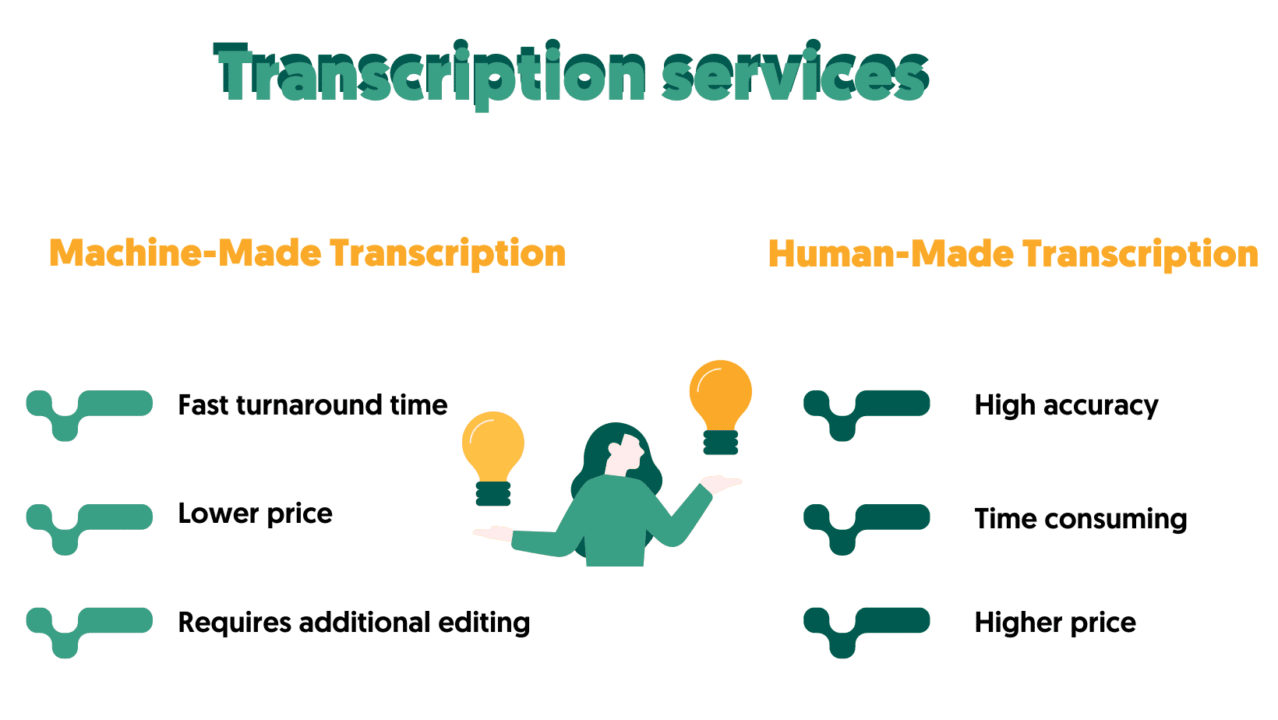
Transcription Services offered by Amberscript
When considering transcription services for your SEO optimization efforts, Amberscript is a versatile and reliable choice that offers both Automated Transcription Services and Manual Transcription Services to cater to your specific needs.
Automatic Transcription Service: Amberscript’s Automatic Transcription Service utilizes cutting-edge AI technology to swiftly transcribe your audio and video content. This service is known for its speed and cost-effectiveness, making it an ideal choice for those with large volumes of content that need to be transcribed quickly. Amberscript’s AI-driven solution ensures consistency in formatting and accuracy, providing you with reliable transcriptions in a fraction of the time it would take for manual transcription.
Manual Transcription Service: For content that demands the utmost precision and contextual understanding, Amberscript offers Manual Transcription Services by professional transcribers. These experts are well-versed in various industries and can handle complex terminology, accents, and challenging audio conditions. Manual transcriptions by Amberscript ensure the highest level of accuracy and context-appropriate transcriptions, making them an excellent choice for industries like medicine, law, or research.
Amberscript’s commitment to accuracy and versatility makes it a trusted partner for businesses, content creators, researchers, and professionals across various fields. Whether you prioritize speed and cost-effectiveness or require the precision and contextual understanding that only human transcribers can provide, Amberscript has a solution tailored to your transcription needs.
By leveraging Amberscript’s services, you can enhance the quality of your transcriptions, making them an invaluable asset in your SEO strategy. The choice between their Automated Transcription Service and Manual Transcription Service allows you to strike the perfect balance between efficiency and accuracy, ultimately contributing to the success of your SEO efforts.
Frequently asked questions
-
Can I add a glossary with specific words to the transcription job?
Yes, we also offer specialized transcription, which can include jargon or specific vocabulary. To learn more about this or discuss specifics, please contact us.
-
Can I translate my subtitles and transcriptions via your app?
No, translation is not available in the automatic services but you can order translated manual subtitles services on our platform. Unfortunately, we do not offer translated manual transcriptions. Please check our prices here.
-
Can you also deliver transcriptions for other media formats?
We deliver data annotation for speech-to-text solutions. However, if you have a special request, please contact our sales team here.
-
Can you transcribe audio with foreign accents?
Yes, our software is constantly being trained to pick up on accents and know how to understand them. Want to know more about how this works? Read it here!
Accuracy in Subtitling: How Important Is It to Be Precise?
Subtitle accuracy is a critical element in the world of multimedia content. It serves as the bridge that connects creators and audiences, transcending language barriers and making content accessible to a global audience. In this blog, we will delve into the pivotal role that accuracy plays in subtitling, exploring how it enhances content accessibility and why it should never be underestimated.
Table Of Contents
- Defining the Importance of Accuracy in Subtitling
- The Role of Subtitles in Enhancing Content Accessibility
- The Art of Subtitling
- Amberscript: A Leading Subtitling Solution
- Contrarian Ideas in Subtitling
- Recap of the Importance of Precision in Subtitling
Defining the Importance of Accuracy in Subtitling
Subtitling, the art of providing written text translations of spoken dialogue in videos, is far more than a mere convenience. It’s an essential tool for ensuring that content reaches a broader audience, including those who are deaf or hard of hearing, speakers of different languages, and viewers in noisy environments. The accuracy of subtitles is the cornerstone of their effectiveness. Inaccurate subtitles not only disrupt the viewer’s experience but can also lead to misinterpretations and confusion. We’ll delve deeper into the nuances of what makes subtitles accurate and why they matter.
The Role of Subtitles in Enhancing Content Accessibility
Subtitles go beyond providing a translation of spoken words. They serve as a vital means of making content more inclusive and accessible to diverse audiences. We’ll explore how subtitles empower individuals with hearing impairments to enjoy videos and how they enable non-native speakers to comprehend and appreciate content in their preferred language. Additionally, we’ll discuss the impact of subtitles in noisy environments or situations where audio can’t be played, emphasizing how they ensure that the message reaches its intended audience effectively.
By understanding the significance of accuracy in subtitling and the role subtitles play in enhancing content accessibility, we set the stage for a deeper exploration of how to achieve precision in this crucial aspect of multimedia content creation.

Subtitle Types and Their Classification
Learn everything aboutThe Art of Subtitling
Subtitling is not a straightforward task; it’s an intricate art that demands a combination of linguistic expertise, cultural awareness, and technical proficiency. In this section, we will explore the fundamentals of subtitling and what distinguishes a good subtitle from a subpar one.
- Subtitling Basics: What Makes a Good Subtitle?
A good subtitle is more than just a word-for-word translation of spoken dialogue. It’s a delicate balance between conciseness and context. A good subtitle should be timed to appear on-screen synchronously with the corresponding dialogue, maintaining readability and ensuring it doesn’t distract the viewer. It should convey the essence of the spoken words accurately, while also taking into consideration factors like character limits, reading speed, and cultural nuances. We’ll delve into the key elements that constitute a well-crafted subtitle, including readability, timing, and context.
- The Impact of Inaccurate Subtitles on Viewer Experience
Inaccuracy in subtitles can have a profound impact on the viewer’s experience. When subtitles fail to reflect the true meaning of the dialogue or are riddled with errors, it can lead to confusion, frustration, and a diminished overall viewing experience. Viewers may struggle to follow the plot, miss important details, or even misinterpret the intended message. We’ll examine real-world examples of the detrimental effects of inaccurate subtitles, highlighting why they should be avoided at all costs.
- The Need for Precision in Subtitling
Precision in subtitling is not an optional luxury; it’s an absolute necessity. Whether you’re creating subtitles for a film, documentary, educational video, or online content, the importance of getting every detail right cannot be overstated. Inaccuracies in subtitles can tarnish the reputation of the content creator and, in some cases, lead to legal issues. We’ll discuss why precision is paramount in subtitling, touching on the consequences of inaccuracies and how they can be mitigated through technology and best practices.
By exploring these aspects of the art of subtitling, we gain a deeper understanding of the challenges and responsibilities that come with creating subtitles that not only serve their practical purpose but also enhance the viewer’s overall experience.
Amberscript: A Leading Subtitling Solution
In the world of subtitling, finding the right tools and services can be a game-changer for content creators and producers. One such leading solution that has gained recognition for its commitment to accuracy and innovation is Amberscript. In this section, we’ll introduce you to Amberscript and take a closer look at the services it offers.
Amberscript and Its Services:
Amberscript is a dynamic player in the subtitling industry, known for its cutting-edge technology and commitment to providing top-tier subtitling services. At its core, Amberscript is an Automatic Speech Recognition (ASR) technology-based platform that specializes in transcribing audio and generating accurate subtitles. Whether you’re working on a video project, a podcast, or any content that requires subtitles, Amberscript offers a comprehensive suite of services to meet your needs.

3 ways automated speech recognition (ASR) can foster digital inclusion
Read the blogAmberscript’s services include but are not limited to:
- Audio Transcription: Amberscript utilizes advanced ASR technology to transcribe audio content quickly and accurately. This transcription forms the foundation for generating subtitles.
- Subtitling: Once the transcription is complete, Amberscript can automatically generate subtitles in multiple languages, ensuring the highest level of accuracy and synchronization with the spoken words.
- Editing and Customization: Amberscript provides tools and features that allow users to edit and customize subtitles, ensuring they meet specific style and formatting preferences.
- Integration: Amberscript offers seamless integration with various platforms and video editing software, simplifying the workflow for content creators.
How Amberscript Ensures Accuracy in Subtitling:
One of the key strengths of Amberscript lies in its commitment to accuracy. By employing state-of-the-art ASR technology, the platform can transcribe audio content with remarkable precision. Amberscript’s accuracy is a result of continuous improvement and fine-tuning of its algorithms, making it a reliable choice for content creators seeking precise subtitles.
The technology behind Amberscript allows it to recognize various accents, dialects, and languages, ensuring that subtitles are not only accurate but also culturally sensitive and contextually relevant. This level of accuracy is crucial, especially when catering to diverse and global audiences.
User Experience and Testimonials
Amberscript’s user-friendly interface and intuitive features contribute to a positive user experience. Content creators can easily upload their audio or video files, receive transcriptions and subtitles promptly, and make any necessary adjustments. The platform’s user-centric design streamlines the subtitling process, saving time and effort.
Testimonials from satisfied users and clients attest to the reliability and effectiveness of Amberscript’s services. Real-world success stories and feedback from content creators who have benefited from its accuracy and efficiency serve as a testament to its value.
Incorporating Amberscript into your subtitling workflow can significantly enhance the precision and quality of your subtitles. As we continue to explore the importance of accuracy in subtitling, Amberscript stands out as a leading solution that aligns with the highest standards in the industry.

Get a customized offer
Request a quote for your subtitling and captioning needs
Contrarian Ideas in Subtitling
In the ever-evolving field of subtitling, it’s essential to consider unconventional approaches and embrace innovative technologies to push the boundaries of accuracy. In this section, we’ll explore contrarian ideas in subtitling, including unconventional approaches to achieving accuracy and the pivotal role of machine learning and AI in this context.
- Exploring Unconventional Approaches to Subtitling Accuracy
While traditional subtitling practices emphasize human involvement in the transcription and subtitling process, there is a growing trend toward leveraging advanced technologies to enhance accuracy. Contrarian ideas include exploring the possibility of fully automated subtitling through cutting-edge Automatic Speech Recognition (ASR) and Machine Translation (MT) systems.
Additionally, some unconventional approaches involve crowdsourcing subtitles or utilizing community-driven efforts to improve accuracy and reach a wider audience. These approaches challenge the conventional wisdom that subtitling must rely solely on professional expertise.
- The Role of Machine Learning and AI in Subtitling
Machine Learning (ML) and Artificial Intelligence (AI) have become game-changers in the subtitling landscape. These technologies enable automatic speech recognition, language translation, and context-aware subtitling at an unprecedented level of accuracy.
Machine learning models can be trained to recognize various accents, dialects, and even emotions in spoken language, leading to more contextually relevant subtitles. AI-driven subtitling tools continuously improve through feedback and learning from user interactions, making them increasingly reliable and precise.
By exploring these contrarian ideas and embracing machine learning and AI in subtitling, content creators and subtitling professionals can unlock new possibilities for accuracy and accessibility. While these approaches may challenge traditional methods, they hold the potential to revolutionize the subtitling industry and provide more accurate and inclusive content for diverse audiences worldwide.
Recap of the Importance of Precision in Subtitling
Throughout this blog, we’ve delved into the multifaceted world of subtitling, from its basics to its role in enhancing content accessibility. Above all else, we’ve stressed the central importance of precision in subtitling. Subtitles are not merely an optional feature; they are a vital means of connecting content with diverse audiences around the world. Inaccurate subtitles can disrupt comprehension, diminish the viewer’s experience, and even lead to misinterpretations.
The essence of precision in subtitling lies in providing an accurate representation of spoken words, ensuring that the subtitles are synchronized, contextually relevant, and culturally sensitive. Whether for individuals with hearing impairments, non-native speakers, or those watching in noisy environments, subtitles are the gateway to understanding and enjoying multimedia content fully.
Embracing Technology and Innovative Solutions for Enhanced Accuracy
In the pursuit of precision, content creators and subtitling professionals must recognize that technology is a powerful ally. Amberscript, as we’ve discussed, exemplifies the potential of advanced Automatic Speech Recognition (ASR) technology in achieving remarkable accuracy. The subtitling landscape is evolving, and embracing innovative solutions is key to meeting the demands of today’s global and diverse audiences.
Machine Learning (ML) and Artificial Intelligence (AI) are at the forefront of this transformation. These technologies not only improve accuracy but also streamline the subtitling process, making it more efficient and accessible. By leveraging AI-driven subtitling tools, content creators can ensure that their subtitles are not only accurate but also adaptable to various languages, accents, and contexts.
In conclusion, precision in subtitling is not just a goal; it’s a necessity. It’s the foundation upon which content bridges language barriers and becomes inclusive to all. By embracing technology and innovative solutions, content creators can enhance the accuracy of their subtitles and reach a wider, more diverse audience than ever before.
As the subtitling landscape continues to evolve, one thing remains clear: accuracy is the key to making content universally accessible, and it’s a journey that involves both tradition and innovation. By prioritizing precision and embracing technology, we can ensure that subtitles continue to serve as a vital tool for connecting the world through the power of multimedia content.
Learn about: How Amberscript is on a mission to make all audio accessible
Read the full articleIn our pursuit of accuracy and accessibility, the possibilities are limitless, and the future of subtitling holds exciting promise.
Frequently asked questions
-
Can I add a glossary with specific words to the transcription job?
Yes, we also offer specialized transcription, which can include jargon or specific vocabulary. To learn more about this or discuss specifics, please contact us.
-
Can I translate my subtitles and transcriptions via your app?
No, translation is not available in the automatic services but you can order translated manual subtitles services on our platform. Unfortunately, we do not offer translated manual transcriptions. Please check our prices here.
-
Can you also deliver transcriptions for other media formats?
We deliver data annotation for speech-to-text solutions. However, if you have a special request, please contact our sales team here.
-
Can you transcribe audio with foreign accents?
Yes, our software is constantly being trained to pick up on accents and know how to understand them. Want to know more about how this works? Read it here!
Maximizing Quality Patient Care: The Role of Medical Transcription in Treatment Planning
Quality patient care is the cornerstone of the healthcare industry. Every decision, every diagnosis, and every treatment plan hinges on the accuracy and organization of patient information. In this article, we delve into a critical but often underestimated component of this process: medical transcription. We’ll explore what medical transcription is, why accuracy is paramount, and how it plays a pivotal role in treatment planning.
Table of Contents
- Understanding Medical Transcription
- Role of Medical Transcription in Treatment Planning
- Maximizing Quality Patient Care with Medical Transcription
- The Vital Role of Medical Transcription
Understanding Medical Transcription
What is Medical Transcription?
Medical transcription is the meticulous process of converting voice recordings from healthcare professionals into written records. This vital task forms the bedrock of accurate and well-organized patient documentation, an indispensable prerequisite for effective treatment planning. The skilled medical transcriptionists take voice recordings and expertly transmute them into comprehensive written reports, serving a multitude of purposes in healthcare.
In addition to capturing the spoken words of healthcare professionals, medical transcriptionists act as guardians of precision. They meticulously ensure that transcribed records are free from errors and faithfully reflect the information provided. With a deep understanding of medical terminology and an unwavering attention to detail, they bridge the chasm between voice recordings and written records, cementing their status as integral components of the healthcare ecosystem. So, understanding the nuances of medical transcription and comprehending its pivotal role in healthcare is paramount. This section is dedicated to unearthing the intricacies of this critical process.
The Importance of Accuracy
In healthcare, accuracy reigns supreme, and medical transcription is no exception. Errors in transcribed records can have far-reaching consequences for patient care. A seemingly minor mistake, such as an incorrect dosage or medication name, can lead to misguided treatment and potential harm to the patient. Inaccurate documentation can also result in misdiagnosis or missed diagnoses, profoundly affecting the trajectory of treatment. In situations demanding swift and precise information, transcription errors can delay critical decisions, jeopardizing patients’ lives.
Even seemingly inconsequential errors, such as a misspelled name or an erroneous birthdate, can engender confusion when retrieving patient records. This confusion can result in treatment delays. In the realm of medical transcription, accuracy is not merely a matter of convenience; it is an issue of patient safety and well-being. Errors in transcribed records have enduring consequences, underscoring the imperative nature of accuracy in healthcare dictations. In the next section, we delve into how healthcare professionals can elevate their dictation to ensure impeccable transcriptions.
Role of Medical Transcription in Treatment Planning
Accurate Patient Records
Central to the responsibilities of medical transcriptionists is the assurance of impeccably accurate and comprehensive patient records. They serve as the guardians of meticulous and detailed documentation, an indispensable cog in the wheel of effective treatment planning. Accurate transcriptions empower healthcare professionals with complete insights into a patient’s condition, history, and treatment trajectory. Armed with these insights, healthcare providers make informed decisions and deliver optimal care.
The significance of accurate documentation reverberates across the spectrum of treatment planning, from initial diagnoses to long-term care. Medical transcriptionists stand as sentinels, ensuring that healthcare professionals’ information is transcribed with unwavering precision, free from ambiguity or errors. This includes critical data such as test results, prescribed medications, follow-up instructions, and any other pertinent information. Informed treatment planning becomes a reality only when healthcare professionals have access to precise and exhaustive patient records, underscoring the indispensable role played by medical transcriptionists. Hence, the importance of accurate patient records looms large in the landscape of healthcare, making medical transcription an integral component of the process. In the subsequent section, we delve into the skills and knowledge requisite for excelling in the field of medical transcription.

Audio Transcription: How To Transcribe Audio to Text
Read the blogLegal and Ethical Compliance
Beyond accuracy, medical transcription assumes a pivotal role in upholding legal and ethical standards in healthcare. Just as every facet of healthcare adheres to laws and regulations, documenting patient records follows suit. Medical transcriptionists must navigate these standards and guidelines to ensure impeccable documentation and safeguard patient privacy.
The realm of medical transcription is not only governed by legal mandates but also guided by ethical considerations. Medical information is sacrosanct, and it falls to medical transcriptionists to preserve patient privacy and confidentiality at all times. They bear the responsibility of ensuring that only authorized individuals gain access to patient records and that stringent security measures are in place to thwart unauthorized entry.
Adequate documentation does not merely shield patients’ rights; it also serves as a bulwark safeguarding healthcare providers from legal repercussions. Inaccurate or incomplete documentation can kindle malpractice claims, portending severe consequences for both patients and healthcare professionals. By ensuring flawless and comprehensive transcriptions, medical transcriptionists assume a pivotal role in protecting the interests of all stakeholders involved in the healthcare journey.
Communication and Coordination
Another pivotal role of medical transcription in treatment planning is its function as a linchpin for communication and coordination among healthcare professionals. Transcribed records encapsulate the vital information that various members of a healthcare team require for effective collaboration. This roster includes physicians, nurses, specialists, and other contributors to a patient’s care.
Accurate documentation confers the ability to review a patient’s history, progress, and treatment plans with ease, thus fostering enhanced communication and coordination. This facet becomes especially salient when multiple providers are involved in a patient’s care, as it bolsters the continuum of care and forestalls gaps or errors in treatment.
Efficient communication and coordination constitute the bedrock of successful treatment planning. They empower healthcare professionals to harmonize their efforts toward a shared objective—ensuring that patients receive the utmost care. Medical transcriptionists facilitate this endeavor by furnishing meticulous and exhaustive records that serve as a conduit for communication across the gamut of the healthcare team. The incontrovertible fact is that medical transcription not only contributes to the preservation of patient records but also plays a pivotal role in invigorating effective communication and coordination among healthcare professionals.
Clinical Decision-Making
In addition to facilitating communication and coordination, transcribed records wield a formidable influence on clinical decision-making. Physicians rely upon these records for the insights they proffer into a patient’s medical history, present condition, and responses to prior treatments.
Medical records further function as a compass guiding diagnostic and therapeutic decisions. Test results and medication histories serve as signposts guiding physicians toward the most judicious course of treatment. Physicians may also reference prior notes and follow-up instructions to ensure the continuity of care.
In certain instances, medical records might unveil critical information that could precipitate life-saving interventions. For example, a vigilant physician, upon perusal of a patient’s records, might unearth an underlying condition, hastening detection and intervention.
Insurance and Billing
Accurate and detailed transcribed records are of paramount significance in insurance claims and billing processes. Insurance companies depend on these records to ascertain the validity and necessity of healthcare services dispensed to patients. Erroneous or incomplete documentation can trigger claim denials, delays, or even legal entanglements.
Medical transcriptionists shoulder the responsibility of ensuring the unerring transcription of all patient records, including procedures or treatments administered. They must also employ the appropriate medical codes and terminology to substantiate insurance claims and simplify billing.
Prudent documentation is the linchpin that ensures that healthcare providers receive just and timely compensation for their services. It also serves the interests of patients, for documentation errors can translate into incorrect charges and unexpected out-of-pocket expenses. By delivering impeccable transcriptions, medical transcriptionists engineer equitable and timely reimbursement for healthcare services. This underscores yet again the pivotal role they play in the treatment planning process.

Get a customized offer
Request a quote for your transcription needs
Maximizing Quality Patient Care with Medical Transcription
Ensuring Accuracy and Clarity
As a healthcare professional, it is imperative to furnish clear and accurate dictation when recording patient information. This practice not only ensures that medical transcriptionists can transcribe your notes with precision but also enriches the overall quality of patient care. To facilitate clear dictation, enunciate words distinctly, speak deliberately, and shield against background noise and distractions.
The value of providing lucid dictation extends beyond mere convenience. It hinges on the expertise that medical transcriptionists possess in the realm of medical terminology. They are adept at deciphering intricate medical jargon, abbreviations, and acronyms. Nevertheless, the provision of clear dictation plays a pivotal role in producing more accurate transcriptions and precluding misunderstandings or errors that could affect patient care adversely.
Through collaborative efforts between healthcare professionals and medical transcriptionists, the zenith of accuracy and clarity in patient records is attainable. This, in turn, culminates in enhanced treatment planning and an elevated standard of care for patients. Thus, it becomes incumbent upon both parties to leverage their respective expertise to maximize the quality of patient care.
Quality Control and Review
Quality control constitutes a linchpin in the sphere of medical transcription, safeguarding the sanctity of accurate and error-free transcriptions. It encompasses a myriad of processes and measures designed to uphold the zenith of quality in patient records. In the healthcare landscape, where even the minutest slip can engender grave consequences, quality control assumes paramount significance.
One path to ensure quality control in medical transcription is the institution of peer-review systems. This modality entails the review of transcribed documents by a second transcriptionist, thereby fortifying accuracy and completeness. It not only serves as a safety net for identifying errors or inconsistencies but also functions as an avenue for perpetual learning and enhancement.
Moreover, medical transcription companies often institute their own quality control mechanisms to ensure that all documents conform to industry standards and guidelines. This includes rigorous proofreading, editing, and formatting assessments before delivering the ultimate transcript to the healthcare provider.
Use of Technology
Technology, an unrelenting catalyst of change, has wielded a transformative impact on medical transcription, enhancing its efficiency and accuracy. A harbinger of this transformation is speech recognition software, an advanced tool that enables direct dictation to be transcribed into text. This innovation truncates the time and effort demanded from healthcare professionals and concurrently curtails errors and disparities stemming from manual data entry.
Another transformative development lies in the integration of transcription with Electronic Health Records (EHR) systems. This integration empowers transcribed records to be directly archived and accessed through digital platforms, obviating the necessity for physical documentation and reducing the risk of loss or damage. This synergy also engenders seamless data exchange between healthcare providers, thereby amplifying communication and coordination in patient care.
The evolutionary trajectory of technology continues to shape the landscape of medical transcription. As technology marches onward, the prospects are rife with innovative solutions that promise to further empower healthcare professionals and patients alike. Consequently, it becomes imperative for all stakeholders to remain abreast of new technologies and seamlessly assimilate them into their practices to maximize both quality and efficiency.

The future of transcription: How AI and machine learning are changing the game
Read the blogCompliance with Regulations
Compliance with regulations serves as an anchor in the realm of medical transcription, ensuring patient confidentiality and safeguarding sensitive information. This mantle extends to the rigorous adherence to healthcare regulations and standards, foremost among them being the Health Insurance Portability and Accountability Act (HIPAA).
HIPAA stands as the sentinel guarding patient privacy and the security of personal health information. Medical transcription companies shoulder the onus of compliance with HIPAA regulations, encompassing the secure transfer and storage of patient records, the imposition of rigorous access controls, and the maintenance of confidentiality agreements with all employees.
Simultaneously, healthcare providers bear the mantle of responsibility when collaborating with medical transcriptionists to ensure compliance with HIPAA regulations. This encompasses the verification of security measures in place for data transfer and storage, as well as the stringent enforcement of privacy protocols by all personnel engaged in the transcription process.
Timely Transcription and Communication
Timely transcription stands as a cornerstone in the provision of efficient and effective patient care. Accurate and punctual transcriptions empower healthcare professionals with the critical information required for sound decision-making regarding their patients’ treatment plans. Delays in transcription can cascade into postponed diagnoses, treatment delays, and consequential implications for the overall quality of care.
To ensure timely transcriptions, effective communication between healthcare teams and medical transcriptionists is imperative. This implies the provision of clear and comprehensive dictations, the prompt resolution of concerns or queries, and the expeditious review of transcribed documents. It also necessitates open and transparent communication between transcriptionists and healthcare providers to ensure the accuracy of all information and the prompt resolution of any discrepancies.
The emphasis on timely transcriptions and the cultivation of effective communication among all stakeholders serve as pivotal facets in the maximization of the quality of patient care through medical transcription. This collaborative effort represents the crux of delivering timely and accurate information, which, in turn, translates into superior treatment outcomes for patients.
The Vital Role of Medical Transcription
In summation, medical transcription occupies a seminal role in the augmentation of patient care quality. Through technological strides, stringent regulatory compliance, and the twin pillars of timely transcriptions and effective communication, the process has undergone a metamorphosis, emerging as a more efficient and precise endeavor than ever before. By adhering to regulatory standards and advocating for effective communication among all stakeholders, healthcare professionals can ensure that patient records are meticulously and securely documented.
Subtitle Types and Their Classification
In the world of multimedia, where visual and auditory experiences reign supreme, subtitles serve as unsung heroes, silently enhancing our connection with content. They play a pivotal role in making media accessible, comprehensible, and enjoyable to a diverse audience. In this blog post, we will delve into the world of subtitles, exploring their significance and the diverse types that exist.
- Brief overview of the importance of subtitles in various media content
- Types of Subtitles
- Classification of Subtitles
- Amberscript and Subtitle Solutions
- Summarizing the key points
Brief overview of the importance of subtitles in various media content
Subtitles are more than just text on a screen; they are gateways to inclusion and understanding. Whether you’re watching a movie, a TV show, an educational video, or even a live broadcast, subtitles serve several critical purposes:
- Accessibility: Subtitles make content accessible to individuals with hearing impairments. They provide a means for those who are deaf or hard of hearing to enjoy movies, TV shows, and online videos without missing out on the dialogue and audio cues.
- Multilingual Communication: In our increasingly globalized world, subtitles bridge language barriers. They enable people from different linguistic backgrounds to consume content in their native languages or learn new languages by watching and reading simultaneously.
- Clarity: Even for those with no hearing impairments or language barriers, subtitles enhance clarity. They help viewers understand dialogue in noisy environments, catch every word when actors mumble, or grasp complex terminology in documentaries and educational content.
- Cultural Context: Subtitles provide essential context by translating idioms, cultural references, and jokes that might not directly translate. This ensures that viewers from different cultures can fully appreciate the subtleties of the content.
- Enhanced Learning: In educational settings, subtitles aid in comprehension and retention. Students can read along with the spoken words, reinforcing their understanding of the material.
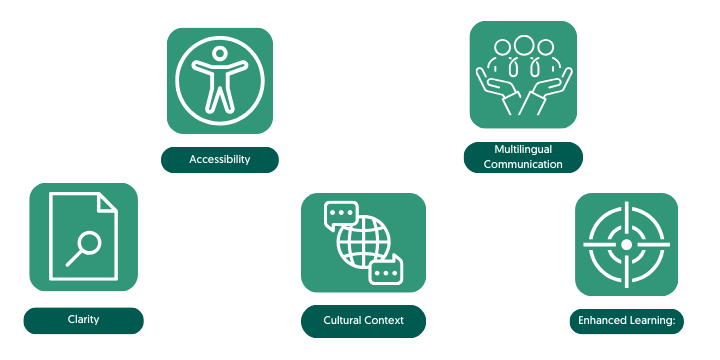
Throughout this blog post, we will explore the diverse types of subtitles, each designed for specific purposes and situations. From open subtitles that are readily visible to closed subtitles that can be toggled on and off, to the real-time subtitles that keep up with live events, we will cover it all.
Types of Subtitles
Subtitles come in various forms, each tailored to specific needs and scenarios in the world of media. Let’s take a closer look at some common types:
Open Subtitles
Open Subtitles, also called Burned-in Subtitles, are those that are permanently embedded into the video content. They are always visible, and viewers cannot turn them off. These subtitles are a helpful choice when the content creators want to ensure that all viewers, regardless of their preferences or hearing abilities, have access to the text. Open subtitles are often used in educational videos, documentaries, and some foreign-language films.
Closed Subtitles
Closed subtitles, in contrast to open subtitles, are optional and can be toggled on or off by the viewer. This flexibility allows the audience to choose whether they want to see the subtitles. Closed subtitles are commonly used in movies and TV shows, allowing viewers to enjoy the content without distraction, while still providing accessibility options for those who need them.

Learn more about: Key differences between Open and Closed Captions
Read the blogForced Subtitles
Forced subtitles are a subset of closed subtitles that are essential for understanding the content. They typically appear only during specific scenes or when a language switch occurs within a film or TV show. For example, if characters in a movie are speaking a foreign language, forced subtitles may appear to translate their dialogue, ensuring viewers can follow the story without missing crucial information.
Real-time Subtitles
Real-time subtitles are generated and displayed as the content is being broadcast or streamed live. They are crucial for making live events, such as news broadcasts or sports events, accessible to a broader audience. Real-time subtitles require advanced technology and skilled captioners to keep up with the fast-paced nature of live broadcasts, ensuring accuracy and timeliness.

Get a customized offer
Request a quote for your subtitling and captioning needs
These are just a few examples of the diverse range of subtitle types that serve different purposes in the world of media. Subtitles play a vital role in making content accessible, enhancing clarity, and ensuring that viewers can fully engage with the material, regardless of their language or hearing abilities. As we continue through this blog post, we will further explore additional subtitle types and their classifications to provide a comprehensive understanding of this essential aspect of multimedia content.
Classification of Subtitles
Subtitles can be classified into various categories based on their primary purpose and how they enhance the viewer’s experience.
Here, we delve into different classifications of subtitles:
Informational Subtitles:
Informational subtitles are primarily designed to provide essential information to the viewer. They often include text that conveys facts, statistics, or additional details relevant to what’s happening on screen. These subtitles are commonly used in news broadcasts, documentaries, and educational videos to offer context or explanations for complex topics.
Translated Subtitles:
Translated subtitles are a bridge for audiences who do not understand the original language of the content. They provide translations of spoken dialogue, allowing viewers to enjoy foreign-language films, TV shows, or videos in their native language. Translated subtitles are invaluable for making global content accessible and appealing to a wider audience.
Descriptive Subtitles:
Descriptive subtitles, also known as audio descriptions or sometimes referred to as SDH (subtitles for Deaf and hard-of-hearing), cater to individuals with visual impairments. They provide textual descriptions of visual elements, actions, and non-verbal cues in the content. These subtitles ensure that visually impaired viewers can fully grasp the narrative and ambiance of a movie or TV show.
Educational Subtitles:
Educational subtitles are specifically tailored to enhance the learning experience. They can include definitions, explanations, and clarifications of complex concepts within educational videos or lectures. Educational subtitles are valuable tools for students and lifelong learners, as they reinforce comprehension and retention.
Entertainment Subtitles:
Entertainment subtitles serve to amplify the enjoyment of movies, TV shows, and online videos. They include elements like dialogue, character names, and on-screen text translations for songs or signs. These subtitles make it easier for viewers to follow the storyline, understand character interactions, and fully immerse themselves in the entertainment.
More Categories (if applicable):
Depending on the specific content and its intended audience, subtitles can fall into additional categories. For instance, subtitles in video games may be categorized as “Gaming Subtitles,” providing players with in-game instructions and dialogue. Subtitles used in corporate presentations may be classified as “Business Subtitles,” offering textual support for presentations and meetings.
Understanding these subtitle classifications allows content creators and viewers to appreciate the versatility of subtitles in different contexts. Whether it’s providing information, enabling cross-cultural communication, enhancing accessibility, aiding education, or simply adding to the entertainment value, subtitles play a pivotal role in elevating the multimedia experience.

All about: Subtitles, Closed Captions, and SDH Subtitles
Learn moreAmberscript and Subtitle Solutions
In the ever-evolving landscape of multimedia content creation, having a reliable and efficient subtitle solution can make a world of difference. One such standout solution is Amberscript, a versatile platform that simplifies the process of creating, managing, and customizing subtitles. Let’s take a closer look at Amberscript and its array of subtitle options:
Amberscript: a Reliable Subtitle Solution:
Amberscript is a trusted name in the world of subtitling, offering a comprehensive suite of tools and features that cater to a wide range of subtitle needs. Whether you’re a content creator, a filmmaker, an educator, or a business professional, Amberscript is designed to streamline your subtitle workflow and ensure accuracy and efficiency.
Exploring the Various Subtitle Options Offered by Amberscript:
Amberscript provides a rich set of subtitle options to meet diverse requirements:
- Automatic Subtitling: Amberscript’s Machine-Made subtitling feature leverages cutting-edge speech recognition technology to generate accurate subtitles with minimal effort. It’s an ideal choice for quickly adding subtitles to recorded content, saving you valuable time.
- Manual Subtitling: For those situations where precision is paramount, Amberscript offers manual subtitling tools. This allows you to meticulously create and edit subtitles, ensuring that they align perfectly with the content.
- Multilingual Subtitling: In our globalized world, Amberscript supports translated subtitling, making it easy to translate and subtitle content in multiple languages. This is invaluable for reaching a broader audience and expanding your content’s reach.
- Customizable Subtitles: Amberscript understands that one size doesn’t fit all. With customizable subtitle options, you have the freedom to adjust fonts, colors, styles, and positioning to match your brand or personal preferences.
Benefits of Using Amberscript:
- Accuracy: Amberscript’s advanced speech recognition technology ensures high accuracy in subtitles, reducing the risk of errors.
- Efficiency: With both automatic and manual subtitle creation options, you can choose the method that suits your project’s needs and deadlines.
- Accessibility: Amberscript enhances accessibility, making your content available to a wider audience.
- Multilingual Support: Seamlessly subtitle content in multiple languages to reach a global audience.
- Customization: Tailor subtitles to your branding or style requirements for a professional look.
- Real-time Capabilities: For live events, webinars, and broadcasts, Amberscript’s real-time subtitling is a reliable solution.
How to Get Started with Amberscript:
To explore the world of Amberscript and leverage its powerful subtitle solutions, simply visit https://www.amberscript.com/en/. You can find detailed information about their products and services, including their subtitle solutions, at https://www.amberscript.com/en/products/subtitles/.
Amberscript’s user-friendly interface and robust feature set make it an invaluable tool for content creators and organizations seeking to enhance their multimedia content with accurate and accessible subtitles. Whether you’re creating educational videos, marketing content, or live broadcasts, Amberscript empowers you to deliver a superior viewing experience to your audience.

Summarizing the key points
In conclusion, subtitles are the unsung heroes of multimedia content, enhancing accessibility, comprehension, and engagement. With the right tools and solutions like Amberscript, content creators and organizations can leverage subtitles to reach wider audiences and deliver superior viewing experiences.
Whether you’re a filmmaker, educator, business professional, or content creator, understanding the diverse world of subtitles and the solutions available can empower you to make your content more accessible and impactful. Embrace the world of subtitles, and let them be your bridge to a global and inclusive audience.

Frequently asked questions
-
Can I add a glossary with specific words to the transcription job?
Yes, we also offer specialized transcription, which can include jargon or specific vocabulary. To learn more about this or discuss specifics, please contact us.
-
Can I translate my subtitles and transcriptions via your app?
No, translation is not available in the automatic services but you can order translated manual subtitles services on our platform. Unfortunately, we do not offer translated manual transcriptions. Please check our prices here.
-
Can you also deliver transcriptions for other media formats?
We deliver data annotation for speech-to-text solutions. However, if you have a special request, please contact our sales team here.
-
Can you transcribe audio with foreign accents?
Yes, our software is constantly being trained to pick up on accents and know how to understand them. Want to know more about how this works? Read it here!
Closed Captions vs Open Captions: What’s the Difference?
In today’s multimedia-rich world, accessibility and inclusivity have become paramount. Closed Captions and Open Captions play a significant role in making video content accessible to a broader audience, including those with hearing impairments or those who prefer to watch videos in silence. However, they are not the same. In this blog post, we’ll explore the differences between closed captions and open captions, helping you understand when and how to use each.
Table of Contents
- Understanding Closed Captions
- Amberscript: A Closed Captioning Solution
- Understanding Open Captions
- Final Remarks: Closed Captions vs Open Captions
Understanding Closed Captions
Closed captions are a fundamental component of accessible video content, serving to make videos inclusive for all viewers, including those with hearing impairments. To fully grasp the importance and functionality of closed captions, let’s explore their key characteristics and advantages in greater detail.
User Control: Closed Captions
One of the primary distinguishing features of closed captions is the degree of control they grant to the viewer. Closed captions are a viewer-centric solution. This means that viewers have the flexibility to decide whether they want to see the captions or not. They can easily toggle closed captions on or off according to their individual preferences and needs.
This user control aspect is crucial for several reasons:
1. Accessibility:
- Closed captions cater to individuals who are deaf or hard of hearing, ensuring they can access and comprehend the spoken content. This inclusivity is not only ethically important but also often legally mandated.
2. Flexibility:
- Closed captions extend their utility to a broader audience. Viewers can activate captions when they find themselves in noisy environments, such as crowded cafes or public transportation, allowing them to enjoy video content without relying on audio.
3. Multilingual Support:
- Closed captions can be provided in multiple languages, offering a global reach. This is particularly advantageous for content creators seeking to engage with diverse audiences around the world.
Customization Options
Closed captions go beyond mere visibility; they emphasize user experience. To accommodate various preferences and accessibility needs, closed captions often provide customization options:
1. Font Size and Style:
- Viewers can typically adjust the font size and style of the captions to suit their reading comfort. This customization is particularly valuable for those with visual impairments or preferences for specific text formats.
2. Color and Background:
- Closed captions may allow users to modify text colors and background opacity. These choices enable viewers to optimize the contrast for readability, taking into account factors like ambient lighting conditions.
3. Positioning:
- Some platforms offer the flexibility to reposition captions on the screen. This feature ensures that captions do not obstruct critical visual content, making for a seamless viewing experience.
4. Speed and Display Time:
- In some cases, viewers can control the speed at which captions appear on the screen. This feature aids those who read at different paces and can be especially useful for educational content.
Regulatory Compliance
The legal landscape underscores the significance of closed captions in multimedia content. Many countries have established regulations and standards that mandate the use of closed captions in various contexts:
1. Television Broadcasting:
- In the realm of television, closed captioning is often a legal requirement. Broadcasters are typically obligated to provide closed captions to ensure that TV programs are accessible to all viewers.
2. Online Video Platforms:
- The digital landscape is no exception. Online video platforms, such as YouTube and streaming services, are subject to regulations that demand the inclusion of closed captions to meet accessibility standards.
3. Accessibility Laws:
- Accessibility laws, such as the Americans with Disabilities Act (ADA) in the United States, reinforce the need for closed captions in various domains, including education, public services, and digital media.
Language Options
Closed captions are a gateway to global reach and inclusivity, thanks to their multilingual support:
1. Audience Expansion:
- Providing closed captions in multiple languages broadens your content’s audience. It enables you to engage with viewers from diverse linguistic backgrounds, transcending geographic boundaries.
2. Localization:
- Closed captions facilitate content localization for international markets. This is vital for businesses and content creators seeking to adapt their material to resonate with different cultures.
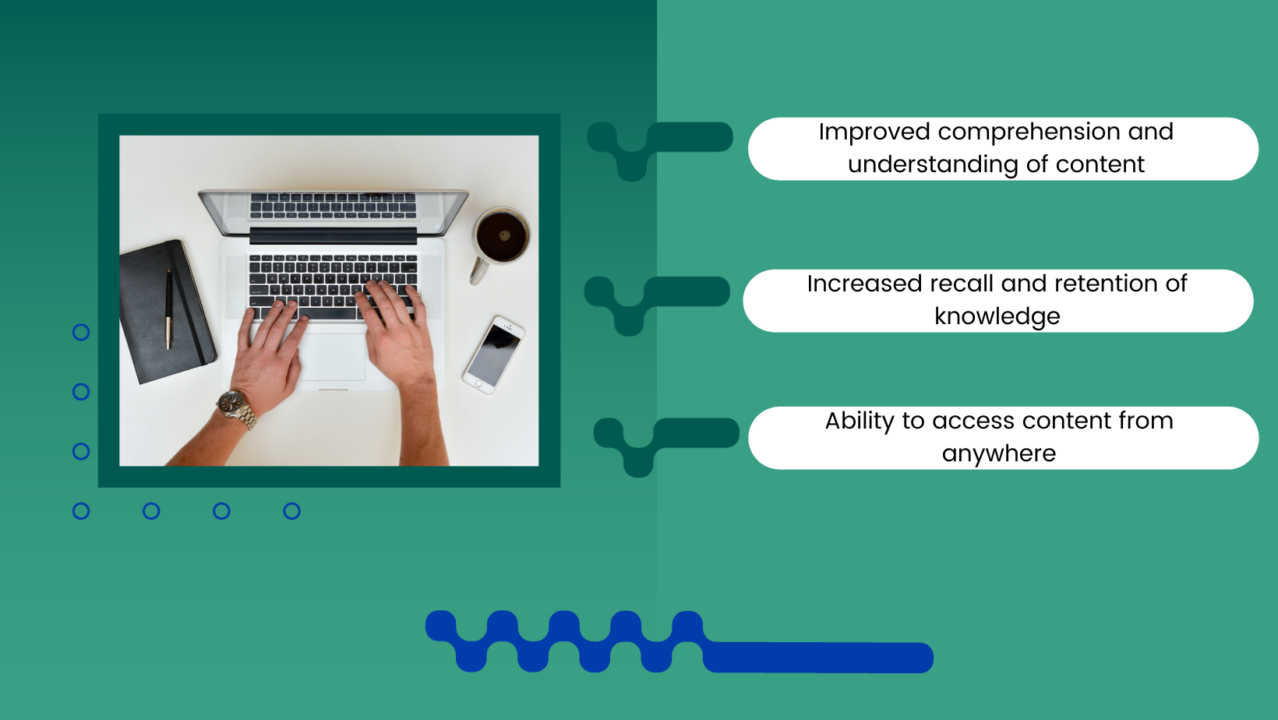
Use Cases for Closed Captions
Closed captions are commonly used in various scenarios:
- Educational Videos: Closed captions ensure that course content is accessible to all students, regardless of their hearing abilities.
- Webinars: Webinars often employ closed captions to make the presentation accessible to diverse participants.
- Streaming Platforms: Platforms like Netflix and YouTube rely on closed captions to reach a broader audience.
Amberscript: A Closed Captioning Solution
In summary, understanding closed captions goes beyond recognizing them as mere text overlays. They are a dynamic and indispensable component of inclusive multimedia content. Closed captions offer viewers control, customization, and accessibility while ensuring compliance with legal standards. Their multilingual capabilities open doors to global audiences, making closed captions an essential tool for modern content creators and distributors.
In addition, when looking for efficient closed captioning solutions, consider exploring options like Amberscript. Amberscript’s advanced AI technology simplifies the process of generating accurate closed captions, enhancing the accessibility and reach of your video content.
Here’s why Amberscript is an excellent option:
- Accuracy: Amberscript’s AI algorithms ensure high accuracy in transcribing audio into text, reducing the risk of errors in closed captions.
- Efficiency: With its automation features, Amberscript can significantly reduce the time and effort required to create closed captions for your video content.
- Multiple Language Support: Amberscript supports multiple languages, making it suitable for a global audience.
- Customization: While closed captions can be customized by viewers, Amberscript offers customization options during the captioning process, allowing you to tailor the appearance of captions to your brand’s style.
- Regulatory Compliance: Using Amberscript can help you meet legal requirements for closed captioning, ensuring your content is accessible to all.
Now that we’ve explored the depth of closed captions, let’s proceed to delve into the realm of open captions in the next section.

How are they different? All about: Subtitles, Closed Captions, and SDH Subtitles
Learn moreUnderstanding Open Captions
Open captions, also also known as burn- or burned-in captions, are another method of adding text to video content, but they differ significantly from closed captions. To gain a thorough understanding of open captions, we need to explore their characteristics, advantages, and specific use cases in more detail.
User Control: Open Captions
The first and most notable distinction between open captions and closed captions lies in user control:
1. Permanence:
- Open captions are permanently embedded in the video and cannot be turned off by viewers. They are a fixed part of the video itself.
While this may seem like a limitation, it offers certain advantages in specific scenarios.
Customization Options
Unlike closed captions, open captions do not typically provide viewers with customization options. The appearance, style, and placement of open captions are determined during the video production process. This lack of flexibility can be advantageous for content creators aiming for a consistent visual presentation.
Regulatory Compliance
Open captions can serve as an effective means of ensuring regulatory compliance without relying on user interaction:
1. Inherent Accessibility:
- Since open captions are an integral part of the video, they automatically ensure accessibility. This can be particularly important for content creators who must adhere to legal requirements or ethical standards.
Language Options
When it comes to language options, open captions and closed captions both play crucial roles:
1. Multilingual Support:
- Closed captions are known for their ability to provide content in multiple languages, ensuring a global reach for your videos.
Comment: It’s worth noting that Amberscript, a leading closed captioning solution, also recognizes the importance of language options. In addition to offering accurate closed captions, Amberscript provides a comprehensive solution that covers both closed captions and open captions (burn-in) for users. This means you can seamlessly integrate open captions into your videos to reach a wider audience, while also benefiting from their multilingual support. You can explore more about Amberscript’s captioning options here.

Get a customized offer
Request a quote for your subtitling and captioning needs
Use Cases for Open Captions
Open captions are best suited for specific scenarios where their characteristics align with the goals and audience expectations:
1. Noisy Environments:
- In environments where viewers have no control over external noise, open captions can be highly beneficial. They guarantee that viewers can follow the content even in challenging acoustic conditions, such as public transportation or crowded areas.
2. Accessibility Commitment:
- Educational institutions, governmental organizations, and businesses with a strong commitment to accessibility may choose open captions to demonstrate their dedication to providing universally accessible content.
3. Enhanced Storytelling:
- Some content creators opt for open captions to enhance storytelling. When captions are an integral part of the visual experience, they can be used creatively to convey emotions, emphasize dialogue, or provide additional context.
In summary, understanding open captions requires recognizing their permanence, limited customization options, and the specific scenarios where they excel. While open captions lack the user control and customization of closed captions, they offer inherent accessibility and can be a powerful tool in specific contexts.
By understanding both closed and open captions, content creators can make informed decisions about which captioning method aligns best with their goals and audience needs.
Final Remarks: Closed Captions vs Open Captions
In conclusion, the choice between closed captions and open captions depends on your audience, content, and specific goals. Closed captions offer user control, customization, and regulatory compliance, making them a versatile option for various situations. Open captions, on the other hand, are always visible and may be preferred in specific contexts.
Understanding the differences between closed captions and open captions allows content creators to make informed decisions that enhance the accessibility and inclusivity of their videos. Whether you opt for closed or open captions, the ultimate goal is to ensure that your content reaches as wide an audience as possible, breaking down barriers and making your message accessible to all.
By considering these distinctions and exploring solutions like Amberscript, you can make an informed choice and use the appropriate captioning method to meet your specific needs and audience expectations.
Understanding Captioning: Types, Methods, and Styles
In today’s digital age, where audio and video content reign supreme, captions have emerged as indispensable tools for promoting inclusivity and accessibility. These text-based additions to visual and auditory media ensure that everyone, regardless of their hearing abilities, can engage with content effectively. In this comprehensive exploration, we delve into the diverse world of captioning, covering the various types, methods, and styles that shape the landscape of inclusive media. Whether you’re a content creator, distributor, or a curious viewer, this blog post promises valuable insights to enhance your understanding of captioning and its pivotal role in making content universally accessible.
Table of Contents
Captioning Types
Captioning is the process of augmenting audio or video content with synchronized text, enabling individuals who are deaf or hard of hearing to access and comprehend spoken words. Beyond accessibility, captioning benefits a broad spectrum of viewers, including those learning a new language or encountering content in noisy environments. Let’s explore the key captioning types:
Closed Captions (CC)
Closed captions are a prevalent form of captioning, providing a textual representation of spoken words, sound effects, and non-verbal elements in video or audio content. Positioned at the screen’s bottom, they synchronize with the dialogue or narration, offering viewers the option to toggle them on or off. Closed captions, often including speaker identification and background noises, are fundamental for the deaf and hard of hearing, now standard in many broadcasting platforms.
Open Captions (OC)
In contrast to closed captions, open captions are permanently embedded in the video or audio content, unmodifiable by viewers. They ensure accessibility for all, particularly in public spaces like theaters or airports where individual caption settings may not be feasible. However, open captions lack customization options, emphasizing universal access over personalization.
Subtitles
Subtitles, sometimes confused with closed captions, solely present dialogue or narration in a video or audio content. Unlike closed captions, they omit speaker identification and sound effects. Subtitles are instrumental for translating content across languages but do not fulfill the same role as closed captions for the deaf or hard of hearing. It’s essential to discern between these two when choosing the right option for your content.

Subtitles, Closed Captions, and SDH Subtitles: How are they different?
Learn moreReal-Time Captions (Live Captioning)
Real-time captions, or live captioning, emerge simultaneously with spoken words in video or audio content. Typically employed in live broadcasts like news programs or sports events, real-time captions demand skilled captioners equipped with specialized tools to transcribe swiftly. While critical for providing immediate accessibility, achieving 100% accuracy in the fast-paced live context requires exceptional transcription skills.
Roll-Up Captions
Roll-up captions, akin to real-time captions, unveil text one line at a time. However, unlike real-time captions, they can be prepared and edited before integration into video or audio content. This flexibility makes them suitable for pre-recorded shows or movies, where precision is paramount. Roll-up captions also permit customization of display time and font size, catering to diverse needs.
Verbatim Captions
Verbatim captions faithfully reproduce spoken words, including filler words and stutters, aiming for an exact reflection of dialogue or narration. Valuable for aiding those grappling with spoken language or complex concepts, verbatim captions may not suit all audiences seeking a more streamlined viewing experience. Tailor your choice to your audience’s requirements.
Pop-On Captions
Pop-on captions, also known as block or timed captions, share similarities with roll-up captions, appearing one line at a time. However, unlike roll-up captions, where each line replaces the previous one, pop-on captions persist on the screen for a specified duration before transitioning to the next. They are widely employed in pre-recorded shows or movies, offering customization options for font style and color to enhance readability and aesthetics.
Captioning Methods
Captioning methods encompass the techniques utilized to generate captions. Each method carries distinct advantages and considerations, catering to diverse content and accessibility needs:
Manual Captioning
Manual captioning hinges on skilled professionals transcribing and timing captions in real-time. Often applied in live broadcasts, it demands accuracy and expertise. While time-consuming and costly, manual captioning ensures high-quality, tailored captions for accessibility.
Automatic Speech Recognition (ASR)
ASR employs software or algorithms to automatically transcribe spoken words. Cost-effective and efficient, ASR is suitable for pre-recorded content. However, its accuracy relies on audio quality and may necessitate professional editing for accessibility standards compliance.
Hybrid Captioning
Combining manual and automatic captioning, hybrid captioning generates initial captions using ASR, subsequently edited and reviewed by humans for accuracy. This approach strikes a balance between efficiency and precision, ideal for time-sensitive content.
Machine Translation and Localization
Machine translation and localization automatically translate and adapt captions into different languages, broadening content accessibility globally. While efficient, it may require professional editing due to language nuances and cultural considerations.
Text-to-Speech (TTS)
TTS converts written text into spoken words using software or algorithms. Beneficial for audio descriptions and deaf or hard-of-hearing viewers, it offers improved naturalness in voices. Nonetheless, it may lack emotional nuance compared to live voiceovers and necessitates editing for accuracy.
Real-Time Automatic Captioning Services
Real-time automatic captioning services, leveraging speech recognition, provide live captions during events and broadcasts. Imperfect yet valuable for viewers reliant on captions, professional review and editing are advised to ensure accuracy.
Amberscript’s Captioning and Subtitling Services
Explore these innovative products and services designed to cater to various needs and preferences in the world of captioning. From cutting-edge AI-powered solutions to human-made precision, we’ve got you covered. Discover how these offerings can revolutionize your captioning experience.

Machine-Made Transcription: Amberscript’s Machine-Made Transcription service transforms spoken content into accurate written text swiftly and efficiently. With the ability to handle diverse audio qualities and accents, this technology underpins the subtitling process, laying the foundation for accurate and reliable subtitles.
Machine-Made Subtitling: Powered by artificial intelligence, Amberscript’s automatic or Machine-Made Subtitling service transforms transcribed text into synchronized on-screen subtitles. This seamless integration between transcription and subtitling expedites the workflow, allowing subtitlers to focus on refining the content’s quality and context.
Professional Human-Made Subtitles: Acknowledging the nuances and cultural intricacies of language, Amberscript’s Human-Made Subtitling service employs skilled professionals who craft subtitles with meticulous attention to detail. This human touch ensures that the essence of dialogues is 100% accurately captured, preserving the intended emotional impact and total exactitude.
Translated Subtitles: Amberscript’s Translated Subtitles service bridges language gaps. By expertly translating subtitles, this service enables films to resonate with international audiences, enriching the festival experience for viewers from diverse linguistic backgrounds.

Get a customized offer
Request a quote for your subtitling and captioning needs
Captioning Styles
Captioning styles add a layer of creativity and expression to content, enhancing the viewing experience for all audiences while prioritizing accessibility. These styles encompass visual aids for comprehending dialogue and sound effects:
- Pop-On Captions: Beyond mere text, captions contribute to the visual experience of content, enhancing creativity and expression. Styles not only aid comprehension but also play a pivotal role in accessibility.
- Roll-Up Captions: Roll-up captions, also known as scroll-up or paint-on captions, commence at the screen’s bottom and continuously ascend as new lines emerge. Ideal for extended dialogues or multi-speaker scenes, they can be customized in color and background to facilitate understanding.
- Paint-On Captions: Paint-on captions, akin to roll-up captions, instantly display all text at once. Often used for songs, poems, or shorter dialogue segments, they can be customized with various colors and fonts to convey changes in speaker or tone.
- Speaker Identification: Speaker identification enhances comprehension, especially in styles using different colors or fonts to indicate speakers. This feature aids viewers in following dialogue and understanding the context.
- Color-Coded Captions: Color-coded captions utilize distinct colors to provide additional context or information. They excel in news programs or documentaries, distinguishing multiple sources of information. Creative applications are likely to emerge as technology advances.
- Caption Positioning: Caption positioning influences comprehension, ensuring optimal placement to prevent obstructing visual elements. Customizable positioning caters to individual preferences and promotes an inclusive viewing experience.
- Text Size and Font: Text size and font are pivotal aspects of captioning, influencing readability. Adjustable options accommodate varying visual impairments and preferences, enhancing the inclusivity of content.
Choosing the Right Captioning Approach
Selecting the appropriate captioning approach is pivotal in fostering inclusivity and accessibility. With numerous styles and customization choices, considering the audience’s needs and preferences is essential in decision-making.
Factors to Consider When Choosing a Captioning Approach
Several factors guide the selection of a captioning approach. Content nature, audience preferences, accessibility requirements, and distribution platforms all play crucial roles. Tailoring your choice to these factors ensures content is accessible and inclusive to all viewers. In the ever-evolving landscape of technology, captioning methods continue to advance, promising further improvements in media accessibility for diverse audiences worldwide.
The Benefits of Transcribing Audio for SEO Purposes
In an increasingly competitive digital realm, the quest for online visibility and engagement has never been more paramount. Your website’s content, no matter how exceptional, needs to stand out in the eyes of both your target audience and search engines. It’s a dynamic challenge that requires innovative strategies. One such strategy, often underestimated, is the art of transcribing audio for SEO gains. In this blog post, we unveil the potent synergy between audio transcription and SEO, shedding light on how this seemingly simple practice can make a monumental difference in your online presence and search engine rankings. Let’s embark on a journey to discover the compelling benefits of harnessing the power of transcription in the digital age.
Table of Contents
- Maximizing Your Web Presence
- SEO Benefits of Audio Transcription
- Implementation Strategies
- Maximizing SEO
Maximizing Your Web Presence
Your website is your digital storefront, and in the vast online landscape, standing out is everything. We’ll delve into the art of maximizing your web presence through a powerful yet often overlooked tool—audio transcription. Discover how this practice can help your content shine brighter and reach a wider audience.
Unlocking SEO Potential through Transcription
Did you know that search engines primarily index and rank text-based content? This means that any audio or video assets without a transcription are missing out on valuable SEO opportunities. By transcribing your audio content, you are essentially converting it into searchable text, making it more easily discoverable by search engines. This can significantly boost your website’s overall SEO performance and increase its online visibility.
Text-Based Indexing: The Backbone of Search Engine Rankings
To understand the impact of audio transcription on SEO, it is crucial to first understand how search engines work. When a user enters a query into a search engine, it scours through the vast amount of web pages in its index to find the most relevant results. And how does it determine relevance? Through text-based indexing. This means that search engines rely heavily on text to understand and rank web pages. By transcribing your audio content into searchable text, you are essentially providing more content for search engines to analyze and rank. This can significantly improve your chances of appearing higher in search results.

How to Transcribe Fast: 10 Tips
Read the blogSEO Benefits of Audio Transcription
In the realm of digital visibility, SEO reigns supreme. But how does audio transcription fit into this equation? We’ll unravel the intricate web of SEO benefits that audio transcription offers. Explore how it can be the key to unlocking higher search engine rankings and increased online discoverability.
Keyword Optimization: A Key Factor in SEO Success
One of the most important aspects of SEO is keyword optimization. This involves strategically incorporating relevant keywords into your content to signal its relevance to search engines. However, with audio content, it can be challenging to include keywords naturally without interrupting the flow or quality. This is where transcriptions come in handy. By converting your audio content into text, you have more control and flexibility in placing important keywords throughout your content. This increases the chances of search engines recognizing your content as highly relevant and ranking it higher in search results. Additionally, transcriptions also make it easier for users to find and engage with your content, as they can easily search for specific keywords within the text.
Enhanced Content Relevance: Making Your Audio Content More Visible and Valuable
Apart from keyword optimization, transcriptions also enhance the overall relevance of your audio content. By providing a text version, you make it more accessible to search engines, increasing its chances of appearing in relevant search results. Transcriptions allow for a better understanding of your content by both search engines and users. This can lead to higher rankings for specific keywords and increased engagement with your content. In essence, transcribing your audio content not only boosts its SEO potential but also improves its value as a whole. If you want to take your SEO game to the next level, consider utilizing audio transcription as part of your content strategy. Your website’s visibility and user engagement will thank you for it.
Improved User Engagement: Keeping Your Audience Engaged and Boosting Your Rankings
In addition to its impact on SEO, transcribing your audio content also has significant benefits in terms of user engagement. By providing a text version of your audio, you are making it more accessible to a wider audience, including those who may have difficulty consuming audio content. This not only expands your reach but also allows for better user engagement. When users can easily access and understand your content, they are more likely to engage with it through likes, shares, comments, and other actions that signal relevance to search engines. Ultimately, this can lead to improved SEO rankings as search engines consider user engagement as an important factor in determining relevancy and quality of content. So even if your primary goal is to improve SEO, transcribing your audio content can also have a positive impact on user engagement and overall website performance.
Reduced Bounce Rate: Keeping Your Audience on Your Website and Pleasing Search Engines
Another significant benefit of audio transcription in terms of SEO is its potential to reduce bounce rate. Bounce rate refers to the percentage of visitors who navigate away from your website after viewing only one page. This can be a signal to search engines that your content is not relevant or engaging enough, leading to a drop in rankings. By providing transcriptions for your audio content, you are giving users more options for consuming your content. Some may prefer reading over listening, and having a text version available can keep them engaged on your website for longer periods. This ultimately leads to a lower bounce rate, which is seen as an indicator of quality content by search engines. By incorporating transcriptions into your SEO strategy, you not only improve your website’s rankings but also enhance the overall user experience.
Implementation Strategies
Now that we’ve explored the why and the what, it’s time to dive into the how. We’ll guide you through the practical aspects of implementing audio transcription into your content strategy. From choosing the right methods to optimizing your transcriptions, this chapter provides a roadmap to success in the digital domain.
Transcription Methods: Choosing the Best Approach for Your Audio Content
When it comes to transcription, there are various methods you can choose from, each with its own pros and cons. The main methods are manual and automated transcription. Manual transcription involves a human transcribing the audio content word for word, while automated transcription uses speech recognition software to produce a text version.

Get a customized offer
Request a quote for your transcription needs
The method you choose will depend on your available resources and the level of accuracy required for your content. If you have a small budget and do not require complete accuracy, automated transcription may be a suitable option. However, keep in mind that speech recognition software is not always 100% accurate and may produce errors that could affect the overall quality of your content. Manual transcription, on the other hand, may be more time-consuming and costly but can ensure a higher level of accuracy. Professional transcription services are often seen as the most reliable and accurate option, especially for businesses or individuals who require precise transcriptions for legal or medical purposes. Carefully weigh your options before deciding on the best method for your audio content. In many cases, a combination of methods may also be used depending on the nature and length of the audio content. The goal should be to produce a high-quality transcription that accurately reflects your audio content. So choose wisely and consider investing in professional services if accuracy is crucial for your content. This investment can pay off in terms of improved SEO and user engagement. So don’t overlook the importance of transcription methods when implementing this strategy into your content plan.
Transcription Optimization: Making Your Text Version More SEO-Friendly
Once you have transcribed your audio content, there are additional steps you can take to optimize it for better SEO performance. The first tip is to strategically place keywords throughout your transcription, just as you would with any written content. This helps search engines understand the relevance of your content and increases the chances of it appearing in relevant search results. However, be careful not to overstuff keywords as this can hurt your rankings.
Another important aspect to consider is formatting. Use headers, subheaders, and bullet points to break up the text and make it more scannable for readers. This not only makes the content easier to consume but also signals relevancy to search engines. Additionally, include a brief summary or introduction at the beginning of your transcription that summarizes the main points of your audio content. This can also help with SEO and provide readers with a quick overview of what they can expect from the full transcription.
Pay attention to creating metadata and using schema markup. Metadata is the information that appears in search engine result pages (SERPs), such as title tags and meta descriptions. Make sure to include relevant keywords in these elements for better SEO performance. Schema markup, on the other hand, helps search engines better understand your content by providing a structured format with specific data such as dates, locations, or authorship. Implementing schema markup can give your transcription an advantage over others in terms of visibility on search engines. By following these optimization tips, you can ensure that your transcriptions are not only accurate but also optimized for maximum SEO benefits.

How to save time in the workplace with automatic transcription
Read the blogTranscription Integration: Enhancing Your Website’s Accessibility with Ease
Integrating transcriptions into your website or content management system (CMS) can be a simple and effective way to improve user accessibility. There are various options for where and how to integrate transcriptions, depending on your specific needs and preferences. For audio or video content, you can add a text version directly below the media player or as an additional tab on the page. This allows users to easily switch between listening and reading, catering to different learning styles and preferences.
Another option is to create a dedicated page or section on your website specifically for transcriptions. This can be useful for longer or more extensive audio content, such as podcasts or webinars. By organizing all transcriptions in one place, users can easily find and access the content they are interested in without having to navigate through multiple pages. Additionally, this can also improve the overall user experience by providing a centralized hub for all audio-related content.
When it comes to making transcriptions easily accessible, there are a few best practices to keep in mind. First and foremost, make sure to clearly label and link your transcriptions so that users can easily identify and access them. This could include using descriptive titles or adding a “transcript” button next to the media player. Additionally, consider implementing search functionality within your website or CMS so that users can search for specific keywords within your transcriptions. This is especially useful for longer content where users may only be interested in certain sections. By following these integration and accessibility best practices, you can ensure that your transcriptions are readily available and user-friendly for all audiences.
Monitoring and Iteration: Measuring the Impact of Transcriptions on SEO Performance
Once you have implemented transcriptions into your content strategy, it’s important to track their impact on SEO performance. This allows you to assess whether your efforts are paying off and make necessary improvements for better results. One way to monitor this is through website analytics tools, such as Google Analytics or SEMrush. These tools can provide valuable insights into the traffic and engagement levels of your transcribed content.
When analyzing the data, pay attention to key metrics such as page views, time on page, and bounce rate. These can give you an idea of how users are interacting with your transcriptions and whether they are finding what they need. If you notice a high bounce rate or short time on page for specific transcriptions, this could indicate that the content needs improvement in terms of relevance or readability. Use this information to iterate and improve upon your transcriptions for better SEO performance.
Another important aspect to monitor is the keywords used in your transcriptions. Are they aligned with your overall SEO strategy and are they effectively targeting your desired audience? Use keyword research tools and track changes in search rankings to ensure that your transcriptions are optimized for maximum visibility and relevance. By regularly monitoring and making necessary iterations, you can continue to improve the SEO performance of your transcriptions and drive more traffic to your website.
Maximizing SEO
Transcribing your audio content can bring a multitude of benefits to your website’s SEO performance. By adding text versions of your audio or video content, you can improve accessibility and cater to different learning styles. This also allows search engines to better understand and index your content, potentially boosting its visibility on SERPs. Additionally, implementing schema markup in your transcriptions can give you an advantage over competitors in terms of search engine ranking.
Accuracy in translated subtitling: Ensuring your translations are spot on
In the world of content creation and global communication, accuracy is the linchpin that ensures messages are conveyed with precision and comprehensiveness. Among the many facets of this landscape, translated subtitling stands as a critical component, transcending mere language comprehension. It’s the bridge that connects content creators with a global audience, transcending the barriers of language. In this journey toward achieving accuracy in translated subtitling, a powerful synergy of cutting-edge technology and human expertise comes into play. And in this dynamic landscape, one name emerges as a beacon of excellence – Ambercript.
Accurate subtitling – a cornerstone of communication
Accurate subtitling is far more than just translating spoken words into written text; it’s a craft that carries the essence, tone, and intent of the original content across languages. It serves both content creators and viewers profoundly, and here’s why:
Connecting with Global Audiences
Content creators invest significant time, effort, and resources into crafting their messages. Accurate subtitling ensures that these messages are not lost in translation. It allows creators to connect with global audiences effectively, preserving the original content’s essence, tone, and intent.
Understanding and Engagement
Inaccurate subtitling can lead to a host of issues that impact audience understanding and engagement. Incorrect translations can result in confusion, misinterpretation, and a failure to grasp the subtleties of cultural references. The consequence? A disheartened audience and a missed opportunity for content creators to connect with a global fan base.
6 minute read
How can you maximize your audience: Translated Subtitles for YouTube
In this blog, we will delve into the significance of a maximized audience for YouTube content creators and explore how translating subtitles can help you achieve this goal.
Read blogChallenges of accurate translated subtitling
The road to accurate translated subtitling is paved with complexities and challenges, making it a demanding yet fascinating endeavor. Here’s a glimpse into some of the intricacies:
Translating spoken language into written subtitles
Translating spoken language into written subtitles goes beyond simple transcription. It involves capturing intonations, pacing, and gestures into a static, written form. Subtitlers must choose concise and accurate wording to encapsulate spoken dialogue without losing its essence. Challenges arise, particularly with rapid conversations, overlapping dialogue, or monologues, making timing and synchronization crucial.
Nuances of language, culture, and idiomatic expressions
Language is deeply tied to the culture it belongs to, with unique sayings, metaphors, and references that may not have direct equivalents in other languages. This necessitates a deep understanding of cultural context to preserve the humor, emotional depth, and historical references. Failing to do so can alienate viewers and diminish the impact of the content.
Ambercript addresses these challenges through a comprehensive approach, blending the precision of technology with the art of human translation. This results in subtitles that truly resonate with the audience, maintaining authenticity and relevance.
Technology and accuracy – a powerful duo
In the modern age of subtitling, technology plays a pivotal role, harnessing the power of Artificial Intelligence (AI) and machine learning to advance accuracy. Ambercript leads this technological evolution by employing KI-driven (Künstliche Intelligenz, German for Artificial Intelligence) services to deliver unrivaled precision.
The role of AI and machine learning in subtitling accuracy
AI and machine learning have revolutionized the subtitling landscape by automating various aspects of the process. They offer:
- Automatic Transcription: AI-driven transcription services swiftly convert spoken language into text, significantly reducing the time and effort required for manual transcription.
- Translation Assistance: Machine learning algorithms aid in translating subtitles by suggesting accurate translations and context-based alternatives.
- Quality Control: AI algorithms detect and correct common errors such as timing issues, spelling mistakes, and alignment problems in subtitles, ensuring spot-on final outputs.
- Ambercript’s KI-Driven Services: Ambercript’s KI-driven services integrate advanced AI models and machine learning, offering:
- Speed and Efficiency: AI’s speed in transcription and translation provides swift turnaround times without compromising quality.
- Consistency: AI models ensure consistency in style and terminology, maintaining content integrity across languages.
- Customization: KI-driven services are tailored to each project’s unique requirements, accounting for industry-specific jargon, brand voice, and cultural considerations.
The human touch in subtitling
While technology is instrumental in achieving accuracy, the human touch is indispensable for finesse and precision.
The importance of human expertise in subtitling
Human expertise brings essential elements that machines cannot replicate:
- Cultural Sensitivity: Human subtitlers possess cultural insight, allowing them to accurately interpret idiomatic expressions, cultural references, and context-specific nuances.
- Adaptability: Human transcribers and translators adapt to the evolving nature of language, ensuring subtitling remains current and relevant.
- Contextual Clarity: Humans discern subtleties in tone, emotional nuances, and non-verbal cues, enabling them to convey these aspects in subtitles accurately, making for a compelling viewer experience.
Ambercript’s team of skilled human transcribers and translators blends seamlessly with cutting-edge technology, creating translations that are accurate, engaging, and relatable.
Quality assurance process – elevating accuracy
Ensuring accuracy in subtitling is a multi-faceted endeavor, and Ambercript’s quality assurance process is designed to deliver results that not only meet but exceed client expectations.
- Quality Control and Review Processes: Ambercript’s quality assurance processes leave no room for error
- Transcription Validation: AI-driven transcription services are validated and edited by human experts to ensure accuracy and proper formatting.
- Translation Expertise: Human translators review and refine translations, considering cultural nuances, idiomatic expressions, and linguistic subtleties.
- Timing and Synchronization: Quality control teams check timing and synchronization, ensuring a seamless viewing experience with subtitles.
- Ambercript’s Accuracy Guarantee: Ambercript’s unwavering commitment to accuracy ensures precise results:
- Thorough Review: Every project undergoes a comprehensive review process before the final delivery, rectifying potential inaccuracies or inconsistencies.
- Client Collaboration: Ambercript collaborates closely with clients to understand their unique requirements, maintaining the content’s integrity and style while delivering precise translations.
- Feedback Loop: Client feedback is actively sought and incorporated to make continuous improvements to services, consistently meeting the highest standards of accuracy.
Ambercript’s accuracy guarantee
At Ambercript, we don’t just promise accuracy; we guarantee it. Our commitment to quality and accuracy is the driving force behind our services:
1. Cutting-Edge Technology
We harness advanced AI and machine learning to streamline the subtitling process while maintaining precision.
2. Human Expertise
Our skilled human transcribers and translators bring cultural awareness, linguistic dexterity, and contextual understanding to every project, preserving the content’s essence.
3. Quality Assurance
Our stringent quality control and review processes ensure the highest standards of accuracy, delivering a seamless viewing experience.
Choose Ambercript for accurate subtitling
In a world where accurate subtitling is paramount, Ambercript stands out as a trusted provider, setting the standard for accuracy. Our combination of cutting-edge technology and human expertise ensures that every project we undertake is a testament to our dedication to the craft.
We invite you to choose Ambercript for your subtitling needs. Our solutions combine the precision of technology with the art of human translation, ensuring your translations are spot on in every sense. Trust us to make your content resonate across languages, cultures, and borders.
Ready to elevate your content with accuracy and engage a global audience? Contact Ambercript today for a free consultation or quote. Our dedicated team is here to help you break through language barriers and deliver content that truly connects. Let’s start a conversation about how Ambercript can enhance your content and make it shine on the global stage.
The Role of Subtitles in Foreign Language Teaching
Foreign language teaching is a vital component of education, as it not only promotes cultural understanding and global communication but also enhances cognitive abilities and opens up opportunities for personal and professional growth. In today’s multicultural world, proficiency in multiple languages has become increasingly valuable. As such, there is a growing demand for innovative and immersive techniques to teach foreign languages effectively. One such technique that has gained significant attention is the use of subtitles in language instruction. In this blog post, we will explore the crucial role of subtitles in foreign language teaching from an instructor’s perspective.
Table of Contents
- Modern, immersive Language Teaching Techniques
- Subtitles as a Teaching Aid
- Innovative Approaches to Subtitle Integration
- Practical Considerations for Instructors
- Subtitles – A Valuable Tool in Language Teaching
Modern, Immersive Language Teaching Techniques
Language instruction has evolved significantly in recent years, with the emergence of modern, immersive techniques that provide a more dynamic and engaging learning experience. Among these techniques, subtitles have proven to be a valuable teaching aid for language learners.
Traditional methods of language instruction have often been criticized for being monotonous and ineffective. As a result, educators are continuously looking for innovative ways to engage learners and enhance their learning experience. Immersive teaching techniques aim to create an environment where students can actively interact with the language, thereby promoting natural language acquisition. These techniques include but are not limited to role-playing, simulations, and real-life scenarios. By incorporating subtitles into these activities, instructors can provide visual reinforcement while maintaining the immersive nature of the exercise.

Speech to text tools for language learners
Read the blogSubtitles as a Teaching Aid
Subtitles have become an essential tool in language instruction, providing support and reinforcement for learners of all levels. By incorporating subtitles, instructors can enhance comprehension and vocabulary skills while also creating a more immersive and interactive learning environment.
Introduction to the concept of subtitles
Subtitles have been used as a tool in foreign language teaching for decades, but their potential has only recently begun to be fully realized. With advancements in technology and accessibility, subtitles can now be easily integrated into language instruction materials, making them more accessible and effective than ever before. Instructors who may have previously overlooked the use of subtitles in their teaching can now explore the various benefits they offer and incorporate them into their lessons. With this newfound understanding, it is crucial to discuss how instructors can choose the right subtitling tool for their language teaching needs.
Benefits of using subtitles in language instruction
- Improved listening comprehension: One significant benefit of using subtitles in language instruction is the improvement of students’ listening comprehension skills. As mentioned previously, subtitles provide written support for spoken dialogue, making it easier for students to understand and follow along with what is being said. This can be especially helpful for learners who struggle with understanding a new language or have difficulty following along with fast-paced conversations. By providing a visual aid, instructors can help students connect the written words with the spoken language, thereby improving their overall understanding and retention of new vocabulary and grammar structures.
- Enhanced pronunciation and intonation: Subtitles also aid in enhancing students’ pronunciation and intonation skills. For language learners, it can be challenging to grasp the nuances of a new language’s sounds and intonations. By providing a visual representation of how words are spoken, subtitles can help students mimic the correct pronunciation and intonation patterns. This is especially beneficial for languages with complex phonetic systems, as it allows students to see and hear how words should be spoken simultaneously. With regular exposure to subtitles, learners can develop a more accurate and natural-sounding pronunciation over time.
- Enhanced vocabulary acquisition: They can also contribute to enhanced vocabulary acquisition for language learners. By following along with the written text, students can connect new words and phrases with their meanings and contexts more easily. This can be especially helpful when learning a language that has different sentence structures or word orders than their native language. Subtitles also provide visual reinforcement of new vocabulary, making it easier for students to remember and use these words in their own speech and writing. Additionally, subtitles can introduce learners to colloquial expressions and idiomatic phrases that may not be easily understood from spoken dialogue alone.

Get a customized offer
Request a quote for your subtitling needs
Innovative Approaches to Subtitle Integration
With the rapid development of technology, there are now more innovative ways to integrate subtitles into language teaching. From using virtual and augmented reality to incorporating automated subtitling tools, instructors can explore new approaches to enhance the effectiveness of subtitles in language instruction.
Technology-driven solutions
One of the most innovative approaches to subtitle integration in language instruction is through the use of AI-driven language learning platforms. These platforms utilize artificial intelligence and machine learning algorithms to create personalized and adaptive learning experiences for students. Subtitles can be incorporated into these platforms, providing real-time feedback and guidance for students as they interact with various media content. This not only enhances students’ language skills but also makes the learning process more engaging and interactive.
Interactive subtitles in virtual classrooms
Another innovative approach to subtitle integration is through the use of interactive subtitles in virtual classrooms. With the rise of online language learning, instructors can now utilize tools that allow for real-time captioning and translation services during live lessons. This not only benefits students who may have difficulty understanding the instructor’s spoken words but also allows for seamless communication with non-native speakers. Additionally, interactive subtitles can provide interactive quizzes and activities to reinforce language learning in a fun and engaging way.
Subtitle-based language games
One unconventional use of subtitles in language instruction is through the incorporation of subtitle-based language games. These games use subtitled video content as a means for students to practice and improve their language skills in a fun and interactive way. For example, students can watch a scene from a movie or TV show with subtitles and then compete against each other to see who can correctly answer questions related to the dialogue. This not only reinforces listening comprehension skills but also makes language learning more enjoyable and engaging for students.

Subtitles for the creation of educational content in different languages
Read the blogPractical Considerations for Instructors
Instructors play a crucial role in incorporating subtitles effectively into language instruction. It is important for them to consider practical aspects such as choosing appropriate exercises and staying updated with advancements in subtitling technology to create an engaging and effective learning experience for their students.
Selecting appropriate content for subtitled lessons
When incorporating subtitles into language instruction, it is important for instructors to carefully select the content that will be used. The chosen media should not only align with the learning objectives but also be engaging and relevant to students. For example, a news segment or documentary related to current events can be an effective way to introduce students to new vocabulary and cultural references.
Choosing the Subtitling Tool for Language Teaching
With a variety of subtitling tools available, instructors should consider factors such as ease of use, accuracy, and compatibility with their teaching methods when selecting a tool for language instruction. It is also important to ensure that the chosen tool supports the target language and offers features such as interactive activities or translation services. Amberscript’s suite of subtitling services provides invaluable tools to make the process more effective and accessible in 39 languages. These solutions not only enhance language learning but also open doors to a world of global cinema and storytelling, fostering a richer and more immersive educational experience.
Amberscript’s AI-Powered Subtitling Solutions for Language Education:
- Machine-Made Subtitles Service: Powered by cutting-edge artificial intelligence technology, Amberscript’s Automatic Subtitling Service takes transcribed text and effortlessly transforms it into synchronized on-screen subtitles. This seamless integration of transcription and subtitling streamlines the workflow, enabling educators and learners to concentrate on enhancing the content’s quality and contextual relevance. With precision and efficiency, this service is a valuable asset for foreign language teachers seeking to provide accessible content to their students.
- Human-Made Subtitles Service: Recognizing the subtleties and cultural nuances embedded within languages, Amberscript’s Human-Made Subtitling Service employs a team of skilled professionals who meticulously craft subtitles. Their attention to detail ensures that dialogues are accurately captured, preserving the emotional impact and linguistic integrity of the source material. For foreign language educators, this service guarantees that students receive subtitles of the highest quality, facilitating comprehension and language learning.
- Translated Subtitles Service: In the world of foreign language teaching, cross-cultural connections are paramount. Amberscript’s Translation Subtitling Service plays a pivotal role in bridging language gaps. Through expert translation of subtitles, this service enables educators to offer films and content that resonate with international students, enriching the language learning experience for individuals from diverse linguistic backgrounds. It promotes cultural exchange and deepens students’ understanding of the language in context.
Benefits of using Amberscript
Amberscript’s services are:
Edit your text in minutes or leave the work to our experienced subtitlers.
Our experienced subtitlers, voice actors and thorough quality controls ensure 100% accuracy of transcripts, subtitles and dubbing services.
Through a series of integrations and API interfaces, you can fully automate your workflows.
Your data is in safe hands. We are GDPR compliant + ISO27001 and ISO9001 certified.
Creating effective subtitle exercises and activities
To fully utilize subtitles in language instruction, instructors should consider incorporating various types of exercises and activities that can help students improve their language skills. These can include fill-in-the-blank exercises, comprehension questions, and even role-playing activities using subtitled dialogue. This not only reinforces learning but also adds an element of fun and engagement to the lesson.
Assessing student progress through subtitle-based assessments
Instructors can also use subtitles as a means for assessing student progress in language learning. By creating subtitle-based assessments, such as matching exercises or translation tasks, instructors can gauge students’ understanding and proficiency in the target language. This allows for more personalized instruction and helps students identify areas for improvement. Subtitles not only enhance the learning experience for students but also provide valuable data for instructors to track progress and make necessary adjustments in their teaching methodology. By considering these practical aspects of incorporating subtitles in language instruction, instructors can effectively use this tool to enhance the learning experience for their students.
Subtitles – A Valuable Tool in Language Teaching
Subtitles have proven to be a valuable tool in language instruction. From improving comprehension and vocabulary skills to providing a more engaging learning experience, subtitles offer numerous benefits for both students and instructors. As technology continues to advance, we can expect even more advancements in subtitling tools and the integration of emerging technologies in language teaching. It is important for instructors to stay updated with these developments to effectively incorporate subtitles into their lessons and continue to enhance the learning experience for their students.
Frequently asked questions
-
Can I translate my subtitles and transcriptions via your app?
No, translation is not available in the automatic services but you can order translated manual subtitles services on our platform. Unfortunately, we do not offer translated manual transcriptions. Please check our prices here.
-
How can transcription be used to make subtitles?
Using Amberscript the video file can be transcribed, either by humans or our AI. We automatically create a subtitle from the text, in which you can change some parameters. The subtitles and parameters can be seen by clicking next to the text on ‘show subtitle preview’. Then the transcript can be exported in any of the popular subtitle formats, such as SRT, EBU-STL or VTT and the file can be played with the video.
-
How do I export my subtitles?
Once your file is ready and available in your account, you can simply click on the file name and then select the “export file” button at the top left of the page. You can then select the file format, style of sutitles (between BBC and Netflix) and alignment. Please note that you can only export a file if you have validated your email address when creating an account.
-
Which languages are supported?
For our human-made subtitling services we work with a network of language experts in 15 different languages. Find out which here. If the language you want is not on the list, please contact us through our contact form. AI-made subtitles are available in 39 languages.
-
How can you guarantee 99% accuracy?
Amberscript guarantees 99% accuracy for files that are clearly audible. We accomplish this through hiring the best language experts and extensive quality checks.
-
How do you protect my files?
Amberscript takes the following steps to protect your files: we ensure that none of the Amberscript employees, 3rd parties or anyone else has access to your files, with the exception of language experts and quality checkers if you choose your files to be manually perfected. Amberscript’s database and hard-disks are encoded.Traffic to the database is encoded. All communication between frontend and backend is encrypted with the latest version of TLS (currently TLS 1.2). Amberscript creates back-ups of data on an hourly basis. The main server and all back-up servers are synchronized continuously. Files that are added/deleted to the main server will be therefore automatically added/deleted to/from all back-up servers. Users of Amberscript have the right to delete their data from all servers (including back-up servers) at any time. In case of usage of Amberscript’s API, Amberscript can set ‘always delete’ as a default setting so that all data of the client will be automatically deleted after processing. If the customer does not request the deletion of files, the files will be stored for a maximum of 6 months. Data is stored with a leading cloud-provider (AWS) on servers in Germany. The servers are certified according to ISO27001 and ISO9001 standards. Amberscript uses 2-factor authentication for all services wherever possible.
Subtitling softwares: What they can do for your SEO
As businesses and individuals seek innovative ways to reach and engage their audience, the importance of effective SEO (Search Engine Optimization) cannot be overstated. SEO plays a big role in determining your online visibility and ranking, ultimately influencing the reach and impact of your content.
One avenue that’s gaining prominence in this dynamic landscape is the use of subtitling software. Subtitles not only make your video content accessible to a broader audience, including those with hearing impairments, but they also have a remarkable impact on SEO. In this blog post, we will dive into the exciting realm of subtitling software and explore the SEO benefits it brings to the table.
Understanding SEO and its role
What is SEO and why it’s crucial for online businesses
SEO, which stands for Search Engine Optimization, is the practice of optimizing your online content to improve its visibility and ranking on search engines like Google, Bing, and Yahoo. It’s the digital compass that guides users to discover your website, products, or services amidst the vast sea of web content.
The importance of SEO cannot be overstated in today’s digital era. It’s the lifeline for online businesses, enabling them to connect with their target audience effectively. With the right SEO strategies, you can ensure that your content is seen by those actively searching for the solutions or information you provide, thereby driving more organic traffic to your website.
How search engines work and ranking factors
Search engines are the gatekeepers of the internet, helping users find relevant content by scanning and indexing billions of web pages. The ranking of web pages on search engine results pages (SERPs) is determined by complex algorithms that consider numerous factors. These factors include keywords, content quality, user experience, backlinks, and more.
Understanding how these algorithms work and the criteria they use to rank web pages is crucial for optimizing your content and improving your search visibility. Successful SEO strategies involve aligning your content with these factors to increase the likelihood of appearing on the first page of search results, where the majority of users click.
Significance of optimizing content for better search visibility
Optimizing your content for search engines is not just an option; it’s a necessity. In a world where online presence often defines the success of businesses and individuals alike, optimizing your content is the key to being discovered and standing out in a crowded digital landscape.
When your content is correctly optimized, it not only attracts more visitors but also engages them effectively. Moreover, it helps establish your website as a reliable source of information or services in your niche. This, in turn, enhances your credibility and authority, contributing to long-term success.
The growing importance of video content
Video content has undergone a remarkable evolution, emerging as one of the most influential and engaging mediums. The statistics speak for themselves: video is no longer just a supplementary feature; it’s a necessity for businesses and content creators. As internet speeds have improved and mobile devices have become more capable, the consumption of video content has skyrocketed.
The popularity of platforms like YouTube, TikTok, and Instagram’s IGTV demonstrates the dominance of video in the digital landscape. The ability to convey information, stories, and emotions through moving images and sound has a profound impact on user engagement. This shift towards video is not a mere trend; it’s a fundamental transformation in how we consume and share information in the 21st century.
How videos attract and engage a wider audience
The power of video lies in its ability to captivate and connect with a diverse audience. Unlike text-based content, videos are inherently more dynamic, allowing for the combination of visuals, audio, and storytelling. This multi-sensory experience can invoke emotions, educate, entertain, and inspire, all in a single viewing.
Videos not only convey information efficiently but also hold the viewer’s attention for longer periods. This engagement can be a game-changer in the digital marketing landscape, as it can lead to increased brand awareness, higher conversion rates, and enhanced user loyalty. It’s no wonder that businesses, content creators, and influencers are doubling down on video content to leave a lasting impact.
The challenge of making video content accessible
While video content has the potential to reach a vast and engaged audience, it’s essential to remember that accessibility is key. Not all viewers are alike, and ensuring that your content is inclusive is both a moral obligation and a strategic advantage. One significant accessibility challenge is catering to those with hearing impairments.
This is where subtitling and subtitling software comes into play as a crucial tool for making video content accessible to a broader audience. Subtitles provide a text-based representation of spoken words and sounds in the video, enabling individuals with hearing impairments to understand the content. But the benefits of subtitles extend beyond accessibility; they can also enhance the SEO performance of your video content, making it more discoverable by search engines.
Subtitling as an SEO strategy
How subtitling and subtitlig software enhances the accessibility of video content
Video content is a powerful medium for engaging audiences, but it has one drawback—it relies heavily on audio. For those with hearing impairments or those who prefer to consume content in silence, this can be a significant barrier. Subtitling, however, bridges this gap and enhances the accessibility of video content.
Subtitles provide a textual representation of the spoken content in a video, making it accessible to a broader audience. This inclusivity not only aligns with the principles of diversity and inclusion but also opens the door to a wider viewership. By catering to a diverse audience, you not only enrich the user experience but also ensure that your content is available to everyone, regardless of their hearing abilities.
The positive impact of subtitles on SEO
Beyond improving accessibility, subtitles can have a profound impact on your website’s SEO. Search engines reward websites that keep visitors engaged and encourage them to spend more time on the site. Subtitles play a key role in achieving these SEO goals.
When you add subtitles to your videos, it becomes easier for viewers to follow the content. Users tend to stay longer on pages with videos that have subtitles, as they can grasp the information more effectively. This increased “dwell time” is a positive signal to search engines, signaling that your content is valuable and engaging.
Moreover, subtitles offer a text layer that search engines can crawl and index. This textual data helps search engines understand the content of your video, the topics discussed, and even the keywords used. As a result, subtitled video content is more likely to be indexed and ranked effectively by search engines, leading to improved visibility in search results.
How search engines index and rank subtitled video content more effectively
Search engines rely on various signals to understand and rank content. When video content is subtitled, it becomes more understandable for search engine crawlers. Subtitles provide context and clarity, making it easier for search engines to comprehend the video’s subject matter.
Additionally, keywords and phrases used in the subtitles can be indexed and contribute to the overall SEO strategy. This means that when users search for specific terms related to your video content, search engines can connect the dots more effectively and present your content as a relevant result.
How Ambercript can help
Your reliable transcription and subtitling software provider
In the dynamic world of digital content, precision, efficiency, and accessibility are paramount. At Ambercript, we understand the unique challenges and opportunities that come with creating and optimizing video content. As a leading transcription and subtitling service provider, we are here to support your journey towards maximizing the potential of your videos.
Ambercript is not just another service provider; we are your strategic partner in content accessibility and SEO enhancement. With a passion for clarity and innovation, we are committed to helping you achieve your goals by providing high-quality transcription and subtitling solutions including transcription and subtitling software.
Combining AI-driven and human-made solutions
What sets Ambercript apart is our dedication to delivering a comprehensive suite of services that seamlessly combine the power of AI-driven technology with the finesse of human expertise.
Our machine-made AI-driven solutions ensure speed and precision in transcribing and subtitling your content. With cutting-edge algorithms and machine learning, we can handle large volumes of content with remarkable accuracy. This not only saves you time but also guarantees a high standard of quality.
At the same time, we recognize the nuances and intricacies of language and context that AI might overlook. That’s where our team of human professionals steps in. They meticulously review and refine the transcriptions and subtitles, ensuring that your content is not just accurate but also contextually appropriate.
Whether you’re looking to transcribe an important interview, add subtitles to your marketing videos, or enhance your SEO strategy with subtitling, Ambercript offers a perfect blend of technology and human touch. By choosing us, you are choosing a partner who is dedicated to your success in the ever-evolving digital landscape.
Benefits of using Amberscript
Amberscript’s subtitling software is:
Edit your text in minutes or leave the work to our experienced subtitlers.
Our experienced subtitlers and thorough quality controls ensure 100% accuracy of transcripts and subtitles.
Through a series of integrations and API interfaces, you can fully automate your workflows.
Your data is in safe hands. We are GDPR compliant + ISO27001 and ISO9001 certified.
Practical tips for optimizing your video content for SEO using subtitling
Subtitling is a powerful tool for enhancing your video content’s SEO, but to maximize its benefits, you need to do it right. Here are some practical tips to help you effectively optimize your videos using subtitles:
Keyword usage:
Research and identify relevant keywords for your video content. Consider using tools like Google Keyword Planner or other SEO tools to find suitable keywords. Incorporate these keywords naturally into your subtitles to improve search engine visibility. Ensure that the keywords are relevant to the content and context. Don’t overstuff your subtitles with keywords; maintain a natural flow to enhance the user experience.
Clear and concise language:
- Keep your subtitles clear and concise. Use simple language that is easy to understand.
- Avoid jargon or technical terms that might confuse the audience. Remember that your subtitles should enhance the viewer’s experience, not complicate it.
Proper timing:
Ensure that your subtitles are synchronized with the audio and video. Timing accuracy is essential for a seamless user experience. Test your subtitles to make sure they appear at the right moment and provide adequate reading time.
Formatting and styling:
- Use a legible font and size for your subtitles to ensure readability on various devices and screen sizes.
- Add contrast between the text and the background to improve visibility.
- Consider using a subtitle style that matches your brand’s aesthetic while remaining clear and professional.
Review and edit:
After creating your subtitles, review them carefully for accuracy and readability. Editing is crucial to eliminate any errors or inconsistencies in your subtitles.
In the ever-evolving digital landscape, the importance of SEO and content accessibility cannot be overstated. We’ve explored the powerful synergy between subtitling software and SEO, and the key takeaways are crystal clear:
- Subtitling enhances the accessibility of your video content, ensuring that it reaches a broader audience, including those with hearing impairments.
- Subtitles have a positive impact on SEO, leading to improved user engagement and longer time spent on your site, both of which are valued by search engines.
- Search engines can index and rank subtitled video content more effectively, increasing your content’s visibility in search results.
By considering subtitling as a vital component of your SEO strategy, you can harness the full potential of your video content and stand out in a competitive digital landscape.
Ready to supercharge your SEO efforts and enhance the accessibility of your video content? Ambercript is here to help. We offer a comprehensive range of transcription and subtitling software, combining AI-driven precision with the expertise of our human professionals. Contact us today for a consultation and discover how our services can elevate your content and improve your SEO performance.
Don’t miss out on this opportunity to make your content accessible, engaging, and SEO-friendly. Let’s work together to ensure your content shines in the digital realm.
Benefits of Subtitling With Closed Captions Video for SEO Purposes
The use of video content in digital marketing has become increasingly prevalent, and with it comes the need for effective SEO strategies. One tool that is often overlooked in this regard is closed captions (subtitles) for videos. These closed captions do more than just enhance accessibility and inclusivity; they hold substantial advantages for SEO. Whether you aim to improve user experiences, prolong watch times, or extend your global outreach, integrating closed captions into your video content strategy is no longer an option but a necessity.
Table of Contents
- Closed Captions for Video SEO
- 10 Benefits of Closed Captions for SEO
- Embracing the Power of Closed Captions
Closed Captions for Video SEO
Video content now plays a pivotal role in the digital marketing milieu, with an escalating number of consumers turning to videos for information and entertainment. This trend has prompted businesses and marketers to hone their focus on crafting high-quality video content as an integral facet of their comprehensive marketing strategies. In tandem with this emphasis on video content, there’s a burgeoning recognition of the importance of SEO (Search Engine Optimization), as enterprises seek to amplify their online visibility and engage broader audiences through favorable search engine rankings.
Amidst the multifaceted realm of video content, closed captions, also referred to as subtitling, often go unnoticed. Closed captions entail the display of text on-screen that transcribes spoken dialogues, sound effects, and other pertinent audio elements for viewers. While initially conceived to cater to individuals with hearing impairments, closed captions have unveiled a plethora of advantages for digital marketing, particularly in the context of SEO. This blog post delves into the pivotal role played by closed captions in bolstering SEO and elucidates why businesses should prioritize their integration into their video content strategies.
10 Benefits of Closed Captions for SEO
Closed captions offer a multitude of advantages that extend far beyond inclusivity. Among these, their impact on Search Engine Optimization (SEO) stands out prominently. The benefits span from improved user experiences and increased watch time to enhanced global reach and rich search engine snippets, demonstrating the pivotal role that closed captions play in the modern digital ecosystem.
Elevating Accessibility and Inclusivity
Accessibility and inclusivity are pivotal considerations within the digital realm, transcending moral imperatives to embody prudent business decisions. Making content universally accessible, irrespective of individuals’ abilities, broadens your audience demographic and augments engagement potential. Closed captions serve as the vanguard of inclusivity, rendering video content accessible to those with hearing impairments, non-native speakers, individuals in noisy surroundings, and those who prefer reading over listening.
The prevalence of hearing impairments globally, as highlighted by the World Health Organization (WHO), with 466 million individuals affected and projections of 630 million by 2030, underscores the significance of closed captions. Neglecting closed captions risks alienating a substantial portion of the population, potentially resulting in the loss of prospective customers or clients.
Tangible real-world instances further emphasize the impact of closed captions on inclusivity. For instance, the National Association of the Deaf in the United States initiated legal action against Netflix, alleging inadequate closed captions for their content, citing discrimination against individuals with hearing impairments. This lawsuit prompted Netflix to prioritize closed captioning for all its content, reaffirming the significance of accessibility.
Augmenting User Experience
Closed captions not only advance accessibility and inclusivity but also elevate the overall user experience. By furnishing a text-based rendition of audio content, closed captions facilitate seamless comprehension, particularly in scenarios where audio clarity or audibility is compromised.
Closed captions prove invaluable in noisy environments like crowded public transit or bustling cafes, enabling viewers to engage with content sans the need to crank up the volume and insulating them from external disturbances. Mobile viewing, where users may lack headphones or find playing audio infeasible, is another sphere where closed captions shine. They empower individuals to engage with content without reliance on audio.
A favorable user experience plays an integral role in SEO rankings. Search engines such as Google scrutinize multiple metrics when determining the ranking of webpages, with user engagement, encompassing metrics like time spent on page and bounce rates, holding sway. By incorporating closed captions, businesses can enhance user experiences, potentially elevating their SEO rankings.

Closed Captioning for YouTube SEO: Improving Viewer Experience
Read the blogMastering Keyword Optimization
Keyword optimization isn’t confined to textual content but extends to video content, courtesy of closed captions. These subtitles furnish an avenue for integrating keywords and phrases that align with spoken dialogue within videos. This synergy enhances search engines’ comprehension of video content, increasing its relevance for specific search queries.
The art of incorporating keywords into closed captions necessitates a natural and seamless approach. Overloading closed captions with keywords, a practice known as “keyword stuffing,” aimed at manipulating rankings, can be counterproductive. Instead, opting for variations of keywords and phrases that harmoniously meld with the dialogue enhances the overall narrative flow.
Keyword alignment within video content can reap substantial SEO rewards. By infusing keywords into closed captions, the probability of videos appearing in search results for relevant queries amplifies. This can channel more traffic towards websites or social media channels, potentially attracting new customers or clients. Additionally, the inclusion of keywords in closed captions imparts added context and relevance to the content being viewed, enriching the user experience.
Prolonging Watch Time
Closed captions wield a formidable influence on prolonging watch times—a pivotal metric in content creation and marketing. Watch time denotes the duration viewers spend engrossed in video content and ranks high on the list of metrics deemed indispensable by content creators and marketers. Closed captions contribute to lengthier video engagement by making content more accessible and engaging.
When videos incorporate closed captions, individuals grappling with audio comprehension challenges can still indulge in content without restrictions imposed by hearing limitations. This inclusivity translates into extended watch times, as viewers are unhindered by auditory barriers. For viewers who prefer a soundless viewing experience, closed captions cater to their preferences without depriving them of crucial information.
Watch time forms a linchpin in SEO rankings. Search engines endeavor to deliver pertinent, top-quality content to users, thereby factoring in watch time as an indicator of content value. Prolonged viewer engagement translates into a higher perception of value in the eyes of search engines, leading to more favorable SEO rankings for video content.
Amplifying Global Reach
Closed captions wield their prowess in broadening the global reach of videos—a pivotal advantage in an era where online video content traverses international boundaries. With the surge in online video content and the meteoric rise of social media platforms as content conduits, videos now possess the potential to transcend linguistic and geographical confines. Closed captions champion this cause by rendering videos accessible to individuals hailing from diverse linguistic backgrounds or with limited proficiency in English.
The translation of subtitles into multiple languages fortifies the comprehensibility and engagement factor for a global audience. This translates into increased content reach, fosters inclusivity and diversity by accommodating various linguistic demographics, and exerts a pronounced influence on SEO.
The ramifications of international outreach on SEO are not to be underestimated. Search engines are ceaselessly committed to providing globally relevant, high-quality content. Consequently, garnering a global audience can substantially bolster the SEO rankings of videos. This holds particularly true for businesses with an international target audience, as engaging and interacting with these demographics can result in augmented website traffic and prospective conversions.

Get a customized offer
Request a quote for your subtitling needs
Curtailing Bounce Rates
Bounce rate assumes critical significance in the realm of SEO, serving as a pivotal metric. This metric gauges the percentage of visitors who navigate away from a webpage after viewing a single page. In essence, it quantifies the number of individuals who depart a site without further interaction or exploration of its content. An elevated bounce rate raises red flags for search engines, suggesting that the content may lack relevance or value.
Closed captions emerge as a potent ally in mitigating bounce rates through improved content comprehension. By weaving keywords and phrases into closed captions, they elevate content relevance and context, enriching the viewing experience. Furthermore, closed captions make videos accessible to individuals with hearing impairments and those who prefer a soundless viewing experience. This ushers in extended watch times and curtails bounce rates.
To harness the full potential of closed captions in engaging viewers, consider the strategic use of keyword variations throughout the dialogue. This not only ensures the seamless integration of keywords but also augments the visual appeal and engagement factor of closed captions. Proofreading and editing for accuracy and readability are indispensable, as errors or typographical blunders can detract from the viewing experience. Enhancements like visual elements and animations within captions can further enhance their visual appeal and viewer engagement.
Rich Snippets and SERP Dominance
Closed captions lay the groundwork for the generation of rich snippets, also known as featured snippets or answer boxes, by search engines. Rich snippets represent concise summaries of content showcased prominently atop search results pages. These succinct summaries furnish users with swift access to information without necessitating clicks on individual links. Closed captions supply search engines with textual data, which they harness to craft rich snippets, streamlining user access to pertinent and valuable content.
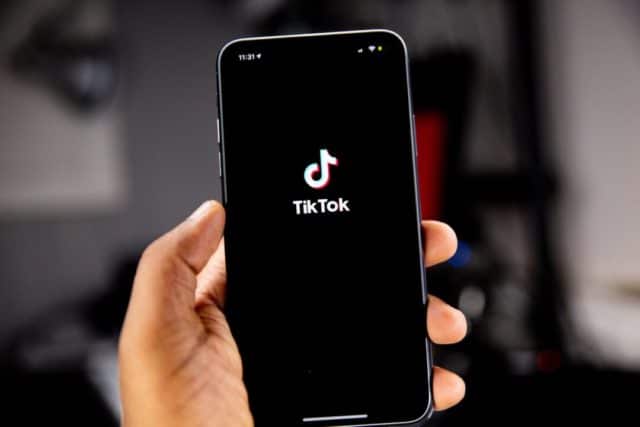
How to add closed captions to TikTok videos?
Learn moreThe repercussions of rich snippets are substantial in terms of click-through rates and traffic. Research studies have illuminated that featuring a rich snippet can amplify click-through rates by up to 30%. Rich snippets bask in the limelight, typically occupying the apex of organic search results. This heightened visibility captures users’ attention more effectively, compelling them to engage with content. Consequently, videos accompanied by rich snippets are more likely to witness heightened traffic and user engagement.
Crafting Mobile-Friendly Content
The mobile-friendliness of closed captions shines through as a critical facet of creating content tailored for the mobile realm—a domain where video consumption is witnessing exponential growth. In an era where the majority of individuals consume video content on their mobile devices, ensuring a seamless viewing experience is imperative for all viewers, those reliant on closed captions. Closed captions extend the privilege of soundless viewing, a boon for mobile users in environments where audio may prove impractical.
The prevalence of mobile video consumption underscores the compelling need for crafting mobile-friendly content. A Cisco report forecasts that by 2022, mobile videos will command a staggering 75% share of all mobile data traffic. This underscores the urgency of creating content conducive to mobile viewers, accommodating those who prefer watching videos on their smartphones or tablets.
From an SEO standpoint, accommodating mobile viewers is not just prudent; it’s paramount. By providing closed captions for video content, content creators optimize the accessibility of their content and extend an olive branch to a broader audience. Simultaneously, they elevate their prospects of securing higher rankings in mobile search results. Search engines are fiercely committed to prioritizing mobile-friendly content, taking elements like closed captions into account when assessing website rankings for mobile searches. Ignoring the significance of mobile-friendliness and closed captions can lead to the forfeit of potential viewers and a drop in search engine rankings.
Unlocking the Potential of Content Repurposing
Closed captions constitute a resource that transcends their immediate role in video content. They can be repurposed as written content, ushering in a plethora of benefits. By transcribing and editing closed captions, content creators can craft blog posts, social media content, or articles that encapsulate valuable insights from their videos. This not only streamlines content creation but also amplifies the reach of the same content in diverse formats.
The benefits of repurposing closed captions extend to SEO. By infusing written content with keywords and phrases originating from videos, content creators bolster their search engine rankings for those specific terms. This fortifies content visibility, potentially driving greater traffic and engagement. The possibilities are diverse, ranging from creating blog posts centering around key video discussion points to disseminating quotes or statistics from videos on social media platforms. Closed caption transcripts can serve as the foundation for articles or newsletters, effectively maximizing content reach and appeal. This dynamic approach not only augments the reach and impact of current content but also beckons new viewers through varied channels.
How to Order Subtitles and Closed Captions from Amberscript

Legal Compliance and the SEO Nexus
Closed captions serve as a linchpin in legal compliance, a facet that seamlessly converges with SEO best practices. In specific regions, legal requirements mandate the use of closed captions. For instance, in the United States, the Americans with Disabilities Act (ADA) necessitates closed captioning for all video content produced or distributed by government entities. The 21st Century Communications and Video Accessibility Act (CVAA) extends a similar mandate to broadcasters, cable operators, and other video programming distributors, ensuring closed captions for online video content.
Compliance with these regulations not only guarantees accessibility for all viewers but also aligns seamlessly with SEO principles. By providing closed captions, content creators unlock a dual advantage: enhancing accessibility and adhering to the legal landscape, while simultaneously bolstering SEO efforts. The provision of accurate and high-quality closed captions augments the overall user experience, a pivotal component of SEO.
Non-compliance with these legal requirements can precipitate repercussions, including legal action and penalties. More significantly, it erects barriers to entry for a substantial audience reliant on closed captions for accessibility. Consequently, content creators must accord paramount importance to legal compliance, ensuring their videos cater to all viewers.
Embracing the Power of Closed Captions
In the contemporary digital milieu, the creation of valuable and captivating content is the sine qua non of success. By harnessing closed captions within video content, content creators can augment accessibility for all viewers, optimize content for search engines, and ensure legal compliance. The repurposing of closed captions offers an array of opportunities to extend content reach and engagement. Content creators should prioritize the integration of closed captions into their video content, seizing the manifold advantages they offer. In so doing, they conjure inclusive and accessible content that resonates with a broader audience, while concurrently optimizing it for search engines.
How to save time in the workplace with automatic transcription
Workplace productivity is a crucial element in today’s professional landscape. However, employees often grapple with the daunting task of managing and documenting vast amounts of information. This is where automatic transcription, powered by advanced AI technology, steps in. It’s a revolutionary solution that transforms spoken words into written text with remarkable accuracy and efficiency, saving time and resources. In this blog, we’ll explore how automatic transcription can address workplace challenges, enhance productivity, and provide valuable benefits.
The power of automatic transcription
Automatic transcription is a technological marvel that simplifies the arduous task of converting spoken language into written text. Unlike manual transcription, which involves a human transcriber listening to audio recordings and typing out the spoken words, automatic transcription relies on cutting-edge artificial intelligence (AI) algorithms. This AI-driven process is not only faster but also remarkably accurate, as it can decipher multiple accents and dialects and produce transcriptions with minimal errors.
In today’s dynamic workplace, where time is a precious resource, AI-driven transcription services have become invaluable. They play an important role in various industries, including journalism, healthcare, legal, and education, by significantly accelerating the transcription process. This means that professionals can focus on more strategic tasks instead of spending hours transcribing audio or video content manually. AI-driven transcription services are adaptive, capable of handling a diverse range of content, from business meetings to medical consultations, with ease.
One of the standout features of automatic transcription tools is their exceptional accuracy. Thanks to AI’s continuous learning, these tools constantly improve their accuracy, making them reliable for capturing even the most complex conversations. Up until now the accuracy accounts to 80 – 90%. Moreover, they work at an impressive speed, transcribing content in real-time or within minutes, depending on the length of the recording. This swift turnaround time means that information can be processed and shared quickly, benefiting businesses and professionals across the board.
The impact of time-saving through automatic transcription is particularly pronounced in industries where swift information processing is of paramount importance. In the field of journalism, reporters can efficiently transcribe interviews and press conferences, facilitating the rapid dissemination of news. Within the healthcare sector, medical professionals can transcribe patient notes with remarkable efficiency, leading to quicker diagnoses and treatment. Similarly, educators can convert lectures and discussions into written form, saving hours of manual note-taking while simultaneously elevating the quality of educational content.
Increased productivity
Efficient transcription, as enabled by automatic transcription services, serves as a catalyst for heightened productivity in the workplace. By expediting the process of converting spoken content into written form, automatic transcription liberates employees from the time-consuming task of manual transcription. This, in turn, empowers them to allocate their time and expertise to more strategic and value-added responsibilities. Professionals can channel their newfound time towards critical decision-making, brainstorming innovative ideas, and enhancing customer engagement. In essence, they transition from being bogged down by administrative work to being strategically positioned to drive the organization forward. This transition not only increases personal productivity but also contributes to the overall success of the business.
The core principle is simple: time saved equals increased opportunities for productivity.
Ambercript’s solution
Ambercript stands as a trailblazer in the realm of transcription and subtitling services, renowned for its commitment to excellence and innovation.
Ambercript’s automatic transcription services are more than just a convenience; they are a strategic tool for elevating workplace efficiency. Our services are characterized by a multiple key features: accuracy, speed, and reliability. The accuracy of our AI-driven transcription technology ensures that every word is faithfully transcribed, even in cases of complex accents or industry-specific jargon. Speed is another hallmark, with the ability to transcribe in real-time or with swift turnarounds, facilitating prompt decision-making. Lastly, reliability is embedded in our services, with meticulous attention to detail to ensure precision and consistency.
What sets Ambercript apart is our holistic approach, blending the power of AI-driven technology with the discerning touch of human expertise. Our automatic transcription process begins with the cutting-edge capabilities of artificial intelligence, ensuring a rapid and precise transcription. But we don’t stop there. Our team of skilled human transcribers meticulously review and edit the AI-generated transcriptions to guarantee unparalleled accuracy and quality. This unique synergy between technology and human oversight ensures that Ambercript’s transcriptions are not only accurate but also reliable, making them a trusted resource for professionals and organizations worldwide.
Ambercript’s commitment to excellence and our fusion of technology and human touch make us the ideal partner for those seeking dependable and efficient transcription services in today’s fast-paced workplace.
How to get started
Getting started with automatic transcription services is a straightforward process, and Ambercript is here to guide you every step of the way. Here’s a simple guide to kickstart your journey towards increased workplace productivity:
Step 1: Visit Ambercript’s website
Begin by visiting our website at www.ambercript.com. You’ll find a user-friendly interface that offers quick and easy access to our transcription services.
Step 2: Sign up or log in
New users can register for an account by clicking on the “Try it free” button. If you’re already part of our community, simply log in to your existing account.
Step 3: Choose your plan
Select the plan that best suits your needs. Whether you require occasional transcription or have ongoing transcription demands, we have flexible plans designed to accommodate all scenarios.
Step 4: Upload your audio or video files
Once you’re logged in and have chosen a plan, you can effortlessly upload your audio or video files directly on the platform.
Step 5: Receive your transcriptions
Sit back, relax, and let our advanced AI technology and human experts work their magic. Your transcriptions will be ready for download in no time.
Remember, we’re here to support you throughout the process, and if you have any questions or need assistance, our customer support team is just a message away.

To make the most of automatic transcription and supercharge your workplace productivity, here are some practical tips:
- Optimize recording quality: Ensure clear and high-quality audio recordings for more accurate transcriptions.
- Use timestamps: Timestamps help locate specific content within a transcript easily.
- Customize speaker labels: Specify speaker labels for multi-speaker recordings to distinguish speakers effectively.
- Edit and proofread: While our technology is highly accurate, a final review by a human can further enhance the quality.
- Explore additional features: Check out any extra features, such as language support or transcription export options, to tailor the service to your exact needs.
With these tips and the convenience of automatic transcription, you’ll be on your way to unlocking newfound productivity in no time.
Ambercript emerges as a leader in this field, offering unparalleled automatic transcription services that combine AI-driven technology with the precision of human expertise. Our commitment to accuracy, speed, and reliability sets us apart as a trusted partner for your transcription needs.
We invite you to take the next step. Visit www.ambercript.com and explore the possibilities. Sign up for our free trial and witness the difference that automatic transcription can make in your workplace. The time you save, the productivity you gain, and the opportunities that unfold are just a click away.
Join the ranks of professionals who have harnessed the power of automatic transcription to their advantage. Start your journey with Ambercript today and experience firsthand the future of workplace productivity.
Your time is precious. Let Ambercript help you make the most of it.
Subtitling Services: What They Can Do for Your SEO
Subtitling services have become an essential tool for businesses and content creators looking to improve their SEO efforts. In today’s digital age, having a strong online presence is crucial to success, making search engine optimization (SEO) a top priority for many organizations. With the vast amount of content available on the internet, standing out from the crowd can be challenging. This is where subtitling services come in.
Table of Contents
- The Significance of SEO
- The Synergy Between Subtitling and SEO
- Choosing the Right Subtitling Service
- Future Trends in Subtitling and SEO
- Subtitling and The Impact on SEO Efforts
The Significance of SEO
In today’s digital age, having a strong online presence is crucial for businesses and content creators. With the increasing use of search engines to find information, SEO has become a vital tool for improving visibility and attracting target audiences.
Search Engine Optimization (SEO) is the process of optimizing a website or online content to improve its visibility in search engine results pages (SERPs). This involves using various strategies and techniques to make your website more attractive to search engines, ultimately increasing organic traffic and improving your ranking.
What SEO is
In today’s digital age, SEO (search engine optimization) is crucial for businesses and content creators alike. With millions of websites and online content competing for attention, having a strong SEO strategy can make all the difference in standing out from the competition.
SEO matters because it directly affects your online visibility and website traffic. Without proper optimization, your website may not rank as high on search engine results pages, making it difficult for potential customers to find you. This can result in missed opportunities and ultimately affect your bottom line.
Why SEO matters for businesses and content creators
For businesses, strong SEO means increased website traffic, brand visibility, and ultimately more conversions and sales. For content creators such as bloggers or YouTubers, it allows them to reach a wider audience and potentially monetize their content.

How Subtitles and Captions Help Increase Video Views by 80%
Read the blogThe role of keywords and relevance in SEO
Keywords play a vital role in SEO as they are the key terms that users type into search engines when looking for specific information. It is important to choose relevant keywords that accurately reflect your content and target audience. Incorporating these keywords strategically throughout your website or online content can help improve your ranking in search engine results pages. Having relevant and high-quality content is essential for SEO as search engines prioritize valuable and informative content for their users. By creating quality content that is optimized with targeted keywords, businesses and content creators can improve their SEO efforts and attract more organic traffic to their website or online platform.
The Synergy Between Subtitling and SEO
Subtitling services, although primarily used for language translation and accessibility purposes, can also have a significant impact on SEO efforts.
How subtitling enhances SEO efforts
Adding subtitles to your videos or transcribing your audio content can greatly enhance your SEO efforts. This is because search engines are unable to understand the content of videos or audio files, making it difficult for them to accurately index and rank this type of content. By providing accurate subtitles or transcripts, search engines can better understand your content and potentially improve its ranking in search results.
Improving accessibility with subtitling
In addition to improving SEO, subtitling also enhances accessibility for those with hearing impairments or those who prefer to consume content with subtitles. This can potentially attract a larger audience and improve user experience, thus indirectly benefiting SEO efforts.
SEO benefits of transcribing and translating content
Translating and transcribing your content can also have significant SEO benefits. By providing multiple language options for your content, you can expand your reach to a global audience and potentially increase website traffic. It also allows search engines to index your content in different languages, making it more accessible and relevant for international users.
Examples of improved SEO through subtitling
Many businesses and content creators have seen a noticeable improvement in their SEO after incorporating subtitles or transcripts into their content. For example, a study by 3Play Media found that adding captions to videos increased the average viewing time by 12%. This not only improves user experience but also sends positive signals to search engines, potentially boosting SEO efforts. Dropbox saw a 10% increase in conversions after translating their product tour video into five different languages with subtitles. These examples demonstrate how subtitling can directly and indirectly improve SEO efforts for businesses and content creators.

Get a customized offer
Request a quote for your subtitling needs
Choosing the Right Subtitling Service
Selecting the right subtitling service is crucial for achieving successful and effective results. With a plethora of options available, it can be overwhelming to determine which service best fits your needs.
Factors to consider when selecting a subtitling service
When choosing a subtitling service, there are several factors to consider. Firstly, it is important to ensure the service offers accurate and high-quality subtitles or transcripts. This can greatly impact the SEO benefits mentioned earlier. Secondly, consider the turnaround time for the service as this can affect your content’s timeliness and relevancy. Other factors to keep in mind include pricing, customer reviews and ratings, and their ability to handle different languages or dialects.
Tips for finding cost-effective solutions
Subtitling services can vary in pricing, and it’s important to find a cost-effective solution that meets your needs and budget. One tip is to compare prices from different services and consider any additional features or benefits they may offer. It’s also helpful to evaluate the level of customer support provided by the service, as this can greatly impact the overall experience and results.
The importance of accuracy and quality in subtitling
Accuracy and quality should not be compromised when choosing a subtitling service. Poorly translated or transcribed content can harm your SEO efforts, as well as negatively impact user experience. It’s crucial to select a service that guarantees accurate and high-quality subtitles or transcripts to effectively reap the benefits of subtitling for SEO and accessibility. By considering these factors and tips, you can make an informed decision when choosing a subtitling service that aligns with your goals and needs.
Amberscript’s Subtitling Services for SEO Enhancement:
- Machine-Made Subtitles: Harnessing the power of artificial intelligence, Amberscript’s Automated Subtitling Service is a game-changer for SEO. By transforming audio and video content into searchable, synchronized subtitles, this service ensures that your multimedia content is discoverable by search engines. The inclusion of accurate and keyword-rich subtitles can significantly improve your website’s ranking, making your content more accessible to users and boosting organic traffic.
- Human-Made Subtitles: When precision and quality are paramount, Amberscript’s Human-Crafted Subtitling Service shines. Our team of skilled professionals pays meticulous attention to detail, crafting subtitles that not only enhance SEO but also preserve the emotional impact and context of your content. By incorporating relevant keywords naturally into the subtitles, we help improve your content’s discoverability, driving more organic traffic to your website.
- Translated Subtitles: In an increasingly globalized digital landscape, reaching international audiences is key to SEO success. Amberscript’s Translated Subtitling Service facilitates this by expertly translating your subtitles into multiple languages. This not only broadens your audience but also enhances your website’s international SEO efforts, allowing you to connect with users around the world and improve your global search engine rankings.
Upload your audio file. Our speech recognition software creates a first version of the subtitles for your audio, which you can improve in our online editor for a 10x time-saving.
We connect your audio to the subtitles in our online editor and align them perfectly, which you can see in the subtitle preview window. You can realign, adjust and search through your text with ease.
Quickly export your audio with subtitles, or the subtitles separately in Text, SRT, VTT or EBU-STL and many other formats, with optional timestamps and speaker distinction.
By leveraging Amberscript’s subtitling services, you can supercharge your SEO strategy, making your website more visible, accessible, and appealing to search engines and users alike. Whether you’re aiming to improve your local or international SEO, our comprehensive suite of subtitling solutions provides the tools you need to achieve higher rankings and drive more organic traffic to your website.
Future Trends in Subtitling and SEO
As technology continues to advance and the digital landscape evolves, it’s important to anticipate future trends in subtitling and SEO to stay ahead of the game.

The future of subtitles and accessibility
Read the blogPredictions for the future of subtitling technology
With advancements in artificial intelligence and machine learning, there is a growing trend towards automated subtitling services. This could potentially improve turnaround times and reduce costs for businesses and content creators. Additionally, there may be advancements in subtitling technology to better cater to different languages and dialects.
Evolving SEO strategies and their relation to subtitling
As search engines continue to update their algorithms, SEO strategies must also evolve. Subtitling will likely play a larger role in SEO as search engines increasingly prioritize user experience and accessibility. This means that accurate and high-quality subtitles or transcripts will become even more important for improving website rankings.
Embracing new technologies and innovations
In order to stay competitive in the digital landscape, businesses and content creators must embrace new technologies and innovations in subtitling and SEO. This could include incorporating virtual or augmented reality into subtitled content, using voice recognition technology for transcription, and utilizing data and analytics to improve subtitling strategies. By staying open to new technologies, businesses can continue to optimize their subtitling efforts for SEO, accessibility, and user experience.
Subtitling and The Impact on SEO Efforts
Subtitling can greatly impact SEO efforts by improving user experience, increasing viewing times, and sending positive signals to search engines. When choosing a subtitling service, it’s important to consider factors such as accuracy, quality, turnaround time, and pricing. As technology continues to advance, we can expect to see more automated subtitling services and advancements in subtitling technology to better cater to different languages. SEO strategies will also evolve, placing a greater emphasis on the importance of accurate and high-quality subtitles or transcripts.
How to Extract Insights From a Meeting Audio
Meetings are an essential part of any business or organization, but they can often be time-consuming and overwhelming. However, with the advancements in technology, there is now a powerful tool that can help you make the most out of your meetings – transcription. So, whether you are a busy professional looking to streamline your meeting process or a business owner seeking to improve productivity and decision-making, keep reading to discover the power of transcription.
Table of Contents
- The Power of Transcription
- Choosing the Right Transcription Solution
- Using Transcribed Meeting Data
- Best Practices for Effective Transcription
- Transcribing for Meetings
The Power of Transcription
Meetings are a crucial part of any business or organization, allowing teams to come together and discuss important topics. However, with the fast-paced nature of meetings, it can be challenging to keep track of all the information being shared. This is where transcription comes in – the process of converting spoken words into written text.
Benefits of Transcribing Meeting Audio
Transcription offers numerous benefits for businesses and organizations, making it a valuable tool to incorporate into your meetings. One significant advantage is improved understanding. By having a written record of the meeting, participants can review key points and ensure they have a clear understanding of the discussions. Another benefit is enhanced productivity. With transcribed meeting audio, team members can focus on actively participating in the meeting rather than worrying about taking notes. This can lead to more efficient and productive meetings, as well as better decision-making.
Legal documentation is another crucial benefit of transcribing meeting audio. In some industries, it is essential to have a written record of meetings for legal purposes. Transcription provides this documentation in an accurate and comprehensive format, ensuring that all important details are captured and readily available if needed.
Challenges of Manual Transcription
While the benefits of transcription are evident, manually transcribing meeting audio can also present challenges. It is a time-consuming and tedious task that requires a high level of accuracy to capture all the information accurately. This can be especially challenging for longer meetings or discussions with multiple speakers.
The Role of Technology in Automated Transcription
With advancements in technology, there are now automated transcription solutions available to make this process more efficient and accurate. Automatic Speech Recognition (ASR) software uses algorithms and artificial intelligence to transcribe speech into text automatically. This eliminates the need for manual transcription, saving time and financial resources. Automated transcription also allows for faster turnaround times, making it easier to access meeting insights and information quickly. Additionally, ASR software can be integrated with other productivity tools, making it a valuable asset for businesses and organizations.

Get a customized offer
Request a quote for your transcription needs
Choosing the Right Transcription Solution
When it comes to transcribing meeting audio, there are two main options: human transcriptionists and automatic speech recognition (ASR) software. Both have their own advantages and drawbacks, so it’s important to consider your specific needs and budget before making a decision.
Types of Transcription Services
Manual transcription services involve transcriptionists listening to the audio recording and transcribing it manually. This option may be preferred for sensitive industries, such as legal or medical, where accuracy is crucial and human transcriptionists can ensure this. On the other hand, ASR software uses algorithms and machine learning to transcribe audio recordings automatically. This option is faster and more cost-effective, making it suitable for businesses or organizations that need to transcribe a large volume of meetings regularly.
Manual Transcription
The main advantage of human transcriptionists is their ability to accurately capture all the nuances and context of spoken language. They can also handle multiple speakers, accents, and background noise effectively. However, this option can be expensive and time-consuming.
Automatic Speech Recognition (ASR) Software
ASR software is constantly evolving and becoming more accurate, making it a viable option for automated transcription. It can transcribe large volumes of audio recordings quickly and at a lower cost. However, it may not be as accurate as human transcriptionists and may struggle with difficult accents or background noise.
The right type of transcription service will depend on your specific needs and budget. If accuracy is crucial, it may be worth investing in human transcriptionists. But if you need to transcribe a large volume of meetings regularly, ASR software may be the more efficient option. It’s important to weigh the pros and cons of each before making a decision.
Factors to Consider When Selecting a Transcription Solution
When choosing a transcription solution, there are several factors that you should consider to ensure it meets your specific needs and requirements.

- Accuracy: One of the most important factors in selecting a transcription solution is accuracy. You want to choose a service or software that can accurately transcribe meeting audio without any errors. This is especially crucial for industries where accuracy is vital, such as legal or medical fields.
- Speed: Another factor to consider is the speed of the transcription solution. If you need to access meeting insights and information quickly, you’ll want a service or software that can transcribe audio recordings in a timely manner.
- Cost: Transcription services can vary in cost, so it’s important to consider your budget when selecting a solution. Human transcriptionists may be more expensive but can provide higher accuracy, while ASR software may be more cost-effective for larger volumes of meetings.
- Security and Privacy: With the rise in data breaches and privacy concerns, it’s crucial to choose a transcription solution that prioritizes security and privacy. Make sure the service or software has measures in place to protect your sensitive meeting data.
- Customization: Lastly, consider whether or not the transcription solution allows for customization. This can include options for different file formats, speaker identification, and timestamps. Having the ability to customize to your specific needs can make the process more efficient and tailored to your organization’s requirements.
Using Transcribed Meeting Data
Once your meetings have been transcribed, you can leverage the data in a variety of ways to improve your organization’s productivity and efficiency.
Organizing and Storing Transcripts
One way to utilize transcribed meeting data is by organizing and storing transcripts for easy access. This allows for quick retrieval of information when needed, saving time and effort. With the use of technology, transcripts can be stored securely in the cloud, making them easily accessible from anywhere.
Searching and Retrieving Information
With a transcribed meeting, you have a written record of all discussions and decisions made during the meeting. This makes it easier to search and retrieve specific information as needed, rather than having to listen through an entire audio recording. This can be especially helpful for businesses or organizations that need to reference past meetings for project updates or decisions made. Having a searchable and organized transcript can also aid in identifying patterns or trends in discussions and decision-making during meetings. This information can then be used to improve future meetings and productivity within the organization.
Analyzing Insights
Transcribed meeting data can also provide valuable insights for organizations to improve their processes and decision-making.
- Identifying Key Takeaways: With a written record of the meeting, it becomes easier to identify key takeaways and important points discussed during the meeting. This can help ensure that all necessary information is captured and utilized effectively.
- Noting Action Items: In addition to key takeaways, transcribed meeting data can also help identify action items and tasks assigned during the meeting. This makes it easier for team members to stay on track and follow through with their responsibilities.
- Detecting Trends and Patterns: By analyzing transcribed meeting data, organizations can also detect trends and patterns in discussions, decisions, and outcomes. This information can be used to make strategic changes and improvements in future meetings, leading to increased productivity and efficiency.
Utilizing transcribed meeting data can provide valuable insights that can benefit organizations of all sizes and industries. By considering the factors when selecting a transcription solution and effectively using the transcribed data, businesses and teams can benefit from transcription in the best way possible.
Integrating with Other Productivity Tools
Transcribed meeting data can also be integrated with other productivity tools, making it even more valuable for organizations.
Integration with Note-taking Apps
Many transcription solutions allow for integration with note-taking apps, making it easier to take notes during a meeting while simultaneously transcribing the audio. This can save time and effort by eliminating the need to manually transcribe notes after the meeting.
Integration with Project Management Tools
By integrating transcribed meeting data with project management tools, organizations can ensure that all tasks and action items from meetings are tracked and completed efficiently. This creates a streamlined workflow and improves overall productivity.
Integration with CRM Software
For sales teams, integrating transcribed meeting data with customer relationship management (CRM) software can provide valuable insights into client interactions and discussions. This information can then be used to tailor sales strategies and improve customer relationships.
Integrating transcribed meeting data with other productivity tools can enhance the value and effectiveness of this data. By utilizing these integrations, organizations can streamline their processes and improve overall productivity, leading to greater success.
Best Practices for Effective Transcription
In order to get the most out of transcribed meeting data, it’s important to follow best practices to ensure accuracy and quality.

- Recording Quality: To obtain accurate transcripts, it’s important to record meetings in a quiet environment with minimal background noise. Additionally, using high-quality recording equipment can also improve the overall quality of the transcription.
- Speaker Identification: To avoid confusion, it’s crucial to identify speakers in the audio recording before transcribing. This can be done by asking participants to state their name before speaking or using a visual aid such as name tags during the meeting.
- Timestamps: Including timestamps in transcribed data can help with navigation and referencing specific points in the discussion. This can be particularly helpful when searching for information or identifying key moments during a meeting.
- Editing and Proofreading: After receiving the transcribed data, it’s important to review and edit for any errors or omissions. This ensures accuracy and clarity in the final transcription.
- Data Security and Compliance: When selecting a transcription solution, it’s essential to consider the security and compliance measures in place. This includes ensuring that the data is encrypted and secure, as well as complying with any relevant privacy regulations.
Transcribing for Meetings
Transcribing meeting data can provide valuable insights for organizations to improve their processes and decision-making. By following best practices and utilizing integration with other productivity tools, businesses and teams can make the most out of this data for increased efficiency and success. It’s crucial to select a reliable transcription solution that meets the needs of the organization and prioritizes data security and compliance. With these factors in mind, transcribed meeting data can be a valuable asset for any organization looking to streamline their processes and improve overall productivity. So next time you have an important meeting, consider utilizing transcription services to get the most out of your discussions and decisions.
How to create an audio description script
Welcome to the world of audio description, a vital tool for making visual content accessible to the visually impaired or blind. At Ambercript, we’re passionate about ensuring that nobody misses out on the magic of movies, TV shows, and more. Join us as we explore the significance of audio description and how our services help bridge the accessibility gap.
Agenda
- What is an audio description?
- Why audio description matters
- Bringing visual worlds to life through words
- Ambercript’s comprehensive services
- Tips for crafting an effective audio description script

What is an audio description?
Audio description, often referred to as AD, is a transformative narrative technique that enhances the accessibility of visual content for those who are blind or visually impaired. It is, quite literally, a voice of inclusivity, providing a second layer of storytelling that makes on-screen actions, settings, and character expressions come alive through spoken words.
The versatility of audio description extends across a wide spectrum of content, ensuring that individuals with visual impairments can enjoy an array of experiences. From the big screen to small screens, audio description enhances movies, TV shows, online videos, live events, and more. It’s an indispensable companion that opens up a world of possibilities for entertainment, education, and information.
Recognizing the vital role audio description plays in fostering inclusivity, legal requirements are increasingly in place to ensure its implementation. Broadcasters and online platforms, in particular, face mandates to provide accessible content, thus creating a more inclusive digital landscape. This legal framework not only emphasizes the importance of audio description but also encourages its widespread adoption.
Why audio description matters
Audio description has a profound impact on individuals with visual impairments. It opens up an entirely new world of visual content that would otherwise be inaccessible to them. With meticulous attention to detail, every aspect of what’s happening on-screen is described, from the visual backgrounds to the subtlest non-verbal expressions of the characters.
The significance of audio description becomes even more apparent when we look at statistics and real-life examples. Research indicates that audio-described content not only complements but often dramatically enhances the visual experience for people with visual impairments. It allows them to enjoy films, TV shows, or live streams in their full glory, leading to a significantly enriched viewing experience that goes well beyond mere visual perception.
Another crucial aspect is the role of audio description in promoting inclusivity and diversity. It ensures that no one is excluded from cultural experiences or information due to a visual impairment. Accessibility through audio description is a step toward building an inclusive society where everyone, regardless of their physical abilities, has equal access to media and culture.
Bringing visual worlds to life through words
Creating an audio description script is an art that involves several crucial steps. Here, we’ll walk you through the process, from content selection to the final recording, ensuring that visually impaired or blind individuals can experience visual content to the fullest.
Content selection: What to describe and why
The first step in crafting an audio description script is choosing what to describe and understanding why it’s important. This involves a careful selection of visual elements, actions, and settings that are pivotal to the narrative. Decisions made in this phase impact the overall quality of the description, as it shapes the viewer’s understanding and engagement with the content.
Scriptwriting: Creating concise, informative descriptions
Once the content is selected, the next challenge is to create clear, concise, and informative descriptions. Descriptions should be crafted in a way that conveys the essential details without overwhelming the listener. It’s a skill that requires striking the right balance between brevity and depth, ensuring that the auditory experience mirrors the visual one.
Recording: Explaining the voiceover process
The final step involves the recording of the audio description script. Skilled voiceover artists bring the script to life, infusing it with tone, emotion, and clarity. The recording process is crucial for ensuring that the voiceover aligns seamlessly with the visual content. It’s where the magic happens, transforming words into a vivid sensory experience.
Ambercript’s comprehensive services
At Ambercript, we understand the importance of creating high-quality audio description scripts.
1. Expert guidance for audio description
When it comes to Audio Description, our team is here to address all your queries and provide expert advice tailored to your unique requirements. Whether you’re deliberating between synthetic voices or human voices, we’ll assist you in making the best choice for your needs.
2. Unwavering reliability in audio description scripts
Our commitment to delivering 100% reliable Audio Description scripts sets us apart. We collaborate exclusively with seasoned professionals who have extensive experience in crafting scripts for the visually impaired. What’s more, every project undergoes a meticulous quality-check process by individuals with visual impairments themselves, ensuring utmost precision and accuracy.
3. Experience high-quality audio descriptions
Starting from the script, we transform it into pristine audio description sound files. Our production process guarantees the highest quality output. You have the option to choose between human-like synthetic voices or seasoned professional voice actors, and we assure top-notch results throughout the entire recording and delivery process.
Tips for crafting an effective audio description script
Crafting an effective audio description script requires finesse and attention to detail. In this section, we’ll provide you with a set of essential guidelines to help you write descriptions that are not only clear but also engaging, ensuring that the viewer’s experience is as immersive as possible.
1. Guidelines for writing clear and engaging descriptions
When writing audio descriptions, clarity is paramount. Your descriptions should provide a vivid mental image of the visual content without ambiguity. Here are some guidelines to keep in mind:
1. Be concise
- Avoid verbosity and focus on the most critical visual elements.
2. Choose precise language
- Use descriptive words that paint a clear picture without being overly flowery.
3. Prioritize narrative relevance
- Concentrate on elements that impact the story’s understanding.
4. Avoid spoilers
- Be cautious not to reveal crucial plot points before they occur.
2. Maintaining an appropriate pace and tone
The pace and tone of your audio description script play a pivotal role in enhancing the viewing experience. Consider the following:
1. Matching the content
- The pace should align with the speed of the visuals, maintaining synchronization.
2. Tone and emotion
- Match the tone to the mood of the content. Be it excitement, drama, or suspense, the tone should reflect it appropriately.
3. Best practices for editing and reviewing audio description scripts
Editing and reviewing are essential steps to ensure the quality and accuracy of your audio description script:
1. Edit for clarity
- Review the script for any ambiguity or areas where improvements can be made.
2. Grammar and language
- Check for proper grammar and ensure language flows smoothly.
3. Timing and synchronization
- Ensure that the descriptions align perfectly with the visual content and do not lag or overlap.
4. Consistency
- Maintain consistency in terminology and style throughout the script.
The significance of audio description cannot be overstated. It’s not just a tool for accessibility; it’s a doorway to inclusivity, a means of ensuring that everyone, regardless of their visual abilities, can savor the richness of visual storytelling. At Ambercript, we take pride in our role as facilitators of this transformation, offering expert guidance and unwavering reliability in crafting audio description scripts.
Our commitment to 100% accuracy is backed by a team of professionals with years of experience, as well as the watchful eye of those who are visually impaired themselves. We ensure that the audio description experience is not just accessible but of the highest quality. Whether you prefer the seamless voices of synthetic narration or the warmth of professional voice actors, we’ve got you covered.
We’re here to support your journey towards a more inclusive digital experience.
Optimizing your videos with transcription & closed captioning for better SEO
Videos captivate viewers and enhance your online presence. In this blog, we’ll explore how transcriptions and closed captions can boost your video’s SEO. Discover Ambercript’s services to harness the full potential of your videos in the online landscape and lead to better SEO performance.
The power of video content in SEO
In the ever-evolving landscape of SEO, video content has emerged as a formidable force. Its importance is continually on the rise for several compelling reasons.
Exponential growth
Video consumption is skyrocketing, with platforms like YouTube and TikTok witnessing unprecedented user engagement. Search engines are inclined to favor websites that incorporate videos.
Enhanced engagement
Videos are inherently more engaging than text-based content. They capture attention, convey information more effectively, and keep visitors on your site for longer periods, reducing bounce rates.
Improved dwell time
Videos encourage users to stay on your website longer, a metric that search engines interpret as a sign of quality and relevance. Longer dwell times contribute positively to your SEO ranking.
Content variety
Offering diverse types of content, including videos, caters to a broader audience. Some users prefer visual and auditory learning, making videos a valuable addition to your content strategy.
However, merely having videos on your website isn’t enough. Accessibility is key. Search engines prioritize websites that ensure all users can access and understand the content. This is where transcriptions and closed captions come into play, making your videos not only engaging but also SEO-friendly.
Why transcriptions and closed captions matter
Transcriptions and closed captions are invaluable tools for enhancing the accessibility and impact of your video content. Here’s why they matter:
Defining transcriptions and closed captions
Transcriptions are textual representations of spoken content in a video, while closed captions are synchronized text displayed on the screen, including not only spoken words but also relevant sounds and music. They make your video content accessible to diverse audiences, including those with hearing impairments and non-native language speakers.
Expanding accessibility
Transcriptions and closed captions break down language barriers and ensure that your video content can be understood by a global audience. They empower viewers who are deaf or hard of hearing to engage with your content, fostering inclusivity.
Enhancing user experience
Providing these text-based options enriches the user experience, allowing viewers to comprehend your video content even in noisy environments, during silent viewing, or when they simply prefer reading over listening. This versatility increases engagement and time spent on your site.
Boosting SEO
Search engines like Google value accessibility and user experience. When you provide transcriptions and closed captions, you not only enhance the accessibility of your videos but also make them more search engine-friendly. Search engines can index the text, which contributes to higher SEO rankings and visibility. Additionally, keywords present in transcriptions and captions further improve your video’s discoverability.
SEO benefits of transcriptions and closed captions
Transcriptions and closed captions offer a direct path to improving your video content’s search engine optimization (SEO). Let’s explore how they can boost your rankings and visibility:
Text-based content and SEO
Search engines, including Google, rely on text-based content to index and rank web pages. While they’ve become more sophisticated in understanding video content, they still heavily depend on associated text to determine the video’s context and relevance to user queries.
Enhancing search engine comprehension
Transcriptions and closed captions serve as a bridge between your video’s visual and auditory elements and the algorithms of search engines. They provide textual context that helps search engines comprehend the content of your video. This, in turn, enables search engines to display your video in search results for relevant queries.
Improving Viewer Experience
Closed Captioning for YouTube SEO
This blog post delves into the intricate relationship between closed captioning and YouTube SEO, demonstrating how this feature can enhance your viewers’ experience while boosting your content’s visibility.
Read blog nowThe human touch in transcription
Amberscript’s human-made transcription services are tailored to deliver unparalleled precision and quality. With a team of skilled transcriptionists, we ensure that your content is not just accurately transcribed but also enriched with contextual understanding.
Advantages of human-made transcriptions
Human transcriptionists bring a level of accuracy, context, and quality that automated solutions can struggle to match. They understand nuances, accents, and idiomatic expressions, providing transcriptions that capture the essence of spoken content.
Professionalism in complex content
When dealing with complex or industry-specific content, professionalism is paramount. Our human transcribers are adept at handling intricate subject matter, ensuring that the transcription is not just a verbatim representation but a coherent and meaningful document that retains the message’s integrity.
By choosing Ambercript’s human-made transcription services, you can trust that your content is transcribed with meticulous attention to detail, maintaining its authenticity, context, and professionalism.
The efficiency of AI-driven transcriptions
Ambercript also offers AI-driven transcription services, combining speed and cost-effectiveness to meet your transcription needs. Here’s a closer look at the advantages of our AI-driven solutions:
Ambercript’s AI-driven transcription services
Our AI-driven transcription services are designed for efficiency and rapid turnaround. Powered by cutting-edge technology, they offer a quick and cost-effective solution for transcribing your content.
Speed and cost-effectiveness
AI-driven transcriptions are known for their incredible speed. They can transcribe large volumes of content in a fraction of the time it would take human transcriptionists. This efficiency not only saves time but also reduces transcription costs, making it an attractive option for businesses with budget constraints.
Quality control measures
While AI-driven transcriptions are swift and economical, we understand the importance of accuracy. That’s why Ambercript employs rigorous quality control measures to ensure the transcriptions are error-free. Our platform includes editing and review features, allowing you to fine-tune the output for precision and readability.
How Amberscript works

Best practices for using transcriptions and closed captions
Effectively implementing transcriptions and closed captions in your video content can significantly enhance user experience and boost SEO. Here are some best practices to consider:
Start with accurate transcriptions
- Ensure that your transcriptions are error-free and contextually sound. Choose the right service, whether AI-driven or human-made, to match your content’s complexity.
Synchronization
- Ensure that closed captions are synchronized with the audio and video to provide a seamless viewing experience.
Formatting and placement
- Position your closed captions for readability. They should not obstruct essential visuals or cover critical parts of the video.
- Use legible fonts and contrasting colors for readability.
Consider a range of devices
- Remember that viewers may access your content on various devices, so ensure your captions are compatible with mobile and desktop screens.
Styling options
- Experiment with styling to make your captions visually appealing. Options such as font styles, colors, and background opacity can enhance the aesthetics.
- Maintain consistency in styling throughout your video content to create a cohesive brand image.
Engagement insights
- Use your transcriptions and closed captions to highlight key points, quotes, or calls to action in your video content.
- Implement appropriate formatting to distinguish between speakers or to indicate sound effects, music, and other non-verbal audio elements.
Herw we talk a little bit about styling options of subtitles
How to add subtitles in iMovie?
This comprehensive guide will explain to you the whole process as well as describe what subtitles and iMovie are, how to add subtitles to your videos, and how to get SRT files with Amberscript.
Read blog nowFinal thoughts
In this blog post, we’ve embarked on a journey to uncover the pivotal role of transcriptions and closed captions in optimizing video content for superior SEO. We encourage you to consider Ambercript’s comprehensive range of transcription and subtitling services to elevate your video optimization efforts. Whether it’s the precision of human-made transcriptions or the speed of AI-driven solutions, we’re here to empower you in the world of video SEO. Transform your videos into SEO powerhouses with Ambercript and unlock new horizons of online engagement and discoverability.
How to convert videos into word documents
Video content is king, but text documents remain essential for accessibility, SEO, and content repurposing. Converting videos into word documents is a powerful way to enhance the reach and impact of your multimedia content. Ambercript, your transcription and subtitling partner, offers an innovative solution to seamlessly transform videos into text. In this blog post, we will explore the importance of video-to-text conversion, compare traditional and automated transcription methods, walk you through the process, and highlight the benefits of using Ambercript’s services.
The importance of video-to-text conversion
Video content is everywhere, but its potential is limited without accompanying text. Converting videos to word documents is vital for several reasons:
Accessibility – Bridging the inclusivity gap
By providing transcripts alongside your videos, you open the doors to inclusivity. Individuals with hearing impairments can read along, ensuring they don’t miss out on valuable content. This approach aligns with universal design principles, making your content accessible to everyone.
SEO optimization – boosting discoverability and ranking
Search engine optimization (SEO) is the lifeblood of online visibility, and search engine crawlers struggle to understand video content. As a result, your videos may not rank as high as text-based content. Converting videos into word documents allows search engines to index your content effectively.
Content repurposing – Unlocking endless possibilities
Transcripts of your videos serve as a treasure trove of source material for various content forms. Whether you’re repurposing content into blog posts, articles, ebooks, or social media posts, transcripts make it easier to transform your video content into multiple formats.
Time savings – The efficiency of reading
When you provide word documents alongside videos, you empower your audience with a choice. Some may prefer to watch the video, while others may opt to skim through the text for quicker consumption. This flexibility ensures that your content caters to varying audience needs, enhancing overall engagement.

or get a customized offer
Request a quote for machine-made transcription
Traditional transcription vs. Automated transcription
When it comes to the conversion of videos into text, you have choices: traditional human-made transcription and automated transcription. Each approach offers distinct advantages and limitations. Let’s delve deeper into these methods:
Traditional Transcription
Traditional transcription relies on human transcriptionists who listen to the audio in the video and manually transcribe it into text. This method is renowned for its precision, offering a level of accuracy that automated solutions may find challenging to match. Human transcribers can capture nuances, accents, and contextual elements that automated systems sometimes struggle with. However, the high level of accuracy in traditional transcription comes at a cost, both in terms of time and money.
Automated Transcription
In contrast, automated transcription leverages the power of artificial intelligence (AI) and speech recognition technology. It’s a fast and cost-effective solution for converting videos into text. AI can process vast amounts of content in a fraction of the time it would take a human transcriber. This rapid turnaround is especially valuable when dealing with large volumes of video content.
However, automated transcription systems, while efficient, may lack the human touch and nuanced understanding that human transcribers bring. They can sometimes misinterpret accents, mumble, or background noise, resulting in minor inaccuracies.
Ambercript’s unique approach
Ambercript’s mission is to bridge the gap between these two methods, providing a solution that combines the best of both worlds. We start with AI-driven transcription for rapid speed and cost-effectiveness. After the AI transcription, our expert human proofreaders step in. They meticulously review and refine the text, ensuring that it not only reflects the spoken content accurately but also addresses any nuances, accents, and contextual elements. This critical human touch enhances the accuracy and overall quality of the transcription. With Ambercript, you can trust that your video content is accurately transcribed and ready for a wide range of applications.
How to begin your journey with Ambercript
Are you excited to embark on your transcription adventure with Ambercript?
Joining us is a straightforward process, and here’s a step-by-step guide to get you started:

1. Upload Your Audio or Video File
Begin by visiting our website and securely uploading your audio or video files. Our system accommodates a wide range of content, including audio clips, recorded phone conversations, audiobooks, and any other digital files.
Select Your Preferred Language
Specify the language in which you’d like your text to be transcribed. Our team of language specialists consists of native speakers who ensure the utmost accuracy, whether you need a polished document or an exact verbatim transcript.
2. Choose Your Transcription Style
Next, choose between automated or manual transcription. You have the freedom to decide how you want your content transcribed. Opt for our human-made transcription service, which offers precision levels of up to 100%. Alternatively, you can select our machine-made transcription service, which leverages AI recognition to automatically convert your audio and video into text. This automated option saves you valuable time.
3. Receive Your Completed Transcript
Leave the heavy lifting to us. We handle all aspects of transcription, including editing and file formatting. You’ll soon receive your completed transcript in a convenient document format, ready for export. Our options include industry-standard formats like SRT and VTT, complete with timestamps and speaker identification, where needed.
Benefits of using Amberscript
Amberscript’s services are:
Edit your text in minutes or leave the work to our experienced transcriptionists.
Our experienced transcriptionists and thorough quality controls ensure 100% accuracy of transcripts.
Through a series of integrations and API interfaces, you can fully automate your workflows.
Your data is in safe hands. We are GDPR compliant + ISO27001 and ISO9001 certified.
Making Media Accessible: The Importance of Audio Description
Accessibility is a crucial aspect of media consumption that is often overlooked. While many of us take for granted the ability to see and hear what is presented on screen, individuals with visual impairments face barriers in accessing the same content. This disparity not only hinders their ability to fully enjoy and engage with media, but it also perpetuates the exclusion of a large portion of society.
Table of Contents
- The Importance of Accessibility in Media
- Understanding Audio Description
- The Impact of Audio Description
- How Audio Description is Created
- Audio Description in Movies and Television
- Audio Description on Video Streaming Platforms
The Importance of Accessibility in Media
There are over 1 billion people worldwide with some form of disability, making up around 15% of the global population. This means that a significant portion of society may face barriers to accessing media content without proper accommodations. Accessibility is not just a matter of convenience but a fundamental human right that promotes inclusivity and diversity. It allows for the representation and recognition of diverse perspectives and experiences, creating a more equitable society.
Accessibility benefits not only individuals with disabilities but also their families, friends, and caretakers. By making media accessible, we can foster a sense of community and understanding among different groups in society. This is particularly important in the entertainment industry, where media has the power to shape attitudes and perceptions towards marginalized communities. By incorporating accessibility measures such as audio description, we can promote positive representation and social inclusion.
Understanding Audio Description
Audio description is a valuable tool that provides individuals with visual impairments access to media content. This form of accessibility involves narrating the important visual elements of a movie, TV show, or live event, allowing those who are unable to see them to fully understand and enjoy the content.

What is audio description?
Audio description, also known as video description or descriptive narration, is an additional audio track that provides verbal descriptions of visual information in media for people with visual impairments. It narrates important visual elements such as actions, gestures, and scene changes that are not communicated through dialogue or sound effects. This narration is inserted during pauses in dialogue or sound to avoid interfering with the original audio, allowing viewers to hear both the description and dialogue simultaneously. Audio description aims to make media content more accessible and inclusive for individuals who are blind or have low vision.
How does audio description work?
Audio description works by providing a verbal narration of important visual elements in media. This narration is carefully crafted to describe the essential visual information without interrupting or overlapping with the original audio. Audio describers must have a thorough understanding of the story, characters, and visuals in order to effectively convey the key elements to the audience. The audio description track is typically added during post-production and can be accessed by viewers through a secondary audio channel.

How to Add Audio Description to Your Videos
Learn moreWhy is audio description important for inclusivity?
Audio description plays a crucial role in making media accessible and inclusive for individuals with visual impairments. It allows them to fully experience and enjoy various forms of media, including movies, TV shows, and streaming content. By providing verbal descriptions of visual elements, audio description enables those with visual impairments to follow the plot, understand character interactions, and visualize settings. This promotes inclusivity and equal access to media for all individuals, regardless of their abilities.
Key components of an audio description
The key components of an audio description include the visual elements being described, the timing and placement of the descriptions, and the language used to convey the information. The visual elements may range from simple actions and gestures to complex settings and character expressions. The descriptions must be placed strategically during pauses in dialogue or sound to avoid overlap and confusion. The language used should be concise, clear, and objective to provide an accurate representation of the visuals without adding personal interpretations. These key components are essential for creating an effective audio description that enhances the viewing experience for individuals with visual impairments.
The Impact of Audio Description
While audio description primarily benefits individuals with visual impairments, it also has a wider impact on promoting inclusivity and diversity in media. By making content accessible to those with disabilities, we create a more equal playing field for all individuals to enjoy and engage with popular movies, TV shows, and live events.
Benefits for individuals with visual impairments
The primary impact of audio description is on individuals with visual impairments, who are often excluded from fully experiencing media content due to the lack of accessibility features. By providing verbal descriptions of visual elements, audio description allows them to follow along with the plot, understand character interactions, and visualize the settings. This not only enhances their viewing experience but also promotes independence and inclusivity. Audio description has been proven to increase engagement and comprehension for individuals with visual impairments, making it an essential tool for equal access to media.
Enhancing the viewing experience for everyone
One of the surprising benefits of audio description is its impact on viewers without visual impairments. By providing additional context and details, audio description enhances the overall viewing experience for everyone. It allows viewers to fully understand the plot and characters, especially in complex or fast-paced scenes. Additionally, audio description can help individuals with learning disabilities or those who are not fluent in the language of the media. This makes audio description a valuable tool for promoting inclusivity and diversity in media.

4 easy ways to make video content accessible to everyone
Find out moreCompliance with accessibility regulations
With the growing recognition of the importance of accessibility, many countries have implemented laws and regulations to ensure equal access to media for individuals with disabilities. This includes requirements for audio description in television and movie productions. By providing audio description, content producers are not only promoting inclusivity but also complying with these accessibility regulations. This helps create a more inclusive society where individuals with disabilities can fully participate in and enjoy various forms of media. Overall, audio description has a significant impact on promoting accessibility and inclusivity for all individuals. By understanding and implementing this important tool, we can create a more inclusive society where everyone can equally enjoy media content.
How Audio Description is Created
Audio description is a specialized technique used to make media content accessible for individuals with visual impairments. Trained audio describers provide verbal descriptions of important visual elements in movies and television shows, allowing individuals with disabilities to follow along and fully experience the content.
The role of audio describers
Audio description is a specialized skill that requires both technical and creative abilities. Audio describers are responsible for crafting the narration that describes key visual elements in media content. They must have a deep understanding of the story, characters, and visuals in order to effectively convey the information to the audience. Audio describers also play a crucial role in ensuring the accuracy and quality of the audio description track. They are often hired by production companies or accessibility services to create audio descriptions for various forms of media.
Techniques and guidelines for effective audio description
Creating effective audio description involves utilizing specific techniques and following guidelines to ensure accuracy and clarity. Some common techniques include pausing during dialogue or sound to avoid overlap, using concise and objective language, and describing only pertinent visual elements. It is also important for audio describers to understand the intended audience and adapt their descriptions accordingly. Guidelines provided by organizations like the American Council of the Blind and the Described and Captioned Media Program can help ensure consistency and quality in audio description production.

Digital accessibility and WCAG 2.1 standards
Learn moreChallenges in audio description production
Despite its importance, audio description production presents several challenges. One of the main challenges is finding a balance between providing enough information for individuals with visual impairments without interrupting the viewing experience for those without visual impairments. Additionally, creating audio descriptions for fast-paced or complex scenes can be challenging and requires careful planning and execution. Technical issues such as incorrect timing or placement of descriptions can also affect the overall effectiveness of audio description. However, with proper training and understanding of the audience, these challenges can be overcome to create high-quality audio descriptions.
Audio Description in Movies and Television
Audio description has become an essential tool in making movies and television shows accessible for individuals with visual impairments. In addition to providing audio description tracks, there have been other accessibility initiatives in movies and television that benefit individuals with disabilities. For instance, some movie theaters now offer special screenings with open captions and audio descriptions, making it easier for individuals with hearing or visual impairments to attend. In addition, some television networks have started including audio description tracks for their live broadcasts of major events such as awards shows and sports games. This not only benefits those watching at home but also promotes inclusivity and accessibility for live events. These initiatives show a growing awareness and commitment to making media content more accessible for all individuals. The use of audio description can also lead to a larger audience for these productions, as it allows individuals with visual impairments to fully engage with and understand the storyline.
Accessibility initiatives in movies and television
Audio description has become increasingly common in mainstream cinema and television. This is largely due to the efforts of disability rights advocates and organizations, as well as advancements in technology that make audio description easier to produce and distribute. For example, in 2019 Disney released their live-action remake of “The Lion King” with an audio description track, making it accessible to individuals with visual impairments. Similarly, the popular TV show “Game of Thrones” also provided audio descriptions for its final season, allowing fans with visual impairments to fully enjoy the show.
Audio Description on Video Streaming Platforms
With the rise of video streaming platforms, accessibility has become more prevalent in mainstream media. This includes the availability of audio description tracks for a wide range of content on popular streaming services such as Netflix, Amazon Prime, and Disney+.
Accessibility initiatives by popular streaming services
In recent years, popular video streaming platforms such as Netflix, Amazon Prime, and Disney+ have made significant efforts to improve accessibility for individuals with disabilities. This includes providing audio description tracks for a wide range of content, including both original and licensed productions. These initiatives not only benefit individuals with visual impairments but also promote inclusivity and diversity in media. As the popularity of video streaming continues to grow, these accessibility efforts have a significant impact on making media content more accessible for all.
Features and availability of audio description
Most major video streaming platforms now offer the option to enable audio description tracks when available. This allows viewers to easily access audio descriptions without having to purchase separate audio description devices or services. Some platforms also provide features such as customizable playback speed and audio description settings, allowing individuals to adjust the viewing experience according to their preferences. However, there is still room for improvement in terms of availability and consistency of audio descriptions on different platforms, which can vary depending on region and licensing agreements. As technology continues to advance, it is important for streaming services to prioritize accessibility and continue to expand their audio description offerings.
Making Media Content Accessible
Audio description plays a crucial role in making media content more accessible for individuals with visual impairments. Trained audio describers utilize specific techniques and guidelines to create accurate and effective descriptions that enhance the viewing experience for those with disabilities. With the growth of audio description in mainstream cinema and the efforts of streaming services to provide accessibility features, there is now more options available for individuals with visual impairments to access popular movies and TV shows. By prioritizing accessibility, we can create a more inclusive media landscape that benefits everyone.
How Video-to-Text Will Impact the Way We Communicate
Are you ready for the future of communication? The ever-evolving technology of video-to-text is set to revolutionize the way we access, create, and consume content. In this blog post, we will explore the exciting possibilities and potential impacts of this emerging technology on our daily lives. Get ready to dive into the world of video-to-text and its potential to break down barriers, streamline information retrieval, and even challenge traditional ideas.
Table of Contents
- Video-to-Text Technology in Communication
- Future Implications on Communication
- Video to Text With Amberscript
- Advancements of Video-to-Text Technology
Video-to-Text Technology in Communication
Communication is constantly evolving and adapting to new technologies. One such technology that has been gaining traction is video-to-text, which involves the conversion of spoken language in videos into written text. This technology not only facilitates accessibility for individuals with hearing impairments but also streamlines content creation and information retrieval. In this blog post, we will delve into the potential impact of video-to-text technology on the way we communicate in the future.
The Growing Importance of Video-to-Text Technology
With the rise of online content consumption, videos have become a popular medium for communication. However, not everyone is able to fully engage with videos due to hearing impairments or language barriers. This is where video-to-text technology comes in, making digital content more accessible and inclusive for all individuals. As this technology continues to advance, its importance in modern communication will only continue to grow.

What is speech to text software and how does it work?
Learn moreFuture Implications on Communication
With the rapid advancements in technology, communication has become more diverse and accessible than ever before. One such evolution is video-to-text technology, which has transformed the way we consume content and communicate with others. From real-time translation capabilities to integration with emerging technologies, this groundbreaking tool has a promising future with implications that will continue to shape the way we communicate and interact.
Efficient Information Retrieval
Aside from its accessibility benefits, video-to-text technology also offers the advantage of efficient information retrieval. With advancements in video indexing and search algorithms, users can now easily search for specific keywords or phrases within a video, making it easier to find relevant information without having to watch the entire video. This technology also enables the creation of searchable transcripts, allowing for quick access to specific parts of a video.
Simplifying Research and Content Creation
The ability to efficiently retrieve information from videos has numerous real-world applications. Researchers can use video-to-text technology to quickly find and analyze relevant information within videos, speeding up the research process significantly. Content creators can also benefit from this technology by easily finding relevant clips or quotes to include in their videos, without having to spend hours manually sifting through footage. This not only saves time but also enhances the overall quality of content creation. With video-to-text technology, information retrieval has never been easier and faster.
Accessibility Enhancement
One of the most significant benefits of video-to-text technology is its ability to enhance accessibility for individuals with hearing impairments. By providing real-time captioning and transcription services, this technology allows those who are deaf or hard of hearing to fully engage with videos and other digital content. This not only promotes inclusivity but also empowers individuals to access information and participate in online conversations. For example, live streaming events with real-time captioning can now be enjoyed by deaf or hard of hearing individuals, breaking down barriers that have traditionally restricted their participation.

4 easy ways to make video content accessible to everyone
Read the blogReal-Time Captioning and Transcription
The use of video-to-text technology has revolutionized the way individuals with hearing impairments consume digital content. Real-time captioning and transcription services allow for immediate access to spoken language, providing a more seamless and efficient experience for individuals with hearing impairments. This not only benefits their ability to understand and engage with content but also saves them time and effort from having to rely on manual transcriptions or captions. With video-to-text technology, individuals with hearing impairments can now fully participate in online communication without any limitations.
Streamlining Content Creation
Video-to-text technology has also greatly impacted content creation, providing a streamlined process for video bloggers, educators, and businesses alike. With the ability to easily transcribe videos, create searchable transcripts, and add captions or subtitles, content creators can now produce high-quality videos efficiently and effectively. This not only saves time but also ensures a wider reach and better engagement with audiences.
Benefits for Video Bloggers, Educators, and Businesses
For video bloggers or vloggers, video-to-text technology offers the convenience of creating transcripts for their videos, making it easier for viewers to follow along and understand the content. Educators can utilize this technology to enhance learning experiences for students, providing transcripts and captions for educational videos. Businesses can also benefit from video-to-text technology by creating searchable content that improves their online presence and SEO rankings. By making videos more accessible and easier to consume, video-to-text technology has opened up new possibilities for various industries.
SEO Advantages
In today’s digital landscape, having searchable content is crucial for improving search engine rankings and driving traffic. With video-to-text technology, businesses and content creators can optimize their videos by adding searchable transcripts, making it easier for search engines to index the content and rank it higher in search results. This not only attracts more viewers but also increases the chances of conversions and engagements. By utilizing video-to-text tools, content creators can effectively improve their SEO strategies and reach a wider audience.
Personalized Content Consumption
In addition to efficient information retrieval and content creation, video-to-text technology also offers the concept of generating text summaries or highlight reels from videos. This feature caters to time-conscious individuals who may not have the luxury of watching full-length videos but still want access to the main points or highlights. With video-to-text tools, users can easily generate summaries or highlight reels of videos, making it easier and faster to consume content on-the-go.
Impacting Content Consumption Habits
The rise of video-to-text technology is also changing the way individuals consume content. With busy lifestyles and shorter attention spans, people are more likely to engage with content that is easily digestible and can be consumed in a shorter amount of time. By offering text summaries or highlight reels, video-to-text technology caters to this preference, ultimately influencing content consumption habits. This not only benefits time-conscious individuals but also opens up new possibilities for content creators to reach and engage with their audience in more ways than before.
Multilingual Communication
One of the most remarkable features of video-to-text technology is its real-time translation capabilities. With the ability to translate speech into text in different languages, this technology has become a powerful tool for breaking down language barriers and facilitating cross-cultural communication. This feature not only benefits individuals who may speak different languages, but also opens up opportunities for businesses to expand their reach globally.
Cross-Cultural Communication Facilitated by Video-to-Text Technology
Video-to-text technology has already made a significant impact on cross-cultural communication, enabling individuals from different parts of the world to communicate with each other seamlessly. For instance, during live events or conferences, real-time translation of speeches and presentations allows for a more inclusive and diverse audience. Similarly, businesses can now easily connect with international clients and partners through video calls or conferences, with the help of real-time translation provided by video-to-text technology. This not only facilitates smoother communication but also promotes cultural understanding and cooperation. With video-to-text tools breaking down language barriers, the possibilities for multilingual communication are endless.
Integration with Emerging Technologies
As technology continues to advance, video-to-text technology is also evolving and integrating with emerging technologies such as augmented reality (AR) and virtual reality (VR). This integration has the potential to enhance user experiences in various industries, including entertainment and education. By combining video-to-text capabilities with AR and VR, users can now not only watch videos but also interact with them in a more immersive way.
Video to Text With Amberscript
In the fast-paced digital age, where video communication is at the forefront, Amberscript’s innovative transcription and translation services are driving change. They ensure that your content is accessible, emotionally resonant, and globally relevant. Join us on this exploration of the future of video-to-text technology and discover how these services are shaping the way we communicate through the lens of video content.

- Machine-made Transcription: Amberscript’s Machine-Powered Transcription service is a technological marvel that swiftly and accurately transforms spoken content into written text. It forms the foundation for the subtitling and captioning process, ensuring that every spoken word is faithfully transcribed. This service’s versatility shines as it adeptly handles diverse audio qualities and accents, leaving no room for misinterpretation. With this tool, accessibility to video content reaches new heights, making it inclusive for all audiences, regardless of hearing abilities or language proficiency.
- Human-made Transcription: Recognizing the nuances and cultural intricacies of language, Amberscript’s Human-Crafted Transcription service adds a personal touch to the art of subtitling. Here, skilled professionals meticulously craft transcripts with an eye for detail, preserving the emotional impact and precision of every dialogue. The result? A profound and authentic viewing experience that transcends the limitations of mere words on the screen, capturing the essence of the content and its intended emotional resonance.
- Translation: The diverse landscape of video and film often demands transcending language boundaries. Amberscript’s Translation service plays a pivotal role in fostering cross-cultural connections. This service expertly translates subtitles and captions, enabling your video footage to resonate with international audiences. It goes beyond mere language conversion; it encapsulates the essence of your content, enriching the experience for viewers of different language backgrounds. Through this service, your message becomes a global conversation, breaking down barriers and broadening your reach.

Get a customized offer
Request a quote for your needs
Advancements of Video-to-Text Technology
From improving accessibility and efficiency to breaking down language barriers and enhancing user experiences, video-to-text technology has made a significant impact on the way we consume content. With its potential for further integration with emerging technologies, we can only expect this technology to continue transforming various industries and providing new possibilities for communication and interaction. As we move towards a more digitally-driven world, embracing the advancements of video-to-text technology can greatly benefit individuals and businesses alike, making content consumption and communication more seamless, inclusive, and personalized.
Is ChatGPT the academic superpower you’ve been searching for?
Students often face a variety of challenges along their educational journey. Lack of time, research demands and the need to communicate effectively through written content can be daunting. That’s why we’re here to discuss whether the relatively newly launched language model-based chatbot ChatGPT is really the revolutionary tool it’s cracked up to be, and whether and how it can make a difference in your academic endeavors.
Challenges that students face throughout their studies
At the beginning of their academic career, students face a variety of challenges that can sometimes feel overwhelming.
Time is a precious resource for students and they often have to juggle multiple tasks: Attending lectures, studying for exams, participating in extracurricular activities and even a part-time job. At the same time, they want and need to make new friends and build a social life. The pressure to manage time efficiently is omnipresent, and finding ways to maximise productivity is becoming increasingly important.
Also, academic success often depends on the ability to conduct thorough research. Students must sift through a vast amount of information, analyse data and synthesise their findings into coherent essays, reports or projects. This process can be not only time-consuming but also mentally demanding.
Moreover, effective study is a skill that can have a significant impact on a student’s performance. Understanding complex topics, retaining information and preparing for exams are important aspects of the learning process. Yet many students find it difficult to find the most efficient and productive ways of learning.
Finally, in the academic world, effective communication and well-crafted written content are paramount. Whether it’s composing essays, creating presentations, or submitting research papers, the ability to convey ideas clearly and persuasively is a fundamental requirement. Students are evaluated not only on their knowledge but also on their written and verbal communication skills.
Is ChatGPT the new AI-powered writing companion?
ChatGPT represents a groundbreaking advance in AI-driven texting, and may also change the way students approach their academic assignments. Let’s dive into a sophisticated introduction to this impressive tool and take a closer look at its capabilities.
“I am ChatGPT, a state-of-the-art AI language model developed by OpenAI. I am built upon the GPT-3.5 architecture, designed to understand and generate human-like text based on the input provided to me. I have been trained on a diverse range of internet text up until my knowledge cutoff date in September 2021.”
ChatGPT is not just another run-of-the-mill software; it’s the result of relentless AI research and development, a testament to the progress made in natural language processing so far. And OpenAI keeps advancing it. Its primary function is to assist users by providing information, answering questions, generating text, and offering guidance on a wide array of topics. ChatGPT has gained one million users in just its first week after launch and the numbers continue to rise, reflecting the hype that has been going on about the tool.
AI-powered precision
What really sets ChatGPT apart is its ability to tackle a plethora of writing challenges. Whether you’re grappling with the initial stages of brainstorming, composing eloquent essays, refining your writing style, or even meticulously transcribing, ChatGPT’s AI-powered features will support your efforts. The AI recognises the subtleties of context, grammar and style and offers invaluable suggestions and insights to improve the quality of your work. This said, it is advisable to use ChatGPT only for support and food for thought. Since it does not have access to all information and current events, it is important to keep checking its results.
How ChatGPT can benefit students
Let’s explore how ChatGPT can benefit students in various aspects of their educational journey.
1. Time-saving assistance
One of the most precious commodities for students is time. ChatGPT emerges as a valuable ally by significantly reducing the time spent on laborious tasks. Whether it’s drafting lengthy essays, or conducting research, ChatGPT can assist in a multitude of ways. It can quickly generate summaries, outline ideas, and provide informative responses to research queries, allowing students to work more efficiently and allocate their time to other essential activities.
2. Elevating writing quality
The quality of written assignments can be a decisive factor in academic success. ChatGPT goes beyond mere assistance; it acts as a discerning writing companion. By offering grammar and style suggestions, it helps students refine their writing, ensuring that essays, reports, and papers meet the highest standards of clarity and coherence. With ChatGPT’s guidance, students can transform their writing into persuasive, well-structured, and error-free compositions.
However, there is the concern that content generated by AI, such as ChatGPT, might be flagged or recognized as AI-generated. It’s important for students to be aware of this potential issue, especially in educational or academic settings where the use of AI-generated content might not be allowed or might be subject to certain rules and regulations. In cases like this, double checking paragraphs, phrases, facts and information, reformulating and paraphrasing, or not using complete ChatGPT output is advised.
3. Cost-Effective Resource
Hiring human professionals for various tasks like transcription and editing can be expensive. While ChatGPT does not directly transcribe audio, it offers cost-effective alternatives in other areas. It’s available around the clock, providing assistance without incurring additional expenses. This makes it an economical choice for students aiming to manage their budgets efficiently while obtaining high-quality results.
ChatGPT has the potential to be a valuable academic tool and a “superpower” of sorts for students, but it’s important to set realistic expectations. While it offers numerous benefits, such as time savings, improved writing assistance, and research support, it should be viewed as an aid rather than a complete solution to academic challenges.
Use ChatGPT responsibly
Responsible and ethical use of AI tools such as ChatGPT is paramount to maintaining academic integrity and adhering to ethical standards. Let us address the importance of responsible use of ChatGPT and provide valuable guidelines to students:
The importance of responsible use
AI tools are powerful tools, but they should be used with care. Responsible use of ChatGPT ensures that the integrity of students’ academic work is maintained. Plagiarism and unethical practices can have serious consequences for educational success and future careers.
Tips for responsible use
- Review and edit: Do not submit AI-generated content unchanged. Review and edit it thoroughly to ensure it is consistent with your own understanding and style.
- Avoid duplication: Never submit the same ChatGPT-generated content for multiple assignments or courses. Each assignment should be unique and reflect your individual efforts.
- Understand your institution’s policies: Familiarise yourself with your educational institution’s policies regarding the use of AI tools. Adhere to any guidelines set by your school or lecturer.
Using ChatGPT for common student tasks
Note-taking support
- Enter your lecture notes or the main points you want to summarise.
- ChatGPT generates concise summaries or outlines based on your input.
- Review the generated content, make the necessary changes and use it as a learning aid.
Assist with essay writing
- Provide a clear and concise essay prompt or topic.
- ChatGPT can help you brainstorm ideas, outline your essay or even create introductory paragraphs.
- Edit and expand the AI-generated content to write a comprehensive essay.
Research assistance
- Describe your research topic or specific questions.
- ChatGPT can provide relevant information, suggest research directions or even generate reference lists.
- Check the accuracy and relevance of the information generated by the AI and use it as a starting point for further research.
Refine the language
- Type your drafts or sections of written assignments.
- ChatGPT can make grammar and style suggestions to improve the clarity and coherence of your text.
- Carefully review and implement the AI-generated suggestions to improve the quality of your work.
Language translation
- Enter a text that you want to translate into another language.
- ChatGPT can help you with accurate translation, making it a useful tool for language learners.
Summaries
- Type longer articles or research papers.
- ChatGPT can create concise summaries to help you quickly grasp the key points of complex texts.
Coding and programming
- Describe your problems or questions about programming.
- ChatGPT can offer code snippets, explanations or debugging tips.
How to transcribe audio to text
While ChatGPT itself does not have the capability to directly transcribe audio, students can still use it in conjunction with other tools and methods to assist with audio transcription for qualitative research, including expert interviews.
For audio transcription needs, it’s recommended to use specialized transcription software or services that are explicitly designed for this purpose, such as Amberscript. These services typically incorporate automatic speech recognition (ASR) technology to accurately transcribe audio content.
Here is how Amberscript can help transcribing interviews, lectures or presentations
Amberscript is a cutting-edge transcription and subtitling service that stands out for its remarkable accuracy and efficiency. Using advanced automated transcription technology, Amberscript effortlessly converts audio and video content into meticulously crafted written transcripts. Its user-friendly platform and customizable settings make it a preferred choice for professionals, researchers, and students seeking fast, reliable, and highly accurate transcriptions. With Amberscript, transforming spoken words into written text has never been more seamless and precise, making it an invaluable asset for various industries and applications.

Create an Amberscript account:
- Visit the Amberscript website.
- Sign up for an account if you don’t already have one.
Upload your audio/video file:
- Log in to your Amberscript account.
- Navigate to the dashboard or transcription section.
- Upload the audio or video file of your interview.
- Ensure that the file you upload is of good quality to enhance transcription accuracy.
Configure settings (if necessary):
- Choose the language of the interview, set speaker identification if applicable, and select any other preferences.
Initiate the transcription:
- Start the transcription process by clicking the appropriate button or option.
- Amberscript’s automated transcription technology will analyze the audio or video content and generate a preliminary transcript.
Review and edit:
- Once the initial transcript is generated, review it carefully.
- Edit the transcript to correct any errors in the user -riendly online-editor, fill in missing words or phrases, and ensure that the content is accurate.
Export the transcript:
- After reviewing and editing the transcript, you can usually export it in a format of your choice, such as a Word document, PDF, or text file.
- Save the transcript to your computer for further use.
Citation and ethical considerations:
- If you plan to use the transcript for academic or research purposes, remember to properly cite the source, which may include mentioning that the transcription was done using Amberscript.
Support from ChatGPT
ChatGPT can be a valuable asset especially in the planning stage of the qualitative interview process.
- Research assistance: Before conducting interviews, researchers often need to gather background information on the topic or potential questions to ask. ChatGPT can help researchers by generating research summaries or suggesting interview questions based on the topic.
- Question generation: ChatGPT can assist in brainstorming and refining interview questions. Researchers can input preliminary questions, and ChatGPT can offer alternative phrasings, probe questions, or additional topics to explore.
It is important to note that researchers should carefully review and refine the output generated by ChatGPT to ensure its accuracy and alignment with research goals. Additionally, ethical considerations, such as obtaining informed consent from interview participants and maintaining data privacy, should always be adhered to throughout the research process.
In closing, ChatGPT emerges as an indispensable companion for students in their academic pursuits. As we’ve explored, this AI-powered tool offers a wealth of advantages, including substantial time savings, enhanced writing quality, and robust academic support.
By harnessing the capabilities of ChatGPT, students can navigate their educational journey with greater efficiency and effectiveness. It’s not merely a tool but a catalyst for academic success, making students faster and smarter in their endeavors.
How to Turn Videos Into PDFs
Video to PDF conversion is an extremely useful tool for businesses, organizations, and individuals alike. With this guide, you’ll learn what video to text conversion is, why it’s important, and how to do it quickly and efficiently. We’ll provide a brief overview of the benefits of converting videos into PDFs before walking through all the steps involved.
Table of Contents
- Converting Videos to PDFs
- The Need for Video to Text Conversion
- Step-by-Step Guide: Converting Videos Into PDFs
- Advanced Tips and Tricks
- Organized and Easily Accessible Content
Converting Videos to PDFs
Converting videos to PDFs is a game-changing process that simplifies video management. It optimizes large video files for easy sharing, long-term storage, and improved searchability. Let’s explore how video to text conversion can streamline your multimedia content.
The Significance of Converting Videos to PDFs
Video files tend to be large and unwieldy, making them difficult to share and store. They also lack indexing capabilities and can’t be searched like text-based documents. Converting videos into PDFs offers a number of advantages including smaller file sizes, easier sharing, archiving for long term storage, and full-text indexing for better searchability.
Benefits and Use Cases
Converting videos into PDFs allows you to share the content with a wider audience faster and easier than ever before. It also has archiving capabilities for long term storage that would otherwise be difficult to achieve with video files. Additionally, it can provide added features such as image embedding, captions, annotations, and other text-based elements to enhance the multimedia experience.
Steps and Tools
This comprehensive guide will walk you through every step of video to text conversion from preparing your video content to creating a searchable PDF document. We’ll cover different methods and techniques for transcribing videos including automatic transcription services and manual techniques. We’ll also cover advanced tips and tricks such as batch processing for multiple videos, using OCR for scanned or non-textual video content, and integrating video to text conversion into automated workflows. By the end of this guide, you’ll have a comprehensive understanding of how to turn videos into PDFs.
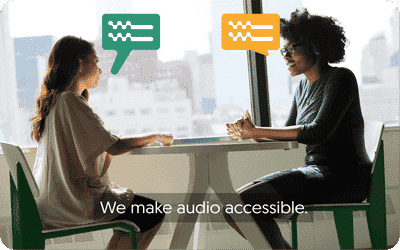
Get a customized offer
Request a quote for Speech-to-Text API
The Need for Video to Text Conversion
Discover why video to text conversion is essential. Videos have limitations, including limited searchability and accessibility. Converting them into text addresses these issues, enhances SEO, and enables content repurposing. Dive into the transformative power of this conversion.
The Limitations of Video Content
Video is an excellent medium for delivering information, but it does have its limitations. Watching a video can be time-consuming and repetitive – you may not catch all the nuances if you watch multiple times, and some viewers may not have the patience or attentionspan to watch the entire video. Additionally, videos are not searchable – if you want to quickly find specific topics or keywords, it can be difficult due to its visual nature.
The Advantages of Having Video Content in Text Format
Converting video into text offers a number of advantages over traditional video formats. Search engine optimization (SEO)can be greatly improved, since text can be easily indexed by search engines. Additionally, video to text conversion makes content more accessible for users with hearing impairments. The same content can also be repurposed quickly and shared across multiple platforms without having to worry about compatibility or format issues.

Best speech to text tools in 2023
Read the blogWhere Video to Text Conversion is Essential
Video to text conversion can be extremely useful in a number of scenarios, such as transcribing speeches and lectures for easy reference and archiving purposes. It can also be used to generate automated subtitles or closed captions for videos, allowing viewers to more easily follow along with the content being discussed. Additionally, it can be used to quickly generate transcripts for legal or medical purposes, ensuring accurate and precise documentation of information.
Step-by-Step Guide: Converting Videos Into PDFs
This guide provides a comprehensive roadmap for converting videos to PDFs efficiently. It covers video preparation, transcription methods, formatting for PDFs, and customization options.
Preparing Your Video Content
- Choosing the Right Video Format: The foundation of video to PDF conversion lies in the selection of the appropriate video format and resolution. Before diving in, ensure that your videos are in an optimal file format, such as MP4 or AVI. This ensures a seamless conversion process. Additionally, opt for a format and resolution that is universally compatible, enabling your content to reach a broader audience.
- Editing and Optimizing Video Quality: Beyond format considerations, optimizing video quality is equally vital. This step ensures that your content is primed for conversion into a PDF document. Leverage well-known video editing tools like Adobe Premiere Pro or Final Cut Pro to fine-tune the audio and visual aspects of your video, ensuring they meet the desired standards.
Converting Video to Text with Amberscript
- Using Automatic Transcription Services: Commencing the video-to-PDF conversion process necessitates the utilization of an automated transcription service, such as Amberscript. This service takes your audio or video file and transcribes it into a text document, ready to be formatted for PDFs.
- Manual Transcription Techniques for Accuracy: In some cases, manual transcription techniques become imperative to ensure precision during the video-to-text conversion. This becomes particularly crucial when specific formatting or stylistic requirements are in play. A meticulous review for typos, grammar, and punctuation errors guarantees the accuracy and precision of your transcriptions before moving on to further formatting.
How to convert Video to Text with Amberscript

Formatting the Text for PDF
- Structuring the Content: With your text transcriptions at hand, the next step is to embark on the formatting journey, turning them into a coherent PDF document. This involves organizing your content, potentially breaking it into sections or subsections as needed.
- Adding Images, Captions, and Additional Context: Enhancing the visual appeal and comprehension of your PDFs can be achieved by integrating images and captions. This not only aids readers in grasping the content but also elevates the document’s visual appeal. Additionally, supplementing the text with context, such as statistics or quotes, enhances clarity.
Creating the PDF Document
- Choosing the PDF Creation Tool: Once your content and formatting are in place, it’s time to breathe life into your PDF document. To accomplish this, you’ll need to select a PDF creation tool, such as Adobe Acrobat Pro or Nitro Pro. These tools empower you to customize the document’s aesthetics, and they offer the capability to introduce additional features like watermarks or bookmarks.
- Customizing PDF Settings and Appearance: Upon choosing your preferred tool for PDF creation, you can commence the customization process to align the document with your specific needs. This entails making choices regarding page size, background color, font type and size, and more. Furthermore, you can incorporate elements such as a table of contents or page numbers to augment professionalism and organization. For an enhanced user experience, contemplate adding interactive elements like links or videos.
Once all the settings for your PDF document are meticulously adjusted, it’s time to export it to a format ready for sharing or printing. Armed with the right tools and meticulous preparation, converting video content into PDF documents becomes a seamless and efficient endeavor.
Amberscript’s services are
5x average time saving by using AI.
Enabling an accurate flow of audio-to-data, adjustable in our easy to use online text editor.
GDPR compliant security and safety.
Advanced Tips and Tricks
Unlock the potential of video to PDF conversion with advanced techniques. Explore batch processing, OCR for non-textual content, and workflow integration. These tips will help you streamline processes, save time, and produce high-quality PDFs from your video content.
Batch Processing for Multiple Videos
For those who need to convert multiple videos at once, batch processing can be a great option. This allows you to select multiple videos and have them processed all at once – saving time and effort in the long run. To take advantage of this feature, make sure your video files are in the same format and resolution before processing them.
Using OCR for Scanned or Non-Textual Video Content
Optical Character Recognition (OCR) technology can also be used to convert scanned documents or other non-textual video content into PDFs. This advanced method is often used when dealing with sensitive data such as medical recordsor legal documents. OCR can detect text from images and then convert it to a readable format that can be used for PDFs.
Integrating Video to Text Conversion Into Automated Workflows
Automating the process of converting video into PDFs can help streamline workflows and increase efficiency. By integrating video to text conversion tools into automated processes,you can quickly and easily generate PDF documents from a variety of sources. This will help cut down on manual labor while still ensuring accuracy in the final output.
Organized and Easily Accessible Content
Converting video to PDF is a great way to keep your content organized and easily accessible. With the right tools, you can quickly and easily convert videos into high-quality documents that are perfect for sharing or printing. By utilizing automated transcription services, manual transcription techniques, formatting features, and advanced integrations,you can ensure that your video to PDF conversion process is as efficient and accurate as possible. With the right preparation, you can create professional-grade documents in no time!
Frequently Asked Questions
-
Can you transcribe audio with foreign accents?
Yes, our software is constantly being trained to pick up on accents and know how to understand them. Want to know more about how this works? Read it here!
-
How do automatic transcription services work?
In a few words, the software “listens” to the audio, identifies the words used and returns it into a text format. That is possible through the use of sophisticated speech recognition technology. In brief, such systems are composed of acoustic and linguistic components running on one or several computers. You can read more about it here.
-
What does Digital accessibility mean for me?
Whether you are a public institution or not, it is always important to think about inclusivity in our society.
We can all help to make sure that everyone is part of the digital revolution, which is making our lives easier every day. In order to help those with visual, auditory, motor or cognitive disabilities, we can come up with solutions to help everyone enjoy the same content. Amberscript is providing software that provides such a solution: we convert audio/video files to text using our speech recognition software, running on an AI-driven engine. To find out more about our products, click here. -
Which audio file formats are supported?
The speech-to-text API supports the following audio file formats: MP3, MP4, WAV, M4A, M4V, MOV, WMA, AAC, OPUS, FLAC and MPG. If you require a different file format, then please contact us here.
-
Can I translate my subtitles and transcriptions via your app?
No, translation is not available in the automatic services but you can order translated manual subtitles services on our platform. Unfortunately, we do not offer translated manual transcriptions. Please check our prices here.
-
Do you offer real-time transcription services?
Yes we do, we provide real-time transcription and subtitling services regularly in a variety of use cases. For more information please reach out to our sales team here.
The Impact of Subtitles and Closed Captioning for Deaf and Hard of Hearing Viewers
Creating content for a global audience can be challenging, especially in terms of accessibility. Subtitles and closed captions are crucial for making your content accessible to diverse viewers. In this blogpost, we’ll guide you through creating compliant subtitles. By the end, you’ll be equipped to enhance the accessibility of your content for all.
Table of Contents
- Understanding the Deaf and Hard of Hearing Community
- Why Subtitles and Closed Captioning Matter
- What to Consider When Creating Accessibility
- Legal Requirements and Standards
- Amberscript: Advancing Accessibility Through Subtitling and Captioning
- Charting the Path Forward: Advancing Accessibility for All
Understanding the Deaf and Hard of Hearing Community
Understanding the Deaf and Hard of Hearing Community is essential for crafting inclusive content. The terms “Deaf” and “hard of hearing” may seem interchangeable, but they have distinct meanings: Deaf individuals have very limited to no hearing, while those who are hard of hearing may retain some degree of hearing. Both groups may identify with deaf culture and primarily use sign language for communication. Hearing impairment is a global public health concern, affecting over 5% of the world’s population, or approximately 466 million people, according to the World Health Organization. Within the community, diversity reigns, with individuals experiencing varying degrees of hearing loss. Recognizing this diversity is critical; a deaf person’s challenges in accessing audio content differ from those with mild to moderate hearing impairment, and profound hearing loss may necessitate extra support when utilizing assistive technologies like closed captioning or subtitles.
Why Subtitles and Closed Captioning Matter
Accessibility in media is not merely a courtesy; it’s a necessity. In this section, we’ll explore why subtitles and closed captioning are pivotal, breaking down barriers and making content universally inclusive.
Barriers Faced by Deaf and Hard of Hearing Viewers
For individuals who are deaf or hard of hearing, accessing audio content can be an arduous task, if not impossible. Without subtitles or closed captioning, they are excluded from the same level of engagement with media that hearing individuals enjoy. Even for those who can lip-read, there are situations where keeping up with dialogue becomes nearly impossible, such as when multiple people are speaking simultaneously or when background noise is present. Subtitles and closed captioning serve as a critical bridge, dismantling these barriers for deaf and hard of hearing viewers.
How Subtitles and Closed Captioning Break Down Barriers
Subtitles and closed captioning serve as powerful tools to enhance accessibility for deaf and hard of hearing audiences. Captions provide a visual representation of the spoken dialogue on screen, enabling viewers to follow the storyline even without audio input. This is particularly valuable for those who rely on sign language as their primary mode of communication since closed captioning allows them to follow the narrative without relying on sign language interpretation.
Additionally, subtitles and captions can extend their utility to educational contexts, such as providing transcripts for lectures or translating foreign-language films. They also benefit hearing viewers in noisy environments or those who struggle with understanding certain accents. Ultimately, subtitles and closed captioning have the potential to make audio content universally accessible.

The future of subtitles and accessibility
Read the blogWhat to Consider When Creating Accessibility
Crafting accessible content goes beyond good intentions; it requires meticulous attention to detail. Here, we delve into the crucial factors to consider when ensuring your content is welcoming to all, from accuracy to formatting.
Accuracy and Quality
- The Importance of Accurate Transcription: Subtitles and closed captioning become effective only when they accurately reflect the audio content displayed on screen. Ensuring that subtitles or captions undergo meticulous proofreading is paramount to detect and rectify any typos or omitted words. Moreover, maintaining synchronization between the captions and the audio track is crucial to prevent viewer confusion and disengagement.
- Proofreading and Editing for Errors: Prior to publication, it is imperative to carefully proofread and edit subtitles and closed captioning to eliminate errors that may have arisen during transcription. Thorough scrutiny for typos, missing words, and other discrepancies can guarantee that viewers access your content seamlessly.
Synchronization
- Timely Display of Captions: When creating subtitles and closed captioning, displaying captions promptly is essential. Captions should appear in sync with the dialogue to avoid distracting delays that could hinder viewers’ comprehension.
- Handling Multiple Speakers and On-Screen Actions: In scenarios featuring multiple speakers or complex on-screen actions, accurately representing these elements in subtitles or captions presents an additional layer of complexity. Special attention must be given to ensure that all audio content is correctly transcribed and displayed.
Language and Localization
- Providing Captions in Multiple Languages: Consideration should be given to the various languages viewers may use when creating subtitles and closed captioning. Offering captions in multiple languages broadens your content’s accessibility and ensures viewers encounter no linguistic barriers.
- Tailoring Content to Regional Dialects: It is equally important to account for the diverse regional dialects viewers may encounter. For instance, captions for a British drama should reflect UK English rather than American English to facilitate easier comprehension.
Formatting and Styling
- Choosing Legible Fonts and Sizes: Careful selection of font type and size for subtitles or captions ensures readability on screen. Small fonts that may prove challenging to read should be avoided. Additionally, selecting a font type that stands out from the background and other on-screen elements is essential.
- Color Contrast for Readability: The choice of caption color should prioritize readability. Opt for high-contrast colors that distinguish captions from other on-screen elements, allowing viewers to differentiate between audio content and visuals.
Sound and Music Descriptions
- Including Descriptions of Non-Verbal Audio Cues: Incorporate descriptions of non-verbal audio cues that enhance viewers’ understanding of on-screen content. This may involve describing sound effects or the significance of background music to the narrative.
- Handling Background Music and Environmental Sounds: Consider any background music or environmental sounds that may be present and describe them accordingly. Detailing the type of music or any noteworthy noises ensures viewers have a richer and more immersive experience.

Accessibility & Subtitling: How to make your content accessible to a wider audience
Learn moreLegal Requirements and Standards
Navigating the legal landscape of accessibility is vital in today’s media landscape. This section provides an overview of the laws and standards you need to be aware of to keep your content compliant and accessible.
Overview of Relevant Accessibility Laws (e.g., ADA, WCAG)
Creating subtitles and closed captioning requires adherence to legal requirements. In the United States, the Americans with Disabilities Act (ADA) and the Web Content Accessibility Guidelines (WCAG) are prominent legal frameworks that outline accessibility standards, including the provision of subtitles and closed captioning for audio-visual material.
Compliance with Accessibility Standards
To comply with these legal obligations, ensure that subtitles and closed captioning meet high standards. This encompasses proofreading for errors, synchronization with audio, offering captions in multiple languages, and tailoring content to regional dialects. Complying with these standards is imperative to guarantee that all viewers can access your content without hindrance.
Consequences of Non-Compliance
Failure to meet legal accessibility requirements carries substantial consequences. It may result in substantial fines, legal actions, and damage to your reputation if viewers encounter difficulties accessing your content due to subpar subtitles or closed captioning. To mitigate these risks, prioritize the creation of high-quality captions and subtitles.
Amberscript: Advancing Accessibility Through Subtitling and Captioning
Embracing cutting-edge technology can streamline the subtitle creation process. We’ll explore the advantages and intricacies of using Amberscript, to create accurate and efficient subtitles for your content.

- Machine-made Transcription: Amberscript’s Machine-Powered Transcription service swiftly and accurately transforms spoken content into written text, laying a solid foundation for the subtitling and captioning process. Its versatility in handling diverse audio qualities and accents ensures that every word is faithfully transcribed.
- AI-Driven Subtitling: Powered by artificial intelligence, Amberscript’s AI-Driven Subtitling service seamlessly transforms transcribed text into synchronized on-screen subtitles and captions. This streamlined integration expedites the workflow, allowing content creators to focus on enhancing the quality and context of their subtitles, all while ensuring accessibility for deaf and hard of hearing audiences.
- Human-made Subtitles: Recognizing the nuances and cultural subtleties of language, Amberscript’s Human-Crafted Subtitling service brings a personal touch to the art of subtitling. Skilled professionals meticulously craft subtitles, preserving the emotional impact and precision of every dialogue, ensuring a profound and authentic viewing experience.
- Translated Subtitles: In the diverse world of video and film, Amberscript’s Translated Subtitles foster cross-cultural connections. By expertly translating subtitles and captions, this service enables your video footage to resonate with international audiences and enriches the experience for viewers of different language backgrounds.

Get a customized offer
Request a quote for your needs
Charting the Path Forward: Advancing Accessibility for All
Looking ahead, the journey toward greater accessibility for the hard of hearing and deaf community is one of ongoing innovation and collaboration. Technologies like Amberscript, with its AI-powered and Human-made solutions, offer promising avenues to make the process of subtitling and captioning more efficient and precise. However, our commitment to accessibility goes beyond technology—it’s a testament to our collective dedication to inclusivity.
Frequently Asked Questions
-
What is Digital accessibility?
Digital accessibility is the ability of a website, mobile application or electronic document
to be easily navigated and understood by a wide range of users, including those users
who have visual, auditory, motor or cognitive disabilities. -
Why is Digital accessibility important?
Digital accessibility is important because it promotes inclusivity and ensures that everyone, regardless of any disability, can have access to the same information. As more and more services and processes in our society become digitalized, it is important to ensure that everyone can enjoy these services and processes. Digital accessibility has also become a topic of interest in European politics, so much so that there are now laws which make it mandatory for public institutions to make all their content understandable and readable for everyone.
-
How to become compliant with the WCAG 2.1?
To become compliant with the WCAG 2.1, it is important to ensure that all audio and video files and features on your website have a textual alternative and vice versa. Do you need to convert audio/video to text? Or do you want to generate captions/subtitles? You can use Amberscript to do so!
-
How is the topic of Digital accessibility related to the EU legislation 2016/2102?
On the 22nd of September 2016, the EU published a directive on digital accessibility regarding the websites of public institutions.
The objectives included in the directive are to be implemented in each EU member state’s national law as of the 23rd of September 2018 and have come into effect. Public institutions are to conform to the European Norm (EN 301 549 V 2.1.2), which refers to a level “A” or level “AA” of the international standards of the Web Content Accessibility Guidelines (WCAG 2.1), as valid minimum requirements in digital accessibility.
To learn more about this topic, read our blog about Digital accessibility and WCAG 2.1 standards.
-
Can I change the position of the subtitles?
That needs to be done using a video editor like VLC. Go to Tools > Preferences [CTRL + P]. Under Show settings, select the option that says All to switch to the advanced preferences. Navigate to Input/Codecs > Subtitle codecs > Subtitles. Under Text subtitle decoder set, the Subtitle justification to left, right or center.
-
How do I generate captions?
You can generate captions automatically using Amberscript. Our software allows you to export transcription based on audio/video files as SRT, EBU-STL or VTT files, which can easily be inserted into a video-editor. Want to know more? Here is a step-by-step guide.
Distance learning: top transcription and captioning services for online educators
In the ever-evolving landscape of education, distance learning has emerged as a transformative force, especially in recent years. With the convenience and flexibility it offers, it has opened up new horizons for students and educators alike. However, as the digital classroom becomes the new norm, ensuring equitable access to educational content is paramount. This is where transcription and captioning services step in, bridging the gap to make online education truly inclusive.
In this blog post, we embark on a journey to explore the top transcription and captioning services tailored specifically for online educators. We’ll delve into why these services are more critical than ever, the factors to consider when choosing the right one, and provide a curated list of the best options available today. Whether you’re an experienced online educator or just venturing into the world of virtual teaching, this guide will equip you with the knowledge and resources to ensure that no student is left behind in the digital classroom.
Table of Contents
- Why Transcription and Captioning Matter in Online Education
- Considerations for Choosing Transcription and Captioning Services
- Top Transcription and Captioning Services
- How to Use Transcription and Captioning Services Effectively in Online Teaching
- Legal Considerations
- Real-World Success Stories
Why Transcription and Captioning Matter in Online Education
In the dynamic realm of online education, accessibility isn’t merely a desirable feature; it’s an ethical and educational imperative. Transcription and captioning services assume a pivotal role in making educational content more accessible and inclusive to all students. As the virtual classroom continues to evolve, it’s crucial to recognize the diverse needs and preferences of learners. Transcriptions and captions address this challenge by breaking down language barriers, catering to various learning styles, and providing essential support for individuals with hearing impairments.
First and foremost, these services enhance accessibility by offering text-based transcriptions of audio and video content. This means that even non-native speakers or those with language comprehension difficulties can engage with course material more effectively. Additionally, for students who learn best through reading or those who struggle with auditory processing, having a written transcript ensures a more comprehensive understanding of the subject matter.
Moreover, captioning services contribute to a more immersive and engaging learning experience. Visual learners, in particular, benefit from the combination of audiovisual content and captions, as it reinforces comprehension and retention. Furthermore, when students can see and read the spoken words simultaneously, it aids in clarifying complex terms, pronunciations, and jargon often used in educational materials.
Beyond these pedagogical advantages, transcription and captioning services fulfill legal requirements as well. Regulations like the Americans with Disabilities Act (ADA) and Section 508 mandate that educational content be made accessible to individuals with disabilities. By providing accurate transcriptions and captions, educators ensure compliance with these laws, mitigating legal risks and fostering an inclusive learning environment.
Considerations for Choosing Transcription and Captioning Services
When it comes to selecting the right transcription and captioning services for your online education needs, several key factors should be taken into account. First and foremost, accuracy is paramount. Consider whether you want to employ automated AI-based transcription services or opt for human transcriptionists. While AI can offer speed and cost-efficiency, human transcriptionists tend to provide higher accuracy and nuanced interpretations. Regardless of your choice, it’s essential to ensure that the service includes a robust quality assurance process to minimize errors and inaccuracies in transcriptions and captions.
Secondly, evaluate the turnaround time offered by the service, as prompt delivery of transcribed content is often crucial in the fast-paced world of online education. Pricing is another significant factor to consider, so weigh the costs against the budget available for accessibility services. Compatibility with your chosen learning management system (LMS) or online platform is also crucial to seamless integration, as not all services support all platforms.
Finally, check whether the service supports the languages required for your course content, ensuring that you can cater to a diverse student population effectively. By carefully considering these factors, you can select the transcription and captioning services that best align with your educational goals and resources.

Amberscript and Education
Learn more about enhancing your learning experience with Amberscript
Find out moreTop Transcription and Captioning Services
When it comes to choosing the right transcription and captioning services for your online education needs, there are several excellent options to consider. We’ve curated a list of top services to help you make an informed decision, and here’s our top 3 choices:
Amberscript

Overview
Amberscript is a standout transcription and captioning service known for its accuracy and user-friendly interface. It offers a range of features tailored to the needs of educators, making it an excellent choice for online courses and virtual classrooms. Amberscript employs a combination of cutting-edge automatic speech recognition (ASR) technology and human editors to ensure precise transcriptions and captions.
Features
- High accuracy through AI-driven technology.
- Support for more than 39 languages, making it ideal for diverse student populations.
- Quick turnaround times, allowing educators to get transcriptions and captions promptly. Possibility to request Rush orders for urgent files, that will be delivered within 24 hours.
- Seamless integration with popular learning management systems (LMS) and online platforms.
- Competitive pricing with transparent and flexible plans.
Pricing
Amberscript offers various pricing plans, including pay-as-you-go options and subscription packages, ensuring that educators can find a plan that fits their budget.
| Pros | Cons |
|---|---|
| Exceptional accuracy with a combination of AI and human editing. | While highly accurate, pricing may be slightly higher compared to purely automated transcription services. |
| User-friendly interface for easy navigation. | |
| Versatility in language support. | |
| Integration options with popular educational platforms. | |
| Competitive pricing with transparent cost structures. |
Rev

Overview
Rev is a well-established transcription and captioning service trusted by educators and content creators. It combines automated transcription technology with a vast network of professional human transcriptionists, ensuring accurate and reliable results. Rev is known for its affordability and user-friendly platform.
Features
- A combination of AI and human transcriptionists for high accuracy.
- Support for various languages and dialects.
- Fast turnaround times with 99% accuracy guarantee.
- Integration options with popular video hosting platforms like YouTube.
- Budget-friendly pricing options.
Pricing
Rev offers competitive pricing with a transparent per-minute rate, making it accessible for educators with varying budgets.
| Pros | Cons |
|---|---|
| Reliable and accurate transcriptions and captions. | Limited free trial compared to some other services. |
| Easy-to-use platform for uploading and managing files. | |
| Speedy delivery of completed transcriptions. | |
| Cost-effective pricing. |
3Play Media
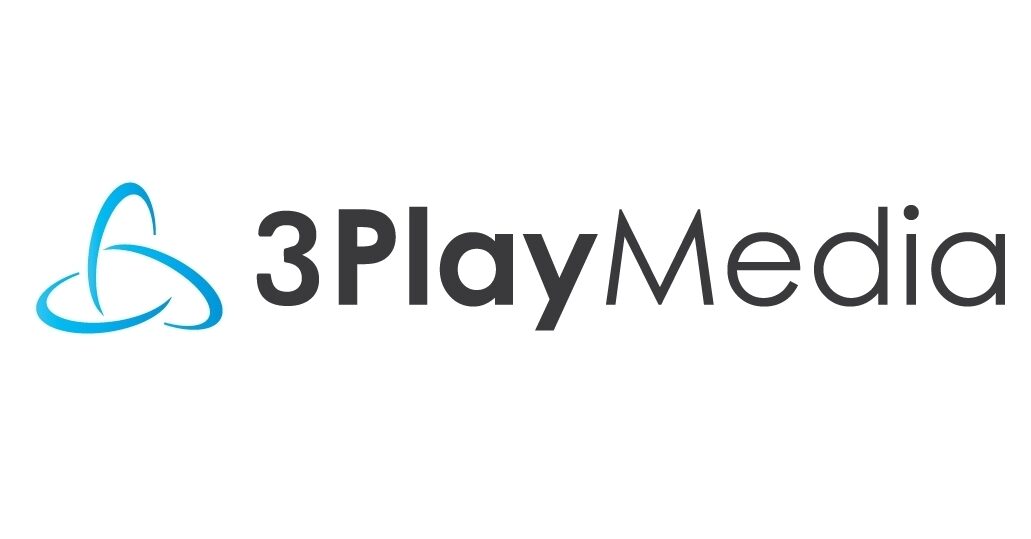
Overview
3Play Media specializes in transcription and captioning services designed to meet accessibility and compliance requirements. It stands out for its commitment to accuracy and its suite of accessibility features, making it a preferred choice for educational institutions.
Features
- High accuracy through a combination of automatic and human transcription.
- Integration with major LMS platforms, including Blackboard and Canvas.
- Advanced captioning options, including interactive transcripts.
- Compliance with ADA and Section 508 accessibility standards.
- Options for audio description and transcript alignment.
Pricing
3Play Media offers competitive pricing, with costs varying depending on the specific services and features you require.
| Pros | Cons |
|---|---|
| Strong commitment to accessibility compliance. | Pricing may be higher for specialized features and services. |
| Robust integration options with popular LMS platforms. | |
| Advanced features like interactive transcripts and audio description. | |
| Focus on quality and accuracy. |
These top transcription and captioning services cater to various needs and budgets, ensuring that educators can select the one that aligns best with their specific requirements for online education accessibility. Whether you prioritize accuracy, affordability, or compliance, there’s a solution here to enhance your online teaching experience. Stay tuned as we explore more options to help you make an informed choice.
How to Use Transcription and Captioning Services Effectively in Online Teaching
Incorporating transcription and captioning services into your online teaching can significantly enhance the learning experience for your students. To help you make the most of these services, we’ve put together a comprehensive guide that includes step-by-step instructions, valuable tips, and solutions for addressing common challenges.
Step-by-step Guide to Integrating Transcriptions and Captions
- Assess Your Course Content: Begin by assessing your course content to identify which materials would benefit most from transcriptions and captions. Consider prioritizing videos, lectures, and multimedia content.
- Choose a Service: Select a transcription and captioning service that aligns with your specific needs. Evaluate factors such as accuracy, turnaround time, and compatibility with your online learning platform.
- Upload Content: Utilize your chosen service’s platform to upload the content you want transcribed and captioned. Ensure that the files are of high quality for the best results.
- Review and Edit: Once the transcriptions and captions are generated, take the time to review and edit them for accuracy. Correct any errors and ensure that the captions are clear, concise, and contextually relevant.
- Integrate with Your Learning Management System (LMS): If your service allows it, seamlessly integrate the transcriptions and captions into your LMS or online platform. This makes it easy for students to access the content.
- Promote Awareness: Inform your students about the availability of transcriptions and captions and explain how to access them. Encourage all students to make use of these resources, particularly those with accessibility needs.
How to transcribe with Amberscript

Tips for Maximizing the Benefits
- Consistency is Key: Maintain consistency in providing transcriptions and captions for all relevant content to create an inclusive learning environment.
- Interactive Transcripts: If your chosen service offers interactive transcripts, encourage students to use them. These transcripts allow students to search for specific content within videos, enhancing their learning experience.
- Engage Student Feedback: Seek feedback from your students about the quality and utility of transcriptions and captions. This input can help you improve your approach and identify areas for enhancement.
Addressing Common Challenges
- Budget Constraints: If you’re on a tight budget, explore cost-effective options and consider prioritizing captioning for essential content.
- Time Constraints: If time is a concern, plan your course content delivery well in advance to allow for transcription and captioning services to meet your deadlines.
- Content Compatibility: Ensure that the transcription and captioning service you choose is compatible with your chosen learning management system or online platform.
- Legal Compliance: Regularly review your course materials to ensure they remain compliant with accessibility laws such as ADA and Section 508. Make necessary updates as needed.
By following this step-by-step guide, implementing valuable tips, and proactively addressing common challenges, you can effectively integrate transcription and captioning services into your online teaching, ultimately fostering a more inclusive and accessible learning environment for all your students.
Legal Considerations
Ensuring compliance with accessibility laws is a fundamental responsibility for educators in the realm of online teaching. In this section, we provide an overview of the key legal requirements, such as Section 508 and the Americans with Disabilities Act (ADA), and offer guidance on how to ensure your online courses meet these standards.
Overview of Legal Requirements
- Section 508: Section 508 of the Rehabilitation Act of 1973, as amended in 1998, mandates that federal agencies and organizations that receive federal funding make their electronic and information technology (EIT) accessible to people with disabilities. While it primarily applies to federal entities, it has influenced accessibility standards adopted more widely.
- Americans with Disabilities Act (ADA): The ADA is a comprehensive federal law that prohibits discrimination against individuals with disabilities. Title II of the ADA applies to state and local government entities, including educational institutions, while Title III applies to public accommodations and commercial entities, which can encompass online educational platforms.
How can you ensure compliance with accessibility laws?
- Familiarize Yourself: Take the time to familiarize yourself with the specific requirements of Section 508 and the ADA as they pertain to online education. Consult with your institution’s legal counsel or accessibility experts if needed.
- Prioritize Accessibility: Make accessibility a core component of your course design and content creation process. Ensure that all course materials, including videos, audio recordings, and documents, are accessible to individuals with disabilities.
- Provide Transcriptions and Captions: As discussed in previous sections, transcription and captioning services play a crucial role in accessibility. Regularly provide accurate transcriptions and captions for multimedia content to accommodate students with hearing impairments or language barriers.
- Test for Accessibility: Utilize accessibility testing tools and conduct regular audits of your course materials to identify and address any accessibility issues. This includes checking the compatibility of your content with screen readers and other assistive technologies.
- Stay Informed: Keep abreast of updates and changes in accessibility laws and standards. Accessibility requirements may evolve, so it’s essential to stay informed and adapt your practices accordingly.
- Provide Accommodations: Be prepared to provide reasonable accommodations to students with disabilities, as required by law. This may involve offering alternative formats for materials or additional support.
- Document Accessibility Efforts: Maintain records of your efforts to ensure accessibility, including the use of transcription and captioning services, accessibility testing, and accommodation provision. These records can be essential in demonstrating compliance.
Ensuring compliance with accessibility laws not only protects you from legal liabilities but also upholds the principles of fairness and inclusivity in online education. By following these guidelines and prioritizing accessibility in your teaching practices, you contribute to a more equitable learning environment for all your students.

Get a customized offer
Request a quote for your transcription needs
Real-World Success Stories
In this section, we present real-world case studies of educators who have harnessed the power of transcription and captioning services to enhance their online teaching. These stories shed light on the positive impacts these services can have on student engagement and learning outcomes.
Case Studies of Educators Who Have Benefited from Transcription and Captioning Services
Case Study 1: Professor Sarah’s Inclusive Biology Lectures
Professor Sarah, a biology instructor at a large university, recognized the diverse learning needs of her students. She decided to incorporate transcription and captioning services into her online lectures. By providing accurate transcriptions and captions, she made her content more accessible to all students, including those with hearing impairments and English language learners. The result? Increased engagement and participation in her courses, as students reported improved comprehension and better retention of complex biological concepts.
Case Study 2: Dr. Patel’s Inclusive Mathematics Tutorials
Dr. Patel, a mathematics professor, faced the challenge of ensuring that her online tutorials were accessible to all students. She began using transcription and captioning services to provide clear, written explanations alongside her video tutorials. This approach not only benefited students with diverse learning styles but also helped those who needed extra support in understanding mathematical formulas and concepts. Dr. Patel saw a significant improvement in students’ exam scores and a decrease in the need for additional tutoring.
What are the Positive Impacts on Student Engagement and Learning Outcomes?
- Enhanced Comprehension: Transcriptions and captions empower students to read along with the spoken content, aiding comprehension. Students who may struggle with auditory learning or non-native English speakers can follow lectures more effectively.
- Improved Retention: Research has shown that the combination of auditory and visual learning, which captions provide, can improve information retention. Students are more likely to remember key concepts and details from lectures.
- Increased Engagement: Accessible content fosters greater engagement. Interactive transcripts, which allow students to search for specific content within videos, encourage active learning and exploration of course materials.
- Inclusivity: Providing transcriptions and captions ensures that all students, regardless of their learning style or disabilities, have equal access to course content. This promotes a more inclusive and equitable learning environment.
These real-world success stories and the positive impacts on student engagement and learning outcomes demonstrate the tangible benefits of incorporating transcription and captioning services into online education. By prioritizing accessibility, educators can unlock the full potential of their students and create a more inclusive learning experience.
Transcription and captioning services go beyond mere compliance with accessibility laws; they enhance comprehension, retention, and engagement among your students. As seen in the real-world success stories of educators who have benefited from these services, the impact on student engagement and learning outcomes is profound.
As online educators, consider how transcription and captioning services can enrich your students’ learning experiences. Together, we can transform online education into a space where every voice is heard, and every learner is empowered to succeed.
Transcription of University Courses
Table of Contents
1- What is a Course Transcript?
2- Legal Considerations
3- DIY vs. Outsourcing
4- Choosing a Transcription Service
5- Accuracy and Quality Control
6- Accessibility and SEO Benefits
7- Time Stamping and Interactive Functions
8- Final Thoughts: Enhancing One’s Education Through Transcription
What is a Course Transcript?
In academia, a course transcript is not only a record of grades, but can also be a textual version of lectures and discussions. These documents serve as an additional teaching tool, offering a myriad of benefits for both students and educators.
For students, having a transcript can help them better understand and retain course material. It offers the flexibility to review complex theories at one’s own pace, enhancing the overall learning experience. For educators, transcripts can be a vital resource for course development and an accessibility tool for students with hearing impairments.

Per saperne di più sull’accessibilità digitale
Learn MoreIn this guide, we cover the entire process of creating course transcripts, from legal considerations to technological solutions and distribution. Whether you are a do-it-yourselfer wanting to create your own transcripts or an institution wanting to outsource this task, our guide aims to provide practical insights for everyone involved in the education ecosystem.
Legal Considerations
When venturing into the realm of course transcription, it is crucial to have a complete understanding of the legal landscape, particularly with regard to copyright laws and the doctrine of educational fair use.
- Copyright laws
Copyright laws protect original works, which include lectures, speeches and any associated materials such as slides or handouts. This protection exists from the moment the work is created in a fixed, tangible form. Unauthorised reproduction, such as transcription, may result in legal sanctions. However, given your experience, you are probably aware that these laws may vary from jurisdiction to jurisdiction, requiring you to consult local or international statutes.
- Proper use in education
Educational institutions often have a little more leeway when it comes to using copyrighted materials for academic purposes, based on the concept of ‘Fair Use’ in the United States or ‘Fair Dealing’ in other jurisdictions such as the United Kingdom and Canada. However, these are nuanced legal concepts that take into account several factors, including the purpose of the use (educational, commercial), the nature of the copyrighted work, the amount used and the effect on the market value of the work.
- Obtaining permissions
In situations where fair use is not clearly applicable, it is essential to obtain written permission from the copyright holder (often the teacher or educational institution). This ensures that you are legally protected and can freely distribute or modify the transcript according to your needs.
- Licences and Open Educational Resources (OER)
If you are part of an institution that generates a significant amount of educational content, you might consider using licences such as Creative Commons to facilitate the legal sharing and reproduction of transcripts.
- Risks of non-compliance
It is worth noting that non-compliance with these legal considerations can result in significant penalties, ranging from monetary fines to, in extreme cases, criminal charges. Institutions may also suffer reputational damage that could have a far-reaching impact on student enrolments and collaborations.
The legal terrain of course transcription is intricate but navigable. It is the crucial first step to generating course transcripts that are not only educational but also legal.
DYI vs. Outsourcing
In the field of course transcription, you are faced with an essential decision point: Roll up your sleeves and transcribe in-house or outsource the task to a specialised service? Each approach has its merits and flaws, and understanding them can help you make an informed decision.
DYI: Do It Yourself
Pros:
Cost-effective: In-house transcription can be cost-effective, especially for smaller projects or institutions with limited resources.
Quality control: In-house transcription gives you complete control over the quality of the transcription, down to every single word and punctuation mark.
Intellectual property: In-house transcription ensures that all rights to the content remain within the institution, minimising the legal complications associated with outsourcing.
Cons:
Time-consuming: Transcription is a labour-intensive process that may take resources away from other academic or administrative activities.
Skill requirements: Correct transcription requires language and subject skills that may require training.
Technological constraints: Without specialised software and hardware, the transcription process can be more cumbersome and less accurate.
Outsourcing
Pros:
Efficiency: Specialised transcription services usually offer fast turnaround times.
Expertise: These services often have experienced transcriptionists and quality assurance processes that ensure a high level of accuracy.
Scalability: Outsourcing is more adaptable to varying volumes of transcription needs, ideal for larger institutions or fluctuating workloads.
Cons:
Efficiency: Specialised transcription services usually offer fast turnaround times.
Expertise: These services often have experienced transcriptionists and quality assurance processes that ensure a high level of accuracy.
Scalability: Outsourcing is more adaptable to varying volumes of transcription needs, ideal for larger institutions or fluctuating workloads.
Hybrid Approach: Speculative Proposal
You might also consider a hybrid model. Use internal resources for specialised or sensitive material and outsource general or mass content to take advantage of both worlds. This approach will allow you to balance cost, quality and efficiency according to the specific needs and resources of your institution.
In summary, the choice between DIY and outsourcing must be a calculated one, taking into account factors such as cost, time, quality and legal considerations.
Choosing a Transcription Service
If you have decided that outsourcing is the way forward for you, the next critical task is to select a professional transcription service that is in line with your needs. Since you are already experienced in evaluating services, you will appreciate that the selection criteria go beyond cost and speed.
Accuracy
The first and most important criterion is the accuracy of the transcripts. Academic material often involves complex language and specific terminology. Make sure that the service you choose has a proven track record of high accuracy in transcriptions, particularly in the educational field.
Delivery Time
In an academic environment, time is often of the essence. Evaluate average delivery times and make sure they are within your institutional timeframe.
Data Security and Compliance
You are no stranger to the complexities of data protection. Ensure that your transcription service complies with applicable data protection regulations and offers robust security measures to safeguard sensitive information.
Specialised Services
You are looking for a service that can handle specific requirements, such as transcription of scientific notations or foreign languages. The flexibility to adapt to your specific needs can be a significant advantage.
Costs
Although quality should not be sacrificed, cost is always a consideration. Evaluate pricing models and check for educational discounts or bulk pricing.
User experience
Consider the usability of the service platform. Easy-to-use software with features such as batch uploading, real-time editing and simple sharing options can simplify the process.
Amberscript: A suitable option
For instance, Amberscript offers a number of functions that make it particularly useful for university transcripts:
High accuracy: Amberscript uses advanced speech-to-text technology that can reach 95% accuracy, making it reliable for academic content.
Fast turnaround time: Its fast processing capabilities are beneficial for time-sensitive academic programmes.
Data security: Amberscript is GDPR compliant and ensures secure data processing.
Specialised services: They offer transcription services in multiple languages, which can be an advantage for universities with a diverse student population or curriculum.
By meticulously evaluating your chosen service against these criteria, you can ensure that outsourced transcripts meet or exceed the educational standards you would expect from an in-house project.
Why Use Amberscript
Average time saving of 5 times through the use of AI
Allowing an accurate flow of audio-data, adjustable in our easy-to-use online text editor
GDPR-compliant security and protection
Accuracy and Quality Control
Quality Controls and Amberscript
For those who choose outsourcing, a service like Amberscript is invaluable. Thanks to its advanced technology, Amberscript achieves up to 95 per cent accuracy, effectively meeting stringent quality control criteria.
Dual Control
Even with high-accuracy services, it is advisable to perform a quick double-check to ensure that transcripts meet your specific requirements and standards. This may involve cross-referencing the transcript with the original audio or requesting a second opinion from a subject matter expert.
By prioritising accuracy and quality control, you can ensure that your transcripts are not only useful, but also reliable and beyond reproach.
Accessibility and SEO Benefits
Transcripts make academic content more accessible, especially for hearing-impaired students. This inclusiveness ensures equal educational opportunities for all.
SEO benefits
In addition, transcripts can be indexed by search engines, improving the visibility of your teaching material and attracting a wider audience.
By incorporating transcripts, you gain benefits beyond simple text conversion, making your content inclusive and easier to discover.
Time Marking and Interactive Functions
Time stamps make it easy to navigate to specific parts of a lesson, enhancing the user experience and facilitating quick reference.
Interactive features
Clickable summaries or chapter divisions can guide the reader through the transcript, allowing for easier absorption of material and a more organised revision process.
Both features serve to make the transcript more than just a static text document, transforming it into a dynamic teaching tool.
Final reflections: Elevating One’s Education Through Transcriptions
Transcripts are not just a convenience: they are a fundamental tool for the quality and accessibility of higher education. From legal considerations to quality control and advanced functionality, every aspect matters. Act now to integrate accurate and interactive transcripts, ensuring that educational content is exemplary and accessible to all.
Transcription for e-learning: How to make online courses more engaging
Table of Contents
- The rise of online education
- Importance of engagement in e-Learning
- Role of transcription in enhancing engagement
- Types of transcription in e-Learning
- Benefits of Transcription in e-Learning
- How to Implement Transcription in Online Courses with Amberscript
- Final Thoughts about Practices for Creating Engaging Transcripts
The rise of online education
In the digital age, education has undergone a profound transformation, transcending the boundaries of traditional classrooms. The emergence of online education, often referred to as e-learning, has reshaped the way people acquire knowledge and skills. This paradigm shift has not only expanded access to education but has also opened up new avenues for both learners and educators.
The rise of online education can be attributed to a confluence of factors: technological advancements, changing learner preferences, and global connectivity. Today, a world of knowledge is just a click away, accessible from the comfort of one’s home, office, or even on the go. This accessibility has empowered individuals of all ages and backgrounds to embark on learning journeys tailored to their unique needs and schedules.
In this blog, we delve into the multifaceted landscape of online education, exploring its evolution, challenges, and the pivotal role of engagement in making e-learning effective. We’ll uncover how transcription services, often an unsung hero in the e-learning world, play a crucial role in enhancing engagement and enriching the online learning experience.

Learn more about digital accessibility
Find out moreImportance of engagement in e-learning
In the digital realm of online education, engagement is the linchpin that holds the entire learning experience together. It goes beyond mere participation; it’s about capturing and maintaining a student’s attention, fostering active involvement, and ultimately, ensuring effective learning outcomes.
Here’s why engagement is paramount:
- Enhanced Learning Retention: Engaged learners are more likely to retain information. Interactive and stimulating learning experiences can lead to better comprehension and knowledge retention.
- Motivation and Persistence: Engaged students are motivated to continue their learning journey. When they find a course interesting and interactive, they are more likely to complete it successfully.
- Improved Critical Thinking: Engaging activities and discussions can stimulate critical thinking and problem-solving skills, promoting a deeper understanding of the subject matter.
- Community Building: Engagement fosters a sense of belonging and collaboration among learners. This community aspect can enhance the overall learning experience.
- Adaptability: Engaged learners are more adaptable to different teaching styles and modes of instruction. They are better prepared to embrace the ever-evolving landscape of online education.
In essence, engagement serves as the bridge that connects students to the content and instructors, making the online learning experience not only informative but also enjoyable. Recognizing the importance of engagement, educators and course designers are continually exploring strategies and tools to create immersive and interactive learning environments. One such tool that plays a significant role in enhancing engagement is transcription.
Role of transcription in enhancing engagement
Transcription, the process of converting spoken or audio content into written text, plays a pivotal role in transforming online courses into engaging and inclusive learning experiences.
Here’s how transcription enhances engagement in e-learning:
- Accessibility: Transcripts provide an accessible alternative to audio content. They cater to diverse learning styles and accommodate individuals with hearing impairments, ensuring that no student is left behind.
- Searchability: Transcripts make content easily searchable. Students can quickly locate specific information, revisit key concepts, or review discussions, enhancing their overall comprehension.
- Content Comprehension: Transcripts reinforce understanding by providing a written version of spoken content. This aids learners who benefit from visual reinforcement or those for whom English is a second language.
- Note-Taking and Study Aids: Transcripts serve as valuable study aids, allowing students to take notes, highlight important points, and engage more deeply with the material.
- Multimodal Learning: Combining audio or video content with transcripts creates a multimodal learning experience that appeals to a broader range of learners, enhancing engagement and knowledge retention.
- Inclusive Learning: Transcriptions promote inclusivity by accommodating learners with different needs and preferences. They contribute to a more equitable and diverse educational environment.
In the evolving landscape of online education, transcription services are a powerful tool for educators and instructional designers. They not only facilitate access to content but also contribute significantly to creating dynamic, engaging, and effective online courses. In the upcoming sections, we’ll explore the various types of transcription used in e-learning and delve into the specific benefits they offer.
Find out more
Unlocking Accessible eLearning: A Comprehensive Guide for Higher Education Institutions
In higher education, accessibility involves creating an inclusive learning environment that accommodates and mitigates barriers for students with disabilities or different learning needs. Learn all about accessibility measures in higher education and how you can empower all people regardless of their learning needs.
Read the full guideTypes of Transcription in e-learning
In the realm of online education, different types of transcription services cater to varying needs and formats of content. These transcription types include:
Verbatim Transcription: Verbatim transcription captures every spoken word, including filler words (e.g., “um” and “uh”) and non-verbal cues (e.g., laughter or pauses). This type of transcription is valuable when precise language or context is crucial, such as in legal or medical education.
Clean Transcription: Clean transcription is a more polished version of verbatim transcription. It omits filler words and non-verbal cues, resulting in a cleaner, more readable transcript. Clean transcripts are often used in educational videos and lectures.
Intelligent Verbatim Transcription: Intelligent verbatim transcription retains essential content while excluding repetitive or unnecessary elements like filler words. This type is commonly used in e-learning to maintain the flow and clarity of the transcript.
Time-Stamped Transcription: Time-stamped transcription includes timestamps at regular intervals, allowing learners to navigate audio or video content more easily. This is particularly useful for tracking progress, referring to specific sections, or facilitating discussions.
Textual Description or Audio Description: Inclusion of textual descriptions or audio descriptions within transcripts is essential for making multimedia content, such as videos and animations, accessible to individuals with visual impairments. These descriptions provide information about visual elements and actions in the content.
Multilingual Transcription: Multilingual transcription involves translating spoken content into multiple languages within the transcript. This promotes language diversity and accessibility, making the course content more inclusive to a global audience.
Automated Transcription: Automated transcription relies on Machine-Made tools to transcribe audio or video content quickly. While it may not be as accurate as human transcription, it offers a cost-effective solution for institutions with extensive content libraries.

Learn more about Transcription Guidelines
Read the blogBenefits of Transcription in e-learning
Transcription services in the context of e-learning offer a multitude of advantages that contribute to a richer and more inclusive educational experience.
- Enhanced Accessibility: One of the primary benefits of transcription is improved accessibility. Transcripts make course content available to individuals with hearing impairments or those who prefer reading over listening. This ensures that education is truly inclusive and reaches a broader audience.
- Facilitated Learning Retention: Transcripts provide learners with written versions of spoken content, reinforcing understanding and retention. Students can review transcripts to clarify concepts, reinforce learning, and take comprehensive notes.
- Effective Searchability: Transcripts make it easy for learners to search for specific information within course materials. This is particularly valuable for students seeking to revisit specific topics or keywords, saving them time and frustration.
- Support for Multimodal Learning: Combining audio or video content with transcripts creates a multimodal learning experience. This caters to different learning styles, making the material more engaging and adaptable to individual preferences.
- Improved Multilingual Access: Transcripts can be translated into multiple languages, breaking down language barriers and expanding the reach of educational content to a global audience.
- Compliance with Accessibility Standards: Many educational institutions are required to meet accessibility standards. Providing transcripts ensures compliance with regulations and demonstrates a commitment to making education accessible to all.
- Enhanced Learning Experience: Transcripts can serve as valuable study aids, allowing students to read, annotate, and engage with content at their own pace. This contributes to a more engaging and effective learning experience.
- Content Repurposing: Transcripts provide a written record of course materials that can be repurposed for various purposes, such as creating study guides, blog posts, or additional educational resources.
In essence, transcription services are a versatile tool that not only improves accessibility but also enhances the overall quality of e-learning. They empower educators to create more engaging and inclusive courses while enabling students to learn in ways that best suit their needs and preferences.
How to Implement Transcription in Online Courses with Amberscript
Implementing transcription in online courses can significantly enhance the learning experience for your students. One versatile solution for transcription services, offering both machine-made and human-made transcriptions, is Amberscript.
Amberscript is a transcription and subtitling service that offers several advantages for educators and institutions looking to incorporate transcription into their e-learning materials.
Here’s the step-by-step on how you can effectively implement Amberscript in your online courses:
- Select your Appropriate Transcription Type: Amberscript provides both machine-made and human-made transcriptions. Machine-made transcriptions offer speed and cost-efficiency, making them suitable for straightforward content. On the other hand, human-made transcriptions ensure the highest level of accuracy and are ideal for complex or specialized topics.
- Upload your Content: Begin by uploading your audio or video content to the Amberscript platform. The user-friendly interface makes it easy to initiate the transcription process quickly.
- Choose the Language: Specify the language of your content. Amberscript supports a wide range of languages, catering to a diverse global audience.
- Opt for AI-Enhanced Editing: Amberscript’s AI-powered editor helps improve the accuracy of machine-made transcriptions. This ensures that even complex terminology or technical jargon is transcribed correctly.
- Review and Edit: If you opt for machine-made transcriptions, review the generated text to ensure it meets your standards. You can edit the transcript within the platform, making any necessary corrections.
- Subtitle Creation: Beyond transcription, Amberscript can also assist in creating subtitles for your videos, further enhancing the accessibility and engagement of your course materials.
- Integrate Transcripts: Once you have your transcripts, seamlessly integrate them into your online course materials. Provide students with access to both audio/video content and the corresponding transcripts for an enriched learning experience.
Amberscript’s comprehensive transcription services offer flexibility, accuracy, and the convenience of a user-friendly platform. Whether you’re looking to transcribe lectures, webinars, or multimedia content, Amberscript can be a valuable tool in your e-learning toolkit.
By implementing transcription services like Amberscript, you ensure that your online courses are not only engaging but also accessible to a wide range of learners, including those with diverse needs and preferences.
Why you should use Amberscript
5x average time saving by using AI.
Enabling an accurate flow of audio-to-data, adjustable in our easy to use online text editor.
GDPR compliant security and safety.
Final Thoughts about Practices for Creating Engaging Transcripts
In conclusion, crafting engaging transcripts in e-learning involves maintaining clarity, accuracy, and conciseness. Clear and error-free transcripts ensure comprehension, while concise content keeps learners focused. Timestamps aid navigation, proper formatting enhances readability, and visuals or multimedia elements enrich the learning experience.
Ensuring accessibility, regular updates, and adhering to these best practices will optimize the impact of transcripts in enhancing online courses, fostering a more inclusive and engaging educational journey for all learners.
How to Choose a TV Channel Broadcast Subtitling Service
Subtitling services are an essential aspect of broadcasting for any broadcaster looking to reach their full potential. From ensuring accuracy and quality assurance to meeting accessibility standards, having the right subtitling service provider can make all the difference in your broadcast’s success. Join us on a journey where we uncover the transformative potential of partnering with the right subtitling service provider.
Table of Contents
- Understanding the Basics of TV Channel Broadcast Subtitling
- Factors to Consider When Choosing Subtitling Services
- Amberscript: A Leading Provider of Subtitling and Transcription Services
- Best Practices for Working with Subtitling Service Providers
- Final Thoughts
Understanding the Basics of TV Channel Broadcast Subtitling
Subtitling is a cornerstone of modern television broadcasting, serving not only as a tool for accessibility but also as a means to enhance the viewer experience. In this chapter, we delve into the fundamental role of subtitling in TV channels, exploring how it makes content accessible to a broader audience and the various types of subtitling services available. Whether you’re new to broadcasting or a seasoned professional, understanding these basics is essential for delivering engaging and inclusive content.
The Role of Subtitling in TV Channels
Subtitles are a cornerstone of television broadcasting, serving various essential functions. They bridge the gap for viewers by providing a textual representation of spoken content, facilitating comprehension for those with hearing impairments. Moreover, they are invaluable for individuals who do not speak the language of the broadcasted content and offer a visual aid, enhancing the overall viewing experience.
The Different Types of Subtitling Services
- Open Captions: Open captions are constantly visible on the screen, remaining in view throughout the program. This type ensures that all viewers, including those who cannot activate captions, have access to the text.
- Closed Captions: Closed captions, on the other hand, are hidden by default and can be activated or deactivated by viewers as needed. This option provides flexibility to the audience.
- Subtitles: Subtitles are text-based translations or transcriptions displayed on a screen during audiovisual content, providing viewers with a written representation of dialogue and audio elements, typically used for language translation, accessibility, or viewer comprehension.
Each type of subtitling service has its unique advantages and considerations, making it crucial for broadcasters to select the most suitable option for their audience and content.

Dubbing vs Subtitling: Which one is Best for Movies and TV Shows?
Read the blogFactors to Consider When Choosing Subtitling Services
Selecting the right subtitling service provider is a critical decision for any television broadcaster. To make an informed choice, there are several key factors that need to be considered. In this chapter, we explore these factors in depth, from the importance of accuracy and language capabilities to turnaround times, cost-effectiveness, and compatibility with your broadcast systems. Discover how these considerations can shape your subtitling strategy and ultimately impact the viewer experience.

Accuracy and Quality
Accuracy is paramount in subtitling. It ensures that viewers receive precise information and contributes to the channel’s professionalism. To ensure accuracy, broadcasters should seek subtitling services with robust quality control processes. This typically includes meticulous proofreading, editing, and automated checks to guarantee synchronization with the spoken words on the screen.
Language Capabilities
The scope of languages supported by a subtitling service provider is a crucial consideration. Some television channels require multilingual subtitles to cater to diverse audiences, while others need localized versions for specific regions or countries. It is equally important to verify the provider’s expertise in the relevant languages to ensure high-quality translation and localization.
Turnaround Time
Efficient time management is essential in television broadcasting. To keep programming up-to-date and relevant, broadcasters should prioritize subtitling services that offer quick turnaround times. Timely delivery is essential to maintaining a dynamic and engaging channel.
Cost-effectiveness
Cost-effectiveness is a fundamental concern for broadcasters. Quality subtitling need not be exorbitantly priced. To optimize budget allocation, it is advisable to obtain quotes from multiple subtitling service providers. This practice allows broadcasters to compare offerings and secure the best value for their investment.
Compatibility with Broadcast Systems
Seamless integration with existing broadcast systems is imperative. Before selecting a subtitling service, broadcasters should ensure that the chosen provider’s technology aligns with their technical requirements. Compatibility issues can disrupt the broadcasting process, making this a critical consideration.

Transcribing for Broadcast: Tips From the Pros
Learn moreThe Role of Technology in Subtitling
- Automatic Speech Recognition (ASR): ASR technology plays a pivotal role in modern subtitling services. By employing artificial intelligence, ASR systems transcribe audio into text swiftly and accurately. This automation not only expedites the subtitling process but also enhances accuracy. ASR can also be employed during post-production to cross-verify the accuracy of subtitles, ensuring that any discrepancies are promptly identified and rectified.
- Machine Translation (MT): Machine translation is another AI-driven technology used in subtitling. MT algorithms translate text from one language to another, significantly reducing the time required for multilingual subtitles. However, it is essential to exercise caution with MT, as it can occasionally produce inaccurate translations. Human oversight is recommended to ensure translation quality.
- Human-Aided Technology: Human-aided technology represents a hybrid approach, combining automated and manual processes. This approach involves both human transcribers and machine translators collaborating to produce accurate subtitles. The human touch enhances the overall quality and control over the final result, making it a reliable option.

How to Caption Sound Effects for TV and Movies: A Comprehensive Guide
Read the blogAmberscript: A Leading Provider of Subtitling and Transcription Services
Amberscript stands out as a prominent provider of subtitling and transcription services for television broadcasters worldwide. Their seasoned team of professionals delivers both automated and human-made subtitles, multilingual capabilities, and customization options to ensure top-notch results.
Benefits
We always aim to deliver your files quickly. Rush your order and get your file as fast as 24h.
Native speakers and quality checks ensure that you get 100% accurate translations.
Your files are confidentially stored in a secure environment.
Automatic and Human-made Subtitling
Amberscript offers a comprehensive range of subtitling solutions, including both automated and manual subtitling services. This dual approach ensures accuracy and quality, with all subtitles undergoing meticulous accuracy checks before being delivered to the client.
Multilingual Subtitling
Amberscript’s expertise extends to multilingual subtitling, allowing broadcasters to swiftly and accurately translate their content into multiple languages. This capability is particularly beneficial for multinational broadcasters looking to reach diverse audiences in different countries or regions.
Customization Options
Amberscript provides customization options that empower broadcasters to tailor the appearance of their subtitles to suit their unique needs. Custom fonts, colors, background images, transitions, and other elements enhance the visual appeal of subtitles, aligning them with the channel’s brand identity.
How to Get Started with Amberscript

Best Practices for Working with Subtitling Service Providers
Collaborating effectively with subtitling service providers is essential to ensure that your content meets the highest standards of accuracy and accessibility. In this chapter, we delve into the best practices for working with subtitling service providers. From clear communication and quality assurance to compliance with accessibility standards, you’ll learn how to establish a productive partnership that results in top-notch subtitling for your broadcasts.
Clear Communication
Effective communication between broadcasters and subtitling service providers is crucial. Clear and comprehensive instructions, including deadlines, target audience specifications, and other requirements, must be communicated upfront to ensure the desired results are achieved.
Quality Assurance and Review
Before subtitles are published, thorough review and quality assurance processes should be in place. This includes broadcaster-led reviews to ensure accuracy and quality. Additionally, subtitling service providers should have mechanisms to promptly address any feedback or issues, facilitating necessary adjustments before finalizing subtitles.
Compliance with Accessibility Standards
Subtitling service providers should be well-versed in accessibility standards and regulations. This includes optimizing subtitles for both sighted and non-sighted viewers and providing closed captioning options for those who cannot hear the audio track. By collaborating with a subtitling service provider experienced in meeting these standards, broadcasters can ensure a seamless subtitling process that aligns with accessibility guidelines.

Get a customized offer
Request a quote for your needs
Final Thoughts
The process of selecting the right subtitling service provider is pivotal to a broadcaster’s success. Amberscript offers a comprehensive suite of tools and services, ensuring accuracy, quality, and compliance with accessibility standards. With their unwavering dedication to customer service and quality subtitling, broadcasters can trust that their subtitling needs will consistently be met. Don’t hesitate; embark on your subtitling journey with Amberscript today and discover the transformative impact that quality subtitles can have on your content and audience engagement.
The future of subtitles and accessibility
For individuals with hearing impairments, accessibility is not a luxury; it’s a necessity. Every day, they encounter numerous challenges when trying to access audio and visual content, whether it’s in the form of videos, webinars, podcasts, or even live events. Without the proper tools, these individuals face exclusion from a vast array of information, entertainment, and educational opportunities.
In this blog, we embark on a journey to shed light on the transformative power of subtitles. We aim to explore how advancements in AI-driven and human-made subtitling services are shaping the future of accessibility. We believe that technology, coupled with human expertise, has the potential to break down barriers and ensure that no one is left behind in this digital age.
Agenda
- What are subtitles and how do they shape accessibility?
- The evolution of subtitles
- Ambercript’s leading role in the AI revolution
- Accessibility for deaf individuals
- Exploring emerging trends and technologies
What are subtitles and how do they shape accessibility?
Before we dive into the fascinating world of subtitles, let’s establish a common understanding. Subtitles are more than just words displayed at the bottom of a screen; they are a lifeline for individuals with hearing impairments. They provide a textual representation of spoken dialogue, sound effects, and other auditory cues, making content accessible to a broader audience.
In essence, subtitles have the power to bridge the gap between the hearing world and the deaf and hard-of-hearing communities. They enable individuals with hearing impairments to enjoy movies, TV shows, educational videos, and online content with the same enthusiasm and understanding as everyone else.
The evolution of subtitles
Subtitles have come a long way since their inception, evolving from a humble translation tool to a pivotal feature in ensuring accessibility for individuals with hearing impairments. To truly appreciate the significance of subtitles in today’s digital landscape, it’s essential to trace their historical journey.
From origins to modern-day significance
Subtitles can trace their origins back to the early days of cinema when they were primarily used as a means of translating dialogue in silent films for international audiences. However, their role was relatively straightforward at the time, mainly serving as a bridge between languages.
As technology advanced and sound was introduced to films, subtitles underwent a transformation. They began to serve not only as a tool for language translation but also as a means of providing additional context and information, enhancing the overall viewing experience. You can read more on the history of subtitles in this article here, were we have dived in into the past, present and future in detail.
The evolution into a vital accessibility feature
It was in the latter part of the 20th century that subtitles started to emerge as a vital accessibility feature. The realization dawned that subtitles could serve a much broader purpose – to make audio and visual content accessible to individuals with hearing impairments.
With this new mission in mind, subtitles began to incorporate not just dialogue translations but also descriptions of sound effects, background music, and even emotional nuances in the dialogue (also referred to as audio description). This richer, more comprehensive approach to subtitling significantly enhanced accessibility for the deaf and hard-of-hearing communities.
Today, subtitles have become an indispensable part of the media landscape. They enable individuals with hearing impairments to enjoy a wide range of content, from movies and TV shows to online videos and educational materials, ensuring that nobody is left behind in the digital age.
The impact of technology
Advancements in AI and machine learning have ushered in a new era for subtitling services, transforming the landscape in ways that were once unimaginable. In this section, we’ll explore how these technological leaps are revolutionizing subtitling and how AI-driven services like Ambercript are at the forefront of this transformative wave.
Revolutionizing subtitling services with AI
Artificial Intelligence and machine learning have significantly enhanced the efficiency and effectiveness of subtitling services. Here’s how:
- Speed: AI-powered algorithms can process audio and video content at incredible speeds. What used to take hours or even days for human transcriptionists can now be accomplished in a fraction of the time. This means that content can be made accessible to the deaf and hard-of-hearing communities much faster than ever before.
- Accuracy: AI-driven transcription and subtitling services are remarkably accurate. They can decipher speech patterns, dialects, and even background noise, resulting in subtitles that are not only timely but also highly precise. This level of accuracy is crucial for ensuring that individuals with hearing impairments receive an equivalent experience to their hearing counterparts.
- Cost-effectiveness: Traditional human transcription services can be costly. AI-driven solutions, on the other hand, offer a cost-effective alternative without compromising on quality. This affordability ensures that more content creators and organizations can make their materials accessible to a wider audience.
Ambercript’s leading role in the AI revolution
Ambercript is at the forefront of this AI-driven revolution in subtitling services. Our commitment to innovation and accessibility is evident in our cutting-edge technology.
Here’s how we stand out:
- Speed and efficiency: With our AI-driven platform, we can transcribe and subtitle content rapidly, making it accessible almost in real-time. This speed is a game-changer for live events, webinars, and breaking news broadcasts.
- Unparalleled accuracy: Our AI models are trained to achieve the highest levels of accuracy, ensuring that our subtitles faithfully represent the content being spoken. We continuously refine our algorithms to provide the best results possible.
- Cost-effective solutions: We understand the value of affordability in promoting accessibility. Our services are designed to be cost-effective, enabling a broader range of content creators and organizations to prioritize inclusivity.
While Ambercript leads the charge in AI-driven subtitling services, we recognize that competition is fierce in this rapidly growing field. Two notable competitors making strides in this space include the American company Rev and otter.ai, both of whom are also leveraging AI and machine learning to enhance subtitling services. Here is a alist of other speech-to-text tools that might interest you.
In the next sections, we’ll delve deeper into the unique features and benefits of Ambercript’s services, showcasing how we are not only keeping pace with technological advancements but also setting new standards in accessibility and inclusivity.
Human-made services for quality
While the advent of AI-driven subtitling services has been a game-changer, it’s essential to recognize the irreplaceable role of human transcriptionists in maintaining the highest standards of quality and accuracy. In this section, we’ll emphasize the importance of human expertise and explain how Ambercript seamlessly combines the strengths of both AI and human transcriptionists to provide a superior subtitling experience.
The human touch in subtitling
There’s a unique art to subtitling that goes beyond mere translation and technical proficiency. It involves understanding the nuances of language, culture, and context, all of which can be challenging for even the most advanced AI algorithms. This is where human transcriptionists shine.
- Contextual understanding: Human transcriptionists can discern the meaning behind words, idiomatic expressions, and cultural references, ensuring that subtitles accurately capture the essence of the content. This contextual understanding is crucial for delivering a satisfying viewing experience.
- Adaptability: Subtitling often involves adapting spoken language to written form while preserving its original meaning and intent. Human transcriptionists excel at this task, making sure that subtitled content flows naturally and cohesively.
- Quality assurance: Humans can review and refine subtitles to eliminate errors, inaccuracies, and awkward phrasing. Their keen eye for detail ensures that the final product is of the highest quality.
Ambercript’s unique approach
At Ambercript, we understand the intrinsic value of human expertise in subtitling. That’s why we’ve adopted a hybrid approach that combines the power of AI with the finesse of human transcriptionists, offering the best of both worlds.
- AI-Powered speed and efficiency: Our AI algorithms handle the initial transcription swiftly and accurately, allowing us to provide rapid turnaround times, even for large volumes of content. This speed is particularly valuable for live events and time-sensitive materials.
- Human expertise for precision: Following AI transcription, our team of skilled human transcriptionists steps in to review, refine, and enhance the subtitles. They ensure that the subtitled content not only meets but exceeds industry standards for quality and accuracy.
- Customization: We offer clients the flexibility to customize their subtitles to align with their unique needs and preferences. Whether it’s adapting the style, font, or timing of subtitles, our human transcriptionists ensure a personalized touch.
By blending technology with the artistry of human transcriptionists, we uphold our commitment to delivering top-tier subtitling services. This approach ensures that our subtitles are not only accessible but also engaging and enjoyable, enhancing the overall viewer experience.
Benefits of using Amberscript
Amberscript’s subtitling services are:
Edit your text in minutes or leave the work to our experienced subtitlers.
Our experienced subtitlers and thorough quality controls ensure 100% accuracy of transcripts and subtitles.
Through a series of integrations and API interfaces, you can fully automate your workflows.
Your data is in safe hands. We are GDPR compliant + ISO27001 and ISO9001 certified.
Accessibility for deaf individuals
Challenges faced by the deaf community
The digital age has brought unprecedented access to information and entertainment, but for the deaf community, there are still significant barriers to overcome. One of the most formidable challenges is accessing content without proper subtitles. Without subtitles, deaf individuals are often left out of the conversation, unable to enjoy a wide range of audio and visual content.
Imagine the frustration of missing out on the latest blockbuster movie, a compelling TED talk, or an informative webinar simply because subtitles are unavailable or poorly executed. It’s a reality that many in the deaf and hard-of-hearing communities face daily.
The legal and ethical imperative
Recognizing the importance of equal access, legal and ethical standards have been put in place to ensure that content creators and organizations prioritize accessibility. Laws such as the Americans with Disabilities Act (ADA) in the United States and similar legislation in other countries mandate the provision of accessible content.
But beyond the legal obligations, there’s an ethical imperative to make content accessible to all. Accessibility is about inclusion and ensuring that everyone has an equal opportunity to participate in society, learn, and enjoy cultural and entertainment offerings. It’s about recognizing the inherent worth and dignity of every individual and affording them the same privileges as anyone else.
Ambercript’s commitment to accessibility
At Ambercript, our commitment to accessibility is not just a corporate slogan; it’s a guiding principle that shapes everything we do. We understand the unique needs of deaf individuals, and we’ve tailored our services to meet those needs effectively.
Multilingual options
We recognize that accessibility is not a one-size-fits-all solution. We offer support for multiple languages, making content accessible to a global audience. Language should never be a barrier to accessibility, and we’re committed to breaking down those linguistic barriers.
Making all audio accessible
Our mission is clear: “making all audio audio accessible.” We believe that everyone, regardless of their hearing abilities, should have equal access to the rich tapestry of audio and visual content that the digital world has to offer. Whether it’s educational material, entertainment, news, or personal content, we’re dedicated to ensuring that it’s accessible to all.
The future of subtitles
As we look ahead, it’s evident that the future of subtitles and accessibility is poised for even more exciting developments. Emerging trends and technologies in the field are shaping a more inclusive digital landscape.
Exploring emerging trends and technologies
- Multimodal subtitles: The integration of subtitles with other accessibility features like sign language interpretation and audio descriptions will provide a richer and more immersive experience for users.
- Real-time translation: Advancements in real-time translation technologies will enable seamless access to content in multiple languages, further breaking down linguistic barriers.
- AI-driven personalization: Subtitling services will become increasingly personalized, adapting to individual preferences, including font size, style, and color, to enhance user experience.
Are you ready to witness the future of subtitles and accessibility in action? Explore Ambercript’s services today and experience the difference for yourself. Our user-friendly platform and commitment to excellence ensure that you’ll receive top-tier subtitling services tailored to your needs.
Try Amberscript’s fast and easy way to create subtitles now – for FREE

Getting started with Amberscript is easy. Visit our website to learn more about our services, pricing, and customization options. You can also contact our friendly customer support team if you have any questions or need assistance with your specific requirements.
In this digital age, where content is abundant and diverse, accessibility should be a fundamental right for all individuals, including those with hearing impairments. We’ve journeyed through the history, challenges, and solutions surrounding subtitles and accessibility.
Ambercript’s mission is to make content more inclusive by ensuring that all audio becomes audio accessible. We’ve explored how AI and human expertise work hand in hand to provide efficient, accurate, and customizable subtitling services.
As we look to the future, it’s clear that technology will continue to pave the way for even greater inclusivity. Ambercript is committed to being at the forefront of these advancements, ensuring that accessibility remains a priority in the digital world.
In closing, let’s remember that accessibility is not just a feature; it’s a fundamental right. By embracing technology and services like Ambercript, we can create a future where everyone, regardless of their hearing abilities, can participate fully in our digital world. Together, we’re shaping a brighter future of subtitles and accessibility.
Transcribing for Broadcast: Tips From the Pros
Transcribing for broadcast is a craft that goes beyond the mere conversion of spoken words into text. It demands precision, speed, and an intimate understanding of the nuances of language, context, and even the specific industries being covered. In this blog post, we dive deep into the world of broadcast transcription, and we’re joined by the pros who’ve made it their life’s work to ensure that every word uttered on air is faithfully captured.
Table of Contents
- The Role of Transcriptions in Broadcast
- Tips from Industry Experts
- Tools and Technology for Transcribing
- Staying Updated in the Broadcasting Industry
The Role of Transcriptions in Broadcast
In the fast-paced world of broadcasting, where information flows seamlessly through the airwaves, the role of transcriptions is often underestimated. However, these textual representations of spoken content play a fundamental role in making broadcast content accessible, searchable, and compliant with legal requirements. In this chapter, we’ll explore the multifaceted importance of transcriptions in the broadcasting industry.
How transcriptions are used in broadcasting
Transcriptions have become an invaluable tool for broadcasters, providing a vital layer of accuracy and accessibility that is essential for successful broadcasting. Transcripts allow content to be easily accessed by viewers, allowing them to search for specific topics or words without having to watch the entire broadcast. Additionally, transcription provides broadcasters with an exact record of their program’s contents, making it easier to review, edit, and update content.
The impact of accurate transcriptions on content accessibility
Transcriptions provide an important level of accessibility for viewers with different needs and abilities. Accurate transcripts can be used to create captioning for the hearing impaired and language translation services for viewers who do not speak the original language of a broadcast. This allows content to be accessible to a much wider audience, significantly increasing reach and engagement.

Get a customized offer
Request a quote for your transcription needs
Legal and compliance requirements for transcriptions in broadcasting
In many areas, there are legal and compliance requirements that dictate how broadcasters must interpret their transcripts. For example, certain broadcasts may require more accurate or detailed transcriptions than others due to the nature of their content or due to local regulations. It is important for broadcasters to be aware of these requirements in order to ensure that their transcriptions are legally compliant.
Tips from Industry Experts
What better way to learn about the art of transcription for broadcast than from those who’ve honed their skills through years of experience? In this chapter, we’ll share the pro tips of experienced broadcast transcribers, including gaining insights into their best practices, common challenges, and strategies for handling even the trickiest of audio content.
Best Practices Recommend
- Accuracy as Priority: Experienced transcribers emphasize that accuracy is non-negotiable. Taking the time to meticulously transcribe content is crucial, as even minor errors can have significant consequences in broadcasting.
- Double-Checking Audio Recordings: To ensure precision, they recommend double-checking audio recordings. Sometimes, nuances are missed during the first pass, and a second listen can make all the difference.
- Familiarizing with Industry Terminology: Familiarity with industry-specific terminology is key. This knowledge aids in correctly interpreting and transcribing content, reducing the chances of errors.
- Staying Up-to-Date with Technology: Technology evolves rapidly, and staying current with transcription tools and software is essential. This ensures efficiency and accuracy in the transcription process.

10 Best Transcription Services in 2023
Read the BlogCommon Challenges Faced by Transcribers in the Broadcast Field
Working in the broadcasting industry presents its own set of challenges for transcribers. These challenges require adaptability and expertise to overcome effectively:
- Difficult Audio Recordings: Background noise, poor sound quality, or multiple speakers talking simultaneously can make audio recordings challenging to transcribe. Transcribers often need to discern and separate voices and sounds to ensure an accurate transcript.
- Time Sensitivity: Broadcasting operates on tight schedules. Transcribers must meet stringent deadlines without compromising accuracy. This balancing act can be one of the most challenging aspects of the job.
- Specialized Terminology: The broadcasting field has its unique terminology and jargon. Transcribers need to understand these terms to provide precise transcripts.
Benefits of using Amberscript
Amberscript’s services are:
Edit your own text within minutes or leave the work to our experienced transcribers.
Our experienced transcribers and thorough quality controls ensure 100% accuracy of your transcriptions and subtitles.
Thanks to a variety of integrations and API interfaces, you can fully automate your workflows.
Your data is in safe hands. We are GDPR compliant + ISO27001 & ISO9001 certified.
Strategies for Handling Difficult Audio and Specialized Terminology
Dealing with challenging audio and specialized terminology requires a combination of skills and strategies:
- Multiple Listenings: To tackle difficult audio, transcribers should listen to recordings several times. Each pass may reveal previously unnoticed details or words, contributing to a more accurate transcript.
- Research: For unfamiliar terminology or industry lingo, research is crucial. Transcribers should take the time to look up and understand these terms before transcribing them, ensuring accuracy.
- Context Matters: Context plays a vital role in transcription. Having a comprehensive knowledge of the broadcasting industry allows transcribers to make informed decisions about context, reducing the likelihood of errors.
- Quality Control: Implementing a robust quality control process is essential. Reviewing and proofreading transcripts help catch any remaining inaccuracies and maintain high-quality standards.
Transcription in the broadcasting industry demands a unique skill set, including accuracy, adaptability, and industry knowledge. Learning from seasoned professionals, understanding common challenges, and applying effective strategies can lead to precise and reliable transcripts that are indispensable in the fast-paced world of broadcasting.
Tools and Technology for Transcribing
Technology has revolutionized the transcription process, offering a plethora of tools and software solutions. In this chapter, we’ll take a closer look at the various transcription technologies available, exploring their pros and cons, and how they assist professionals in transcribing accurately and efficiently.
Overview of transcription software and tools
There are a variety of transcription software and tools available to aid in the transcription process. These range from automated services that provide basic transcriptions to more advanced programs that enable users to add detailed annotations and other features. The choice of software will depend on the type of content being transcribed, as well as the skill level of the transcriber.
Pros and cons of different transcription methods
Automated transcription services are often the quickest and cheapest option, but they can be unreliable at times due to their lack of accuracy. Professional transcribers on the other hand are more reliable, but tend to be slower and more expensive than automated options. Finally, there are tools such as audio players and voice recognition software that can be used to aid in the transcription process.
How technology can aid professionals in the transcription process
Technology can significantly enhance the transcription process for professional transcribers by enabling them to work more efficiently. Audio players and voice recognition software, for example, can allow transcribers to quickly locate difficult passages and pick up on nuanced details. Additionally, transcription software can enable transcribers to add annotations and other features which help to improve accuracy and consistency of transcripts. Technology is an invaluable tool for professional transcribers that can save time and result in better quality transcriptions overall.

The future of transcription: How AI and machine learning are changing the game
Learn moreStaying Updated in the Broadcasting Industry
Transcribers in the broadcast field play an indispensable role in bridging the gap between spoken content and its textual representation. Their dedication to accuracy, mastery of specialized terminology, and commitment to staying ahead of the curve with cutting-edge transcription technologies are what ensure that every word uttered on air is faithfully captured. As we conclude our journey through the tips and strategies of these industry experts, it’s clear that their expertise goes far beyond simply converting spoken words into text. It encompasses a profound understanding of the broadcast industry, a keen ear for nuances, and an unwavering commitment to delivering the highest quality transcripts.
Best transcription for media companies: How to get the most accurate transcriptions
In the world of media and broadcasting, accuracy is everything. Whether you’re creating subtitles for a documentary, transcribing interviews, or generating captions for a news segment, precision in transcription is paramount. In this blog post, we will explore the significance of accurate transcriptions for media companies and introduce you to Ambercript, your go-to partner for transcription services.
Agenda
- The meaning of transcriptions in the media and broadcasting industry
- Challenges in media transcription
- Creating accurate transcripts without a transcription company
- Ambercript’s transcription solutions
The meaning of transcriptions in the media and broadcasting industry
A transcript is a written or textual representation of spoken words and audio content from media and broadcasting materials, such as interviews, podcasts, videos, and broadcasts. In the media and broadcasting industry, accurate transcriptions play a pivotal role by providing a written record of spoken content. These transcripts serve as valuable resources for content creators, journalists, and broadcasters. They enable easy reference, content organization, and searchability, making it simpler to locate specific information within audio or video files. Transcripts also enhance accessibility by providing text versions of audio content, making it inclusive for individuals with hearing impairments. Moreover, transcripts are vital for optimizing content for search engines, thus improving discoverability and reaching a broader audience.
Learn more about audio transcription
Audio Transcription: How To Transcribe Audio to Text
From legal and medical to media and academia, transcription has become a vital tool for converting spoken language or audio into written form. It enhances accessibility for the hard of hearing, provides a written record of important conversations, and facilitates research analysis. In this guide, we’ll explore the many uses and benefits of transcription, giving you everything you need to know to get started.
Challenges in media transcription
Media transcription, however, presents unique challenges. Media content often involves multiple speakers, background noise, and technical jargon specific to the industry. Transcribing such content accurately can be a daunting task. Whether it’s a news broadcast, a panel discussion, or an interview, frequently introduces complexities that can confound automated transcription systems and even human transcribers. Here is a bit more detail on some of the key challenges:
Multiple Speakers
In media content, it’s common to have multiple speakers engaged in rapid exchanges. This dynamic interaction can lead to overlapping dialogues and conversations, making it challenging to discern who is saying what. Accurate speaker identification is critical.
Background Noise
Whether it’s the hum of equipment in a studio, street sounds in interviews conducted outdoors, or applause in a live show, background noise is often an unwelcome guest in media recordings. Distinguishing between the intended speech and unwanted noise can be tricky. Here is more information on getting the best audio quality possible.
Technical Jargon
Different sectors within the media and broadcasting industry have their own specialized terminology. Newsrooms, for example, use distinct language, as do sports commentators and science reporters. Transcribers need to be well-versed in these industry-specific terms to ensure accuracy.
Accents and Dialects
Interviews and media coverage often involve individuals from diverse backgrounds, each with their unique accents and dialects. Transcribers must be adept at understanding various accents to transcribe content accurately.
Fast-Paced Content
In the media world, information flows rapidly. News broadcasts and live interviews may involve quick changes in topics, interruptions, and fast-paced dialogue. Transcribers must keep up with this pace while maintaining accuracy.
Non-Verbal Communication
Media content isn’t just about words. Non-verbal cues like laughter, pauses, and emotional tones can convey important information. Capturing these nuances in transcripts is essential for conveying the full context of the content.
Privacy and Sensitivity
In some cases, media content may include sensitive or private information. Transcribers must exercise discretion and adhere to privacy guidelines while transcribing such material.
Creating accurate transcripts without a transcription company
Getting the most accurate transcriptions without using a service company involves a DIY approach. While professional transcription services can offer efficiency and accuracy, you can still achieve high-quality transcriptions on your own with the following steps:
- Quality Recording: Start with a high-quality audio or video recording. Use good microphones, recording equipment, and ensure that the environment is as quiet as possible to minimize background noise.
- Transcription Software: Choose reliable transcription software or tools designed for DIY transcription. Some popular options include Express Scribe, oTranscribe, and InqScribe. These tools offer features like variable playback speed and hotkeys to make the transcription process more efficient.
- Prepare and Familiarize: Before you start transcribing, listen to the recording at least once to familiarize yourself with the content, speakers, and any challenging sections. This helps you anticipate what to expect.
- Create a Template: Develop a clear and organized transcription template. Include sections for timestamps, speaker identification, and the transcript itself. Consistency in formatting will make your transcriptions more professional.
- Use Keyboard Shortcuts: Familiarize yourself with keyboard shortcuts in your chosen transcription software. These shortcuts can significantly speed up the typing process.
- Pause and Rewind: Transcription can be time-consuming, but accuracy is crucial. Don’t hesitate to pause, rewind, and replay sections as needed to ensure you capture every word accurately.
- Speaker Identification: Clearly mark the speakers in your transcript to avoid confusion, especially in recordings with multiple speakers. Use labels like “Speaker 1,” “Interviewer,” or actual names if available.
- Timestamps: Include timestamps at regular intervals (e.g., every minute or whenever there’s a significant change in content). Timestamps help locate specific parts of the recording quickly.
- Break It Down: Break down the transcription into manageable sections or time blocks. Completing one section at a time can make the task less overwhelming.
- Proofreading: After transcribing, proofread your work carefully. Correct any errors, fill in gaps, and ensure that the transcript accurately represents the spoken content.
- Accuracy Over Speed: While speed is important, prioritize accuracy. It’s better to take your time and produce an error-free transcript.
- Online Resources: Utilize online resources like dictionaries, glossaries, and industry-specific terminology references if you encounter unfamiliar words or jargon.
- Collaboration: If you have colleagues or team members available, consider collaborating on the transcription to cross-check for accuracy and share the workload.
- Practice: Transcription can be a skill that improves with practice. The more you transcribe, the faster and more accurate you’ll become.
Remember that DIY transcription can be time-consuming, especially for long or complex content. If you have a high volume of transcription work or require industry-specific expertise, it may still be beneficial to consider professional transcription services or AI-powered transcription tools to supplement your efforts and ensure the highest level of accuracy. That’s where Ambercript comes in. Our transcription services are designed to tackle these challenges head-on.

Get a customized offer
Request a quote
Ambercript’s transcription solutions
Ambercript offers a range of transcription solutions tailored to meet the diverse needs of media companies. Our AI-driven transcription technology is a powerful tool for quickly and cost-effectively transcribing audio and video content. It’s perfect for situations where speed is of the essence.
Our AI is trained to recognize and handle various accents, background noise, and industry-specific terminology. This means you can trust it to deliver accurate transcriptions, even in the most complex scenarios.
The human touch: Ambercript’s professional transcribers
While AI technology is impressive, we understand that some media content demands the human touch. For complex or sensitive content, our team of professional transcribers steps in. These experts have years of experience in transcribing media materials, ensuring the highest level of accuracy and quality.
At Ambercript, we believe in the power of a hybrid approach, combining the speed and efficiency of AI with the expertise of human transcribers to guarantee the best results.
Amberscript’s transcription software is:
Edit your own text within minutes or leave the work to our experienced transcribers.
Our experienced transcribers & thorough quality controls ensure 100% accuracy of your transcriptions.
Thanks to a variety of integrations and API interfaces, you can fully automate your workflows.
Your data is in safe hands. We are GDPR compliant + ISO27001 & ISO9001 certified.
Accurate transcriptions are the backbone of successful media and broadcasting operations. They enhance accessibility, improve SEO, and streamline content management. Choosing the right transcription service can make all the difference.
At Ambercript, we’re committed to providing media companies with the most accurate transcriptions available. With our advanced AI technology and skilled human transcribers, we’re the partner you can trust to deliver exceptional results.
Ready to experience the benefits of accurate transcriptions for your media company? Explore Ambercript’s transcription services today. Contact us to discuss your specific needs and discover how we can help you achieve the highest level of accuracy in your media content.
Can AI Replace Human Translators for Precise Subtitling?
In the vast world of multimedia and global content consumption, subtitling plays a pivotal role in ensuring that language is no barrier to understanding and enjoying diverse forms of entertainment and information. Whether it’s the latest blockbuster movie, a captivating documentary, or an informative YouTube video, precise subtitling bridges linguistic gaps, allowing individuals from different corners of the world to connect with content on a deeper level. However, in an era dominated by rapid technological advancements, the question looms large: Can AI replace human translators for precise subtitling?
Table of Contents
- The Role of Human Translators in Subtitling
- AI in Subtitling: Current State
- The Advantages of AI in Subtitling
- The Limitations of AI in Subtitling
- The Future of AI in Subtitling
- The Importance of Human-AI Collaboration
- Balancing the Roles of AI and Human Translators
The Role of Human Translators in Subtitling
In the intricate world of subtitling, human translators have long been the unsung heroes. They possess a unique set of skills that goes beyond mere language proficiency. The role of these experts in crafting precise and contextually appropriate subtitles is indispensable. In this section, we’ll uncover the nuances of their craft and understand why human translators remain the cornerstone of quality subtitling.
The Traditional Subtitling Process
Subtitling requires a great deal of expertise and skill, which is why it has traditionally been done by professional translators. This process involves transcribing the audio, accurately translating the text into the target language, ensuring that the subtitles are in sync with the video content and adhere to conventions of time limits and readability, and making sure that the emotion and context of the original dialogue is preserved. It also requires knowledge of subtitles’ specific formatting requirements, such as font type and size, text color, and placement on the screen.
Given the complexity of this task, human translators are invaluable in producing accurate subtitling. This is why it is essential to understand the role of human translators in subtitling and how AI could potentially support or replace them.
The Expertise and Skills Required for Accurate Subtitling
Human translators have extensive expertise and skills, which are essential for precise subtitling. They must be able to identify subtle differences in language and be familiar with different cultural references. They must be able to accurately translate the original dialogue and convey its meaning. In addition, they must have a thorough understanding of the text formatting requirements in order to produce legible subtitles that are in sync with the content.
Human translators also need to have good problem-solving skills in order to adapt to unexpected situations, such as when the audio or video content is difficult to understand. Their expertise and skills are essential for producing accurate subtitles that can capture the emotion of the original dialogue while following conventions of time limits and readability.

How can you maximize your audience: Translated Subtitles for YouTube
Read the blogChallenges Faced by Human Translators in Subtitling
Despite their expertise and skills, human translators face a number of challenges when it comes to subtitling. One of the most common challenges is time constraints, as it can be difficult to find translators who are able to complete the task quickly and accurately. In addition, human translators often face technical difficulties when dealing with formats that are not supported by their software or when dealing with audio and video files that are too large for their computers to handle.
Another challenge that human translators face is ensuring the accuracy and consistency of their subtitle translations. This can be difficult when there are multiple languages involved or when dealing with rapidly-changing dialogue. Finally, human translators must also deal with cultural differences in order to ensure that any references or jokes are accurately translated and understood by viewers.
Benefits of Human Translators in Subtitling
In spite of the challenges, human translators offer many benefits for accurate subtitling. Their expertise and skills ensure that subtitles are consistently high-quality and adhere to conventions of time limits and readability. They can also provide an in-depth understanding of language nuances to preserve the emotion and context of the original dialogue.
In addition, human translators can offer a more personal touch than AI, as they are able to tailor their translations to the preferences of viewers. Finally, they can provide quality assurance and post-editing services to ensure that the subtitles are accurate and consistent.
How to order subtitles from Amberscript

AI in Subtitling: Current State
As artificial intelligence continues its march through the digital landscape, its presence in subtitling cannot be ignored. This section will provide an overview of the current state of AI in subtitling, exploring the tools and technologies that are already reshaping this field. From machine translation to automation, we’ll examine how AI is making its mark on subtitling processes.
AI-Powered Subtitling Tools
With advances in technology, artificial intelligence (AI) is becoming increasingly important in the subtitling process. AI-powered subtitling tools are becoming more sophisticated and can be used to automate some of the tedious parts of the process. These tools use machine translation algorithms to generate subtitles from source language audio, and they can also be used to automate the synchronization of subtitles with audio or video content.
AI-powered subtitling tools can quickly process large volumes of data, which is beneficial for projects that require a quick turn-around time. In addition, these tools enable faster production times by automating tasks such as transcription and translation. However, it is important to understand the pros and cons of AI-powered subtitling before considering its use in a project.
Machine Translation and Subtitling
Machine translation is one of the key components of AI-powered subtitling tools. This technology uses algorithms to translate source language audio into target language subtitles, which can be used for automated subtitling. While machine translation can produce reasonable translations in some cases, it does not always capture the nuances of language or account for cultural references, making its accuracy questionable in certain contexts. For this reason, many subtitling projects still require human translators to ensure quality and accuracy.
Pros and Cons of AI-Powered Subtitling
While AI-powered subtitling tools can offer some advantages, such as faster production times and increased accuracy, they also have a number of drawbacks. For example, the use of machine translation can lead to inaccuracies in the subtitles due to misinterpretations or mistranslations. In addition, AI-powered tools may require additional resources for training and maintenance.
It is important to take into account both the pros and cons of AI-powered subtitling before making any decisions. Ultimately, it is up to the individual project to decide what technology will be most beneficial.
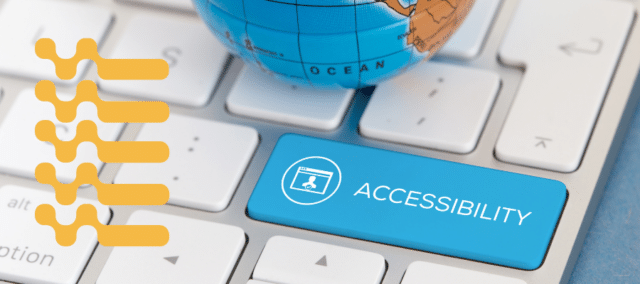
How to choose your subtitling service for precisely accurate subtitles
Learn moreThe Advantages of AI in Subtitling
AI brings a slew of benefits to the world of subtitling that are hard to ignore. Speed, efficiency, and cost-effectiveness are just the tip of the iceberg. In this section, we’ll dive into the advantages that AI-powered subtitling offers, showcasing the potential for faster turnaround times and broader multilingual capabilities.

Speed and Efficiency
One of the key advantages of AI-powered subtitling tools is speed and efficiency. These tools can quickly process large volumes of data, allowing for faster production times. In addition, they can automate certain tedious tasks such as transcription and translation, freeing up time for other aspects of the project. This makes AI-powered subtitling a great option for projects with tight deadlines.
Cost-Effectiveness
Another benefit of AI-powered subtitling is cost-effectiveness. These tools can be used to reduce the costs associated with hiring human translators or editors, as some of the tedious tasks can be automated at a fraction of the cost. Additionally, machine translation algorithms can be used to quickly and accurately generate subtitles in multiple languages, allowing for cost savings on translation projects.
Multilingual Capabilities
AI-powered subtitling tools also offer the benefit of increased multilingual capabilities. These tools can be used to automatically translate source language audio into multiple languages, enabling subtitling in a variety of languages without having to hire multiple human translators. This makes it easy for viewers in different countries to enjoy content with accurate and consistent subtitles.
Consistency and Scalability
Finally, AI-powered subtitling tools can also help ensure consistency and scalability. These tools can be used to maintain a high level of accuracy across multiple languages, as well as creating subtitles that adhere to conventions such as readability and time limits. This makes them a great choice for large-scale projects, as they can easily scale up without sacrificing quality or accuracy.
The Limitations of AI in Subtitling
While AI may promise efficiency, it is not without its limitations. Precision, context, and cultural sensitivity often elude automated systems. This section will shed light on the challenges AI faces when it comes to subtitling, providing a balanced view of its capabilities and shortcomings.

Accuracy and Precision Challenges
One of the key limitations of AI-powered subtitling tools is accuracy and precision. While machine translation algorithms can produce reasonable translations in some cases, they do not always capture the nuances of language or account for cultural references, making their accuracy questionable in certain contexts. Additionally, these tools may struggle to accurately transcribe fast-paced audio or dialogue with multiple speakers, leading to inaccuracies and errors in the subtitles.
Handling Context and Nuances
Another limitation of AI-powered subtitling is its ability to handle context and nuances. These tools are not able to recognize complex language structures, metaphors, humor, or slang, making it difficult for them to accurately understand and translate source language audio. For this reason, many subtitling projects still require human translators to ensure quality and accuracy.
Cultural Sensitivity and Adaptation
AI-powered subtitling tools also lack the ability to adapt subtitles for different cultures. This can lead to problems such as mistranslations or misunderstandings of cultural references in the subtitles, making them unsuitable for use in certain contexts. For example, a subtitling tool may not recognize the differences between British and American English, or the nuances of regional dialects.
Lack of Creative Input
Finally, AI-powered subtitling tools lack the ability to provide creative input on subtitles. These tools rely solely on algorithms and are not able to make decisions about readability, style, or timing of the subtitles. For this reason, it is still necessary to involve human translators and editors in subtitling projects to ensure that the subtitles are accurate and adhere to industry standards.

Get a customized offer
Request a quote for Speech-to-Text API
The Future of AI in Subtitling
As technology evolves, the future of AI in subtitling is a topic of great intrigue. In this section, we’ll explore ongoing developments and potential improvements on the horizon. Can AI evolve to overcome its limitations and become a more formidable force in the world of subtitling?
Ongoing Developments in AI Technology
The field of AI-powered subtitling is constantly evolving, with new technologies and algorithms emerging all the time. These developments have already led to significant improvements in accuracy and efficiency, as well as increased multilingual capabilities. As these developments continue, AI-powered subtitling tools will become increasingly sophisticated and useful.
Potential Improvements in AI Subtitling
In the future, AI-powered subtitling tools may be able to provide more accurate translations and better handle complex language structures. Additionally, these tools could become more adept at understanding cultural references and adapting subtitles for different countries or regions. This would enable subtitlers to produce subtitles that accurately reflect the source language and provide a more enjoyable experience for viewers.
Integration of AI with Human Translators
One of the most promising developments in AI-powered subtitling is the integration of AI tools with human translators. This could enable projects to benefit from both automated and manual subtitling, allowing them to maintain accuracy while scaling up quickly. However, this integration will require careful consideration to ensure that AI tools do not replace human translators completely.
Ethical Considerations in AI Subtitling
Finally, as the technology for AI-powered subtitling continues to develop, there are important ethical considerations that must be taken into account. These include issues such as ensuring accuracy and avoiding discrimination or bias in subtitles. It is important to consider these issues carefully when developing AI-powered subtitling tools, as they could have significant implications for the field going forward.
The Importance of Human-AI Collaboration
In a world where technology and human expertise coexist, the importance of collaboration cannot be overstated. This section delves into the synergistic relationship between human translators and AI systems. We’ll explore how this collaboration can yield the best results in terms of precise subtitling, ensuring quality and accuracy for global audiences.
Combining the Strengths of AI and Human Translators
The ability to successfully combine the strengths of AI and human translators is essential for optimizing subtitling projects. This allows you to take advantage of both automated and manual processes, utilizing the speed and efficiency of machine translation while maintaining accuracy through post-editing by human experts. By leveraging the strengths of both, it is possible to achieve quality and accuracy without sacrificing efficiency.
Quality Assurance and Post-Editing
Post-editing by human experts is essential for ensuring accuracy and quality in subtitling projects. Human translators can check and correct errors made by automated tools, as well as add any necessary cultural context or nuances to the subtitles. This can be done quickly and efficiently, allowing for a much faster turnaround time than if all of the work were done manually.
Training and Upskilling for Human Translators
In order to take full advantage of AI-human collaboration, it is important to ensure that human translators have the necessary skills and training. This will enable them to quickly and accurately post-edit subtitles generated by AI-powered tools. It is also important that human translators are kept up to date on the latest developments in AI technology, so they can best utilize these tools for their projects.
Ensuring the Best Results for Precise Subtitling
The use of both AI and human translators in subtitling projects is key to ensuring the best possible results. By combining automated tools with manual post-editing, it is possible to achieve high levels of accuracy without sacrificing speed or efficiency. This makes it easier for subtitlers to provide viewers with precise subtitles that accurately reflect the source language.
Balancing the Roles of AI and Human Translators
AI-powered subtitling tools have the potential to revolutionize the field of subtitling, streamlining and improving accuracy and efficiency for projects of all sizes. However, it is important to remember that AI tools alone are not enough; they must be integrated with human translators in order to get the best results. Human translators can provide post-editing to ensure accuracy and add the cultural nuances needed for effective subtitles.
By carefully balancing the roles of AI and human translators, subtitlers can simultaneously achieve higher accuracy and faster turnaround times in their projects. As these tools continue to develop, they will become increasingly sophisticated and useful – allowing for a more efficient subtitling process that supports the needs of both content creators and viewers alike.
Frequently Asked Questions
-
To which languages can you translate subtitles?
For our human-made subtitling services we work with a network of language experts in 15 different languages. Find out which here. If the language you want is not on the list, please contact us through our contact form.
-
Can I translate my subtitles and transcriptions via your app?
No, translation is not available in the automatic services but you can order translated manual subtitles services on our platform. Unfortunately, we do not offer translated manual transcriptions. Please check our prices here.
-
Do you also offer translations?
Yes, we do. We regularly do projects in many different languages. If you have a request please let us know through our contact form. Translated subtitles can be requested during the upload process.
-
How do I order translated subtitles?
To order translated subtitles, you can upload your file like you would normally do. You can then select manual subtitling. Once you have selected this, an option will appear where you will be able to select the language the subtitles need to be translated to. If the language that you want is not one of the options you can contact us through our contact form.
-
Can I burn the subtitles directly onto my video?
If you have exported the transcript as a SRT, EBU-STL or VTT file, you can easily burn them onto your video using video-editing software.
-
Can I change the position of the subtitles?
That needs to be done using a video editor like VLC. Go to Tools > Preferences [CTRL + P]. Under Show settings, select the option that says All to switch to the advanced preferences. Navigate to Input/Codecs > Subtitle codecs > Subtitles. Under Text subtitle decoder set, the Subtitle justification to left, right or center.
The future of transcription: How AI and machine learning are changing the game
In an age where technology continues to reshape industries, transcription services have not been left behind. At Ambercript, we understand the importance of staying at the forefront of innovation in transcription and subtitling. In this blog post, we’ll explore the evolving landscape of transcription, the rise of AI and machine learning, and how these technologies are changing the game for our clients.
Create error-free transcripts with Amberscript – in 3 simple steps

The evolution of transcription services
Traditional transcription services have long relied on human transcriptionists to painstakingly transcribe audio recordings into written text. While this method has been effective, it comes with limitations, such as time constraints and potential for errors due to human factors. What is transcription? Learn everything about it here.
The rise of AI in transcription
Artificial Intelligence (AI) and Machine Learning (ML) – these technologies have revolutionized transcription by automating processes that were once time-consuming and error-prone. AI-driven transcription services can transcribe audio and video files with remarkable speed and accuracy, making them an invaluable tool in today’s fast-paced world.
Ambercript utilizes AI and machine learning to offer transcription and subtitling services that are not only efficient but also cost-effective. Our AI-driven approach ensures that you get your transcriptions quickly and accurately.
More detail on AI and Machine Learning on relation to transcription services
In the realm of transcription services, the integration of AI and machine learning has revolutionized the way we convert spoken words into written text. AI-driven transcription leverages complex algorithms and neural networks to automatically transcribe audio and video content with remarkable speed and accuracy. ML plays a pivotal role in enhancing transcription accuracy over time, as it continually learns from vast datasets, adapting to various accents, languages, and speech patterns. This dynamic duo of AI and ML not only accelerates the transcription process but also refines it, making it increasingly adept at handling diverse audio sources. The result is a transcription service that’s not only efficient but also adaptable and capable of delivering top-tier quality, regardless of the complexity of the content.
Ambercript’s innovative approach
What sets Ambercript apart is our innovative blend of AI and human expertise. While AI handles the heavy lifting, our team of human professionals ensures that the final output is of the highest quality. This hybrid approach combines the speed of AI with the precision of human editing, guaranteeing you transcripts that meet the most rigorous standards.
Machine-Made Transcription
Amberscript’s machine-made transcription service offers a quick and budget-friendly solution for transcription needs. Leveraging advanced speech-to-text technology, Amberscript can swiftly and accurately transcribe your audio content within minutes. This service is particularly well-suited for clear audio recordings with minimal background noise, such as interviews, lectures, and podcasts. Amberscript’s machine-made transcription service supports over 30 languages, including English, French, German, and Spanish.
Using this service is straightforward, as you can easily upload your audio files to the platform with just a few clicks. Once your transcription is generated, you have the flexibility to edit and customize it in Amberscript’s highly secure cloud-based environment. Offering competitive pricing and rapid turnaround times, Amberscript’s machine-made transcription service provides a cost-effective solution for those in need of swift and accurate transcriptions.
Learn everything about machine-made transcriptions here.
This could also interest you
How to Transcribe Fast: 10 Tips
Transcribing audio can be a time-consuming and laborious task, especially if you are dealing with long recordings. In this article, we’ll go over ten practical tips on how to transcribe audio quickly and efficiently, so you can get the job done faster and with much less effort.
Read moreHuman-Made Transcription
For those seeking utmost accuracy and specialized transcriptions, Amberscript’s human-made transcription service is the ideal choice. Backed by a team of skilled transcribers and captioners, Amberscript delivers high-quality transcriptions that can achieve up to 100% accuracy. This service is well-suited for intricate audio recordings featuring challenging accents or multiple speakers, as often seen in legal or medical transcriptions.
Amberscript’s human-made transcription service includes the support of a dedicated project manager who collaborates with you to ensure that your transcription meets your precise requirements. With flexible pricing options and swift turnaround times, Amberscript’s human-made transcription service stands as a dependable and efficient solution for those demanding the highest accuracy and specialized transcriptions.
Industries Benefiting from AI Transcription
Various industries have embraced AI-driven transcription services. In healthcare, for example, accurate medical transcripts are crucial for patient care and research. Legal professionals appreciate the speed and accuracy of AI transcripts in the courtroom, while media companies rely on transcription for video content accessibility.
Ambercript has worked with clients across these industries, providing tailor-made transcription solutions that meet their specific needs. Real-world examples illustrate how our services have streamlined their operations and improved efficiency. Universities, media and broadcasting companies as well as individual journalists, students, governments and more have already made use of our service. Read their full case studies here.
The Future of Transcription Services
The future of transcription is bright and promising. As AI and machine learning continue to advance, transcription services will become even more accessible, accurate, and efficient. At Ambercript, we remain committed to staying at the cutting edge of these developments.
We are continually working on enhancing our services, exploring new languages, and improving the accuracy of our transcriptions. Expect exciting features and developments from us in the near future as we continue to innovate in the transcription and subtitling space.
How to Get Started with Ambercript
Are you ready to experience the future of transcription? Getting started with Ambercript is simple.
- Visit our website and upload your audio or video files: Simply upload your audio or video clip to our secure network. You may submit audio clips, taped phone conversations, audiobooks, or anything else that can be saved as a digital file.
- Select the language of the meeting: Specify the language in which you wish your text to be written. Our language specialists are native speakers who produce documents with the utmost accuracy in material that has been made more legible or words typed verbatim.
- Choose whether you want an automated or manual transcript: Pick your preference of transcription style and go through our transcriber’s magic. Our human-made transcription service allows our language experts to transcribe with up to 100% accuracy. Our machine-made transcription service automatically converts your audio and video to text with our AI recognition, which saves hours of transcription time.
- Receive your file: We’ll handle all the transcribing, editing, and file formats. You can now receive your file as a document ready to be exported in SRT, VTT, and many other formats, with optional timestamps and speaker distinction.
Find more tutorials on how to use our online platform and editor on our YouTube channel.
AI and machine learning are ushering in a new era for transcription services. At Ambercript, we are proud to be at the forefront of this transformation, offering you the best of both worlds – the efficiency of AI and the precision of human expertise. Join us on this exciting journey towards the future of transcription, and let’s change the game together.
Ready to experience the future of transcription? Contact us today for inquiries or request a demo. Stay updated with the latest advancements in transcription technology by following our blog and social media channels. Your transcription needs are evolving, and so are we at Ambercript.

or get a customized offer
Request a quote for machine-made transcription
Choosing the Right Transcription Service for Universities
In recent years, transcription services have become indispensable tools for universities, supporting a wide array of tasks. Accurate transcriptions hold multifaceted advantages for educational institutions, facilitating accessibility for both students and faculty through readable lecture recordings and research documentation. Moreover, transcription services foster inclusivity, providing transcripts that cater to diverse readers. Consequently, selecting the appropriate transcription service becomes a crucial decision to meet institutional needs effectively.
Table of Contents
- The Role of Transcription Services in Universities
- Benefits of Transcription Services for Universities
- Factors to Consider When Choosing a Transcription Service
- Prominent Transcription Services for Universities
- Key Findings
The Role of Transcription Services in Universities
Transcription services empower universities to transcribe and document lectures, research endeavors, interviews, and meetings, serving a multitude of academic purposes. Precise transcripts guarantee accurate information preservation. These transcripts also enable inclusivity by catering to varying learning styles and disabilities among students and faculty. They play a pivotal role in archiving records, capturing research progress, and preserving knowledge for future generations. Through transcription services, universities harness content potential while championing inclusivity within their communities.

Transcriptions hold additional utility, serving as referenceable records for meetings and interviews. They contribute to creating video and podcast subtitles, augmenting content accessibility. These services hence stand as vital resources for universities and other educational institutions.
Benefits of Transcription Services for Universities
The advantages of transcription services for universities are abundant and undeniable. By bolstering accessibility and preserving knowledge, these services offer immeasurable value. Their meticulous contribution to accuracy and inclusivity underscores their essential role in education. By aligning with a suitable service, universities optimize content potential while nurturing inclusivity within their academic circles. The aim of this blog post is to provide a guiding framework to kickstart your journey with transcription services and help you choose the most fitting option for your institution.

Transcription Services for Universities: Enhancing Accessibility, Learning, and Research
Learn moreFactors to Consider When Choosing a Transcription Service
When it comes to selecting the right transcription service, there’s more to it than meets the eye. In the digital age, where audio and video content proliferate, the need for accurate and efficient transcriptions has never been more crucial. Whether you’re a university aiming to make lectures accessible or a business seeking to streamline operations, the choice of a transcription service can significantly impact your outcomes. To make an informed decision, it’s essential to consider various factors beyond just cost and turnaround time. In this article, we’ll delve into the key factors to consider when choosing a transcription service, ensuring that you select the one that aligns perfectly with your unique needs and goals.

Accuracy and Quality
As universities deliberate over transcription service options, accuracy and quality emerge as paramount considerations. Especially for academic contexts, precise, error-free transcripts are imperative. Employing human editors for transcript review upholds an exceptional standard of quality. Leveraging AI technology further enhances accuracy by real-time analysis of audio content, culminating in effortless, accurate transcripts. Ultimately, high-quality results are non-negotiable for universities seeking reliable and efficient transcription services.

University Research Transcripts: Unlocking the Power of Perfection
Read the blogTurnaround Time
Alongside accuracy and quality, universities must factor in turnaround time when selecting transcription services. This consideration gains significance for lectures, events, and research activities necessitating swift transcriptions. Diverse services offer varying turnaround times to cater to the unique requirements of clients. Some services promise quick delivery within hours, while others prioritize comprehensive processing for intricate audio content.
The size and complexity of audio files influence turnaround time, which can be expedited in urgent cases. By factoring in turnaround time, universities secure timely transcriptions that optimize academic content and uphold knowledge preservation.
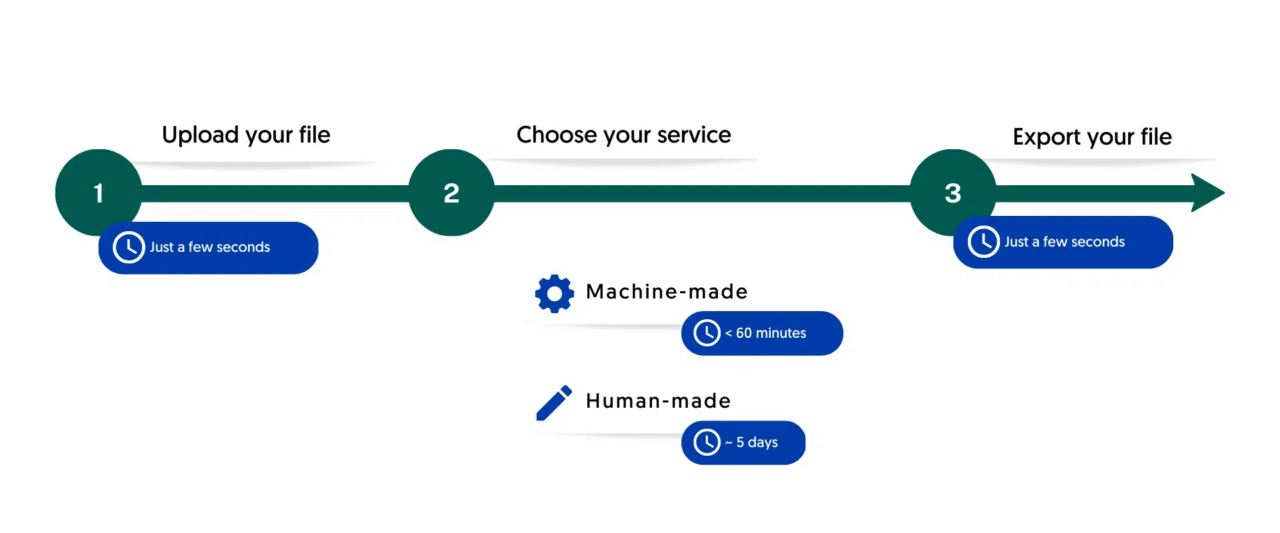
Specialized Terminology and Context
In the pursuit of a transcription service, universities must factor in the accommodation of specialized terminology and context. Academic content often contains intricate technical terms that might elude the general audience. Hence, institutions should seek services that comprehend the intricacies of academic language, producing accurate transcripts that maintain precision.
Furthermore, specialized expertise catering to specific fields or subjects proves invaluable. This is particularly true for transcribing intricate content like medical reports or legal documents. By aligning with services that acknowledge context and terminology nuances, universities assure themselves of accurate, contemporary transcripts for their fields of study.
Integration with Existing Systems
Universities must also contemplate the integration convenience of chosen transcription services with existing systems. Services that streamline direct uploads and integration with university tools, such as learning management systems, expedite processes while upholding accuracy and punctuality.

Seamless integration enables direct transcript access from databases, negating manual downloads and ensuring instant availability. Such integration further facilitates usage monitoring and policy compliance enforcement. In summary, harmonious integration with established systems is indispensable, ensuring efficient and reliable transcription services.
Data Security and Confidentiality
Data security and confidentiality stand as paramount concerns in selecting a transcription service. Given the sensitive nature of academic content, services must align with industry standards, ensuring data protection through encryption, secure storage, and adherence to regulations like GDPR.
Privacy policies also warrant scrutiny, with clear, transparent statements ensuring confidential data handling within legal boundaries. Backup systems against data loss or breaches contribute to comprehensive security protocols. Universities should thus opt for transcription services that epitomize data security and confidentiality, offering peace of mind regarding content safety.
Cost and Pricing Models
Universities need to navigate the various cost and pricing models while selecting a transcription service. Services proffer pay-per-minute, subscription, or per-project models, enabling flexible budgeting. This equilibrium between cost optimization and transcript accuracy and punctuality is imperative.
The equilibrium extends to evaluating cost-effective options while assessing potential impacts on quality and delivery times. Striking the right balance between cost and quality ensures transcripts remain exemplary and punctual.

Get a customized offer
Request a quote for your needs
Customization and Editing Tools
Customization and editing tools constitute another consideration for universities in their quest for an apt transcription service. Services providing editing tools facilitate transcript refinement, including font adjustments, timestamp alterations, formatting modifications, and other refinements.
Moreover, services offering enhanced customization options—such as annotations, word/phrase deletion, and precise timestamp adjustments—enable tailored transcripts aligning with specific requirements. By embracing services with expansive customization and editing tools, universities ensure transcript precision while catering to specific demands.
User Experience and Support
User experience and support are pivotal in the transcription service selection process. Intuitive interfaces contribute to simplified transcript management for users. Services backed by resources like tutorials and customer service channels amplify convenience, ensuring users remain well-supported.

Furthermore, efficient customer support, encompassing features like live chat and dedicated phone lines, facilitate prompt issue resolution. Opting for services prioritizing user-friendly interfaces and dependable customer support guarantees a seamless user experience throughout the transcription journey.
Prominent Transcription Services for Universities
When it comes to transcription services, universities possess a gamut of options. Among the frontrunners is Amberscript, catering to educational institutions with cost-effective rates and secure data storage. Rev sets itself apart with rapid turnaround times and an impressive 99% accuracy rate, accepting diverse audio formats. Verbit leverages AI for an accuracy rate exceeding 99%, while Trint boasts an intuitive dashboard, transcription editor, and real-time progress tracking.
Cloud-based Sonix supports multiple languages, while Temi’s automated speech recognition technology expedites transcriptions. Additionally, Otter.ai and Scribie offer AI-driven accuracy and prompt turnaround times. Universities are presented with a spectrum of transcription services featuring diverse offerings such as cost-effectiveness, swift turnaround, secure data storage, and automated speech recognition technology.
Benefits of using Amberscript
Amberscript’s services are:
Edit your text in minutes or leave the work to our experienced transcriptionists.
Our experienced transcriptionists and thorough quality controls ensure 100% accuracy of transcripts.
Through a series of integrations and API interfaces, you can fully automate your workflows.
Your data is in safe hands. We are GDPR compliant + ISO27001 and ISO9001 certified.
Key Findings
Universities embarking on the journey of selecting a transcription service must align choices with their unique needs. The array of features, from cost-effectiveness to secure data storage, reflects the flexibility of transcription services in catering to the distinct requirements of educational institutions. Robust editing tools, customization options, user experience, and dependable customer support further shape the selection process.
Amberscript emerges as a fitting solution, offering optimal features for educational institutions. By entrusting the right service, universities optimize accuracy, punctuality, and cost-effectiveness, bolstering their transcripts and fortifying their academic pursuits.
What Programs Can I Use to Open a VTT File
Table of Contents
- Brief description of a VTT file and its common usage
- Increasing popularity of web videos and the need for subtitles or captions
- Use cases of VTT Files: Captions, subtitles, metadata for videos, etc
- Native Browser Support
- Software & Applications
- Online Tools
- Encouragement for readers to explore and choose the best tool suited for their need
Brief description of a VTT file and its common usage
A VTT file, standing for “Web Video Text Tracks,” is a format used for displaying subtitles or captions for video content on the web. Originating as part of the HTML5 specification, VTT files allow video creators to enhance accessibility and provide additional content or translations for their viewers. These files typically have a “.vtt” extension and contain both the timing information and the text of the captions or subtitles to be displayed.
Commonly, VTT files are employed by online video platforms, such as YouTube and Vimeo, to offer subtitles in various languages or to deliver essential closed captions for viewers with hearing impairments. Beyond accessibility, they can also be used for karaoke applications, providing song lyrics in sync with music videos, or for any media content where timed text is beneficial.
Increasing popularity of web videos and the need for subtitles or captions
The digital age has seen an unprecedented surge in the consumption of web videos. From short clips on social media platforms like TikTok and Instagram to full-length films on streaming services like Netflix and Hulu, video content is undeniably a dominant form of media today. As of recent statistics, billions of hours of videos are watched daily across various platforms, reflecting the global audience’s insatiable appetite for visual content.
With this rise in popularity comes a diverse, global audience. As videos cross borders and are viewed by people from different countries, cultures, and linguistic backgrounds, the need for subtitles and captions becomes paramount. Subtitles not only break down language barriers, enabling content creators to reach a wider audience, but they also ensure inclusivity. Captions, in particular, are crucial for viewers who are deaf or hard of hearing, making videos accessible to them.
Moreover, with the increasing noise and distractions in public places and the trend of muting videos by default on many social media feeds, many viewers rely on captions to understand video content without sound. This shift has made subtitles and captions more than just an accessibility feature; they are now a fundamental part of the user experience for many viewers. In essence, as web videos continue to thrive, the importance of VTT files and other subtitling formats will only grow, catering to the diverse needs of the global audience.
Benefits of Using VTT Files for Subtitling in Content Creation
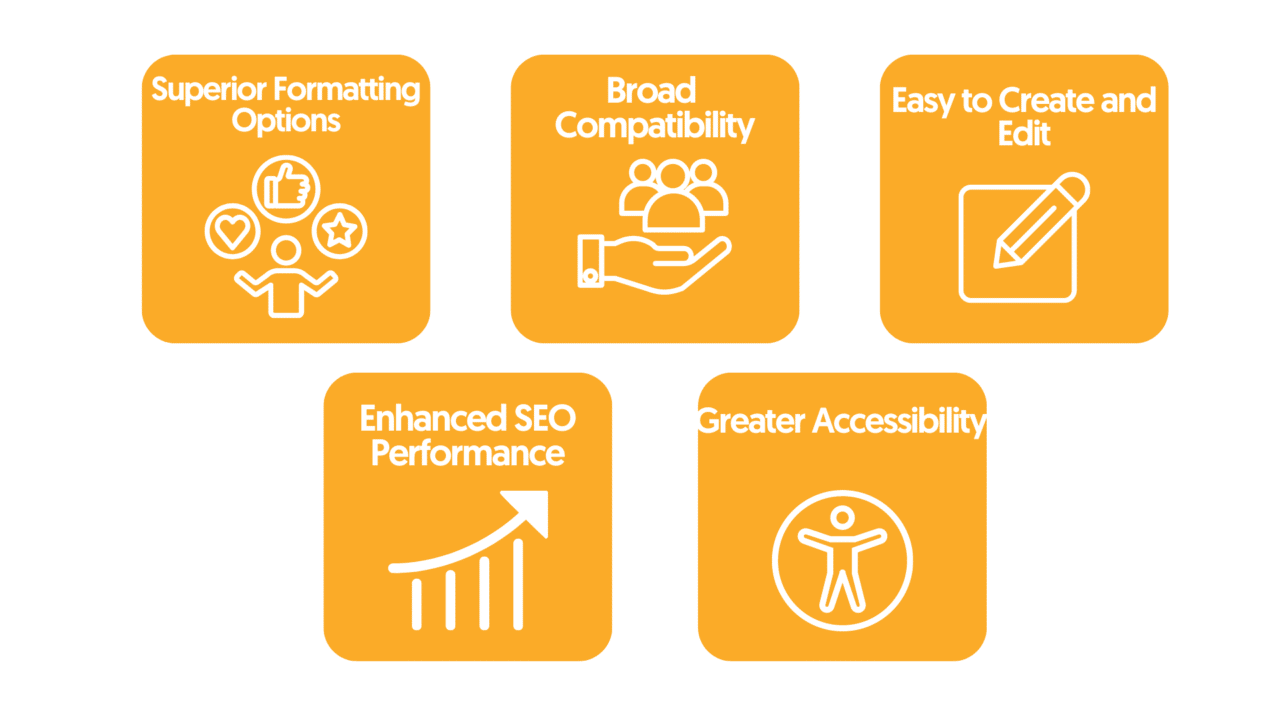
Use cases of VTT Files: Captions, subtitles, metadata for videos, etc
VTT files have proven to be incredibly versatile, catering to various needs when it comes to video content. Let’s delve into some primary use cases:
- Captions: Perhaps the most well-known use of VTT files is for closed captioning. Unlike subtitles, which primarily translate dialogue for viewers who speak a different language, captions convey all relevant audio information. This includes spoken dialogue as well as sound effects, background noises, and musical cues, making them especially useful for viewers who are deaf or hard of hearing. Captions ensure that these viewers have the same rich experience as those who can hear the audio.
- Subtitles: Subtitles primarily serve to translate spoken dialogue and are instrumental in making video content more accessible to a global audience. With VTT files, content creators can provide multiple subtitle tracks, enabling viewers to select their preferred language. This not only breaks down linguistic barriers but also opens up the content to a wider, global audience.
- Metadata for Videos: VTT files can also be used to embed metadata within video content. This could be supplementary information about the video, details about the content, links to related resources, or even commentary. For example, during an educational video, a VTT track might provide additional reading materials or definitions for specific terms mentioned in the video.
- Chapter Titles and Navigation: For longer videos, such as lectures, workshops, or movies, VTT files can be used to define chapters or sections. This aids viewers in navigating through the content, allowing them to skip to relevant parts easily.
- Karaoke Lyrics: An entertaining use of VTT files is in karaoke settings, where the lyrics of a song are displayed in sync with the music, allowing participants to sing along.
- Interactive Elements: As web video technology evolves, there’s potential for VTT to be used in creating interactive video experiences. This could include clickable links, pop-up trivia, or even interactive quizzes that appear at specific timestamps.
In summary, while VTT files are often associated mainly with subtitles and captions, their potential applications are vast. As video content continues to evolve and become more interactive and immersive, the uses and importance of VTT files are likely to expand further.

Native Browser Support
One of the significant advantages of VTT files is the built-in support by modern web browsers. This native compatibility ensures a seamless experience for users, without the need for additional plugins or extensions. Here’s a breakdown of how native browser support for VTT files works:
- HTML5 Video Element: The Web Video Text Tracks format (WebVTT) was introduced as a standard component of the HTML5 specification. This means that any video embedded on a webpage using the HTML5
<video>element can inherently support VTT subtitle and caption tracks using the<track>element. - Browsers That Support VTT: The majority of contemporary web browsers, including Google Chrome, Mozilla Firefox, Apple Safari, Microsoft Edge, and even many mobile browsers, have integrated support for VTT files. When a user plays a video in these browsers, they can usually access subtitle or caption tracks (if available) through a built-in video player interface.
- Loading VTT Files: To provide captions or subtitles for a video, content creators simply need to link to the VTT file within their video element.
- Styling and Customization: Modern browsers also provide options to customize the appearance of captions and subtitles. Users can often adjust font size, color, and background for better visibility based on their preferences. Furthermore, CSS can be used by web developers to apply advanced styles to captions and subtitles, ensuring they align with the website’s design aesthetic.
- Fallbacks and Accessibility: Native browser support for VTT also benefits from built-in fallbacks. If a browser doesn’t recognize the VTT file or encounters an error, it typically fails gracefully, ensuring the video remains watchable. Additionally, this native support ties in with browser accessibility features, providing tools and options for users with disabilities.
In conclusion, the native support of VTT files by modern browsers ensures that video content remains accessible, interactive, and versatile, without placing additional burdens on viewers or requiring them to install third-party tools.
Software & Applications
Beyond web browsers, numerous software and applications can handle VTT files, aiding in both viewing and editing them. Here’s a brief look at some notable ones:
- VLC Media Player: A widely used, open-source media player, VLC supports playback of videos with associated VTT subtitle tracks. Users can easily load VTT files and view them alongside their videos.
- Notepad++ (Windows) & TextEdit (Mac): These text editors can open VTT files, enabling users to view or make changes to the content. This is especially handy for those looking to manually adjust timings or edit the text within the VTT file.
- Subtitle Edit: A dedicated tool for creating, editing, and converting subtitle files. It offers a user-friendly interface for editing VTT files, along with other subtitle formats. With features like spell-check, synchronization, and translation, it’s a go-to for many subtitle professionals.
- PotPlayer & KMPlayer: Both of these multimedia players, popular in various regions, offer robust support for subtitle tracks, including VTT. They offer advanced features for subtitle synchronization, style customization, and more.
These software options and applications ensure that users have a range of choices when working with VTT files, whether they’re casual viewers or professionals looking to craft precise subtitle tracks.
Online Tools
In today’s digital age, online tools provide a convenient, browser-based solution for users who need to work with VTT files without downloading dedicated software. These platforms often come with intuitive interfaces, ensuring ease of use. Among the myriad of tools available, Amberscript stands out for its comprehensive offerings:
- Amberscript: A leader in the transcription industry, Amberscript harnesses the power of advanced AI to deliver top-tier, automatic speech recognition services. Amberscript’s Machine-made transcription” option can churn out highly accurate transcripts in quick turnaround times, achieving precision levels of up to 95% including an online text editor for their users to edit their transcripts online. For those who prefer a more personal touch or have content that requires the nuanced understanding of a human, Amberscript offers a Human-made transcription service. Leveraging the expertise of professional transcriptionists, this option ensures every detail, inflection, and context is captured perfectly in the transcript. It’s an excellent choice for those who want the highest level of accuracy and care.
- Subtitle Horse: An online platform for creating, editing, and synchronizing subtitles. Its user-friendly interface is perfect for those who want to work on their subtitles directly from their browsers.
- VTT Creator: An online tool tailored specifically for VTT files, making it an excellent choice for those who work extensively with the WebVTT format.
The beauty of these online tools, Amberscript included, is the ability to seamlessly integrate transcription and subtitling processes into one’s workflow without the need for cumbersome software installations. They cater to a range of needs, from quick AI-driven transcriptions to meticulous, human-crafted ones, ensuring users always have the right tool at their fingertips.

Encouragement for readers to explore and choose the best tool suited for their needs
In the dynamic landscape of video content and accessibility, the tools and resources at our disposal are ever-evolving. From native browser support to dedicated software and innovative online platforms, there’s a wealth of options available for those venturing into the world of VTT files and transcription. It’s crucial to remember that the best tool isn’t universally the same for everyone—it’s what best fits your specific needs, whether it be speed, accuracy, human touch, or flexibility.
Take a moment to assess your objectives. Are you looking for rapid machine-made transcriptions, or do you prefer the precision and nuance of human-made text? Whatever your needs may be, Amberscript offers the perfect solution for you!
Dive in, explore, and experiment until you find the solution that seamlessly integrates into your workflow. With the right tool in hand, you’ll not only enhance the accessibility and reach of your content but also ensure a more enriching experience for your audience. Embrace the journey and find the perfect match for your VTT and transcription needs!
Enhancing University Education with AI-Driven Transcription & Subtitling
In today’s digital age, universities are embracing online education and e-learning like never before. With the shift towards remote learning and the incorporation of technology into traditional classrooms, the importance of audio and video content has skyrocketed. These mediums enhance the learning experience, making it more engaging and accessible to students worldwide.
At Ambercript, we understand the pivotal role that audio and video content plays in modern education. We offer AI-driven transcription and subtitling services, combining the power of technology with human expertise to help universities efficiently manage their audio and video files.
How to easily transcribe audio and video content with Amberscript

Agenda
- Converting video and audio content to text
- The digital transformation of education
- Challenges of managing audio and video content
- Ambercript’s solutions
- Getting started with Ambercript
Converting video and audio content to text
The process of converting video and audio content into text has become indispensable. This transformation not only makes multimedia content more searchable and accessible but also enhances its utility across various applications. By leveraging cutting-edge technology and expert human oversight, services like Ambercript make this conversion seamless and highly accurate. Whether it’s transcribing lectures for educational purposes, creating subtitles for videos, or improving content accessibility for all audiences, converting video and audio content to text is a game-changer in how we interact with and utilize multimedia resources.
The digital transformation of education
Universities worldwide are undergoing a profound digital transformation. Traditional classrooms are being complemented, and in some cases replaced, by virtual lectures and e-learning platforms. As a result, the need for high-quality audio and video content has never been greater. Whether it’s recording lectures, capturing events, or providing supplementary materials, universities are generating vast amounts of multimedia content to support their educational goals.
Challenges of managing audio and video content
However, with the surge in multimedia content comes a set of challenges. Universities must grapple with the sheer volume of files, making it a daunting task to organize, search, and retrieve specific content. Moreover, ensuring accessibility for all students, including those with disabilities, is a critical concern.
Transcription and subtitling are essential solutions for addressing these challenges. They make content more searchable, enhance comprehension, and provide accessibility benefits. This is where Ambercript steps in to offer efficient and effective solutions.
Ambercript’s solutions
Ambercript’s AI-driven transcription and subtitling services are designed to streamline the management of audio and video content for universities. Our cutting-edge technology can transcribe lectures and events accurately and quickly, saving valuable time for educators and students.
But we don’t stop at automation. We recognize the importance of accuracy and quality, especially in an educational context. That’s why we combine our AI technology with human expertise to ensure the highest level of precision in transcriptions and subtitles. Our team of experts reviews and edits the content generated by our AI, guaranteeing top-notch results.
Accessibility and inclusivity
Accessibility is at the core of modern education. Every student deserves equal access to educational materials, regardless of their abilities. Transcriptions and subtitles improve accessibility by making audio and video content comprehensible for individuals with hearing impairments and those who prefer to read along.
Ambercript’s services empower universities to create an inclusive learning environment. By providing accurate transcriptions and subtitles, institutions can cater to a wider audience, fostering an educational atmosphere that values diversity and accessibility.
Find out more
Unlocking Accessible eLearning: A Comprehensive Guide for Higher Education Institutions
In higher education, accessibility involves creating an inclusive learning environment that accommodates and mitigates barriers for students with disabilities or different learning needs. Learn all about accessibility measures in higher education and how you can empower all people regardless of their learning needs.
Read the full guideTestimonials and success stories
Don’t just take our word for it; let our customers speak for us. Universities and educational institutions that have adopted Ambercript’s services have seen remarkable improvements. Our accurate transcriptions and subtitles have enhanced content accessibility, boosted student engagement, and saved educators precious time. Here are a few examples:
“The implementation in Opencast after the purchase was super easy and worked flawlessly”
– Tino Tschiesche from University of Jena’s Computer Centre
Through this collaboration with Amberscript, the University of Jena now automatically subtitles all lecture and class recordings with a fully automated workflow via the Opencast integration for more digital accessibility on the intranet and extranet. Read the full story here.
“We collect a lot of qualitative data in different projects. Thanks to our collaboration with Amberscript, we are guaranteed good and timely transcriptions of our interviews, and we are able to focus our own attention on the analysis”
– Dr. D. van Middelkoop, a researcher for the University of Applied Sciences Amsterdam (HvA)
Amsterdam University of Applied Sciences decided to start using Amberscript’s transcription services to convert recorded interviews to transcripts. Read the full story here.
Getting started with Ambercript
Are you ready to revolutionize the way your university handles audio and video content? Getting started with Ambercript is simple:
- Contact us for a consultation or request a demo.
- Explore our tailored solutions to fit your university’s specific needs.
- Experience the benefits of efficient content management, enhanced accessibility, and improved engagement.
- Join the universities worldwide that have already embraced the future of education with Ambercript.
The digital transformation of education is here to stay, and Ambercript is here to support universities every step of the way. Our AI-driven transcription and subtitling services empower educational institutions to make their audio and video content more accessible, engaging, and manageable. With Ambercript, universities can create a brighter, more inclusive future for all students.
For more insights and success stories, visit our Case Studies section.
Ready to transform your university’s educational content? Contact Ambercript today to get started or try our automatic services for free. Together, we can shape the future of education.
Speech Recognition in Academic Research: Present and Future
In academia, universities are at the forefront of research and knowledge creation. To drive their research initiatives, they are looking for innovative tools and technologies to advance them. One such technology that is making high waves is speech recognition. From linguistics to psychology and beyond, speech recognition in academic research as a tools are changing the way universities conduct research. In this article, we will explore the current state and future prospects of speech recognition tools in academic research, with a particular focus on how universities can benefit from this technology. We will also introduce Amberscript, a leading provider of transcription and captioning services that can help universities take advantage of this technology.
Agenda
- What is speech recognition technology?
- The evolution of speech recognition in academia
- Benefits of speech recognition in academic research
- Challenges and limitations
- Amberscript’s solutions for academic research
- Future prospects of speech recognition in academia
What is speech recognition technology?
Speech recognition technology, also known as automatic speech recognition (ASR) or speech recognition, is a technology that enables computers and software to understand and interpret spoken language. It converts spoken words into written text or performs certain actions based on spoken commands.
Speech recognition technology has made significant progress in recent years thanks to machine learning and deep learning techniques. It continues to evolve, with applications spreading across different industries and becoming an integral part of our daily lives.
Find out more
Best speech to text tools for academics
With an increasing amount of information and a limited amount of time, academics are always looking for ways to optimize their workflow. In this article, we’ll look at some of the best speech to text tools for academics and discuss their features and benefits.
Read moreThe evolution of speech recognition in academia
Speech recognition technology has come a long way since its beginnings. Early systems were limited in their accuracy and application, but significant progress has been made over the years. Researchers have played an important role in advancing this technology and pushing the boundaries of speech recognition further and further.
Key milestones in the development of speech recognition include the development of hidden Markov models (HMMs) in the 1970s and the introduction of deep learning techniques in the 21st century. These breakthroughs have led to improved accuracy and ease of use, making speech recognition a valuable tool in academic research.
Benefits of speech recognition in academic research
The use of speech recognition tools in academic research brings numerous benefits. Researchers can now transcribe interviews, record lectures and analyse spoken data with unprecedented speed and accuracy. This not only saves time, but also increases the efficiency of research projects.
For example, linguists can analyse large corpora of spoken language more quickly, psychologists can study speech patterns in clinical settings, and social scientists can gain valuable insights from interviews and focus group discussions. Speech recognition tools are revolutionising data collection and analysis in these fields.
Challenges and limitations
Despite the advances that have been made in speech recognition, challenges remain. Different accents, background noise and technical limitations can still affect the accuracy of automatic transcription. In academic research, where accuracy is paramount, these challenges cannot be overlooked.
This is where Amberscript comes in. We know how important high-quality transcription and captioning services are in academic research. Our combination of AI-driven technology and human expertise ensures accurate and reliable results, even in challenging conditions. We have a dedicated team of professionals who review and edit transcripts to ensure the highest level of accuracy.
Amberscript’s solutions for academic research
Amberscript offers a range of solutions tailored to the needs of academics. Find more information on our research solution here. Our AI-driven transcription and captioning services are designed to streamline your research workflow. With advanced algorithms and machine learning, we deliver fast and accurate transcriptions that save you valuable time.
What sets Amberscript apart is our commitment to quality. Although automation plays an important role in our services, we understand the value of human expertise. Our team of experienced transcriptionists and editors ensures that your transcripts are error-free and available for your research. You can rely on Amberscript to deliver the highest quality results for your academic projects.
Future prospects of speech recognition in academia
The outlook for speech recognition technology in academia is promising. Further advances in machine learning and artificial intelligence will lead to even greater accuracy and speech support. Researchers can expect increasingly sophisticated tools to assist them in data collection and analysis.
In the dynamic world of science, universities are constantly pushing the boundaries of knowledge. To stay ahead, they need cutting-edge tools that enhance their research capabilities. Speech recognition technology is proving to be groundbreaking, offering unprecedented speed and accuracy in data capture and analysis. Amberscript is ready to help universities adopt this innovative technology.
Are you a university looking to enhance your research efforts with the power of speech recognition? Visit our website to learn more about our services and start a free trial today. Join universities around the world who trust Amberscript for their transcription and captioning needs. Together, we are embarking on a journey of discovery and innovation in the field of academic research.

Get a customized offer
Request a quote for machine-made transcription
Can I play a VTT file on my iPhone?
Table of Contents
- Brief explanation of VTT files
- Can VTT files be played on an iPhone?
- Formats and content of VTT files
- Challenges of Playing VTT Files on iPhones
- Available Solutions
- Steps to Play VTT Files on an iPhone
Brief explanation of VTT files
VTT files, also known as WebVTT files, are a type of text-based file format used to create subtitles or captions for videos on the web. “VTT” stands for “Web Video Text Tracks.” These files contain timed text cues that are synchronized with the video playback. They are commonly used to provide accessibility features such as subtitles for the deaf and hard-of-hearing, as well as for language translation and video indexing purposes.
VTT files are written in a specific format that includes timing information for each subtitle or caption cue. Each cue typically consists of a start time, an end time, and the text content of the subtitle. The cues are separated by an empty line.
VTT files are widely supported by modern web browsers and video players, making it easy to display captions alongside videos. They are a flexible and accessible way to enhance the usability and inclusivity of online videos.

Can VTT Files Be Played on an iPhone?
iPhones, celebrated for their sleek design and advanced functionalities, bring forth both opportunities and challenges for experiencing WebVTT files.
The compatibility of VTT files with iPhones relies on essential factors:
- Technical Considerations: While iPhones showcase impressive processing prowess and graphic capabilities, they are inevitably limited by screen dimensions and hardware specifications. WebVTT files, often tailored for larger displays, may necessitate adjustments to ensure optimal visibility and operational efficacy on iPhones.
- File Formats: VTT files are available in diverse formats, contingent upon the originating platform or software. The harmony between these formats and iOS devices significantly influences the feasibility of seamless VTT playback on iPhones.
- User Interface: The intuitive interface of VTT platforms is a pivotal facet of user experience. Adapting these interfaces to iPhones’ touchscreen dynamics requires meticulous thought to ensure intuitive navigation and effortless interaction.
Whether achieved through dedicated applications, web-based platforms, or innovative design strategies, the arena of WebVTT experiences on iPhones continues to evolve, offering many possibilities for enthusiasts who seek a harmonious blend of convenience and captivating engagement.
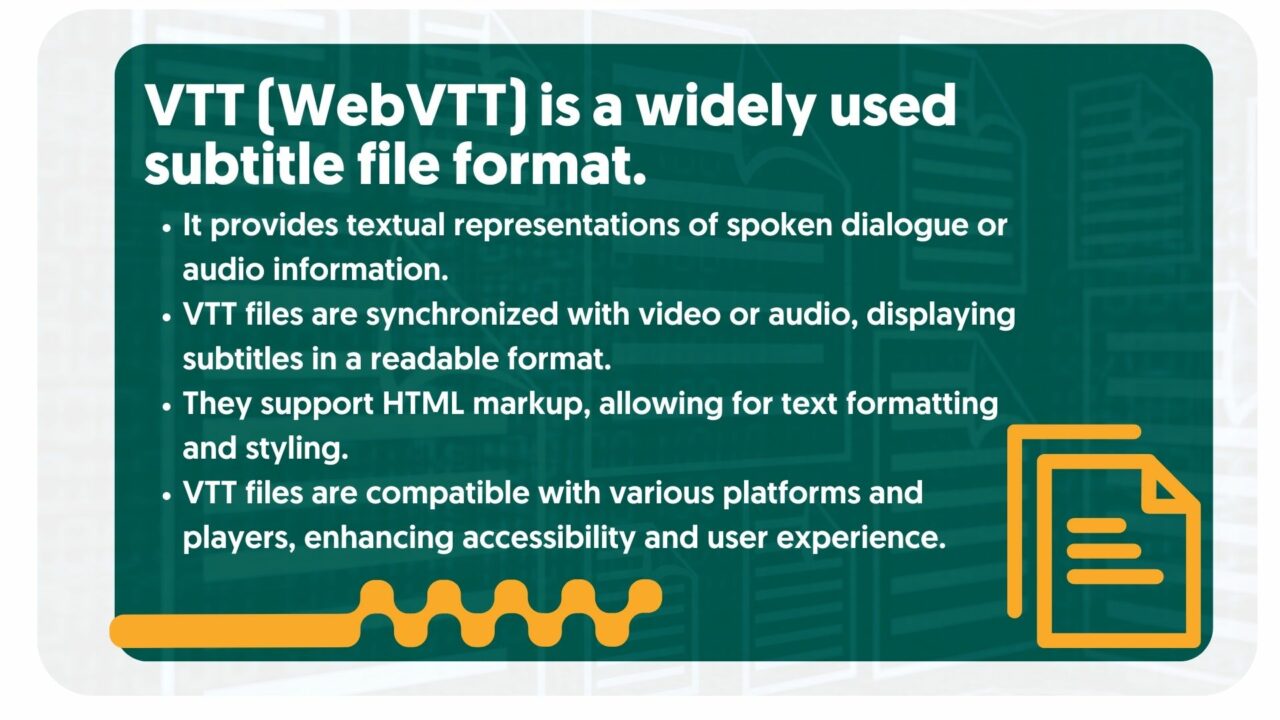
Formats and Content of VTT Files
VTT files, a specific format used for synchronizing text with multimedia content, offer a structured and versatile approach to enhancing user experiences across various digital platforms. These files are particularly valuable for scenarios where text-based information needs to be precisely timed and coordinated with audiovisual elements.
File Format Structure:
VTT files adhere to a structured syntax that includes distinct components. These components ensure accurate synchronization between the displayed text and the corresponding moments in multimedia content:
- Timestamps: WebVTT files begin with timestamps indicating when each caption or text block should be displayed and hidden. These timestamps are essential for maintaining synchronization with the media.
- Text Captions: The heart of VTT files lies in the text captions themselves. Each caption block contains the text that will be displayed to the audience at the specified timestamp. This text can include dialogue, descriptions, or any other relevant information.
- Styling and Positioning: VTT files offer the option to apply styling cues to the text. This means that captions can be formatted using CSS-like styling, allowing content creators to control attributes such as font size, color, and positioning on the screen.
Content Components:
The content within files can vary depending on the context in which they are used. Here are some common components found within VTT files:
- Multimedia Captions: VTT files are frequently used to provide captions or subtitles for multimedia content, such as videos or audio tracks. These captions offer accessibility by providing text representations of spoken content.
- Interactive Elements: In certain cases, VTT files may include interactive cues that trigger specific actions when displayed. This can range from displaying additional information to initiating certain behaviors within the multimedia player.
- Transcriptions: WebVTT files can be utilized to provide synchronized transcriptions for multimedia presentations. This is particularly useful for educational content, webinars, and online tutorials.
- Visual Effects Timing: WebVTT files can synchronize text with visual effects, allowing creators to provide textual context for on-screen animations or effects.
Understanding the structure and content possibilities of VTT files is essential for content creators, educators, and anyone seeking to provide a synchronized and engaging multimedia experience.
Challenges of Playing VTT Files on iPhones
The allure of experiencing VTT content on iPhones is compelling, but certain challenges must be navigated to ensure a smooth and satisfying user experience. These challenges arise due to the distinctive features of iPhones and the complexities inherent to VTT files. Here are key obstacles to consider:
- Screen Size and Layout: iPhones boast smaller screens compared to traditional computers, which could impact the visibility of intricate visuals like maps and character sheets. The task of adapting complex layouts to fit smaller screens without compromising user-friendliness presents a challenge.
- Processing Power: While modern iPhones showcase remarkable processing capabilities, the rendering of graphics-intensive VTT files containing animations and visual effects can strain device resources, potentially leading to diminished performance speeds.
- Offline Access: These files often necessitate an internet connection for access to online platforms or resources. Enabling smooth offline access to files and content poses a challenge on mobile devices.
- Integration with Other Apps: Integrating VTT files with external applications, such as messaging or note-taking apps, might not be straightforward on iPhones. This could impact collaborative and communication aspects within the context of WebVTT content.
Resolving these challenges necessitates a blend of technical remedies, intuitive user interface designs, and optimization strategies.
Discover here how Amberscript provides solutions to overcome these challenges and enjoy immersive WebVTT content experiences on iPhones.

Learn more about the differences between VTT files vs SRT files
Read the blogAvailable Solutions
To address the challenges of playing VTT files on iPhones, several solutions have emerged, each contributing to a more seamless and immersive user experience. Among these solutions, Amberscript stands out as a valuable resource. Here are some available solutions:
- Adaptive User Interfaces: Some platforms offer adaptive user interfaces that automatically adjust the layout of VTT content to fit the screen dimensions of iPhones. These interfaces ensure optimal readability and interaction without compromising the visual appeal of complex elements.
- Dedicated Mobile Apps: Certain virtual tabletop platforms provide dedicated mobile apps optimized for iPhones. These apps are designed to provide an intuitive and efficient experience for accessing and interacting with VTT content on smaller screens.
- Offline Access: Platforms that support offline access allow users to download VTT files onto their iPhones. This ensures that users can access and enjoy their content even when an internet connection is unavailable.
- Integration with Note-Taking Apps: Some platforms facilitate integration with note-taking apps commonly used on iPhones. This enables users to seamlessly capture insights, highlights, and annotations while engaging with VTT content.
- Amberscript’s Expertise: Amberscript offers solutions that address challenges associated with VTT files. Through their audio-to-text services, Amberscript converts audio and video content into accurate transcriptions, which can then be formatted as WebVTT files. This service enhances accessibility and the overall quality of content experiences on iPhones.

Steps to Play VTT Files on an iPhone
Playing WebVTT files on iPhones involves a series of steps that harness technology and optimize user interactions. Here’s a concise outline of the steps:
- Content Creation: Begin by creating accurate and well-structured VTT files. Utilize resources like Amberscript’s audio-to-text services to transcribe audio and video content accurately, or refer to their blog post on “How to Create VTT Files” for guidance on formatting and styling.
- File Accessibility: Ensure your VTT files are accessible on your iPhone. This could involve uploading files to cloud storage, utilizing dedicated apps, or integrating content with compatible platforms.
- Optimized Interface: Access the VTT content through platforms or apps optimized for iPhones. These interfaces should offer intuitive navigation and adaptive layouts for seamless interactions.
- Offline Access (Optional): If offline access is supported, download the VTT files to your iPhone when you have an internet connection. This ensures uninterrupted content enjoyment even when not connected.
- Interact and Engage: Explore the VTT content, whether it’s multimedia with synchronized captions, interactive elements, or transcriptions. Engage with the content, interact with features, and absorb the immersive experience.
- Integration with Note-Taking: If applicable, integrate VTT content with note-taking apps on your iPhone. This allows you to capture insights, annotations, or important points while engaging with the content.
By following these steps and leveraging the insights provided by Amberscript, users can successfully play VTT files on their iPhones. The journey from content creation to interactive engagement is optimized for convenience and enjoyment, encapsulating the essence of seamless multimedia experiences on handheld devices.
We make the best use of a human and AI interaction, upload your files and we handle the rest. Rush your order and get your file as fast as 24h.
Native speakers and quality checks ensure that you receive 100% accurate captions or translated subtitles.
Your files are confidentially stored in a secure environment.
Using Speech Recognition Software in Academic Research: #1 Benefits and Challenge
In the realm of academic research, technology is driving transformative change. Speech recognition software is one such game-changer we’ll explore in this blog post. Amberscript, with its AI-driven transcription and subtitling solutions, is at the forefront of this evolution, empowering universities and researchers. In today’s tech-driven education and research landscape, speech recognition software plays a pivotal role. It bridges spoken words to written text, offering new possibilities for academia. Join us to uncover the benefits and challenges of using speech recognition software in academic research, where technology and scholarship intersect.
Understanding Speech Recognition Software
Speech recognition software is a transformative technology that converts spoken language into written text using advanced algorithms and artificial intelligence. Its evolution from basic systems to the current state-of-the-art AI-driven models has been remarkable, revolutionizing the way we interact with spoken content. In today’s market, there is a range of speech recognition software options, each with its unique features and applications. Researchers and educators must grasp the nuances of these options to select the most suitable one for their specific academic and research requirements.
Benefits of Using Speech Recognition Software for Universities
In the dynamic landscape of modern education, universities are increasingly recognizing the profound advantages of integrating speech recognition software into their academic research endeavors. This technological marvel is nothing short of a game-changer, profoundly impacting various aspects of the university ecosystem.

Reliable & Precise Transcriptions for Qualitative Research: Companies and Individuals
Automated Efficiency versus Human Precision? Pick Best Transcription Solution for Your Research
Find out moreEnhanced Accessibility
One of the foremost benefits lies in accessibility. Speech recognition software empowers universities to make their research materials accessible to a diverse and inclusive audience, including individuals with disabilities. Real-time transcriptions ensure that no student is left behind, creating a learning environment that embodies the principles of equity and inclusivity.
Time Efficiency
Beyond accessibility, it’s a veritable time-saver extraordinaire. University researchers often grapple with the arduous tasks of transcription and data analysis, consuming hours of valuable research time. By automating these processes, speech recognition liberates researchers from the drudgery of manual work, allowing them to channel their energies into groundbreaking research and innovation.
Accuracy and Precision
In the realm of academia, where precision is paramount, AI-driven speech recognition steps up to the plate. It offers precise transcriptions of spoken content, sparing university researchers from the painstaking work of error correction that can plague manual transcription. This newfound precision elevates the quality of research outcomes, ensuring that scholarly work is built on a solid foundation of accurate data.
Global Collaboration
The academic world knows no boundaries, and universities often engage in global research collaborations. Here, speech recognition software serves as a global ally, capable of transcribing content in multiple languages. It effortlessly breaks down language barriers, facilitating international collaboration and enabling universities to partake in cross-cultural research initiatives seamlessly.
Cost Savings
Lastly, but significantly, there are substantial cost savings associated with speech recognition software. Universities can bid farewell to the budget-draining expenses linked with manual transcription services. By embracing this technology, they make a savvy and budget-friendly choice, allowing them to allocate resources more efficiently to other critical academic pursuits.

Case Study
Amberscript supports the University of Jena in making lecture recordings & co. digitally accessible. As part of the state project “inclusive university”, the University of Jena has set itself the goal of providing subtitles for all its digital lecture recordings.
Read the full storyChallenges and Considerations
While the benefits of speech recognition software for universities and research are undeniable, it’s important to be aware of the potential challenges and limitations that come with it. Being prepared and informed is key to successful implementation.
1. Accuracy Concerns
One notable challenge is occasional errors in transcription. While AI-driven speech recognition is remarkably accurate, it’s not infallible. It’s crucial to emphasize the importance of reviewing and editing transcriptions to ensure complete precision, especially in academic contexts where accuracy is paramount.
2. Privacy and Data Security
Universities often deal with sensitive research data. When utilizing speech recognition tools, it’s imperative to have robust data security measures in place. This includes safeguarding not only the transcribed content but also any personally identifiable information that may be present in the recordings.
3. Training and Adaptation
Another consideration is the need for users, including professors, researchers, and students, to adapt to the software and train it for optimal results. While the learning curve is generally short, it’s important to allocate time for users to become familiar with the software to maximize its efficiency.
4. Compatibility
Ensuring compatibility with different devices and platforms is essential for a smooth user experience. Universities often have diverse technology ecosystems, and speech recognition software should seamlessly integrate with these environments, allowing users to work with their preferred devices and systems.
While the benefits of speech recognition software for universities and research are undeniable, it’s important to be aware of the potential challenges and limitations that come with it. Being prepared and informed is key to successful implementation. Partnering with a trusted provider like Amberscript can be instrumental in addressing these challenges. Amberscript not only offers cutting-edge speech recognition technology but also provides comprehensive support and guidance to ensure seamless integration. Their commitment to accuracy, data security, and user-friendly interfaces makes them an ideal partner for universities seeking to enhance their research and educational processes. By leveraging Amberscript’s expertise, institutions can navigate the complexities and harness the full potential of speech recognition software, ultimately advancing their academic pursuits.
Tips for Effective Implementation
As universities and researchers venture into the world of speech recognition software, a successful implementation hinges on careful planning and execution. Here are some practical tips to ensure a smooth integration into academic research:
1. Choosing the Right Software
Selecting the most suitable speech recognition software is paramount. Start by identifying your specific needs and objectives. Consider factors like accuracy, multilingual support, compatibility with your existing systems, and ease of use. Research different software options, read user reviews, and consult with experts to make an informed choice. Don’t forget to explore the offerings of trusted providers like Amberscript, whose expertise can be invaluable in finding the right fit for your institution.
2. Training and Customization
Once you’ve chosen your software, invest time in training and customization. Many speech recognition tools allow for training to improve accuracy. Familiarize users, including professors, researchers, and students, with the software’s features and functionalities. Customize the software to better align with your academic content and research needs. Regularly updating and fine-tuning the system can lead to increasingly accurate results.
3. Data Security Measures
Safeguarding research data is paramount. Ensure that your chosen software provider adheres to robust data security standards. Implement encryption protocols to protect sensitive information within transcriptions. Educate users on best practices for handling and storing data securely. Amberscript, for example, prioritizes data security, providing a safe environment for your research materials.
Future Outlook
The future of speech recognition technology holds exciting promise for academic research and e-learning. As we look ahead, we can anticipate several key developments that are poised to reshape these domains.
1. Advancements in Speech Recognition Technology
In the coming years, we can expect speech recognition technology to become even more sophisticated and accurate. AI-driven models will continue to improve, reducing errors and expanding support for a wider range of languages and accents. This will make transcriptions and content accessibility even more seamless, benefiting both researchers and students.
2. Enhanced Multimodal Learning
Speech recognition will play a pivotal role in the evolution of e-learning. The integration of speech recognition with other AI technologies, such as natural language processing and machine learning, will pave the way for more interactive and personalized learning experiences. Imagine educational platforms that can not only transcribe lectures but also provide real-time feedback and suggestions to learners, tailored to their individual needs.
3. AI’s Role in Education and Research
Artificial intelligence is set to play an increasingly central role in the future of education and research. AI-powered tools, including speech recognition software, will streamline administrative tasks, assist in data analysis, and enhance accessibility, ultimately freeing up time and resources for educators and researchers to focus on innovation and knowledge creation.
4. Collaboration and Global Research
The global landscape of academia and research will benefit from enhanced collaboration made possible by speech recognition technology. Researchers from different corners of the world can seamlessly collaborate on projects, transcending language barriers and sharing insights more effectively. This will foster a richer exchange of ideas and drive innovation.
As we embrace these exciting developments, it’s clear that AI and speech recognition technology are poised to transform education and research. Their potential to enhance accessibility, efficiency, and collaboration is boundless. By staying at the forefront of these advancements and partnering with forward-thinking providers like Amberscript, universities can position themselves to lead the way in shaping the future of academic research and e-learning.
This blog has shed light on the transformative potential of speech recognition software in the world of academia. From its ability to enhance accessibility and streamline research processes to its future promise in reshaping education and research, the advantages are clear. We invite universities and researchers to embrace this technology as a valuable tool in their work, revolutionizing the way they learn, teach, and conduct research.
To embark on this journey and harness the full power of speech recognition software, we encourage you to explore Amberscript’s services. With cutting-edge technology and a commitment to excellence, Amberscript stands ready to assist in seamlessly incorporating speech recognition into your academic research. For further inquiries and to embark on this transformative path, don’t hesitate to reach out. Your academic endeavors are on the cusp of a remarkable evolution, and Amberscript is here to guide you every step of the way.
University Research Transcripts: Unlocking the Power of Perfection
In the world of academia, the pursuit of knowledge is a journey guided by precision, credibility, and unwavering dedication. At the heart of this journey lies a crucial element often overlooked: research transcripts. These meticulously prepared documents serve as the backbone of academic exploration, recording the meticulous steps, groundbreaking findings, and profound insights that shape our understanding of the world. In this blog post, we delve into the art of perfecting university research transcripts, unveiling a treasure trove of benefits that extend far beyond the ink on paper. Join us as we navigate the realm of credibility, collaboration, and career advancement that lies within the realm of flawlessly crafted transcripts. From the corridors of academia to the frontiers of innovation, let’s explore how the pursuit of perfection in research transcripts can propel you towards academic excellence and leave an indelible mark on the ever-evolving landscape of knowledge.
Table of Contents
- Definition of University Research Transcripts
- Importance of Accuracy and Quality in Research Transcripts
- 10 Benefits of Perfection in University Research Transcripts
- Final Thoughts
Definition of University Research Transcripts
University research transcripts are meticulous records that intricately capture the journey of scholarly exploration. They meticulously document the methodologies employed, data collected, analyses conducted, and the conclusive findings unearthed through rigorous research efforts within academic institutions. These transcripts serve as a chronological roadmap, tracing the steps taken by scholars, researchers, and students in their quest to unravel the mysteries of the world.
Importance of Accuracy and Quality in Research Transcripts
In the realm of academia, accuracy and quality are the bedrock upon which the edifice of research stands. Impeccably prepared research transcripts form the cornerstone of this foundation. These transcripts are not mere documentation; they are the embodiment of intellectual rigor and painstaking attention to detail. By maintaining the highest standards of accuracy and quality, research transcripts ensure the reliability, credibility, and enduring impact of academic work. They bridge the gap between individual pursuit and collective progress, facilitating the seamless exchange of knowledge, fostering collaborations, and propelling the march of scientific understanding.
10 Benefits of Perfection in University Research Transcripts
Striving for perfection in research transcripts yields numerous benefits that extend beyond the confines of academia. From enhancing credibility and securing funding to fostering collaborations and enabling future research endeavors, impeccable transcripts shape the trajectory of both researchers and the broader scientific community.
1. Credibility and Professionalism
- How Impeccable Transcripts Enhance the Researcher’s Credibility: Research transcripts that are error-free, well-organized, and accurate reflect the researcher’s commitment to precision and diligence. Such professionalism elevates the researcher’s credibility in the eyes of peers, mentors, and potential employers.
- The Role of Professionalism in Impressing Peers, Employers, and Funding Agencies: Professionalism displayed through flawless transcripts not only impresses fellow researchers but also captures the attention of employers and funding agencies. A track record of producing high-quality transcripts enhances the chances of receiving research grants and job opportunities.
2. Accurate Communication of Research Findings
- Ensuring Accurate Representation of Research Methodologies and Outcomes: Precise transcripts ensure that the methodologies used and the outcomes obtained are accurately communicated to the readers. Researchers can trust that their work is being portrayed faithfully, which is essential for building upon previous findings and promoting scientific progress.
- Preventing Misinformation and Promoting Knowledge Advancement: Inaccurate or poorly documented research transcripts can lead to the spread of misinformation, hindering the advancement of knowledge. Perfect transcripts contribute to a robust and reliable information exchange, enabling researchers to build upon established foundations.
3. Publication Opportunities and Academic Recognition
- Link Between High-Quality Transcripts and Acceptance by Prestigious Journals and Conferences: Reputable journals and conferences are more likely to accept research for publication when accompanied by meticulously prepared transcripts. The attention to detail showcased in these transcripts indicates a rigorous approach to research.
- How Publications Contribute to Academic Recognition and Visibility: Publications stemming from impeccable transcripts not only contribute to the researcher’s academic recognition but also enhance the visibility of their work. Increased visibility can lead to opportunities for collaboration, speaking engagements, and further research projects.

7 Tips for Transcription in Field Research
Learn more4. Career Advancement and Opportunities
- Demonstrating Attention to Detail and Expertise Through Perfect Transcripts: Perfect transcripts reflect a researcher’s dedication to precision and thoroughness. Employers value these qualities as they translate into meticulous work and an ability to contribute meaningfully to projects.
- Impact on Career Prospects, Promotions, and Industry Opportunities: Researchers with a history of producing flawless transcripts are more likely to stand out when seeking promotions or transitioning into industry roles. Employers recognize the skills required to consistently produce high-quality work.
5. Facilitating Collaboration and Networking
- The Role of Clear Communication in Productive Collaborations with Other Experts: Clear and accurate transcripts facilitate effective communication between researchers, promoting fruitful collaborations. Collaborators can trust the information shared, leading to more productive teamwork.
- Enhancing Networking Opportunities and Fostering New Research Partnerships: When researchers are known for their precision in documenting findings, they become attractive partners for collaborations. Networking opportunities increase, leading to partnerships that can result in groundbreaking discoveries.
6. Maintaining Data Integrity and Validity
- Preserving the Integrity of Collected Data Through Accurate Transcripts: Impeccable transcripts help maintain the integrity of collected data, ensuring that it remains unaltered and reliable for future analyses. Researchers can trust their data when it is meticulously documented.
- Ensuring Validity and Reproducibility for Future Research Endeavors: Accurate transcripts allow for the reproducibility of research by providing a clear roadmap for future researchers to follow. This strengthens the validity of findings and contributes to the cumulative nature of scientific progress.
7. Securing Funding and Grants
- How Impeccable Transcripts Increase the Likelihood of Receiving Research Funding: Funding agencies are more inclined to invest in projects that are accompanied by well-prepared transcripts. These transcripts demonstrate the researcher’s commitment to producing reliable and impactful work.
- Attracting Investment from Funding Agencies and Institutions: Researchers who consistently produce high-quality transcripts build a reputation that attracts investment from funding agencies and institutions. This support is crucial for conducting research that pushes the boundaries of knowledge.

10 best research tools every scholar should use
Learn more8. Ethical Considerations and Research Integrity
- Demonstrating Commitment to Ethical Research Practices Through Well-Prepared Transcripts: Perfect transcripts reflect a researcher’s dedication to upholding ethical research practices. Ethical considerations are integral to maintaining the credibility of both the researcher and their work.
- Upholding Research Integrity and Compliance with Ethical Guidelines: Researchers with impeccable transcripts demonstrate their commitment to conducting research that adheres to ethical guidelines. This fosters trust among peers and ensures the responsible advancement of knowledge.
9. Educational Value and Knowledge Dissemination
- How Accurate Transcripts Serve as Educational Resources for Students and Researchers: Impeccable transcripts provide valuable educational resources for students, researchers, and professionals seeking to understand complex methodologies and findings. They serve as a guide for learning and building expertise.
- Contributing to the Dissemination of Research Knowledge and Methodologies: Accurate transcripts facilitate the sharing of research knowledge and methodologies with a broader audience. This dissemination contributes to the overall advancement of knowledge within the academic community.
10. Long-Term Impact of Research
- Role of High-Quality Transcripts in Ensuring the Lasting Impact of Research: Perfect transcripts contribute to the long-term impact of research by providing a solid foundation for subsequent studies. This impact extends beyond the immediate findings and shapes the trajectory of a field of study.
- Enabling Future Generations of Scholars to Build Upon Previous Work: Well-documented research transcripts enable future generations of scholars to build upon the work of their predecessors. This continuity of knowledge drives ongoing innovation and progress.

Get a customized offer
Request a quote for your transcription needs
Final Thoughts
In the pursuit of perfection in university research transcripts, researchers unlock a multitude of benefits that transcend disciplinary boundaries. The meticulousness, accuracy, and professionalism exemplified through these transcripts have far-reaching implications, shaping academic careers, fostering collaborations, and paving the way for groundbreaking discoveries. As the academic community continues to push the boundaries of knowledge, the importance of impeccable research transcripts remains a cornerstone of progress, ensuring that the journey of discovery is built on a foundation of accuracy, credibility, and ethical rigor.
Frequently Asked Questions
-
Can you transcribe audio with foreign accents?
Yes, our software is constantly being trained to pick up on accents and know how to understand them. Want to know more about how this works? Read it here!
-
Do you add timestamps?
Yes, our software automatically adds timestamps, which you can edit if you wish to do so in our online editor.
-
Do you offer services in other languages?
Yes, we do. Our software supports 39 different languages and we manually transcribe through our network of professional transcribers in 15 different languages, but if you have a request for another language please contact us through our contact form.
-
Do you provide bulk discounts?
Yes, we are able to offer a special rate for requests above 100h. Please request a quote here.
-
Do you transcribe files with multiple speakers?
Yes, our software can transcribe multi-speaker files and can also distinguish different speakers in the transcript. Different speakers will be indicated as “speaker 1”, “speaker 2”, etc. You can rename speakers in the online editor.
-
How can I improve the accuracy of the transcript?
The accuracy can be improved by ensuring that the quality of the audio in your file is the best it can possibly be. Want to know how to optimize your audio? Read it here!
-
How do automatic transcription services work?
In a few words, the software “listens” to the audio, identifies the words used and returns it into a text format. That is possible through the use of sophisticated speech recognition technology. In brief, such systems are composed of acoustic and linguistic components running on one or several computers. You can read more about it here.
-
Are there limitations on the number of files I can upload?
No, you can upload as many files as you would like.
-
Can you also deliver transcriptions for other media formats?
We deliver data annotation for speech-to-text solutions. However, if you have a special request, please contact our sales team here.
-
Can you automatically detect the language of an audio file?
No, our standard API does not support language detection, however please reach out to our sales team here in order to find the perfect solution for your situation as we do have access to this technology.
Transcription Services for Universities: Enhancing Accessibility, Learning, and Research
In the dynamic landscape of higher education, innovation is a constant force driving positive change. One such innovation that has made a significant impact on academic success is transcription services. These services offer a transformative solution that enhances accessibility, learning experiences, and research efficiency within universities. In this comprehensive guide, we’ll explore the multifaceted role of transcription services in the realm of higher education and delve into the key benefits they offer to both students and researchers.
Table of Contents
- The Role of Transcription Services in Higher Education
- Key Benefits of Transcription Services for Universities
- Factors to Consider When Choosing Transcription Services for Universities
- Top Transcription Services for Universities
- Transcription Services and Accessibility
The Role of Transcription Services in Higher Education
In the digital age, where diverse learning styles and abilities converge, transcription services have emerged as a crucial bridge to academic success. These services play a pivotal role in modern higher education settings by transforming spoken content into written form. This transformation holds immense significance, particularly in addressing accessibility challenges faced by students with disabilities. Beyond accessibility, transcription services have evolved to serve as tools that facilitate comprehensive note-taking, aid in revision, and promote a deeper understanding of complex concepts.
Key Benefits of Transcription Services for Universities
In the dynamic realm of higher education, transcription services have emerged as powerful allies, bringing a multitude of benefits that extend beyond the confines of traditional learning. These services enrich the academic experience, enhance accessibility, and revolutionize the way students engage with content. From leveling the playing field for students with disabilities to amplifying learning outcomes, the key benefits of transcription services pave the way for a more inclusive and impactful educational journey.
Accessibility and Inclusivity
One of the most compelling benefits of transcription services is their contribution to accessibility and inclusivity in higher education. For students with hearing impairments, traditional lectures can present significant barriers to learning. Transcription services enable these students to access educational content through written transcripts, creating an equitable learning environment. Moreover, providing accessible content aligns with legal and ethical obligations under disability rights regulations, fostering a culture of inclusion within universities.
Enhanced Learning Experience
Imagine a classroom where students can fully engage in discussions and interactions without the distraction of hurried note-taking. Transcription services make this vision a reality by offering accurate transcriptions of lectures and audio content. Students can now concentrate on comprehending the material instead of struggling to capture every word. This shift not only enhances the learning experience but also encourages active participation and critical thinking during class discussions.

Unlocking Accessible eLearning: A Comprehensive Guide for Higher Education Institutions
Read the blogEfficient Research and Review
For researchers, transcription services act as indispensable tools for transcribing interviews, focus groups, and qualitative data. The ability to convert spoken content into text accelerates the data analysis process and provides a searchable reference for research endeavors. This efficiency not only saves valuable time but also ensures the accuracy and integrity of research findings, thereby elevating the quality of academic output.
Language Learning and ESL Support
In the globalized landscape of higher education, universities often welcome students from diverse linguistic backgrounds. Transcription services offer substantial support to English as a Second Language (ESL) students who seek to enhance their language skills and comprehension. Additionally, language courses can leverage transcribed audio content for practice and analysis, fostering linguistic growth and cultural appreciation.
Factors to Consider When Choosing Transcription Services for Universities
Selecting the right transcription service for a university involves a meticulous evaluation of various critical factors. As institutions seek to enhance their educational offerings and research endeavors, considerations such as accuracy, turnaround time, content specialization, and security take center stage. This exploration delves into the essential factors that guide the decision-making process, ensuring that the chosen transcription service aligns seamlessly with the institution’s unique needs and goals.

Accuracy and Quality
The cornerstone of transcription services in a university setting is accuracy. Whether opting for automated transcription or human-reviewed transcription, maintaining a high level of accuracy is paramount. Educational content demands precision, and transcription services should reflect this commitment to quality.
Turnaround Time and Real-time Transcription
The urgency of academia necessitates efficient turnaround times for transcriptions. Real-time transcription capabilities have become increasingly valuable for live events, lectures, and online classes. Balancing speed with accuracy is crucial to ensure that transcriptions meet the demands of academic timelines.
Content Specialization and Domain Knowledge
Universities host a wide array of disciplines, each with its unique terminology and nuances. Transcribers with domain knowledge are essential to accurately capture subject-specific content. Whether it’s complex scientific terminology or intricate legal jargon, specialized transcribers ensure the fidelity of academic content.
Security and Privacy
Educational institutions handle sensitive data, and ensuring data security and privacy is non-negotiable. Compliance with regulations like the Family Educational Rights and Privacy Act (FERPA) is paramount when dealing with student and faculty information. Transcription services must adhere to stringent privacy standards to safeguard the integrity of academic content.
Integration with Educational Platforms
The seamless integration of transcription services with learning management systems (LMS) and content repositories streamlines accessibility for students and educators. A well-integrated transcription solution simplifies the process of sharing transcribed content and enhances the overall learning experience.

7 Tips for Transcription in Field Research
Read the blogTop Transcription Services for Universities
In the landscape of transcription services catering to the diverse needs of universities, a handful of standout solutions have emerged. These services, meticulously designed to meet the demands of higher education, offer a blend of accuracy, integration, and efficiency. Amberscript, Rev.com, Otter.ai, Verbit, and Cielo24 represent the cream of the crop, each bringing their own set of strengths to the table. Delve into this overview to discover the top transcription services that universities can embrace to propel their academic endeavors forward.
Amberscript: Advancing Educational Accessibility

Amberscript, a renowned transcription tool, is a game-changer for universities. Employing a blend of automated speech recognition technology and human editing, it ensures unmatched transcription accuracy. Optimal for the needs of universities, its intuitive interface simplifies the conversion of lectures, interviews, and academic content into text.

The standout feature of customizable timestamps enables effortless navigation through transcriptions, enhancing the educational experience. Amberscript supports various audio and video formats, accommodating diverse content sources. With ongoing advancements in speech recognition algorithms, Amberscript guarantees increasing accuracy over time. In the educational landscape, Amberscript is a catalyst for converting spoken words into written knowledge, fueling academic success and efficiency.
Why you should use Amberscript
5x average time saving by using AI.
Enabling an accurate flow of audio-to-data, adjustable in our easy to use online text editor.
GDPR compliant security and safety.
Rev.com: Accuracy for Academic Excellence

Rev.com’s reputation for accuracy and precision makes it a preferred choice among educational institutions. Its human transcription services and integration options contribute to elevating the quality of academic content. By aligning with Rev.com, universities emphasize their commitment to delivering accurate educational resources.
Otter.ai: Real-time Innovation for Learning
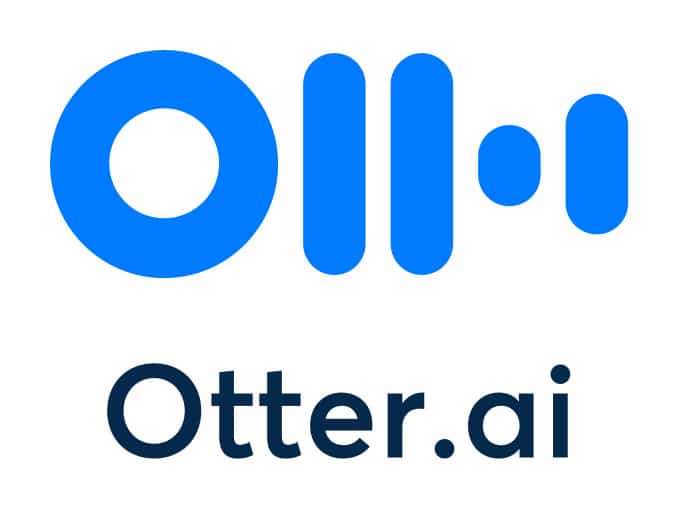
Otter.ai’s innovative AI-powered transcription features redefine real-time engagement within higher education. The capability to transcribe live events, lectures, and discussions empowers both students and educators. Seamless integration with note-taking platforms further enriches the learning experience.
Verbit: Bridging AI and Expertise
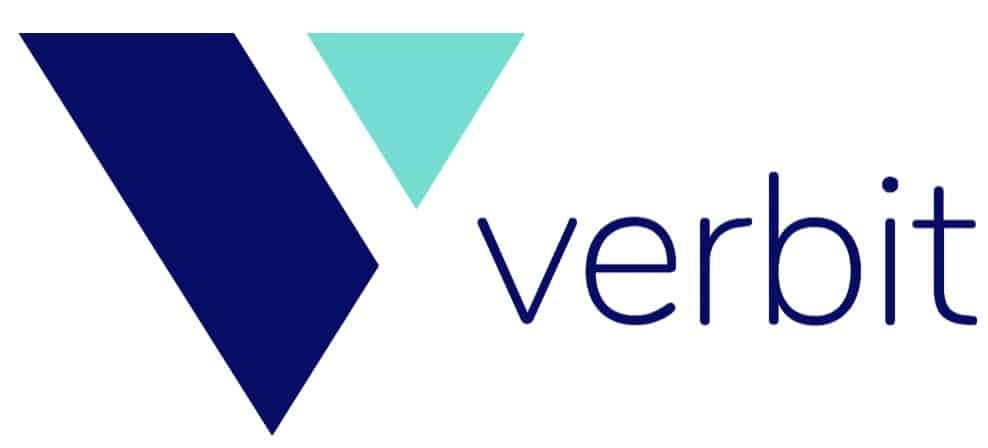
Verbit’s unique blend of AI technology and human transcribers is tailored to the intricate demands of academic content. The fusion of artificial intelligence with specialized domain knowledge ensures the fidelity of subject-specific transcriptions. Universities partnering with Verbit embrace a harmonious balance between technology and expertise.
Cielo24: Championing Accessibility and Inclusion
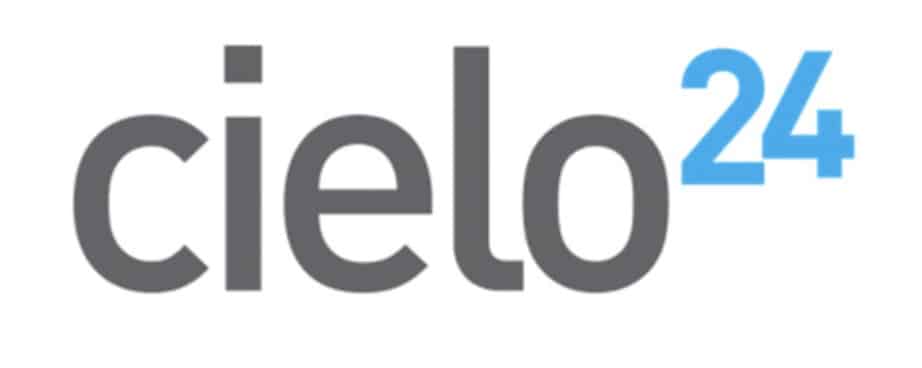
Cielo24’s focus on accessibility and captioning services aligns perfectly with the ethos of higher education. By offering tailored solutions for educational institutions, Cielo24 reinforces the principle of inclusivity. The integration of captions with educational content transcends physical barriers and supports diverse learning needs.
| Tool | Pros | Cons |
|---|---|---|
| Amberscript | – Strong focus on accessibility
– Automated and professional transcription available – Integration with educational platforms | – Turnaround time for human transcription
– Pricing might be on the higher side |
| Rev.com | – High accuracy – Trusted by educational institutions – Human transcription services – Integration options | – Cost may be higher compared to automated services
– Turnaround time for human transcription |
| Otter.ai | – AI-powered real-time transcription
– Integration with note-taking platforms – Efficient for live events | – Accuracy may vary for specialized content
– Limited human review options |
| Verbit | – Combination of AI technology and human transcribers
– Specialized for academic content – High accuracy | – Pricing might be on the higher side
– Limited integration options |
| Cielo24 | – Focus on accessibility and captioning services
– Tailored for educational institutions | – May not offer extensive AI-driven features
– Limited advanced customization |
Transcription Services and Accessibility
Transcription services have become a transformative force in higher education, offering a bridge between spoken content and written accessibility. From empowering students with disabilities to enhancing the learning experience, these services are reshaping academia. Integrating seamlessly with educational platforms, they exemplify the fusion of technology and education. Just as Amberscript’s real-time transcriptions make academic content accessible to everyone, the impact of transcription services in universities is equally far-reaching, promising an inclusive and enriched learning environment.
How to Multiply Your Podcast Audience: Go Beyond Your Native Language and Improve your Growth
In today’s globalized world, the power of the spoken word has transcended international boundaries, thanks to the rise of podcasts. This digital medium has revolutionized the way we consume information, offering a more personalized and engaging alternative to traditional broadcasting. However, while English remains the dominant language in podcasting, an untapped multilingual audience awaits. Could addressing this audience in their language multiply your podcast audience? The answer is yes!
Breaking the language barrier can open doors to a plethora of non-English speaking listeners, thereby expanding your reach and influence. Targeting a multilingual audience is not just about translations; it’s about creating a sense of community and inclusion, offering content that resonates with them culturally, and establishing meaningful connections. This blog post aims to guide you through multiplying your podcast audience beyond your native language. So, let’s embark on this exciting journey to explore the uncharted territories of multilingual podcasting.
Table of contents
- Understanding the Benefits of Multilingual Podcasting
- Steps to Multiply Your Podcast Audience Beyond Your Native Language
- Overcoming Challenges and Tips for Success
- Case Studies: Successful Multilingual Podcasting Examples
- Tools and Resources for Multilingual Podcasting
Understanding the Benefits of Multilingual Podcasting
Before delving into the how-to’s of multilingual podcasting, let’s explore why it’s worth considering.
By going multilingual, you’re essentially unlocking the door to an audience base that far exceeds the English-speaking world. This expansion can dramatically increase your podcast’s reach and impact, and potentially catapult your podcast into global popularity.
Increased Diversity and Inclusivity
Multilingual podcasting invites diversity into your listener community, enriching it with varied cultural perspectives and experiences. This inclusive approach can help your podcast stand out, fostering a sense of belonging and connection among listeners from different linguistic backgrounds.
Opportunities for Collaborations and Partnerships
Embracing languages other than your own opens up a world of collaboration opportunities. From guesting non-English speaking influencers to partnering with foreign language podcasts, these collaborations can boost your podcast’s visibility and credibility in new markets.
Steps to Multiply Your Podcast Audience Beyond Your Native Language
Creating a multilingual podcast might seem daunting, but with strategic planning and implementation, you can effectively grow your audience in your targeted languages. Here are the six steps to aid you in this process.
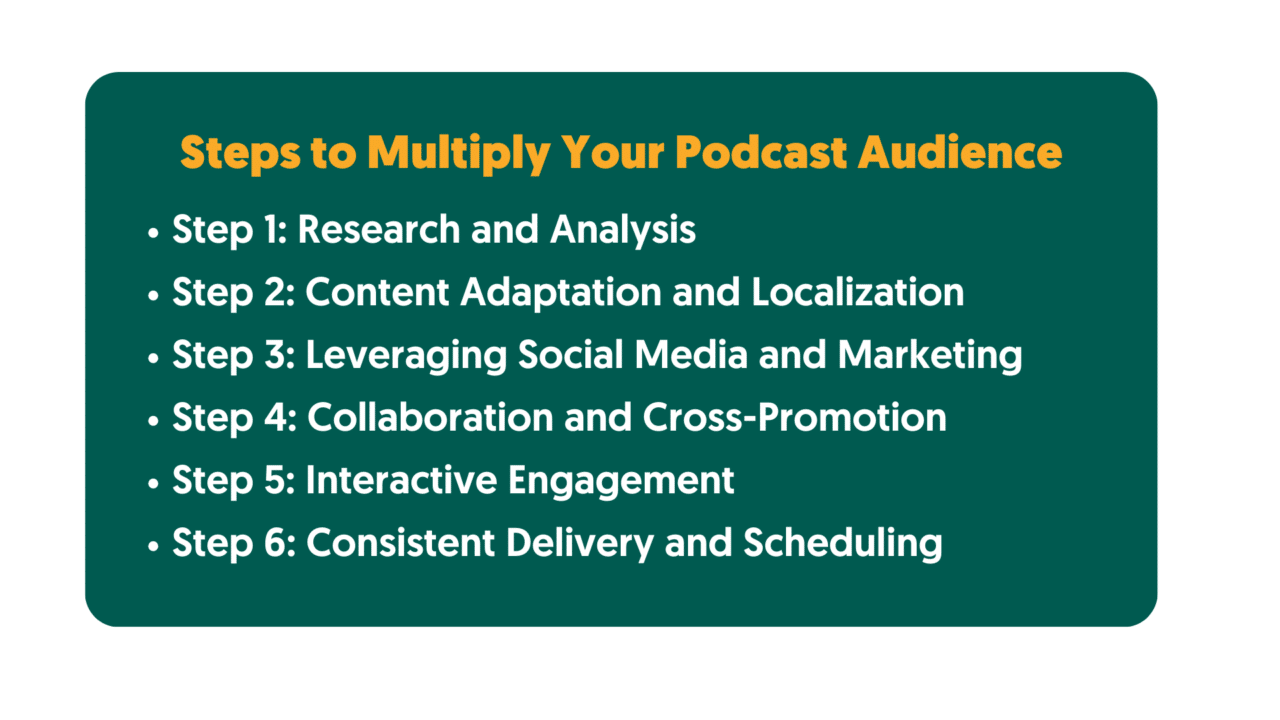
Step 1: Research and Analysis
The first step is to identify which languages to target. You can do this by researching popular podcast languages, countries with high podcast consumption, and the languages spoken by your existing listeners. Understanding the cultural nuances and preferences of your target audience can help tailor your content to their tastes. Cultural insights can also guide your podcast format, theme, and topic choices.
Step 2: Content Adaptation and Localization
Translating your episode titles and descriptions is a crucial step. It not only makes your podcast accessible but also boosts visibility in foreign language search results. Content localization goes beyond literal translation. It involves adapting your content to fit the cultural, societal, and linguistic contexts of your target audience.
Keep an eye on trends and interests popular in the target language community. Incorporating these elements into your episodes can increase your podcast’s relevance and appeal.
Step 3: Leveraging Social Media and Marketing
Promote your podcast in multiple languages across various social media platforms. This will raise awareness and attract potential listeners who speak those languages. You should also consider engaging with communities and influencers who speak your target languages. They can help your podcast gain traction in these new markets. Finally, use relevant hashtags and keywords in your target languages in your social media posts. This will improve your podcast’s visibility and discoverability.
Step 4: Collaboration and Cross-Promotion
Collaborate with local influencers or other podcasters from your targeted language groups. This will expose your podcast to their follower base, increasing your audience. Network and participate in international podcast events and communities. These platforms provide opportunities for exposure and collaborations.
Don’t be scared to make guest appearances on popular foreign podcasts. This can help you tap into their listener base and attract new followers.
Step 5: Interactive Engagement
Create platforms where listeners can engage in their native language. This encourages interaction and fosters a sense of community. Encourage listeners to leave feedback and contribute in their language, as this can provide valuable insights to improve your multilingual podcast. Moreover, hosting live episodes or Q&A sessions in various languages can boost engagement. This also demonstrates your commitment to catering to a diverse audience.
Step 6: Consistent Delivery and Scheduling
Consistency is key in podcasting. Ensure you maintain a reliable podcasting schedule across all languages to keep your audience engaged. Don’t forget to take into account the time zone differences of your audience when releasing your episodes. Timing your release can maximize listenership in different regions!
How can you monetize your podcast?
Find out more now!Overcoming Challenges and Tips for Success
Multilingual podcasting can be a daunting task, and like any venture, it does have its challenges. Here are some common difficulties you might face and some tips on how to overcome them.
Language Barrier
The most obvious challenge is the language barrier. Not everyone is multilingual, and even if you are, there might be nuances in dialects and accents that could cause miscommunication.
Tip: Hire Native Speakers or Use Translation Services
Consider hiring native speakers or using professional translation services. Native speakers can provide accurate translations and offer insights into cultural nuances. Alternatively, there are numerous online translation services that offer high-quality translations at affordable prices.
Quality Consistency Across Different Languages
Ensuring a consistent quality of content across different languages can be difficult to manage. Sometimes, translation can lead to loss of meaning, and cultural differences might make some content irrelevant in certain languages.
Tip: Regular Audits and Feedback Collection
To address this, conduct regular content audits and collect feedback from your listeners. These practices can help ensure that your content remains relevant and engaging across different languages.
Technical Challenges
Producing a podcast in multiple languages can bring about technical complexities. You may need to manage different feeds, and SEO can become a challenge when dealing with multiple languages.
Tip: Use Multilingual Podcast Hosting Platforms
There are several multilingual podcast hosting platforms available that can help manage your different podcast feeds. Also, learning the basics of multilingual SEO can greatly improve your podcast’s visibility across different languages.
Cultural Misunderstanding
When producing content for diverse audiences, there’s always a risk of cultural misunderstanding or offensive content, even if unintentional.
Tip: Cultural Sensitivity and Extensive Research
Ensure you invest time in understanding the culture of your target audience. Extensive research and consultation with cultural experts can help avoid potential cultural misunderstandings.
Remember, the goal of a multilingual podcast is not just to multiply your audience but also to create a global community where everyone feels included and respected. By addressing these challenges head-on and with sensitivity, you can reap the benefits of a truly international podcast.
Case Studies: Successful Multilingual Podcasting Examples
Let’s take a look at some successful multilingual podcasting examples to inspire your journey.
Case 1: Duolingo Spanish Podcast
The Duolingo Spanish Podcast is an excellent example of a podcast that effectively reaches a multilingual audience. Providing captivating stories in easy-to-understand Spanish, the podcast is designed for Spanish learners who want to improve their listening comprehension. The success of this format led Duolingo to develop similar podcasts for other languages.
Case 2: News in Slow French
News in Slow French is a podcast that presents global news in slow, clear French. It’s a great resource for French learners and has been highly successful due to its unique approach in engaging its audience. The creators of News in Slow French have launched similar podcasts in other languages, indicating the success of their multilingual approach.
Case 3: Radiolingua Network
The podcasts from the Radiolingua Network, including the popular Coffee Break Spanish and Coffee Break French series, provide language-learning content in several languages. With a broad range of content, from beginner lessons to advanced courses, these podcasts have garnered a global audience and demonstrate the potential of multilingual podcasting.
These case studies exemplify the power of multilingual podcasting. With the right strategies and commitment to quality, your podcast too can reach audiences far beyond your native language.
Tools and Resources for Multilingual Podcasting
Embarking on the journey of multilingual podcasting is made easier with the right tools and resources. Here are some options you might find useful.
Translation Services
- Google Translate: While not perfect, Google Translate can provide quick translations for less complex text. It’s a good starting point before moving onto more accurate resources.
- Deepl: Deepl is recognized for its superior translation quality. It’s a great tool for translating scripts or episode descriptions.
- Amberscript: Make use of Amberscript’s expert translators and obtain quality translations for your podcast within hours! You can choose from 39 languages and explain your project in depth, so you are sure you get the best service possible.

Receive a custom offer
Tell us about your translation needs
Oops! We could not locate your form.
Podcast Hosting Platforms
- Soundcloud: Soundcloud is a popular podcast hosting platform that supports multiple languages. It’s an excellent tool for distributing your multilingual podcast.
- Libsyn: Another leading podcast hosting platform, Libsyn offers robust features and supports various languages, ideal for a multilingual podcast.
Audio Editing Software
- Audacity: This is a free, open-source audio editing software suitable for both beginners and professionals. It’s available in several languages.
- Adobe Audition: This is a professional-grade audio editing tool. Although paid, it offers comprehensive features and multi-language support.
Transcription Services
If you are looking for the right transcription service, you are in luck: Amberscript can definitely help you! Wether you choose the automatic or professional transcription service, you can rest assured that everything will be taken for for you. When you choose automatic transcription, our cutting-edge AI technology will transcribe your audio and video files quickly and with up to 85% accuracy. Once you get the file back (within minutes, saving you lots of time), you can edit the transcript as much as you want.
If you opt for our human-made service, one of our professional transcribers will meticulously take care of the revision process, assuring up to 100% accuracy for your file. Moreover, Amberscript’s user-friendly platform makes the entire process seamless, from uploading files to receiving the final transcripts. With the blend of automation and human expertise, Amberscript truly offers a comprehensive transcription solution that caters to diverse transcription needs, making it the top choice in the industry.
In conclusion, these tools and resources can significantly aid in your multilingual podcasting journey by offering services that help you produce, manage, and distribute your podcast in various languages.
Embarking on the multilingual podcasting journey can be an enriching experience that goes beyond merely expanding your audience. It enables you to connect with different cultures, learn new perspectives, and truly create a global community through your content. Remember, the challenges are surmountable with the right strategies, tools, and resources. Don’t let language boundaries limit the reach of your podcast.
Call to Action: Start Your Multilingual Podcast Today
It’s time to take your podcast beyond your native language. Start today! Whether you’re just starting out or already have an established podcast, there are resources available to assist you. Make use of the tools and strategies discussed in this post, learn from successful multilingual podcast examples, and begin to multiply your audience. Don’t forget to share your experiences and successes with us. We can’t wait to see how far your podcast will go!
How to Monetize Your Podcast?
Table of contents
- Establishing a Strong Foundation
- Growing Your Audience
- Monetization Strategies
- Implementing Monetization Strategies
- Scaling and Long-Term Success
Establishing a Strong Foundation
To begin with, successful podcast monetization starts with building a strong foundation. Here’s how to do it:
Step 1: Define Your Niche and Target Audience:
Start by choosing a topic or niche that resonates with your interests and aligns with the needs of your targeted listeners. The more specific your niche, the easier it will be to attract a dedicated audience and potential sponsors interested in your content.
Stop 2: Create High-Quality Content:
Invest in good recording equipment and prioritize sound editing and production to deliver professional-quality episodes. Remember, content is king. The better you sound, the more likely listeners are to stick around and recommend you to others.
Step 3: Build a Consistent Publishing Schedule:
Keep your audience engaged and attract new listeners by regularly releasing new episodes. Consistency is key to building a loyal listener base.
Step 4: Develop a Brand Identity:
Establish your brand by creating a distinct logo, cover art, and name. Your brand identity should efficiently convey your podcast’s tone and content, thereby making it instantly recognizable to your audience.
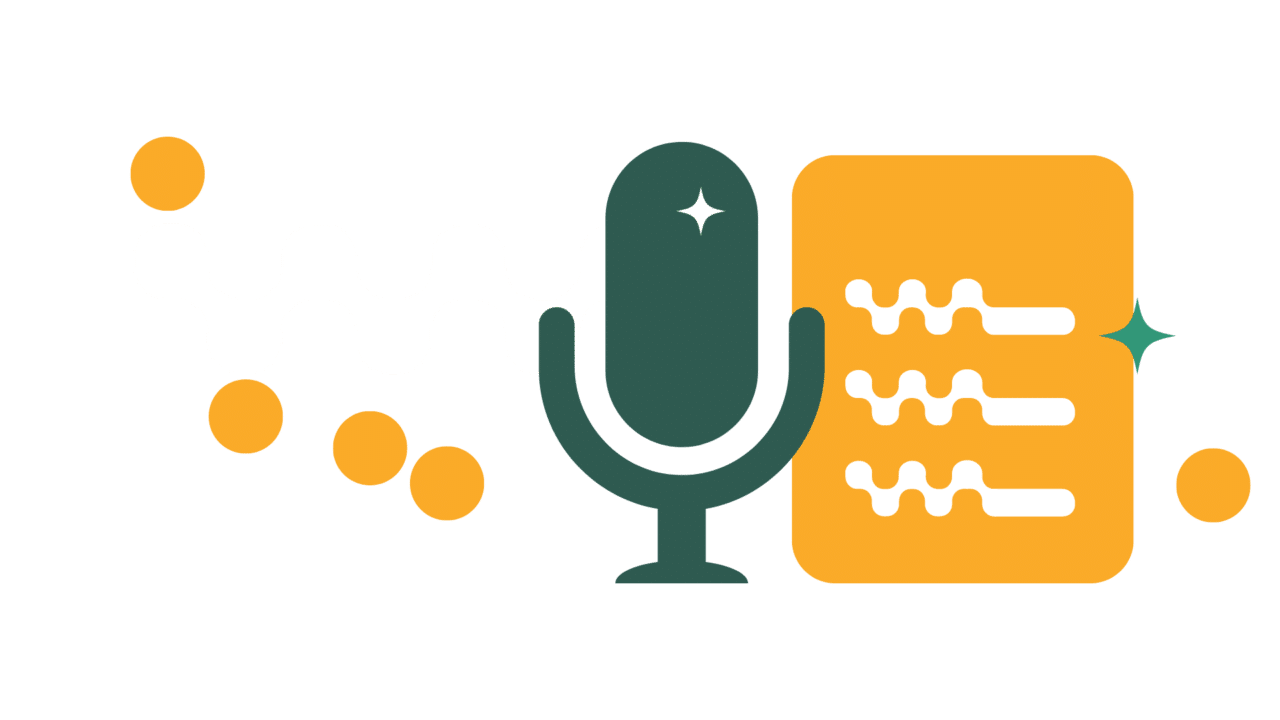
Growing Your Podcast Audience
Once a strong foundation is laid, the next step is to grow your listener base. Here’s how you can accomplish it:
- Utilize Social Media Platforms: Promote your podcast on popular social media platforms such as Instagram, Twitter, and Facebook. This will allow you to reach a wider audience and increase your visibility.
- Collaborate with Influencers and Guests: Consider inviting guests who are relevant to your niche. This not only provides variety in your content but also allows you to leverage their audience to expand your listener base.
- Engage with Your Audience: Encourage listeners to provide feedback, and respond to their comments and reviews. This interaction builds a sense of community and helps to foster a loyal listener base.
Monetization Strategies
After establishing a firm foundation and growing your audience, it’s time to start thinking about how to generate income from your podcast. Here are some effective monetization strategies:
- Sponsorships and Advertisements: Pair up with brands that align with your contents’ theme and audience. These partnerships can lead to sponsored segments or ad spots within your podcast episodes. Make sure the ads are relevant and valuable to your listeners to maintain their trust.
- Listener Support and Donations: Platforms like Patreon or Buy Me a Coffee offer a way for listeners to support your podcast monetarily. This can be a direct and effective way to earn some income, especially if you have a highly engaged audience.
- Premium Content and Subscriptions: Offer exclusive episodes, early access, or bonus content to premium subscribers. Using platforms like Patreon or Supercast, you can provide additional value to dedicated listeners willing to pay a little extra.
- Merchandise and E-commerce: Sell branded merchandise. This can include anything from t-shirts and mugs to keychains and posters. It’s a great way to monetize your podcast and promote it at the same time.
- Live Shows and Events: Host live recordings or other virtual events and charge admission fees. This not only brings in income but also helps to strengthen your community of listeners.
Implementing Monetization Strategies
The effective implementation of your chosen monetization strategies can make a significant difference in your podcast’s income. Not all monetization strategies will work for every podcast. Evaluate your podcast’s theme, your audience’s preferences, and your personal goals to choose the most suitable strategies. It might be beneficial to test different methods to see what resonates best with your audience.
When introducing monetization, make sure to communicate this to your audience clearly. Your listeners will appreciate honesty and transparency. This can help maintain trust and even encourage loyal listeners to contribute towards your podcast monetarily. Regardless of the monetization strategies you choose, never compromise the quality of your content. Remember, your listeners tune in for your content first. Any monetization should add to their listening experience, not detract from it.
Everything you need to know out creating a successful podcast.
Find out more now!When pursuing sponsorships and advertisements, ensure that the brands align with your podcast’s theme and values. This will increase the chances of your audience finding value in these partnerships, which can be beneficial for both you and the sponsoring brand.
When implementing listener support and donations, remember to provide value back to your supporters. This could be in the form of exclusive content, shout-outs during episodes, or branded merchandise.
Use analytics to assess the effectiveness of different monetization strategies and adjust accordingly. These insights can guide you in making informed decisions about what’s working and what needs improvement.
Scaling and Long-Term Success
With your podcast growing and generating income, the next stage is scaling and ensuring long-term success. Here’s how to go about it:
- As your podcast begins to generate income, consider reinvesting some of this back into improving your production quality, marketing efforts, or even hiring help. This can help streamline your workflow and improve your podcast overall.
- Consider branching out with your content. This could mean starting a new podcast series, exploring different topics or formats, or creating additional related content like blog posts or videos. This diversification can help reach a broader audience and create new income streams.
- Form strategic partnerships with other podcasters, influencers, or organizations in your niche. These partnerships can lead to guest appearances, cross-promotions, or other collaborative efforts that can grow your audience and enhance your brand’s reputation.
- Never stop engaging with your audience. Regularly solicit feedback, interact with listeners on social media, and make an effort to include your community in your podcast. This ongoing engagement helps maintain a loyal listener base and can lead to organic growth through word-of-mouth referrals.
- Stay updated with the latest trends in podcasting and digital media. Adapting to changes and staying current will keep your content fresh and relevant, ensuring your podcast’s long-term sustainability.
As your podcast grows and evolves, your monetization strategies may need to adapt as well. Regularly review your income streams and adjust as necessary to optimize your revenue. Remember, what works for one stage of your podcast might not work for another. Always be ready to experiment and evolve.
Podcasting can be a rewarding endeavor, both personally and financially. However, the path to monetization requires strategic planning and careful implementation. Whether it’s through sponsorships, listener donations, premium content, e-commerce, or live events, the key lies in choosing the right strategies that resonate with your audience and align with your podcast’s theme. Remember, trust and transparency with your audience are paramount, and quality content should always be at the forefront. With continuous engagement, monitoring, and adaptation, your podcast can achieve substantial growth and sustainable income. So, get out there, let your voice be heard, and turn your passion for podcasting into a profitable venture!
Podcasting Success Secrets: What It Takes to Make a Great Show
Podcasting has experienced an unparalleled boom in recent years. What was once a niche medium has exploded into mainstream popularity, cementing itself as a crucial channel for storytelling, education, engagement, and connection. This rapid proliferation of podcasts has made it more important than ever to create a show that stands out, resonates with listeners, and delivers consistent value.
This guide aims to shed light on the key elements that contribute to the success of a podcast. It offers in-depth insights into a range of critical topics, from finding your podcasting niche and crafting compelling content to mastering the technical aspects and growing your audience. Whether you’re a seasoned podcaster or an eager newbie, this guide has something for you. Let’s unravel the secrets to podcasting success and discover what it truly takes to create a great show.
Table of Contents
- Finding Your Podcasting Niche
- Crafting Compelling Content
- Pre-production Essentials
- Technical Aspects of Podcasting
- The Art of Interviewing
- Editing and Post-production
- Creating Eye-catching Cover Art and Branding
- Publishing and Distribution
- Growing Your Audience
- Analyzing and Adapting
- Monetization and Long-term Success
Finding Your Podcasting Niche
Your podcasting journey begins with identifying a niche – a specific area of interest where your passion and expertise resonate. This is a crucial step as it helps position your podcast uniquely in the crowded podcasting landscape.
The first step is to recognize where your passion lies and what subjects you have expertise in. You should feel excited and knowledgeable about the topic of your podcast, as this enthusiasm will translate into engaging content for your listeners. Be it technology, storytelling, wellness, or any other field – your passion is the fuel for your podcast engine.
Once you’ve identified your passion and expertise, it’s essential to research market trends and audience demand. Understanding what listeners are interested in and how other podcasts in your niche fare can provide valuable insights into content strategy and positioning.
After identifying potential areas and doing your research, it’s time to narrow down your niche. Focusing on a very specific subset of your broader area of interest can help in creating content that has depth and appeal to a dedicated audience. It reduces competition and allows you to be the go-to source for that particular topic.
Remember, a well-defined niche is a cornerstone of a successful podcast. It sets the foundation for your content, audience connection, and overall podcast direction. It’s not just about creating a podcast; it’s about creating the right podcast for the right audience.
Crafting Compelling Content
Creating irresistible content is at the heart of podcasting success. It is your way of providing value, establishing authority, and building a loyal listener base. The structure, engagement, and authenticity of your podcast are crucial to captivating your audience and keeping them coming back for more.
The format and structure of your podcast play a significant role in its overall appeal. This might involve choosing between a solo, co-hosted, or interview-based format, or even a blend of these. The structure refers to how each episode is laid out – from introductions and main content segments to wrap-ups and CTAs. A well-defined format and structure provide consistency, making it easier for listeners to follow and understand your content.
Planning Engaging Episodes and Story Arcs
Engaging content is more than just presenting facts; it’s about telling stories that captivate your audience. Plan your episodes around compelling story arcs or themes that build anticipation and maintain interest throughout. This could involve creating multi-episode series, exploring different perspectives on a topic, or having a narrative thread that weaves through your episodes.
Balancing Information, Entertainment, and Authenticity
A successful podcast strikes a balance between informative, entertaining, and authentic content. While your podcast should provide value and educate your audience, it should also entertain and engage them. Integrating humor, anecdotes, or unique insights can add a layer of entertainment. Most importantly, be authentic. Authenticity creates a genuine connection with your listeners and sets you apart in the podcasting world.
Remember, your podcast should evolve with your audience. Keep listening, learning, and adapting to keep your content fresh, relevant, and engaging. Your podcast is a reflection of your passion and purpose – let it shine brightly in every episode.
Learn more about Creating Engaging Podcasts
Read the blogPre-production Essentials
Prior to hitting the record button, an essential phase of podcasting lies in the pre-production work. It’s about setting the stage for smooth recording and production processes.
Outlining Episode Content
An episode outline is a blueprint for your podcast episode. It includes key points, questions, and potential directions the episode might take. This doesn’t mean scripting every word, but having a structured layout helps keep the discussion on track and ensures you cover all the topics you intend to.
Gathering and Organizing Your Resources
Whether it’s research materials, interview questions, or sound effects, gathering and organizing these resources beforehand can streamline your recording process. It ensures you have everything you need at your fingertips, reducing the risk of interruptions during recording.
Scheduling Recording Times
Recording a podcast isn’t a quick process; it requires time and attention. Scheduling specific recording times can help maintain consistency, improve productivity, and allow for buffer time for unforeseen issues or delays.
Setting Up Your Recording Environment
The quality of your recording is significantly impacted by the environment you record in. A quiet, echo-free room can make a considerable difference in sound quality. So, take time to set up your recording environment, considering factors like acoustics, background noise, and potential interruptions.
Pre-production is all about preparing and organizing. Investing time in this stage can save you hours of editing and re-recording later, leading to a more efficient, enjoyable, and successful podcasting process. Remember, preparation is key to podcasting success.
Technical Aspects of Podcasting
Mastering the technical side of podcasting is key to delivering a high-quality listening experience. It involves understanding recording, audio editing, and podcast hosting and distribution.
The quality of your podcast heavily depends on the equipment you use. This includes a good quality microphone, headphones, and potentially a pop filter. You don’t need to break the bank for this equipment, as many affordable options deliver excellent results. Remember, clear and crisp audio is crucial in podcasting.
Learning Basic Audio Editing
Editing your podcast is where you fine-tune your content and audio quality. It’s where you can remove unwanted noises, awkward pauses, or irrelevant sections, ensuring your content is as engaging and polished as possible. There are several user-friendly editing software options available with tutorials that can guide you through this process.
Understanding Podcast Hosting
A podcast host is where your podcast files live online. It’s the home base for your podcast and where you’ll publish your episodes. When choosing a hosting platform, consider factors like cost, storage limits, and distribution capabilities.
Distributing Your Podcast
Once your episodes are ready and hosted, it’s time for distribution. This involves submitting your podcast to directories like Apple Podcasts, Spotify, and Google Podcasts. Each platform has different requirements for submission, so it’s essential to familiarize yourself with these.
The technical aspects may seem daunting, but with the right tools and a bit of patience, they are manageable. Focus on learning one aspect at a time and remember, you don’t have to be a technical whiz to run a successful podcast. The key is to start simple and upgrade or adapt as your show grows.
The Art of Interviewing
Quality interviews are at the heart of many successful podcasts. They provide insightful, diverse content that engages and educates listeners. However, conducting a stellar interview requires preparation, active listening, and follow-up.
Preparation is key to conducting an effective interview. This involves researching your guest, their expertise, and recent work. It’s about understanding and anticipating what your audience would be interested in learning from this guest. Preparation also includes creating a list of potential questions, but be prepared to deviate from this list based on the flow of the conversation.
During the interview, your role is to guide the conversation in a way that provides value to your listeners. Listen actively to your guest’s responses and ask follow-up questions that dive deeper into the discussion. Remember to create a comfortable and respectful environment that encourages open and honest exchanges.
After the interview, take the time to review and reflect on the conversation. Consider if there are any areas that require clarification or further exploration in future episodes. Finally, don’t forget to thank your guest for their time and contribution.
Mastering the art of interviewing can significantly enhance the value and appeal of your podcast. It’s about creating meaningful conversations that resonate with your listeners and leave them eagerly awaiting your next episode.
Editing and Post-Production
The post-production process is where your podcast truly comes to life. It involves editing the audio, adding music or sound effects, and polishing the final product.
Audio Editing
Audio editing is a crucial part of creating an engaging, professional-sounding podcast. This stage involves cutting unnecessary content, removing distracting noises, and ensuring a consistent volume level for a seamless listening experience. Utilize editing software that suits your skill level, from beginner-friendly options to more advanced professional tools.
Adding Music and Sound Effects
Music and sound effects can significantly enhance the mood and tone of your podcast and keep your listeners engaged. Whether it’s an energetic intro tune, a dramatic sound effect, or a calming outro, these elements can elevate your podcast’s production value. Always ensure you have the rights to use these sounds to avoid any copyright issues.
Final Touches and Exporting
Once you’ve edited your audio and added any desired music or sound effects, it’s time for the final touches. This might include adding a voiceover for your intro and outro or editing your podcast’s metadata (like the episode title, description, and artwork). After all the final touches, export your episode in a podcast-friendly format, typically MP3.
Post-production requires time and attention to detail but it’s a critical stage in creating a high-quality podcast. With practice, you’ll become more efficient and develop an editing process that works for you. Remember, polishing your podcast in the post-production phase can distinguish your show in a sea of podcasts and keep your listeners coming back for more.

Why is Podcasting a Good Way to Share Your Expertise?
Find out now!Creating Eye-catching Cover Art and Branding
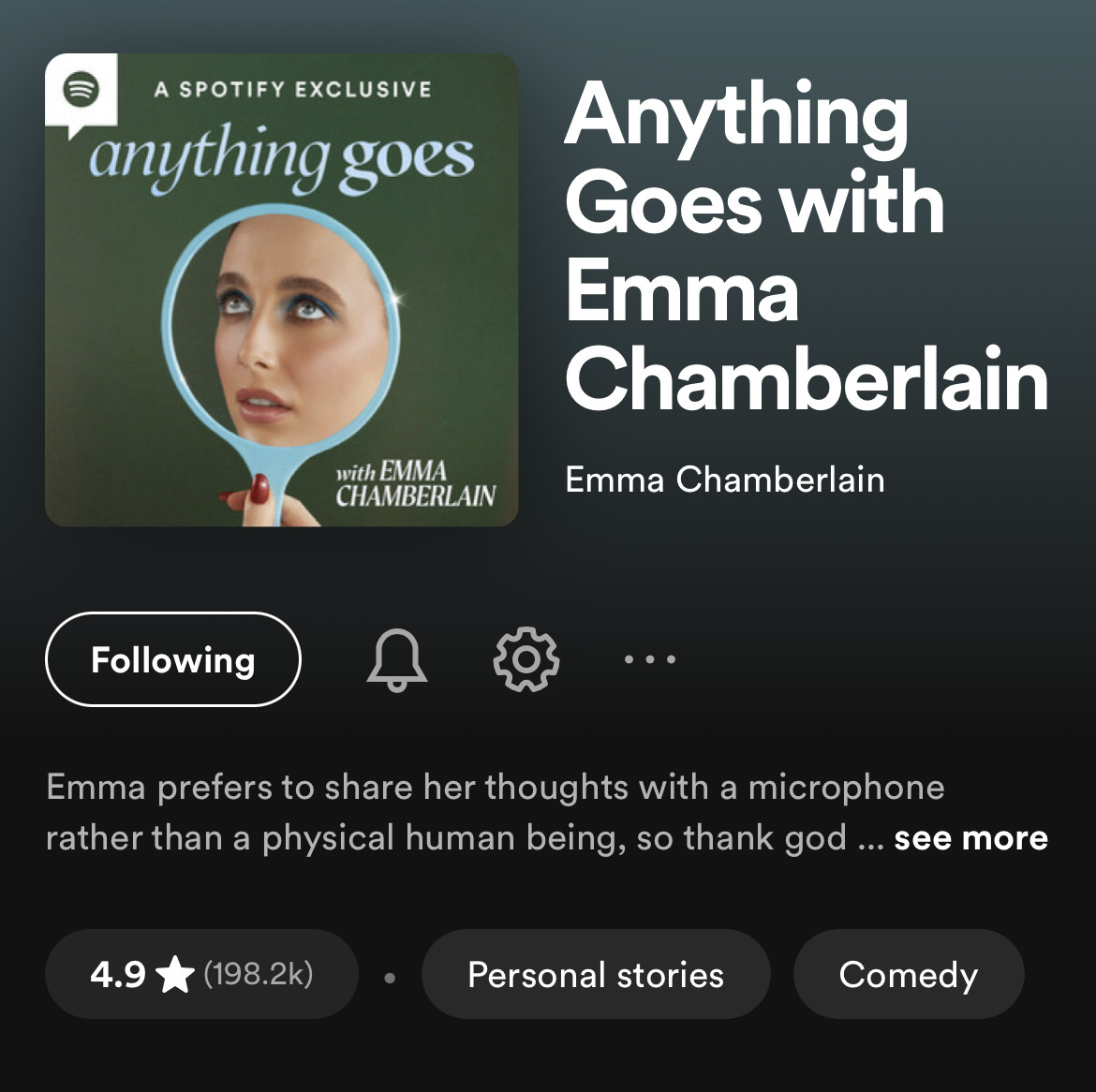
A compelling podcast is not just about the content and sound quality; the visual elements are equally paramount. Your podcast’s cover art and overall branding are the first elements potential listeners see, and it can significantly influence their decision to listen or not.
Designing Your Podcast Cover Art
Your podcast cover art should be striking, relevant, and communicate the essence of your show at a glance. While it’s important to incorporate your personal style and color scheme, make sure your podcast title is clear and legible even in small thumbnail size. Platforms like Apple Podcasts and Spotify have specific requirements for cover art dimensions and resolution, so be sure to meet those standards.
Developing Your Podcast Branding
Beyond the cover art, consider other visual components that form your podcast’s branding. This includes your podcast logo, website design, social media graphics, and merchandise if applicable. Consistency in your visual identity across different platforms helps establish your brand and makes your podcast instantly recognizable.
Utilizing Design Tools and Professional Services
You can create your design using user-friendly applications like Canva, or if you have some graphic design skills, Adobe Photoshop or Illustrator. Alternately, hire a professional designer if budget allows. They can help you create a unique and professional design that truly stands out.
Never underestimate the power of quality cover art and branding. A visually appealing and consistent brand can attract new listeners, keep your audience engaged, and create a memorable identity for your podcast. It’s worth investing time and resources to get it right.
Publishing and Distribution
Once your podcast episode is fully produced and polished, it’s time to share it with the world. Publishing and distributing your podcast effectively is crucial to reaching your target audience and growing your listener base.
Step 1: Choosing the right podcast host. Your host not only stores and delivers your podcast files but also provides essential tools for publishing, analytics, and distribution. Look for a host with reliable uptime, robust analytics, and easy integration with podcast directories.
Step 2: Submitting to Podcast Directories. To ensure your podcast reaches the widest possible audience, you need to submit it to popular podcast directories like Apple Podcasts, Spotify, Google Podcasts, and others. Each directory has its own submission process and requirements, so be sure to familiarize yourself with these guidelines.
Step 3: Promoting Your Podcast. Promoting your podcast involves sharing it across various channels like your website, social media platforms, email newsletters, and more. Consider creating engaging promotional materials like audiograms, quote graphics, or teaser videos. Engage with your audience, respond to comments, and consider collaborating with other podcasters or influencers in your niche for cross-promotion.
Step 4: Monitoring Your Podcast Performance. Lastly, keep a close eye on your podcast analytics. Understanding how your podcast performs can help you refine your content strategy, improve listener engagement, and attract advertisers. Pay attention to metrics like total downloads, listener geography, listening platforms, and audience retention rates.
Publishing and distributing your podcast effectively is a key part of your podcasting journey. With the right strategies and tools, you can reach your target audience, grow your listenership, and create a successful podcast.
Growing Your Audience
Growing your podcast audience doesn’t happen overnight; it requires patience, consistency, and strategic planning. Here are some proven strategies to help you increase your listenership.
- High-quality content: First and foremost, focus on producing high-quality content. Create content that is valuable, engaging, and unique to your podcast. Understand your audience’s needs and interests and plan your episodes around those topics. Remember, the more value you provide, the more likely your listeners will recommend your podcast to others.
- Consistent Posting Schedule: Consistency is key in podcasting. Stick to a regular posting schedule, whether it’s daily, weekly, or monthly. Consistency not only helps retain your current listeners but also attracts new ones as they can rely on your podcast for regular content.
- Collaboration and Cross-Promotion: Collaborate with other podcasters or influencers in your niche. Guest appearances, shout-outs, or joint episodes can introduce your podcast to a new audience. Similarly, promote other podcasts on your show, they might return the favor.
- Engaging with Listeners: Engage with your listeners both on and off the air. Respond to comments and messages, ask for feedback, and involve your listeners in your podcast, maybe by answering their questions in episodes or featuring listener stories. An engaged audience is more likely to share your podcast with their network.
- SEO for Podcasts: Optimizing your podcast for search engines can significantly increase your visibility. Incorporate relevant keywords in your podcast title, description, and episode show notes. Furthermore, consider adding subtitles to your content, as this will help your podcast appear in relevant search results, attracting more listeners. Using Amberscript subtitling services, you can obtain accurate subtitles in a blink of an eye.
- Paid Advertising: If your budget allows, consider paid advertising. Platforms like Facebook, Instagram, and Google AdWords can help your podcast reach a larger audience. However, ensure you’re targeting the right demographics to get the best return on your investment.
Remember, growing your audience is a slow and steady process. It might take some time for you to see substantial growth, but with persistence and the right strategies, you can increase your listenership and make your podcast a success.
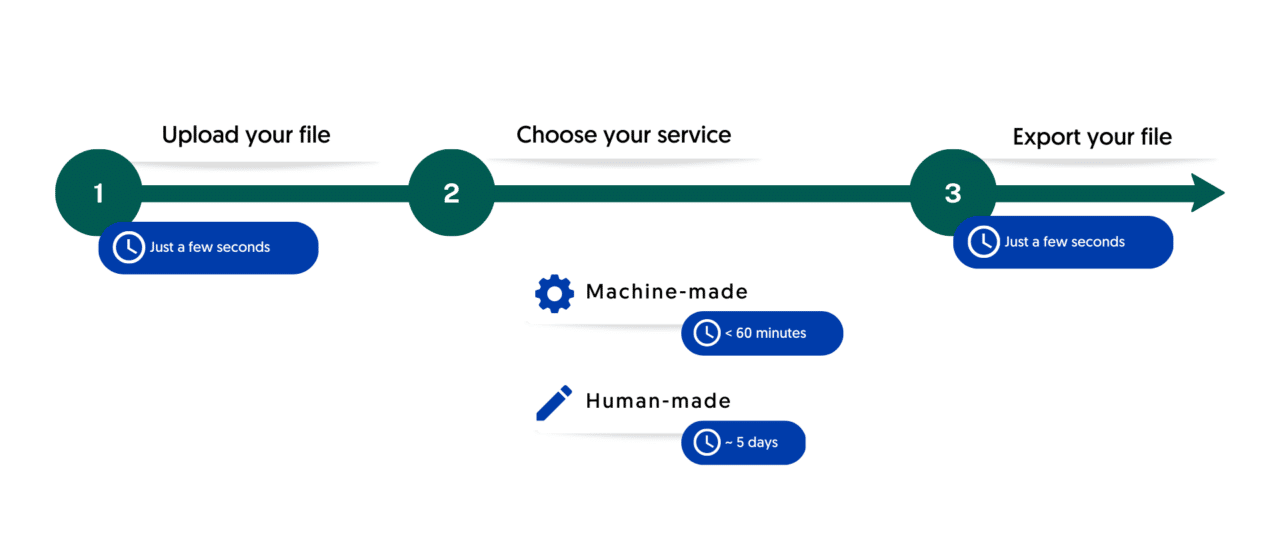
Analyzing and Adapting
The process of podcasting is a dynamic journey that demands continuous analysis and adaptation. Your podcast’s success lies not just in producing great content, but also in reviewing its performance and making necessary adjustments.
Most podcast hosting providers offer analytical tools to track your podcast’s performance. These metrics provide insights into total downloads, listener demographics, episode completion rates, and other key measurements. Reviewing these analytics helps understand what’s working and what can be improved.
Don’t forget that your listeners are an invaluable source of feedback. Pay attention to their comments, emails, and social media interactions. They can offer direct insight into what they love about your podcast and what they wish was different. Always consider their feedback when planning and producing future episodes, and make sure you implement the necessary changes.
Tracking the Impact of Changes
After you’ve made some changes, monitor your analytics and audience feedback to gauge the impact. It can take some time for the effects to become apparent, so be patient. If you see positive results, you’ll know you’re on the right track. If not, don’t be discouraged; just keep analyzing, adapting, and improving.
In podcasting, the cycle of creating, analyzing, adapting, and improving is ongoing. It’s this continuous evolution that keeps your podcast fresh, relevant, and increasingly successful.
Monetization and Long-Term Success
Achieving financial success with your podcast is an aspect that cannot be overlooked. Monetization not only helps to cover production costs, but it also allows you to reinvest in your podcast, improving its quality and reach.
One of the most common ways to monetize a podcast is through sponsorships and advertisements. Brands are always on the lookout for effective channels to reach their target audience, and a podcast with a loyal listener base can be just that. You can offer pre-roll, mid-roll, or post-roll slots in your episodes for advertisements. Ensure the brands you partner with align with your podcast’s theme and audience interests.
Another source of revenue could be your listeners themselves. Platforms like Patreon or Kickstarter allow podcasters to accept donations or run crowdfunding campaigns. In return, you can offer exclusive content, merchandise, shout-outs, or any other perks to your donors.
Implementing a subscription-based model is another effective way to monetize your podcast. You can offer ad-free episodes, early access to episodes, exclusive content, or other perks to your subscribers. Be creative in your offerings and ensure they add value to your listeners.
finally, if your podcast has a strong brand identity and a loyal fan base, selling merchandise can be a viable revenue stream. T-shirts, mugs, stickers, or any other items with your podcast logo or catchphrases can be popular among your listeners.
Monetization is a crucial component of long-term podcasting success, but remember, your listeners are your most valuable asset. Keep their interests and preferences in mind when implementing any monetization strategy. After all, a satisfied and loyal audience is the key to a successful and profitable podcast.

Get a customized offer
Request a quote for your subtitling needs
Podcasting is an art and science, a delicate balance of creativity and strategic thinking. It’s a journey, not a destination, and success in podcasting requires patience, persistence, and adaptability. It’s about producing compelling content, fostering a connection with your audience, constantly analyzing and improving, and smartly monetizing your efforts. Remember, every successful podcast started with a single episode. What matters is not where you start, but how much you grow along the way. So don’t be daunted by the challenges, embrace them as opportunities. Your podcasting journey begins here, and remember, the only way to create a great show is to start podcasting. The world needs your voice. Happy podcasting!
Subtitling in the Newsroom: a Guideline with Best Tips
Table of Content
- Importance of subtitling for news content
- Different types of news content that benefit from subtitling
- The role of subtitling in enhancing accessibility and inclusivity
- Guidelines for Subtitling in the Newsroom
- Best Tips for Subtitling in the Newsroom
- Using Automated Tools and Technology
- Encouragement for newsrooms to invest in quality subtitling for better audience engagement and inclusivity
Importance of subtitling for news content
In today’s fast-paced and interconnected world, newsrooms play a pivotal role in shaping public opinion and disseminating critical information.
As digital media continues to dominate the landscape, news consumption habits have evolved, and audiences now expect access to news content across various platforms and devices. Among the diverse methods employed to engage audiences effectively, subtitling has emerged as an indispensable tool in the newsroom arsenal. Subtitling not only enhances the accessibility of news content for viewers with hearing impairments but also caters to a global audience, breaking language barriers and promoting inclusivity.
In this blog post, we delve into the paramount importance of subtitling for news content, exploring how it not only reaches a wider audience but also significantly improves viewer engagement and understanding of crucial news stories.
Different types of news content that benefit from subtitling
Different types of news content greatly benefit from subtitling, ensuring wider audience reach and comprehension.
Live broadcasts, such as press conferences and breaking news events, often feature rapid speech and multiple speakers, making subtitles invaluable in delivering accurate information. Interviews with people speaking different languages can also be effectively conveyed to a diverse audience through translated subtitles. News documentaries and investigative reports rely on subtitling to present intricate details and maintain viewer interest.
Overall, subtitling serves as a vital tool in making news content accessible, inclusive, and engaging for diverse audiences across various platforms.
The role of subtitling in enhancing accessibility and inclusivity
The role of subtitling in enhancing accessibility and inclusivity cannot be overstated. Subtitles are a powerful tool that breaks down communication barriers for individuals with hearing impairments, making news content accessible to the deaf and hard-of-hearing communities. By providing written text of spoken dialogue and sounds, subtitling ensures that important information is not lost solely through auditory channels.
Moreover, subtitling plays a crucial role in fostering inclusivity by making news content available to a broader audience regardless of their language proficiency. Newsrooms can use subtitles to translate content into various languages, enabling international viewers to engage with news stories in their native tongues.
Beyond catering to those with specific needs or language preferences, subtitling also benefits viewers in noisy environments or situations where audio cannot be played. It allows people to follow news updates without disrupting their surroundings, thereby promoting convenience and flexibility in consuming news content.
Guidelines for Subtitling in the Newsroom
Guidelines for Subtitling in the Newsroom ensure that subtitles effectively convey information while maintaining accuracy and clarity. Verbatim vs. clean (edited) subtitles are chosen based on the content’s complexity, with a focus on retaining key information. Proper grammar, punctuation, and avoiding errors are paramount to prevent misinterpretations.
- Timing and synchronization demand aligning subtitles with spoken words, allowing viewers to follow seamlessly. For on-screen readability, suitable timing is crucial, especially in fast-paced news clips. Addressing rapid speech and multiple speakers requires strategic subtitle duration management.
- Contextual adaptation involves understanding cultural nuances and adapting technical terms to suit the audience. Humor, idioms, and wordplay must be accurately translated to preserve intended meanings.
- Consistency and formatting maintain a professional look. Style and formatting should be uniform, adhering to newsroom branding guidelines. Proper fonts, colors, and backgrounds ensure subtitles are legible and in line with the newsroom’s visual identity.
By following these guidelines, newsrooms can create subtitles that enhance viewer comprehension, accessibility, and overall engagement with news content.
Best Tips for Subtitling in the Newsroom
- Quality control and review are essential: proofreading and editing ensure accuracy before publishing. Internal reviews involving team members enhance compliance and accuracy, while seeking audience feedback provides valuable insights for improvement.
- Leveraging automated tools and technology streamlines the subtitling process. AI-powered tools offer benefits like speed and consistency, but human oversight is crucial to rectify potential errors and nuances that automated systems might miss.
- Adapting subtitles for different platforms is crucial. Customization for TV broadcasts, websites, and social media optimizes viewing experiences. Adhering to character limitations on various platforms ensures subtitles fit seamlessly.
- For live subtitling, employing skilled stenographers or subtitlers is vital. Techniques for real-time subtitling during live broadcasts involve rapid typing and quick decision-making to ensure accurate, timely subtitles.
By incorporating these best tips, newsrooms can produce subtitles that enhance accessibility, comprehension, and engagement, contributing to an informed and satisfied audience.

Learn more about Subtitling in a newsroom
Read the blogUsing Automated Tools and Technology
Using Automated Tools and Technology revolutionizes the subtitling process, providing efficiency and consistency. AI-powered subtitling tools like Amberscript offer the advantage of faster turnaround times, making them ideal for delivering timely news updates. These tools can transcribe spoken content and generate subtitles quickly, reducing manual effort.
Automated subtitling, however, requires caution. Complex linguistic nuances, cultural references, and technical terms might be misinterpreted by automated systems. Therefore, human oversight remains crucial to ensure accuracy and prevent errors. Skilled human-subtitlers can review and adjust the automated output, guaranteeing high-quality and contextually appropriate subtitles.
The combination of automation and human expertise results in a potent subtitling approach. It not only expedites the subtitling process but also maintains the integrity of the content, catering to both speed and accuracy requirements in the dynamic newsroom environment.

Request a quote
Amberscript presents a versatile platform that caters to various subtitling needs. With its advanced AI technology, the tool excels at swiftly transcribing spoken content, generating accurate automatic subtitles promptly. This capability is particularly valuable for quickly sharing breaking news or brief updates.
Amberscript offers a seamless experience – users can effortlessly upload audio or video files, receiving rapid automated transcripts. Moreover, what sets Amberscript apart is its recognition of the importance of precision and nuance. For more intricate or professional content, the tool enables the option of human subtitles for more refined and exact subtitles for heavy or very important content. This combination of automated efficiency and the inclusion of human oversight ensures not only speed but also a high standard of accuracy and contextual appropriateness.
Start using Amberscript now, as a powerful asset for your newsrooms seeking to streamline the subtitling process while upholding the quality demanded by comprehensive news coverage.
Encouragement for newsrooms to invest in quality subtitling for better audience engagement and inclusivity
In the ever-evolving landscape of news consumption, investing in quality subtitling emerges as a pivotal step for newsrooms to bolster audience engagement and foster inclusivity.
The impact of accessible content cannot be overstated; by incorporating subtitles, newsrooms ensure that their stories reach a broader spectrum of viewers, transcending linguistic and auditory barriers.
As news content continues to be consumed across diverse platforms, the presence of well-crafted subtitles enhances the viewer experience, making it convenient to stay informed even in noisy environments or situations where audio playback is limited. Beyond accessibility, subtitling imparts a professional touch, underscoring a newsroom’s commitment to delivering comprehensive and understandable information. By embracing subtitling with dedication and care, newsrooms reflect their responsiveness to the needs of modern audiences and their dedication to fostering a media environment that is truly inclusive, informative, and impactful.
How to Create Subtitles and Closed Captions Using a VTT File
In today’s digital age, video content has become a dominant force in communication and entertainment. As content creators, it is crucial to make our videos accessible to a broader audience, including those with hearing impairments or those who prefer subtitles. Subtitles and closed captions provide an inclusive and engaging experience for viewers, making the content accessible to a diverse audience.
Amberscript emerges as a powerful tool for creating accurate and efficient subtitles and closed captions. In this blog post, we will delve into the process of using Amberscript to generate VTT (Web Video Text Tracks) files for captions and subtitles, exploring the advantages and features that make it an invaluable asset for content creators.
Table of Contents
- Understanding VTT Files
- Getting Started with Amberscript
- Automatic Captioning with Amberscript
- Manual Captioning and Subtitling with Amberscript
- Advanced Editing Features
- Exporting VTT Files from Amberscript
- Final Thoughts
Understanding VTT Files
VTT files, or Web Video Text Tracks, are a format used to store captions and subtitles for videos. They contain the necessary text, timestamps, and formatting to display synchronized text alongside the video during playback, making them essential for an inclusive viewing experience.
What is a VTT File?
A VTT file, or Web Video Text Tracks file, is a format used to store captions or subtitles for videos. It contains the text, timestamps, and formatting necessary to display synchronized text alongside the video during playback. VTT files are widely used on various video platforms, making them a standard choice for captioning needs.
Benefits of Using VTT Files for Subtitling
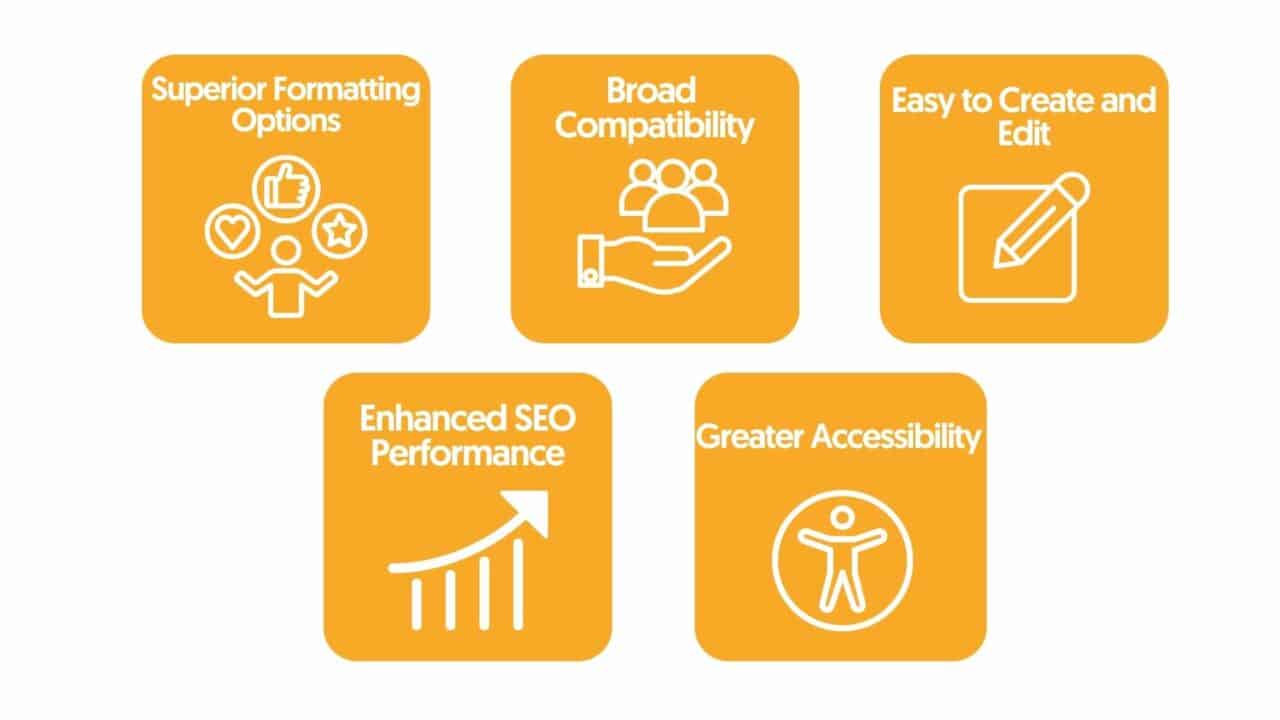
Compatibility with Various Video Platforms
One of the significant advantages of VTT files is their compatibility with a range of video platforms. Whether you’re uploading your videos to YouTube, Vimeo, or other social media channels, VTT files can be seamlessly integrated to enable subtitles and closed captions. This compatibility ensures that your content can reach a broader audience across different platforms.

Can I upload a VTT file to Youtube?
Read the blogGetting Started with Amberscript
Amberscript is a powerful captioning software that simplifies the process of creating subtitles and closed captions. By setting up an account and exploring its automatic and manual captioning features, content creators can efficiently make their videos accessible to a broader audience.
Introduction to Amberscript
Amberscript is a cutting-edge captioning software that utilizes advanced speech recognition technology to create high-quality captions and subtitles. With its user-friendly interface and powerful features, Amberscript simplifies the captioning process, making it accessible to content creators of all skill levels.
Setting up an Amberscript Account
To begin using Amberscript, you need to set up an account on the platform. The process is straightforward, and you can choose from various subscription options based on your captioning needs. Once registered, you’re ready to start captioning your videos with ease.

Overview of Amberscript Features for Automatic and Manual Captioning
Amberscript offers two primary methods of creating captions: automatic captioning and manual captioning. Automatic captioning relies on the software’s speech recognition technology to generate captions automatically. Manual captioning, on the other hand, allows you to input captions manually, giving you more control over the accuracy and formatting.
Automatic Captioning with Amberscript
Amberscript’s automatic captioning feature utilizes advanced speech recognition technology to generate subtitles automatically. By uploading a video, the software transcribes spoken words into written text and aligns the captions with timestamps, saving time and effort for content creators.

How to choose an automatic subtitling tool
Learn moreUploading a Video for Automatic Captioning
To get started with automatic captioning, simply upload your video to the Amberscript platform. The software will analyze the audio and generate captions based on its speech recognition capabilities. This process can save a considerable amount of time, especially for longer videos.
How Amberscript Generates Automatic Subtitles
Amberscript’s automatic captioning relies on sophisticated algorithms that convert speech to text. The software uses neural networks and language models to transcribe spoken words into written text, aligning the captions with timestamps to synchronize them with the video.
Reviewing and Editing Automatic Captions
While automatic captioning is a valuable tool, it may not always be 100% accurate, especially for content with complex terminology or background noise. Fortunately, Amberscript allows you to review and edit the generated captions manually, ensuring a higher level of precision and clarity.
Manual Captioning and Subtitling with Amberscript
For utmost accuracy and control, Amberscript offers a user-friendly interface for manual captioning. Content creators can input captions, assign timestamps, and format them as needed, ensuring precise and clear captions for their videos.
Step-by-Step Guide to Manual Captioning
Manual captioning gives you more control over the captions, making it ideal for content that requires utmost accuracy. Amberscript provides a user-friendly interface where you can easily input your captions, assign timestamps, and format them as per your preferences.
Utilizing Amberscript’s User-Friendly Interface
Amberscript’s intuitive interface makes the manual captioning process smooth and efficient. The platform allows you to see the video alongside the caption editor, enabling real-time adjustments and precise synchronization.
Tips for Accurate and Efficient Manual Captioning
Creating accurate captions manually can be a meticulous task. We’ll provide some useful tips and best practices to streamline the manual captioning process and ensure your captions are precise and well-timed.
Advanced Editing Features
Amberscript provides advanced editing tools, such as adding timestamps and speaker identification, to enhance the captioning experience. These features enable content creators to handle challenging audio and customize captions for different video types.
Adding Timestamps and Speaker Identification
Timestamps and speaker identification are crucial for captioning content with multiple speakers or for ensuring precise timing of captions. Amberscript offers tools to add timestamps at specific intervals and distinguish between speakers to enhance the viewer’s comprehension.
Handling Difficult Audio and Background Noise
Challenging audio, such as noisy environments or multiple speakers talking simultaneously, can impact the accuracy of captions. Learn how Amberscript addresses these challenges and how you can optimize your captions in such scenarios.
Customizing Captions for Different Video Types
Different types of videos may require distinct caption styles to match the tone and content. Amberscript enables you to customize captions to suit various video genres, ensuring a seamless viewing experience for your audience.
Exporting VTT Files from Amberscript
Once captions are ready, content creators can save them in the VTT format for compatibility with various video platforms. Amberscript allows for seamless exporting, ensuring the accessibility of captions across different devices and players.
Our promise to you
10x average time saving by using AI.
Automatic alignment of your subtitle with customizable formatting.
GDPR compliant security and safety.
Saving Captions and Subtitles in VTT Format
Once you have created and reviewed your captions in Amberscript, it’s time to save them in the VTT format. We’ll guide you through the exporting process to obtain the VTT file that accompanies your video.
Export Options for Different Video Platforms
Different video platforms may have specific requirements for caption formats. We’ll explore how to export your VTT files from Amberscript to ensure compatibility with various video hosting services.
Ensuring Compatibility and Accessibility
Captioning is not only about providing subtitles; it’s also about making sure they are accessible to all viewers. We’ll cover the importance of ensuring compatibility with different devices and players, ensuring everyone can benefit from your captions.
Final Thoughts
Subtitles and closed captions are essential tools for making video content inclusive and accessible to all. Using VTT files with Amberscript empowers content creators to efficiently generate accurate captions and subtitles for their videos, reaching a broader audience and fostering a more inclusive online community.
Amberscript’s combination of automatic and manual captioning features, along with its advanced editing capabilities, makes it a valuable asset for content creators seeking to improve their video accessibility. Embracing the power of captioning and using tools like Amberscript will undoubtedly enhance the impact and reach of your video content. Let’s strive together to make the digital world more inclusive, one caption at a time.
How to Caption Sound Effects for TV and Movies: A Comprehensive Guide
Sound effects are the unsung heroes of the audiovisual world, weaving a mesmerizing tapestry that enhances storytelling and brings on-screen visuals to life. From the gentle rustle of leaves to the thunderous roars of explosions, these auditory cues play a pivotal role in captivating audiences and evoking emotions. However, for individuals with hearing impairments, the magic of sound effects remains elusive without accurate and accessible captions. In this comprehensive guide, we explore the significance of captioning sound effects for TV and movies and introduce Amberscript as a powerful captioning software. Whether you’re a filmmaker, content creator, or simply an enthusiast, join us as we delve into the art and technology of captioning sound effects, paving the way for a more inclusive and engaging audiovisual experience for all.
Table of Contents
- Sound Effects in TV and Movies
- Understanding the Role of Sound Effects in Audiovisual Media
- The Importance of Captioning Sound Effects
- Amberscript as a Sound Effects Captioning Software
- Best Practices for Captioning Sound Effects with Amberscript
- Amberscript’s Workflow for Efficient Sound Effects Captioning
- Final thoughts
Sound Effects in TV and Movies
Sound effects are the hidden gems that breathe life into audiovisual content, transforming a mere scene into a captivating experience. From the subtle ambiance to the explosive action, these auditory elements play a vital role in engaging and immersing the audience in the world of TV shows and movies.
The Importance of Sound Effects in TV and Movies
In the world of audiovisual media, sound effects play a pivotal role in enhancing storytelling and creating an immersive experience for the audience. From the subtle rustling of leaves to thunderous explosions, sound effects contribute to the overall atmosphere, mood, and emotion of a scene. They breathe life into visuals, making them more engaging and realistic. Sound effects are not only crucial for action-packed blockbusters but also for intimate and emotionally charged moments in dramas, documentaries, and TV shows.
The Need for Accurate and Accessible Captions for Sound Effects
While sound effects enrich the audiovisual experience, they also present a challenge for the deaf and hard-of-hearing audience. To ensure that everyone can fully comprehend and enjoy the content, accurate and accessible captions for sound effects are essential. Captions not only provide a textual representation of dialogue but also describe sound cues, background noises, and other auditory elements, allowing the deaf and hard-of-hearing audience to fully engage with the media.

How Subtitles and Captions Help Increase Video Views by 80%
Read the blogIntroducing Amberscript as a Captioning Software for Sound Effects
Amberscript is a powerful and versatile captioning software that offers solutions for automatic and manual captioning of sound effects in TV and movies. With its advanced algorithms and user-friendly interface, Amberscript makes the process of captioning sound effects more efficient and accurate, ultimately enhancing the accessibility and viewing experience for a broader audience.
Understanding the Role of Sound Effects in Audiovisual Media
Beyond the visuals, sound effects serve as powerful storytelling tools, creating an emotional connection with the audience. This section explores how sound effects enrich narratives, evoke emotions, and create a multi-dimensional audiovisual experience.
How Sound Effects Enhance Storytelling and Immerse the Audience
Sound effects serve as storytelling tools that go beyond what is seen on screen. They add depth and texture to the visuals, making the audience feel like they are part of the narrative. For instance, the suspenseful creaking of a door can heighten tension, the soothing sounds of nature can create a calm and serene ambiance, and the booming roars of monsters can induce fear and excitement. By skillfully using sound effects, filmmakers and TV producers can elicit specific emotions and reactions from the audience, enriching their viewing experience.
Challenges in Captioning Sound Effects for Various Media Platforms
Captioning sound effects presents unique challenges compared to captioning dialogue. While dialogue typically follows a linear sequence, sound effects can occur simultaneously or in quick succession, making it harder to accurately represent them in captions. Additionally, certain sound effects might not have an onomatopoeic equivalent, requiring thoughtful descriptions to convey the intended auditory experience. Moreover, the timing and synchronization of sound effect captions with the visuals demand precision to avoid disrupting the audience’s immersion.
The Importance of Captioning Sound Effects
Inclusivity is at the heart of the entertainment industry, and captioning sound effects is a crucial step towards making TV shows and movies accessible to all. Discover the significance of providing descriptive captions for sound cues, background noises, and other auditory elements to ensure a comprehensive viewing experience.
Ensuring Accessibility for the Deaf and Hard-of-Hearing Audience
Captioning sound effects is crucial for making TV shows and movies accessible to individuals who are deaf or hard of hearing. By providing descriptive captions of sound cues, background noises, and other auditory elements, these viewers can fully comprehend and enjoy the content, ensuring inclusivity in the audiovisual media landscape.
Enhancing the Overall Viewing Experience for All Audiences
Captioning sound effects doesn’t only benefit the deaf and hard-of-hearing audience but also enhances the viewing experience for all audiences. Captions can be helpful in noisy environments where the audio might be difficult to hear, for language learners who want to improve their listening skills, or for viewers who prefer to watch content with subtitles to better understand the dialogue and sound elements.
Amberscript as a Sound Effects Captioning Software
Meet Amberscript, the innovative captioning software designed to address the challenges of sound effects captioning. Explore its automatic and manual captioning capabilities, and how it simplifies the process of transcribing sound effects with remarkable accuracy.
Overview of Amberscript and its Capabilities
Amberscript is a leading captioning software that offers a comprehensive suite of tools for sound effects captioning. It employs cutting-edge automatic speech recognition (ASR) technology that can identify and transcribe sound effects with impressive accuracy. Additionally, it provides intuitive manual captioning features for situations where automatic recognition may be challenging.
Features for Automatic Captioning of Sound Effects
Amberscript’s automatic captioning feature allows users to upload audio files and generate captions for sound effects quickly. The ASR engine is trained on vast amounts of data, enabling it to recognize a wide range of sound effects accurately. This feature saves time and effort in the captioning process, making it an efficient solution for large-scale projects.
Manual Captioning Tools and Their Advantages
While automatic captioning is highly effective, there may be instances where manual intervention is necessary to ensure utmost accuracy. Amberscript offers intuitive manual captioning tools that allow users to review and edit captions to fine-tune the transcription. These tools also enable the addition of descriptive text for complex sound effects, providing a more detailed and immersive experience for the audience.
Supported File Formats and Integration Options
Amberscript supports various audio file formats, making it compatible with most audiovisual production workflows. Users can seamlessly integrate the captions generated by Amberscript into their TV and movie projects, ensuring a smooth and streamlined captioning process.
Best Practices for Captioning Sound Effects with Amberscript
Capturing the essence of sound effects through captions requires finesse and precision. Learn the best practices for preparing audio files, choosing appropriate captioning styles, addressing challenges, and ensuring seamless synchronization between captions and visuals.
Benefits of using Amberscript
Amberscript’s subtitle services are:
Edit your own text within minutes or leave the work to our experienced subtitlers.
Our experienced subtitlers and thorough quality controls ensure 100% accuracy of your transcriptions and subtitles.
Thanks to a variety of integrations and API interfaces, you can fully automate your workflows.
Your data is in safe hands. We are GDPR compliant + ISO27001 & ISO9001 certified.
Preparing Audio Files for Captioning
Before captioning sound effects with Amberscript, it’s essential to ensure that the audio files are of high quality and clarity. Removing background noise and optimizing audio settings can improve the accuracy of the automatic captioning process.

How to improve audio quality?
Learn moreChoosing Appropriate Captioning Styles and Formats
Captioning styles and formats should be selected with consideration for the target audience and the overall tone of the content. For instance, using italics for certain sound effects or applying specific formatting for onomatopoeic words can enhance the visual presentation of the captions.
Addressing Challenges in Sound Effects Recognition and Transcription
Although Amberscript’s ASR technology is advanced, some sound effects may still pose challenges in recognition and transcription. In such cases, manual intervention is crucial to ensure accurate representation of the auditory elements.
Ensuring Synchronization Between Captions and Visuals
Timing is of utmost importance in captioning sound effects. Captions must be precisely synchronized with the visuals to maintain the audience’s immersion and prevent any discrepancies between audio and text.
Amberscript’s Workflow for Efficient Sound Effects Captioning
Delve into Amberscript’s streamlined workflow, combining automatic captioning with intuitive manual tools for a seamless captioning process. Discover how to review, edit, and export captions effectively, optimizing the software’s potential for sound effects captioning.
Step-by-Step Guide to Automatic Captioning
1. Upload the audio file: Begin by uploading the audio file to Amberscript’s platform.
2. Automatic transcription: Initiate the automatic captioning process, where Amberscript’s ASR technology transcribes the sound effects.
3. Review and edit: Carefully review the generated captions to correct any inaccuracies or to add descriptive text where needed.

Utilizing Manual Captioning Tools Effectively
1. Identify complex sound effects: Use manual captioning tools to address sound effects that the ASR technology might have difficulty recognizing.
2. Add descriptive text: Enhance the audience’s experience by including descriptive text for nuanced sound effects.
Reviewing and Editing Captions for Accuracy
1. Playback and cross-reference: Play back the audio while reviewing the captions to ensure accuracy and synchronization.
2. Edit as necessary: Make necessary adjustments to ensure the captions align precisely with the sound effects.
Exporting and integrating captions into TV and movie projects
Once the captioning process is complete, export the captions in the desired format and integrate them seamlessly into the TV show or movie project.
Final Thoughts
In conclusion, sound effects are integral to the storytelling and immersion in TV and movies, making captioning of sound effects essential for accessibility and enhanced viewing experiences. Amberscript stands out as a robust captioning software that offers automatic and manual captioning capabilities, ensuring accuracy and efficiency in the captioning process. By adopting Amberscript for sound effects captioning, content creators can cater to a broader audience and contribute to a more inclusive media landscape. As the industry continues to recognize the importance of accessibility, accurate sound effects captioning with Amberscript becomes a valuable tool for producing captivating and inclusive audiovisual content.
How to add chapter markers to a VTT file
Table of content
- Choosing a Text Editor for VTT Files
- Identifying Chapter Points
- Formatting Chapter Markers
- Adding Chapter Markers Step-by-Step
- Validating the VTT File
- Testing Chapter Markers in Video Players
- Troubleshooting Common Issues
- Best Practices for Chapter Markers
Choosing a Text Editor for VTT Files
When it comes to editing VTT files, selecting the right text editor can significantly impact your workflow and overall experience. Several text editors in the market cater to various needs, but some of the most recommended ones for VTT file editing are Notepad++, Sublime Text, and Visual Studio Code.
Recommended Text Editors
- Notepad++: This popular text editor is favored for its user-friendly interface and extensive plugin support. Notepad++ provides syntax highlighting for VTT files, making it easier to spot errors and format cues accurately. Its lightweight nature ensures smooth performance even with large VTT files.
- Sublime Text: Known for its speed and versatility, Sublime Text is another top choice for VTT file editing. With a minimalist design, it offers a distraction-free environment, allowing you to focus solely on editing your VTT files. Additionally, its multiple selections feature comes in handy when making changes to multiple cues simultaneously.
- Visual Studio Code: This feature-rich text editor, developed by Microsoft, is a powerful tool for VTT file editing. With its built-in terminal and debugging support, Visual Studio Code offers more than just text editing capabilities. It also boasts a vast library of extensions that can enhance your VTT file editing experience.
Advantages of Using Text Editors for VTT File Editing
Using a dedicated text editor for VTT file editing presents several advantages over standard word processing software. Unlike word processors, text editors are designed to handle plain text efficiently and are better suited for the specific syntax used in VTT files. Some key advantages include:
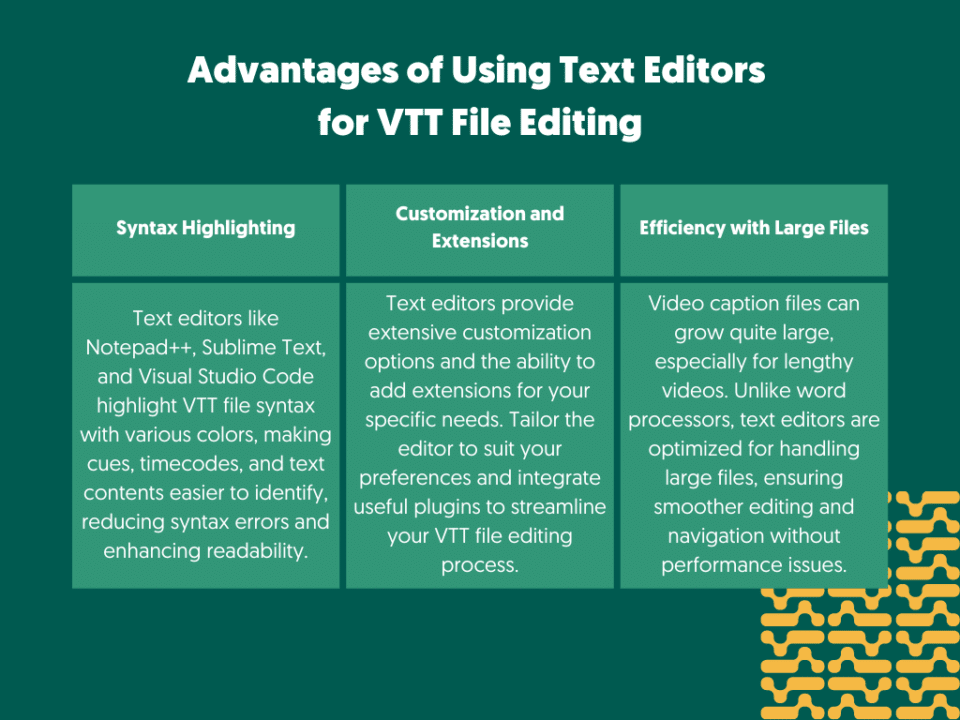
Installing and Setting Up the Chosen Text Editor
After choosing the text editor that suits your preferences and needs, the next step is to install and set it up on your computer. Installation is usually straightforward and involves downloading the appropriate installer from the text editor’s official website and running it on your system.
Once installed, you can customize the editor’s settings to enhance your VTT file editing experience. Adjust font sizes, enable word wrapping, and configure color themes to make the editing environment comfortable for you.
With your text editor installed and configured, you’re now equipped with a powerful tool to dive into VTT file editing. The next sections of this guide will cover the process of adding chapter markers and enhancing your video navigation.

Find out more about finding the right tools for VTT files
Find out moreIdentifying Chapter Points
Importance of Selecting Appropriate Chapter Points
Selecting the right chapter points is crucial for creating a meaningful and user-friendly video navigation experience. Chapter points serve as signposts that guide viewers to essential sections of the video. When choosing these points, consider the relevance and significance of the content. Identify moments that highlight key events, important information, or topic changes. By doing so, you can help viewers quickly find the specific content they are looking for, saving them time and enhancing their overall engagement with your video.
Determining Key Events or Topic Changes
To identify chapter points effectively, focus on the key events and transitions within your video. These events could be critical moments, demonstrations, or discussions that hold particular importance in the overall context of the content. Similarly, topic changes mark shifts from one subject matter to another. By understanding the flow and structure of your video, you can determine where to place chapter markers to aid viewers in navigating through different sections smoothly.
Timecode Selection for Chapter Markers
Accurate timecode selection is essential for placing chapter markers precisely at the intended points in your video. Most video players interpret timecodes in the HH:MM:SS.MMM (hours, minutes, seconds, milliseconds) format. While adding chapter markers, ensure that the timecodes align with the start of each chapter. To improve user experience, consider selecting timecodes at natural breaks or pauses in the video, making it easier for viewers to jump to specific sections without missing any crucial content.
By identifying appropriate chapter points, you can create a well-structured video with clear navigational cues. This approach not only enhances viewer satisfaction but also encourages them to explore more of your content, leading to increased engagement and retention. In the next section, we will delve into the process of formatting chapter markers in your VTT file, unlocking the full potential of your video’s navigation capabilities.
Formatting Chapter Markers
Introduction to Chapter Cue Settings Syntax
To effectively add chapter markers to a VTT file, it’s essential to understand the syntax used for defining chapter cues. Chapter cues are created using specific settings within the VTT file, denoting the start and end times of each chapter, along with additional optional information like chapter titles. The syntax generally follows the format of:

The ‘CHAPTER‘ keyword indicates the beginning of a new chapter cue, followed by the start and end times in HH:MM:SS.MMM format, and the chapter title, which is displayed when the viewer interacts with the chapter markers.
Step-by-Step Guide for Creating Chapter Markers
- Start time and end time format: Begin by determining the start and end times of each chapter in your video. You can easily identify these timestamps by scrubbing through the video or using video editing software. Ensure to format the timecodes correctly in HH:MM:SS.MMM format.
- Chapter title and additional settings: After setting the timecodes, assign a descriptive title to each chapter. The title should be concise yet informative, giving viewers a clear idea of the content they can expect. Optionally, you can include additional settings such as cue styling (e.g., italics, bold) or even custom CSS classes for further customization.
Examples of Properly Formatted Chapter Markers
Here are a few examples of properly formatted chapter markers:
Example 1:

Example 2:

Example 3:

Properly formatted chapter markers are essential for smooth navigation. When you save the VTT file with these chapter cues, the video player will recognize them, and viewers can easily skip to different chapters or sections.
In the next section, we will walk you through the process of adding chapter markers step-by-step, using your chosen text editor. By the end of this guide, you’ll be proficient in creating well-structured VTT files with chapter markers, elevating your video content and providing an enhanced viewing experience for your audience.
Adding Chapter Markers Step-by-Step
Opening the VTT File in the Text Editor
To begin adding chapter markers to your VTT file, open the file in your chosen text editor, such as Notepad++, Sublime Text, or Visual Studio Code. Simply locate the VTT file on your computer, right-click on it, and select “Open with” to choose your preferred text editor. The VTT file will now be displayed in the editor, ready for you to start adding chapter markers.
Navigating to the Desired Chapter Points
Once your VTT file is open, navigate to the sections in the video where you want to place the chapter markers. This step requires a thorough understanding of your video’s content and the key events or topic changes you identified earlier. Scrub through the video or use the timecodes to pinpoint the exact moments where you wish to insert the chapter markers.
Inserting Chapter Markers Using Correct Syntax
With the desired chapter points in mind, it’s time to insert the chapter markers using the correct syntax. As explained earlier, the VTT file follows a specific format for chapter cues, including the start and end times in HH:MM:SS.MMM format and the chapter title. Type the chapter cue settings, adhering to the syntax guidelines, just above the corresponding section of the video’s transcript.
For example:

Saving the Edited VTT File
After inserting all the chapter markers, ensure that you save the edited VTT file to preserve the changes. Simply go to the “File” menu and select “Save” or use the keyboard shortcut (e.g., Ctrl + S for Windows, Command + S for Mac) to save the file. Saving the VTT file is crucial, as it enables video players to recognize the chapter markers and make them accessible to viewers during playback.
Congratulations! You’ve successfully added chapter markers to your VTT file. The chapter cues you’ve inserted will enable viewers to navigate through your video content effortlessly, providing them with a seamless and enjoyable viewing experience.
In the next section, we will delve into the importance of validating your VTT file to ensure proper syntax and compatibility. Validation is a crucial step that helps you identify any errors or issues that might affect the functionality of your chapter markers.
Validating the VTT File
Importance of Validating VTT Files
Validating your VTT file is a crucial step in ensuring the accuracy and functionality of your chapter markers. Errors in the VTT file can lead to issues during video playback, resulting in improperly positioned or non-functional chapter markers. By validating the VTT file, you can identify and rectify any syntax errors or inconsistencies, guaranteeing a seamless viewing experience for your audience. Moreover, validation ensures cross-platform compatibility, as different video players may interpret VTT files differently. Taking the time to validate your VTT file demonstrates your commitment to delivering high-quality content to your viewers.
Recommended VTT Validation Tools
Fortunately, there are several online tools available that can help you validate your VTT file effortlessly. These tools analyze your VTT file for errors and provide valuable feedback to ensure compliance with the WebVTT standard. Some recommended VTT validation tools include “WebVTT Validator” and “VTT Validator” by the W3C (World Wide Web Consortium). These tools offer user-friendly interfaces and detailed error reports, making it easy for content creators to address any issues that may arise.
Checking for Syntax Errors and Compatibility
When using a VTT validation tool, pay close attention to syntax errors that may be flagged during the process. Syntax errors could include missing timecodes, incorrect cue settings, or improper formatting of chapter titles. Address these errors by reviewing and adjusting the affected chapter markers in your VTT file.
Additionally, consider testing your VTT file with different video players to ensure cross-platform compatibility. Playback behavior may vary between web browsers and media players, so verifying that your chapter markers work as intended across different platforms guarantees a seamless experience for all viewers.
By validating your VTT file and addressing any errors, you can confidently publish your video content, knowing that your chapter markers are accurate, functional, and accessible to all. In the next section, we will guide you through testing your chapter markers in various video players, ensuring they perform flawlessly and provide the best possible navigation experience.
Testing Chapter Markers in Video Players
How to Test VTT Files with Chapter Markers in VLC Player
One of the most reliable ways to test your VTT files with chapter markers is by using the VLC media player. VLC is a popular open-source multimedia player that supports WebVTT files and accurately interprets chapter markers. To begin testing, simply open VLC and load your video file along with the corresponding VTT file in the same directory. When you play the video, VLC will automatically detect the chapter markers and display them as clickable navigation points in the player’s interface. Clicking on any chapter marker will instantly take you to the associated section of the video, allowing you to verify the accuracy and smoothness of the navigation.
Testing Chapter Markers on Online Video Platforms (e.g., YouTube, Vimeo)
Aside from local testing with VLC, it’s essential to ensure that your chapter markers work seamlessly on popular online video platforms like YouTube and Vimeo. Upload your video to the platform of your choice and make sure to include the VTT file as a caption or subtitle track. Once the video is live, watch it on the platform and activate the captions or subtitles. The chapter markers should now be visible in the player’s interface, allowing viewers to skip to specific sections of the video easily. Test the chapter markers on different devices and web browsers to ensure a consistent and user-friendly experience across various platforms.
Ensuring Proper Positioning and Functionality of Chapter Markers
During the testing phase, pay close attention to the positioning and functionality of the chapter markers. Ensure that each marker aligns accurately with the intended sections of the video. Check for any discrepancies or delays in the marker activation. If you encounter any issues, go back to your VTT file and review the timecodes and cue settings to rectify the problem. Additionally, verify that the chapter titles display correctly and convey the content of each section effectively.
Thoroughly testing your chapter markers in different video players is crucial to providing an optimal viewing experience for your audience. Well-implemented chapter markers enhance video navigation and engagement, enabling viewers to find relevant content quickly and easily. In the final section of our guide, we’ll explore common troubleshooting tips and best practices to fine-tune your chapter markers further.
Troubleshooting Common Issues
-
Common Problems Encountered
While adding chapter markers to your VTT file can greatly enhance video navigation, you might encounter a few common issues during the process. One frequent problem is misaligned timecodes, where the chapter markers do not correspond accurately with the intended sections of the video. Additionally, formatting errors, such as missing cue settings or improperly placed chapter titles, can lead to malfunctioning chapter markers. It’s also possible to encounter issues when your VTT file is not recognized by certain video players, preventing the chapter markers from appearing altogether. However, fear not! With the right troubleshooting techniques, these problems can be swiftly resolved, ensuring a seamless experience for your viewers.
-
Troubleshooting Tips for Formatting or Playback Issues
To resolve formatting issues, carefully review the syntax of your chapter markers in the VTT file. Check for any missing or incorrect settings, ensuring that each chapter cue follows the correct structure. Pay close attention to the timecodes, making sure they accurately align with the intended sections of the video. If you encounter playback issues, try testing your VTT file in different video players, such as VLC, YouTube, and Vimeo. Verify that the chapter markers work as expected across various platforms. If inconsistencies arise, double-check your VTT file’s compatibility with each player and make necessary adjustments.
-
Ensuring Cross-Platform Compatibility
Cross-platform compatibility is crucial to ensure that your chapter markers function seamlessly across different devices and browsers. While most modern video players support VTT files and chapter markers, there might be minor discrepancies in their interpretation. To ensure compatibility, follow best practices when creating your VTT file, adhering to the WebVTT standard. Stick to widely supported features and avoid using proprietary extensions that may cause compatibility issues. Regularly test your chapter markers on various platforms to verify their consistency and accessibility.
By proactively addressing common issues and troubleshooting formatting or playback discrepancies, you can deliver an exceptional viewing experience for your audience. Well-implemented chapter markers will not only facilitate video navigation but also enhance engagement and overall satisfaction. In the final section of our guide, we’ll discuss essential best practices for creating chapter markers that optimize the user experience.
Best Practices for Chapter Markers
Choosing Clear and Concise Chapter Titles
When it comes to chapter titles, clarity and conciseness are paramount. Aim to create titles that succinctly summarize the content of each section. Avoid lengthy or ambiguous titles that may confuse viewers. Instead, opt for descriptive phrases that give a clear indication of what the chapter entails. Well-crafted chapter titles not only aid navigation but also entice viewers to explore different sections of your video. By using straightforward and engaging titles, you can enhance the overall user experience and keep your audience hooked throughout the video.
Optimizing Time Intervals for Chapter Markers
Striking the right balance with time intervals is essential for an efficient and user-friendly video navigation experience. Chapter markers that are too frequent might overwhelm viewers, while those spaced too far apart can make it challenging to find specific content quickly. Consider the flow of your video and the significance of each section when setting time intervals for the chapter markers. Ideally, aim for intervals that are long enough to encompass substantial content but short enough to provide meaningful division. Optimize the time intervals to ensure smooth navigation while maintaining viewer engagement.
Maintaining Consistency and Clarity in Chapter Markers
Consistency in chapter markers is crucial for a cohesive viewing experience. Use a consistent format for the chapter titles, ensuring they are easily distinguishable from the rest of the text. Similarly, maintain a standardized timecode format throughout the VTT file to avoid confusion. In cases where your video is part of a series or playlist, consider using consistent chapter marker styles across all videos to create a seamless user experience. Additionally, refrain from overloading your video with chapter markers; instead, focus on highlighting the most essential sections to keep the navigation intuitive and clutter-free.
By implementing these best practices, you can elevate your chapter markers and optimize video navigation for your audience. Clear and concise titles, optimized time intervals, and consistent formatting will make your content more accessible and enjoyable.
Chapter markers are the key to enhancing video navigation and viewer experience. By following the steps and best practices in this guide, you can create seamless and engaging video content. Embrace the art of chapter markers and unlock the full potential of your videos.
Filmmaking: The Process of Getting Accurate Subtitles and Closed Captions
Table of content
- Understanding the Difference Between Subtitles and Closed Captions
- The Pre-Production Phase: Planning for Subtitles and Closed Captions
- The Production Phase: Creating Accurate Subtitles and Closed Captions
- The Post-Production Phase: Quality Assurance for Subtitles and Closed Captions
- Overcoming Challenges in Subtitling and Captioning
- Best Practices for Subtitles and Closed Captions in Filmmaking
- The Role of AI in Subtitling and Captioning
- Legal and Ethical Considerations
- The Impact of Accurate Subtitles and Closed Captions
In the world of filmmaking, the art of storytelling knows no bounds. To ensure that every story can reach its audience, accurate subtitles and closed captions play a vital role. This blog post will uncover the process of obtaining these essential elements, exploring their impact on accessibility and the challenges filmmakers must navigate.
Understanding the Difference Between Subtitles and Closed Captions
Definition of subtitles and closed captions
Subtitles and closed captions are textual elements displayed on the screen during a film or video to provide a written representation of the spoken dialogue and other important audio elements. The key difference lies in their display options and target audience. Subtitles are typically designed for viewers who may not understand the language spoken in the film. They appear in a language different from the audio, enabling foreign language speakers to follow the plot and dialogue seamlessly. On the other hand, closed captions are specifically tailored for individuals with hearing impairments. These captions not only include dialogue but also encompass non-verbal audio cues like sound effects and music, enriching the viewing experience for those who rely on them.
How they cater to different needs
While both subtitles and closed captions serve to enhance accessibility, their purposes cater to distinct viewer requirements. Subtitles are vital for reaching international audiences and bridging the language barrier. They facilitate a broader global reach for a film, enabling it to connect with people from diverse linguistic backgrounds. Closed captions, however, play a crucial role in ensuring inclusivity for viewers with hearing disabilities. By providing a text-based representation of all audio elements, including ambient sounds and speaker identification, closed captions make films accessible to the deaf and hard of hearing, fostering an inclusive cinematic experience.
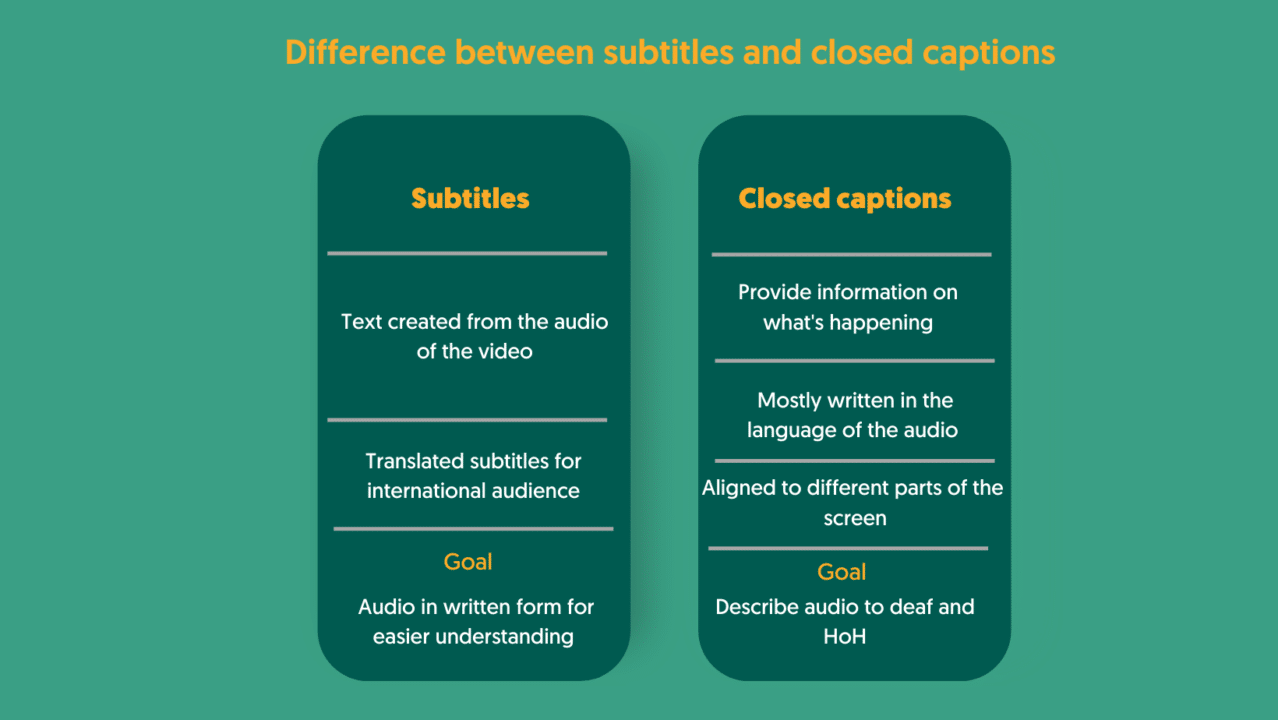
Legal requirements and accessibility guidelines
In many countries, legal requirements and accessibility guidelines mandate the inclusion of subtitles and closed captions in films and videos. For instance, the Americans with Disabilities Act (ADA) in the United States emphasizes the provision of closed captions for television programs and online content to ensure equal access for individuals with hearing impairments. Similarly, international treaties and conventions, such as the Convention on the Rights of Persons with Disabilities (CRPD), advocate for the accessibility of audiovisual content. By adhering to these legal and ethical obligations, filmmakers not only meet regulatory demands but also contribute to a more inclusive and diverse cinematic landscape.
The Pre-Production Phase: Planning for Subtitles and Closed Captions
Identifying the target audience and their language preferences
In the pre-production phase, filmmakers must first identify their target audience and consider their language preferences. Understanding the demographic composition of the intended viewership helps determine the languages for which subtitles and closed captions will be required. Analyzing data on the film’s potential distribution regions and markets is essential in making informed decisions about which languages to prioritize. By tailoring the accessibility elements to match the linguistic needs of the audience, filmmakers can effectively engage and connect with viewers from diverse backgrounds.
Selecting appropriate languages for subtitles
Once the target audience and their language preferences are determined, the next step is to select the appropriate languages for subtitles. It involves careful consideration of the primary language of the film and the languages spoken in the regions where the film will be distributed or screened. Prioritizing widely spoken languages and those relevant to the storyline or theme can significantly enhance the film’s accessibility and international appeal. Moreover, filmmakers must also be mindful of cultural nuances and sensitivities when translating the dialogue, ensuring an accurate and respectful representation of the original content.
Hiring professionals or using AI-based solutions for transcription
The accuracy and quality of subtitles and closed captions are paramount to their effectiveness. In this regard, filmmakers have two primary options: hiring professional transcribers and translators or utilizing AI-based solutions. Professional transcribers possess the linguistic expertise and cultural awareness needed to deliver precise and contextually appropriate subtitles. Their human touch can account for idiosyncrasies, puns, and colloquial expressions that AI may struggle with. However, AI-driven transcription services such as Amberscript have seen significant advancements, offering faster processing times and cost-effectiveness. Filmmakers must strike a balance between manual and automated approaches, depending on the project’s requirements and available resources. Whichever route is chosen, the goal remains the same: to deliver accurate and accessible subtitles and closed captions that enhance the film’s impact and reach.

The Production Phase: Creating Accurate Subtitles and Closed Captions
Transcribing the dialogue and audio content
During the production phase, the focus shifts to transcribing the dialogue and audio content of the film accurately. This crucial step involves listening to the spoken dialogue and identifying every word and utterance to create a comprehensive written transcript. Transcribers must pay close attention to nuances in speech, dialects, and any background noises that could impact the clarity of the dialogue. Additionally, transcribing non-verbal audio cues such as laughter, applause, or footsteps ensures a more immersive and inclusive experience for viewers who rely on closed captions. The transcription serves as the foundation for subsequent stages of the subtitling and captioning process.
Proper time coding for synchronization
Once the dialogue and audio content are transcribed, the next step is to synchronize the text with the corresponding scenes in the film. Time coding involves precisely aligning each subtitle or caption with its respective on-screen action or dialogue. Proper timing is crucial to ensure that the text appears and disappears at the right moments, maintaining synchronization with the audio and video elements. Accurate time coding not only enhances the viewing experience but also prevents distractions or confusion for the audience. This process requires meticulous attention to detail and may involve multiple iterations to achieve seamless synchronization.
Ensuring accuracy, context, and context-awareness
Beyond technical precision, creating accurate subtitles and closed captions demands an acute awareness of the film’s context and the intended viewer experience. Subtitlers and captioners must strive to capture the essence of the dialogue, conveying emotions, humor, and tone as intended by the filmmakers. Understanding the broader narrative and character dynamics helps in preserving the film’s artistic integrity throughout the subtitling and captioning process. Context-awareness is especially critical when dealing with idiomatic expressions, cultural references, and wordplay, as direct translations may not always capture the intended meaning. By carefully balancing precision and creativity, the production team ensures that the subtitled or captioned version resonates with the audience, regardless of language or hearing abilities.
In the production phase, the collaboration between transcribers, subtitlers, and captioners plays a pivotal role in delivering accurate and contextually rich subtitles and closed captions. The effort invested in transcription, time coding, and context-awareness culminates in a seamless viewing experience for audiences worldwide. By striving for excellence during this phase, filmmakers demonstrate their commitment to accessibility and inclusivity, fostering a more diverse and engaged community of viewers.
The Post-Production Phase: Quality Assurance for Subtitles and Closed Captions
Reviewing and editing the transcriptions
In the post-production phase, meticulous review and editing of the transcriptions take center stage. This step involves a thorough examination of the previously transcribed text to ensure accuracy, grammar, and spelling. Any errors or inconsistencies in the transcriptions must be corrected to maintain the highest level of quality in the final output. Moreover, the review process allows subtitlers and captioners to verify that all dialogue and audio cues have been appropriately captured, enhancing the overall coherence and understanding of the film. Additionally, collaborative feedback and input from language experts and native speakers can help refine the transcriptions, catering to linguistic nuances and cultural sensitivities.
Proper placement and formatting of subtitles
The aesthetic and functional aspects of subtitles and closed captions are critical to a seamless viewing experience. During this phase, the placement of subtitles on the screen is carefully considered to avoid obscuring important visual elements or obstructing on-screen text. Proper formatting, such as font style, size, and color, is also chosen to ensure readability and legibility. The use of appropriate punctuation and text positioning helps convey the right cadence and timing, contributing to a more engaging and enjoyable viewing experience. Balancing visibility and subtlety, the team strives to integrate subtitles and closed captions seamlessly into the film, enhancing rather than detracting from the storytelling.
Testing for synchronicity and readability
Before finalizing the subtitles and closed captions, thorough testing for synchronicity and readability is conducted. This process involves meticulously aligning the text with the audio and video to verify that the timing is accurate and matches the on-screen actions and dialogue precisely. Synchronicity testing is essential to avoid premature or delayed display of text, which can disrupt the viewing experience. Furthermore, readability assessments are conducted to ensure that the chosen fonts and text sizes are suitable for various screen sizes and devices, enabling effortless comprehension by the audience. Pilot screenings or test audiences, including individuals with hearing impairments, may be involved to provide valuable feedback and insights to further refine the subtitles and closed captions.
In the post-production phase, the emphasis on quality assurance ensures that the subtitled and captioned version of the film maintains the director’s artistic vision while adhering to accessibility standards. By combining attention to detail with technical expertise, the filmmaking team works diligently to deliver a flawless and inclusive cinematic experience. The collaboration between subtitlers, captioners, and technical experts during this phase culminates in a final product that transcends linguistic and auditory barriers, leaving a lasting impact on audiences around the world.
Overcoming Challenges in Subtitling and Captioning
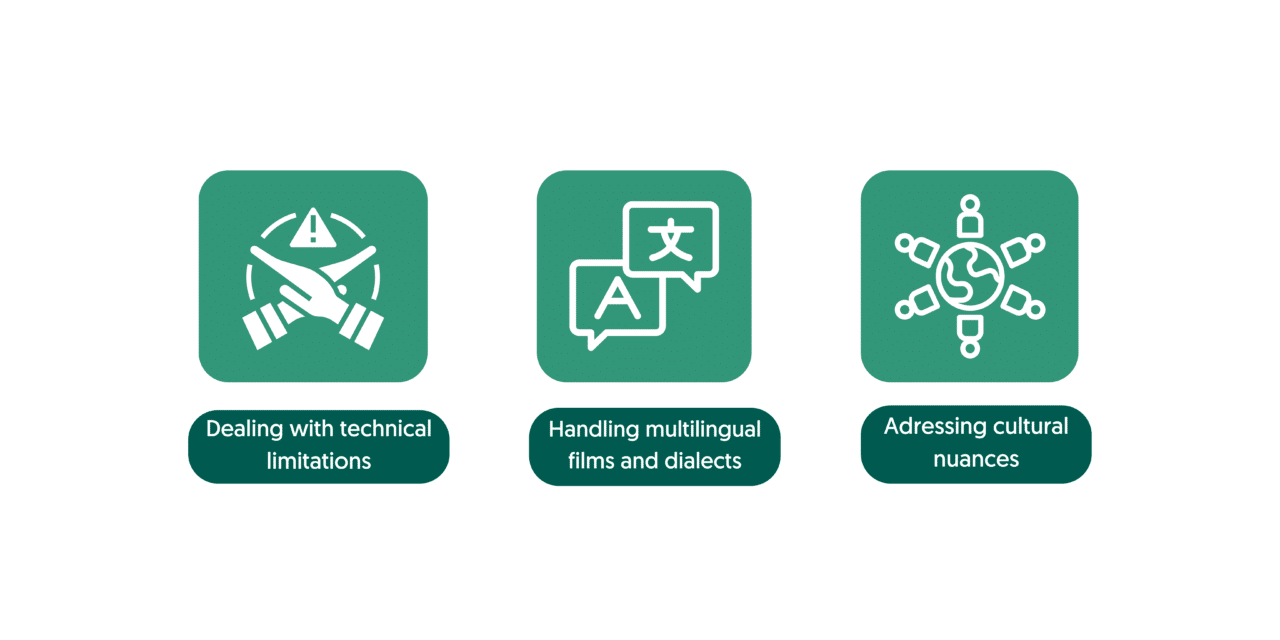
Dealing with technical limitations and video restrictions
In the world of subtitling and captioning, technical limitations and video restrictions can present formidable challenges. Some films may feature fast-paced scenes with rapid dialogue exchanges, making it challenging to fit subtitles within the screen space without compromising readability. Additionally, certain video platforms or devices may impose character or line limitations, further constraining the amount of text that can be displayed on-screen. To tackle these challenges, subtitlers and captioners employ techniques such as condensing dialogue while preserving its essence, strategically breaking lines, and employing optimized fonts to maximize space utilization. Moreover, technical advancements in subtitle rendering and video formatting help in navigating these constraints, providing more creative solutions for an engaging viewing experience.
Handling multilingual films and dialects
Multilingual films present a unique set of challenges for subtitling and captioning. When multiple languages are spoken within the same film, it becomes essential to maintain clarity while distinguishing between the different languages in the subtitles. Properly identifying and labeling each language helps the audience follow the conversations seamlessly. Moreover, in films featuring regional dialects or accents, accurately capturing the nuances of speech is crucial for conveying the characters’ backgrounds and cultural identities. Careful translation and localization of dialects require a deep understanding of regional variations, and working with native speakers becomes invaluable in achieving linguistic accuracy. By balancing authenticity and clarity, subtitlers and captioners ensure that the multilingual aspects of the film enrich the storytelling without becoming a hindrance.
Addressing cultural nuances and wordplay
Translating cultural nuances and wordplay poses a significant challenge in subtitling and captioning, especially when linguistic and cultural differences exist between the source and target languages. Humor, idiomatic expressions, and references to specific cultural events may lose their impact when translated literally. Here, the creativity and expertise of subtitlers and captioners come into play. They employ adaptation techniques such as cultural equivalent expressions, footnotes, or parenthetical explanations to convey the intended meaning without compromising on cultural authenticity. Striking a delicate balance between faithfulness to the original content and effective communication in the target language is vital in preserving the film’s essence and engaging the audience on a global scale.
In overcoming the challenges of subtitling and captioning, the filmmaking team demonstrates their commitment to delivering a universally accessible and culturally relevant cinematic experience. By embracing technical innovations, collaborating with language experts, and exercising linguistic creativity, subtitlers and captioners ensure that films transcend language barriers and cultural divides. Their dedication to quality and attention to detail enable a broader spectrum of audiences to immerse themselves in the captivating world of cinema, regardless of linguistic or auditory barriers.
Best Practices for Subtitles and Closed Captions in Filmmaking
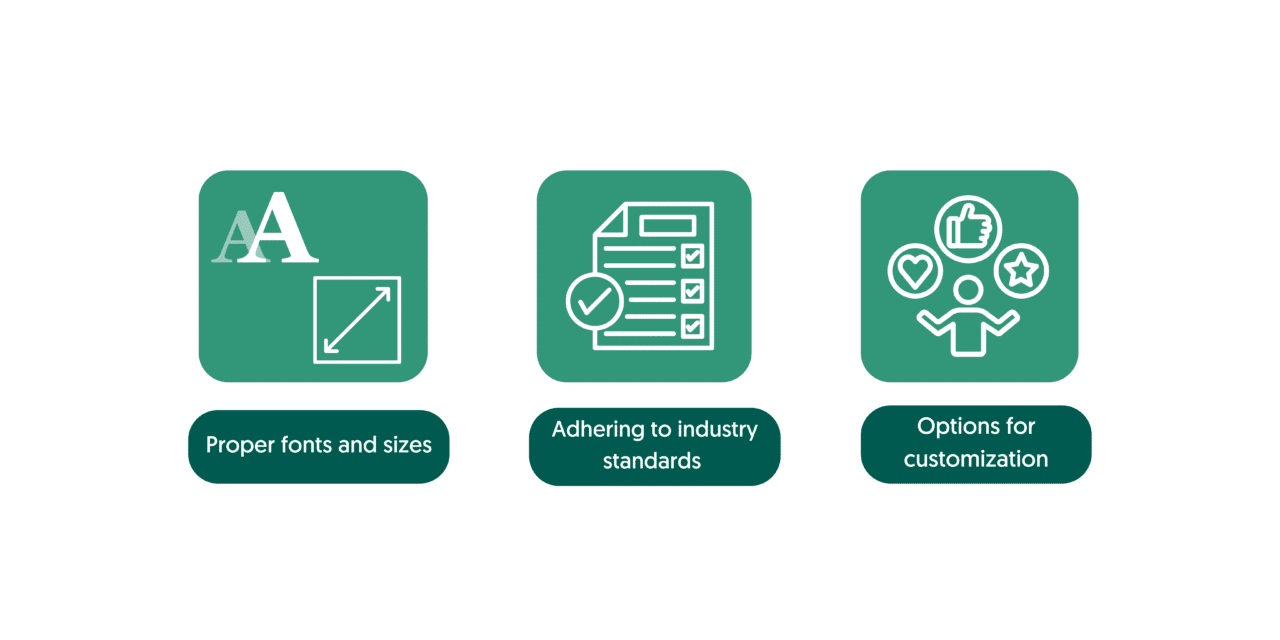
Using proper fonts and sizes for readability
When it comes to creating subtitles and closed captions, prioritizing readability is of utmost importance. Selecting appropriate fonts and sizes can significantly impact how easily viewers can follow the on-screen text. Clear and simple fonts, such as sans-serif typefaces, are often preferred for their legibility. The size of the text should be chosen thoughtfully, striking a balance between being large enough for easy reading and not overwhelming the screen with text. Furthermore, using contrasting colors for the text and background ensures that subtitles and captions stand out, making them accessible even in challenging lighting conditions. By adhering to best practices in typography, filmmakers can guarantee that their subtitles and closed captions enhance rather than hinder the overall viewing experience.
Adhering to industry standards and guidelines
Incorporating industry standards and accessibility guidelines is essential to producing high-quality subtitles and closed captions. Filmmakers should stay up-to-date with the latest recommendations from organizations like the W3C and the Federal Communications Commission (FCC). These standards cover various aspects, including text placement, timing, and synchronization with audio and video content. Following these guidelines ensures that subtitles and captions are synchronized accurately and provide comprehensive access to the film’s auditory content for individuals with hearing impairments. By adhering to recognized standards, filmmakers not only meet legal requirements but also demonstrate their commitment to making their films more inclusive and accessible to a diverse audience.
Providing options for customization and preferences
Recognizing the diverse needs and preferences of viewers, offering customization options is a mark of a filmmaker dedicated to inclusivity. Allowing users to personalize their viewing experience empowers them to optimize subtitles and closed captions according to their specific requirements. Customization options can include selecting different font styles, sizes, colors, and even language preferences. Furthermore, providing the option to toggle subtitles on or off gives viewers control over their viewing experience, catering to multilingual audiences or those who prefer to watch without captions. By incorporating user-friendly customization features in streaming platforms or media players, filmmakers enable viewers to enjoy their films in a manner that suits their individual needs and enhances overall satisfaction.
By embracing these best practices in subtitling and closed captioning, filmmakers not only enhance accessibility but also improve the overall quality of their films. Readable and well-designed subtitles and closed captions contribute to a more engaging and enjoyable viewing experience for all audiences. Adhering to industry standards ensures that films meet legal requirements and adhere to recognized accessibility guidelines. Moreover, by providing options for customization, filmmakers create a welcoming and inclusive environment, enabling viewers to connect with their stories regardless of linguistic or auditory differences. Embracing these practices fosters a deeper appreciation for the art of filmmaking while ensuring that films can be enjoyed by a broader audience, fostering a sense of unity and inclusivity within the cinematic community.
The Role of AI in Subtitling and Captioning
AI-driven solutions for faster and more accurate processing
With advancements in technology, Artificial Intelligence (AI) has revolutionized the subtitling and closed captioning process. AI-driven solutions offer the advantage of speed and efficiency, significantly reducing the time required for transcribing and time coding. By leveraging sophisticated algorithms, AI can automatically transcribe spoken dialogue and even identify non-verbal audio cues, making the process faster and more streamlined. Moreover, AI-based systems continuously learn and improve from their interactions, enhancing accuracy over time. This capability enables filmmakers to obtain high-quality subtitles and closed captions in a fraction of the time it would take using traditional manual methods.
Balancing automation and human expertise
While AI brings undeniable benefits to the subtitling and captioning process, finding the right balance between automation and human expertise is crucial. While AI can handle routine tasks and repetitive processes efficiently, it may encounter challenges in accurately capturing cultural nuances, dialects, or complex wordplay. Here, human intervention becomes invaluable. Skilled human transcribers and captioners possess the ability to interpret context, ensuring that subtitles are contextually appropriate and culturally sensitive. Combining AI-driven automation with human review and editing allows filmmakers to capitalize on the strengths of both approaches, achieving a harmonious blend of speed, accuracy, and creative finesse.
Advantages and limitations of AI-based systems
AI-based systems offer several advantages in subtitling and captioning that complement traditional methods. As mentioned earlier, AI excels in processing large volumes of content swiftly, providing significant time savings for filmmakers. Additionally, AI can process various languages simultaneously, making it a valuable asset in multilingual film productions. Furthermore, AI’s adaptability allows it to cater to different video platforms and devices seamlessly, optimizing the viewing experience for various audiences.
However, AI-based systems also have their limitations. For instance, AI may struggle with complex sentence structures, accents, or unclear audio, which can result in inaccuracies in transcriptions. The lack of human context awareness may lead to misinterpretation of the intended meaning in certain situations. Additionally, AI systems may not be as adept at recognizing rare or niche languages, making human expertise essential in such cases. Being aware of these limitations helps filmmakers make informed decisions about when and how to integrate AI into their subtitling and captioning workflows effectively.
Legal and Ethical Considerations
Copyright and licensing issues
In the realm of subtitling and closed captioning, copyright and licensing considerations are paramount. Filmmakers must obtain proper authorization to use copyrighted materials, including the audiovisual content, dialogues, and any accompanying music or sound effects. This involves securing the necessary licenses from the original content creators or rights holders. Failure to do so could result in legal repercussions, such as copyright infringement claims or distribution limitations. Additionally, filmmakers should be mindful of using third-party subtitles or closed captions without permission, as they may not comply with the same legal and quality standards. Respecting copyright laws not only protects filmmakers from potential legal disputes but also ensures fair compensation and recognition for the creators of the original content.
Ensuring subtitles and captions respect cultural sensitivities
Creating subtitles and closed captions that respect cultural sensitivities is essential to providing an inclusive and respectful viewing experience. Certain dialogues or scenes in films may contain culturally specific references, religious themes, or historical events that require careful handling to avoid misrepresentation or offense. Translators and captioners must possess cultural awareness and sensitivity to accurately convey these nuances while preserving the essence of the original content. Consulting with native speakers or cultural experts can be beneficial in navigating these complexities and avoiding cultural insensitivity. By being attuned to cultural sensitivities, filmmakers demonstrate their commitment to fostering cross-cultural understanding and appreciation.
Complying with accessibility laws and regulations
Accessibility laws and regulations have increasingly recognized the importance of providing equal access to audiovisual content for individuals with disabilities. Filmmakers are bound by these laws, which vary depending on the region or country in which the film is distributed. For instance, in the United States, the Americans with Disabilities Act (ADA) mandates the provision of closed captions for television programs and online content to ensure accessibility for individuals with hearing impairments. Similarly, other countries may have their accessibility standards and guidelines that filmmakers must adhere to. Compliance with these regulations not only ensures legal compliance but also aligns with ethical principles of inclusivity and social responsibility. By embracing accessibility, filmmakers foster a more diverse and engaged audience, enriching the viewing experience for all individuals, regardless of their abilities.
In navigating the legal and ethical considerations of subtitling and closed captioning, filmmakers uphold the integrity of their work while promoting inclusivity and cultural sensitivity. Securing appropriate licenses and permissions demonstrates respect for intellectual property rights and the contributions of content creators. Culturally aware subtitling and captioning acknowledge the diversity of the audience, fostering a deeper connection with viewers from different backgrounds. Compliance with accessibility laws ensures that films can be enjoyed by all individuals, including those with disabilities, further promoting social equality and inclusion. By embracing these considerations, filmmakers create a more profound impact with their films, fostering a sense of unity and appreciation among audiences worldwide.
The Impact of Accurate Subtitles and Closed Captions
Broadening the reach of films to international and diverse audiences
Accurate subtitles and closed captions play a pivotal role in breaking down language barriers and broadening the global reach of films. By providing translations in multiple languages, filmmakers can connect with audiences from different countries and cultural backgrounds. Subtitles enable foreign language speakers to fully engage with the storyline and characters, fostering a deeper appreciation for the film’s artistic merit. Additionally, multilingual subtitles allow filmmakers to tap into new markets and expand their viewership, ultimately contributing to the international success and recognition of their work. By embracing accessibility through accurate translations, filmmakers unlock the potential to captivate diverse audiences, creating a shared cinematic experience that transcends linguistic boundaries.
Enhancing the viewing experience for individuals with hearing impairments
For individuals with hearing impairments, accurate closed captions are transformative, granting them equal access to the auditory content of films. By providing visual representations of dialogues, sound effects, and other audio cues, closed captions immerse hearing-impaired viewers in the film’s narrative and atmosphere. This level of inclusion fosters a sense of belonging and appreciation for the film industry’s commitment to diversity. Closed captions empower individuals with hearing impairments to fully engage with the story, share in the emotions, and partake in the collective experience of watching a film. Through accessible content, filmmakers affirm their dedication to inclusivity, demonstrating that every audience member deserves an enriching cinematic encounter.
Contributions to social inclusion and diversity
Accurate subtitles and closed captions contribute significantly to the promotion of social inclusion and diversity within the film industry. By embracing accessibility practices, filmmakers create a more welcoming and equitable space for all individuals to participate in the cinematic discourse. This commitment to inclusivity fosters a more accepting and compassionate society, where individuals of different abilities and backgrounds are represented and celebrated. Moreover, subtitles and closed captions offer a platform for showcasing diverse voices, languages, and cultures. When filmmakers prioritize cultural sensitivity in translations and captions, they acknowledge the importance of diverse perspectives in storytelling. As a result, audiences experience a richer and more authentic portrayal of the human experience, broadening their horizons and fostering empathy for others.
In conclusion, the impact of accurate subtitles and closed captions extends far beyond the screen. By broadening the reach of films to international audiences, filmmakers create opportunities for cross-cultural understanding and appreciation. In embracing accessibility for individuals with hearing impairments, they empower a segment of the audience that may have been marginalized in the past, reinforcing the notion that cinema is for everyone. Additionally, the commitment to social inclusion and diversity through accurate translations and culturally sensitive captions elevates the film industry as a vehicle for fostering a more inclusive and interconnected world. Filmmakers, by recognizing the significance of accurate subtitles and closed captions, champion an inclusive cinematic landscape that truly reflects the richness and complexity of the global human experience.
Frequently asked questions
-
Can I burn the subtitles directly onto my video?
If you have exported the transcript as a SRT, EBU-STL or VTT file, you can easily burn them onto your video using video-editing software.
-
Can I change the position of the subtitles?
That needs to be done using a video editor like VLC. Go to Tools > Preferences [CTRL + P]. Under Show settings, select the option that says All to switch to the advanced preferences. Navigate to Input/Codecs > Subtitle codecs > Subtitles. Under Text subtitle decoder set, the Subtitle justification to left, right or center.
-
How do I add subtitles to a YouTube video?
To add subtitles to your Youtube video, simply add the file you have created using Amberscript to your video in the Youtube Studio. Click on “subtitles”, then “add” and finally “upload file” and select the SRT file.
-
How do I add subtitles to a video on Vimeo?
To add subtitles to your Vimeo video, simply add the file you have created using Amberscript to your video in the editing window on Vimeo. Click on “distribution”, then “subtitles” and finally click on the + symbol to upload the SRT file.
-
How do I order translated subtitles?
To order translated subtitles, you can upload your file like you would normally do. You can then select manual subtitling. Once you have selected this, an option will appear where you will be able to select the language the subtitles need to be translated to. If the language that you want is not one of the options you can contact us through our contact form.
-
To which languages can you translate subtitles?
For our human-made subtitling services we work with a network of language experts in 15 different languages. Find out which here. If the language you want is not on the list, please contact us through our contact form.
-
What subtitle file formats are supported?
Our software allows you to export the transcript from the video or audio file as an SRT, EBU-STL or VTT file.
How to Decide Whether to Use a Free or Paid Subtitling Tool
To meet this rising demand for subtitles, a wide array of subtitling tools has emerged in the market, each offering unique features and capabilities. However, when navigating this vast sea of choices, content creators often face a critical decision: whether to opt for free subtitling tools or invest in premium, paid options. The significance of this choice lies in its potential impact on the quality, efficiency, and overall effectiveness of the subtitling process.
Agenda
- Understanding Subtitling Tools
- Advantages of Free Subtitling Tools
- Limitations of Free Subtitling Tools
- Benefits of Paid Subtitling Tools
- Examples of Popular Paid Subtitling Tools – Amberscript
- Evaluating Your Subtitling Needs
- Factors to Consider Before Choosing
In this blog post, we delve into the world of subtitling tools, exploring their significance and the pivotal role they play in various content types. Our primary focus, though, will be to guide you through the decision-making process, helping you determine which option, whether free or paid, aligns best with your specific needs and objectives.
Understanding Subtitling Tools
Definition of Subtitling Tools and Their Functionality
Subtitling tools are specialized software applications, online platforms, or plugins designed to facilitate the process of adding subtitles or captions to audiovisual content. These tools aim to streamline the subtitling workflow, making it easier for content creators, video editors, and media professionals to produce accurate and time-synced subtitles for their videos. The primary functionality of subtitling tools revolves around the creation, editing, and synchronization of subtitles with the corresponding audio or video content. Users can input the text of the subtitles, set the timing for each line, and preview how the subtitles will appear in the final output. Advanced subtitling tools may offer features like automatic speech recognition (ASR), translation support, subtitle styling, and exporting subtitles in various formats, catering to the specific needs of different projects.
Types of Subtitling Tools Available
The market offers a diverse range of subtitling tools, each with its own set of features and accessibility options. Here are some common types of subtitling tools:
Software Applications
Standalone software that can be installed on your computer, providing a comprehensive set of subtitling features. These tools are often used by professional subtitlers or video editors who require extensive customization and precision.
Online Platforms
Web-based subtitling tools accessible through a browser. They are convenient for collaborative projects, as multiple users can work on subtitles simultaneously, regardless of their physical location.
Plugins and Extensions
These tools integrate with popular video editing software, offering seamless subtitling capabilities within the editing environment. They are suitable for those who prefer working directly within their editing software.
Mobile Apps
Some subtitling tools are available as mobile applications, allowing users to create subtitles on-the-go, making them useful for content creators who produce videos using their smartphones or tablets.
Importance of Choosing the Right Tool for Efficient Subtitling
Selecting the appropriate subtitling tool is paramount to ensure efficiency and effectiveness in the subtitling process. The right tool can significantly impact the overall quality of the subtitles, as well as the ease of working on the project. Here’s why choosing the right tool matters:
- Time-saving: A well-suited subtitling tool can automate tasks like time-coding and synchronization, reducing the overall time and effort required to create subtitles.
- Accuracy and Precision: Advanced tools offer features like spell-checking, error detection, and preview options, ensuring accurate and error-free subtitles.
- Flexibility and Customization: Different projects have varying requirements, and the right tool will provide the flexibility to cater to those needs, such as supporting multiple subtitle formats or customizing subtitle styling.
- Collaboration: For collaborative projects, online platforms or cloud-based tools enable real-time collaboration among team members, enhancing productivity and reducing communication gaps.
- User-Friendly Interface: A user-friendly tool can make the subtitling process more accessible to users with different skill levels, allowing even beginners to create high-quality subtitles.
Advantages of Free Subtitling Tools
Cost-effectiveness and Accessibility
One of the most significant advantages of using free subtitling tools is their cost-effectiveness. As the name suggests, these tools are available at no charge, making them an attractive option for budget-conscious content creators, small businesses, or individuals who may not have the resources to invest in premium software. Moreover, since free subtitling tools are often web-based or downloadable without any payment requirements, they are easily accessible to anyone with an internet connection.
Availability of Basic Features for Simple Projects
Free subtitling tools typically come equipped with essential features necessary for straightforward subtitling tasks. These include the ability to input and synchronize text, adjust timing, and preview the subtitles. For basic projects with straightforward subtitling requirements, these tools can be sufficient to get the job done without the need for more advanced functionalities.
Suitable for Occasional Use or Personal Projects
If you only require subtitling tools for occasional use or personal projects, free options can be a practical choice. Whether you need to add subtitles to a short video for a personal blog, a family event, or a non-commercial project, free subtitling tools can meet your needs without any financial burden.
Limitations of Free Subtitling Tools
Lack of Advanced Features and Customization Options
While free subtitling tools may be suitable for basic projects, they often lack the advanced features and customization options available in their paid counterparts. Advanced features like automatic speech recognition (ASR), translation support, or subtitle styling options may be limited or absent in free tools.
Watermarking or Branding on the Output
Some free subtitling tools may add watermarks or branding to the final output, which can be distracting and unprofessional, particularly for commercial or professional projects. Removing these watermarks may require upgrading to a paid version or using a different tool altogether.
Potential Privacy or Security Concerns
Free tools might come with privacy or security risks, as some platforms may collect user data or display advertisements to generate revenue. It’s essential to review the privacy policy and terms of use of any free subtitling tool to understand how your data will be handled.
Where Free Tools Might Fall Short
Large-scale Projects
Free tools may not be ideal for extensive or complex projects with numerous subtitles or specialized requirements.
Professional Work
For professional video productions or projects with strict quality standards, free tools might not offer the level of accuracy and control required.
Multilingual Subtitling
Free tools may have limitations when it comes to handling multiple languages or providing accurate translations.
Benefits of Paid Subtitling Tools
Comprehensive Features and Customization Options
Paid subtitling tools often come equipped with a wide range of comprehensive features and customization options, making them a valuable asset for demanding projects. These tools may offer automatic speech recognition (ASR) technology to expedite the transcription process, support for multiple languages and translation services, and advanced subtitle styling options. Content creators can tailor the appearance and timing of subtitles to suit their specific video content, enhancing the overall viewing experience.
Better Accuracy and Reliability
One of the significant advantages of opting for a paid subtitling tool is the assurance of better accuracy and reliability. Premium tools leverage advanced algorithms and speech recognition systems, resulting in more precise transcriptions and fewer errors compared to their free counterparts. This heightened accuracy is particularly beneficial for professional projects, where the quality of subtitles plays a crucial role in maintaining the credibility of the content.
Professional Support and Updates
Choosing a paid subtitling tool often grants access to professional customer support, ensuring that any technical issues or inquiries are promptly addressed. Paid tool providers are more likely to offer regular updates and improvements to their software, keeping it up-to-date with the latest advancements in subtitling technology. This ongoing support and maintenance contribute to a seamless subtitling workflow and a positive user experience.
Examples of Popular Paid Subtitling Tools – Amberscript
Amberscript is a notable example of a popular paid subtitling tool that has gained recognition for its accuracy and efficiency. The platform combines cutting-edge ASR technology with human editors to ensure the highest quality transcriptions. Amberscript supports multiple languages and provides customizable output options, catering to a wide range of users, including educational institutions, media companies, and content creators. Its user-friendly interface and commitment to accuracy have made it a preferred choice for those seeking professional-grade subtitling solutions.
By investing in a paid subtitling tool like Amberscript, content creators can unlock a suite of advanced features, achieve exceptional accuracy, and receive reliable customer support. As we explore the advantages of paid options, it’s essential to assess your project’s needs and goals to determine if the investment aligns with your specific requirements.
Easy Creation of Highest Quality Subtitles with Amberscript

Evaluating Your Subtitling Needs
Identifying Your Specific Subtitling Requirements
Before deciding between a free or paid subtitling tool, it’s crucial to assess your specific subtitling needs. Consider factors such as the frequency at which you require subtitles, the complexity of your projects, and the volume of content that needs subtitling. Understanding these requirements will help you determine whether a basic free tool will suffice or if a paid tool with advanced features is necessary for achieving your goals efficiently.
Determining Your Budget and Project Scope
Having a clear understanding of your budget and project scope is essential in making the right decision. While free subtitling tools offer cost-effectiveness, paid tools often come with a price tag that varies depending on the features and subscription plans. Assess the scale and importance of your project, and allocate your resources accordingly to ensure that your chosen subtitling solution aligns with your financial capabilities.
Considering the Long-Term Implications of Your Choice
The decision between free and paid subtitling tools should also consider the long-term implications. If you foresee a frequent need for subtitling in your content creation endeavors, a paid tool may offer greater efficiency and scalability over time. On the other hand, if subtitling is an occasional requirement, a free tool might be more suitable for sporadic usage without incurring ongoing costs.
Factors to Consider Before Choosing
- Project Size and Complexity: The size and complexity of your subtitling projects play a significant role in determining which tool is suitable for your needs. Larger projects with a considerable volume of content may benefit from the advanced automation and accuracy offered by paid tools, whereas smaller projects might find free tools sufficient.
- Desired Accuracy and Quality: The level of accuracy and quality required for your subtitles should be a primary consideration. Paid tools often offer superior accuracy, making them ideal for professional or commercial projects where precision is crucial. On the other hand, if your needs are more casual or personal, free tools might be satisfactory.
- Support and Resources Needed: Evaluate the level of support and resources you’ll need to work effectively with your chosen subtitling tool. Paid tools typically provide dedicated customer support and regular updates, which can be beneficial for smooth project execution. Consider the availability of tutorials, user guides, and community forums that can assist you in using the tool efficiently.
- Cost-Benefit Analysis: Finally, perform a cost-benefit analysis to weigh the advantages and disadvantages of each option. Calculate the value gained from the features of a paid tool against the financial investment required. If the additional features and benefits justify the cost, a paid tool might be the right fit for your subtitling endeavors.
Free or paid subtitling tool? It’s your choice!
In the quest to determine whether to use a free or paid subtitling tool, the key lies in understanding your unique subtitling needs and evaluating the resources available to you. Free subtitling tools offer accessibility and cost-effectiveness, making them suitable for occasional or personal projects. However, for projects demanding comprehensive features, higher accuracy, and professional support, paid tools such as Amberscript provide an excellent solution. By carefully considering factors like project size, desired quality, support requirements, and budget, you can make an informed decision that ensures efficient and exceptional subtitling for your content. Whichever path you choose, remember that the ultimate goal remains the same: to enhance the accessibility and impact of your videos through accurate and well-crafted subtitles.
Quality Assurance Procedures for Subtitling in a Newsroom
Table of content
- The Significance of Accurate Subtitling in News Reporting
- Understanding the Role of Subtitling in Newsrooms
- Common Subtitling Mistakes in News Reporting
- Establishing Quality Assurance Protocols
- Step-by-Step Quality Assurance Procedures
- Incorporating Ethical Considerations
- The Role of Technology in Quality Assurance
- Continuous Improvement and Feedback Mechanisms
Accurate subtitling in news reporting is vital for reaching a broader audience and ensuring accessibility. However, it comes with challenges such as tight deadlines and linguistic nuances. Quality assurance procedures play a crucial role in maintaining the integrity of the information conveyed and upholding standards for reliable news dissemination.
The Significance of Accurate Subtitling in News Reporting
Importance of Quality Assurance Procedures
The importance of quality assurance procedures in newsroom subtitling cannot be overstated. These procedures act as a safety net, catching errors and ensuring that subtitles are error-free, consistent, and faithful to the original content. They involve a series of systematic checks, including spelling, grammar, timing, and synchronization, leaving no room for inaccuracies. Quality assurance procedures also maintain the newsroom’s credibility, as they help prevent misinterpretation or misrepresentation of critical information. By upholding rigorous quality standards, newsrooms demonstrate their commitment to providing reliable and accessible news to their viewers, fostering trust and loyalty in their audience.
Challenges Faced in Subtitling for Newsroom Content
Subtitling for newsroom content presents unique challenges that demand immediate attention. In the fast-paced world of news reporting, tight deadlines are a norm. Subtitlers must work swiftly to ensure that the news reaches viewers promptly without compromising on accuracy. Moreover, news items often contain complex and specialized terminology, demanding linguistic proficiency and subject matter expertise from subtitlers. Translating cultural references and idiomatic expressions can be particularly challenging and requires a nuanced approach. The contextual nature of news also demands a high level of sensitivity and ethical consideration while subtitling potentially controversial or sensitive topics.
Understanding the Role of Subtitling in Newsrooms
Accessibility and Inclusivity
In the ever-evolving landscape of news reporting, accessibility and inclusivity have become key pillars in media organizations’ mission. Subtitling plays a pivotal role in breaking down barriers and ensuring that news content reaches a diverse audience. By providing subtitles, newsrooms extend their coverage to individuals with hearing impairments, granting them equal access to crucial information. Additionally, subtitles enable people with language limitations to comprehend news in their native tongue or a language they are more comfortable with, fostering inclusivity and promoting a sense of belonging within the global community. As newsrooms strive to cater to a broader spectrum of viewers, investing in quality subtitling becomes a non-negotiable commitment to embracing diversity and accessibility.
International Audience Reach
Newsrooms have transcended geographical boundaries with the advent of digital platforms and global connectivity. Content produced by media organizations is no longer confined to local viewership; it has the potential to reach an international audience. Subtitling significantly enhances this global reach by breaking down language barriers. By providing accurate translations and subtitles, newsrooms can capture the attention of viewers from different linguistic backgrounds. This expanded audience not only amplifies the impact of the news but also presents new opportunities for cross-cultural exchange and understanding. As newsrooms aim to be at the forefront of global journalism, investing in high-quality subtitling ensures that their content resonates with audiences worldwide, fostering a truly interconnected world.
Enhancing User Experience and Engagement
In today’s fast-paced digital world, user experience and engagement are paramount for the success of any media organization. Subtitling adds a layer of convenience and flexibility for viewers, allowing them to consume news content in various settings, whether in a noisy environment or without audio capabilities. With subtitles, viewers can quickly grasp the essence of a story, leading to increased retention and comprehension. Moreover, subtitles can serve as an attention-grabbing element, capturing the interest of viewers who prefer visual cues or who may have limited time to watch news broadcasts. By investing in quality subtitling, newsrooms elevate the user experience, leading to higher engagement rates and a stronger bond with their audience.
Common Subtitling Mistakes in News Reporting
Subtitling in a newsroom demands utmost precision and accuracy to ensure that vital information is conveyed seamlessly to the audience. However, despite the best efforts of subtitlers, certain common mistakes can occur, compromising the quality and impact of the news content.
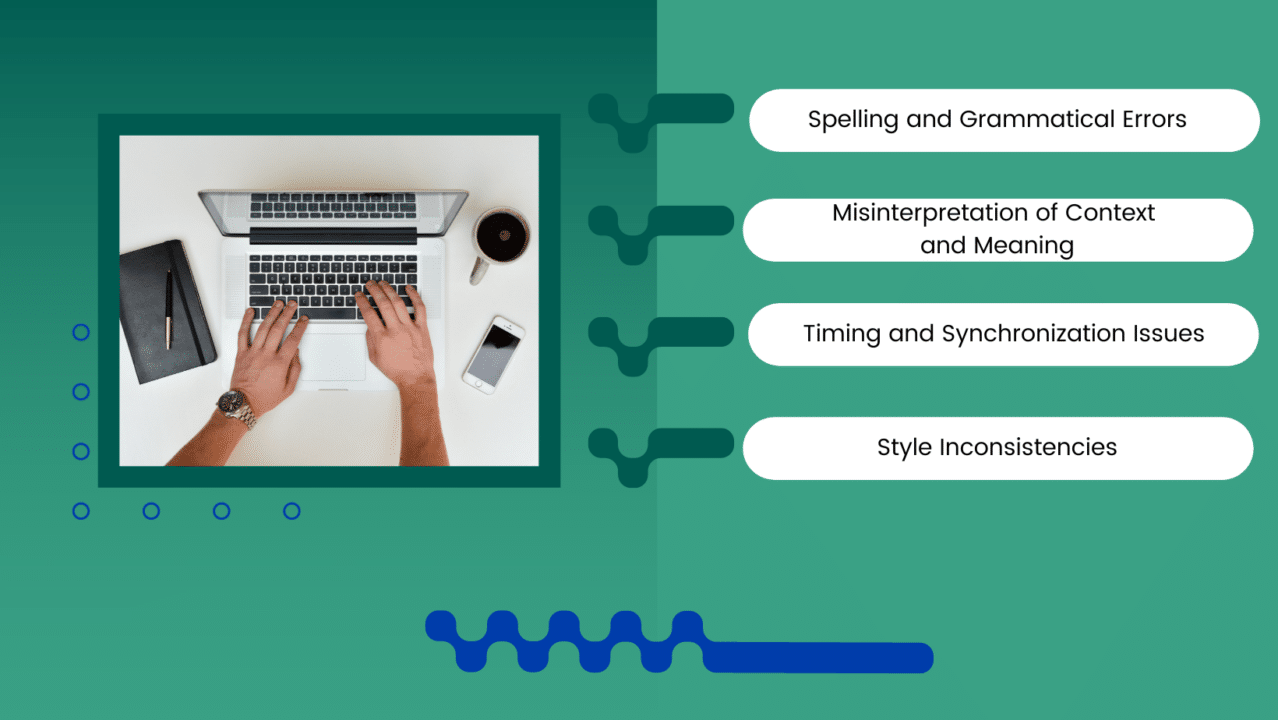
Spelling and Grammatical Errors
One of the most prevalent subtitling mistakes in news reporting is spelling and grammatical errors. In the fast-paced environment of newsrooms, subtitlers often work under tight deadlines, leaving little room for error-proofing. As a result, typos and grammatical mistakes can inadvertently find their way into subtitles. Such errors not only diminish the professionalism of the newsroom but can also lead to misunderstandings and misinformation. Implementing robust quality assurance procedures that involve thorough proofreading and spell-checking is essential to catch and rectify these mistakes before the content is broadcasted.
Misinterpretation of Context and Meaning
Translating news content requires more than just linguistic proficiency; it demands a deep understanding of the context and nuances of the information being presented. Misinterpretation of context and meaning is a grave subtitling error that can significantly impact the credibility of the newsroom. Inaccurate translations can alter the intended message, leading to confusion or misrepresentation of critical information. To mitigate this risk, quality assurance protocols should involve a team of skilled subtitlers who possess subject matter expertise and work collaboratively to ensure the accuracy and fidelity of the subtitles.
Timing and Synchronization Issues
Timing and synchronization play a crucial role in the effectiveness of subtitles. Subtitlers must strike a delicate balance between displaying text on the screen and the corresponding audio or visual content. Timing errors, such as delayed or premature subtitles, can disrupt the flow of information and distract viewers from the news. Ensuring precise timing requires meticulous attention to detail and adherence to industry-standard guidelines. Employing subtitling software with timing capabilities and conducting rigorous technical checks during quality assurance procedures can help address and rectify synchronization issues.
Style Inconsistencies
Consistency in style is a hallmark of professional subtitling and contributes to a seamless viewing experience for the audience. Style inconsistencies, such as varying font sizes, colors, or positioning of subtitles, can be jarring and diminish the visual appeal of the news content. Maintaining a cohesive style throughout the entire subtitling process is essential to uphold the newsroom’s brand identity and create a polished and cohesive appearance. Implementing style guides and conducting meticulous checks during the quality assurance phase can ensure that subtitles adhere to the predetermined style and maintain uniformity.
Establishing Quality Assurance Protocols
To ensure accuracy and reliability in subtitling, newsrooms must establish robust quality assurance protocols. These procedures act as the backbone of the subtitling process, guaranteeing that the final output meets the highest standards of professionalism and precision.
Pre-subtitling Preparations
- Transcription and Translation Guidelines
Before embarking on the subtitling journey, newsrooms must define clear transcription and translation guidelines. These guidelines lay the groundwork for the entire subtitling process, outlining standards for transcribing spoken dialogue and translating it into the target language. By establishing these guidelines, newsrooms create a framework for subtitlers to follow, ensuring consistency and accuracy throughout the project.
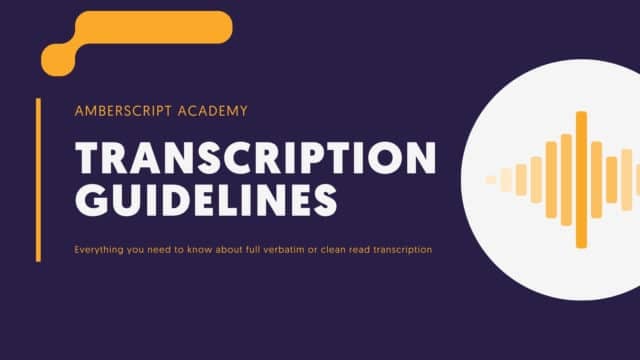
Find out more about our transcription guidelines
Find out more- Glossaries and Style Guides
Glossaries and style guides play a vital role in maintaining linguistic and stylistic consistency. They contain a curated list of specific terms, acronyms, and expressions commonly used in news reporting. Subtitlers refer to these glossaries to ensure accurate translations of frequently encountered words or phrases. Additionally, style guides define the visual appearance of subtitles, including font type, size, color, and positioning. Following these guidelines not only streamlines the subtitling process but also guarantees a polished and uniform final product.
Subtitling Software and Tools
- Selection and Familiarity with Industry-Standard Software
Selecting the right subtitling software is crucial for seamless workflow and efficient quality assurance. Newsrooms should invest in industry-standard software that offers a comprehensive set of features, such as precise timing controls, subtitle formatting options, and support for multiple languages. Moreover, subtitlers should undergo training to become proficient in using the chosen software, enabling them to make the most of its capabilities and streamline their subtitling process.
- Automation vs. Manual Intervention
Automation can significantly expedite the subtitling process, especially for larger projects. However, it’s essential to strike a balance between automation and manual intervention. While automated tools can handle repetitive tasks and ensure consistency, they might lack the contextual understanding required for accurate translations and timing. Relying on human subtitlers for nuanced decisions and meticulous checks during the quality assurance phase is vital to deliver high-quality subtitles that resonate with the audience.

Request a quote
Team Training and Skill Development
- Linguistic Proficiency and Subject Matter Expertise
Subtitling in a newsroom demands more than just linguistic proficiency. Subtitlers must possess a deep understanding of the subject matter they are working with to ensure accurate translations and contextually relevant subtitles. Newsrooms should assemble a team of subtitlers who not only excel in language skills but also possess expertise in the various topics covered in news reporting.
- Continuous Training and Workshops
The world of news is dynamic and constantly evolving, requiring subtitlers to stay updated with language trends and emerging terminology. Continuous training and workshops are essential for honing linguistic skills, staying abreast of the latest subtitling technologies, and learning from industry best practices. By investing in the professional development of their subtitling team, newsrooms can reinforce their commitment to delivering accurate and high-quality subtitles that enhance the audience’s viewing experience.
Step-by-Step Quality Assurance Procedures
Effective quality assurance procedures are pivotal in ensuring that subtitling in a newsroom meets the highest standards of accuracy and professionalism. This step-by-step guide outlines the essential processes to be followed to deliver flawless and reliable subtitles.
Initial Subtitling Process
- Transcribing the Content Accurately
The initial phase of subtitling involves accurately transcribing the spoken content. Transcribers carefully listen to the audio or video material and meticulously convert the spoken words into written text. Precision is paramount at this stage, as any inaccuracies or omissions can lead to errors in the subsequent translation and subtitling processes.
- Ensuring Precise Translations
Once the transcription is complete, the next crucial step is translating the transcribed text into the target language. Translators must possess a strong command of both the source and target languages to ensure accurate and contextually relevant translations. Adhering to the established translation guidelines and glossaries is essential to maintain consistency and to capture the intended meaning of the original content.
Review and Edit
- In-house Editor’s Role
After the initial subtitling process, an in-house editor plays a critical role in reviewing and refining the subtitles. The editor meticulously examines the translated text for accuracy, clarity, and adherence to the established style guide. Their expertise ensures that the subtitles align with the newsroom’s tone and voice, conveying the information succinctly and effectively.
- Collaborative Feedback Loops
Incorporating feedback is vital in the subtitling quality assurance process. The collaborative feedback loop involves close communication between the editor and the subtitlers, fostering an environment of continuous improvement. Any discrepancies or queries regarding translations, timing, or other elements are addressed and resolved through open dialogue, ensuring that the final subtitles are refined and error-free.
Technical Checks
- Timing and Synchronization Verification
Subtitles must be timed precisely to appear on the screen in sync with the corresponding audio or video content. A technical check is performed to verify the timing accuracy, ensuring that the subtitles appear and disappear seamlessly, without disrupting the viewer’s experience. Adjustments are made as needed to achieve flawless synchronization.
- Formatting and Styling Verification
The formatting and styling of subtitles contribute significantly to their readability and visual appeal. Technical checks verify that the chosen font, size, color, and positioning of subtitles comply with the established style guide. Consistency in formatting throughout the entire subtitling project enhances the professional look and feel of the subtitles.
Final Verification
- Consistency Check
Before finalizing the subtitles, a comprehensive consistency check is conducted. This involves ensuring that the same terminology and language style are maintained throughout the entire project. Consistent subtitles not only enhance the viewer’s understanding but also reflect the newsroom’s commitment to delivering accurate and reliable information.
- Proofreading and Final Adjustments
The last stage of the quality assurance process involves thorough proofreading of the final subtitles. Spelling, grammar, and punctuation are meticulously reviewed to eliminate any lingering errors. Any last-minute adjustments or refinements are made to ensure that the subtitles are of the highest quality before they are presented to the audience.
Incorporating Ethical Considerations
When it comes to subtitling in a newsroom, accuracy and credibility are paramount. However, alongside technical precision, newsrooms must also navigate the ethical dimensions of subtitling to ensure that information is conveyed responsibly and inclusively. Incorporating ethical considerations in the quality assurance process is essential to uphold journalistic integrity and foster a deeper sense of trust with the audience.
Avoiding Bias and Misrepresentation
Subtitling in a newsroom requires a keen awareness of potential biases and the responsibility to avoid misrepresentation. Subtitlers must steer clear of injecting personal opinions or prejudices into the translation process. Every effort must be made to provide an impartial and balanced representation of the news content. Newsrooms should establish clear guidelines and ethical codes that prioritize impartiality and objectivity in subtitling, ensuring that the subtitles reflect the core values of unbiased journalism.
Handling Sensitive or Controversial Content
Newsrooms often deal with stories that touch upon sensitive or controversial topics. When subtitling such content, special care must be taken to handle it with utmost sensitivity and respect for the individuals involved. Inaccurate translations or inappropriate language can exacerbate the emotional impact of such news, potentially causing harm or distress. Quality assurance procedures should involve a review process specifically tailored to address such sensitive content, where experienced subtitlers and editors collaborate to ensure that the subtitles strike the right tone and do not sensationalize or trivialize the news.
Maintaining Cultural Appropriateness
As newsrooms aim for a global audience reach, cultural appropriateness becomes a crucial consideration. Different cultures have varying norms, values, and sensitivities that must be respected in subtitling. Words, expressions, or gestures that might be acceptable in one culture can be offensive or misunderstood in another. Subtitlers need to be culturally aware and well-informed, ensuring that the translations remain respectful and relevant to the target audience. Quality assurance protocols should incorporate cross-cultural checks, involving native speakers and cultural experts who can validate the appropriateness of the subtitles.
The Role of Technology in Quality Assurance
In the digital era, technology has revolutionized the subtitling process in newsrooms, augmenting efficiency and precision. However, striking the right balance between automation and human oversight remains crucial to ensure accuracy and maintain the ethical dimensions of subtitling.
Automated QA Tools for Efficiency
Automated Quality Assurance (QA) tools have become invaluable assets in the subtitling workflow. These tools can swiftly detect and rectify common errors such as timing discrepancies, spelling mistakes, and formatting inconsistencies. The use of automated QA tools streamlines the subtitling process, enabling subtitlers to work more efficiently and meet tight deadlines. By identifying and resolving repetitive errors, these tools free up valuable time, allowing subtitlers to focus on more nuanced aspects of the subtitles, thereby enhancing overall quality.
Human Intervention for Nuanced Checks
While automation enhances efficiency, certain aspects of subtitling demand human intervention. Nuanced checks, such as verifying cultural appropriateness, ensuring accurate translations of context-specific terms, and preserving the subtleties of language, require the keen eye and understanding of experienced subtitlers. Human intervention is vital in upholding journalistic ethics, avoiding misrepresentation, and catering to the diverse cultural sensitivities of the audience.
Striking the Right Balance Between Automation and Human Oversight
Achieving an optimal balance between automation and human oversight is essential for the success of quality assurance procedures in subtitling. While automated tools can speed up the process and catch common errors, human subtitlers bring the contextual understanding and creative judgment required for producing accurate and engaging subtitles. By integrating automation strategically into the workflow, newsrooms can optimize efficiency without compromising on the quality and integrity of their subtitles.
Continuous Improvement and Feedback Mechanisms
Quality assurance in subtitling is not a one-time endeavor but a continuous process of refinement and growth. Newsrooms can foster a culture of improvement through regular audits, learning from mistakes, and actively seeking feedback from both internal and external sources.
Regular Audits and Evaluations
Conducting regular audits and evaluations is pivotal in identifying areas for improvement in the subtitling process. Newsrooms can assess the effectiveness of their quality assurance procedures, analyze trends in errors, and implement corrective measures to enhance the overall quality of subtitles. These audits also provide valuable insights into the performance of automated QA tools and the need for additional human intervention.
Learning from Mistakes and Updating Guidelines
Mistakes are inevitable, but they also present opportunities for growth. Newsrooms should treat errors as learning experiences and use them to improve their subtitling practices. Analyzing past mistakes allows newsrooms to update their guidelines, glossaries, and style guides to prevent similar errors in the future. An open and constructive approach to learning from mistakes fosters a culture of continuous improvement within the subtitling team.
Incorporating Feedback from the Audience
The audience’s perspective is a valuable asset in refining the subtitling process. Newsrooms should actively seek and incorporate feedback from viewers, whether through surveys, social media, or other channels. Audience feedback provides valuable insights into the clarity, accuracy, and overall satisfaction with the subtitles, helping newsrooms make data-driven decisions to enhance the subtitling experience.
Frequently asked questions
-
Can I burn the subtitles directly onto my video?
If you have exported the transcript as a SRT, EBU-STL or VTT file, you can easily burn them onto your video using video-editing software.
-
Can I change the position of the subtitles?
That needs to be done using a video editor like VLC. Go to Tools > Preferences [CTRL + P]. Under Show settings, select the option that says All to switch to the advanced preferences. Navigate to Input/Codecs > Subtitle codecs > Subtitles. Under Text subtitle decoder set, the Subtitle justification to left, right or center.
-
How do I add subtitles to a YouTube video?
To add subtitles to your Youtube video, simply add the file you have created using Amberscript to your video in the Youtube Studio. Click on “subtitles”, then “add” and finally “upload file” and select the SRT file.
-
How do I add subtitles to a video on Vimeo?
To add subtitles to your Vimeo video, simply add the file you have created using Amberscript to your video in the editing window on Vimeo. Click on “distribution”, then “subtitles” and finally click on the + symbol to upload the SRT file.
-
How do I order translated subtitles?
To order translated subtitles, you can upload your file like you would normally do. You can then select manual subtitling. Once you have selected this, an option will appear where you will be able to select the language the subtitles need to be translated to. If the language that you want is not one of the options you can contact us through our contact form.
-
To which languages can you translate subtitles?
For our human-made subtitling services we work with a network of language experts in 15 different languages. Find out which here. If the language you want is not on the list, please contact us through our contact form.
-
What subtitle file formats are supported?
Our software allows you to export the transcript from the video or audio file as an SRT, EBU-STL or VTT file.
Can I upload a VTT file to Youtube?
In the expansive world of YouTube, a platform where over 500 hours of video are uploaded every minute, how can you ensure your content stands out and is accessible to a global audience? One effective tool at your disposal is the use of subtitles. More than just an aid for the hearing-impaired or non-native speakers, subtitles can significantly boost your video’s reach and even its SEO performance. Among the various file formats YouTube supports for subtitling, VTT files hold a prominent place. But what exactly are VTT files, and can you upload them directly to YouTube for your video’s subtitles? This article aims to demystify VTT files, explore their compatibility with YouTube, and guide you on how to leverage them for your content.
Table of Contents
- Understanding Subtitling on YouTube
- Can I Upload a VTT File to YouTube?
- Benefits of Using VTT Files for YouTube Subtitling
- Best Practices for Subtitling Content on YouTube
Understanding Subtitling on YouTube
Subtitling on YouTube can be accomplished in two primary ways: through automatic captions generated by YouTube’s inbuilt system, and manual subtitles that you can create and upload yourself.
Automatic Captions
YouTube’s automatic captions system utilizes voice recognition technology to generate captions for videos. The system listens to the audio track of your video, transcribing spoken words into text and synchronizing them with your video. It’s a great starting point, especially for those new to the world of subtitling.
However, it’s important to note that this system, while impressive, is not perfect. Mispronunciations, background noise, or complex jargon can lead to inaccuracies in the generated captions. Additionally, it may not perfectly sync the captions with the audio, which can lead to a disconnect for the viewer.
Manual Subtitles
On the other hand, manual subtitles allow for greater control and accuracy as you can input the exact text and timings you want for your video subtitles. YouTube provides the option to upload subtitle files in various formats, including SRT, SBV, and VTT. Each format has its own structure and syntax, and may be preferred depending on your specific subtitling needs or the tools you are using to create your subtitle file.
Manual subtitles have the advantage of increased accuracy and customization. You can ensure the subtitles perfectly match your video’s audio and make adjustments as necessary. This can greatly enhance the viewer experience, especially for those relying on subtitles to understand your content.
To add manual subtitles, you’ll need to navigate to your Video Manager, select the video you want to add subtitles to, click on “Subtitles and CC”, select “Add new subtitles or CC”, choose the language, and then either upload your subtitle file or manually type in your subtitles and their corresponding timings.
How to obtain subtitles with Amberscript
For individuals seeking to add subtitles to their videos, Amberscript stands out as an excellent option. Its user-friendly interface, compatibility with diverse devices, and an array of customization choices enable users to craft compelling and impactful subtitles with ease. All you have to do is upload your file and choose what type of service you prefer, and we’ll take care of the rest.

Can I Upload a VTT File to YouTube?
The question brings us to the crux of our discussion – is it possible to upload a VTT file to YouTube? The answer is a resounding yes. YouTube does support the VTT format for subtitles.
VTT File Format Explained
Before delving into the process, it’s important to understand what VTT files are and how they’re structured.
- What is a VTT File?
VTT, or WebVTT (Web Video Text Tracks), is a popular file format for subtitles. Its structure is simple and straightforward, making it easy to create even manually, though there are many tools available that can assist in creating VTT files.
- Structure and Syntax of VTT Files
A VTT file begins with the line “WEBVTT”. Each subtitle cue in the file has a unique identifier, followed by the time range during which the subtitle should be displayed, and then the subtitle text itself.
Compatibility with YouTube’s Subtitling System
YouTube’s compatibility with the VTT format makes it easy to upload these files as subtitles for your videos. In fact, while YouTube supports multiple formats for subtitle files (SRT, SBV, and VTT), VTT holds an edge due to its advanced formatting capabilities and ease of use. Uploading a VTT file is as simple as selecting the “Upload a file” option in the “Subtitles/CC” tab of the Video Manager, choosing your VTT file, and clicking “Upload”.
Converting VTT to Other Supported Formats (SRT, SBV)
While directly uploading VTT files is supported, there might be instances where you may need to convert your VTT files to other formats such as SRT or SBV.
VTT to SRT Conversion
There are several online tools available that can help convert VTT files to SRT (SubRip Subtitle) format. The process is typically as simple as uploading the VTT file, selecting the desired output format, and initiating the conversion.
VTT to SBV Conversion
Similar to the above, there are tools that can convert VTT to SBV (YouTube’s proprietary subtitle format) if needed. However, given the broad acceptance of VTT files, you’ll find that a direct VTT upload will often suffice.

If you want to learn more about VTT Files
Read the Guide!Benefits of Using VTT Files for YouTube Subtitling

Choosing to use VTT files for your YouTube subtitles can bring a multitude of benefits.
Superior Formatting Options
VTT files support more advanced formatting options compared to other formats. This allows for a customized and enhanced viewer experience, as subtitles can include different colors, sizes, and positioning on the screen.
Broad Compatibility
VTT files are widely accepted across various platforms, not just YouTube. This means you can use the same subtitle file across multiple video hosting platforms, saving considerable time and effort.
Easy to Create and Edit
The structure and syntax of VTT files are straightforward, making them easy to create and edit. Even if you’re manually creating subtitle files, VTT files can be done without complex software or technical knowledge.
Enhanced SEO Performance
Using VTT files can potentially enhance your video’s SEO performance. The text in VTT subtitles can be indexed by search engines, improving the visibility and searchability of your video content.
Greater Accessibility
Finally, VTT subtitles can make your videos more accessible to a wider audience. They can cater to people who are hard of hearing, non-native speakers, or those who prefer to watch videos with subtitles. This can significantly increase your video’s reach and impact.
Best Practices for Subtitling Content on YouTube
Creating subtitles for your YouTube videos is not just about providing text for the spoken content. It also involves ensuring that your subtitle text aids understanding and improves viewer engagement. Here are some best practices to keep in mind:
Accurate Transcription
It’s crucial that your subtitles accurately represent the spoken content in your videos. This includes capturing spoken words correctly, but also transcribing relevant non-verbal sounds that contribute to the understanding of the video content.
Synchronized Timing
Ensure that your subtitles match the timing of the spoken content. Subtitles that appear too early or too late can confuse viewers and disrupt the viewing experience.
Readable Format
Ensure that your subtitles are in a format that is easy to read. This includes choosing a font size and color that are clear against the video background. Additionally, consider the length and speed of your subtitles – viewers need enough time to read and understand the text before it disappears.
Use of Language
Use simple, clear language in your subtitles for ease of understanding. Avoid complex sentences and jargon where possible. If your video uses technical terms, consider adding explanations or definitions in the subtitles to aid viewer comprehension.
Testing and Revision
Test your subtitles by watching your video with them turned on. This can help you spot any errors or areas for improvement. Don’t hesitate to revise your subtitles and upload the updated file if necessary, to ensure the best viewing experience.
Consider Automatic Translation
If your audience includes non-English speakers, consider using YouTube’s automatic translation feature to provide subtitles in multiple languages. Remember, though, that automated translations may not always be accurate, so manual checking and revision may be required.
Accessibility
Keep in mind that subtitles are an important accessibility tool for many viewers, including those who are deaf or hard of hearing. Make sure your subtitles are comprehensive, including transcriptions of important sound cues and not just dialogue.
These best practices can help you create subtitles that enhance your YouTube videos, making them more accessible and engaging for your viewers.

Get a customized offer
Request a quote for your subtitling needs
In conclusion, VTT files have proven themselves to be a powerful and flexible tool for providing subtitles on YouTube. Their usage is not only straightforward but also offers various notable advantages such as superior formatting, broad compatibility, ease of creation and editing, improved SEO performance, and accessibility. Meanwhile, remember to follow the best practices for subtitling on YouTube, such as ensuring accurate transcription, synchronized timing, readability, simplicity of language, and testing and revision. Though it may seem like a minor detail, well-executed subtitles can significantly enhance the viewer experience, improving engagement and accessibility of your content. So, don’t hesitate to make the most out of VTT files in your YouTube journey.
From Melodies to Lyrics: How to Transcribe Song Lyrics into Lyrics
In the world of music, song lyrics have deep meaning and resonate with audiences on an emotional and intellectual level. From conveying powerful messages to evoking memories and emotions, lyrics play a crucial role in shaping the impact of a song. Whether it is an anthemic chorus that unites the crowd or poetic verses that speak to the soul, the power of lyrics cannot be underestimated.
As music fans, we often long to delve into the words that move us, which brings us to the intriguing subject of extracting song lyrics as lyrics. Thanks to advances in technology, it has become possible to transcribe songs as lyrics using automatic speech recognition (ASR) tools. In this post, we will explore how this process works and how it allows us to better appreciate and analyse the essence of our favourite songs, revealing the hidden beauty and artistry behind the melodies we love.
Table of Contents
1- Getting to know ASR Tools
2- Preparing the Song for Transcription
3- Transcribing the Song Text
4- Reviewing and Editing the Transcript
5- Copyright and Song Lyrics Transcription
6- Embracing the Magic of Music with Amberscript
Getting to Know ASR Tools
Automatic Speech Recognition (ASR) is an innovative technology that has revolutionised the way we interact with audio content. ASR is an advanced system designed to convert spoken language, including human speech from audio recordings, into written text. This extraordinary capability has opened up a world of possibilities in various fields, from transcription services to voice-controlled virtual assistants. The role of ASR in converting audio into text is crucial, as it allows us to extract valuable information and insights from audio data that would otherwise remain inaccessible.
The most widely used ASR tools for transcription include industry-leading services such as Google Cloud Speech-to-Text, known for its high accuracy and extensive language support. In addition, IBM Watson Speech to Text has also gained popularity due to its robust capabilities and linguistic flexibility. These tools have become indispensable for professionals, researchers and music enthusiasts, as they unlock song lyrics and offer new avenues to explore the artistic genius contained within the realm of music.
When it comes to extracting song lyrics, one name stands out as a reliable and efficient transcription tool: Amberscript. Amberscript has quickly gained a reputation for its top-notch automatic speech recognition (ASR) capabilities, making it the ideal choice for music fans, content creators and researchers. With its user-friendly interface and state-of-the-art technology, Amberscript simplifies the process of transcribing audio into accurate, readable text.
What sets Amberscript apart is its impressive accuracy even with complex song lyrics and difficult audio conditions, such as background noise or multiple voice levels. Whether discovering the words of an iconic classic or decoding the lyrics of a newly released hit, Amberscript guarantees a reliable and seamless transcription experience.
With Amberscript at your disposal, exploring the poetic artistry and emotional depth of your favourite songs has never been easier. Say goodbye to the days when you had to strain your ear to catch every single line and embrace the convenience and accuracy of Amberscript for all your lyric transcription needs.
Preparing the Song for Transcription
Before embarking on the exciting journey of extracting song lyrics with automatic speech recognition (ASR) tools, it is essential to prepare the song to ensure a smooth and accurate transcription process. Preparing the song involves performing some simple but crucial tasks that can have a significant impact on the quality of the transcription.
From ensuring that the song is in a compatible audio format to minimising background noise and improving audio clarity, these preparatory measures lay the foundation for successful transcription. In this section we will delve into the key aspects of track preparation, providing you with the knowledge you need to optimise the audio and unleash the true essence of the music through accurate and reliable transcription.
The importance of having the track in digital format
In the digital age of music, the format in which a song is stored plays an important role in many ways, especially when it comes to extracting the lyrics as lyrics. Having the song in a digital format, such as MP3, WAV, FLAC or other commonly supported audio formats, is of paramount importance for several reasons. Firstly, digital formats preserve the quality and fidelity of the song’s audio, ensuring that every subtle nuance and vocal expression is accurately captured during transcription.
Secondly, ASR tools are optimised to work with digital audio and using a compatible format improves the efficiency and accuracy of the tool in converting audio to text. In addition, digital files are easily shared and accessible, making it convenient to use the transcription in different applications and platforms. By having the song in digital format, we not only preserve the integrity of the music, but also pave the way for an accurate and seamless lyric transcription process, allowing us to delve deeper into the profound beauty of the song’s words.

Ensuring better transcription results: Audio quality considerations
When it comes to extracting song lyrics as text using automatic speech recognition (ASR) tools, the quality of the audio source can have a significant impact on transcription results. To ensure a smoother and more accurate transcription process, it is essential to consider certain aspects of audio quality.
First, choosing high-quality audio recordings minimises the risk of distortion or loss of important vocal details during transcription. Clear, well-recorded audio makes it easier for the ASR tool to accurately distinguish different words and pronunciations, resulting in more accurate texts. In addition, reducing background noise and eliminating any potential audio interference increases the instrument’s ability to focus on the voice, further improving transcription accuracy.
In addition, if the song has multiple vocal layers or instrumental overlaps, it may be useful to isolate voices or use instrumental versions to achieve cleaner audio for transcription. By paying attention to these audio quality considerations, we can elevate the transcription process, ensuring that the essence and beauty of the song’s lyrics are flawlessly captured as lyrics.
Transcribing the Song Text
Uploading to your chosen ASR tool
Embarking on the exciting journey of transcribing the lyrics of your favourite song into lyrics is made easy with a step-by-step guide on loading the song into your chosen automatic speech recognition (ASR) tool. First, make sure you have chosen a reliable ASR tool that supports audio transcription of songs. Once you have chosen the tool, create an account or log into your existing one.
Then, locate the option for audio transcription and select the audio file of the song you want to transcribe. Depending on the tool, you can either upload the song directly from your device or provide a URL to an online audio source. Once uploaded, the ASR tool will start processing the audio, converting the song voices into written text. Patience is key at this stage, as large audio files may take some time to be fully transcribed.
Once the process is complete, you will be presented with the transcribed text on the platform. Review the lyrics for accuracy and make any necessary changes to ensure that the transcription reflects the true essence of the song. With this user-friendly guide, you can effortlessly transform a catchy melody into a lyrical masterpiece, ready to be enjoyed in all its poetic glory.
Transcribe song lyrics with Amberscript: A step-by-step guide
Amberscript, a state-of-the-art software package, is the gateway to translating audio recordings of your favourite songs into lyrics. Here is a simple guide on how Amberscript works its magic in transcribing song lyrics:
1- Uploading the file:
Start by uploading the audio file of your song to the Amberscript platform. Whether on your computer or an online archive, the process is simple and hassle-free.
2- Language and audio preferences:
Select the language of the song and your audio preference, whether you want a transcript of the lyrics or subtitles, according to your specific needs.
3- Automatic speech recognition:
Amberscript uses sophisticated automatic speech recognition technology to transform song audio into written text. The powerful algorithm guarantees amazing accuracy in converting sung words into a textual masterpiece.
4- Editing and proofreading:
Once the transcription is complete, you can review and edit the text using Amberscript’s simple editor. Correct any errors, add punctuation and make the necessary changes to perfect the transcription of the text.
5- Export and integrate:
Once the revision is complete, you receive an e-mail notification and save the transcript in various formats, such as Microsoft Word, PDF or plain text. Amberscript also offers integration options that allow transcripts to be seamlessly transferred to other programmes or platforms in your workflow.
Transcribing texts has never been easier. Start now and save hours of time!
Transcribe audio and video into text without errors and receive a perfect export.
GDPR-compliant security and protection. Your files are stored confidentially in a secure environment.
Are you ready to improve your song lyric transcription process? Try Amberscript now for fast, accurate and efficient transcription. Experience the convenience of a free trial or explore our pricing plans by clicking here. Discover the poetic beauty of song lyrics like never before!
Reviewing and Editing the Transcript
As we dive into the fascinating process of transcribing song lyrics with Amberscript, it is essential to understand the importance of reviewing and editing the transcript. Although Amberscript boasts impressive accuracy, certain factors can lead to occasional errors in the output. The most common errors may be the misinterpretation of homophonies, especially in songs with poetic language, or inaccuracies in capturing the unique pronunciations or accents of performers. In addition, background noise or overlapping vocal levels can create problems during transcription, causing slight discrepancies in the lyrics.
However, Amberscript simplifies the review and editing process by allowing users to play back the audio along with the transcription, ensuring accurate alignment. By actively listening and comparing the audio with the text, any errors or inaccuracies can be easily identified and corrected. Amberscript’s intuitive interface also allows for manual editing, where changes can be made to words or phrases to achieve a flawless transcription. Amberscript’s combination of cutting-edge technology and user-friendly tools allows us to perfect the transcription in its most authentic form, preserving the beauty of the lyrics and the artistic essence of the song for everyone.
Improving Transcription Quality: Tips for Manual Improvement
Although Amberscript offers remarkable accuracy in transcribing song lyrics, in some cases manual adjustments can further improve transcription quality. Here are some valuable tips to achieve a precise and refined result. First of all, before reviewing the transcription, it is good to familiarise yourself with the lyrics of the song. Preliminary knowledge of the lyrics helps to quickly identify any discrepancies.
Secondly, pay attention to context and meaning. In poetic songs, some words or phrases may have multiple interpretations, so understanding the context helps to select the most appropriate option. Third, use audio playback timestamps to identify specific segments to edit, making the process more efficient. Also, listen for background noise or voice overlaps and carefully isolate texts to eliminate any confusion.
If you find unclear or ambiguous words, try searching for official text sources or reliable websites to cross-check and verify. Finally, remember that transcription is a collaborative effort between technology and human touch. Use your creative instincts and linguistic expertise to perfect the transcription, ensuring that the brilliance of the song lyrics shines through in all its glory. Using these manual enhancement tips or Amberscript’s manual services, you can take transcription quality to new levels, savouring the artistry and depth of your favourite songs like never before.
Copyright and Song Lyrics Transcription
When entering the fascinating world of song lyric transcription, it is essential to tread carefully through the complex landscape of legal and ethical considerations, particularly when it comes to copyright issues. Song lyrics, like any creative work, are protected by copyright law, which grants exclusive rights to the original creators or their publishers.
Transcribing and reproducing copyrighted lyrics without proper authorisation may lead to legal consequences. Therefore, it is essential to obtain permission from the copyright holders before using or sharing transcripts in any public or commercial context. In addition, some songs may be subject to more stringent licensing agreements, especially in cases where lyrics have been incorporated into other copyrighted works, such as films or advertisements.
As responsible users of transcription tools such as Amberscript, we must prioritise ethical practices and respect the intellectual property rights of artists and content creators. While transcription is a valuable tool for exploring and appreciating the beauty of song lyrics, complying with copyright laws and seeking appropriate permissions safeguards the integrity of the creative process and promotes a fair and supportive environment for artists around the world.
Respect copyright: Seek permission before use
As music fans, the appeal of transcribing song lyrics to discover the essence of our favourite melodies is undeniable. However, it is crucial to remember that these lyrics are creative works protected by copyright laws. Before using transcribed lyrics for any purpose beyond personal enjoyment, it is essential to seek permission from the copyright holders. Whether you intend to share transcripts on social media, embed them in a video or use them for commercial purposes, it is essential to obtain explicit consent.
Respecting the intellectual property rights of artists and authors is not only a legal obligation, but also an ethical responsibility. Proper authorisation not only protects you from potential legal consequences, but also supports and encourages the artistic community by recognising the value of its creations. Therefore, before embarking on exciting projects involving the transcription of texts, take the time to get in touch with copyright holders, show appreciation for their work and ensure that your initiatives remain within the law. Remember that responsible use of transcribed lyrics strengthens the bond between music fans and artists, fostering a harmonious creative environment for all.
Embracing the Magic of Music with Amberscript
In this journey of extracting song lyrics as text, Amberscript’s advanced ASR technology has enriched our appreciation of the depth of music lyrics. From song preparation to precise transcription, Amberscript simplified the process effortlessly. Proofreading and editing ensured accuracy, while copyright compliance safeguarded creativity. With Amberscript as an ally, we celebrate the poetic harmony of music, appreciating every word and embracing the infinite beauty of our favourite songs.
Enter the enchanting realm of transcribing song lyrics while respecting copyright laws and ethical considerations. Respect the artistry of artists by asking permission before using transcribed lyrics beyond personal enjoyment. Amberscript’s powerful ASR technology makes this musical journey precise and captivating. Let the poetic harmony of your favourite songs come to life. Start your exploration responsibly and use Amberscript to transcribe the lyrics. Unleash the magic of music’s profound words. Happy transcription!
Why Free to Use Speech to Text Tools Maybe Aren’t Enough for Your Business
In the rapidly evolving digital world, the popularity of speech to text tools is skyrocketing. These utilities, especially the free-to-use variants, have become an essential part of our daily digital interactions, offering convenience and contributing to enhanced productivity. However, while these free tools are undoubtedly appealing for casual users, they may fall short of meeting the diverse and complex demands of business environments. This paper aims to delve deeper into this subject, arguing that despite the allure of cost savings, the limitations of free speech to text tools may not make them the perfect fit for business needs. It is crucial for businesses to consider the unique requirements of their industry, prioritizing accuracy, customization, security, and reliable customer support over the appeal of free tools.
Table of Contents
- The Appeal of Free Speech to Text Tools
- Limitations of Free Tools in a Business Environment
- Business-Specific Requirements
- Support and Customer Service
- Professional Speech to Text Solutions
The Appeal of Free Speech to Text Tools
In the realm of digital utilities, the appeal of free speech to text tools is undeniable. These tools cater to a wide audience, offering a level of convenience and efficiency that makes them a favorite among casual users. Companies like Google and Microsoft offer free versions of their speech to text tools, and these have seen extensive use in myriad applications, from creating quick notes to transcribing interviews.
One of the key attractions of these free tools is undoubtedly the cost-saving aspect. For individual users and small-scale applications, these tools present a cost-effective and efficient solution. They eliminate the need for manual transcription, saving time and effort, thereby enhancing productivity. This cost-effectiveness coupled with the convenience of use is what makes these free tools so attractive. However, as the scale of operations increases, one might start to see the cracks in the façade.
Limitations of Free Tools in a Business Environment
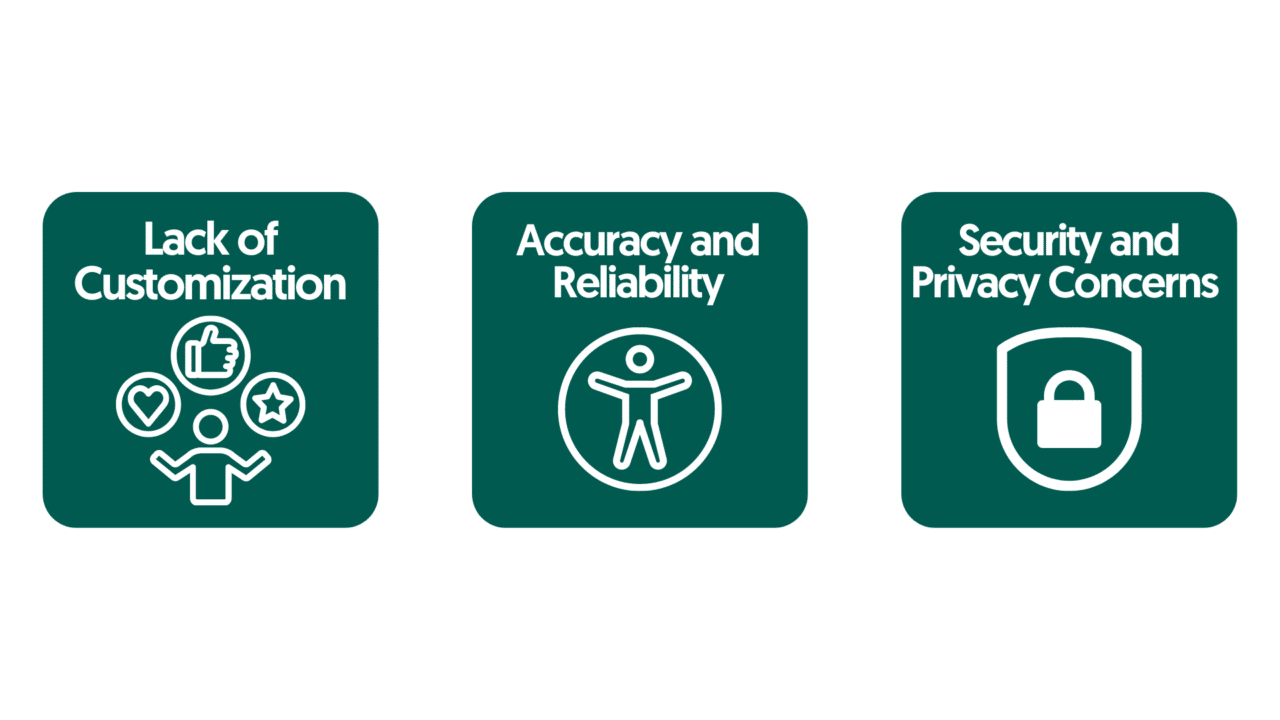
Free speech to text tools, while offering cost-saving benefits and easy usability, have certain limitations when deployed in a business environment.
Lack of Customization
Free tools are designed with a generic user base in mind, catering to a wide array of casual users. This broad focus often fails to meet the specific needs of businesses, especially those that require industry-specific terminology and jargon. For instance, businesses in the medical, legal, or technological sectors often utilize niche terminology that may not be effectively recognized or transcribed by free tools.
Accuracy and Reliability
In a professional setting, the accuracy and reliability of transcription are paramount. Errors in transcription can lead to misunderstandings, miscommunications, and in some cases, could even have legal implications. Free speech to text tools, while decently accurate for everyday conversation, may not always maintain this accuracy when it comes to the precise language often used in business communications.
Security and Privacy Concerns
When handling sensitive business data, security and privacy are of utmost importance. Free speech to text tools may not offer the level of data security that businesses require. There’s always a risk of data leakage or breach when using these free tools, as they often do not come with robust security measures. This risk is amplified when dealing with sensitive information like client data, proprietary information, or strategic communications. Businesses must consider these potential security pitfalls before opting for free speech to text tools.

Learn more about Speech to text tools
Read the blogBusiness-Specific Requirements
Tailored Solutions
Businesses, particularly those operating in specialized sectors, often require solutions that are tailored to their unique needs. From recognizing industry-specific jargon to handling complex terminologies, the requirements of businesses can vary significantly from those of casual users. Free speech to text tools, being designed for a generic audience, may not offer the nuanced understanding and recognition of these specialized requirements.
Integration with Existing Tools
Seamless integration with existing tools and software is another imperative for businesses. This integration allows for smoother workflow and increased productivity. However, free tools often lack the needed integration capabilities. As a result, businesses might face challenges in harmonizing their operations, leading to potential hiccups in productivity.
Support and Customer Service
In the event of issues or difficulties, businesses need prompt and efficient customer support. Free tools typically do not provide the same level of customer service as their paid counterparts. Limited support and slower response times could lead to longer downtimes, impacting the smooth functioning of business operations.
Regular Updates and Maintenance
Speech to text technology is continually evolving. Regular updates and improvements are critical to stay on par with the latest advancements. Free tools may not provide regular updates or may lag in incorporating the most recent features, potentially leading to outdated usage and decreased efficiency.

Get a customized offer
Request a quote for Speech-to-Text API
Support and Customer Service
One of the most overlooked yet vital aspects of any digital tool is the support and customer service it provides. Businesses often encounter unexpected issues in their operations, and during these times, a reliable support team becomes invaluable. This is where free speech to text tools often fall short. Free tools, due to their cost-free nature, typically don’t offer the same level of customer support that paid services do. They may not have dedicated teams to handle inquiries or troubleshooting problems, leading to slower response times. In an environment where every minute counts, these delayed responses can lead to significant disruptions in business operations. In contrast, premium speech to text services generally invest in providing robust customer service, ensuring that any issues are promptly addressed, mitigating downtime, and ensuring the smooth continuation of business operations. Therefore, when considering the appeal of free tools, businesses must weigh these potential downsides against the cost savings.
Professional Speech to Text Solutions
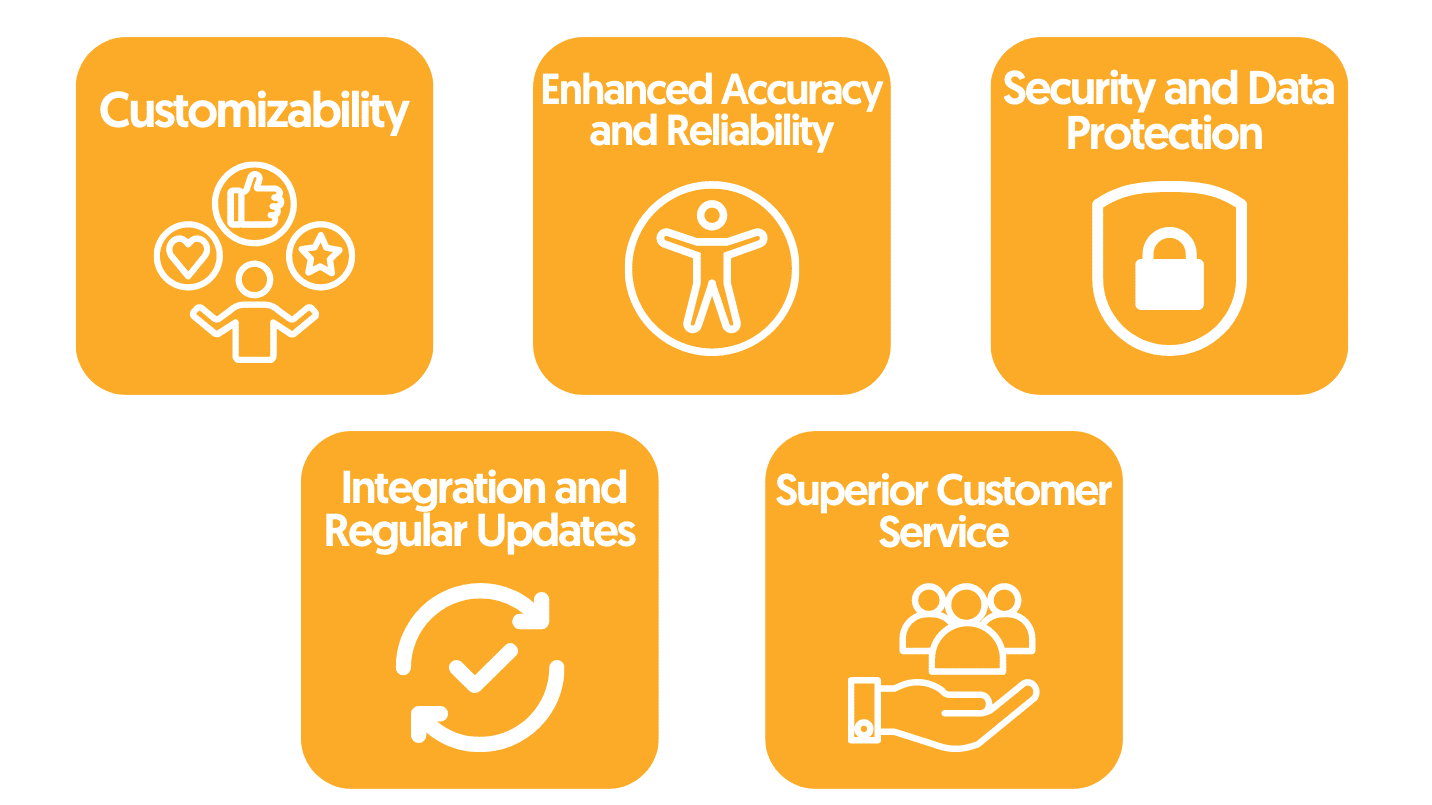
Professional speech to text solutions offer a comprehensive answer to the limitations encountered with free tools. These solutions are designed with a business-centric approach, providing features and functionalities that cater specifically to the needs of businesses across various sectors.
Customizability
Unlike their free counterparts, paid speech to text services are usually customizable, allowing businesses to tailor the tool to suit their specific requirements. This feature enables the tool to handle industry-specific jargon and complex terminologies effectively, enhancing the overall accuracy of transcription.
Enhanced Accuracy and Reliability
Professional speech to text solutions prioritize accuracy and reliability, recognizing the significance of these factors in a business environment. They utilize advanced algorithms and machine learning techniques to ensure the highest levels of transcription accuracy, reducing the chance of misunderstandings and miscommunications.
Security and Data Protection
Paid services typically offer robust security features to safeguard the sensitive data handled during transcription. These measures include end-to-end encryption, stringent data access controls, and secure data storage and transfer protocols. This strong focus on security and data protection makes professional solutions a more reliable choice for businesses.
Seamless Integration and Regular Updates
Professional services often support seamless integration with existing business tools and software, promoting a smooth workflow and efficient operations. Additionally, they ensure regular updates and improvements, incorporating the latest advancements in speech to text technology, and maintaining the tool’s relevance and efficiency.
Superior Customer Service
Paid speech to text services understand the value of reliable customer support. They invest in providing quality customer service to address any issues promptly and effectively, minimizing downtime and ensuring the smooth continuation of business operations.
In conclusion, while free speech to text tools may appear attractive due to their cost-saving benefits, businesses must consider their limitations. Professional speech to text solutions, though more expensive, provide the customizability, accuracy, security, and support that businesses need for efficient and secure operations.
Our services are
5x average time saving by using AI.
Enabling an accurate flow of audio-to-data, adjustable in our easy to use online text editor.
GDPR compliant security and safety.
In sum, while free speech to text tools may initially appear cost-effective, they may not meet the demanding needs of a business environment. The limitations in customization, integration capabilities, regular updates, and customer service can impact operational efficiency and pose potential security concerns. On the other hand, professional speech to text solutions, though they come with a price, deliver enhanced accuracy, robust security, seamless integration, and reliable customer support. These factors collectively contribute to smoother, more efficient operations. Therefore, businesses need to consider these aspects before choosing between free and professional speech to text tools.
Frequently Asked Questions
-
How accurate is the speech recognition?
Our speech recognition software can deliver the highest level of accuracy on the market. To increase accuracy, you can request a customized engine, which includes specific terms, accents or vocabulary. To find out more, please contact us here.
-
Is it possible to train the speech recognition on specific vocabulary?
Yes it is, and it will help to make the speech recognition software more accurate. For more information, please contact us here.
-
Can you transcribe audio with foreign accents?
Yes, our software is constantly being trained to pick up on accents and know how to understand them. Want to know more about how this works? Read it here!
-
Do you add timestamps?
Yes, our software automatically adds timestamps, which you can edit if you wish to do so in our online editor.
-
Do you offer services in other languages?
Yes, we do. Our software supports 39 different languages and we manually transcribe through our network of professional transcribers in 15 different languages, but if you have a request for another language please contact us through our contact form.
-
Do you provide bulk discounts?
Yes, we are able to offer a special rate for requests above 100h. Please request a quote here.
-
Do you transcribe files with multiple speakers?
Yes, our software can transcribe multi-speaker files and can also distinguish different speakers in the transcript. Different speakers will be indicated as “speaker 1”, “speaker 2”, etc. You can rename speakers in the online editor.
-
How can I improve the accuracy of the transcript?
The accuracy can be improved by ensuring that the quality of the audio in your file is the best it can possibly be. Want to know how to optimize your audio? Read it here!
-
Are there limitations on the number of files I can upload?
No, you can upload as many files as you would like.
-
Can you also deliver transcriptions for other media formats?
We deliver data annotation for speech-to-text solutions. However, if you have a special request, please contact our sales team here.
-
Can you automatically detect the language of an audio file?
No, our standard API does not support language detection, however please reach out to our sales team here in order to find the perfect solution for your situation as we do have access to this technology.
How to Insert Closed Captions into a VTT File: A Step-by-Step Guide
In today’s digital era, video content reigns supreme. Yet, without closed captions, a significant portion of the global population is excluded from fully enjoying these multimedia experiences. Herein lies the importance of WebVTT (VTT) files. They are the unsung heroes that provide a critical link for those who are deaf, hard of hearing, or simply prefer to have text accompanying their video content. This article serves as a comprehensive guide on how to insert closed captions into a VTT file. We’ll explore the key differences between closed captions and subtitles, understand the benefits of the VTT format, and delve into the intricacies of preparing your captions, using the right text editor, and ultimately creating and synchronizing captions with your video. Additionally, we also take a look at how to validate, test, and upload your VTT file, explore advanced caption features, and share best practices to ensure your content is accessible and inclusive. So, whether you’re a content creator, an editor, or simply curious about the digital world, read on to unlock the power of VTT files and closed captions.
Table of Contents
- Understanding VTT Files and Closed Captions
- Preparing Your Closed Caption Text
- Choosing the Right Text Editor for VTT Files
- Creating the VTT File and Inserting Captions
- Synchronizing Captions with the Video
- Validating and Testing the VTT File
- Uploading the VTT File to Your Video
- Advanced Closed Caption Features
- Best Practices for Closed Captions and VTT Files
Understanding VTT files and Closed Captions
What is a VTT File?
Web Video Text Tracks (WebVTT or VTT) is a popular file format used for displaying captions and subtitles on HTML5 videos. These plain text files contain both the timing and content of what needs to be displayed alongside your video. This technology offers an easy and effective way to improve the accessibility of your multimedia content.
Closed Captions vs. Subtitles: Key Differences
Though commonly confused, closed captions and subtitles serve distinct purposes. Subtitles are designed for viewers who can hear but may not understand the language spoken in the video. They generally only provide a translation of the dialogue. On other hand, closed captions cater to the deaf or hard of hearing viewers. They not only transcribe dialogues but also include relevant non-speech elements such as sound effects and musical cues.
Advantages of Using VTT Format for Closed Captions
The VTT format has several advantages. Firstly, it is a standard format supported by all modern browsers, ensuring compatibility across different platforms. Additionally, it supports caption styling and positioning, allowing you to enhance the viewer’s experience by adjusting the captions to avoid covering on-screen content. Lastly, VTT files are straightforward to create and edit, making them a practical choice for most video content creators.
Preparing Your Closed Caption Text
Before we jump into the technicalities of VTT files, we need to prepare our closed caption text. This process involves three key steps:
Transcribing the Video Content
The first step to prepare your closed caption text is to transcribe the video content. This means converting all the spoken words into written text. Be sure to include essential non-speech sounds that contribute to understanding the video’s context, such as [applause] or [laughter]. You can easily request a professional transcript on our platform, to ensure you get the most accurate file possible. However, if you want to customize the captions yourself, you can also use our automatic service and obtain your transcription within minutes.
Formatting the Caption Text
After transcribing, we need to format the caption text. Break down your content into concise, easy-to-read chunks, typically two lines or less. Remember, the goal of closed captions is to make content accessible, so avoid complex sentences that might be hard to follow.
Timecodes and Synchronization
Now, for each caption, we need to decide when it should appear and disappear on the screen. These timings are called ‘timecodes’. Timecodes synchronize the captions with the corresponding spoken words in the video. Precision here is critical to ensure a seamless viewing experience.
Remember, preparing your closed caption text is a crucial step in the process. It serves as the foundation for the VTT file we’re about to create.
If you want to learn more about Video Transcription
Read the Guide!Choosing the Right Text Editor for VTT Files
The selection of the right text editor is paramount when working with VTT files. There are several options available, and the choice depends on your specific needs and comfort level.
Built-in Editors in Video Platforms
Most video platforms, such as YouTube and Vimeo, come with built-in closed caption editors. They allow you to directly transcribe and timecode your captions within the platform. This could be a convenient option if you’re looking for a streamlined process and are comfortable working within the video platform itself.
Third-Party Text Editors with VTT Support
If you prefer a more hands-on approach, you can use a third-party text editor that supports VTT files, as these editors offer more flexibility and control over the formatting and timing of your captions. Examples include Amberscript, one of the best solutions for creating polished VTT files quickly and easily.
How it works
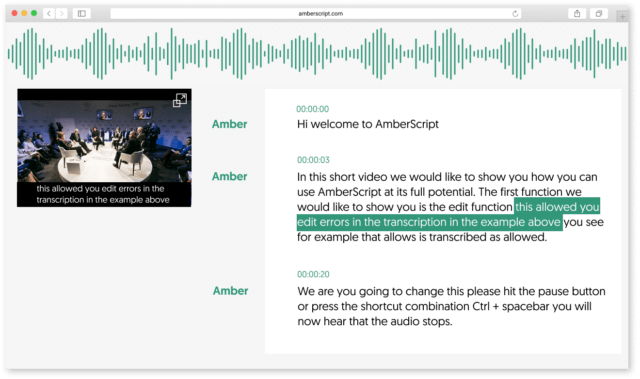
Easy to use online subtitle editor
Our online editor effortlessly syncs your audio with the text, enabling easy adjustments to your subtitles.
You can import video files in many different formats and export your video with subtitles, or export the subtitles separately in Text, SRT, VTT or EBU-STL and many other formats, with optional timestamps and speaker distinction.
Try it free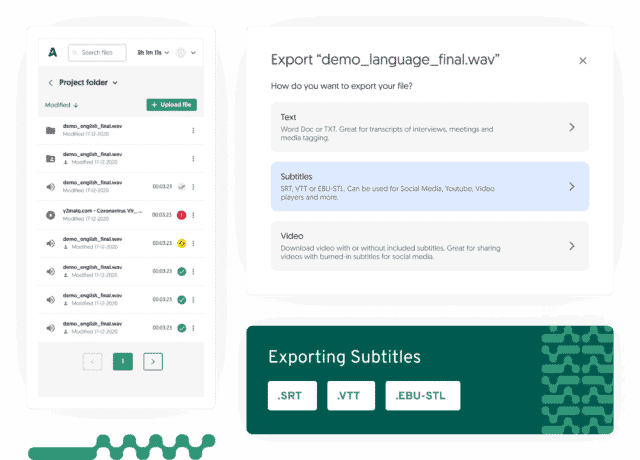
Auto captioning
We provide auto captions with the highest possible accuracies for your video stream
Easy to set up and use with Teams, Zoom, Google Meet, Skype, GoToMeeting, Cisco Webex, Jitsi and Slack. Also available through our streaming API for enterprise integration of lectures, e-courses, webinars and other video streams.
Request a quoteFeatures to Look for in a VTT Text Editor
Regardless of which editor you choose, there are a few key features you should look for. Firstly, it should support the VTT format, allowing you to save your file with the .vtt extension. Secondly, it should allow you to define timecodes for each caption. And lastly, it should provide options for styling and formatting captions.
Remember that the purpose of using a text editor is to make your task of inserting closed captions into a VTT file as straightforward as possible. So, choose one that best suits your comfort level and requirements.
Creating the VTT File and Inserting Captions
Now that we’ve prepared our caption text and chosen our text editor, it’s time to create the VTT file and insert our captions.
Step 1: Creating the VTT File
To create a VTT file, we’ll start by creating a new text file in our chosen editor. Remember to save it with the .vtt extension. The first line of our VTT file should be `WEBVTT` — this tells the video player that the file is in the VTT format.
Step 2: Inserting Captions
Next, we’ll start adding our captions. Each caption is composed of three parts:
- A sequence number: This begins from 1 and increases with each new caption.
- The timecode: It specifies when the caption should appear and disappear on the screen. It should be formatted as `hours:minutes:seconds.milliseconds –> hours:minutes:seconds.milliseconds`. For instance, `00:00:20.000 –> 00:00:24.000`.
- The caption text: This is the transcribed and formatted text we prepared earlier.
Each part should be on a separate line, and there should be a blank line between each caption. Here’s an example:
“`
1
00:00:20.000 –> 00:00:24.000
This is our first caption.
“`
Repeat this process for each caption. Make sure to save your work frequently!

Synchronizing Captions with the Video
Once we have prepared our VTT file with all the properly formatted captions and timecodes, the next step is to synchronize these captions with the video. Synchronization is crucial as it ensures that each caption appears at the right time, corresponding to the spoken words in the video.
To synchronize the captions, we first play the video and observe if each caption shows up at the stipulated time as per the timecodes we defined. If you find any caption appearing too early or too late, adjust its timecode in the VTT file. This process might require a few iterations to get everything perfectly aligned.
For videos hosted on platforms like YouTube or Vimeo, you can upload the VTT file directly to the video. These platforms have built-in tools that allow you to adjust the timing of each caption, making synchronization easier.
If you’re using a local video player, make sure it supports closed captions and that you can select your VTT file as the source for the captions. You might need a special plugin or software to view the captions and make adjustments.
Remember, synchronization might seem like a tedious process, but it’s essential for providing a seamless and inclusive viewing experience. In the next section, we’ll discuss how to validate and test your VTT file.
Validating and Testing the VTT File
After creating your VTT file, inserting captions, and synchronizing them with the video, the next step is to validate and test the VTT file. This is an important step to ensure that your captions are appearing correctly and at the right times.
There are various online tools available that can validate your VTT files, such as the WebVTT Validator. These tools will check your file for any formatting errors or issues that might prevent your captions from displaying correctly.
To use a validation tool, simply upload your VTT file and let the tool do its work. If there are any issues, it will provide a report detailing what needs to be fixed.
After validating your file, it’s time to test it. Play the video with the captions enabled, and watch it in its entirety to ensure that all captions are appearing correctly and in sync with the audio. If multiple people will be using the captions, it might be a good idea to have someone else watch the video as well. They might spot issues that you missed.
Remember to pay attention to the timing, placement, and legibility of the captions. Make any necessary adjustments to the VTT file, and repeat the validation and testing process until you’re satisfied with the results.
By validating and testing your VTT file, you can ensure that your video is accessible to all viewers. In the final section, we’ll explore how to make further enhancements to your captions.
Uploading the VTT File to Your Video
After creating, synchronizing, validating, and testing your VTT file, the final step is to upload it to your video. The process will vary depending on the platform where your video is hosted.
For platforms like YouTube, you’ll need to navigate to the “Subtitles” section of the video settings. Here, you’ll have the option to upload a subtitle file. Choose your VTT file, and ensure that it’s assigned to the correct language.
On Vimeo, you’ll find the option to add captions and subtitles in the “Distribution” settings of your video. Similar to YouTube, you can upload your VTT file and assign it to the appropriate language.
If you’re hosting the video on your own website, the process could be slightly more technical, involving HTML5 video elements and the track tag.
Remember to check the visibility and synchronization of the captions once the VTT file is uploaded. This step is crucial to ensure that all viewers can benefit from the closed captions you’ve painstakingly prepared.
Uploading your VTT file to your video marks the final step in making your content accessible to all. With accurate, well-timed captions, you can ensure that your message is conveyed effectively to all viewers, irrespective of their hearing ability.
Advanced Closed Caption Features
Once you’ve mastered the basics of creating, synchronizing, and uploading your VTT file, you might want to consider some advanced features to enhance the viewing experience even further.
- Positioning: By default, captions are displayed at the bottom center of the video. However, VTT allows you to specify the position of captions. This can be useful when the caption obscures important visual content.
- Styling: VTT files support a subset of CSS, allowing you to change the font, size, color, and background of your captions. Make sure the styles you choose improve readability without distracting from the video content.
- Voice Tags: If your video features multiple speakers, it can be helpful to use voice tags. These are denoted by the `<v>` tag in your VTT file. This tag precedes the dialogue and helps differentiate between speakers.
- Captions for Sound Effects: Captions can be much more than transcriptions of dialogue. Including descriptors of important sounds and sound effects can greatly improve the experience for deaf or hard-of-hearing viewers.
- Timestamps: If your video contains a lot of information or points that viewers might need to reference, adding timestamps to your closed captions can be a helpful tool.
Remember, these features exist to make your content more accessible and engaging. As you continue to refine your closed captioning skills, keep exploring how these advanced features can be used to enhance your viewers’ experience.
Best Practices for Closed Captions and VTT Files
When creating and implementing closed captions in VTT files, there are several best practices that can enhance their functionality and the viewing experience.
- Accuracy: Ensure that your captions accurately reflect the spoken words and significant sounds in your video. Incorrect or misleading captions can confuse viewers and detract from the overall experience.
- Synchronization: Timing is key in closed captioning. Your captions should coincide precisely with the audio for optimum understanding.
- Readability: Use a simple, clear font for your captions and ensure they’re of a size that can be easily read. Avoid fancy or intricate fonts which may be hard to decipher.
- Punctuation and Grammar: Correct punctuation and grammar are essential for understanding. They provide important cues about the flow and structure of the speech.
- Segmentation: Keep each caption’s duration reasonable. A good rule of thumb is to limit each caption to two lines of text and to ensure it’s displayed long enough to be read completely.
- Non-Speech Information: Include relevant non-speech information, such as sound effects and music, in your captions. This provides context and enhances understanding for those who cannot hear the audio.
- Speaker Identification: If your video features multiple speakers, make sure to identify each one in the captions when they speak. This can be done by including the speaker’s name or by using different positions or colors for each speaker’s captions.
- Consistency: Be consistent in your captioning style, terminology, and formatting. Consistency helps viewers follow along and understand the content more easily.
By following these best practices, you’ll not only ensure compliance with accessibility standards but also enrich the viewing experience for all your audience. Remember, the goal of closed captions is more than just transcription—it’s about making content accessible and comprehensible for everyone.

Get a customized offer
Request a quote for your subtitling needs
Mastering the art of closed captioning is a pivotal step towards creating content that is truly inclusive and accessible. By integrating closed captions in VTT files, content creators open their work up to a wider audience, ensuring their message is heard, understood, and appreciated by all. It’s more than just transcribing words – it’s about conveying the essence of your content in a way that resonates with every viewer. Remember, every small step towards accessibility counts, fostering a more inclusive digital world. So, take that step today, and make your content accessible to everyone!
The Importance of Precise Subtitles for the Film Industry
In the realm of global cinema, one tiny feature often goes unnoticed but has a profound impact on the viewing experience: subtitles. With the film industry becoming ever more international, films now reach a wider audience than ever before, spanning various languages, cultures, and regions. As these cinematic works cross borders, subtitles act as a pivotal bridge, enabling the story to resonate with diverse audiences. However, the art of subtitling requires a delicate balance of linguistic precision, cultural understanding, and technical finesse. This article will explore how precise subtitles are vital in enhancing the cinematic experience for both local and international viewers, shedding light on their role in accessibility, preserving artistic intent, engaging global audiences, and much more.
Table of Contents
- Understanding the Role of Subtitles in Films
- Improving Accessibility for Diverse Audiences
- Preserving Artistic Intent and Storytelling
- Engaging Global Audiences
- Avoiding Misinterpretation and Miscommunication
- Technical Considerations for Subtitling
- The Role of Professional Subtitlers and Translators
- Subtitling Challenges in a Rapidly Changing Industry
Understanding the Role of Subtitles in Films
Subtitles, in essence, are written translations of dialogue that appear on the screen while a film is playing. Their primary purpose is to facilitate understanding by rendering spoken words into a readable format. This function becomes particularly important when the film is presented to an audience whose native language differs from that used in the film.
There are several types of subtitles utilized in movies. Interlingual subtitles translate the spoken language into another language, making foreign films accessible to a broader audience. Intralingual subtitles transcribe dialogue within the same language, beneficial for viewers with hearing impairments or those who have trouble understanding the dialogue due to accents or speed of speech. Subtitles for the Deaf and Hard-of-Hearing (SDH) and closed captions not only transcribe dialogue but also include relevant non-dialogue information such as sound effects and musical cues, thus creating a more immersive viewing experience for those with hearing difficulties.
Historically, subtitles were introduced in the silent film era, with intertitles providing narrative continuity or dialogue. With the advent of sound films, however, subtitles evolved to become an essential tool for overcoming language barriers, paving the way for global cinema. As the film industry continues to expand its international reach, the role of subtitles in cinema becomes increasingly significant.

Learn more about Subtitles and Accessibility
Read the blogImproving Accessibility for Diverse Audiences
The beauty of cinema is that it transcends borders and unites people under the universal language of storytelling. Its power and reach are largely amplified by subtitles, which play a pivotal role in breaking down language barriers, thus making films accessible to diverse audiences.
Interlingual subtitles, for example, are a bridge between languages, allowing non-native speakers to understand and appreciate films from around the world. By providing a written translation of a film’s dialogue, they open up a wealth of foreign films to international audiences, fostering cross-cultural exchanges and enhancing the viewer’s global cinematic experience.
For those who are deaf or hard of hearing, subtitles can make the difference between exclusion and inclusion in the cinematic world. Subtitles for the Deaf and Hard-of-Hearing (SDH) and closed captions go beyond transcribing dialogue – they also include vital non-dialogue elements like sound effects and musical cues. This added layer of detail allows these viewers to fully immerse themselves in the story, providing a more enriching and inclusive viewing experience.
Intralingual subtitles also play a crucial role in fostering inclusivity, particularly for regional dialects. They assist viewers who might struggle with heavy accents, fast speech, or colloquial terms used in the film, ensuring no one is left out of the experience due to language proficiency or regional variances. Through these practices, subtitles effectively democratize cinema, making it a universal medium that everyone can enjoy.
Preserving Artistic Intent and Storytelling
Effective subtitling serves as a silent and unobtrusive guide that leads viewers through the narrative, upholding the original intent and tone of the film. It’s an art form in itself, requiring the subtitler to faithfully transmit meaning, emotions, humor, and cultural nuances from one language to another, all while maintaining the rhythm and pace of the film. Good subtitling is not just about direct translation – it’s about capturing the essence of the dialogue, the character’s personality, and the overall mood of the scene.
In many cases, dialogues in films are laced with idiomatic expressions, cultural references, or puns that might not have a direct translation in other languages. A skilled subtitler has the tough task of finding suitable equivalents in the target language that deliver the same impact and remain true to the director’s vision. Therefore, precise subtitling can preserve the intended humor or drama of a scene, making it resonate with the audience regardless of cultural or linguistic differences.
Moreover, subtitles also play an essential role in maintaining the continuity and flow of the narrative. By appearing and disappearing in sync with the characters’ speech, they guide the viewers through the plot, ensuring a seamless viewing experience. Inaccurate or mistimed subtitles can disrupt this flow, leading to confusion or even misinformation. Thus, the accuracy and timing of subtitles are vital in preserving the storytelling and artistic intent of a film.
In this rapidly globalizing world, subtitles are no longer just an add-on feature for films. They are an integral part of the cinematic experience that ensures the film’s message, story, and artistic integrity reach as many people as possible in its truest form.

Engaging Global Audiences
Subtitling has opened up the world of cinema to global audiences, fostering a massive expansion of cross-cultural exchange. It has effectively eliminated linguistic hurdles, enabling films to be appreciated beyond their country of origin, and allowing audiences worldwide to experience a vast array of cinematic narratives.
Translating a film’s dialogue into multiple languages via subtitles has empowered international film enthusiasts to enjoy films that they might not have access to otherwise due to language constraints. This accessibility means that a film produced in any part of the world can find an audience in any other, facilitating a truly global conversation around cinema. This global reach has not only lead to increased revenue for the film industry, but it has also enriched the viewer’s experience by exposing them to different cultures, perspectives, and storytelling traditions.
Moreover, the art of subtitling can play a significant role in enhancing the global popularity of a film. Accurate and well-timed subtitles that capture the original tone, humor, and cultural nuances can vastly increase a film’s appeal, leading to positive word-of-mouth and higher viewer ratings on global platforms.
In conclusion, precise subtitling is not just a tool for understanding dialogues in foreign films. It’s a powerful instrument in the film industry’s arsenal that engages global audiences, promotes cross-cultural understanding, and drives the universal appeal of cinema.
Avoiding Misinterpretation and Miscommunication
In the realm of cinema, precise subtitling is the key to averting misinterpretation and miscommunication. Dialogues in a film deliver not just words, but also carry the weight of context, emotions, and cultural implications. A minor discrepancy in subtitles can change the intended meaning, causing confusion, and potentially giving rise to unintended interpretations.
Subtitles serve as the interpreter for the audience, and hence any inaccuracies can lead to a distorted understanding of the plot or character intentions. For instance, a sarcastic remark can be mistaken for a serious statement if the subtitles fail to capture the nuances of sarcasm. Similarly, a culturally specific phrase or idiom could lose its impact if not translated or explained correctly, leading to a disconnect between the viewer and the narrative.
Avoiding such miscommunication requires a thorough understanding of both the source and target languages, cultural sensitivity, and a keen attention to detail. The goal is to ensure that the subtitles faithfully represent the dialogues, preserving the original tone, intent, and subtleties. This accuracy is crucial not just for providing viewers with an authentic viewing experience, but also for maintaining the reputation of the film and its creators. Any misinterpretation can potentially impact viewer ratings, reviews, and ultimately the success of the film on a global scale.
In essence, precise subtitling is a crucial aspect of the film industry that prevents mistranslations, preserves the integrity of the original dialogues, and ensures that audiences around the world can enjoy the film as intended by its creators.
The Role of Professional Subtitlers and Translators
Professional subtitlers and translators play an integral role in shaping the global film industry. They serve as linguistic intermediaries, bridging the gap between diverse cultures and fostering a sense of unity through shared cinematic experiences. They are not just translators, but also cultural interpreters, tasked with the delicate job of transposing the cultural nuances, humor, and emotions from one language to another.
Subtitlers and translators possess an in-depth understanding of both the source and target languages and cultures. They employ their expertise to ensure that the subtleties of dialogue, tone, and context are accurately captured in the subtitles, thereby preventing misinterpretations and miscommunications. They help preserve the integrity of dialogue, ensuring that the film’s narrative and character portrayals are understood as the creators intended.
Moreover, these professionals are skilled in dealing with the technical aspects of subtitling, ensuring synchronicity between subtitles and dialogue, maintaining readability and length, and taking into account the needs of viewers with hearing impairments. Their work goes beyond mere translation, encompassing a range of skills that contribute to the viewer’s overall cinematic experience.
In conclusion, professional subtitlers and translators play a pivotal role in the film industry, making cinema a more accessible and engaging medium for audiences around the globe. Their expertise and dedication are instrumental in promoting cross-cultural understanding, expanding the reach of films, and enhancing the global popularity of cinema.

Get a customized offer
Request a quote to translate subtitles
Technical Considerations for Subtitling
The process of subtitling is not simply about translating dialogues, it also involves several technical aspects that contribute to a smooth and meaningful viewing experience. One primary consideration is the timing and synchronization of subtitles. The subtitles should appear and disappear exactly when the respective dialogue is being delivered on-screen, maintaining a rhythm that aligns with the pace of the conversation.
Another important aspect is the length and readability of subtitles. Subtitles should be concise, fitting comfortably within a viewer’s reading speed, while still effectively conveying the essence of the dialogue. Overly long or complex subtitles can be challenging to read in the short time they are displayed, potentially causing viewers to miss crucial moments in the film.
The format and appearance of subtitles also play a crucial role. The font, size, color, and placement of subtitles can affect how easily they are read and understood. The subtitles should be easily distinguishable from the background, ensuring that they stand out clearly on the screen.
The process has never been easier with Amberscript: you can either choose our automatic subtitling services and use the online editor to edit and customize your captions, or you can ask our professional subtitlers to take care of the whole process for you! No matter your needs, Amberscript has a solution for you.
Moreover, the subtitler must bear in mind that subtitles often serve as a means for the hearing impaired to access the film’s content. Therefore, it’s essential to include relevant non-dialogue information in the subtitles, like the description of sound effects or music playing in the background, which can significantly enhance the viewing experience for those viewers.
In sum, technical considerations in subtitling are fundamental to delivering a viewer-friendly, accurate, and engaging cinematic experience. The technical precision of subtitles directly impacts the viewer’s ability to follow and appreciate the narrative, underscoring the necessity for meticulous attention to detail in the process of subtitling.
Subtitling Challenges in a Rapidly Changing Industry
In an industry that is continuously evolving, subtitlers and translators face a number of challenges. With the rise of digital media platforms and the increasing demand for high-quality content, the workload has significantly increased. Tight deadlines and high volume demands make the task of maintaining precision and quality in subtitling even more challenging.
One of the major hurdles is the constant evolution of language itself. New phrases, idioms, and slang are being introduced regularly, and these need to be accurately captured in subtitles to keep pace with the dynamic nature of languages. Similarly, the rise of regional content has brought local dialects and vernaculars to the forefront, adding another level of complexity to the subtitling process.
In addition, cultural sensitivities and regional nuances pose a significant challenge. Ensuring that subtitles do not offend any particular group or culture while maintaining the essence of the original content can be a delicate balancing act. This is particularly pertinent in today’s globalized world, where a film produced in one corner of the globe can be viewed by a diverse, international audience.
Technological advancements too, while offering new tools and functionalities, also bring about their own set of challenges. Subtitlers must constantly upgrade their skills to make use of the latest software and technology, adapting to changes like the rise of AI-powered translation tools and automated subtitling.
In conclusion, while the rapidly changing nature of the film industry offers exciting opportunities, it also presents a host of challenges to subtitlers and translators. Navigating these hurdles requires a blend of linguistic expertise, cultural understanding, technical skills, and adaptability, underlining the importance and complexity of the subtitling profession in the modern film industry.
Working with Freelance Translators In A Newsroom Subtitling Process
Subtitling is a crucial component of news media, allowing news agencies to reach broader audiences and ensure that their content is accessible to viewers with hearing impairments. While traditional subtitling processes are often time-consuming and costly, the increasing use of freelance translators in newsrooms has opened up new possibilities for faster turnaround times and more accurate translations. This article examines the role of subtitling in newsrooms, the emergence of freelance translators in this process, tips on building successful collaborations with them, best practices for integrating freelancers into your workflow, as well as case studies highlighting successful implementations.
Table of Contents
- The Role of Subtitling in Newsrooms
- The Emergence of Freelance Translators in Newsroom Subtitling
- Tips for Building Successful Collaborations With Freelance Translators
- Utilizing Technology in the Subtitling Workflow
- Overcoming Challenges and Pitfalls
- Case Studies: Successful Integration of Freelance Translators in Newsrooms
The Role of Subtitling in Newsrooms
Subtitling is an invaluable tool for news organizations, allowing them to expand their reach and engage with a larger and more diverse global audience. From breaking news, political debates, and investigative reports to entertainment programs, subtitling enables viewers to consume content across multiple language barriers in real time. Additionally, subtitling provides access to quality programming for people who are deaf or hard of hearing by providing them with a way to understand the audio components of a video without relying on interpreters or friends.
In the highly competitive newsroom setting, reporters face huge pressure to deliver timely updates on developing stories around the world as quickly as possible. This often leaves little time for accurate translations—a task that requires attention to detail and cultural sensitivity, as well as significant linguistic expertise and subject matter knowledge. As such, many news agencies are turning to freelance translators who have the specialized skills needed to meet tight deadlines while delivering quality translations that are both accurate and culturally appropriate.
Given its potential impact on public opinion on current events and other important topics, it’s critical that subtitle translations be precise and free from any misrepresentations or misinterpretations that could lead to significant misunderstandings among viewers from different backgrounds and cultures speaking different languages. Therefore, it’s essential that any freelance translator hired by a newsroom possess strong mastery of both source and target languages alongside adequate knowledge of relevant subject matters in order to produce accurate translations that are tailored for their intended audiences.
The Emergence of Freelance Translators in Newsroom Subtitling
The rise of digital media has transformed today’s news industry, presenting both opportunities and challenges to traditional news outlets as they compete for viewership against new entrants in the market. This has placed immense pressure on reporters and editors alike to quickly digest large amounts of rapidly evolving information and deliver accurate updates in multiple languages to viewers across different countries and cultures—a task that is nearly impossible without utilizing freelance translators who can provide timely translations with a high degree of accuracy and cultural sensitivity.
For many newsrooms, hiring full-time in-house translators may not be feasible due to budgetary constraints or time limitations associated with specific projects or stories. In such cases, engaging freelance translators allows them to access quick translations at competitive rates, granting them greater flexibility when dealing with tight deadlines or limited resources while still achieving high levels of accuracy and quality assurance standards set by their organization.
Benefits of Working With Freelance Translators

- Greater control over turnaround times due to increased flexibility when hiring based on project specifics, rather than relying solely on permanent staff members who may have other commitments or tasks that take precedence over subtitling assignments.
- Access to specialized subject matter expertise for more complex translations that require a deeper understanding of relevant topics or contexts beyond language proficiency alone, such as medical reports, legal documents, or financial statements
- Opportunity for newsrooms to work with a wider selection of native speakers from different regions who are familiar with local dialects and slang expressions used by their target audiences which may not be easily understood by non-native speakers.
- Increased cost savings that come with hiring freelancers on an hourly or project basis, as opposed to paying salaries and other benefits for permanent staff members.
Learn more about Subtitling in a newsroom
Read the blogTips for Building Successful Collaborations With Freelance Translators
Establish Clear Communication and Set Realistic Expectations
Foster open, direct communication with freelancers to ensure that both parties have a clear understanding of the project requirements and deadlines. This includes providing detailed instructions on the scope of work and the desired outcome, as well as setting realistic expectations about turnaround times for each task or assignment given to them. Create a system of feedback loops between newsroom managers and freelancers in order to track progress and ensure that adequate support is provided throughout the workflow process. Examples include regular check-ins via video calls or emails, timely responses to queries, clarification of tasks if needed, and prompt feedback on any revisions requested by editors or viewers when applicable.
Offer Competitive Payment Rates
Provide competitive rates based on the complexity of each subtitling task while also taking into account local currencies and living costs in different countries or regions where freelance translators might be located. This should incentivize freelancers to deliver quality translations while also allowing them to maintain financial stability without having to sacrifice their own personal time or resources in order to complete a project within set deadlines. Offer additional incentives such as bonuses or future projects if certain benchmarks are met during specific assignments in order to motivate freelancers who provide exceptional results or exceed expectations during particularly difficult tasks or assignments with tight turnaround times.
Develop an Effective QA System
Implement a quality assurance protocol that involves multiple rounds of proofreading from several editors (preferably native speakers) before subtitles are released for public viewings in order to ensure accuracy, consistency, clarity, cultural appropriateness, etc., across all languages being used in the newsroom’s translations projects worldwide. Utilize automated tools such as Automatic Speech Recognition (ASR) software for preliminary checks prior to manual review by human editors in order maximize efficiency and accuracy while minimizing errors due to rushed processes caused by tight deadlines associated with live broadcasts or breaking news updates requiring immediate attention from translation teams worldwide.
Maintain Professionalism and Respect
Treat freelance translators as part of the newsroom team by recognizing their contributions, promoting transparency throughout the collaboration process, and fostering an environment of mutual respect between all parties involved in the subtitling workflow. This should include courtesy when discussing tasks or assignments with freelancers in addition to timely payments for completed work, regardless of whether the project is successful or not. Establish a transparent feedback system that allows both sides to provide honest critiques while also giving credit where credit is due whenever appropriate without fear of retribution or reprimand. Such open communication fosters a sense of belonging within the translator community and encourages greater loyalty towards your organization which can help maintain long-term collaborations with the same freelancers in the future.
Embrace Diversity and Inclusion
Leverage the power of diverse perspectives when selecting freelance translators in order to ensure accuracy, cultural sensitivity, and appropriate representation across all languages used for subtitling projects within your newsroom. This could involve reaching out to native speakers in other parts of the world or integrating feedback from focus groups composed of viewers from different countries or regions who can provide insights into local dialects, slang expressions, etc., that might not be properly understood by non-native speakers working on translations for specific projects. Make a conscious effort to embrace inclusion in all aspects of your collaboration process by encouraging freelancers to share their unique perspectives and experiences with the newsroom team, as well as actively seeking out translators from different backgrounds in order to create a more diverse set of voices that can be represented within your subtitling projects.
By following these tips, newsrooms can ensure that they are getting the most out of their partnership with freelance translators and build a strong foundation of trust and respect in order to create successful subtitling projects in the long run. At the same time, freelance translators will have a better understanding of what is expected from them and how they should conduct themselves to achieve success.
Upload your audio file. Our speech recognition software creates a first version of the subtitles for your audio, which you can improve in our online editor for a 10x time-saving.
We connect your audio to the subtitles in our online editor and align them perfectly, which you can see in the subtitle preview window. You can realign, adjust and search through your text with ease.
Quickly export your audio with subtitles, or the subtitles separately in Text, SRT, VTT or EBU-STL and many other formats, with optional timestamps and speaker distinction.
Utilizing Technology in the Subtitling Workflow
In today’s modern and highly digitized world, newsrooms can leverage a variety of advanced technology tools to streamline and optimize their subtitling workflow. Here are a few tips on how to maximize efficiency and accuracy when utilizing technology in the subtitling process:
Leverage Automation for Efficiency
- Utilize Automatic Speech Recognition (ASR) software which allows audio recordings to be automatically converted into text that can then be quickly edited by human translators before being released for public viewings. This helps to significantly reduce time spent on transcription while also improving accuracy due to fewer human errors caused by rushed processes associated with tight deadlines.
- Utilize Machine Translation (MT) services such as Google Translate or Amazon Translate which allow newsrooms to quickly generate subtitles for live broadcasts or breaking news updates within set deadlines without having to wait for native speakers from other countries or regions who may not have access to the Internet at all times.
Introduce Intelligent Quality Assurance
- Incorporate Natural Language Processing (NLP) tools that can detect grammar mistakes, typos, incorrect words or syntax that could potentially detract from the overall quality of translations before they are released for public viewings in order to ensure accuracy across all languages used in your project.
- Implement Artificial Intelligence (AI) algorithms that can perform automated checks on translations against a pre-defined set of criteria such as cultural appropriateness, regional dialects, etc., in order to ensure consistency across different languages used in various subtitling projects worldwide.
Utilize Cloud Storage Solutions
- Leverage cloud-based storage solutions such as Dropbox, Google Drive or Microsoft OneDrive which allow newsroom teams (including freelance translators from anywhere around the world) easy access and sharing of documents, subtitles files and other media assets necessary for completing a project within set deadlines without delays caused by any technical issues related to data loss or retrieval problems from remote locations where freelancers might be located at any given time during a collaboration process with newsrooms abroad.
- Develop an efficient system for archiving completed projects so that newsroom teams can easily refer back to previous translations if needed while also allowing them quick access new materials whenever a translator needs assistance with understanding certain terms or expressions across multiple languages during specific assignments involving non-native speakers working on translations tasks outside their own language proficiency zones.

Overcoming Challenges and Pitfalls
Working with freelance translators in the newsroom subtitling process does come with certain challenges and pitfalls which must be addressed in order to ensure success. Here are a few tips on how to best overcome these issues when collaborating with freelancers:
Establish Clear Communication Protocols
Agree upon a set of guidelines between newsrooms and freelance translators regarding expectations, deadlines, payment terms, and other details such as required software or tools before beginning any project together. This helps to reduce potential misunderstandings from happening during the collaboration process due to different working styles of both parties involved.
Utilize cloud-based communication platforms such as Zoom, Google Meet or Microsoft Teams that allow for real-time interactions between all members of the project team regardless of their geographic location or native language proficiency levels – providing an opportunity for better understanding amongst everyone involved in the subtitling process while also allowing freelance translators from anywhere around the world to participate more effectively in projects without having to travel long distances for physical meetings or conference calls.
Offer Competitive Rates and Incentives
Pay competitive rates that match industry standards in order to attract top quality talent while also rewarding those members who show dedication and commitment towards completing tasks on time especially when tight deadlines need to be met.
Create bonus incentives that reward freelance translators for successful collaborations such as offering discounts on future projects or recognition programs that highlight their work contributions thus motivating them to strive for higher quality translations even under pressure situations associated with shorter turn-around timelines expected by newsrooms worldwide today.
Leverage Automation Tools For Quality Assurance
Incorporate automated checks within the subtitling workflow which look out for common grammar mistakes, typos, incorrect syntax and other errors that could possibly detract from the overall accuracy of translations before they are released publicly – this helps ensure consistency across multiple languages used in various projects while also saving time spent on manual editing processes associated with tight deadlines usually expected by newsrooms today.
Introduce artificial intelligence algorithms into your workflow which can detect subtle nuances between different dialects (such as regional slang) across various languages so translations are accurate even when dealing with unfamiliar cultures or regions – helping newsrooms maintain a high level of quality control amongst all members involved in the subtitling process regardless of their native language proficiency levels at any given time during a project’s lifecycle.
Overall, the use of technology in the subtitling process can help newsrooms to save time, reduce costs and ensure accuracy across all languages while also building more efficient ways to collaborate with freelance translators from around the world.
Case Studies: Successful Integration of Freelance Translators in Newsrooms
With the rise of globalization, many newsrooms have found it essential to incorporate freelance translators into their operations. Here are some examples of successful collaborations between newsrooms and freelance translators that demonstrate the value of integrating global talent into subtitling projects.
BBC World News
BBC World News, a major international news broadcaster, has successfully integrated freelance translators into their operations as part of their subtitling and captioning workflow. Through the effective use of cloud-based storage solutions such as Dropbox, Google Drive and Microsoft OneDrive, BBC World News has created an efficient system for sharing documents with translators from around the world quickly and securely. Additionally, they leveraged automated checks within their subtitling workflow to help identify common errors such as typos and incorrect syntax which allowed them to ensure a high level of quality control amongst all members involved in the process regardless of language proficiency levels or geographic locations. This collaboration proved successful and helped BBC World News maintain its reputation as an international leader in news broadcasting across multiple languages.
CNN International
CNN International has also been able to successfully incorporate freelance translators into their subtitling operations by using AI algorithms to detect subtle differences between dialects across various languages which enabled them to ensure accuracy even when dealing with unfamiliar cultures or regions. By introducing this technology into their workflow, CNN International was able to maintain a high level of quality control amongst all members involved while also allowing them access new materials whenever needed without any delays caused by technical issues related to data retrieval or language proficiency levels of freelance translators working on projects outside their native countries. This successful integration helped CNN International become a leading source for international news coverage in multiple languages across the globe.
In conclusion, newsrooms can benefit greatly by integrating freelance translators into their operations. By leveraging the power of modern technology such as cloud-based storage solutions and AI algorithms to detect subtle differences between dialects across various languages, newsroom teams are able to ensure a high level of quality control in all aspects of their subtitling process while also allowing them quick access new materials whenever necessary without any delays caused by technical issues or language proficiency levels. The success stories from BBC World News, CNN International demonstrate just how powerful collaboration between these two parties can be when both sides communicate effectively with one another at all stages during a project’s lifecycle.
The Do’s and Don’ts of Transcribing in a Newsroom
Transcription is an integral part of journalism and newsrooms, as it provides accuracy and clarity to the content produced. It is essential for transcribers to be meticulous in their approach, taking into account the nuances of language as well as other considerations such as confidentiality and privacy. This article will provide a comprehensive guide on the dos and don’ts of transcribing in a newsroom, from using specialized software to preserving privacy when necessary. With these tips, you can ensure that your transcriptions are accurate and effective!
Table of Contents
The Do’s of Transcribing
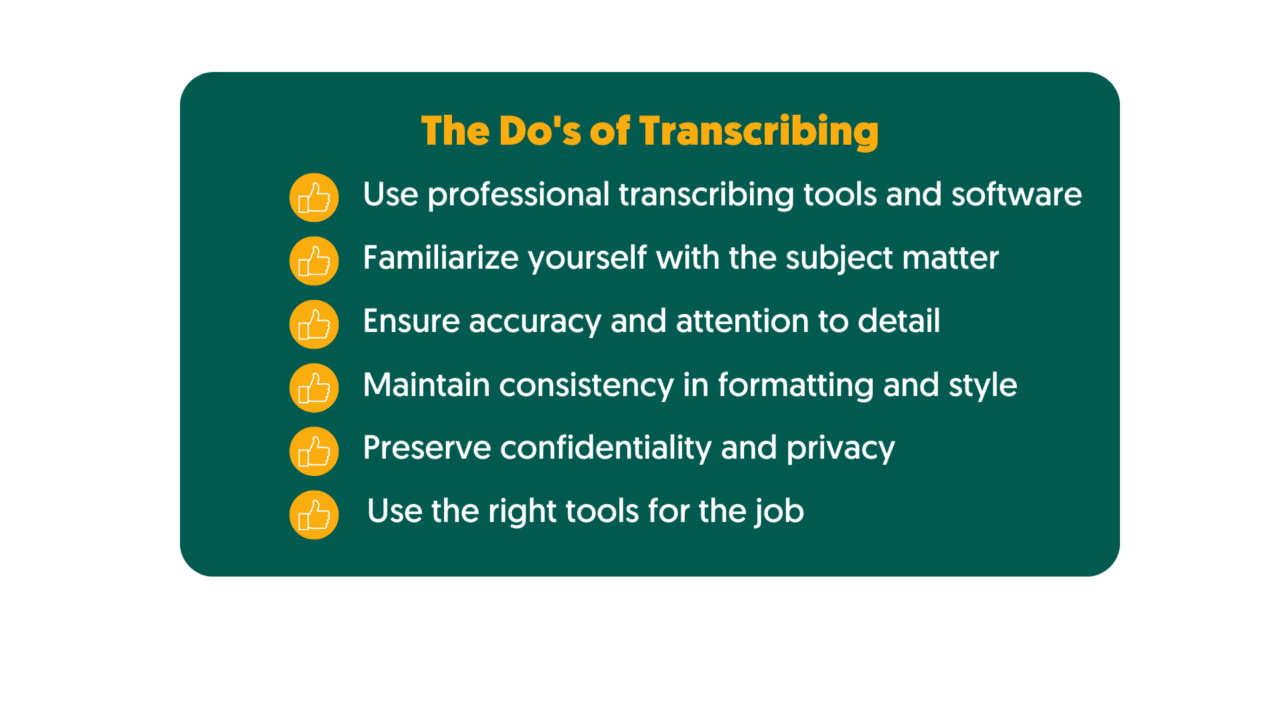
Use professional transcribing tools and software
Professional transcription tools and software provide a wide range of features to facilitate accurate and efficient transcription. These include automatic playback features, speech recognition capabilities, time stamps, and customizable user interfaces that make transcribing easier. Additionally, these tools offer useful features such as audio splitting, noise cancellation, and punctuation marks for improved accuracy. Popular tools for transcription in newsrooms include Amberscript, Express Scribe Transcription Software, NCH Express Scribe Pro Transcription Software, and Audacity.
Familiarize yourself with the subject matter
It is essential to understand the context of the audio or video being transcribed before beginning work on it. This requires researching the topic extensively and becoming well-versed in relevant terminology or jargon used in the newsroom environment. Being familiar with the topic at hand will help you capture nuances better and produce more accurate transcripts than you would otherwise achieve with minimal background knowledge.
Doing your research is also important when it comes to ensuring accuracy when dealing with names or places mentioned in an audio clip – double-check these names against reliable sources if necessary to ensure accuracy in transcription results.
Ensure accuracy and attention to detail
Accuracy is key when it comes to transcribing – capturing exactly what was said in an audio clip should be your primary goal as a transcriber in a newsroom environment. Paying attention to small details such as intonation and accent can make all the difference when it comes to producing an accurate transcript that captures tone or emotion accurately as well as specific words used by speakers during conversations or interviews recorded on audio files/clips.
After completing your transcription work, proofread your transcript thoroughly for typos or errors before submitting your final version – this could involve using spell checkers to ensure accuracy of any proper nouns mentioned during conversations that were recorded on audio files/clips while double-checking against reliable sources if necessary for further precision when necessary (for example when handling sensitive information). Additionally, consider running multiple drafts of your transcriptions through third-party software like Grammarly for quality assurance purposes before submitting final versions of transcripts to superiors or publishing houses if necessary depending on company policies/rules pertaining to such matters within newsroom environments across industries/sectors today.
Find out more about ensuring accuracy
Read the blogMaintain consistency in formatting and style
When producing transcripts for public consumption or other purposes such as archival materials etc., maintaining consistency is vital – this applies not just for punctuation but also capitalization choices made throughout entire documents/files created during transcription processes within newsrooms today. Utilizing a style guide is recommended here given how this can flesh out details pertaining different elements involved (such as proper nouns being handled) depending on sector specific requirements concerning such areas across industries.
Keeping track of date formats (including year formats), usage conventions related questions posed during interviews etc., are some other matters that require keeping consistent during transcribing processes within newsrooms today. Having reference points such as existing company produced documents/files containing related content (elements obtained from interviewing subjects etc.) can help here when looking into setting up standardization rules applied uniformly across board throughout entire process where possible dependent upon particular requirements concerning sectors presently active on market today.
Preserve confidentiality and privacy
Handling sensitive information in a newsroom requires strict adherence to ethical standards and respect for privacy. Transcribers must be cautious about disclosing personal details without public interest and should avoid causing unnecessary harm to individuals mentioned in the content. To uphold privacy, it’s crucial to set boundaries and avoid transcribing private matters disclosed in interviews or recordings. Additionally, when dealing with vulnerable individuals or victims, extra sensitivity is necessary. Transcribers should also be aware of relevant legal requirements, such as data protection laws, to ensure compliance.
When dealing with sensitive content, obtaining informed consent is vital. This involves clearly explaining the transcription’s purpose to interviewees and sources and offering options for anonymity or pseudonyms if appropriate. Consent may be obtained in writing for contentious topics to have a record of agreement. It’s essential to respect individuals’ decisions and remove sensitive information if consent is revoked.
Use the right tools for the job
Transcribing in a newsroom environment requires having access to reliable tools that can help speed up the process and ensure accuracy of transcripts produced during this time, ranging from automated transcription software to specialized journalism transcription services. Automated transcription software, such as Amberscript, are great for quickly generating transcripts with minimal effort on the part of transcribers although some editing may be necessary depending on the level of accuracy required by superiors or publishing houses if relevant.
For those who prefer human-powered transcription services, there are specialized journalists’ transcription services available which provide more accurate results since they involve experienced transcribers. These services can be hired on a per-project basis and are often more reliable than automated transcription services, making them an attractive option for those in need of the utmost accuracy. If you are working on short deadlines, Amberscript has got you covered: by offering rush services, we ensure that you obtain your transcript as fast as 24 hours.
At the end of the day, when it comes to transcribing in a newsroom environment, there is no one-size-fits-all approach – what works best for one company may not necessarily work best for another. It’s important to be aware of the dos and don’ts so that you can ensure accuracy while preserving confidentiality and privacy at all times. With the right tools and processes in place, you can guarantee successful transcriptions every time!

The Don’ts of Transcribing
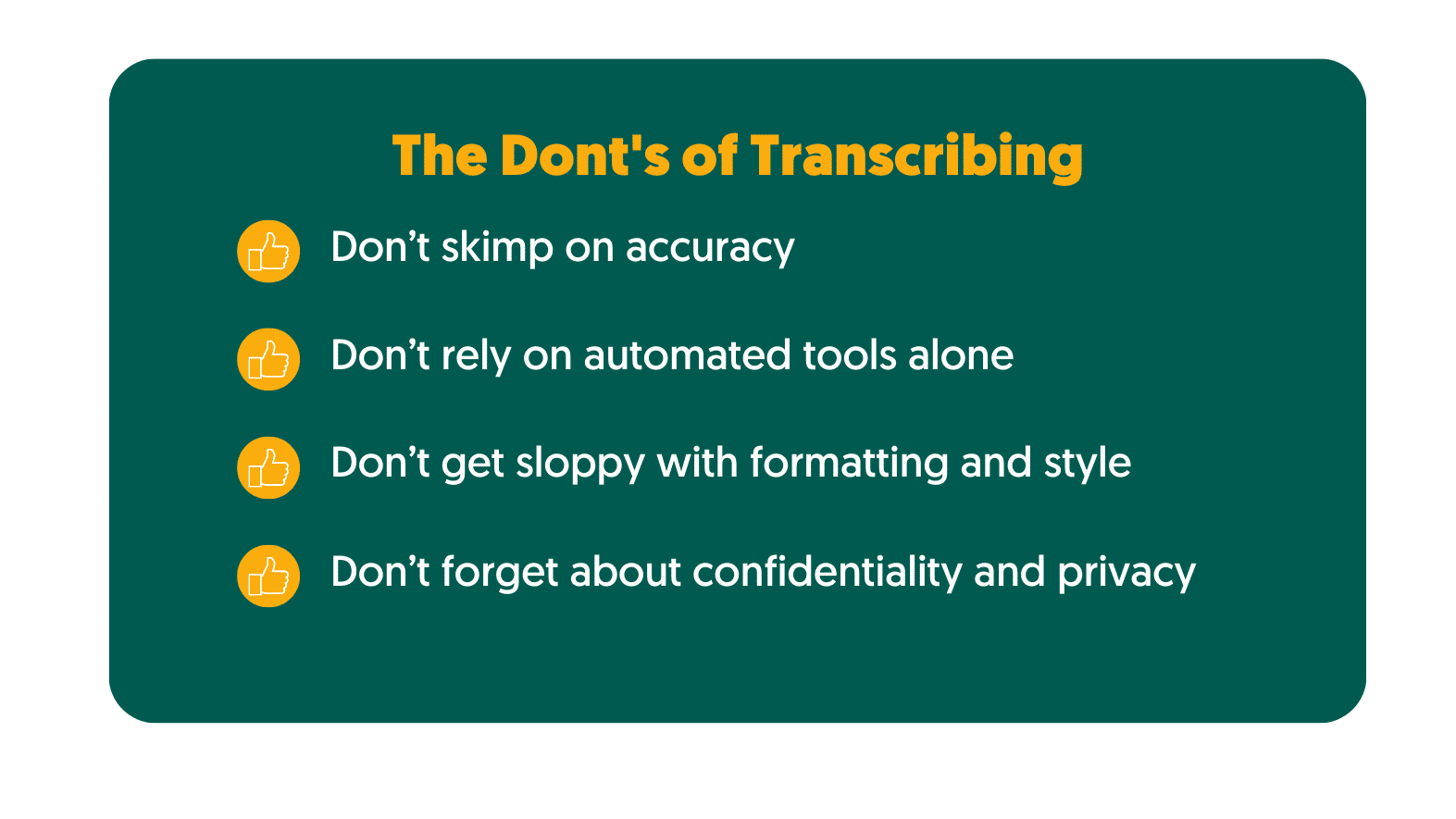
- Don’t skimp on accuracy – transcribers should take the time to ensure that their transcripts are 100% accurate, especially when it comes to text related to sensitive information or legal matters. Double-check facts, spellings and other details against reliable sources if necessary for further precision when necessary. Additionally, consider running multiple drafts of your transcriptions through third-party software like Grammarly for quality assurance purposes before submitting final versions of transcripts to superiors or publishing houses as required.
- Don’t rely on automated tools alone – although automated transcription tools can help speed up the process, they aren’t always 100% accurate – they may miss out certain words or phrases depending on the context in which such terms are mentioned within recordings etc., making it important to double-check results obtained via manual methods prior to submission/publication related activities proceeding forward. Furthermore opting for human-powered transcription services (where available) is recommended due more accurate results produced here since experienced transcribers are handling respective tasks in question presently discussed .
- Don’t get sloppy with formatting and style – when producing transcripts for public consumption or other purposes such as archival materials etc., maintaining consistency is key. Utilizing a style guide is recommended here given how this can flesh out details pertaining different elements involved (such as proper nouns being handled) depending on sector specific requirements concerning such areas across industries today . Keeping track of formatting rules (including punctuation & capitalization choices made throughout documents/files created during transcription processes within newsrooms today ) is also vital towards achieving desired outcome here dependent upon particular requirements pertaining sectors presently active market so forth .
- Don’t forget about confidentiality and privacy – when handling sensitive information during transciption processes within newsrooms today , ethical considerations need addressing properly via obtaining consent from relevant parties involved (interviewees etc.) especially so when content obtained could potentially breach confidentiality agreements currently established between them & superiors / publishing houses etc . Failing do so due regulations currently applicable under law post completion respective task could then render entire exercise involving illegal activities case which carries dire consequences best avoided at all cost here given potential damages incurred due same impacting negatively long term prospects concerning respective individual’s career prospects future related engagements alike so forth best prevented via proactive measures adopted prior commencement works concerning same presently discussed herein .
In conclusion, following the dos and don’ts of transcribing in a newsroom environment can help ensure accurate results while preserving confidentiality and privacy at all times. With the right tools and processes in place, you can guarantee successful transcripts every time.
Transcribing in a newsroom is complex and requires careful consideration of the dos and don’ts to ensure accuracy, confidentiality, and privacy. The right tools for the job can help speed up the process while also providing accurate results. Whether you choose automated transcription software or specialized journalists’ transcription services, having access to reliable tools will make sure your transcripts are successful every time. With these tips in mind, transcribers should be able to confidently produce quality transcripts that meet their organization’s needs.
Best 7 Transcription tools for journalists to help speed up their work
Table of content
In this blog post, we will explore the best 7 transcription tools for journalists to speed up their work. These tools offer accuracy, user-friendly interfaces, and time-saving features, allowing journalists to focus on their storytelling instead of transcription.
Criteria for Selecting Transcription Tools
When choosing a transcription tool, it’s essential to consider several criteria to ensure it meets the specific needs of journalists. Here are the key factors to consider:
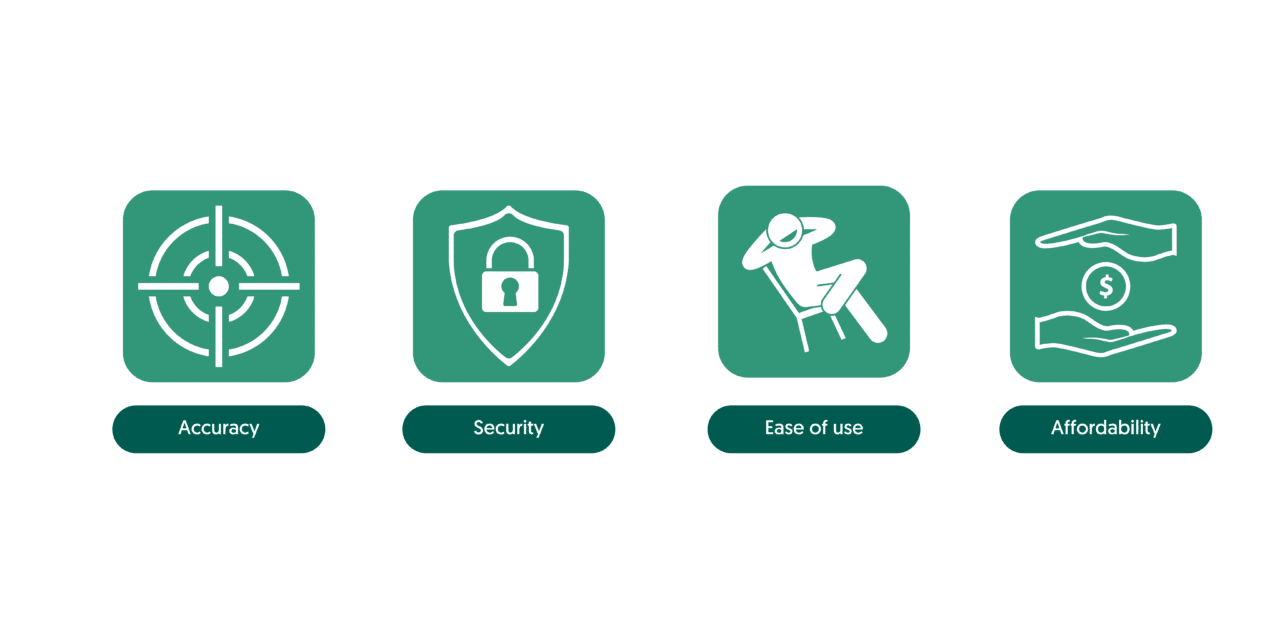
- Accuracy: Reliable and precise transcriptions are crucial for journalistic work. Look for tools with advanced speech recognition technology and human editing capabilities to ensure the highest level of accuracy.
- Ease of Use and User Interface: A user-friendly interface with intuitive navigation and clear instructions can significantly enhance productivity and streamline the transcription process.
- Time-saving Features: Tools that offer automated timestamping, speaker identification, and text highlighting can expedite the transcription process, saving valuable time.
- Cost Considerations: Finding a tool that offers an optimal balance between affordability and functionality is crucial. Consider pricing models such as pay-as-you-go, subscription plans, or tiered pricing based on usage.
By considering these criteria, journalists can select the transcription tool that best suits their specific requirements and maximizes their efficiency.
Amberscript

Overview and Key Features:
- Amberscript is a highly regarded transcription tool that offers a range of features to support journalists in their transcription needs. The tool utilizes a combination of automated speech recognition technology and human editing to deliver highly accurate transcriptions. With its user-friendly interface, Amberscript simplifies the transcription process, allowing journalists to transcribe interviews and recordings more efficiently. One standout feature of Amberscript is its customizable timestamps, which enable users to navigate through transcriptions with ease and reference specific parts of the text. Additionally, Amberscript supports various audio and video file formats, making it versatile for different journalistic content. The tool continually improves its speech recognition algorithms through advanced machine learning techniques, ensuring enhanced accuracy over time.
Pricing Details:
- Amberscript offers flexible pricing options to cater to the varying needs and budget constraints of journalists. While specific pricing details may be subject to change, the tool typically provides different pricing plans based on factors such as transcription volume or usage time. Users can choose between pay-as-you-go pricing or subscription-based models. It’s advisable to visit Amberscript’s official website or contact their support team to get the most up-to-date pricing information and explore the available options that best suit individual requirements.
User Reviews and Ratings:
- Amberscript has garnered positive reviews and ratings from journalists and users who have utilized the tool for transcription purposes. Users have praised the tool for its accuracy, user-friendly interface, and customizable timestamping feature. They have highlighted Amberscript’s ability to expedite the transcription process and enhance overall productivity. Amberscript’s commitment to customer satisfaction and continuous improvement has been well-received, contributing to its positive reputation among journalists. To get a comprehensive understanding of user experiences, it’s recommended to explore trusted review platforms or seek feedback from other journalists who have used Amberscript.
Otter.ai
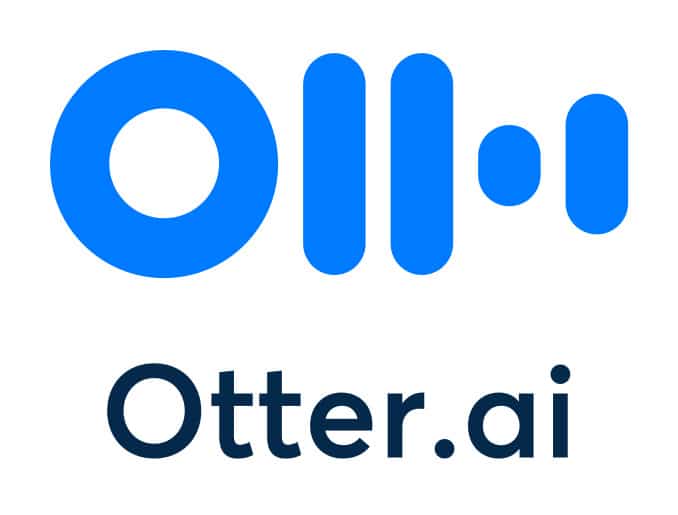
Overview and Key Features:
Otter.ai is a popular transcription tool known for its accurate and automated transcription services. With its real-time transcription capabilities, Otter.ai can transcribe interviews and recordings as they happen, making it ideal for journalists. The tool also offers speaker identification and text highlighting, making it easier to navigate through transcriptions. Otter.ai integrates with note-taking apps, allowing journalists to combine their transcriptions with their own notes seamlessly.
Pricing Details:
Otter.ai offers both free and paid plans. The free plan provides limited features, while the paid plans start at affordable prices, usually around $9.99 per month. The paid plans offer additional features and higher transcription limits, making them suitable for journalists with heavier transcription needs.
User Reviews and Ratings:
Users have praised Otter.ai for its accuracy and real-time transcription capabilities. The tool’s ability to identify speakers and highlight text has been particularly useful for journalists. Users have found Otter.ai to be reliable and user-friendly, enhancing their transcription workflow. Exploring user reviews and ratings can provide more specific insights into the experiences of journalists who have used Otter.ai.
Rev

Overview and Key Features:
Rev is a renowned transcription service that provides high-quality transcriptions through a team of professional transcribers. Journalists can upload audio or video files to Rev, and the transcriptions are delivered with exceptional accuracy. Rev supports various file formats and offers fast turnaround times, ensuring prompt delivery of transcriptions.
Pricing Details:
Rev’s pricing is based on the length of the audio or video file submitted for transcription. The pricing typically starts at around $1.25 per minute of audio or video. This pricing structure allows journalists to have transparency and control over their transcription costs.
User Reviews and Ratings:
Rev has received positive reviews for its accuracy and quick turnaround times. Journalists have appreciated the professionalism and reliability of the transcriptions provided by Rev’s team of transcribers. Exploring user reviews and ratings can provide further insights into journalists’ experiences with Rev.
Temi
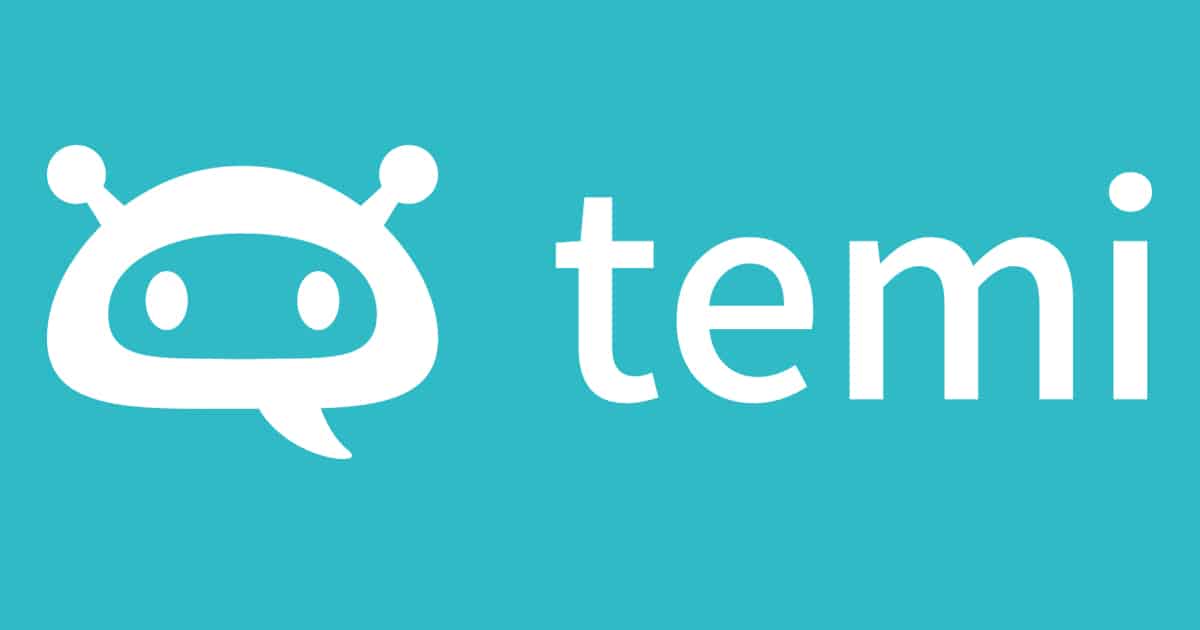
Overview and Key Features:
Temi is a popular transcription tool that combines automated speech recognition with human editing for accurate transcriptions. The tool offers a user-friendly interface, allowing journalists to easily upload audio or video files and receive transcriptions in a timely manner. Temi’s quick turnaround times make it suitable for journalists on tight deadlines.
Pricing Details:
Temi operates on a pay-as-you-go pricing model, typically charging around $0.25 per minute of transcription. This flexible pricing structure allows journalists to transcribe as per their needs without long-term commitments.
User Reviews and Ratings:
Users have appreciated Temi’s speed and accuracy in delivering transcriptions. The tool’s ease of use and affordability have been praised by journalists who have used it for their transcription requirements. Exploring user reviews and ratings can provide more specific insights into journalists’ experiences with Temi.
Descript

Overview and Key Features:
Descript is a powerful transcription tool that goes beyond basic transcriptions. It provides an interactive audio and video editing environment, allowing journalists to edit text by editing the audio itself. This unique feature makes Descript a valuable tool for seamless transcription and editing. Collaboration and version control features also make it convenient for journalists working in teams.
Pricing Details:
Descript offers subscription-based pricing starting at around $15 per month. The pricing may vary based on the specific plan and features chosen. Exploring Descript’s website will provide detailed information on pricing options.
User Reviews and Ratings:
Descript has received positive reviews for its innovative approach to transcription and editing. Journalists have found Descript’s editing capabilities, such as editing text by editing audio, to be a significant time-saver. The tool’s collaborative features have also been praised by teams working on transcription projects. Exploring user reviews and ratings can provide further insights into journalists’ experiences with Descript.
Trint

Overview and Key Features:
Trint is an AI-powered transcription tool that focuses on collaboration and workflow management. Journalists can easily upload audio or video files, and Trint’s advanced technology quickly transcribes them. The tool offers efficient editing and sharing features, making it a reliable choice for journalists working in teams.
Pricing Details:
Trint offers various pricing plans tailored to different needs. Detailed pricing information, including the specific plans and features available, can be found on Trint’s website.
User Reviews and Ratings:
Users have praised Trint for its accuracy and collaborative features. The tool’s ability to streamline the transcription workflow and facilitate team collaboration has been beneficial to journalists. Exploring user reviews and ratings can provide more specific insights into journalists’ experiences with Trint.
Sonix

Overview and Key Features:
Sonix is a transcription tool that boasts a user-friendly interface and accurate transcription results. With automated timestamping and speaker identification features, Sonix simplifies the transcription process for journalists. The tool supports a variety of audio and video file formats, making it versatile for different journalistic content. Sonix also offers a user-friendly editor, allowing journalists to make quick and easy edits to the transcriptions.
Pricing Details:
Sonix provides flexible pricing options, including pay-as-you-go and subscription plans. The pricing may vary depending on factors such as usage time and additional features required. Exploring Sonix’s website will provide detailed information on the available pricing options.
User Reviews and Ratings:
Sonix has received positive reviews for its accuracy and user-friendly interface. Journalists have found Sonix to be reliable and efficient, providing quick and accurate transcriptions. User reviews and ratings can offer more specific insights into journalists’ experiences with Sonix.

Get a customized offer
Request a quote for your transcription needs
Transcription tools have become indispensable assets for journalists, saving them valuable time and effort in transcribing interviews and recordings. The best 7 transcription tools mentioned in this blog post, including Amberscript, Otter.ai, Rev, Temi, Descript, Trint, and Sonix, offer a range of features tailored to the specific needs of journalists. These tools provide accuracy, user-friendly interfaces, time-saving features, and flexible pricing options. By leveraging these transcription tools, journalists can streamline their workflow, enhance productivity, and focus on producing high-quality content. It is recommended that journalists explore these tools further, considering their unique requirements, and select the one that best aligns with their specific needs. Embracing transcription tools empowers journalists to navigate the transcription process with ease, ultimately enhancing their overall efficiency in delivering compelling stories.
How to find and use quotations in your transcript
Quotations are an invaluable tool for anyone transcribing and analyzing spoken language. Not only do they help capture the essence of a conversation or speech, but they can also be used to add color and context to your transcripts. Whether you’re a journalist, researcher, student, or just someone who wants to record important conversations accurately, learning how to find and use quotations is essential.
In this article, we’ll look at the basics of understanding quotations in transcripts as well as tips on finding them effectively. We’ll also go over ethical considerations and explore tools and techniques for using quotes more efficiently. Finally, we will provide some examples of effective quotation usage along with case studies that demonstrate best practices for quoting accurately in different contexts.
Table of Contents
- Understanding Quotations
- Finding Quotations
- Using Quotations Effectively
- Credibility and Ethical Considerations
- Tools and Techniques
- Common Challenges and Solutions
- Examples and Case Studies
Understanding Quotations
Quotations are direct or indirect references to someone’s words, thoughts, or opinions. They can be used in a variety of contexts such as writing, speeches, presentations, and transcripts. Quotations are typically noted by quoting marks, and they should accurately reflect the source’s original words and intent.
There are two main types of quotations: direct and indirect. Direct quotations quote directly from the source using their exact words, while indirect quotations allude to the source’s ideas without using their exact words. It is important to differentiate between quotes and paraphrases since one is more accurate than the other when it comes to transcripts and other forms of written communication.
Finding quotations for a transcript is not always an easy task but it can be done with patience and practice. When listening to a recording, look out for key moments or impactful statements that could be worth quoting in your transcript. Mark these down during your transcription process so you can easily identify them later on. It is also important to make sure you are accurately recording these quotes with time stamps so you have an easier time finding them later on when needed.
Finding Quotations
When listening to a recording, try to get into the habit of noting down key moments and impactful statements that could potentially be used in your transcript as quotes. This allows you to easily go back and review the recording later on to identify any quotes worth including.
Making sure you are accurately recording these quotes is also imperative, as this will help you pinpoint them later on when needed. It is best practice to note down time stamps or create labels for each quote so that you can quickly access them if needed for review or further analysis. Additionally, it is important to ensure the accuracy of the transcription by double-checking each quote before using it in your transcript.
This process is significantly faster when using Amberscript: after recording, you only need to upload your file on the platform and you’ll obtain your transcription within minutes. The online tool is easy to use and allows you to edit and customise your file before you export it. Moreover, the tool identifies different speakers and adds timestamps to the transcript for you, optimizing your workflow.
When looking for purposeful quotes, consider what kind of effect they may have on your overall message. Are there any specific phrases or words that carry more weight than others? Consider how certain lines may resonate with the audience or make a lasting impression on readers. A well-crafted quote can make all the difference in how effectively a transcript conveys its intended message, so take care when selecting which ones to include in your document.
Edit your text in minutes, or let our professionals take over. Rush your order and get your file as fast as 24h.
Native speakers and quality checks ensure that you receive 100% accurate transcripts.
Your files are confidentially stored in a secure environment.
Using Quotations Effectively
Once you have identified and transcribed the quotations, the next step is to use them effectively in your transcript. When using quotes, it is important to provide necessary context and attribution for each quote so that readers can understand its significance. This includes noting who said the quote and when it was said, as well as describing any relevant circumstances surrounding it.
Integrating quotations into your writing is also a key factor to consider. Avoid making the transcript sound too choppy or disjointed by placing quotes strategically within your text. Consider how various sentences and phrases might flow together to capture the intended tone or message better. Additionally, make sure that all quotes are accurately quoted from the source material and properly set apart from other text with quotation marks or indentation.
When working with quotations, there are certain ethical considerations to keep in mind. It is important to always verify that any quote used in a transcript is accurate and true to what was originally stated by the speaker. Misquoting someone or taking their words out of context can lead to embarrassing situations or even legal implications, so double-checking every quote before including it in a transcript is essential. Additionally, when quoting conversations between multiple people, try to include any relevant responses in order to maintain an accurate representation of the exchange.
Finally, take advantage of technology tools available for transcribing and quoting accurately and efficiently. For example, Amberscript offers different services based on your needs: whether you choose Machine-made or Human-made transcriptions, you can rest assured that your file will be handled with the utmost care for security and accuracy, to give you the best experience possible.
Best practices for citing and referencing quotations should also be taken into account depending on your use case – this includes guidelines for formatting citations as well as providing proper attribution for quotes used across different media sources (blogs, newspapers, websites, etc.).
Credibility and Ethical Considerations
When working with quotations, there are certain ethical considerations to keep in mind. It is important to always verify that any quote used in a transcript is accurate and true to what was originally stated by the speaker. Misquoting someone or taking their words out of context can lead to embarrassing situations or even legal implications, so double-checking every quote before including it in a transcript is essential. Additionally, when quoting conversations between multiple people, try to include any relevant responses in order to maintain an accurate representation of the exchange.
Furthermore, it is also necessary to provide proper attribution for any quotes used across different media sources (blogs, newspapers, websites, etc.). This means accurately citing the source material along with details such as author name, publication date, and website URL (if applicable). Failure to do so could constitute plagiarism or intellectual property violations if published content is used without permission from the copyright holder.

Tools and Techniques
When transcribing audio recordings, it is important to make sure that all quotes are accurately recorded and properly attributed. Fortunately, there are tools and techniques available that can help streamline the transcription process along with features such as auto-timestamps for recording quotes during playback or text matching tools for pinpointing specific words quickly within large files of recorded audio.
For example, Amberscript is a comprehensive transcription tool that allows users to easily record, store, and manage quotes from audio recordings. It offers a wide range of features such as automatic transcription capabilities which can convert audio into text in real time; advanced search options that can be used to quickly locate specific words or phrases within large files; and powerful editing tools which enable users to seamlessly integrate quotes into transcripts for maximum impact. Additionally, Amberscript also complies with all ethical guidelines related to quoting and citing so users can rest assured that any quote used in their transcript is accurate and properly attributed.
By utilizing effective tools such as Amberscript, you can guarantee that your transcripts remain both credible and ethical. Utilizing these resources correctly will also ensure that all quotes used in your transcript are accurately recorded and properly cited when necessary according to best practices.
Common Challenges and Solutions
Working with audio recordings and transcripts can often be a challenging process. Transcribers are faced with the difficult task of accurately capturing spoken language in written form, which requires careful attention to detail as well as a good understanding of grammar and punctuation rules. Additionally, when dealing with quotes from multiple sources, it is important to ensure that all quotes are properly attributed to their respective sources.
One of the most common challenges associated with transcription is the time-consuming nature of the process.Manually transcribing long or complex recordings can take several hours or even days depending on the length and complexity of the material. Fortunately, tools like Amberscript can help streamline the process thanks to their automatic transcription capabilities and powerful editing features that allow you to integrate quotes into transcripts.
Another challenge is maintaining accuracy when dealing with quotes from multiple sources or long conversations between multiple people. To ensure that all quotes are accurate and properly attributed, double-check each quote before including it in your transcript and make sure to capture any relevant responses in order to maintain an accurate representation of the exchange. Additionally, always cite source material correctly according to best practices for citing quotations and references when necessary.
By utilizing effective tools such as Amberscript along with best practices for quoting accurately and ethically, you can minimize these common challenges associated with transcription and guarantee that your transcript remains credible and ethical.

Get a customized offer
Request a quote for your transcription needs
Examples and Case Studies
In order to illustrate the importance of accurately transcribing quotes and properly attributing them to their respective sources, here are some examples and case studies from real-world scenarios.
- In 2017, a Washington Post investigation uncovered numerous instances in which President Trump had falsely claimed credit for creating jobs or saving existing ones. However, upon closer examination, it was revealed that the quotes attributed to Trump were actually from other sources such as local officials or business executives. This reinforced the need for accurate transcription when dealing with quotes from multiple sources, particularly when it comes to public figures such as elected officials.
- Another example can be found in a 2016 dispute between popular YouTubers PewDiePie and TotalBiscuit regarding certain comments made by TotalBiscuit during an interview. To settle the matter, several independent transcriptionists were commissioned to transcribe the audio recording of the interview in question. After careful review, it was determined that two different transcripts contained subtle discrepancies which could have serious implications if taken out of context. This serves as a reminder of how important it is to make sure all quotes used in transcripts are accurate and true to what was stated by the speaker.
These examples demonstrate why it is essential to take extra precautions when dealing with quotes from multiple sources. By utilizing effective tools such as Amberscript along with best practices for quoting accurately and ethically, you can guarantee that your transcript remains credible and ethical while avoiding any potential legal issues or embarrassing situations caused by misquoting someone or taking their words out of context.
When transcribing audio recordings, it is essential to ensure that all quotes used in the transcript are accurate and properly attributed. Utilizing tools such as Amberscript can help streamline the process while best practices for quoting accurately and ethically will guarantee a credible and ethical transcript. By taking these extra steps when dealing with quotes from multiple sources, you can avoid any potential legal issues or embarrassing situations caused by misquoting someone or taking their words out of context.
Best Practices For Transcribing Interviews For Journalists & Reporters
Accurate transcription is essential for reporters and journalists who are gathering important information from their sources. Whether it’s a one-on-one interview, a group discussion, or an audio recording of an event, having an accurate transcript allows journalists to review the source material quickly and effectively.
This article will provide best practices for transcribing interviews in order to ensure accuracy and objectivity while protecting confidentiality and privacy. We’ll discuss how to prepare for transcription, effective techniques for recording interviews, the pros and cons of manual vs automated transcription methods, quality assurance processes, tools & resources available to journalists & reporters, as well as key takeaways from this article.
Table of Contents
- Preparing for Transcription
- Recording Interviews
- Transcription Process
- Quality Assurance and Editing
- Tools and Resources
Preparing for Transcription
Preparing for transcription is essential to ensure accuracy and high quality results. Before beginning the transcription process, it’s important to become familiar with the subject matter and research the interviewee and their background in order to gain a better understanding of the context of the interview.
Equipment and software are also necessary considerations for successful transcription. Selecting a reliable recording device is important as it will directly affect audio quality, while transcribing software or services can help streamline the transcription process. Popular options available include Amberscript, Otter.ai, Rev, and more. Depending on budget constraints, free alternatives such as YouTube audio transcriptions or manual typing may be used instead.
When choosing a recording device, consider factors such as mobility & portability, data storage capacity, compatibility with other systems and devices, ease of use and operation etc. For larger interviews where multiple people are being recorded simultaneously or where background noise is present, using an external microphone may help capture clearer audio recordings which makes it easier to transcribe later. It’s also important to obtain verbal agreements from all parties involved before recording begins, ensuring that everyone understands the purpose of the interview and has given consent to be recorded if necessary (especially when dealing with sensitive information). Taking extra precautions such as discussing confidentiality beforehand can help protect anonymity for all participants if needed.
Find out more about transcribing for journalism
Read the blogRecording Interviews
In order to ensure accurate transcription of interviews, it is important to carefully consider the environment and equipment used during recording. Positioning the recording device in an optimal spot will help capture clear audio quality, minimizing any background noise that may interfere with the conversation. If possible, use a microphone for larger interviews or when background noise may be present, as this can provide a higher quality signal and help reduce ambient sounds that can disrupt clarity.
When recording an interview, it is vital to get verbal consent from all parties involved before proceeding. This helps protect the privacy and confidentiality of any sensitive information discussed, as well as ensuring that all participants are aware of the purpose of the interview and are comfortable with being recorded. Depending on the subject matter of the interview and its potential repercussions, discussing anonymity and confidentiality in advance can also be beneficial.
Once recording begins, use active listening techniques such as restating key points or repeating back answers in order to ensure accuracy and understanding. Taking notes throughout the interview is also recommended in order to highlight key sections for detailed transcription later on. In addition to note-taking, it may also be helpful to pause periodically throughout the conversation in order to check in with both parties and make sure everyone is still on track discussing relevant topics; this can reduce editing time later during the transcription process.
Transcription Process
Transcribing interviews is a critical task for journalists and reporters, as it ensures the accurate representation of the spoken words in a written format. Here are some best practices to follow during the transcription process:
Choosing the Appropriate Method
When deciding on the transcription method, consider the nature of the interview and your available resources. Manual transcription involves listening to the recording and transcribing it word by word, whereas automated transcription tools use speech recognition software to transcribe the audio automatically. While automated tools can save time, they may not always be as accurate as human transcription due to potential errors in speech recognition.
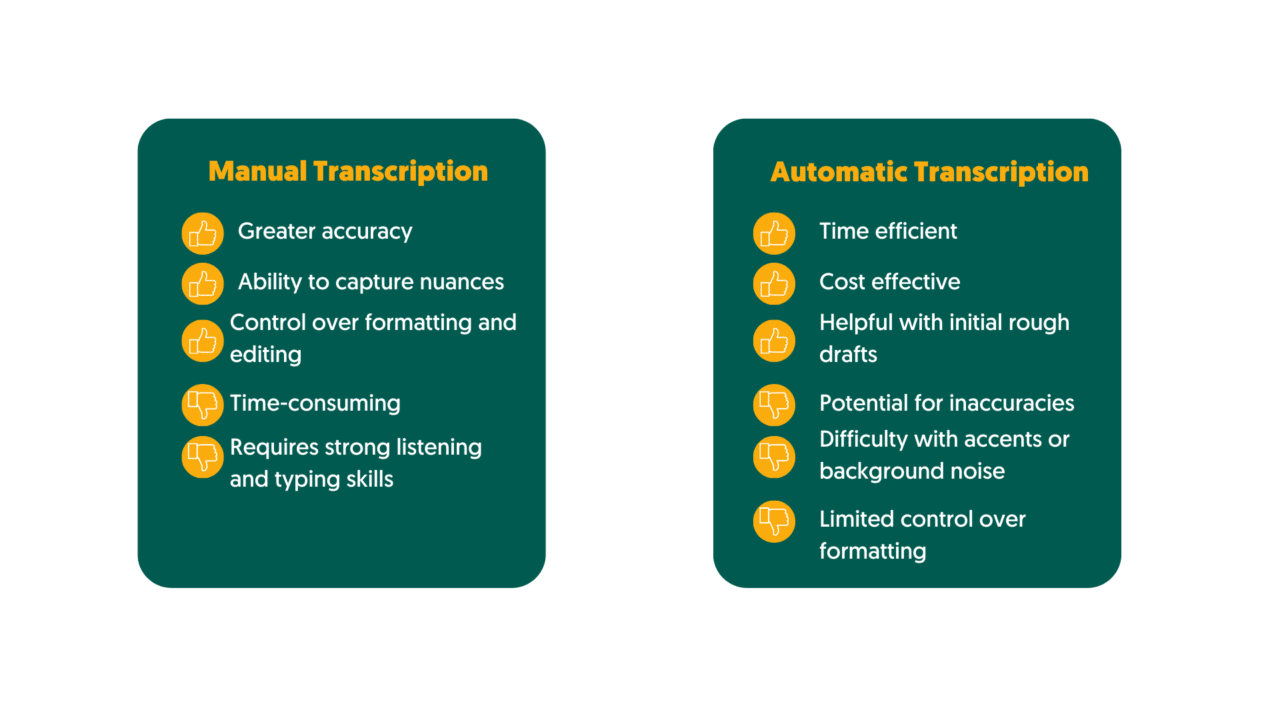
Effective Listening and Note-Taking
Develop active listening skills to capture important details accurately. Maintain focus, take brief pauses when needed, and avoid distractions during the transcription process. Make use of playback options to review unclear sections. As you listen, use appropriate techniques to identify and mark significant segments of the interview. This can include notable quotes, key topics, or any sections requiring further attention during transcription. Highlighting these areas will help streamline the process and ensure accurate representation of critical information.
Transcribing Style and Format
Aim for an accurate and unbiased representation of the interviewee’s words. Transcribe the speech faithfully without altering or omitting any essential information. Include any verbal cues, pauses, or non-verbal expressions that contribute to the context. Follow standard grammar and punctuation rules while transcribing interviews. Use appropriate paragraph breaks, quotation marks, and speaker identifiers to ensure clarity. Use [inaudible] for any indiscernible parts and [unclear] for sections that are difficult to understand.
Time Management and Organization
Create a realistic schedule to manage your transcription workload effectively. Consider the length of the interview, your other commitments, and any deadlines you need to meet. Breaking down the transcription process into manageable chunks can improve efficiency. Develop a consistent naming convention for your transcription files, including the interviewee’s name, date, and any other relevant details. Organize your files into appropriate folders or use transcription management software to ensure easy access and retrieval of transcripts when needed.
Remember, accurate transcription is essential for maintaining journalistic integrity and providing reliable information to your audience. By following these best practices, you can streamline the transcription process and produce high-quality transcripts that serve as valuable resources for your journalistic work.

Quality Assurance and Editing
Quality assurance and editing are two important steps for any transcription process, especially when it comes to transcribing interviews for journalists and reporters. A thorough review and editing process will ensure accuracy in the transcripts, which can be an invaluable resource for journalists.
One of the best practices for quality assurance is to have multiple sets of eyes review the transcript. Having a second set of eyes review the transcript will help catch any mistakes or inconsistencies that may have been missed during transcription. It also ensures accuracy in spelling, names, and other details that are essential to a complete transcript.
In addition to having multiple sets of eyes review the transcript, another important practice is to adhere strictly to a certain style guide throughout the entire transcription process. This will help maintain consistency in formatting, terminology, punctuation, and other aspects of each transcript. By following a predetermined style guide, accuracy in each transcript is more likely.
Editing should occur both during and after the transcription process as well. During transcription, if there are certain words or phrases that may be difficult to understand or interpret correctly, they should be noted so that they can be double-checked later on during editing. During editing after transcription has taken place, all notes made during transcription should be reviewed and corrected where necessary. Additionally, any abbreviations used should be checked against their full versions to ensure accuracy in understanding each phrase or sentence accurately. Lastly, any typos should obviously be fixed before sending out a final transcript for use by journalists or reporters.
Overall, quality assurance and editing are essential steps when it comes to transcribing interviews for journalists and reporters. Through following best practices such as having multiple sets of eyes review transcripts as well as adhering strictly to style guides throughout the entire process; accuracy in transcripts is far more likely which can help provide invaluable resources for journalists’ research needs.
Tools and Resources
When it comes to transcribing interviews for journalists and reporters, there are several tools and resources available. These include both physical tools such as recorders, microphones, and even transcription software; as well as online resources such as templates or style guides.
For physical tools, a basic recorder or microphone can be an invaluable asset when it comes to capturing audio recordings that need to be transcribed. Recording devices vary in price depending on the quality of audio that is desired however most recorders come with adequate sound recording capabilities. Additionally, transcription software provides a way for transcripts to be created quickly and efficiently from an audio recording. Transcription software also allows for easier integration with other services such as speech-to-text or text-to-speech.
In addition to physical tools, there are also online resources that can help with the transcription process. For example, Amberscript has a transcription app that allows you to record the interview and obtain your transcript all with your phone. This streamlines the transcription process, as you do not have to upload the files from a laptop, saving time and enhancing productivity.
Overall, there are several options available when it comes to transcribing interviews for journalists and reporters. Physical tools like recorders and microphones can help capture audio recordings accurately while transcription software provides a way to quickly create transcripts from recorded audio files. Additionally, online resources such as templates and style guides can help ensure accuracy in formatting while tutorials on how to use certain types of software can offer further instruction if necessary.

Get a customized offer
Request a quote for your transcription needs
Transcribing interviews for journalists and reporters can be a difficult process, but with the right tools and resources it doesn’t have to be. Quality assurance and editing are key steps in creating accurate transcripts that will provide invaluable assistance to journalists during their research efforts. By utilizing physical tools such as recorders or microphones along with transcription software, capturing audio recordings accurately is possible. In addition, online resources like templates and style guides can help ensure accuracy in formatting while tutorials on how to use certain types of software offer further instruction when needed. With these tips in mind, transcribing interviews for journalists should become much easier going forward!
Essential Transcribing Tips for Reporters with Easy-to-Use Tools
Transcription is an essential part of the journalism process. It involves taking spoken words, converting them to written form and preserving the original meaning and intention. Transcription provides a permanent record that journalists can refer back to in order to accurately source information or capture quotes for articles and reports. By using easy-to-use transcription tools, reporters can quickly and efficiently transcribe recordings for use in their stories without having to invest in expensive software or equipment. In this blog post, we will explore some essential transcribing tips for reporters along with a few recommended easy-to-use tools that can make the job easier.
Table of Contents
- Choosing the Right Transcription Tool
- Preparing for Transcription
- Tips for Efficient Transcription
- Ensuring Accuracy in Transcription
- Data Security and Privacy
- Finalizing Transcriptions
- Essential Transcribing Tips for Reporters
Choosing the Right Transcription Tool
Having the right transcription tool is essential for successful transcribing. It is important to look for reliable transcription services that offer high-quality results and a range of features such as timed transcripts, automated speech recognition, and multiple languages. This will ensure that you can accurately capture and document all relevant information from your recordings with minimal effort. With the right transcription service, you can be sure that your transcripts are accurate enough to use in articles or reports.
Comparing different transcription tools and their features
When choosing a transcription tool, it is important to compare different options and their features so that you can find the best one for your needs. Not all transcription tools offer the same features, so it is important to look for services that provide automated speech recognition, multiple language support, and timed transcripts. Some services may offer other useful features such as audio-editing capabilities or integrations with other software. By researching and comparing different transcription tools, you can make sure that you choose the one that provides the right balance of price and features for your specific needs.
Amberscript: a leading supplier for automated and professional transcription
Among the best transcription tools out there is Amberscript. This powerful service offers both automated and professional transcription services with features such as multi-language support, automated speech recognition, and timed transcripts that make it a great choice for both experienced reporters and those new to using transcription tools. What’s more, Amberscript has an easy to use interface along with helpful customer support that provides assistance when needed. Amberscript offers competitive pricing plans allowing users to pay only for what they need, making it one of the most cost effective options on the market. With all these features combined, Amberscript makes transcribing recordings fast and simple for even the busiest reporters.

Get a customized offer
Request a quote for your transcription needs
Preparing for Transcription
Recording High-Quality Audio
Before beginning the transcription process, it is important to ensure that you have high-quality audio recordings. Poor audio quality can make transcribing difficult and time consuming so it is essential to make sure that your source recordings are as clear as possible. It’s also helpful to record in a quiet environment with minimal background noise. This will help reduce the amount of noise interference present in your recordings and make them easier to transcribe.
Minimizing Background Noise and Disruptions
In order to produce the best results from a transcription tool, it is important to minimize background noise and disruptions during recordings. This can be done by using a microphone with good noise cancellation capabilities or by setting up the recording in a quiet room with minimal sound interference. By minimizing distractions during recordings, reporters can ensure that their source material is as clear as possible, which will make the job of automatically transcribing audio easier for tools such as Amberscript. Additionally, this will also help produce more accurate transcripts from manual transcription services like those offered by Amberscript.
Using Suitable Recording Equipment and Microphones
Using the right recording equipment and microphones can also help minimize background noise and ensure high-quality recordings. It is important to look for equipment that has good noise cancellation capabilities as well as a microphone that is suitable for the environment you are recording in. Additionally, some microphones may be better suited for transcribing certain types of voices or accents than others, so it is important to consider these factors when making your selection. By using equipment and microphones that are optimized for transcription, reporters can make sure that their recordings will be clear enough to transcribe accurately and quickly.
Tips for Efficient Transcription
Breaking Audio Into Smaller Segments for Better Accuracy
One of the best tips for efficient transcription is to break audio into smaller segments. This can help improve accuracy and save time by reducing the amount of material that needs to be transcribed at once. Additionally, by breaking the audio up into shorter chunks, it is easier to review and make corrections if needed. However, when using a professional transcription tool such as Amberscript, this step is not necessary as automated speech recognition technology can quickly and accurately transcribe long recordings without having to manually break them down.
Understanding the Transcription Tool’s Features and Shortcuts
It is also important to understand the features and shortcuts offered by your transcription tool. Most transcription tools offer a range of options such as automated speech recognition, timed transcripts, and audio editing capabilities. Taking some time to learn about these features can help you take advantage of them and speed up the transcription process. Many of these tools offer helpful keyboard shortcuts so it’s worth spending some time getting familiar with them in order to make transcribing easier and more efficient. For example, Amberscript offers an array of features such as multi-language support, audio editing capabilities, and timed transcripts to make the transcription process easier. What’s more, Amberscript also provides helpful keyboard shortcuts and a user-friendly interface that makes it simple for even beginners to take advantage of its powerful features. With all of these features combined, Amberscript is one of the most efficient and reliable transcription tools available today.
Leveraging Custom Dictionaries for Industry-Specific Terms
Leveraging custom dictionaries for industry-specific terms is a great way to quickly and accurately transcribe material in a specific field. Amberscript gives reporters the ability to add their own personalized glossary which contains words or phrases that are regularly used in their particular line of work. This can help make the transcription process faster while ensuring that all of the important details are captured correctly. Using a custom dictionary also allows you to use alternate spellings or terms that may not be commonly understood. By taking advantage of these features, reporters can save time and produce accurate transcripts with ease.
Ensuring Accuracy in Transcription
Reviewing and Editing Automated Transcripts
One key step to ensuring accuracy in transcription is to review and edit automated transcripts. While automated transcripts can be helpful for quickly getting a rough draft of the material, it’s important to go through them manually and make any necessary corrections or adjustments. This process can take some time but is essential for making sure that your transcriptions are accurate and complete.
For extra precise transcriptions, manual transcriptions are a great option. With manual transcription, an experienced typist will go through the recording and produce a high-quality, accurate transcript. Amberscript offers experienced professional typists who can help with this process and ensure that your transcriptions are of the highest quality possible.
How to Transcribe With Amberscript

Implementing Speaker Identification in Multi-Participant Conversations
When transcribing multi-participant conversations, it is essential to implement speaker identification in order to ensure accuracy. Amberscript offers automated speaker distinction which can make this process simpler and more efficient. Additionally, providing context for each conversation such as noting the locations of the participants or other relevant information will help ensure that your transcriptions are accurate and easy to follow. By taking advantage of these features, reporters can quickly produce high-quality transcripts with ease.
Timestamping for Easy Reference to Specific Sections
Timestamping is a key tool for ensuring accuracy in transcription. Amberscript adds timestamps automatically at various points throughout the recording which can make it much easier to quickly reference and locate sections of audio as needed. This can be helpful for reporters who may need to go back and review portions of recordings or revisit certain topics, saving time while producing accurate transcriptions that are easy to follow. Finally, it’s important not to rush through the transcription process and take your time to ensure accuracy. With patience and following the tips above, you will find that the transcription process is much more efficient while providing high-quality results.
Data Security and Privacy
Data security and privacy are essential when it comes to transcription. With sensitive information such as personal details or confidential business documents being transcribed, it’s important to take stringent measures to ensure that the data remains secure. This can include using strong passwords for access control, deploying encryption techniques, and ensuring that only authorized personnel have access to the recordings and transcripts. Taking these steps will help protect confidential information and keep it out of the wrong hands.
Ensuring the transcription tool complies with privacy regulations
When selecting a transcription tool, it’s essential to ensure that the tool complies with privacy regulations. Amberscript is GDPR compliant, meaning any data stored or processed through their services is secure and safe. By taking the time to research your transcription tool and understand its security protocols, you can guarantee that confidential information remains protected during the transcription process.
Finalizing Transcriptions
Finally, it’s important to thoroughly proofread and verify transcriptions before they are finalized. This is especially true when dealing with sensitive information or legal documents that require accuracy in order to be valid. Taking the time to review transcripts can help catch any errors or discrepancies that may have been missed during the initial transcription process. Many tools offer features such as integrated spell-checkers and auto-correction capabilities which can help ensure accurate results. By double-checking your work and using these helpful features, you can make sure all transcripts are accurate prior to finalization. By taking the time to properly prepare for the transcription process, leverage helpful tools and features, and thoroughly check each transcription before it’s finalized, you can save time and ensure accurate results each and every time. With Amberscript, you can edit your transcript in the editor yourself or you can outsource the task to their experienced professionals who can help ensure accuracy and quality. Following these tips will help you make the most out of your transcription experience.
Exporting Transcriptions in Different Formats
Once a transcription is finalized, it can then be exported in different formats depending on the needs of the user. Many tools offer ways to export transcripts as PDF files, audio clips, or other document types for easy distribution and sharing. Additionally, some tools provide integration with third-party programs which allow users to export transcriptions directly into their existing workflows. By taking advantage of these features, you can quickly and easily share your completed transcriptions with clients or colleagues in just a few clicks.
Integrating transcribed content into reporting workflow
Transcribed content can be integrated into a reporting workflow for easy access and analysis. Many transcription tools offer ways to export data in a variety of formats, such as CSV or JSON, that can then be used with third-party programs. This allows users to quickly import large amounts of data into their existing workflows, saving time and effort in the process. Some programs also provide features such as searchable transcripts which can help locate specific information more easily. With these features at your disposal, you will have all the necessary tools to make the most out of your transcription experience and ensure accurate results every time!
Recap of Essential Transcribing Tips for Reporters
In conclusion, Amberscript is the perfect tool for any reporter who wants to streamline their journalism workflow. With its easy-to-use features and comprehensive capability, Amberscript can help save time and ensure accurate results every time. By taking the time to properly prepare for your transcription task, leveraging helpful tools and features provided by Amberscript, and thoroughly proofreading each transcript before finalization, you can make sure all transcripts are accurate prior to finalization. Additionally, utilizing easy-to-use transcription tools like Amberscript will allow reporters to better manage their workflows while also streamlining reporting processes. So don’t hesitate – take advantage of all that Amberscript has to offer and make the most out of your transcription experience today! With these essential tips in mind, reporters can remain competitive in today’s ever-evolving media landscape.
Transcribe audio to text without errors and receive a perfect export.
Audio transcription has never been this simple. Start now and save hours of time!
Your audio files are confidentially stored in a secure environment.
Why Podcasting Is a Good Way to Share Your Expertise
Podcasting, a phenomenon rapidly growing in the digital landscape, is reinventing the way experts disseminate their knowledge, foster community, and market their unique value proposition. If you are an expert in a specific domain, you possess valuable insights, experiences, and skills that others are eager to learn. Podcasting offers an unparalleled platform to communicate this expertise. It enables you to carve out a niche, build a dedicated following, and establish yourself as an authority in your field. This piece delves into the multiple reasons why podcasting is an excellent medium for sharing your expertise and the myriad of benefits it brings to your personal brand or business.
Advantages of Podcasting in a Nutshell
- Accessibility: Making Expertise Universally Available
- Convenience and Portability: Delivering Knowledge On-Demand
- Long-Form Content: A Deep Dive into Your Expertise
- Niche Targeting: Connecting with the Right Audience
- Evergreen Content: Timeless Insights
- Networking and Collaboration: Broadening Your Expertise and Audience
- Authenticity and Connection: Creating a Loyal Following
Transcribe your Podcasts in 3 simple Steps with Amberscript

1. Accessibility: Making Expertise Universally Available
In the digital era we are living in, podcasts serve as an accessible conduit for information consumption. They transcend geographical and temporal barriers, converting your knowledge into a format that can be readily consumed anywhere and at any time. Whether your audience is commuting, working out at the gym, or preparing dinner, they can simultaneously tap into your expertise.
Moreover, transcription services like Amberscript make your podcast universally accessible. By transforming audio content into text, your podcast becomes accessible to a wider audience, including individuals with hearing impairments and non-native English speakers. This ensures that everyone can learn from your expertise, effectively broadening your reach.
2. Convenience and Portability: Delivering Knowledge On-Demand
Podcasts are both downloadable and portable, making them a supremely convenient way of ingesting content. Listeners can carry your insights wherever they go and learn from you at their convenience. This flexibility aligns perfectly with today’s fast-paced lifestyles, making podcasts an increasingly popular choice for many.
3. Long-Form Content: A Deep Dive into Your Expertise
Podcasts stand out in their ability to deliver long-form content effectively. While numerous media channels are veering towards shorter, quick-to-consume content, podcasts excel in presenting comprehensive insights. They allow you to delve deeply into your subject matter, delivering nuanced discussions that are often glossed over in short-form content. Podcasting enables you to showcase the breadth and depth of your expertise, providing meaningful content that dedicated learners crave.
4. Niche Targeting: Connecting with the Right Audience
Podcasting allows you to tap into niche audiences with precision. By zeroing in on a specific topic or field of expertise, your podcast can attract an engaged and relevant audience. Listeners who seek out your content are more likely to engage with your brand, share your work, and develop into brand advocates. Consistently providing high-quality, focused content allows you to reinforce your status as an expert in your field.
5. Evergreen Content: Timeless Insights
One of the many advantages of podcasting is the creation of evergreen content — content that retains its value and relevance over time. Once you publish a podcast episode, it remains available indefinitely, continually drawing in new listeners and offering lasting value. This enduring nature of podcast content amplifies the reach and impact of your insights, benefiting audiences long after the original publication date.
6. Networking and Collaboration: Broadening Your Expertise and Audience
Podcasting provides ample opportunities for networking and collaboration. When you invite other experts in your field for an interview, it not only enriches your content but also expands your reach. You can tap into the guest’s audience, thereby attracting new listeners to your podcast. Reciprocally, being a guest on another podcast can introduce your expertise to new audiences, increasing your visibility and impact.
7. Authenticity and Connection: Creating a Loyal Following
Podcasts facilitate an authentic and intimate connection between you, the expert, and your audience. This medium lets listeners hear your voice, your passion, and your thought process directly. It fosters a sense of personal connection and trust that text-based content often can’t match. This authentic connection is key to building a loyal audience. Listeners are more likely to engage with and trust a brand they feel personally connected to.
Realize the Potential of Podcasting
Podcasting is a dynamic and effective platform for experts to share their knowledge. It offers unparalleled accessibility and convenience, allows for detailed exploration of your subject matter, and offers significant opportunities for networking. The capacity to create evergreen content and the ability to forge an authentic connection with your audience underscore the value of podcasting. As an expert looking to share your knowledge, influence, and reach, consider embracing the power of podcasting to amplify your voice and impact.
Why Podcasting Is an Excellent Way to Reach Target Market or New Audiences
In today’s rapidly evolving digital landscape, successful marketing strategies necessitate creative, immersive, and engaging mediums that resonate with diverse audiences. One such medium that’s gained tremendous traction in recent years is podcasting. This incredibly versatile platform offers unique opportunities for brands to expand their reach, build deeper connections, and create lasting impact. And when combined with transcription and subtitling services like those offered by Amberscript, your podcast content can become even more inclusive and powerful. But let’s not get ahead of ourselves. Let’s first explore why podcasting is such a potent tool for reaching your target market or new audiences.
Agenda
- The Allure of Podcasting
- 1. Identifying and Understanding Your Target Audience
- 2. Developing a Unique and Compelling Brand Voice
- 3. Leveraging SEO and Transcription Services
- 4. Engaging with Your Audience
- 5. Monetizing Your Podcast
- 6. Utilizing Cross-Promotion
- 7. Making Your Podcast Accessible
- Podcasting, The Marketing Tool of the Future
The Allure of Podcasting
Podcasting isn’t just a fleeting trend; it’s a game-changing marketing tool that’s here to stay. According to Edison Research, as of 2023, over 40% of Americans aged 12 and older have listened to a podcast, and these numbers continue to rise. This surge in popularity isn’t merely coincidental. It’s born out of the unique attributes that make podcasts so appealing to today’s digitally savvy consumers.
Firstly, podcasts offer content versatility like no other medium. They can accommodate a wide range of topics, formats, and styles, from intimate personal narratives and expert interviews to roundtable discussions and educational lessons. This flexibility enables brands to craft content that aligns with their identity, values, and marketing objectives while resonating with their specific audience.
Secondly, podcasts cater to the on-the-go lifestyle of today’s consumers. People can listen to podcasts while commuting, working out, cooking, or doing virtually anything, anywhere, anytime. This convenience factor significantly broadens your potential audience reach and engagement.
Moreover, podcasting allows for in-depth exploration of topics, creating opportunities for brands to showcase their expertise, build authority, and establish a strong brand voice. Unlike social media posts or blog articles that often skim the surface, podcasts can dive deep, providing value that fosters trust and loyalty among listeners.
So far, it sounds like podcasting has it all, doesn’t it? Well, it doesn’t stop there. Let’s delve into some strategies for harnessing the power of podcasts to tap into new markets and audiences.
1. Identifying and Understanding Your Target Audience
The first step in leveraging podcasts for reaching your target market or new audiences is to gain a solid understanding of who your listeners are, what they value, and how they consume content. Once you’ve identified your audience, tailor your podcast content to cater to their interests, needs, and consumption habits. Remember, the more relevant your content is to your listeners, the more engaged they’ll be.
2. Developing a Unique and Compelling Brand Voice
Your podcast is an extension of your brand, and as such, it should reflect your brand’s personality, values, and mission. By developing a unique and compelling brand voice, you can differentiate yourself from the competition, attract your target audience, and build strong brand recognition.
3. Leveraging SEO and Transcription Services
SEO isn’t just for written content. By optimizing your podcast for search engines, you can boost your visibility, reach a wider audience, and drive more traffic to your website. Incorporating keywords into your podcast title, description, and transcript can significantly improve your SEO performance.
This is where Amberscript’s transcription services come into play. Transcribing your podcast episodes not only improves accessibility for those who prefer or need to read content, but it also provides more content for search engines to index, enhancing your SEO.
4. Engaging with Your Audience
Engagement is crucial for any marketing strategy, and podcasting is no exception. By engaging with your listeners, you can build a community around your brand, foster loyalty, and gain valuable feedback that can help you refine your podcast content and marketing strategies. There are many ways to engage with your podcast audience, from encouraging comments and reviews to hosting Q&A sessions and creating interactive content.
5. Monetizing Your Podcast
As your podcast grows and attracts a loyal audience, various monetization opportunities can emerge. From sponsorships and partnerships to premium content and merchandise sales, podcasting can become a significant revenue stream for your brand. Remember, monetization is not just about immediate revenue; it’s also a measure of the value your audience places on your content.
6. Utilizing Cross-Promotion
Cross-promotion is a powerful strategy for expanding your reach. By collaborating with other podcasters, influencers, or brands, you can tap into their audiences and introduce your podcast to potential new listeners. Make sure to choose cross-promotion partners that align with your brand values and cater to the audience demographics you aim to reach. Learn more about marketing your podcasts here.
7. Making Your Podcast Accessible
Inclusivity is not only ethically right; it’s also good business practice. Making your podcast accessible to everyone, including those with hearing impairments or non-native English speakers, can significantly broaden your potential audience. This is where Amberscript’s services shine. By providing accurate transcriptions and subtitles for your podcast, Amberscript ensures that your content is truly for everyone.
Podcasting, The Marketing Tool of the Future
To sum it all up, podcasting offers a unique opportunity for brands to engage with their target markets and reach new audiences in a personal and immersive way. It’s an innovative and versatile platform that can boost your brand authority, foster a loyal community, and expand your marketing reach.
However, the magic of podcasting doesn’t lie solely in the medium itself but in how you use it. By understanding your audience, crafting compelling content, engaging with your listeners, leveraging SEO and transcription services, and exploring monetization and cross-promotion opportunities, you can harness the power of podcasting to take your marketing strategy to the next level.
As the digital landscape continues to evolve, podcasting stands out as a powerful marketing tool that’s here to stay. And with the help of services like Amberscript, you can maximize the impact of your podcast and ensure that your brand’s voice reaches as many ears (and eyes) as possible.
So, are you ready to take your marketing strategy to new heights with podcasting? Your audience is waiting to hear from you. Tune in, turn up the volume, and let your brand’s voice be heard. Here you will find some more tips!
9 reasons why podcasts are a powerful marketing tool
In the ever-evolving digital landscape, podcasts have emerged as a force to be reckoned with. Offering a compelling blend of entertainment and information, they’ve captivated audiences worldwide and given brands an innovative way to share their story. But what truly makes podcasts stand out in the crowded realm of digital marketing? And how can transcription services, like Amberscript, amplify their potential?
In this comprehensive article, we delve into why podcasts are an incredibly powerful marketing tool and how combining them with transcription can take your marketing strategy to new heights.
9 Reasons in a Nutshell
- Accessibility and Reach
- Connection and Engagement
- Building Trust and Credibility
- Increasing Brand Visibility
- Building a Community
- Accessibility and SEO
- Improved User Experience
- Content Repurposing
- Enhancing Engagement and Understanding
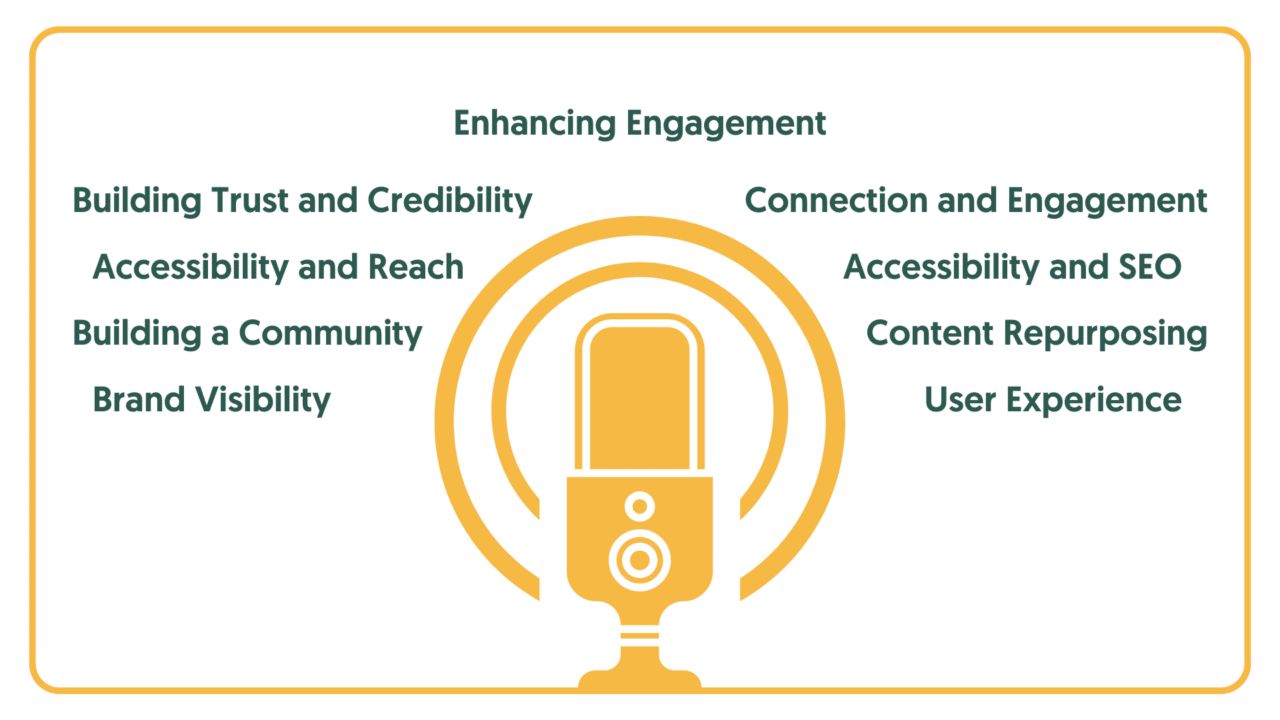
Accessibility and Reach
Podcasts have seamlessly woven themselves into the fabric of our digital lives.
As mobile technology continues to evolve, so does the ease with which we can access a diverse range of podcasts. Whether you’re passionate about entrepreneurship, cooking, health and fitness, or even astrophysics, there’s a podcast out there for you. This versatility makes podcasts a powerful marketing tool, capable of reaching various demographics and psychographics. Moreover, podcasts offer a unique form of flexibility. Whether you’re commuting, working out, or taking a break, you can plug into your favorite podcasts, making the consumption of content a convenient and enjoyable experience.
Connection and Engagement
Marketing in the modern era is all about connection.
Brands are not just looking to sell a product or a service; they’re looking to tell a story, to resonate with their audience. Podcasts, with their auditory format, offer a unique advantage in this regard. The experience of listening to a podcast is much like having a conversation with the host. This creates an intimate atmosphere that allows brands to connect with their audience on a deeper level. Additionally, podcasts usually run longer than traditional commercials or promotional videos, allowing for in-depth discussions and extensive explorations of topics. This not only showcases the brand’s expertise but also provides substantial value to the audience, leading to higher engagement rates.
Building Trust and Credibility
Trust and credibility have become paramount in today’s marketplace.
Consumers are increasingly skeptical of traditional advertisements, preferring to invest in brands that offer real value and demonstrate industry expertise. Podcasts provide an ideal platform for thought leadership. They allow brands to engage in extensive discussions, share insights, and collaborate with industry experts. This exchange of valuable knowledge fosters trust among listeners and builds the brand’s credibility in the industry.
Increasing Brand Visibility
The digital nature of podcasts means they are not confined to a single platform.
They can be shared across a variety of channels, including social media, websites, and podcast directories, amplifying the brand’s reach. Moreover, listeners often share episodes they enjoy with their network, leading to organic growth and increased brand visibility.
Building a Community
Podcasts have a unique way of fostering a sense of community.
Regular listeners often feel like they’re part of an exclusive club. They engage in online discussions about the episodes, sharing their thoughts, insights, and opinions. This community-driven engagement is a goldmine for brands, as it not only fosters loyalty among listeners but also cultivates a pool of brand advocates. While podcasts are powerful marketing tools in their own right, their potential skyrockets when they’re paired with transcription services. At first glance, the connection might not be apparent, but delve a little deeper and the synergy becomes clear. Transcriptions can amplify the reach of your podcasts, make them more accessible, and even boost your SEO efforts. This is where Amberscript, a leading transcription service provider, steps into the picture.
Accessibility and SEO
Transcribing your podcasts does much more than create a text-based version of your content.
It widens the net of accessibility, making your podcasts available to people who are hard of hearing, those who are in a noise-sensitive environment, or even those who simply prefer reading over listening. Additionally, transcriptions provide a substantial SEO boost. While search engines can’t index audio content, they can crawl and index text, which means your transcribed podcasts are more likely to rank higher in search results, attracting a larger audience and potentially driving more conversions.
Improved User Experience
User experience plays a pivotal role in shaping the consumer’s journey.
By providing transcriptions, brands can cater to different audience preferences, improving the overall experience. Some listeners might prefer reading the content or using the text as a reference. Others may find it easier to focus and understand complex concepts when they read along. This adaptability to diverse consumer preferences is a key benefit of podcast transcriptions.
Content Repurposing
One of the biggest advantages of podcast transcription is the ability to repurpose content.
You can transform your podcast transcripts into blog posts, infographics, social media updates, eBooks, and more. This allows you to cater to a wider range of audience preferences, expand your content’s reach, and get more bang for your buck from each episode.
Enhancing Engagement and Understanding
Providing transcripts for your podcasts enhances your audience’s engagement and understanding.
Being able to read along with the podcast allows listeners to digest the information at their own pace. They can pause, highlight, or take notes, leading to better retention of your message.
In conclusion, podcasts are more than just the modern evolution of radio. They are a formidable tool in the marketer’s arsenal, with the power to forge connections, build trust, and foster community. Combined with the accessibility, SEO, and engagement benefits of transcription services like Amberscript, the potential of podcasts skyrockets. So, whether you’re a seasoned marketer exploring innovative avenues or a budding entrepreneur looking to make your mark, harnessing the power of podcasts, coupled with transcription, can set you on the path to success.
Ready to unleash the power of podcast digital marketing? Remember, it’s not just what you say, but how you present it. So, leverage the power of Amberscript and let your brand’s voice resonate with your audience. Happy podcasting!
Maximizing Exposure and Engagement with a Global Audience on YouTube
YouTube is an essential platform for anyone looking to reach a global audience. With its massive user base and powerful video hosting capabilities, YouTube offers countless opportunities for content creators to maximize exposure and engagement with audiences from around the world. However, in order to capitalize on these opportunities, it’s important to understand how best to create engaging content that appeals to a diverse viewership. This article will provide key strategies for understanding your target global audience and optimizing your YouTube channel and videos in order to maximize exposure and engagement with a global audience. By following them, you can ensure your YouTube content reaches the most people and remains engaging for viewers from all around the world. Let’s get started!
Table of contents
- Understanding Your Target Global Audience
- Creating Engaging Content for a Global Audience
- Optimizing YouTube Channel and Videos
- Leveraging Social Media and Cross-Promotion
- Utilizing Localization Strategies
- Engaging with the Global Community
- Building a Global Network
- Tracking and Analyzing Metrics
Understanding Your Target Audience
When it comes to creating a successful YouTube channel, understanding your target audience is essential. Determining who your target audience is will help you tailor content that resonates and engages them with the right messaging.
One way to get an idea of who you should be targeting is by looking at what kind of content already exists on YouTube and which topics are discussed most often in your niche. For example, if you’re creating a fitness-related channel, look for channels that are already successful in the same niche and analyze their videos – which topics are they discussing? What kind of language do they use? Do certain types of videos perform better than others?
You can also conduct market research and surveys to gain insights into your target audience’s needs, interests, and behavior. This will give you valuable information that can help guide your content strategy and ensure that the content you create is tailored to your specific target audience.
By understanding your target audience, you can create content that resonates with them and establish a meaningful connection with viewers. Ultimately, this will help you build an engaged community of followers who are more likely to support your channel in the long-term.
Why you should use Amberscript
Audio transcription has never been this simple. Start now and save hours of time!
Transcribe audio and video to text without errors and receive a perfect export.
GDPR compliant security and safety. Your files are confidentially stored in a secure environment.
Creating Engaging Content for a Global Audience
When creating content for a global audience, it’s important to keep in mind that different cultures have different values and preferences. To ensure you are engaging with an international audience, consider creating content across multiple platforms such as Facebook, Twitter, Instagram and YouTube. Having a presence on these channels will help give your brand more reach and visibility around the world.
When utilizing YouTube as part of your content strategy, make sure to create videos that are tailored to different countries or cultural backgrounds. This could include localized versions of existing videos or even new content created specifically for those audiences. It’s also important to provide subtitles in different languages so all viewers can understand what is being said in each video. Additionally, consider adding localized branding elements to your videos to make them more relatable for viewers in different parts of the world.
Creating engaging content for a global audience does not have to be an intimidating task. By putting in the time and effort to create localized versions of existing content and creating new content specifically tailored for different countries, you can ensure that your brand is reaching a wide range of people around the world. With enough dedication and research, creating successful content for a global audience is definitely achievable!
Optimizing YouTube Channel and Videos
Optimizing your YouTube channel and videos can help you become more successful on the platform. Here are some tips to keep in mind when optimizing your Youtube channel and videos:
- Create compelling titles for your videos – Titles should be descriptive, concise, and catchy to grab viewers’ attention. Use relevant tags and descriptions that resonate with your audience, and include keywords to improve search engine visibility. This optimization helps potential viewers find your content when searching for related topics.
- Use custom thumbnails for each video – Create visually appealing and attention-grabbing thumbnails that accurately represent the content of your videos. Thumbnails serve as a preview and can significantly impact click-through rates. Additionally, create engaging video intros that captivate viewers from the start, encouraging them to watch the entire video and subscribe to your channel.
- Optimize video metadata for search engine optimization (SEO) – Pay attention to the details of your video metadata, including closed captions, transcripts, and subtitles. Subtitling, in particular, is a valuable tool for optimizing your videos. By adding subtitles or closed captions in multiple languages, you enhance accessibility for viewers who are deaf or hard of hearing and cater to a global audience. Additionally, subtitles provide text-based content that can be indexed by search engines, boosting your video’s visibility in search results. You can easily obtain subtitles by using Amberscript’s subtitling services.
Leveraging Social Media and Cross-Promotion
Social media is an essential tool for marketing, as the audiences you reach on these platforms are massive. Utilizing YouTube for example, can help your business gain a huge amount of exposure with videos that are educational or entertaining and related to your brand. Creating a channel allows customers to watch content that will engage them, making it more likely that they will remember your company when they need its services or products.
Cross-promotion is another great way to get the word out about what you’re offering. Finding other businesses with similar markets can open up opportunities for both of you. For instance, if you offer web design services, find a hosting company who would benefit from your services and reach out to them about forming a collaboration. Both of you may be able to gain new customers due to the promotion.
Using social media and cross-promotion are great ways to increase brand awareness and help expand your customer base. Don’t forget to take advantage of these tools while marketing for your business!
Utilizing Localization Strategies
Localization is a great strategy that can help any organization reach more customers in their target market. To make the most out of this strategy, organizations should consider utilizing YouTube as part of their localization efforts. By creating a localized YouTube channel, businesses can create content specifically targeted at audiences in different regions or countries. This localized video content can be used to introduce new products and services, showcase existing offerings, and even respond quickly to customer inquiries. Additionally, localized channels on YouTube allow for companies to personalize messages intended for local markets, making it easier for customers to connect with the brand. Through these localized channels, organizations are able to build relationships with customers across borders while also expanding their global footprint. With the right strategies and resources in place, businesses will be able to make the most out of localization efforts through YouTube.
Utilizing localization on YouTube can come with some challenges, however. Creating localized channels for each target market requires careful planning and resources dedicated towards creating new content for multiple platforms and regions. Additionally, organizations must ensure that their content is culturally appropriate for each given region or country they are targeting in order to ensure success. Moreover, companies should be mindful of any local laws or regulations related to digital media in order to avoid potential legal issues down the line. With these considerations in mind, businesses will be better equipped to leverage localization strategies on YouTube effectively and successfully reach customers across borders.
Engaging with the Global Community
Engaging with the global community goes beyond simply posting content on YouTube. It involves actively fostering interaction and building meaningful connections with your audience. One effective way to do this is by organizing contests and challenges that encourage viewers from different countries to participate. Whether it’s a video submission contest or a creative challenge, these activities create a sense of excitement and involvement, making your audience feel like valued contributors.
In addition to contests, responding to comments and feedback is vital when engaging with your public. Take the time to acknowledge and respond to comments, answer questions and address concerns. This level of interaction demonstrates that you genuinely care about your viewers and their opinions, fostering a sense of community and loyalty.
Live streaming and interactive sessions are powerful tools for engaging with a global audience in real-time. Hosting live Q&A sessions, interactive games, or collaborative projects allows your viewers to directly interact with you and with one another. These sessions create a unique and immersive experience, forging deeper connections and solidifying your presence as an influential content creator.
By actively engaging with your global community, you create an environment that encourages ongoing participation, discussion, and sharing. This not only strengthens the bond between you and your audience but also encourages them to share your content with others, thus increasing your reach and exposure on YouTube.

Get a customized offer
Request a quote for your subtitling needs
Building a Global Network
Building a global network is essential for expanding your reach and influence on YouTube. Establishing connections with content creators, influencers, and brands from different countries can help to introduce your videos to new demographics and tap into unexplored markets. Here are few strategies for taking advantage of the international opportunities available to you:
- Attend international events and conferences: Attending international events related to your niche is an effective way of building relationships with content creators, industry professionals, and enthusiasts from all over the world. Participating in workshops, panels discussions, and networking sessions at these gatherings give you the chance to share ideas with people from diverse backgrounds and cultures while learning more about trends and best practices in the industry.
- Collaborate with creators and influencers from different countries: Linking up with content creators in foreign countries enables you to benefit from their influence while introducing your content to their audience. When seeking potential collaborators, look for those who share similar values or interests as yourself as this will allow both parties to get more out of the partnership. You could collaborate on videos, joint projects, or have them appear as guests on your channel – either option provides a great opportunity for exposure and cross-promotion across borders.
- Explore cross-promotional opportunities with global brands: Partnering up with global brands can not only increase visibility but also add credibility to your channel. Make sure that any brand you collaborate with is a good fit for both your own values and those of your target audience. Possible forms of collaboration include sponsored videos or product integrations which can help bring attention from different parts of the world and open doors for future collaborations or sponsorships.
When building a global network, it’s important to approach collaborations with authenticity and mutual benefit in mind. Seek partnerships that align with your values and resonate with your audience, ensuring that any collaborations feel genuine and add value to your content. Building a strong global network not only helps you reach new audiences but also fosters valuable relationships that can enhance your growth and open doors to exciting opportunities in the YouTube community.
Tracking and Analyzing Metrics
Tracking and analyzing metrics is an important part of running a successful YouTube channel. When it comes to YouTube, there are two main categories of metrics: engagement metrics and performance metrics. Engagement metrics measure how viewers interact with your videos, such as the total number of views, likes, comments, shares and watch time. Performance metrics measure how effectively you’re reaching your target audience and driving traffic to your videos, such as impressions, cost per view or click-through rate. By tracking these different types of data points over time, you can determine which strategies are working best for your channel and make adjustments accordingly. Additionally, analyzing these metrics can help you decide what type of content to create in order to maximize viewership potential. Ultimately, understanding and analyzing your channel’s metrics will help you create better videos and maximize success on YouTube.
By tracking and analyzing these metrics, you can make informed decisions about how to optimize your content in order to get more views, likes, shares, and comments. Additionally, it allows you to monitor your progress over time so that you can accurately measure the success of your efforts. It is important to remember that while numbers are helpful tools for measuring results, it isn’t all about the numbers; how viewers engage with your content should be taken into account as well. Taking the time to track and analyze metrics will allow you to identify trends, refine strategies, and ultimately improve the effectiveness of your content on YouTube.
Find out everything you need to know about subtitling for Youtube
Read the blogBy leveraging the power of YouTube, creating an effective channel and uploading interesting content regularly, you can reach a global audience with ease. With the right strategies in place for optimizing your videos to maximize visibility and engagement, it is possible to build a large following on this platform. As long as you are consistent in producing engaging content that resonates with viewers around the world, there’s no reason why you won’t be able to establish yourself as an authority in your niche. So what are you waiting for? Start building your own successful YouTube channel today!
Unlock the Power of Subtitles: The 10 Best SRT Editors for Mac and Windows Revealed
Whether you’re creating videos or just watching them, subtitles are an essential part of the experience. From giving a greater level of accessibility to providing an alternate way to comprehend and interpret video content, subtitle editors are necessary for both content creators and consumers. Fortunately, there are many great options available that are compatible with both Mac and Windows computers. In this blogpost, we will be exploring the 10 best subtitle editors for both Mac and Windows users alike. Read on to discover which editor is right for you!
Table of Contents
If you’re looking for the perfect subtitle editor to fit your needs, look no further. In this blogpost, we will discuss 10 of the best subtitle editors available for both Mac and Windows users – Amberscript, Subtitle Edit, Aegisub, Jubler, Subtitle Workshop, Subtitle Composer, Amara, SubtitleCreator, Gaupol and Caption. Whether you’re a professional content creator or a casual video watcher who just wants to customise their subtitles with ease – these tools offer everything from basic text editing functions to advanced features like advanced spell-checkers. Read on to find out which one suits your needs the most!
SRT Subtitle Editors
Amberscript
Amberscript is a powerful ai-based automatic transcription and subtitle editor. It’s incredibly easy to use and allows you to quickly and accurately create subtitles for your videos without having to manually type them out yourself. Plus, with its human-made subtitle feature, you can access the services of professional captioners who will provide you with high quality subtitles in a range of languages. If you’re looking for an effortless way to transcribe and add captions to your content, Amberscript is the perfect choice.
Key Features
Amberscript’s speech-to-text transcription capabilities are incredibly accurate, meaning that you can trust it to accurately transcribe your audio and get the best results. It’s also powered by AI which makes it easier for it to pick up on subtle nuances in accent and pronunciation, resulting in a more accurate transcript of your video. With Amberscript, you can be sure that your subtitles will be precise and error-free.
Why you should use Amberscript
Edit your text in minutes, or let our native speakers take over. Rush your order and get your file as fast as 24h.
Native speakers and quality checks ensure that you get 100% accurate transcripts and captions.
With many integrations available, you can seamlessly set up and customize your workflows
Advantages
One of the most impressive features of Amberscript is its user-friendly interface for editing and exporting SRT subtitles. With its intuitive tools, you can quickly make changes to your subtitles and then export them as an SRT file. It also has a range of advanced features such as customisable fonts, colours and backgrounds which you can use to make your files even more eye-catching. Plus, it’s compatible with multiple subtitle formats so you can be sure that you’ll always get the best results no matter what format your project is in. All in all, Amberscript is one of the most comprehensive subtitle editors available today.
How to Edit your Subtitles with Amberscript

Easy to use online text editor
Our online editor effortlessly syncs your audio with the written content, enabling easy adjustments, highlighting sections, and quick searching through the material.
Try it free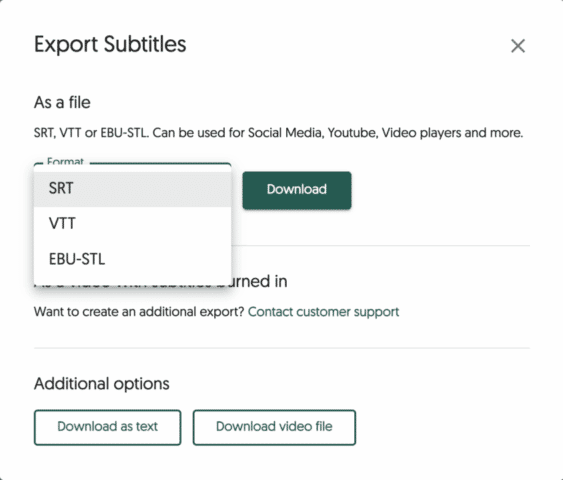
Multiple import and export options
You can import video and audio files in many different formats and export your transcript as a Word, JSON, or text file, with optional timestamps and speaker distinction.
Try it freeSubtitle Edit
Subtitle Edit is a great subtitle editor for both Mac and Windows users. It allows you to easily create, edit and export subtitles in multiple formats from text files or DVD-Video discs. With its wide range of features, you can make simple changes such as spelling corrections, add timecodes and formatting or even synchronise the subtitles with the audio track. Plus, it also supports converting between different subtitle formats so you can adapt your subtitles for any platform. All in all, Subtitle Edit is perfect if you’re looking for an easy to use yet powerful subtitle editor.
Key Features
Subtitle Edit is packed with features that make it perfect for any task. It has a powerful subtitle synchronisation tool which allows you to easily match the subtitles with the audio track. It also has built-in spell-checking and translation capabilities so you can quickly and accurately create subtitles in multiple languages. Plus, it supports a range of different video formats such as MP4, AVI and MKV so you can be sure that your subtitles will work on all platforms. All in all, Subtitle Edit is an excellent subtitle editor for both Mac and Windows users alike.
Advantages
Subtitle Edit also supports a range of different subtitle formats, including SRT. It’s incredibly easy to create and export SRT files with Subtitle Edit and the resulting subtitles are always of the highest quality. Plus, it even allows you to preview your subtitles in real-time so you can make sure that everything is working correctly before exporting your file. All in all, if you need an easy way to create and edit SRT subtitles, then Subtitle Edit is the perfect solution!
Aegisub
Aegisub is a powerful and flexible subtitle editor that’s great for both Mac and Windows users. It can be used to create, edit and export subtitles in multiple formats from text files or DVD-Video discs. With its advanced features such as automated timing, spell correction, audio waveform visualisation and support for a range of different subtitle formats – it’s easy to see why Aegisub is so popular amongst content creators. Plus, it also supports real-time previewing of subtitles which makes it much easier to make sure that everything is working correctly before exporting your project. If you’re looking for a comprehensive subtitle editor with plenty of features, then Aegisub is the perfect choice!
Key Features
Aegisub also offers a range of advanced styling and formatting options which make it perfect for creating professional-looking subtitles. You can easily customize the font, size, colour and other settings to give your subtitles that perfect look. Plus, you can also use Aegisub’s automated timing tools to save time when creating or editing subtitles. All in all, if you’re looking for an easy way to create beautiful and accurate subtitles with plenty of customization options, then Aegisub is the ideal choice!
Advantages
Aegisub also comes with a range of features which make it an excellent choice for content creators. It has a real-time preview feature which allows you to instantly see the changes that you’re making, as well as an automation tool which can speed up your workflow. Plus, its advanced customization options make it easy to create subtitles in any style that you want. All in all, Aegisub is one of the most comprehensive and powerful subtitle editors available today.
Jubler
Jubler is a great user-friendly subtitle editor for both Mac and Windows users. With its intuitive tools, you can quickly create, edit and export subtitles in multiple formats from text files or DVD-Video discs. It also has a range of advanced features such as support for multiple languages, spell checking, and real-time previewing which make it perfect for creating accurate subtitles with ease. Plus, Jubler supports conversion between different subtitle formats so you can be sure that your subtitles will work on any platform. If you’re looking for an easy to use yet powerful subtitle editor then Jubler is the ideal choice!
Key Features
Jubler also has some great features which make it perfect for precise and accurate subtitle editing. It has timeline-based editing which allows you to easily adjust the timing of your subtitles. Plus, it also supports spell-checking in multiple languages so you can quickly and easily create subtitles in any language that you need. All in all, Jubler is a powerful yet easy to use subtitle editor with plenty of features for creating accurate and professional subtitles.
Advantages
Jubler also supports a range of different subtitle formats, including SRT. It’s incredibly easy to create and export SRT files with Jubler and the resulting subtitles are always of the highest quality. Plus, it even allows you to preview your subtitles in real-time so you can make sure that everything is working correctly before exporting your file. All in all, if you need an easy way to create and edit SRT subtitles then Jubler is the perfect choice!
Subtitle Workshop
Subtitle Workshop is a great subtitle editor that’s perfect for both Mac and Windows users. It provides an easy to use interface which makes it incredibly simple to create, edit and export subtitles in multiple formats from text files or DVD-Video discs. Plus, Subtitle Workshop also supports spell checking and real-time previewing which make it much easier to create accurate subtitles with ease. Additionally, it even supports conversion between different subtitle formats so you can be sure that your subtitles will work on any platform. All in all, if you’re looking for an easy yet powerful subtitle editor then Subtitle Workshop is the ideal choice!
Key Features
Subtitle Workshop also supports automated timing which can help you save time when creating or editing subtitles. Plus, it has spell-checking in multiple languages so you can quickly and easily create subtitles in any language that you need. All in all, Subtitle Workshop is an excellent subtitle editor with plenty of features for creating professional-looking subtitles with ease. Whether you’re a beginner or a professional content creator, this software is sure to have everything that you need to make your work look perfect!
Advantages
Subtitle Workshop also comes with a range of features which make it perfect for creating accurate and professional subtitles. It has subtitle synchronization which allows you to easily adjust the timing of your subtitles, spell-checking in multiple languages for quick and easy corrections, and batch conversion between different subtitle formats. Plus, its real-time preview feature lets you instantly see the changes that you’re making so you can always be sure that everything is looking just right before exporting your file. All in all, if you’re looking for an excellent subtitle editor then Subtitle Workshop is the ideal choice!

Request a quote for your subtitling needs
Subtitle Composer
Subtitle Composer is a great cross-platform subtitle editor for both Mac and Windows users. It provides an easy to use interface which makes it incredibly simple to create, edit and export subtitles in multiple formats from text files or DVD-Video discs. Plus, Subtitle Composer also supports spell checking and real-time previewing which make it much easier to create accurate subtitles with ease. Additionally, it even supports conversion between different subtitle formats so you can be sure that your subtitles will work on any platform. All in all, if you’re looking for a powerful yet user-friendly subtitle editor then Subtitle Composer is the ideal choice!
Key Features
Subtitle Composer also has a simple and intuitive interface which makes it easy to learn and use. It has an intuitive timeline-based editing system which enables you to quickly adjust the timing of your subtitles and make changes with ease. Plus, it supports spell-checking in multiple languages so you can easily create subtitles in any language that you need. All in all, if you’re looking for an excellent subtitle editor then Subtitle Composer is the perfect choice!
Advantages
Subtitle Composer also comes with a range of features which make it perfect for creating accurate and professional subtitles. It has synchronization which allows you to easily adjust the timing of your subtitles, spell-checking in multiple languages for quick and easy corrections, and real-time previewing so you can always be sure that everything is looking just right before exporting your file. Plus, its batch conversion feature enables you to quickly convert between different subtitle formats so you’ll never have any compatibility problems. All in all, if you need an easy yet powerful subtitle editor then Subtitle Composer is the ideal choice!
Amara
Amara is a great online subtitle editor that’s perfect for both Mac and Windows users. It provides an easy to use interface which makes it incredibly simple to create, edit and export subtitles in multiple formats from text files or DVD-Video discs. Plus, Amara also supports spell checking and real-time previewing which make it much easier to create accurate subtitles with ease. Additionally, it even supports conversion between different subtitle formats so you can be sure that your subtitles will work on any platform. All in all, if you’re looking for an online solution for editing your subtitles then Amara is the perfect choice!
Key Features
Amara also has some great collaborative subtitle editing capabilities which make it perfect for working with other people on your subtitles. It allows you to easily invite others to collaborate on your project and edit the subtitles together in real-time. Plus, its built-in chat functionality makes it much easier to communicate with others while creating or editing your subtitles. All in all, if you need an easy way to create or edit subtitles with other people then Amara is the ideal choice!
Advantages
Amara also comes with a range of features which make it the perfect choice for creating professional subtitles. It has time-coding support which makes it easy to adjust the timing of your subtitles, translation support so you can easily translate subtitles in multiple languages, and built-in chat functionality for quick and easy collaboration. Plus, its real-time preview feature lets you instantly see the changes that you’re making so you can always be sure that everything is looking just right before exporting your file. All in all, if you’re looking for an excellent subtitle editor then Amara is the ideal choice!
SubtitleCreator
SubtitleCreator is a lightweight yet powerful subtitle editor that’s perfect for both Mac and Windows users. It provides an intuitive user interface which makes it incredibly easy to create, edit and export subtitles in multiple formats from text files or DVD-Video discs. Plus, SubtitleCreator also supports spell checking and real-time previewing which make it much easier to create accurate subtitles with ease. Additionally, it even supports conversion between different subtitle formats so you can be sure that your subtitles will work on any platform. All in all, if you’re looking for a lightweight yet powerful subtitle editor then SubtitleCreator is the ideal choice!
Key Features
SubtitleCreator also comes with support for all the major subtitle formats, including SRT, SSA/ASS, and TTML. Plus, it even has a powerful batch conversion feature which allows you to quickly convert between different subtitle formats so you’ll never have any compatibility problems. Additionally, its real-time preview feature lets you instantly see your changes before exporting so you can be sure that everything is just right. All in all, if you need an easy yet powerful subtitle editor then SubtitleCreator is the perfect choice!
Advantages
SubtitleCreator also offers basic editing features like synchronization and text formatting which make it much easier to quickly create or adjust your subtitles. It has an intuitive timeline-based editing system which makes it easy to synchronize the timing of your subtitles, plus you can easily format the text of your subtitles with its built-in text editor. Plus, it even supports spell-checking in multiple languages so you can easily correct any mistakes that might have been made while creating your subtitles. All in all, if you’re looking for a lightweight yet powerful subtitle editor then SubtitleCreator is the ideal choice!
Gaupol
Gaupol is an excellent subtitle editor that’s perfect for both Mac and Windows users. It provides a simple yet powerful user interface which makes it incredibly easy to create, edit and export subtitles in multiple formats from text files or DVD-Video discs. Plus, Gaupol also supports spell checking and real-time previewing which make it much easier to create accurate subtitles with ease. Additionally, it even supports conversion between different subtitle formats so you can be sure that your subtitles will work on any platform. All in all, if you’re looking for a comprehensive subtitle editor then Gaupol is the perfect choice!
Key Features
Gaupol also has a clean and user-friendly interface which makes it perfect for creating accurate subtitles with ease. It has an intuitive timeline-based editing system which makes it easy to synchronize the timing of your subtitles, plus you can easily format the text of your subtitles with its built-in text editor. Furthermore, Gaupol also supports translation in multiple languages so you can easily translate your subtitles into any language that you need. All in all, if you’re looking for a simple yet powerful subtitle editor then Gaupol is the ideal choice!
Advantages
Gaupol also comes with a range of features which make it the ideal choice for creating professional subtitles. It has spell-checking support so you can easily correct any mistakes that may have been made while creating your subtitles, translation support so you can easily translate your subtitles into different languages, and synchronization capabilities which make it easy to adjust the timing of your subtitles. Plus, its real-time preview feature lets you instantly see the changes that you’re making so you can always be sure that everything is looking just right before exporting your file. All in all, if you need an excellent subtitle editor then Gaupol is the perfect choice!
Caption
Caption is a powerful subtitle editor specifically designed for macOS. It has an intuitive user interface which makes it incredibly easy to create, edit and export subtitles in multiple formats from text files or DVD-Video discs. Plus, Caption also supports spell checking and real-time previewing which make it much easier to create accurate subtitles with ease. Additionally, it even supports conversion between different subtitle formats so you can be sure that your subtitles will work on any platform. All in all, if you’re looking for an excellent subtitle editor specifically designed for macOS then Caption is the ideal choice!
Key Features
Caption also comes with a range of features which make it an excellent choice for creating accurate subtitles. It has real-time preview so you can instantly see how your changes look before exporting, synchronization capabilities which make it easy to adjust the timing of your subtitles, and even automatic captioning support which lets you quickly create subtitles from audio or video files. Plus, Caption also supports spell-checking in multiple languages so you can easily correct any mistakes that might have been made while creating your subtitles. All in all, if you’re looking for a professional subtitle editor then Caption is the perfect choice!
Advantages
Caption also supports a range of subtitle formats, including SRT and other popular formats. This makes it easy to load existing subtitles or export your own subtitles in any format you need. Plus, Caption’s batch conversion feature allows you to quickly convert between different subtitle formats so you can be sure that your subtitles will work on any platform. All in all, if you need a powerful yet user-friendly subtitle editor then Caption is the ideal choice!
Comparison of The Tools
Choosing the right subtitle editor is crucial for creating high-quality subtitles that enhance the accessibility and impact of your videos. To help you make an informed decision, we’ve compiled a comparison table highlighting the pros and cons of the top subtitle editors for both Mac and Windows. From feature-rich options to user-friendly interfaces, this table will provide you with valuable insights into the strengths and weaknesses of each editor, enabling you to find the perfect fit for your subtitle editing needs.
| Tool | Pros | Cons |
|---|---|---|
| Amberscript | Accurate automatic and manual transcription and subtitle editing | Requires an internet connection for cloud-based editing |
| Subtitle Edit | Free and open-source | User interface can be overwhelming for beginners |
| Aegisub | Advanced styling and formatting options | Steeper learning curve compared to simpler editors |
| Jubler | User-friendly interface | Lacks some advanced features like automation |
| Subtitle Workshop | Comprehensive feature set | Interface can feel outdated |
| Subtitle Composer | Simple and intuitive interface | Limited advanced features compared to other editors |
| Amara | Online and collaborative subtitle editing | Relies on internet connection |
| SubtitleCreator | Lightweight and easy to use | Limited features compared to more robust editors |
| Gaupol | Clean and user-friendly interface | Lacks some advanced features like automation |
| Caption | Designed specifically for macOS | Not available for Windows or other operating systems |
The Best Subtitle Editor for Mac and Windows
In this blog post, we’ve looked at 10 of the best subtitle editors for both Mac and Windows users. Each one has its own unique features and advantages, but all of them offer powerful yet user-friendly interfaces which make it easy to create accurate subtitles with ease. From SubtitleCreator and Caption to Aegisub and Jubler, there’s something here for everyone. So whether you need a simple editor for quick adjustments or a comprehensive solution for creating professional subtitles, there’s sure to be an editor that meets your needs!
At the end of the day, it’s up to you to decide which subtitle editor is best for your needs and preferences. That’s why we encourage you to explore each of these options and find the one that works best for you. With so many great choices available, there’s sure to be a subtitle editor that meets your needs! So don’t hesitate – get started with exploring these 10 great subtitle editors today!
Choose a reliable and user-friendly subtitle editor in order to create high-quality subtitles for your video projects. Whether you’re creating subtitles for personal use or professional work, having a good subtitle editor will make all the difference in the quality of your final product. If you’re looking for an easy yet powerful solution, then we recommend Amberscript – it has everything you need to quickly and easily create accurate subtitles with ease. So don’t wait any longer – get started with Amberscript today!
-
Can I burn the subtitles directly onto my video?
If you have exported the transcript as a SRT, EBU-STL or VTT file, you can easily burn them onto your video using video-editing software.
-
Do you edit words (e.g. umm, uhh)?
Yes, we do. There are different types of transcripts, you can opt for a “verbatim” or “clean read” transcript. A “clean read” transcripts leaves out words like “umm, uhh”. To find out more, read our blog.
-
How can you guarantee 99% accuracy?
Amberscript guarantees 99% accuracy for files that are clearly audible. We accomplish this through hiring the best language experts and extensive quality checks.
-
How do I export my subtitles?
Once your file is ready and available in your account, you can simply click on the file name and then select the “export file” button at the top left of the page. You can then select the file format, style of sutitles (between BBC and Netflix) and alignment. Please note that you can only export a file if you have validated your email address when creating an account.
-
What is the price?
For our prices, please refer to our pricing page.
-
Do you add timestamps?
Yes, timestamps are included in the transcript. You can choose to export the transcript with or without timestamps.
Best Speech-to-Text Apps for Android Users: A Detailed Deep-Dive
In a world that increasingly embraces digital solutions, the magic of transforming spoken words into written text is no longer a novelty but an essential part of our daily lives. Whether you’re a tireless professional, an imaginative thinker, or a dedicated learner, speech-to-text apps are invaluable companions that streamline your workflow, enhance your productivity, and even assist in breaking down language barriers.
Our mission today is to decode the top 5 speech-to-text apps for Android users. We’ll cover the high performers, weigh the pros and cons, and ultimately unveil why Amberscript holds the trophy for the best speech-to-text app.
Table of Contents
1- Amberscript
Kicking off our list is none other than Amberscript. As a software and service provider in the transcription field, Amberscript leverages advanced technology and a slick interface to make your transcription experience unparalleled.
Pros:
- Accuracy: A phenomenal 95% accuracy rate ensures top-notch transcription of your audio and video files.
- Multilingual: With support for over 30 languages and dialects, Amberscript caters to a global audience.
- Ease of Editing & Export: Amberscript simplifies the process of editing transcripts and provides diverse export options.
Cons:
- Pricing: The cost of its premium tier may be a hurdle for some, though the features offered justify the price.

Get a customized offer
Request a quote for your transcription needs
Amberscript firmly establishes itself as the top contender in the realm of speech-to-text tools, being versatile enough to cater to both professional and personal needs.
How to convert Speech into Text with Amberscript
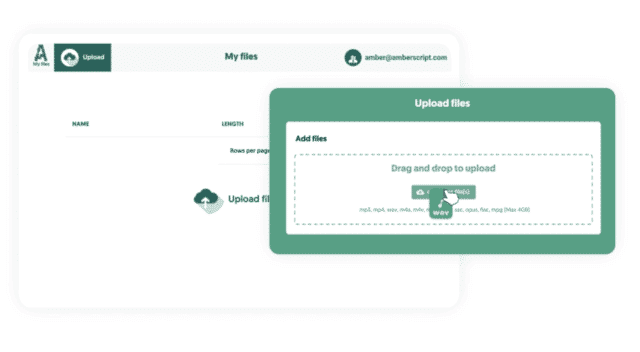
1. Upload your audio files
Join our platform today at no cost and effortlessly upload your audio or video files. Our cutting-edge system is compatible with an extensive range of audio and video formats, including MP3, AAC, WAV, MOV, MP4, and MPG. With support for 39 different languages, simply select your preferred language and specify the number of speakers in your file to begin. Leave the rest to our advanced software, which will handle the entire process seamlessly!
Try it free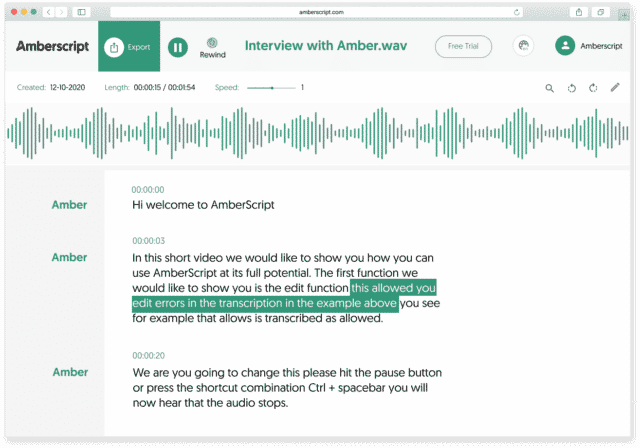
2. Edit the text yourself or order our manual services
Experience the convenience of our robust editor, designed to simplify text editing tasks. Effortlessly modify text, emphasize important sections, rename speakers, and fine-tune timestamps – all without the need to listen to the audio or manually transcribe the content. Handling a substantial volume of audio content? We have you covered! With our Human Made services, our team of skilled experts will handle the task for you. Additionally, for those in need of speedy results, we offer rush orders to accommodate your tight schedule.
Start now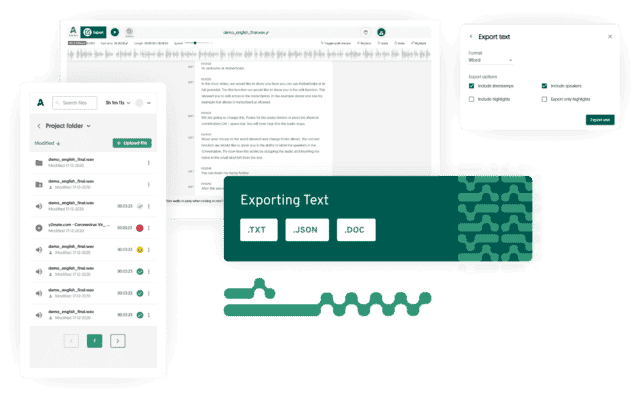
3. Export your files
Once your transcription and editing tasks are finished, you can conveniently export your audio/video file transcript in three versatile formats: Google Docs (.gdoc), Microsoft Word (.docx), or plain text (.txt). This allows for seamless sharing of your work with others or effortless transfer to alternative services as needed.
Try it free2- Google Voice Typing
Google Voice Typing, a feature of your Android device, combines ease-of-use and efficient performance.
Pros:
- Integrated and Free: It’s a free, built-in feature in Android devices, eliminating the need for additional installations.
Cons:
- Limited Features: The tool lacks advanced features like distinguishing between multiple speakers or adding time codes.
- Requires Internet: It needs an internet connection to function, limiting its usability in offline scenarios.
Google Voice Typing is a solid choice for basic transcription tasks, but for more demanding tasks, a dedicated tool like Amberscript may be more appropriate.
3- Live Transcribe
Live Transcribe is an app that provides real-time transcription, making it a good alternative for lectures, meetings, and interviews.
Pros:
- Real-time Transcription: It transcribes speech as it happens, which is great for live events.
- Free: It’s a free app.
Cons:
- Requires Internet: It requires an internet connection to work, limiting its use in offline situations.
- Limited Languages: While it supports multiple languages, its selection is not as extensive as Amberscript.
- Live Transcribe is a handy tool for on-the-go transcription. However, if you require offline functionality and extensive language support, Amberscript could be a better fit.
4- Speechnotes
Speechnotes is an efficient transcription app, designed specifically for extended speech transcription.
Pros:
- User-friendly: Its intuitive design makes it easy to use right out of the box.
- Long-Duration Recording: It’s optimized for lengthy lectures or meetings.
Cons:
- Limited Features: It lacks the advanced features of more comprehensive apps like Amberscript.
- Accuracy: While good, its transcription accuracy may not be as high as that of Amberscript.
While Speechnotes shines in the user-friendly and long-duration recording categories, it falls short in advanced features and transcription accuracy, where Amberscript takes the lead.
5- Transcriber for WhatsApp
Transcriber for WhatsApp is a niche app designed to convert voice notes in WhatsApp to text.
Pros:
- Specific to WhatsApp: This app is perfect for people who frequently use WhatsApp’s voice notes feature.
Free to Use: The app is free to use with optional in-app purchases.
Cons:
- Limited Usage: Its usage is limited to transcribing WhatsApp voice notes.
- Accuracy: The app’s transcription accuracy, while generally good, may not be as high as Amberscript’s.
Transcriber for WhatsApp serves a specific need but is limited in its application. For a more comprehensive transcription tool, you might want to consider Amberscript.
6- Comparison
With an array of strengths and versatile features, Amberscript reigns supreme as the best speech-to-text app for Android users. It caters to a broad range of transcription needs, making it an invaluable tool in this digital age.
| App | Pros | Cons |
|---|---|---|
| Amberscript | High accuracy, Multilingual support, Smooth editing & export options | Premium tier may be costly |
| Google Voice Typing | Integrated and free, User-friendly | Requires internet, Limited features |
| Live Transcribe | Real-time transcription, Free and user-friendly | Requires internet, Limited language support |
| Speechnotes | User-friendly, Long-duration recording | Limited features, Accuracy may not be as high as Amberscript |
| Transcriber for WhatsApp | Specific to WhatsApp, Free to use | Limited usage, Transcription accuracy might not match Amberscript |
Ready to let Amberscript elevate your transcription game? Start your journey with us today and experience the top-tier transcription that’s only a tap away on your Android screen. Happy transcribing!
How to import a VTT file into Adobe Premiere Pro
Table of Contents
- Introduction to Adobe Premiere Pro as a video editing software
- Understanding VTT Files
- Importance of importing VTT files for video editing
- Preparing the VTT File for Import
- Importing VTT Files into Adobe Premiere Pro
- Working with VTT Files in Adobe Premiere Pro (editing)
Introduction to Adobe Premiere Pro as a video editing software
Adobe Premiere Pro is a leading video editing software trusted by professionals worldwide. With its comprehensive features and user-friendly interface, Premiere Pro allows users to create captivating visual content.
From simple home videos to complex cinematic projects, this non-linear editing system offers flexibility and power to bring creative ideas to life. Integrated with other Adobe Creative Cloud applications, Premiere Pro provides seamless collaboration and access to advanced tools for tasks like color correction, motion graphics, and multi-camera editing.
In this blog, we will delve into the process of importing VTT (WebVTT) files into Adobe Premiere Pro, exploring the importance of these files and the steps involved in seamlessly integrating them into your video projects. So let’s dive in and discover how to leverage the power of Adobe Premiere Pro for efficient and effective video editing.
Understanding VTT Files
At its core, a VTT file is a plain text document that contains timestamps, text content, and optional style information. It acts as a roadmap for displaying text at specific moments during a video playback. VTT files are widely supported and can be created using any text editor.
The primary purpose of VTT files is to provide accessibility and enhance the viewer’s understanding of the video content. Captions, for instance, offer a textual representation of the audio, including dialogue, sound effects, and music descriptions. This makes videos accessible to individuals with hearing impairments or those watching without audio. Subtitles, on the other hand, serve the purpose of translating dialogue for viewers who don’t understand the video’s original language.
Apart from captions and subtitles, VTT files can also be utilized for other text elements in video production. For instance, they can be used to display on-screen text, such as location names, speaker identification, or additional information relevant to the video’s context. VTT files can even be employed to provide descriptions for the visually impaired, explaining visual elements and actions happening on the screen.

Importance of Importing VTT Files for video editing
Importing VTT (WebVTT) files into Adobe Premiere Pro holds significant importance in video editing workflows. These files serve as a crucial element for enhancing accessibility, improving comprehension, and expanding the reach of video content.
VTT files enable the inclusion of captions and subtitles in videos. Captions provide text representations of the audio, making the content accessible to individuals with hearing impairments. Subtitles, on the other hand, are translations of the spoken dialogue, allowing non-native speakers to understand the video’s content. By importing VTT files, editors can seamlessly incorporate these text elements, making their videos inclusive and accessible to a wider audience.
VTT files are also essential for localization purposes. In today’s globalized world, reaching international audiences is vital for many content creators. By importing VTT files, editors can easily incorporate translated captions and subtitles in different languages, ensuring that their videos resonate with diverse viewers.
At the same time, with VTT Files editors can adjust the timing, positioning, and styling of captions and subtitles to align with their creative vision.
Overall, importing VTT files into Adobe Premiere Pro is crucial for creating inclusive, localized, and engaging video content. By incorporating captions and subtitles, editors can broaden their audience, improve accessibility, and enhance the overall impact of their videos.
1. Preparing the VTT File for Import
Before importing a VTT (WebVTT) file into Adobe Premiere Pro, it is essential to ensure compatibility and, if necessary, convert the file to a compatible format.
Firstly, compatibility with Adobe Premiere Pro is crucial. While Premiere Pro supports the import of VTT files, it is important to verify that the version of Premiere Pro being used supports this feature. Checking the software’s documentation or consulting the Adobe website can provide information on compatibility.
If the VTT file is not compatible, conversion to a supported format is necessary. One common method is to convert the VTT file to a compatible subtitle format, such as SubRip (.srt) or Scenarist Closed Caption (.scc). Several online tools and software applications are available for converting VTT files to these formats.
Once the conversion is complete, the newly formatted subtitle file can be imported into Adobe Premiere Pro without any compatibility issues. It is recommended to keep the original VTT file as a backup in case any changes or modifications are needed in the future.
By ensuring compatibility or converting the VTT file to a supported format, video editors can seamlessly integrate captions, subtitles, or other text elements into their Adobe Premiere Pro projects. This step is crucial to maintain a smooth workflow and avoid any technical difficulties during the import process.

2. Importing VTT Files into Adobe Premiere Pro
To seamlessly import VTT (WebVTT) files into Adobe Premiere Pro, follow this step-by-step guide:
- Launch Adobe Premiere Pro: Open the Adobe Premiere Pro application on your computer. Ensure that you have the latest version installed to access all the features and compatibility improvements.
- Create or Open a Project: Create a new project by selecting “New Project” from the startup screen. Alternatively, open an existing project by choosing “Open Project” and selecting the desired project file from your computer.
- Access Import Options: Once inside the project, navigate to the “Project” panel, usually located in the lower-left corner of the interface. Right-click within the panel and select “Import” from the context menu that appears. This will open the import options.
- Select and Import the VTT File: In the import options window, navigate to the location on your computer where the VTT file is stored. Select the VTT file and click “Import.” Adobe Premiere Pro will now import the VTT file into the project.
- Adjust Import Settings: After importing the VTT file, you can make adjustments to the import settings if necessary. This includes modifying the timing, position, or appearance of the captions or subtitles. To access these settings, right-click on the imported VTT file in the project panel, select “Modify” and choose the desired options from the available settings.
By following these steps, you can successfully import VTT files into Adobe Premiere Pro and begin working with captions, subtitles, or other text elements. Remember to save your project regularly to ensure all changes are preserved.
3. Working with VTT Files in Adobe Premiere Pro
Once you have imported a VTT (WebVTT) file into Adobe Premiere Pro, you can explore a range of features and capabilities to enhance the text content, adjust timing, and customize the appearance of captions and subtitles.
- Editing the Text Content: Adobe Premiere Pro allows you to easily edit the text content of the VTT file. Simply select the VTT file in the project panel and double-click it to open it in the Source Monitor. From there, you can make changes to the text, such as correcting errors, adding or removing captions, or modifying the wording to improve clarity.
- Adjusting Timing and Synchronization: Precise timing and synchronization are crucial for captions and subtitles to align perfectly with the corresponding audio or video content. In Adobe Premiere Pro, you can make adjustments to the timing of captions by dragging them on the timeline, ensuring that they appear and disappear at the desired moments. This allows you to synchronize the text with the dialogue, sound effects, or other audio cues in your video.
- Enhancing with Effects and Transitions: Adobe Premiere Pro offers a wide range of effects and transitions to enhance the visual presentation of your VTT files. You can apply effects like color correction, blurs, or overlays to make the captions or subtitles more visually appealing or to match the overall style of your video. Additionally, transitions can be used to smoothly fade in or out the captions, creating a seamless viewing experience.
- Customizing Appearance: Adobe Premiere Pro provides various options for customizing the appearance of captions and subtitles. You can change the font style, size, and color to ensure readability and visual consistency. Additionally, you can modify the background color, opacity, or add a border to make the captions stand out or blend seamlessly with the video.
By utilizing these features in Adobe Premiere Pro, you have the flexibility to refine the text content, timing, and appearance of your VTT files. This empowers you to create professional and visually engaging captions and subtitles that enhance the overall viewing experience for your audience.

Get a customized offer
Request a quote for your subtitling needs
Final Thoughts on Integrating VTT Files into Adobe Premiere Pro
In conclusion, integrating VTT (WebVTT) files into Adobe Premiere Pro brings numerous benefits and advantages to video editing workflows. Let’s recap the import process and highlight the significance of VTT files for accessibility and localization:
The import process for VTT files in Adobe Premiere Pro involves launching the software, creating or opening a project, accessing the import options, selecting and importing the VTT file, and adjusting import settings if needed. By following these steps, video editors can seamlessly incorporate captions, subtitles, and other text elements into their projects, enhancing the overall viewing experience.
Integrating VTT files offers several benefits. Firstly, it ensures accessibility by providing captions for individuals with hearing impairments, allowing them to engage with video content. Additionally, VTT files enable localization, making videos accessible to global audiences by offering translated subtitles. This expands the reach of content and enhances user engagement across different regions and languages.
Moreover, VTT files allow for greater customization and creative control. Editors can modify the text content, adjust timing and synchronization, and enhance the VTT files using Adobe Premiere Pro’s effects and transitions. By customizing the appearance of captions and subtitles, videos can maintain visual consistency and professionalism.
Incorporating VTT files into Adobe Premiere Pro emphasizes the importance of accessibility and localization in video production. It ensures that content creators reach a wider audience, making their videos inclusive and relevant to diverse viewers.
In summary, integrating VTT files into Adobe Premiere Pro is a powerful way to enhance video editing workflows. By following the import process, harnessing the benefits of accessibility and localization, and utilizing the software’s features, video editors can create compelling and accessible content that resonates with viewers around the world.
Frequently asked questions
-
How do I add subtitles to a YouTube video?
To add subtitles to your Youtube video, simply add the file you have created using Amberscript to your video in the Youtube Studio. Click on “subtitles”, then “add” and finally “upload file” and select the SRT file.
-
How do I add subtitles to a video on Vimeo?
To add subtitles to your Vimeo video, simply add the file you have created using Amberscript to your video in the editing window on Vimeo. Click on “distribution”, then “subtitles” and finally click on the + symbol to upload the SRT file.
-
How do I order translated subtitles?
To order translated subtitles, you can upload your file like you would normally do. You can then select manual subtitling. Once you have selected this, an option will appear where you will be able to select the language the subtitles need to be translated to. If the language that you want is not one of the options you can contact us through our contact form.
-
To which languages can you translate subtitles?
For our human-made subtitling services we work with a network of language experts in 15 different languages. Find out which here. If the language you want is not on the list, please contact us through our contact form.
-
What subtitle file formats are supported?
Our software allows you to export the transcript from the video or audio file as an SRT, EBU-STL or VTT file.
-
Can I burn the subtitles directly onto my video?
If you have exported the transcript as a SRT, EBU-STL or VTT file, you can easily burn them onto your video using video-editing software.
-
How do I generate subtitles?
You can generate subtitles automatically using Amberscript. Our software allows you to convert your video file to text and then export the transcripts as SRT, EBU-STL or VTT files, which can easily be inserted into a video-editor.
-
Can I change the position of the subtitles?
That needs to be done using a video editor like VLC. Go to Tools > Preferences [CTRL + P]. Under Show settings, select the option that says All to switch to the advanced preferences. Navigate to Input/Codecs > Subtitle codecs > Subtitles. Under Text subtitle decoder set, the Subtitle justification to left, right or center.
An Insider’s Guide to the 5 Best Speech-to-Text Apps for iPhone Users
In today’s fast-paced world, where every second matters, being able to multitask efficiently is a game-changer. That’s where speech-to-text apps come into the picture. Especially for iPhone users who are always on the move, these apps can transform your spoken words into written text, making note-taking, message composing, and document creation a breeze.
So, we’ve dug into the digital trenches to bring you the top 5 speech-to-text apps for iPhone users. Whether you’re a bustling entrepreneur, an industrious student, a passionate podcaster, or an enthusiastic multitasker, this guide is your ticket to choosing the best speech-to-text app for your needs.
Table of Contents
Amberscript
Amberscript gets its place at the very top of our list, earning its place as a trusted software and service provider in the world of transcription. Amberscript isn’t just an app—it’s a powerhouse of transcription automation paired with an appealing, user-friendly interface.
Why you should use Amberscript
Audio transcription has never been this simple. Start now and save hours of time!
Transcribe audio and video to text without errors and receive a perfect export.
GDPR compliant security and safety. Your files are confidentially stored in a secure environment.
Pros:
Accuracy: With an impressive 95% accuracy rate, Amberscript swiftly converts your audio and video files into top-quality transcripts.
Multilingual: With support for more than 30 languages and dialects, Amberscript is a polyglot’s best friend.
Smooth Editing & Export Options: The platform allows easy editing of transcripts and supports export in numerous formats, providing a seamless workflow.
Cons:
Pricing: Although its fantastic features justify the cost, its premium tier may not fit within everyone’s budget.
With its robust feature set, Amberscript stands tall as the best speech-to-text app for diverse use cases from professional to personal.

Apple’s Dictation
Next up is Apple’s own Dictation tool, which is built right into your iPhone. This tool represents Apple’s signature combination of simplicity and functionality, making it a great choice for quick and effortless transcriptions.
Pros:
Seamless Integration: As a built-in iPhone feature, it eliminates the need for downloads and installations.
Cost-Effective: It’s free for all iPhone users, making it a practical solution for those on a budget.
Cons:
Limited Language Selection: While it covers many popular languages, its language selection is more limited than some other tools, such as Amberscript.
Basic Features: The tool does not support advanced features like punctuation commands or distinguishing between multiple speakers.
While Apple’s Dictation might lack advanced features, it’s perfect for users seeking a simple transcription tool without any bells and whistles.
Transcribe
Transcribe is a good transcription app for many iPhone users. Offering a streamlined user experience and advanced features, this app strikes a balance between functionality and usability.
Pros:
Offline Functionality: Transcribe lets you convert speech to text even when you’re offline.
Multilingual Support: The app supports more than 80 languages, making it a versatile choice.
Cons:
Subscription-Based: While the app offers a free trial, you’ll need a subscription to continue using all its features.
Accuracy: While generally reliable, its accuracy might not measure up to tools like Amberscript in certain scenarios.
Transcribe offers a robust set of features, but users looking for the acceptable level of accuracy may find Amberscript a better option.
Just Press Record
Just Press Record is a speech-to-text app that stands out for its one-tap recording and transcription feature. It’s a boon for users who need to capture and transcribe thoughts or conversations quickly.
Pros:
Simplicity: Just Press Record is all about simplicity – one tap to start, one tap to stop.
iCloud Sync: The app syncs with iCloud, ensuring your recordings and transcripts are always available across your Apple devices.
Cons:
Pricing: The app is not free and requires a one-time purchase.
Accuracy: The app’s transcription accuracy may not be as high as Amberscript’s latest technology transcription engine.
Just Press Record offers a straightforward transcription process but falls short when it comes to advanced features and top-notch accuracy, where Amberscript leads.
Speechnotes
Speechnotes is a user-friendly, efficient transcription app that’s quickly gaining popularity among iPhone users. Its straightforward design and reliable transcription capabilities make it a top pick for those who want to turn speech into text without any hassle.
Pros:
User-Friendly: With a simple, intuitive design, anyone can start using Speechnotes right away.
Continuous Recording: The app can record and transcribe for extended periods, making it great for long lectures or meetings.
Cons:
Limited Features: It lacks some of the advanced features that apps like Amberscript offer.
Accuracy: While decent, the transcription accuracy isn’t as high as that of Amberscript.
Speechnotes’ user-friendly approach and continuous recording feature are indeed appealing. However, when it comes to the range of features and high transcription accuracy, Amberscript still reigns supreme.
Comparison
There you have it – the best of the best when it comes to speech-to-text apps for iPhone users. While all these apps bring unique strengths to the table, Amberscript takes the crown due to its impressive features, superb accuracy, and support for numerous languages.
| App | Pros | Cons |
|---|---|---|
| Amberscript | High accuracy, Multilingual support, Smooth editing & export options | Premium tier may be costly |
| Apple’s Dictation | Seamless integration with iPhone, Cost-effective | Limited language support, Basic features |
| Transcribe | Offline functionality, Multilingual support | Subscription-based, Accuracy might fall short compared to Amberscript |
| Just Press Record | Simplicity of use, iCloud sync | Requires a one-time purchase, Accuracy may not be as high as Amberscript |
| Speechnotes | User-friendly, Continuous recording | Limited features, Lower transcription accuracy |

Get a customized offer
Request a quote for machine-made transcription
Ready to take your transcription journey to the next level? Let Amberscript elevate your transcription game. Remember, with Amberscript, precision and efficiency are right at your fingertips. Start your journey with us today and enjoy top-tier transcription that’s as simple as a tap on your iPhone screen. Happy transcribing!
Frequently Asked Questions
-
Can you transcribe audio with foreign accents?
Yes, our software is constantly being trained to pick up on accents and know how to understand them. Want to know more about how this works? Read it here!
-
Do you add timestamps?
Yes, our software automatically adds timestamps, which you can edit if you wish to do so in our online editor.
-
Do you offer services in other languages?
Yes, we do. Our software supports 39 different languages and we manually transcribe through our network of professional transcribers in 15 different languages, but if you have a request for another language please contact us through our contact form.
-
Do you provide bulk discounts?
Yes, we are able to offer a special rate for requests above 100h. Please request a quote here.
-
Do you transcribe files with multiple speakers?
Yes, our software can transcribe multi-speaker files and can also distinguish different speakers in the transcript. Different speakers will be indicated as “speaker 1”, “speaker 2”, etc. You can rename speakers in the online editor.
-
How can I improve the accuracy of the transcript?
The accuracy can be improved by ensuring that the quality of the audio in your file is the best it can possibly be. Want to know how to optimize your audio? Read it here!
-
How do automatic transcription services work?
In a few words, the software “listens” to the audio, identifies the words used and returns it into a text format. That is possible through the use of sophisticated speech recognition technology. In brief, such systems are composed of acoustic and linguistic components running on one or several computers. You can read more about it here.
-
Are there limitations on the number of files I can upload?
No, you can upload as many files as you would like.
-
Can you also deliver transcriptions for other media formats?
We deliver data annotation for speech-to-text solutions. However, if you have a special request, please contact our sales team here.
-
Can you automatically detect the language of an audio file?
No, our standard API does not support language detection, however please reach out to our sales team here in order to find the perfect solution for your situation as we do have access to this technology.
5 Best Speech to Text Tools for Mac Users
In the digital age, efficient communication is the backbone of success. But when it comes to managing multiple meetings, brainstorming sessions, or interviews, retaining every valuable spoken word can be an overwhelming task. Here’s where the magic of the best speech to text apps comes into play.
Table of Contents
- Amberscript
- Apple’s Dictation
- Dragon by Nuance
- IBM Watson Speech to Text
- Google Docs Voice Typing
- Comparison
For all Mac users out there, we’ve crafted an in-depth review of the top speech-to-text tools that can revolutionize the way you handle transcriptions. So, whether you’re a diligent student, an enthusiastic podcaster, a busy professional, or just someone looking to make life a little easier, this guide is for you.
Amberscript
At the very top of our list is Amberscript, an intuitive transcription software and service provider that has established a strong reputation among Mac users worldwide. Amberscript is more than a tool, it’s a comprehensive transcription solution that combines state-of-the-art automation with an easy-to-use interface.
Why you should use Amberscript
Audio transcription has never been this simple. Start now and save hours of time!
Transcribe audio and video to text without errors and receive a perfect export.
GDPR compliant security and safety. Your files are confidentially stored in a secure environment.
Pros
Accuracy: Amberscript’s powerful speech-to-text engine ensures a staggering 95% accuracy rate under optimal conditions, turning your audio and video files into high-quality transcripts in the blink of an eye.
Multilingual: Supporting over 30 languages and dialects, Amberscript’s robust speech-to-text API ensures everyone’s voice can be heard and understood.
Flexible Editing & Export Options: The platform allows for easy editing of transcripts and supports export in a variety of formats, seamlessly integrating with your existing workflow.
Cons
Pricing: While its top-notch features justify the cost, its premium features come with a slightly higher price tag. However when you compare it with its competitors in the market, Amberscript’s prices fall under the wallet-friendly side!
With its comprehensive feature set, Amberscript serves as the best speech-to-text software for diverse use cases ranging from professional and academic to personal needs.

Apple’s Dictation
Coming up next is Apple’s own Dictation tool, a built-in feature right at your fingertips. Embodying Apple’s ethos of simplicity and functionality, this tool is perfect for those looking for quick and easy transcriptions.
Pros
Integration: As an integrated Mac feature, it eliminates the need for downloads and installations.
Cost: It’s absolutely free for all Mac users, offering a practical solution for those on a tight budget.
Cons
Limited Languages: While it does cover many common languages, its selection falls short when compared to other tools like Amberscript.
Lacks Advanced Features: This simple tool does not support punctuation commands or distinguish between multiple speakers.
While Apple’s Dictation might not offer a feature-rich experience, it’s a nice alternative for those seeking basic transcription functionality without any extra fuss.
Dragon by Nuance
Nuance, a veteran in the industry, has captured the attention of many with its Dragon software. Renowned for its efficient dictation capabilities, Dragon employs a top-tier recognition engine to offer high quality speech-to-text experience.
Pros
Accuracy: Dragon prides itself on providing superior speech recognition, which translates into accurate transcriptions.
Customizable: With Dragon, you can tailor your experience by setting custom commands and vocabulary.
Cons
Price: Dragon’s top-tier service comes at a premium price, making it one of the more expensive options on the market.
Setup: Getting started with Dragon can be slightly complex, particularly for those who are less tech-savvy.
While Dragon excels in speech recognition and offers a highly customizable experience, its price and complexity might make Amberscript a more appealing and user-friendly option for many.
IBM Watson
IBM Watson’s Speech to Text service is a shining example of AI’s potential in the transcription field. Capable of recognizing a variety of languages and dialects, it’s a highly useful tool for Mac users that need transcription on the fly.
Pros
Advanced Features: IBM Watson offers sophisticated features like speaker recognition and keyword spotting, pushing the boundaries of what’s possible with speech-to-text technology.
Real-time Transcription: Perfect for meetings or live events, it can transcribe audio in real time, ensuring you never miss a beat.
Cons
Pricing: With charges per minute of audio, the costs can add up quickly for larger projects.
Technical Interface: The interface can be a bit daunting for those without a tech background, especially when compared to more intuitive options like Amberscript.
Despite its impressive real-time transcription capabilities, IBM Watson Speech to Text’s pricing model and technical interface might prompt users to consider more budget-friendly and user-friendly options like Amberscript.
Google Docs Voice Typing
Google Docs Voice Typing has become a crowd favorite for students and professionals alike. As a free and efficient tool integrated into Google Docs, it offers a convenient way to handle basic transcription tasks.
Pros
Ease of Use: There’s no need to install additional software—simply open Google Docs and you’re good to go.
Free: No cost for users.
Cons
Limited Features: While great for basic transcription, it lacks the advanced features offered by other tools like Amberscript. It doesn’t support multiple speakers or punctuation commands.
Internet Connection: To use Google Docs Voice Typing, you need a stable internet connection, which might limit its use in some scenarios.
While Google Docs Voice Typing is ideal for quick and simple transcription tasks, its limited feature set might not be enough for users who require more from their transcription software.
Comparison
So, there you have it: a comprehensive review of the top 5 best speech-to-text tools that Mac users can count on. Each tool has its unique strengths and benefits, but as we’ve seen, Amberscript emerges as the best speech-to-text software. It impresses with its accuracy, multilingual support, and ease of use, making it a powerful companion for all your transcription needs.
| Outil | Avantages | Inconvenients |
|---|---|---|
| Amberscript | High accuracy, Multilingual support, Edit & Export options | Premium features come at a higher cost |
| Apple’s Dictation | Free, Integrated with Mac | Limited language support, Lacks advanced features |
| Dragon by Nuance | Superior accuracy, Customizable commands and vocabulary | Expensive, Complex setup |
| IBM Watson Speech to Text | Advanced features, Real-time transcription | Pricing per minute can add up, Technical interface |
| Google Docs Voice Typing | Easy to use, Free | Limited features, Requires stable internet connection |
But don’t just take our word for it. Experience the power of Amberscript first hand. From professional meetings and academic lectures to personal interviews, Amberscript’s robust features are tailored to cater to a myriad of transcription scenarios. Let Amberscript’s technology do the hard work for you, so you can focus on what truly matters. Explore our plans and find the one that best suits your needs. Happy transcribing!

Get a customized offer
Request a quote for machine-made transcription
Frequently Asked Questions
-
Can you transcribe audio with foreign accents?
Yes, our software is constantly being trained to pick up on accents and know how to understand them. Want to know more about how this works? Read it here!
-
Do you add timestamps?
Yes, our software automatically adds timestamps, which you can edit if you wish to do so in our online editor.
-
Do you offer services in other languages?
Yes, we do. Our software supports 39 different languages and we manually transcribe through our network of professional transcribers in 15 different languages, but if you have a request for another language please contact us through our contact form.
-
Do you provide bulk discounts?
Yes, we are able to offer a special rate for requests above 100h. Please request a quote here.
-
Do you transcribe files with multiple speakers?
Yes, our software can transcribe multi-speaker files and can also distinguish different speakers in the transcript. Different speakers will be indicated as “speaker 1”, “speaker 2”, etc. You can rename speakers in the online editor.
-
How can I improve the accuracy of the transcript?
The accuracy can be improved by ensuring that the quality of the audio in your file is the best it can possibly be. Want to know how to optimize your audio? Read it here!
-
How do automatic transcription services work?
In a few words, the software “listens” to the audio, identifies the words used and returns it into a text format. That is possible through the use of sophisticated speech recognition technology. In brief, such systems are composed of acoustic and linguistic components running on one or several computers. You can read more about it here.
-
Are there limitations on the number of files I can upload?
No, you can upload as many files as you would like.
-
Can you also deliver transcriptions for other media formats?
We deliver data annotation for speech-to-text solutions. However, if you have a special request, please contact our sales team here.
-
Can you automatically detect the language of an audio file?
No, our standard API does not support language detection, however please reach out to our sales team here in order to find the perfect solution for your situation as we do have access to this technology.
VTT Files: How to Create and Everything You Need to Know
VTT, or Video Text Tracks, files are an extremely useful and powerful tool when it comes to video production. They allow you to add captions, subtitles, and metadata to your videos. Whether you’re creating a training video for employees or making a movie for theatrical release, VTT files can help make the experience more enjoyable for your viewers. Here’s everything you need to know about VTT files and how to create them.
Table of Contents
- Understanding VTT Files
- Creating VTT Files With Amberscript
- Working with VTT Files
- Advanced VTT File Features
- Best Practices for VTT File Management
- Key Points
Understanding VTT Files
Definition and Purpose of VTT Files
VTT files, also known as Video Text Tracks, are an essential part of video production. VTT files allow you to add captions, subtitles, and metadata to your videos. This can be used for a variety of purposes including making training videos more effective, providing helpful information to viewers, or creating translations for foreign audiences. VTT files can be used to help improve accessibility by providing closed captions and subtitles in different languages for those who are hearing impaired or speak different languages. Using VTT files is the best way to ensure that your videos are viewable and accessible to everyone.
Common Applications of VTT Files in Video Production and Streaming
VTT files have a wide range of uses in video production. They can be used to add captions, subtitles and graphics to videos, making them more accessible and easier to understand for viewers. Additionally, they can be used to provide scene descriptions or audio descriptions for those who are visually impaired or hearing impaired.
Furthermore, VTT files are widely used by streaming services such as Netflix and Hulu in order to provide multiple language versions of their content. With the help of VTT files, you can make sure that everyone is able to access your videos no matter what language they speak or what disabilities they may have.
Key Features and Characteristics of VTT Files
VTT files serve as highly versatile and powerful tools in video production. They offer a wide range of capabilities, enabling you to enhance your videos with captions, subtitles, and metadata in various languages. These files go beyond basic text by providing additional accessibility features, such as audio descriptions for viewers with visual or hearing impairments. Moreover, VTT files support multiple styles, allowing you to customize the appearance of captions and subtitles to match the context or mood of your video. You can adjust attributes such as color, font size, boldness, italics, and background color, ensuring a visually appealing and engaging viewing experience.
In addition to text-based elements, VTT files also support media elements like images and videos. This means you can embed visual content directly within the file itself, enhancing the impact and richness of your video. Overall, the comprehensive features of VTT files make them an invaluable asset for video producers seeking to create accessible and enjoyable content for viewers. By utilizing VTT files, you can effectively communicate your message, cater to diverse audiences, and elevate the overall quality of your video production.
Creating VTT Files With Amberscript
Step-by-step Guide on Creating Subtitles and Captions as VTT Files With Amberscript
When it comes to creating subtitles, there are multiple methods available, but Amberscript stands out as one of the simplest and most effective options. With Amberscript, you can effortlessly generate subtitles for various video formats while also having the ability to create VTT files. Amberscript offers three distinct approaches for creating subtitles, ensuring flexibility and convenience in the subtitle creation process.
Adding subtitles to video content is highly recommended for several compelling reasons, such as improving SEO compatibility, enhancing digital accessibility, and expanding audience reach. However, the process of creating subtitles can be meticulous and time-consuming. Thankfully, Amberscript provides a solution with its expert subtitle services, making the task of adding subtitles effortless. Our comprehensive service encompasses both automated subtitle generation using cutting-edge AI technology and professional manual subtitling by experienced subtitlers. Let’s delve into how our machine-made subtitle software works seamlessly to create accurate and high-quality subtitles for your videos.

1. Upload your video file to the Amberscript platform
After completing your video creation, the next step is to upload it to the Amberscript platform. Uploading is a breeze and can be done by simply dragging and dropping the file, sharing a link, or manually selecting the file from your desktop. Once uploaded, choose the language of your video’s audio and select the automatic service option provided. Within minutes, the AI-powered system will generate a first draft of the subtitles. Now, all you have to do is sit back and let the platform work its magic, taking care of the subtitle creation process for you.
2. Edit your subtitles in the intuitive online text editor
Making modifications to the automatically generated subtitles is a breeze with the integrated online text editor provided by Amberscript. You have the flexibility to revise the transcript initially generated by the AI and then fine-tune and format the subtitles within the editor. To get acquainted with the online editor’s functionalities, we recommend watching the demo video and following the provided instructions. To expedite the editing process, take advantage of the convenient key combinations available in the bottom left corner of the editor. With these tools at your disposal, editing your subtitles becomes efficient and hassle-free.
3. Export your subtitles
Once you have completed the editing process, downloading your subtitle file is a quick and straightforward procedure. It is crucial to determine the most suitable file format for your subtitles’ specific use case. While the VTT format is a popular choice, it’s worth noting that other formats are also available, such as SRT and EBU-STL. Select the VTT format and proceed to download it to your laptop or computer, ensuring easy access to your subtitles in the future.

Exploring VTT File Structure and Formatting Options
In order to create effective and impactful VTT files, it’s important to understand the structure and formatting options available. VTT files are structured in two main sections: metadata and cues. Metadata includes information such as language, title, description, and creator; while cues contain the actual captioning or subtitling data. It’s also important to understand the formatting options that VTT files support so that you can customize your captions and subtitles to match the context or mood of your videos. This includes things like font size, boldness, italics, colors, background color, and media elements like images or videos. With these tools at your disposal, you can ensure that your viewers will get a better viewing experience.
Best Practices for Creating Accurate and Well-Formatted VTT Files
Creating accurate and well-formatted VTT files is crucial for delivering an enjoyable and accessible viewing experience to your audience. When working on your VTT files, it’s essential to adhere to key principles that ensure optimal results. Fortunately, when using the Amberscript platform, you can rely on its capabilities to handle these aspects seamlessly. Here are some key principles to keep in mind:
1. Syncing Captions: Ensure that your captions are properly synchronized with the audio of your video to avoid delays or misinterpretations.
2. Consistent Formatting: Maintain a consistent formatting style throughout your VTT file, including font type, size, color, and other visual elements. Amberscript’s platform ensures uniform formatting to create a polished and professional subtitle appearance.
3. Utilizing Metadata: Make use of metadata, such as language and title information, to enhance the navigation experience for viewers, especially in long videos.
By using the Amberscript platform, you can trust that these best practices will be automatically handled for you, enabling the creation of accurate and well-formatted VTT files that enhance the accessibility and enjoyability of your videos for viewers.
Working with VTT Files
Understanding VTT File Extensions and Compatibility
VTT files can be identified by their .vtt file extension and are compatible with most popular video streaming and editing softwares. VTT files also come with a range of features that make them a versatile choice for captioning videos. For instance, they support multiple languages, including right-to-left language scripts; they can contain styling information such as font size, weight, italics, color, background color and even images; and lastly, they are supported by the World Wide Web Consortium (W3C) standard for text tracks in HTML5 multimedia elements. With all these features at your disposal, working with VTT files should be a breeze!
Integrating VTT Files with Video Players and Streaming Platforms
Integrating VTT files with video players and streaming platforms is essential for providing viewers with an accessible viewing experience. Fortunately, this integration process is relatively straightforward. Popular streaming platforms such as YouTube, Twitch, and Vimeo all support the inclusion of external VTT files within their videos. Most major video players today also have built-in support for displaying captions from external VTT files. By taking advantage of these options, you’ll be able to ensure that your videos are properly captioned no matter what platform they’re being watched on. With a little work, you can make sure your videos are accessible to everyone who tunes in!
Troubleshooting Common Issues when Working with VTT Files
Troubleshooting common issues when working with VTT files is an important part of the captioning process. One of the most common issues is ensuring that all text tracks are properly formatted according to the W3C standard. Another issue is making sure that your captions and subtitles are synchronized properly with the audio in your video. Finally, it’s also important to make sure that your captions and subtitles are accurate, well-timed, and consistent with any other formatting choices you may have made for your VTT file. By addressing these issues before releasing your videos to the public, you can ensure a smooth viewing experience for all who tune in. With these tips in mind, troubleshooting should be a breeze!
Optimizing VTT Files for Different Devices and Platforms
Optimizing VTT files for different devices and platforms is key to ensuring a smooth viewing experience. This means making sure that the captions and subtitles in your file are properly formatted according to the device or platform’s specifications. It also involves taking into consideration any extra features that may be available such as image support or variable-width fonts. By taking these steps, you can ensure that your viewers on all devices will have an enjoyable viewing experience from start to finish. With these tips in mind, optimizing your captions and subtitles should be a breeze!

Get a customized offer
Request a quote for your subtitling needs
Advanced VTT File Features
Timecodes and Cue Settings in VTT Files
Timecodes and cue settings are an important part of VTT files. These can be used to set the start and end times for captions and subtitles, as well as other information such as background color, foreground color etc. Additionally, some advanced features may even allow you to add images or hyperlinks within your captions and subtitles. With these options at your disposal, you’ll have complete control over how your captions and subtitles are presented on screen. Taking advantage of these timecode and cue settings will go a long way towards ensuring that viewers get the most out of their viewing experience. So don’t forget to utilize all the available features in your VTT files!
Formatting Options for Text, Colors, and Positioning
Formatting options for text, colors, and positioning are essential for creating captions and subtitles that stand out in the best way possible. Advanced VTT files allow you to add styling such as font size, weight, italics, color, background color and even images to your captions and subtitles. There are also options available for positioning the caption or subtitle boxes on different levels of the screen as well. With these formatting options at your disposal, you can tailor your captions and subtitles even further so they look just right according to your preferences. Taking advantage of all these features will go a long way towards ensuring that viewers get the most out of their viewing experience! So don’t forget to make full use of them!
Handling Multiple Languages and Translations in VTT Files
Handling multiple languages and translations in VTT files is a must for providing viewers with content that’s accessible to everyone. Fortunately, this is relatively straightforward with advanced VTT files as they support multiple language scripts, including right-to-left languages. By using the same timecodes and cue settings for each language track, you can make sure all of your translations are properly synchronized with the audio in your video. You can also include styling information such as font size, weight, italics, color, background color and even images for each translation. With these features at your disposal, providing captions and subtitles in different languages should be a breeze! This will go a long way towards ensuring that viewers from all over the world can enjoy your videos. So don’t forget to make full use of them!
Interactive Features and Metadata in VTT Files
Interactive features and metadata in VTT files can really enhance the viewing experience for viewers. For example, you can add interactive elements such as buttons and hotlinks to your captions and subtitles which will allow viewers to pause, rewind, or even go directly to a different part of the video without having to leave the page. You can also add metadata such as descriptors, keywords and scene tags so that viewers can easily search for related content within your videos. With these options at your disposal, you’ll be able to elevate the viewer’s experience beyond just plain text captions and subtitles. So don’t forget to make full use of these advanced VTT features! This will definitely give viewers a more enjoyable experience when watching your videos.
Best Practices for VTT File Management
Organizing and Naming VTT Files Effectively
Organizing and naming your VTT files is an important part of the captioning process. It’s essential to have a well-organized system that allows you to quickly and easily identify which file belongs to what video. For this reason, it’s best practice to incorporate an easy-to-follow naming convention for all of your VTT files that clearly identifies each one. Additionally, you may also want to consider creating separate folders or directories for each language track and ensuring that they are properly labeled. With these simple steps, managing your VTT files should be much easier! And by taking the time to name them properly, locating the correct file will always be a breeze! So don’t forget to take advantage of these best practices when working with VTT files.
Version Control and Tracking Changes in VTT Files
Version control and tracking changes in VTT files is essential for ensuring accuracy and consistency. By keeping track of the different versions of your captions and subtitles, you can quickly identify any mistakes or discrepancies that may have been made during the editing process. Additionally, version control can also help you ensure that all content remains up-to-date so your viewers always get accurate information with every viewing experience. Taking advantage of these best practices for version control will go a long way towards making sure your viewers get the most out of their viewing experience. So don’t forget to make use of them! This is an important part of creating captions and subtitles that are comprehensive yet easy to understand.
Backing up and Archiving VTT Files for Future Reference
Backing up and archiving VTT files is another important step in the captioning process. By having backups of your captions and subtitles, you can easily restore any changes if needed and keep them securely stored for future reference. Archiving your VTT files also makes it much easier to keep track of which versions are current or outdated so you always know exactly when changes were made. Taking advantage of these best practices for backing up and archiving your VTT files will give you peace of mind knowing that they’ll be safe and secure for years to come. So don’t forget to make use of them! This is an essential part of providing viewers with a consistent viewing experience across multiple languages. So don’t forget to take advantage of these best practices for VTT file management! They will make the entire captioning process much easier and more efficient.
Collaboration and Teamwork in VTT File Management
Collaboration and teamwork are essential for handling VTT files in a timely and efficient manner. By having different team members working on different tasks, such as transcribing, editing or creating new subtitles, you can make sure that all of your captions and subtitles stay current and accurate. Collaboration also enables multiple editors to work together to ensure the accuracy of the captions and subtitles in each language track. Taking advantage of these best practices for collaboration will help you create better content faster. So don’t forget to involve other people when working with VTT files! This will keep your viewers engaged with up-to-date information from beginning to end. Don’t forget to take full advantage of teamwork when managing your VTT files! It will make the entire captioning process much easier.
Key Points
VTT files are an essential tool for creating captions and subtitles that are accurate, comprehensive, and easy to understand. In this blogpost, we’ve gone over the basics of VTT file creation and management, including best practices for organizing and naming your files, version control, backing up and archiving your content, as well as collaboration and teamwork. Mastering these techniques will ensure that viewers get the most out of your videos no matter what language they speak. So take some time to explore and experiment with VTT files in order to create enhanced video content for everyone to enjoy! Don’t forget: mastering VTT file creation and management is key to creating captions and subtitles that are accessible to all viewers!
The Benefits of Using Amberscript
We make the best use of a human and AI interaction, upload your files and we handle the rest. Rush your order and get your file as fast as 24h.
Native speakers and quality checks ensure that you receive 100% accurate captions or translated subtitles.
Your files are confidentially stored in a secure environment.
Frequently asked questions
-
How do I add subtitles to a YouTube video?
To add subtitles to your Youtube video, simply add the file you have created using Amberscript to your video in the Youtube Studio. Click on “subtitles”, then “add” and finally “upload file” and select the SRT file.
-
How do I add subtitles to a video on Vimeo?
To add subtitles to your Vimeo video, simply add the file you have created using Amberscript to your video in the editing window on Vimeo. Click on “distribution”, then “subtitles” and finally click on the + symbol to upload the SRT file.
-
How do I order translated subtitles?
To order translated subtitles, you can upload your file like you would normally do. You can then select manual subtitling. Once you have selected this, an option will appear where you will be able to select the language the subtitles need to be translated to. If the language that you want is not one of the options you can contact us through our contact form.
-
To which languages can you translate subtitles?
For our human-made subtitling services we work with a network of language experts in 15 different languages. Find out which here. If the language you want is not on the list, please contact us through our contact form.
-
What subtitle file formats are supported?
Our software allows you to export the transcript from the video or audio file as an SRT, EBU-STL or VTT file.
-
Can I burn the subtitles directly onto my video?
If you have exported the transcript as a SRT, EBU-STL or VTT file, you can easily burn them onto your video using video-editing software.
-
How do I generate subtitles?
You can generate subtitles automatically using Amberscript. Our software allows you to convert your video file to text and then export the transcripts as SRT, EBU-STL or VTT files, which can easily be inserted into a video-editor.
-
Can I change the position of the subtitles?
That needs to be done using a video editor like VLC. Go to Tools > Preferences [CTRL + P]. Under Show settings, select the option that says All to switch to the advanced preferences. Navigate to Input/Codecs > Subtitle codecs > Subtitles. Under Text subtitle decoder set, the Subtitle justification to left, right or center.
How to Make Sure Your Videos Are Seen by a Global Audience on YouTube
YouTube has quickly become one of the world’s largest channels for content creation and sharing, with over 2 billion monthly users worldwide. YouTube’s global reach is far-reaching, and creators have a unique opportunity to reach viewers from all walks of life with their videos. To maximize viewership, understanding how to effectively target and engage international audiences is essential. Multi-Channel Networks (MCNs) are one of the most effective tools available to content creators looking to expand their audience base on an international scale.
In this blog post, we will discuss why reaching a global audience on YouTube is important, explore the demographics of YouTube users around the world and consider cultural language considerations when targeting a global audience. We will also explain what MCNs are and how they can be used to expand your viewership, provide strategies for making videos more accessible internationally and give examples of successful case studies that have used MCNs to reach a global audience. Finally, we will recap the importance of reaching an international audience on YouTube and emphasize the role of MCNs in helping creators achieve their goals. At the end of this post, content creators should feel empowered and encouraged to explore international opportunities for growth on YouTube.
Table of Contents
- Reaching a Global Audience on YouTube
- Understanding the Global Audience on YouTube
- Utilizing MCNs to Reach a Global Audience
- Strategies for Making Your Videos More Accessible
- Engaging with International Audiences
- Increasing Discoverability with Subtitles
- Key Findings
Reaching a Global Audience on YouTube
Importance of reaching a global audience on YouTube
The ability to reach a global audience has become an increasingly important factor in content creation, especially for YouTubers looking to expand their viewership and gain more recognition within the YouTube community. Reaching viewers from all over the world can open up new opportunities for collaboration with diverse creators and enable access to wider audiences that would otherwise be unreachable.
Targeting international audiences adds an extra layer of complexity which requires careful consideration for cultural backgrounds, language preferences and local trends. Though it may seem intimidating, tapping into the global market can provide tremendous benefits for YouTubers looking to grow their channel and establish a strong presence on the platform. With this in mind, understanding the importance of reaching a global audience on YouTube is the first step towards achieving success.
Role of Multi-Channel Networks (MCNs) in Expanding Viewership
Multi-Channel Networks (MCNs) are organizations that partner with content creators on YouTube to help them scale their audience and expand their reach beyond local markets. MCNs offer a wide range of services including access to established international networks and channels, localized content strategies and market insights, language localization and translation services, cross-promotion opportunities, metadata optimization for discoverability and much more. By partnering with an MCN, creators can tap into the resources they need to make their videos more accessible internationally and engage with global audiences who might not have otherwise found their channel.
Leveraging the expertise and experience of MCNs can prove invaluable when it comes to understanding cultural trends, localizing content and developing strategies for successful international expansion. Ultimately, MCNs can be a powerful tool for content creators looking to maximize their viewership on an international level.
Understanding the Global Audience on YouTube
Overview of YouTube’s Global Reach and Popularity
YouTube has quickly become one of the world’s largest channels for content creation and sharing, with over 2 billion monthly users worldwide. This massive global reach makes it an invaluable platform for creators looking to expand their audience base beyond their local markets.
YouTube’s user base is incredibly diverse – viewers come from nearly every country in the world and from all walks of life. This wide range of cultural backgrounds, languages, devices and interests provides YouTubers with a unique opportunity to engage with international audiences that have never been exposed to their content before. In order to maximize viewership and capitalize on this vast global market, content creators must first understand the demographics of YouTube’s users around the world.
Demographic Diversity of YouTube Users Around the World
Though it is difficult to accurately measure the demographics of YouTube’s vast user base, there are certain trends that can be identified when examining the data available. According to a 2020 study conducted by Global Web Index, an estimated 51% of YouTube users are male while 49% are female, and more than half (53%) identify as being between 18-34 years old. Additionally, research indicates that 72% of viewers have at least some college education and 21% hold a postgraduate degree or higher. When looking at language preferences on Youtube, English (27%), Spanish (14%), Hindi (7%) and Dutch (6%) top the list as the most popular languages used by viewers worldwide. Though these figures provide an overall snapshot, it is important to remember that YouTube’s user base is incredibly diverse and cultural differences must be taken into account when targeting a global audience.
Cultural and Language Considerations when Targeting a Global Audience
When looking to target a global audience on YouTube, it is essential to consider the cultural and language differences between markets. Not only do viewers from different countries have vastly differing interests, but they also communicate in diverse languages and respond differently to various types of content. To effectively engage with an international audience, creators must first familiarize themselves with the local trends and be aware of any religious, political or cultural sensitivities that may exist within their target market.
Translating content into multiple languages can help increase viewership and make videos more accessible for viewers who don’t speak English as their primary language. Though this process can seem daunting at first, understanding the importance of cultural sensitivity and language localization when targeting a global audience on YouTube can be incredibly beneficial in the long run. By carefully considering these factors, content creators can maximize their viewership on an international level and reach new audiences that would otherwise remain untapped.
Utilizing MCNs to Reach a Global Audience
Definition and Role of Multi-Channel Networks (MCNs)
Multi-Channel Networks (MCNs) are organizations that partner with content creators on YouTube in order to help them scale their audience and expand their reach beyond local markets. MCNs provide creators with access to established international networks and channels, localized content strategies and market insights, language localization and translation services, cross-promotion opportunities, metadata optimization for discoverability and much more.
By leveraging the resources of an MCN, creators can tap into global audiences who may not have otherwise found their channel. Furthermore, partnering with an experienced MCN can be invaluable when it comes to understanding cultural trends, localizing content and developing strategies for successful international expansion. Ultimately, MCNs can be a powerful tool for content creators looking to maximize their viewership on an international level.
Benefits of Partnering with MCNs for Global Expansion
Access to Established International Networks and Channels
One of the major benefits of partnering with an MCN is the access it provides to established international networks and channels. By signing on with an MCN, content creators can use their existing network of global partners to distribute their content more effectively and reach viewers that they may not have been able to engage with before.
Many MCNs have teams dedicated to optimizing metadata for discoverability which can be invaluable when targeting new audiences in different countries. This process helps make sure your videos appear at the top of search results in multiple languages so that viewers from around the world can find your content easily. Furthermore, many MCNs offer cross-promotion opportunities which can help increase the overall reach of your content and allow you to tap into new markets. Ultimately, partnering with an MCN can provide valuable access to established international networks and channels that would otherwise remain untapped.
Localized Content Strategies and Market Insights
Another major benefit of working with an MCN is the localized content strategies and market insights they can provide. Many MCNs have teams of experienced strategists who specialize in understanding the cultural and language differences between different regions. By leveraging their expertise, content creators are able to craft content that resonates with audiences from different countries, which can significantly increase viewership on a global level. A lot of MCNs offer research services that help creators understand local trends and target specific markets with greater precision. By tapping into this valuable knowledge base, creators have access to up-to-date insights on the latest consumer behaviors in various countries so that they can make more informed decisions when marketing their content internationally. Partnering with an MCN can provide invaluable resources in the form of localized content strategies and market insights.
Language Localization and Translation Services
Partnering with an MCN can also be beneficial when it comes to language localization and translation services. Many MCNs offer access to experienced translators who are able to accurately translate videos into different languages so that viewers from around the world can understand them easily. Additionally, many MCNs use automated voice-over technology which helps make sure that translations sound natural, even for complex dialogue or technical terms. By leveraging these tools, creators are able to maximize their international viewership without sacrificing clarity or accuracy. Furthermore, MCNs can also help creators understand any regional language quirks that may exist in order to ensure their videos are respectful and culturally sensitive. Therefore partnering with an MCN for language localization and translation services can be incredibly beneficial when targeting a global audience on YouTube.
Cross-Promotion and Collaboration Opportunities
Finally, partnering with an MCN can provide valuable cross-promotion and collaboration opportunities that would otherwise remain untapped. By leveraging their established international networks, content creators are able to access new markets and help promote their videos on other channels. Additionally, many MCNs offer collaborations with experienced influencers who can help increase the overall reach of your content and engage new audiences.
Some MCNs also offer advice on how to best target viewers from different countries so that you can use your resources more effectively. Ultimately, partnering with an MCN for cross-promotion and collaboration is a great way to grow a global audience quickly and efficiently.
Strategies for Making Your Videos More Accessible
Implementing Subtitles and Closed Captions in Multiple Languages
One of the best ways to make your videos more accessible on an international level is by implementing subtitles and closed captions in multiple languages. This helps ensure that viewers from around the world can understand what’s happening in your video, regardless of their native language. Use Amberscript’s subtitling and captioning services which help make sure your videos are accurately transcribed into different languages quickly and easily. Amberscrpit also offers translations by experienced translators. Ultimately, using subtitles and closed captions is a great way to maximize viewership on a global level without sacrificing clarity or accuracy.

Adapting Content to Appeal to Diverse Cultural Backgrounds
Another important strategy for making your videos more accessible on an international level is to adapt the content so that it appeals to diverse cultural backgrounds. Many MCNs offer advice and support when it comes to developing content specifically designed for different countries and regions. This can include crafting videos with relevant topics, using visual imagery that resonates with viewers from different cultures, or providing localized versions of your content in languages other than English. By leveraging this expertise, creators are able to maximize their viewership and engagement on a global scale. Adapting your content to appeal to diverse cultural backgrounds is a great way to ensure that everyone from around the world can understand and appreciate your work.
Optimizing Video Metadata and Tags for International Discoverability
In order to maximize discoverability on an international level, it’s important to optimize your video metadata and tags for each language you plan on targeting. Many MCNs offer guidance when it comes to crafting titles, descriptions, and tags that are relevant in different countries and regions. Some MCNs also provide insights into popular keywords used in specific countries so that you can make sure your videos appear in local search results as well. By leveraging these resources, creators are able to increase viewership by reaching new audiences from around the world more effectively. Ultimately, optimizing your video metadata and tags for international discoverability is a great way to ensure that viewers from other countries can easily find and enjoy your content.
Leveraging YouTube’s Localization Features and Tools
Finally, creators should also take advantage of YouTube’s various localization features and tools in order to make their content more accessible on an international level. These include things like customizing thumbnails for different countries, using localized versions of the video title and description, or creating playlists featuring videos from different countries. YouTube also offers a wide range of translation tools that can be used to accurately captions and subtitles videos in any language, even for complex dialogue or technical terms. By leveraging these tools, creators are able to maximize their international viewership without sacrificing clarity or accuracy. Ultimately, taking advantage of YouTube’s localization features and tools is an important step when targeting a global audience.
Accessibility for Individuals with Hearing Impairments
Subtitles and captions provide an invaluable service to individuals with hearing impairments, enabling them to follow along with the audio portion of a video. Subtitles are words that appear at the bottom of a video display which replicate what is being said in the audio portion. Captions allow for additional information such as sound effects or speaker identification to be included as well.
They can also be translated into multiple languages, allowing for a more global audience to understand the content. With the help of subtitles and captions, videos can be made accessible to those with hearing impairments and ensure that everyone has an equal opportunity to experience media.
Engaging with International Audiences
Building a Global Community through Active Engagement
Once you’ve established a presence in international markets, it’s important to actively engage with these audiences by building a global community around your content. Many MCNs are able to provide advice and support when it comes to developing effective strategies for interacting with viewers in different countries. This can include things like hosting livestreams, answering questions in comments sections, or creating localized versions of your content for specific regions. Many MCNs also have teams of experienced community managers who can help with managing engagement and responding to viewers from around the world. Ultimately, actively engaging with international audiences is a great way to build a global community around your content and increase viewership on an international scale.
Encouraging Viewers to Contribute Subtitles and Translations
Another great way to engage with international audiences is by encouraging viewers to contribute subtitles and translations for your videos. Many MCNs offer incentives such as exclusive content, discounts, or giveaways for viewers who are willing to help out in this regard. This helps ensure that your videos are accurately transcribed into other languages quickly and easily. It also provides a unique opportunity for engagement since you’ll be able to interact directly with the people who are helping make your content more accessible on a global level. Encouraging viewers to contribute subtitles and translations is a great way to engage with international audiences while making sure that everyone from around the world can understand and appreciate your work.
Hosting Live Streams and Q&A Sessions to Connect with Global Fans
Finally, hosting live streams and Q&A sessions is an excellent way for creators to connect with their global fans. By leveraging the power of social media, you can easily reach viewers from different countries and regions in real-time. Multiple MCNs also offer advice on how to make these interactions as meaningful as possible by utilizing language localization tools or using visuals to create more localized versions of your content. Hosting live streams and Q&A sessions is a great way to interact directly with international audiences while providing valuable insights into how people from around the world are engaging with your work.
Tailoring Content and Marketing Strategies to Specific Regions
Finally, creators should also take the time to tailor their content and marketing strategies to specific regions in order to maximize international viewership. This can include things like creating localized versions of videos for different countries, researching trends in various markets, or using language localization tools. A lot of MCNs are able to provide guidance on how creators can better target audiences in specific areas with tailored messages or promotions that will help increase engagement and conversion rates. Tailoring content and marketing strategies to specific regions is an important step when it comes to reaching a global audience more effectively.
Increasing Discoverability with Subtitles
If you’re looking for ways to make your video content more accessible and engaging, subtitles and captions should be at the top of your list. Subtitles are textual representations of spoken content within videos that viewers can easily turn on or off. Closed captions not only include dialogue, but also provide additional auditory information such as sound effects and music. By incorporating these features into your video project, you will make it more accessible to those who are deaf or hard-of-hearing, as well as improve comprehension for non-native speakers and increase audience reach overall. With subtitles and captions at your disposal, there’s no reason why anyone should be left out from experiencing the power of media!
How Amberscript Can Help
If you’re looking for an easy and efficient way to add subtitles and captions to your videos, Amberscript is the perfect platform for you. With cutting-edge technology and user-friendly features, adding subtitles has never been so simple. Make sure your content is accessible to everyone with Amberscript – stay relevant and Increase the discoverability of your content with subtitles.
Benefits of using Amberscript
Amberscript’s subtitling services are:
Edit your text in minutes or leave the work to our experienced subtitlers.
Our experienced subtitlers and thorough quality controls ensure 100% accuracy of transcripts and subtitles.
Through a series of integrations and API interfaces, you can fully automate your workflows.
Your data is in safe hands. We are GDPR compliant + ISO27001 and ISO9001 certified.
Key Findings
To sum up, it’s important for content creators to explore international opportunities for growth on YouTube and understand the role of MCNs in expanding viewership. Reaching a global audience is essential for any creator looking to build an engaged fanbase and maximize their visibility on the platform. This can be accomplished by utilizing language localization tools, hosting live streams and Q&A sessions, encouraging viewers to contribute subtitles or translations, and tailoring content and marketing strategies to specific regions. Understanding these various methods of engaging with international audiences is key for any creator looking to achieve success on a global scale.
How can you maximize your audience: Translated Subtitles for YouTube (Guideline)
Table of Contents
- Importance of Maximized Audience for YouTube Content Creators
- What are Subtitles?
- What are Translated Subtitles?
- How Translated Subtitles can improve your audience
- Creating Translated Subtitles for YouTube Videos: A Guideline with Amberscript
- Encouragement to implement Translated Subtitles in YouTube videos
Importance of Maximized Audience for YouTube Content Creators
In the ever-expanding realm of YouTube, content creators face the constant challenge of standing out amidst the sea of videos available. With an ever-increasing number of channels and content creators vying for viewers’ attention, it has become crucial to find ways to maximize your audience reach.
One effective strategy to achieve this is by translating subtitles for YouTube videos. By acknowledging the importance of a maximized audience, content creators can tap into the vast potential of reaching viewers from diverse linguistic backgrounds. Translation not only breaks down language barriers but also enhances accessibility, expands the reach of your content, and boosts engagement levels. In this blog, we will delve into the significance of a maximized audience for YouTube content creators and explore how translating subtitles can help you achieve this goal.
What are Subtitles?
In the digital age, subtitles have emerged as a vital component of audiovisual content, revolutionizing the way we consume media. Subtitles, also known as captions, are textual representations of the dialogue or audio content displayed on the screen while watching a video. They serve a variety of purposes, including aiding comprehension for viewers with hearing impairments, overcoming language barriers, and improving the overall user experience.
Subtitles have become increasingly prevalent across various platforms, including YouTube, as they play a crucial role in maximizing audience reach and engagement. They allow content creators to connect with a broader and more diverse audience, transcending linguistic boundaries and enabling viewers from different regions and language backgrounds to understand and enjoy the content. Furthermore, subtitles contribute to search engine optimization (SEO) by making the video more discoverable and increasing its visibility in search results. As a result, content creators can leverage subtitles as a powerful tool to enhance accessibility, expand their audience base, and ultimately maximize the impact and reach of their YouTube videos. In this blog, we will explore the significance of subtitles and provide guidelines on how to translate subtitles effectively to maximize your audience on YouTube.

What are Translated Subtitles?
Translated subtitles are an essential element in the global landscape of digital content. They refer to the process of converting the original language subtitles into a different language, enabling viewers who do not understand the original language to access and enjoy the video. Translated subtitles play a pivotal role in expanding the reach of YouTube content, allowing creators to connect with an international audience and overcome language barriers. By providing translated subtitles, content creators can tap into new markets, increase viewer engagement, and maximize their audience.
Translated subtitles go beyond mere translation; they consider cultural nuances, idiomatic expressions, and context to provide an authentic and immersive viewing experience for non-native speakers.
How Translated Subtitles can improve your audience
Translated subtitles are an invaluable asset for content creators aiming to maximize their audience on YouTube. They break down language barriers, increase accessibility, and create opportunities for cross-cultural communication. By investing in professional translation services or using reliable tools, content creators can ensure high-quality translated subtitles that enhance viewer experience and enable their videos to reach a broader, global audience.
By incorporating translated subtitles, content creators can unleash the true potential of their YouTube videos. With translated subtitles, videos become accessible to a wider range of viewers, including those who may not be fluent in the video’s original language. This accessibility allows content creators to attract and engage viewers from diverse linguistic backgrounds, expanding their audience and fostering a global community. Moreover, translated subtitles contribute to search engine optimization (SEO) by making videos more discoverable in search results, increasing their visibility, and driving organic traffic.
In the following sections of this blog, we will delve into the process and guidelines for translating subtitles effectively, equipping you with the knowledge and tools to expand your audience reach and maximize the impact of your YouTube content.

Find out everything you need to know about translated subtitles
Read the blogCreating Translated Subtitles for YouTube Videos: A Guideline with Amberscript
With Amberscript creating translated subtitles for YouTube videos has never been easier, simpler, faster, and safer! with our user-friendly platform and advanced technologies, the process becomes seamless and efficient.
Benefits of using Amberscript
Amberscript’s subtitling services are:
Edit your text in minutes or leave the work to our experienced subtitlers.
Our experienced subtitlers and thorough quality controls ensure 100% accuracy of transcripts and subtitles.
Through a series of integrations and API interfaces, you can fully automate your workflows.
Your data is in safe hands. We are GDPR compliant + ISO27001 and ISO9001 certified.
Start by:
- Uploading your video file onto our platform
- Our team subtitlers will then perfect automatically generated subtitles
- Export as video with subtitles, or the subtitles separately in Text, SRT, VTT or EBU-STL and many other formats
Then, by exporting this subtitles in a compatible format, you can easily submit them for translation in our Amberscript Webpage. With just a few clicks, you can select your target language(s) and order the translation service.
The translated subtitle files are delivered promptly, allowing you to review and edit them for accuracy and synchronization. Finally, adding the translated subtitles to your YouTube video is a breeze, ensuring a smooth and accessible viewing experience for your audience.
With Amberscript, you can confidently create high-quality translated subtitles, maximizing the impact and reach of your YouTube content while saving time and effort.
Step 1: Transcribe and Create Original Subtitles
Start by transcribing the audio content of your YouTube video using Amberscript’s Translated or Human-Made Subtitles feature. Upload your video or audio file to the platform and use their automatic speech recognition technology to generate initial subtitles. Review and edit the generated subtitles to ensure accuracy and correct any errors.
Step 2: Prepare Subtitles for Translation
Once you have the original subtitles, export them in a compatible format (e.g., SRT or VTT) from Amberscript. These files will serve as the basis for translation.
Step 3: Select Target Language(s)
Identify the target language(s) for translation based on your audience and market. Consider the regions you want to expand into and choose languages accordingly.
Step 4: Order Translated Subtitles
Visit Amberscript’s Translated Subtitles page and select the desired target language(s) for translation. Choose the appropriate pricing plan and place an order for the translation service. Provide the original subtitle file(s) you prepared in Step 2.
Step 5: Review and Edit Translated Subtitles
Once the translation is complete, Amberscript will provide you with the translated subtitle files. Review and edit the translated subtitles to ensure accuracy, cultural relevance, and synchronization with the video. Make any necessary adjustments to deliver a seamless viewing experience.
Step 6: Add Translated Subtitles to Your YouTube Video
Upload the translated subtitle file(s) to your YouTube video. In YouTube Studio, go to the Subtitles tab and select “Add language” to add the translated language(s) to your video. Choose the file you received from Amberscript and make sure it aligns correctly with the video’s content.
Here you can find our detailed step-by-step guide on how to add subtitles to your YouTube video.
Step 7: Publish and Promote Your Video
After adding the translated subtitles, publish your video on YouTube. Ensure that you include the relevant language keywords and tags to optimize your video for search engine visibility. Promote your video across various channels and engage with your audience to maximize its reach and impact.
By following these steps and utilizing Amberscript’s services, you can effectively create translated subtitles for your YouTube videos. This will help you overcome language barriers, expand your audience, and connect with viewers from diverse linguistic backgrounds, ultimately maximizing the impact and reach of your content.
Encouragement to implement Translated Subtitles in YouTube videos
In conclusion, implementing translated subtitles in your YouTube videos is a highly encouraged and impactful strategy to maximize your audience reach and engagement. The benefits of incorporating translated subtitles go beyond breaking language barriers; they contribute to search engine optimization (SEO), accessibility, and fostering a global community of viewers.
By embracing translated subtitles, you open the doors to a broader audience base. You can connect with viewers from different linguistic backgrounds, expanding your reach and establishing a global presence. Translated subtitles enable non-native speakers to understand and engage with your content, fostering inclusivity and creating opportunities for cross-cultural communication.
By taking advantage of the services of Amberscript, creating translated subtitles becomes a seamless process. Our advanced technologies, such as Human-Made Subtitles and Translated Subtitles, provide user-friendly solutions for transcribing, translating, and synchronizing subtitles with ease. With Amberscript’s efficient platform, you can save valuable time and effort while ensuring accurate and high-quality translations.
Embracing translated subtitles is a powerful step towards maximizing your audience on YouTube. Through Amberscript’s reliable and efficient services, you can easily create and implement translated subtitles, enhancing accessibility, driving engagement, and expanding your reach. By breaking language barriers, you can connect with viewers worldwide and establish your content as a global phenomenon. So, don’t miss out on the immense benefits of translated subtitles; take the leap and unlock the full potential of your YouTube videos.
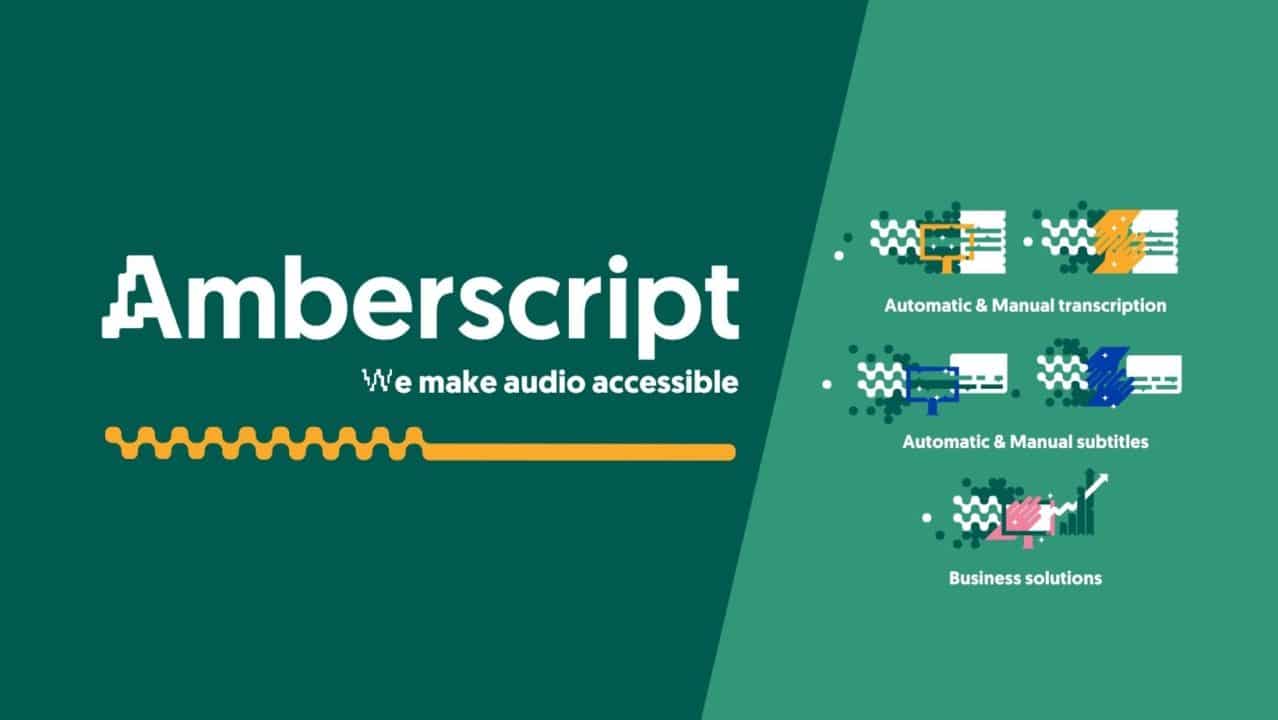
Subtitling in a Multichannel Network Environment
In today’s digital age, Multichannel Networks (MCNs) have emerged as an influential force in the content distribution landscape. MCNs, which manage multiple YouTube channels and offer a range of services to creators, play a pivotal role in shaping our online viewing experiences. Among the many tools at their disposal, one stands out for its ability to expand content reach and improve viewer engagement – subtitling. By providing a textual version of the audio content, subtitles make videos accessible to a broader audience, break down language barriers, and even boost SEO. This blog post will delve into the role of subtitling in an MCN environment, highlighting its importance and the benefits it offers for both creators and viewers.
Table of content
- Overview of what a Multichannel Network (MCN) is
- Understanding Multichannel Networks
- The Importance of Subtitling in MCNs
- Challenges of Subtitling in a Multichannel Network Environment
- Effective Strategies for Subtitling in MCNs
- Future of Subtitling in MCNs
Overview of what a Multichannel Network (MCN) is
An MCN is an organization that works with multiple channels and creators on platforms like YouTube, providing services ranging from audience development and content programming to monetization and digital rights management. These networks offer creators the opportunity to reach a wider audience, collaborate with other content creators, and generate revenue more efficiently.
Subtitling is an essential aspect of MCNs that is often underestimated. As a simple but powerful tool, subtitles serve as a bridge to overcome language barriers, making content accessible to viewers who speak different languages or are deaf or hard of hearing. Moreover, they enhance the viewer’s experience by ensuring that the message is conveyed accurately, even in noisy environments or when the sound is muted.
The benefits of using subtitles in an MCN environment are multifold. From amplifying the reach of content across different languages and regions to boosting viewer engagement and comprehension, subtitles can substantially enhance the value that MCNs deliver to their creators and audiences. Furthermore, they promote inclusivity, ensuring that content is accessible and enjoyable for everyone, regardless of language or hearing abilities.
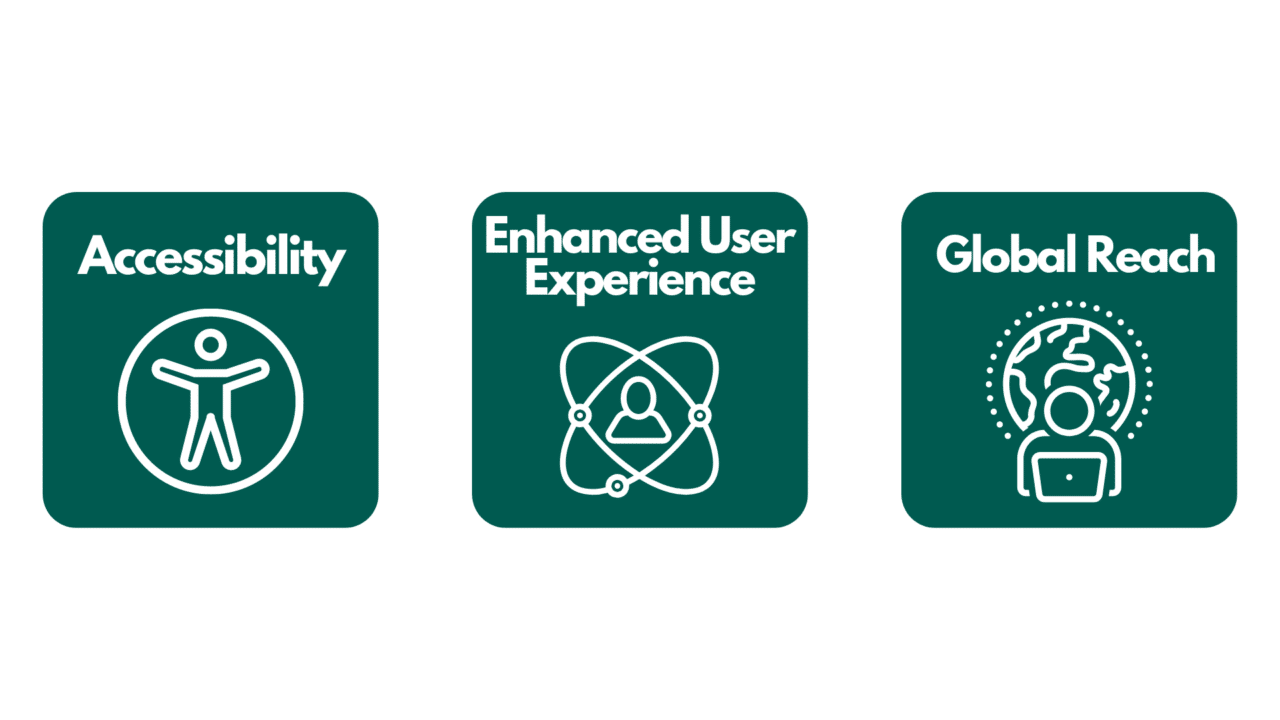
Understanding Multichannel Networks
Before we delve further into the significance of subtitling in Multichannel Networks, it’s crucial to understand what MCNs are and how they operate.
At its core, an MCN is an organization that affiliates with multiple content creators across platforms like YouTube. These networks work with channel owners, offering a range of services including but not limited to digital rights management, monetization, audience development, and content programming. They essentially act as intermediaries between video platforms and content creators, allowing creators to focus on what they do best – creating content, while the MCN handles distribution, promotion, and monetization.
MCNs play a vital role in content distribution and promotion. They use their extensive networks and expertise in digital content strategy to help creators reach their target audience, promote their content, and boost their visibility on the platform. By providing tools, resources, and analytics, MCNs empower creators to grow their channels and engage their audiences more effectively.
In the ever-evolving digital content landscape, the growth and significance of MCNs can’t be overstated. With the exponential rise in online video consumption, MCNs have emerged as a crucial player in the global digital content industry. They are not just facilitating content distribution on a vast scale, but are also shaping the future of content creation and consumption by fostering diverse and vibrant creator communities.
In essence, MCNs serve as a powerful engine for the global digital content industry, driving growth, innovation, and inclusivity. And within this dynamic ecosystem, tools like subtitling play a pivotal role, which we will explore in the next section.
The Importance of Subtitling in MCNs
As we navigate deeper into the world of Multichannel Networks, one element stands out as a game-changer—subtitling. But how exactly does subtitling elevate the game in the MCN environment? Let’s explore.
Firstly, subtitling is a key contributor to content accessibility. By providing a written version of the spoken content in videos, subtitling opens the door to those who are deaf or hard of hearing. It also aids viewers who may have difficulty understanding the spoken language or dialect, those in noisy environments, or those who prefer to consume content without sound. Subtitling ensures that no potential viewer is left behind due to language or auditory challenges.
Secondly, subtitling plays a crucial role in reaching a global audience. As digital content transcends borders, it invariably encounters language barriers. Subtitles, especially when translated into multiple languages, dismantle these barriers, making the content comprehensible to non-native speakers. This expansion of reach is particularly significant for MCNs, which often host a diverse array of content aimed at an equally diverse global audience.
Lastly, subtitling enhances viewer engagement and content retention. When viewers watch subtitled content, they not only listen but also read, creating a dual sensory experience that can improve comprehension and recall. Furthermore, subtitled videos encourage viewer interactions like sharing, liking, and commenting, which can boost the video’s visibility and impact.
In essence, subtitling in MCNs acts as a linchpin, expanding accessibility, enabling global reach, and increasing viewer engagement and retention. These factors combine to optimize the viewing experience and maximize the content’s potential.
Challenges of Subtitling in a Multichannel Network Environment
Despite the undeniable benefits subtitling brings to MCNs, the journey isn’t without its challenges. Let’s explore some of the main hurdles that MCNs and content creators face in the realm of subtitling.
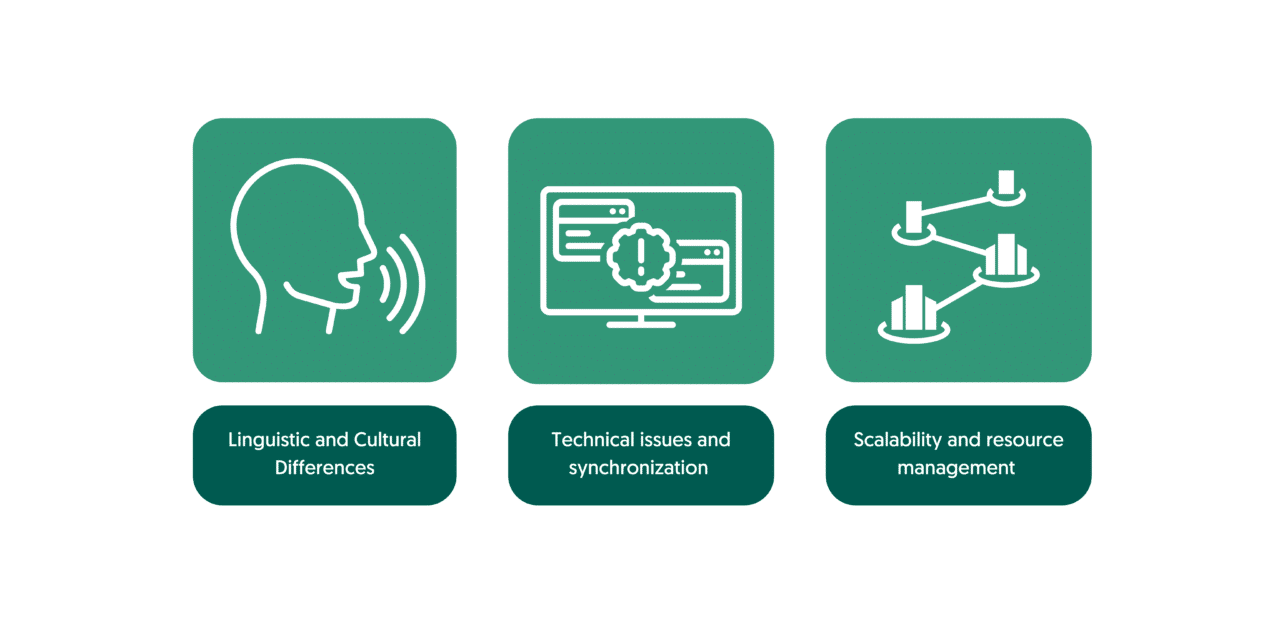
Linguistic and cultural differences
Linguistic and cultural differences often pose a significant challenge in subtitling. Translating content accurately while capturing the nuances, context, and humor can be a daunting task. Not only do subtitles have to be linguistically correct, but they must also respect cultural sensitivities to avoid offending viewers or misrepresenting the content. The challenge becomes even more profound when catering to a global audience with diverse languages and cultural backgrounds.
Technical issues and synchronization
They are common obstacles in the subtitling process. Ensuring that subtitles align perfectly with the audio and visual content is crucial for viewer experience. Mistimed subtitles can confuse viewers and detract from the viewing experience. Moreover, there may be technical limitations related to the platform, file formats, or even the devices viewers use to consume content.
Scalability and resource management
They represent substantial challenges, especially for large MCNs with thousands of videos requiring subtitles. Subtitling is a resource-intensive task that requires time, expertise, and often expensive software. Scaling up to provide subtitles for a large volume of content, potentially in multiple languages, can strain resources and slow down content distribution.
In spite of these challenges, the value of subtitling in MCNs is immense, and with the right strategies and tools in place, these hurdles can be effectively managed.
Effective Strategies for Subtitling in MCNs
Subtitling within MCNs can certainly be complex, but with the right strategies, it can become a powerful tool for expanding reach, boosting engagement, and promoting inclusivity. Let’s delve into some of the most effective strategies for subtitling within MCNs.
Best Practices for Language Localization and Cultural Adaptation
Language localization goes beyond mere translation—it involves adapting the content to suit the linguistic nuances, cultural context, and societal norms of the target audience. Therefore, it’s crucial to work with experienced translators who are not only proficient in the source and target languages but also well-versed in the cultures concerned.
One best practice is to avoid direct, word-for-word translations, which can often lose the original meaning or context. Instead, aim for conveying the message or idea in a way that resonates with the target culture. It’s also essential to be mindful of cultural sensitivities to avoid offending viewers or misrepresenting the content.
Tools and Technologies for Efficient Subtitling
There are various tools and technologies available that can streamline the subtitling process. For example, Amberscript is a powerful tool that uses advanced speech recognition technology to convert audio and video into text. With its ability to recognize multiple languages and dialects, it can be an invaluable asset for MCNs dealing with multilingual content.
Amberscript can also assist with timing and synchronization, ensuring that the subtitles align perfectly with the audio. While the platform provides impressive automated capabilities, it’s essential to remember that human oversight remains crucial to ensure accuracy, context, and cultural appropriateness.

In addition to standalone tools like Amberscript, there are also comprehensive subtitling platforms that allow for collaborative work. These platforms let multiple users work on the same project simultaneously, which can significantly speed up the process and improve efficiency, especially for large MCNs dealing with high volumes of content.

Get a customized offer
Request a quote for your subtitling needs
Future of Subtitling in MCNs
As we move further into the digital age, the landscape of subtitling is expected to evolve significantly. Here are a few key areas that will likely shape the future of subtitling within MCNs.
-
The Potential Impact of AI and Machine Learning on Subtitling
Artificial intelligence and machine learning are rapidly advancing, and their application in subtitling is promising. AI-powered tools like automatic speech recognition (ASR) have the potential to speed up the process of generating subtitles drastically. Machine learning, on the other hand, could be used to improve the accuracy of translations over time by learning from corrections and feedback. However, while these technologies can boost efficiency, they’ll likely work in tandem with human oversight for the foreseeable future to ensure linguistic accuracy and cultural sensitivity.
-
The Role of Community Contributions in Subtitling
Some platforms, like YouTube, have already started harnessing the power of their user communities to contribute to subtitling efforts. This approach can be particularly effective for MCNs, as they typically have large, diverse viewer bases that can provide translations for a wide range of languages. Community contributions can complement professional subtitling services, especially for less commonly spoken languages or for content with highly specialized terminology.
-
The Ongoing Importance of Professional Subtitling Services
Despite the rise of AI and the potential of community contributions, professional subtitling services will continue to play a crucial role in MCNs. The human touch remains vital in providing accurate translations, maintaining cultural appropriateness, and addressing complex linguistic nuances that machines and untrained individuals might miss. As a result, investing in professional subtitling services will likely remain a key strategy for MCNs looking to ensure the highest quality subtitles for their content.
While the future of subtitling in MCNs will undoubtedly be influenced by new technologies and approaches, the essence will remain the same: to make content accessible, engaging, and universally understood.
Subtitling in a Multichannel Network environment is much more than a mere translation task. It’s a powerful vehicle for amplifying reach, enhancing viewer engagement, and championing inclusivity across languages and cultures. The effective use of subtitling can open up opportunities for MCNs to connect on a deeper level with a global audience.
While the advent of AI and machine learning offers promising advancements in the field, the importance of professional subtitling services remains paramount. Moving forward, a balanced approach, which combines technological innovation, community involvement, and professional expertise, will be key to navigating the exciting future of subtitling in MCNs.
As MCNs continue to expand their horizons, embracing the power of effective subtitling will not just be an option—it will be a necessity for success in the global digital content landscape.
Closed Captioning for YouTube SEO: Improving Viewer Experience
Table of Contents
- Importance of closed captioning in media and communication
- Understanding YouTube SEO
- The Role of Closed Captioning in Enhancing Viewer Experience
- The Impact of Closed Captioning on YouTube SEO
- How to Implement Closed Captioning for YouTube Videos
Have you ever wondered how to make your YouTube content more accessible, engaging, and search-engine friendly? The answer may be simpler than you think: closed captioning. Closed captions, text overlays that transcribe dialogue and important audio cues, are not only an essential tool for accessibility, they also can have a profound impact on your YouTube SEO and viewer engagement. This blog post delves into the intricate relationship between closed captioning and YouTube SEO, demonstrating how this feature can enhance your viewers’ experience while boosting your content’s visibility.
Importance of closed captioning in media and communication
In today’s digital era, YouTube has become a key platform for sharing and discovering content. With over 500 hours of video uploaded every minute, getting your content noticed on YouTube is a challenge that requires a well-planned strategy. This is where YouTube Search Engine Optimization (SEO) steps in. SEO, a fundamental aspect of digital marketing, ensures that your content stands out in this sea of endless videos. It involves optimizing your videos, playlists, and channel to be discoverable to targeted audiences, thereby increasing your views and subscribers.
Closed captioning plays a crucial role in enabling individuals with hearing loss to fully comprehend and engage with audiovisual content. By providing a textual representation of the dialogue, sound effects, and other audio elements, closed captions allow those with hearing impairments to access and understand the content on an equal footing with individuals without hearing loss. This accessibility ensures that people with hearing disabilities can enjoy movies, TV shows, online videos, and other forms of media without missing out on essential information or dialogue.
Moreover, closed captioning extends the reach of content to a broader audience. It benefits not only individuals with hearing loss but also those in noisy environments or learning a new language. In loud environments where audio may be difficult to hear clearly, closed captions allow viewers to follow along and understand the content without relying solely on sound. Additionally, for individuals learning a new language, closed captions provide valuable support by offering a visual representation of the spoken words, helping them improve their language skills and comprehension.
Beyond accessibility, closed captioning promotes social inclusion and diversity. By breaking down communication barriers, it ensures that individuals with hearing impairments can actively participate in conversations and cultural experiences. Closed captions enable seamless communication and engagement, fostering a more inclusive society where everyone can share the same media and cultural references. Furthermore, by considering the needs of individuals with hearing loss, content creators and broadcasters demonstrate their commitment to diversity, accessibility, and equality.
Understanding YouTube SEO
To begin with, let’s dive into the concept of YouTube SEO. SEO stands for Search Engine Optimization, and when applied to YouTube, it’s all about optimizing your channel, playlists, metadata, description, and videos, so they appear high in YouTube’s search results.
The ultimate goal of YouTube SEO is to get your videos indexed and ranked higher by YouTube’s algorithm, which will result in more visibility, clicks, views, likes, shares, and, ultimately, subscribers. It involves meticulous planning, from the type of content you produce to the way you classify and promote it.
There are several common techniques for optimizing your YouTube SEO. These include keyword research to understand what your target audience is searching for, optimizing your video titles and descriptions with relevant keywords, using high-quality thumbnails to attract clicks, creating engaging content that keeps viewers watching, and encouraging interactions such as likes, comments, and shares.
But, a crucial part of YouTube SEO that often goes overlooked is the user experience. User experience on YouTube is determined by several factors including how easy it is to find your content, the quality of your content, how engaged your audience is, and how accessible your content is to all viewers. In short, the more user-friendly your content is, the better it will likely perform in terms of SEO. The algorithm takes note of viewer behavior – including how long viewers watch your content (watch time), how quickly they click on your content after seeing it (click-through rate), and how much they interact with your content (engagement).
This is where Closed Captioning can significantly improve your YouTube SEO. By providing a text version of your video’s audio, you’re catering to a wider range of user needs and preferences, making your content more accessible, and hence improving the user experience.
The Role of Closed Captioning in Enhancing Viewer Experience
Now, let’s focus on Closed Captioning and its role in enhancing the viewer experience.
Closed Captioning is the process of displaying text on a video screen to provide additional or interpretive information. These captions typically include the spoken dialogue in the video and may also provide descriptions of non-speech elements, such as music or sound effects.
But how does Closed Captioning improve the viewer experience?
- Accessibility for deaf and hard of hearing viewers: For those who are deaf or hard of hearing, closed captions are an essential feature that allows them to fully understand and engage with video content. By displaying the spoken content as text, closed captions ensure that these viewers can access the same information as those who can hear the audio.
- Comprehension aid for non-native speakers: For viewers who are not fluent in the language of the video, closed captions can significantly improve their comprehension. They can read along with the captions while listening to the audio, which can help them better understand the content and even learn new vocabulary and phrases.
- Facilitating quiet viewing environments: In situations where watching videos with sound isn’t possible or convenient – such as in a library, in the office, or late at night when others are sleeping – closed captions allow viewers to follow along silently.
To understand the impact of Closed Captioning on viewer experience, let’s consider a few examples:
Consider the case of a popular educational YouTube channel, Crash Course. They have been consistently using Closed Captioning for all their videos, enabling them to reach a larger and more global audience, including those with hearing impairments and non-native English speakers. This has not only boosted their views but also earned them positive feedback and appreciation from their viewers for their inclusivity.
Similarly, TED Talks, a channel known for its impactful and diverse range of speeches, uses closed captions in multiple languages. This has helped them cater to a global audience, allowing viewers from all over the world to benefit from their content, regardless of their language proficiency.
The Impact of Closed Captioning on YouTube SEO
The YouTube algorithm, which determines which videos to show in search results and recommendations, uses various signals to rank videos. One of these signals is the video’s content and relevance, which is where Closed Captioning comes into play. YouTube’s algorithm can crawl the text in closed captions, which helps it understand the video’s content and context. Consequently, videos with accurate closed captions are more likely to appear in search results for relevant queries, as the algorithm can better match the video with viewer’s interests.

Additionally, Closed Captioning can significantly boost video engagement in several ways:
- Higher viewer retention: When viewers can fully understand and engage with a video, thanks to closed captions, they are likely to watch it for longer. This increased watch time is a strong signal to YouTube that your video is high-quality and engaging, which can boost your video’s ranking in search results.
- Increase in likes, shares, and comments: Closed captions can also lead to more interactions with your video. When viewers fully understand your content, they are more likely to react to it by liking, sharing, and commenting. These interactions signal to YouTube that your video is engaging, which can help improve its visibility and ranking.
The knock-on effect of this increased engagement is higher video ranking. YouTube prioritizes videos that keep viewers on the platform for longer. So, when your video has high watch time and viewer engagement, YouTube’s algorithm is more likely to promote your video to other users, increasing its ranking in search results and recommendations.
In summary, Closed Captioning not only makes your videos more accessible and enjoyable for viewers but also helps improve your YouTube SEO, leading to increased visibility and engagement.
How to Implement Closed Captioning for YouTube Videos
Having explored the benefits of Closed Captioning for viewer experience and YouTube SEO, let’s discuss how you can implement it for your YouTube videos.
Adding closed captions to your YouTube videos is a straightforward process. Here is a step-by-step guide:
- Log in to YouTube Studio and select the video you want to add captions to.
- Under the ‘Subtitles’ category on the left sidebar, click on ‘ADD’.
- You can then choose to upload a transcript file, auto-sync your text with the video, or type them in manually as you watch the video.
- After adding the captions, you can adjust the timings to match the audio accurately.
- Click ‘Publish’ to save your changes.
When implementing Closed Captioning, it’s important to follow some best practices to ensure the best experience for your viewers:
- Accuracy and readability: Ensure the text accurately represents the spoken word and includes important non-verbal cues. Make sure the text is clear, easy to read, and does not contain spelling or grammatical errors.
- Timing and synchronization: Sync the text with the corresponding audio to ensure the text appears at the right time. This makes it easier for viewers to follow along.
- Language and translation considerations: If your audience speaks different languages, consider adding translations. This can make your videos accessible to a wider audience.
To streamline the process, several third-party tools and services can help you with closed captioning. Services like Amberscript offer professional captioning that guarantees a high level of accuracy.

Incorporating Closed Captioning in your YouTube videos might require an additional step in your video production process, but the benefits for viewer experience and YouTube SEO are well worth it.
Implementing Closed Captioning in your YouTube videos is more than an accessibility feature—it’s an effective strategy for boosting your YouTube SEO and enhancing the viewing experience for your audience. By ensuring your content is understandable and enjoyable for a wider array of viewers, you not only promote inclusivity, but you also increase viewer engagement and your content’s visibility in search results. Whether you’re a seasoned YouTuber or a newcomer, leveraging Closed Captioning can provide your channel with a significant edge in the competitive landscape of YouTube. So, next time you’re uploading a video, remember to caption it. Your viewers, and your SEO, will thank you.
Frequently asked questions
-
How do I add subtitles to a YouTube video?
To add subtitles to your Youtube video, simply add the file you have created using Amberscript to your video in the Youtube Studio. Click on “subtitles”, then “add” and finally “upload file” and select the SRT file.
-
How do I add subtitles to a video on Vimeo?
To add subtitles to your Vimeo video, simply add the file you have created using Amberscript to your video in the editing window on Vimeo. Click on “distribution”, then “subtitles” and finally click on the + symbol to upload the SRT file.
-
How do I order translated subtitles?
To order translated subtitles, you can upload your file like you would normally do. You can then select manual subtitling. Once you have selected this, an option will appear where you will be able to select the language the subtitles need to be translated to. If the language that you want is not one of the options you can contact us through our contact form.
-
To which languages can you translate subtitles?
For our human-made subtitling services we work with a network of language experts in 15 different languages. Find out which here. If the language you want is not on the list, please contact us through our contact form.
-
What subtitle file formats are supported?
Our software allows you to export the transcript from the video or audio file as an SRT, EBU-STL or VTT file.
-
Can I burn the subtitles directly onto my video?
If you have exported the transcript as a SRT, EBU-STL or VTT file, you can easily burn them onto your video using video-editing software.
-
How do I generate subtitles?
You can generate subtitles automatically using Amberscript. Our software allows you to convert your video file to text and then export the transcripts as SRT, EBU-STL or VTT files, which can easily be inserted into a video-editor.
How Subtitling Can Help MCNs Reach New Audiences
Subtitling is a powerful tool that has the potential to greatly benefit Multi-Channel Networks (MCNs) and their content. It not only makes videos more accessible, engaging, and comprehensive for viewers of all backgrounds, but it also amplifies the reach of MCNs by making their content easier to find online and allowing them to tap into new international markets.
Subtitling is an effective way for MCNs to increase shareability on social media platforms such as YouTube, improve SEO rankings, and potentially create viral content. By embracing subtitling as part of their strategy, MCNs can unlock the full potential of their videos and open up new possibilities for global success.
Table of Contents
- The Power of Subtitling
- Improving Discoverability and SEO
- Engaging Non-Native Speakers
- Social Media Amplification
- Subtitling with Amberscript
- Subtitling for MCNs to Reach New Audiences
The Power of Subtitling

Accessibility
Subtitling is an effective way to make videos accessible for a wider range of viewers. By adding subtitles, MCNs can ensure that their content is available to people with hearing impairments or other disabilities, as well as those who speak different languages.
Subtitles also help improve comprehension and engagement by providing additional information on the video in an easily understandable format, allowing viewers to take away more from the experience and enjoy it to its fullest potential. With subtitles, MCNs can reach new audiences and foster a sense of inclusion among all viewers.
Enhanced User Experience
Subtitles can have a major impact on the user experience by making videos easier to understand and more enjoyable to watch. Subtitles provide visual cues that make it easier for viewers to follow along, pick up on important details, and get the most out of the content.
They also help bridge language barriers, allowing MCNs to reach audiences in different countries without having to dub or translate their videos. By adding subtitles, MCNs can improve comprehension, enhance engagement, and ensure that viewers are getting the best possible experience from their content.
Global Reach
One of the biggest advantages of subtitling for MCNs is how it allows them to reach a global audience. By adding subtitles, MCNs are able to break through language barriers and open up their content to viewers in different countries. Subtitling can also help improve search rankings by providing more text-based metadata that search engines can index, allowing MCNs to gain visibility on a global scale. By leveraging subtitling as part of their strategy, MCNs can expand their reach and tap into new markets around the world.
Improving Discoverability and SEO
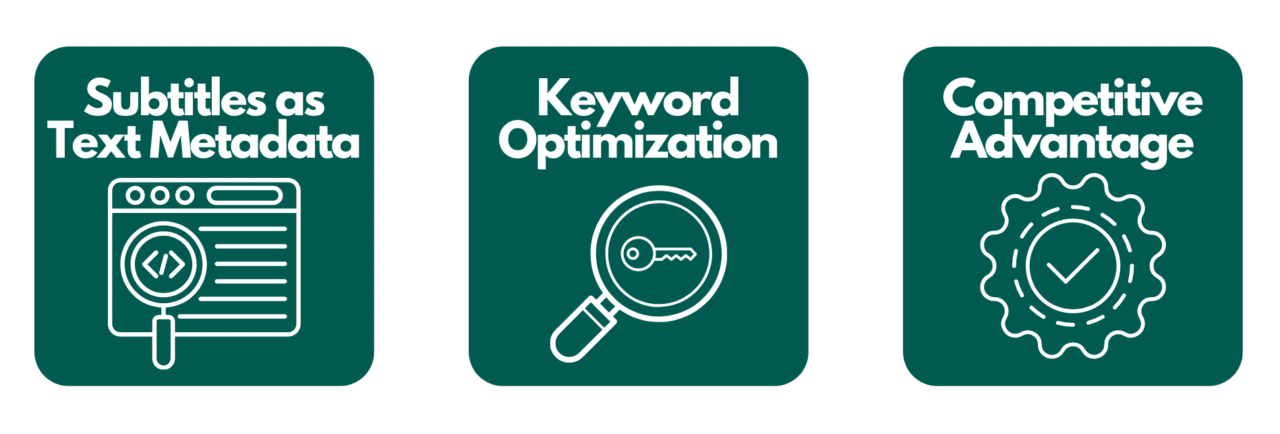
Subtitles as Text Metadata
Subtitles can be a powerful tool for improving discoverability and SEO rankings. By providing text-based metadata, subtitles allow search engines to better index MCN content and make it more visible in search results. This is especially useful when using targeted keywords to optimize subtitles, as this can help boost the visibility of MCN videos in relevant searches. With the right subtitling strategies, MCNs can ensure that their content is easier to find online and gain an edge over competing channels.
Keyword Optimization
Keyword optimization is an important part of effective subtitling strategies for MCNs. By incorporating targeted keywords into subtitles, MCNs can increase the visibility of their content and gain an advantage over competing channels in search results.
By carefully selecting keywords that are relevant to the topic of the video, MCNs can ensure that viewers are able to find their content online more easily. It is also important to keep in mind the target audience when choosing keywords, as this will help tailor the subtitles for maximum impact.
Competitive Advantage
Subtitling offers a great opportunity for MCNs to gain an edge over competitors by improving SEO rankings and boosting visibility online. With targeted keyword optimization and carefully selected subtitles, MCNs can ensure that their content appears higher in search results and gets more attention from viewers. This can be a powerful tool for gaining an upper hand on competing channels, as it allows MCNs to get the most out of their videos and increase their chances of success in the competitive world of online video.
Engaging Non-Native Speakers

Growing International Market
The global appeal of MCN content has led to a growing international market, with non-native English speakers comprising an increasingly large portion of viewers. In order to reach this broad audience, MCNs must take the time to ensure their content is accessible and engaging for all viewers.
Subtitling can be a powerful tool for making videos more comprehensible and enjoyable for non-native English speakers, as it allows them to better understand what’s being said in the video and engage more deeply with the content.
Language Customization
Subtitling is a great way for MCNs to offer their content in multiple languages and cater to audiences who speak different dialects. By creating subtitles in various languages, MCNs can ensure that viewers are able to understand the content regardless of where they are located or what language they speak. This allows MCNs to open up their content to a wider range of viewers and foster a sense of inclusion among all members of the audience. With language customization, MCNs can create an enjoyable experience for international viewers, as well as increase engagement and loyalty among fans from around the world.
Cultural Sensitivity
Subtitling offers a great opportunity for MCNs to reach out to international audiences by adapting subtitles to local dialects, idioms, and cultural references. With language customization, MCNs can make sure that their content resonates with viewers from different countries and cultures. This approach is especially important in today’s globalized world, as it ensures that all members of the audience feel included and respected regardless of their background or nationality. By showing cultural sensitivity through subtitling, MCNs can foster an environment where everyone feels welcome and empowered to engage with the content they love.
Social Media Amplification

Subtitles for Social Media Platforms
Subtitles are essential for MCNs looking to reach their audience on social media platforms. With auto-play videos and often muted playback, subtitles are the only way for viewers to understand what’s being said in videos without having to turn up the volume or click on the video itself. This makes subtitles an invaluable tool for amplifying content on social media, as it ensures that viewers can quickly and easily understand what’s being said even if they don’t have access to sound. By leveraging subtitles effectively, MCNs can make sure that their content is seen and heard by as many people as possible.
Increased Shareability
Subtitles can also be an effective way for MCNs to increase the shareability of their content on social media. By offering subtitles in multiple languages, MCNs can make sure that viewers from all over the world are able to understand what’s being said and engage more deeply with the content. This encourages viewers to share the video with their friends and followers, thereby helping to spread the word about MCN content and boost its visibility online. With subtitles, MCNs can ensure that their videos reach a wider audience and get more attention on social media platforms.
Viral Potential
Subtitles can be a great way for MCNs to take advantage of the potential for their videos to go viral. Case studies have shown that by adding subtitles, MCNs can significantly increase the shareability of their content and reach new audiences that may have otherwise missed out on their videos.
Videos with subtitles are often shared more widely than those without, which helps to boost visibility online and create buzz around the content. With targeted keywords and language customization, MCNs can maximize the viral potential of their videos and make sure they get seen by as many people as possible.
Subtitling with Amberscript
Subtitling services like Amberscript can be a great resource for MCNs looking to make the most out of their content. Amberscript’s automated subtitle generator makes it easy to quickly add subtitles to videos, so that viewers don’t have to wait for manual transcribing and editing. It also supports multiple languages and offers language customization, so that MCNs can reach international audiences with their videos.

Finally, Amberscript allows users to preview subtitles on different devices before publishing them online, which helps ensure accuracy and quality control. With the help of tools like Amberscript, MCNs can easily create engaging video content and boost its success in the competitive world of online video.
Subtitling for MCNs to Reach New Audiences
Recap of the Benefits of Subtitling for MCNs
Subtitling is an invaluable tool for MCNs looking to make the most out of their content. From broadening audiences and increasing engagement to offering language customization and boosting shareability on social media platforms, subtitling has a huge range of benefits for MCNs.
With the help of automated services like Amberscript, MCNs can easily create subtitles for their videos and make sure they are seen by as many people as possible. By leveraging the power of subtitling, MCNs can reach new viewers from around the world and maximize the success of their online video content.
Encouragement for MCNs to Embrace Subtitling as a Means to Reach New Audiences
MCNs should be encouraged to embrace subtitling as a powerful tool for reaching new audiences and amplifying their content on social media platforms. By taking advantage of subtitling services like Amberscript, MCNs can easily create subtitles for their videos and ensure that viewers from all around the world can understand and engage with the content.
With language customization, MCNs can also make sure that local dialects and cultural references are accurately represented in subtitles to foster an inclusive environment among fans from different backgrounds. Subtitling is an invaluable asset in today’s competitive online video landscape, so MCNs should take full advantage of it to boost the success of their content.
Speech to text tools for people with disabilities
Table of Contents
- Definition of speech-to-text tools
- Importance of speech-to-text tools for people with disabilities
- How speech-to-text tools work
- Top Speech-to-Text Tools for People with Disabilities
- Amberscript
- Dragon NaturallySpeaking
- Otter.ai
- Google Gboard
- Windows 10 Speech Recognition
Definition of Speech-to-Text Tools
Speech-to-text tools, also known as voice recognition software or dictation tools, are advanced technological solutions designed to convert spoken language into written text. These tools utilize complex algorithms and artificial intelligence (AI) to analyze and interpret spoken words, transforming them into accurate and readable text in real-time. By bridging the gap between spoken and written communication, speech-to-text tools provide individuals with disabilities or limitations an effective means of expression and accessibility.
These tools capture audio input, process it through sophisticated speech recognition systems, and generate corresponding written text, empowering users to communicate, create content, and engage with others through written language. With their ability to enhance accessibility and inclusivity, speech-to-text tools have become invaluable resources for individuals with speech impairments, hearing impairments, motor disabilities, dyslexia, and other conditions.

Get a customized offer
Request a quote for Speech-to-Text API
Importance of Speech-to-Text Tools for People with Disabilities
Speech-to-text tools play a crucial role in improving the quality of life for people with disabilities. These tools offer several key benefits that enhance communication, productivity, and independence.
Firstly, speech-to-text tools enable individuals with speech impairments to overcome the limitations imposed by their condition. By converting spoken words into written text, these tools facilitate effective communication, allowing individuals to express their thoughts, needs, and ideas with greater ease and accuracy. This enhanced communication fosters inclusivity and enables individuals to actively participate in conversations, social interactions, and professional environments.
Speech-to-text tools also provide a valuable resource for individuals with hearing impairments. By transcribing spoken words into written text in real-time, these tools allow individuals to read and understand conversations, lectures, or other audio content. This helps bridge the gap between the hearing world and the deaf or hard-of-hearing community, enabling equal access to information and facilitating effective communication.
Tools like this empower individuals with motor disabilities or conditions that affect their ability to type or write. These tools eliminate the physical barriers associated with traditional methods of text input by allowing users to dictate their thoughts verbally. By converting speech into text, individuals can compose documents, emails, or messages without the need for manual typing or writing, thereby improving productivity and efficiency.
How Speech-to-Text Tools Work
Speech-to-text tools utilize a combination of advanced technologies to convert spoken language into written text. The process involves several key steps that enable accurate and real-time transcription of speech.
- Audio Input: The speech-to-text tool begins by capturing audio input, typically through a microphone. The tool then digitizes and processes the audio data, preparing it for further analysis.
- Speech Recognition: The processed audio data is then passed through a speech recognition system. This system uses complex algorithms and machine learning techniques to analyze the audio, identify speech patterns, and convert them into corresponding text. The system is trained on vast amounts of data to recognize and interpret different languages, accents, and speech variations.
- Language Processing: Once the speech is recognized, the tool performs language processing tasks to improve accuracy and readability. This includes tasks such as punctuation insertion, capitalization, and grammar correction.
- Real-Time Transcription: Many speech-to-text tools offer real-time transcription, meaning the converted text is displayed immediately as the user speaks. This feature allows users to see the transcription in real-time, enabling them to make corrections or modifications as needed.
- Post-Processing and Editing: After the speech is transcribed, users have the option to edit, proof read and correct any mistakes.
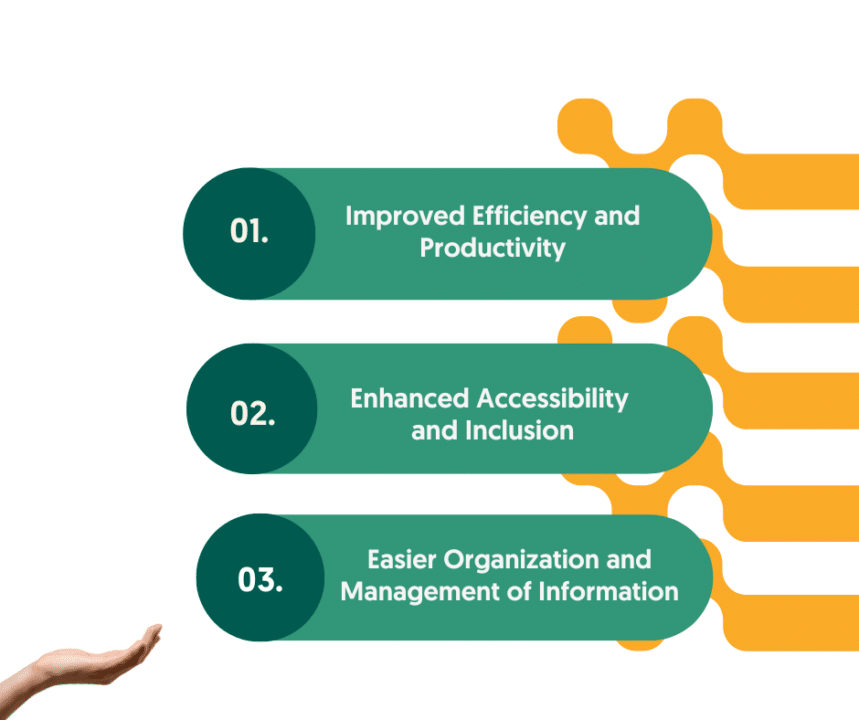
Top Speech-to-Text Tools for People with Disabilities
Amberscript

Amberscript is an excellent speech-to-text tool that provides numerous benefits for individuals with disabilities. With its advanced technology and user-friendly interface, Amberscript offers a reliable and accurate solution for converting spoken language into written text. Here are some key reasons why Amberscript stands out as a top choice for people with disabilities:
- Accuracy and Reliability: Amberscript utilizes state-of-the-art speech recognition algorithms and AI technology, ensuring high accuracy in transcribing spoken words. The tool continuously learns and adapts to individual users’ speech patterns, leading to improved accuracy over time. This reliability is crucial for individuals with disabilities who heavily rely on accurate transcription to communicate effectively.
- User-Friendly Interface: Amberscript features a user-friendly interface that makes it accessible to individuals of varying technological proficiency. The intuitive design allows users to navigate the tool effortlessly, ensuring a smooth and seamless transcription experience. The simplicity of the interface is particularly beneficial for individuals with disabilities who may have specific accessibility needs or limitations.
- Integration Options: Amberscript offers flexible integration options, allowing users to incorporate the tool into their preferred devices or software. Whether it’s integrating with popular transcription software, word processors, or assistive technologies, Amberscript ensures compatibility and ease of use, catering to the diverse needs of individuals with disabilities.
- Accessibility Features: Amberscript recognizes the importance of accessibility and offers features to support individuals with disabilities. This includes customizable settings for font size, color contrast, and keyboard shortcuts, accommodating users with visual impairments or motor disabilities. By prioritizing accessibility, Amberscript ensures an inclusive and user-centric experience for all users.
- Positive User Feedback: Amberscript has received positive feedback from users, including individuals with disabilities. Testimonials and success stories highlight the tool’s effectiveness in improving communication, productivity, and accessibility for users with diverse needs. Such feedback further solidifies Amberscript’s reputation as a reliable and valuable speech-to-text tool for individuals with disabilities.
Dragon NaturallySpeaking
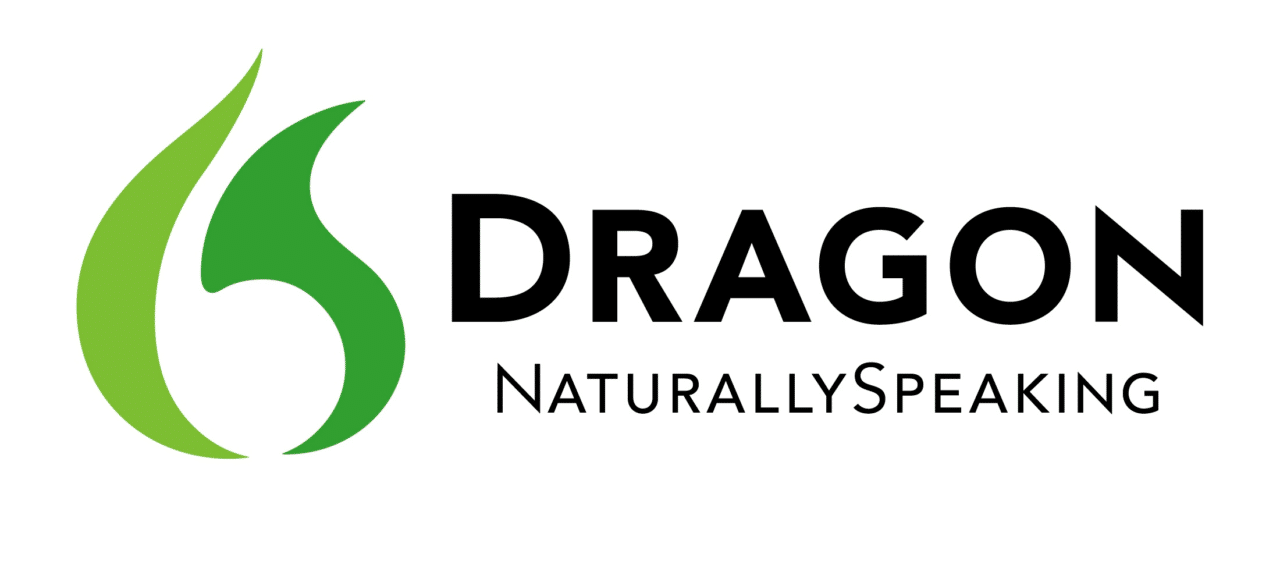
Dragon NaturallySpeaking, developed by Nuance, is a highly regarded speech-to-text tool that offers numerous advantages for individuals with disabilities. Here are key reasons why Dragon NaturallySpeaking stands out as an excellent choice for people with disabilities:
- Exceptional Accuracy: Dragon NaturallySpeaking boasts industry-leading accuracy in speech recognition. The software utilizes advanced algorithms and deep learning technology to consistently deliver highly accurate transcriptions. This level of precision is crucial for individuals with disabilities who rely on accurate speech-to-text conversion to effectively communicate and express themselves.
- Customization and Personalization: Dragon NaturallySpeaking provides extensive customization options, allowing users to tailor the tool to their specific needs and preferences. Users can create custom vocabularies, add specialized terminology, and adapt the software to their unique speech patterns. This flexibility ensures that individuals with disabilities, who may have specific speech characteristics or specialized terminology, can achieve optimal accuracy and recognition.
- Wide Range of Applications: Dragon NaturallySpeaking offers seamless integration with various software and applications, including popular word processors, email clients, and web browsers. This versatility enables individuals with disabilities to use the tool across multiple platforms and perform tasks such as writing documents, composing emails, or browsing the internet, with ease and efficiency.
- Accessibility Features: Dragon NaturallySpeaking prioritizes accessibility, catering to the needs of users with disabilities. The software supports various assistive technologies, offering compatibility with alternative input devices, switch scanning, and other accessibility tools. This inclusive approach ensures that individuals with motor disabilities or other limitations can fully utilize the software and overcome barriers to communication and productivity.
Otter.ai
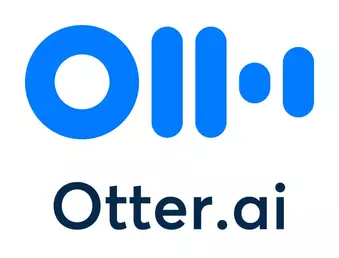
Otter.ai is an exceptional speech-to-text tool that offers a range of benefits for individuals with disabilities. Designed to provide accurate and real-time transcription, Otter.ai stands out as a valuable resource for enhancing communication, accessibility, and productivity. Here are key reasons why Otter.ai is an excellent choice for people with disabilities:
- Real-Time Transcription: Otter.ai excels in providing real-time transcription capabilities, enabling users to see the converted text as they speak. This immediate feedback allows individuals with disabilities to review and make corrections or modifications in real-time, ensuring accurate and effective communication.
- Accurate Speech Recognition: Otter.ai employs advanced speech recognition technology to deliver accurate transcriptions. The tool is constantly updated and refined to improve accuracy and adapt to different accents, languages, and speech patterns. This level of accuracy is crucial for individuals with disabilities who rely on precise transcriptions for effective communication and understanding.
- User-Friendly Interface: Otter.ai features a user-friendly interface that is intuitive and easy to navigate. The tool offers a clean and straightforward design, making it accessible to users of varying technological abilities. This simplicity is particularly beneficial for individuals with disabilities who may require a user-friendly interface to enhance usability and accessibility.
- Collaboration and Integration: Otter.ai facilitates collaboration by allowing users to share transcriptions with others in real-time. This feature promotes inclusive communication, enabling individuals with disabilities to actively participate in group discussions, meetings, or educational settings. Otter.ai also offers integration options with popular productivity tools, making it seamless for users to incorporate transcriptions into their workflows.
- Accessibility Features: Otter.ai recognizes the importance of accessibility and provides features to support individuals with disabilities. This includes customizable settings for font size, color contrast, and compatibility with assistive technologies. These accessibility features ensure that individuals with visual impairments or other disabilities can comfortably access and utilize the tool.
Google Gboard
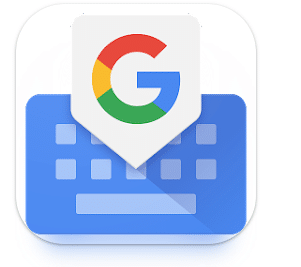
Google Gboard, with its integrated speech-to-text capabilities, serves as a highly effective tool for individuals with disabilities. It offers a range of features and benefits that enhance accessibility, communication, and ease of use. Here’s why Google Gboard stands out as a good speech-to-text tool for people with disabilities:
- Voice Typing: Google Gboard includes a powerful voice typing feature that allows users to dictate text in various applications. With a simple tap on the microphone icon, users can speak naturally, and Gboard converts their speech into written text in real-time. This feature eliminates the need for manual typing, making it particularly beneficial for individuals with motor disabilities or conditions that affect typing speed or accuracy.
- Accuracy and Language Support: Google Gboard leverages Google’s advanced speech recognition technology, resulting in high accuracy in transcriptions. It supports a wide range of languages and dialects, ensuring that individuals with diverse linguistic backgrounds or speech patterns can effectively communicate using their preferred language.
- Multilingual Support: Google Gboard offers multilingual support, allowing users to switch between multiple languages seamlessly. This feature benefits individuals who are bilingual or multilingual, ensuring that they can dictate text in different languages without needing to switch between different input methods or apps.
- Integration with Accessibility Features: Gboard integrates with various accessibility features available on Android and iOS devices. It supports switch access and external keyboards, enabling individuals with motor disabilities to utilize alternative input methods. Gboard also integrates with screen readers, providing auditory feedback for individuals with visual impairments.
- Customization and Personalization: Google Gboard offers customization options to suit individual preferences. Users can adjust settings such as keyboard layout, key size, and gesture typing sensitivity to optimize their typing experience. This flexibility ensures that individuals with disabilities can adapt Gboard to their specific needs, enhancing their overall usability and accessibility.
Windows 10 Speech Recognition

Windows 10 Speech Recognition offers a robust and accessible speech-to-text solution, making it a valuable tool for individuals with disabilities. Here are several reasons why Windows 10 Speech Recognition stands out as an excellent option for people with disabilities:
- Native Integration: Windows 10 Speech Recognition is built directly into the operating system, providing seamless integration and accessibility for users. This native integration eliminates the need for additional software installation and ensures compatibility with various applications and programs on the Windows platform.
- Accessibility Features: Windows 10 Speech Recognition is designed with accessibility in mind. It offers a range of features that cater to individuals with disabilities, including voice commands for hands-free operation, customizable speech recognition settings, and compatibility with assistive technologies such as screen readers and alternative input devices.
- Accuracy and Language Support: Windows 10 Speech Recognition utilizes advanced speech recognition technology, resulting in accurate and reliable transcriptions. It supports multiple languages and dialects, enabling individuals with diverse linguistic backgrounds or speech patterns to communicate effectively using their preferred language.
- System-wide Functionality: Windows 10 Speech Recognition works seamlessly across the entire operating system, allowing users to dictate text in various applications, text editors, web browsers, and more. This system-wide functionality ensures that individuals with disabilities can access and utilize speech-to-text capabilities in their daily activities, whether it’s writing documents, composing emails, or browsing the internet.
Encouragement to explore and try different speech-to-text options
Speech-to-text tools are of paramount importance for people with disabilities as they enhance communication, foster inclusivity, and promote independence. These tools enable individuals to overcome barriers imposed by their disabilities, providing them with the means to express themselves, access information, and participate fully in various aspects of life.
The advent of cutting-edge speech-to-text tools such as Amberscript, Dragon NaturallySpeaking, Otter.ai, Google Gboard, Windows 10 Speech Recognition, and Microsoft or Apple Dictate has significantly expanded the possibilities for individuals with disabilities. These tools boast user-friendly interfaces, robust features, and seamless integration with other software and devices, further enhancing their effectiveness and usability.
In conclusion, when it comes to speech-to-text tools for people with disabilities, Amberscript truly shines. With its accuracy, user-friendly interface, integration options, and positive user feedback, it’s a reliable and valuable solution. Whether you need to transcribe lectures, create written content, or communicate more effectively, Amberscript has got you covered.
Experience the power of Amberscript for yourself and unlock a world of accessibility and inclusivity. Start using Amberscript today and discover the transformative impact it can have on your transcription needs. Empower your voice, break down barriers, and embrace a new level of communication with Amberscript!
Our services are
5x average time saving by using AI.
Enabling an accurate flow of audio-to-data, adjustable in our easy to use online text editor.
GDPR compliant security and safety.
How Subtitles and Captions Help Increase Video Views by 80%
Are you struggling to get more views on your videos? Have you been searching for a way to easily boost video engagement and viewership? Then look no further, as subtitles and captions are the answer! Adding subtitles and captions can increase video views by an impressive 80%, making them a powerful tool for enhancing viewer engagement and expanding content reach.
From improving accessibility to increasing discoverability, subtitles and captions provide numerous benefits that make them an essential part of any successful video strategy. In this blog post, we will explore the importance of video views, discuss the role of subtitles and captions in improving user experience, explain how they can boost viewer engagement and discoverability, address sound-sensitive environments, showcase case studies and statistical evidence to support their impact on video views, provide best practices for creating subtitles and captions, and outline potential limitations.
By the end of this article, you will have a better understanding of why subtitles and captions are invaluable tools that can help you take your videos to the next level! Additionally you will learn more about Amberscript – your first choice for subtitles and captions.
Table of Contents
- Understanding the Importance of Video Views
- The Role of Subtitles and Captions
- Increasing Viewer Engagement
- Making Videos Accessible with Subtitles and Captions
- Addressing Sound-Sensitive Environments
- Best Practices for Adding Subtitles and Captions
- Key Findings at a Glance
Enhancing Video Engagement and can Increase Views by 80%
Subtitles and captions play a crucial role in improving video engagement and viewership. Adding subtitles and captions to your videos can lead to an impressive 80% increase in views, making them an incredibly powerful tool for boosting engagement. Subtitles and captions not only provide accessibility benefits, but also enable you to reach a larger audience by overcoming language barriers. Additionally, they help make videos more discoverable by increasing their visibility on search engine results pages (SERPs).
Finally, subtitles and captions provide solutions for sound-sensitive environments, allowing viewers to access video content without audio. With so many advantages of incorporating subtitles and captions into your video strategy, there is no doubt that adding them can significantly help enhance your content and increase viewership. Make sure to get the most out of your videos by taking advantage of this essential tool! Amberscript is here to help you with all your subtitling and captioning needs, so be sure to check us out!
Understanding the Importance of Video Views
Definition of Video Views and their Significance
Video views are an essential metric for understanding the success and reach of your videos. A video view is defined as a single instance of someone watching your video, whether it be in full or in part. Video views are important because they provide insight into the effectiveness of your content and how much engagement it has garnered. The number of views you get may not always directly translate to success, however having more viewers means you have a larger potential audience that can become invested in what you create.
Additionally, higher numbers often lead to increased visibility on search engine results pages (SERPs) as well as social media platforms such as YouTube and Facebook. This is why it’s so important to find ways to increase your video views – one way to do this is by adding subtitles and captions! By providing added accessibility, subtitles and captions can help you reach a wider audience and boost your video engagement. Don’t miss out on this powerful tool – stay ahead of the competition with Amberscript’s subtitling and captioning services!

Get a customized offer
Request a quote for your subtitling needs
The Impact of Video Views on Content Creators and Businesses
Video views have become an important metric for content creators and businesses, as they can be used to measure how successful a particular video is in terms of engagement. Video views are often seen as the basis of success when it comes to monetizing videos on platforms such as YouTube, where advertisers pay based on the number of times their ads appear within a video. Higher view counts also increase visibility for content creators and businesses, allowing them to gain more attention from potential customers or fans.
Video views may be taken into account when ranking videos on search engines like Google or YouTube itself, resulting in greater organic reach for those with higher view counts. Ultimately, understanding the impact of video views can help ensure that content creators and businesses get maximum visibility and monetization out of their videos.
By tracking video view counts, content creators and businesses can assess the success of their videos before investing more time and resources into them, as well as making improvements for future releases. Video views are also a valuable source of feedback from audiences, allowing content creators to adjust their approach or style to better suit their fans’ preferences. Ultimately, understanding the impact of video views can help ensure that content creators and businesses get maximum visibility and monetization out of their videos.
The Role of Subtitles and Captions
Definition and Purpose of Subtitles and Captions
Subtitles and captions are important elements of any video, as they provide a means to understand the audio content without having to rely solely on sound. Subtitles are text-based versions of the spoken dialogue or narration in a video that can be read along with the visuals. Captions, meanwhile, are transcripts of all audio elements including music and sound effects. While subtitles help viewers watch foreign films or videos with heavy accents or unclear audio quality, captions make multimedia more accessible for deaf and hard-of-hearing individuals.
Subtitles can also benefit people who would like to view videos in loud environments such as public spaces where it may not be appropriate to play sound out loud. Without subtitles or captions, viewers might miss out on important information or context cues that can greatly alter the experience of watching a video. Therefore, subtitles and captions are essential tools for making multimedia more accessible and enjoyable to everyone.
Accessibility Benefits of Subtitles and Captions
Subtitles and captions provide a range of accessibility benefits for people with hearing impairments, making media content accessible to everyone. They can also be useful for people who are hard of hearing, have English as a second language, or those in noisy environments where the audio is difficult to understand. Subtitles and captions help improve comprehension by providing written evidence of what is being said on screen.
By including subtitles and captions in your videos, you make it easier for all your viewers to enjoy and understand your content – no matter their circumstances. This makes your content more inclusive and accessible to wider audiences than ever before. Not only does this boost engagement from viewers who require them due to disability or language barrier, but it also increases overall engagement from those who do not require it. Subtitles and captions are a win-win for everyone!
Improving User Experience with Subtitles and Captions
Subtitles and captions are both great tools for improving the user experience, as they allow viewers to access audio information that was previously inaccessible. Subtitles provide a complete transcription of what is being said onscreen, making it easier for deaf or hard-of-hearing viewers to follow along with the dialogue. Captions take this one step further by adding descriptions of sound effects and other non-speech elements that are part of the video experience.
Providing subtitles and captions, content creators can ensure that everyone has access to their work—regardless of hearing ability—while also increasing engagement from their audience. In addition, subtitles and captions can help viewers better understand unfamiliar accents or slang words that might be used in a piece of content. Ultimately, subtitles and captions are essential tools for any content creator who wants to provide a truly inclusive user experience.
Increasing Viewer Engagement
Catering to Diverse Audiences with Multilingual Subtitles
Content creators can increase viewer engagement by catering to diverse audiences with multilingual subtitles. This is an effective way of ensuring that content is accessible to viewers from different linguistic backgrounds, as well as those who are not native English speakers. With the right subtitle formats and language options, content creators can reach a much wider audience than ever before—opening up new possibilities for growth and success.
Overcoming Language Barriers and Expanding Reach
Subtitles and captions can be incredibly useful for overcoming language barriers and expanding your reach. By providing subtitles in multiple languages, content creators have the potential to engage a much wider audience than ever before. Viewers who are not native English speakers are more likely to watch videos with subtitles as it increases their understanding of what is being said or shown on the screen. This helps to ensure that everyone has access to the content, regardless of their language background or hearing ability.
Enhancing Comprehension and Engagement through Captions
Captions are invaluable for enhancing comprehension and engagement by making videos more accessible to all viewers, regardless of hearing ability. Captions provide a written record of what is being said onscreen, which can be helpful for hard-of-hearing viewers or those who are not native-English speakers. They also help to better explain sound effects and other non-speech elements that may be difficult to understand without additional information. By adding captions to their videos, content creators can ensure that everyone has access to their work—while at the same time increasing engagement from their viewers.
Making Videos Accessible with Subtitles and Captions
Search Engine Optimization (SEO) Advantages of Subtitles
Subtitles are a great way to make videos more accessible, and they can also provide search engine optimization (SEO) advantages. By adding subtitles to your content, you can increase the visibility of your videos in online searches and make them easier for viewers to find. Subtitles enable search engines to understand the context of what is being said onscreen—which means that they can be used as an effective tool for keyword targeting and ranking higher in search results. Ultimately, utilizing subtitles in this way can help content creators reach larger audiences while also increasing engagement from their viewers.
Increased Visibility on Social Media Platforms
In addition to SEO advantages, subtitles can also help increase the visibility of videos on social media platforms. This is because many social media algorithms prioritize content with subtitles and captions, which makes it easier for viewers to find and access your work.
Having multiple language versions available also makes it easier for viewers to share their favorite videos with friends and family all over the world. By providing subtitles in several languages, content creators can maximize their chances of success while also showing their commitment to fostering inclusivity on their platform.
Captions as Textual Content for Search Engine Indexing
Captions provide a written record of what is being said onscreen, which makes them invaluable for search engine indexing. By adding captions to your videos, you can ensure that your content will be indexed by search engines and made visible in online searches. This not only increases the chances of viewers finding your video—it also ensures that they get an accurate understanding of the content without having to watch it first. Captions are thus an effective tool for improving SEO performance while at the same time providing an accessible version of your work to all types of viewers.
Addressing Sound-Sensitive Environments
Viewing Videos without Audio in Public Spaces
We often take for granted the ability to view videos with sound, but this isn’t always possible in public spaces. Whether it’s due to noise regulations, personal preference or other considerations, many viewers don’t have the option of viewing a video with audio. Fortunately, subtitles are an effective solution for this issue—they enable viewers to understand and engage with videos without having to rely on sound. By providing subtitles for their videos, content creators can make sure that their work is accessible even in sound-sensitive environments.
Providing a Solution for Individuals with Hearing Impairments
Subtitles are also an effective solution for individuals with hearing impairments. For viewers who are hard of hearing or deaf, captions provide a written record of what is being said onscreen—which can be invaluable for understanding the context and full scope of multimedia content. By adding subtitles to their videos, content creators can ensure that everyone has access to their work—while at the same time increasing engagement from their viewers. Ultimately, adding captions to your multimedia content is an effective way of reaching a wider audience while also improving user experience and viewer engagement.
Best Practices for Adding Subtitles and Captions
Choosing the Right Tools and Software for Subtitling and Captioning
When it comes to adding subtitles and captions, it’s important to choose the right tools and software. There are a variety of different solutions on the market that can be used for subtitling and captioning, from free online applications to paid options with more advanced features.
It’s also important to consider how much time you have available—for example, automated programs can provide quick results but may not always produce accurate translations, whereas manually creating subtitles or captioning videos can take longer but will ensure better accuracy.
Proper Formatting and Synchronization Techniques
Once you’ve chosen the right tools and software, the next step is to make sure that your subtitles and captions are properly formatted and synchronized. This means keeping lines of text short so viewers can easily follow along—as well as ensuring that text appears at the same time as audio cues. It’s also important to format subtitles in a way that complements the video content—for example, by using color-coding or highlighting to emphasize key points. By following best practices such as these, content creators can ensure that their videos are accessible to all types of viewers.
Tips for Creating Accurate and Engaging Subtitles and Captions
Creating accurate and engaging subtitles or captions is an important part of making multimedia content accessible for all viewers. To ensure a high level of accuracy, it’s important to use accurate spelling and punctuation as well as avoiding slang words or colloquialisms. It’s also important to use the active voice—for example, rather than saying “the village was destroyed” you would say “an avalanche destroyed the village”. Providing context-specific translations can help make your subtitles or captions more engaging by providing viewers with additional information about the content. By following these simple tips, content creators can create effective subtitles or captions that are both accurate and engaging.
Amberscript – your Tool for Subtitles and Captions
Are you searching for the ideal platform to effortlessly add subtitles to your videos? Look no further than Amberscript. Our cutting-edge technology and user-friendly platform make the process of adding subtitles a breeze. By choosing Amberscript, you can ensure that your content remains relevant and accessible to a wide audience. Claim your free trail and experience the convenience and effectiveness of Amberscript today.

With both automatic and manual solutions available, Amberscript is an experienced video subtitle solutions provider that can not only deepen your connection to your existing audiences, but potentially grow your influence worldwide with accurate and compelling subtitle video translation services.
All services are
Edit your text in minutes, or let our native speakers take over. Rush your order and get your file as fast as 24h.
Native speakers and quality checks ensure that you get up to 100% accurate transcripts and captions.
With many integrations available, you can seamlessly set up and customize your workflows.
Key Findings at a Glance
Recap of the Benefits of Subtitles and Captions in Increasing Video Views
Subtitles and captions can be an invaluable tool for increasing video views, as they help make content accessible to a wider audience. They can also improve user experience and enhance viewer engagement—especially when used in conjunction with other strategies such as localized translations and proper formatting techniques.
Subtitles and captions are not only beneficial for viewers—they can also benefit content creators by improving SEO rankings, providing more accurate analytics data, and even helping to reduce costs associated with editing videos. By taking advantage of the benefits that subtitles and captions offer, content creators can ensure their videos are seen by the widest possible audience.
Final Thoughts on the Importance of Leveraging Subtitles and Captions
Leveraging subtitles and captions is a key element in creating accessible multimedia content—and one that should not be overlooked. With the right tools, techniques, and strategies, anyone can create captions and subtitles that are both accurate and engaging. By doing so, content creators can ensure their videos reach the widest possible audience—while providing viewers with an enjoyable viewing experience. As such, subtitles and captions are essential for any content creator looking to make their mark on the world of multimedia.
Incorporate Subtitles and Captions for Improved Engagement and Growth
Creating captions and subtitles is an effective way to increase audience engagement and grow one’s following. Content creators should take the time to create accurate and engaging subtitles or captions that are tailored to their specific audience—as this can help ensure their videos are seen by the widest possible audience.
Content creators should also consider leveraging other strategies such as localized translations in order to further enhance viewer engagement. By taking advantage of these tips and techniques, content creators can reap the rewards of increased viewership—and ensure their videos make an impact with viewers around the world.
-
Can I burn the subtitles directly onto my video?
If you have exported the transcript as a SRT, EBU-STL or VTT file, you can easily burn them onto your video using video-editing software.
-
Do you edit words (e.g. umm, uhh)?
Yes, we do. There are different types of transcripts, you can opt for a “verbatim” or “clean read” transcript. A “clean read” transcripts leaves out words like “umm, uhh”. To find out more, read our blog.
-
How can you guarantee 99% accuracy?
Amberscript guarantees 99% accuracy for files that are clearly audible. We accomplish this through hiring the best language experts and extensive quality checks.
-
How do I export my subtitles?
Once your file is ready and available in your account, you can simply click on the file name and then select the “export file” button at the top left of the page. You can then select the file format, style of sutitles (between BBC and Netflix) and alignment. Please note that you can only export a file if you have validated your email address when creating an account.
-
What is the price?
For our prices, please refer to our pricing page.
-
Do you add timestamps?
Yes, timestamps are included in the transcript. You can choose to export the transcript with or without timestamps.
Why Dubbing Is Important for Movie Producers and International Markets
Dubbing is the process of replacing the original language dialogue in a film with a translated version, allowing audiences around the world to enjoy movies and TV shows in their native language. In this guide, we will explore the significance of dubbing for movie producers and international markets, highlighting its benefits and providing essential guidelines for successful dubbing endeavors.
Table Of Contents
- Overcoming Language Barriers
- Increased Accessibility and Market Penetration
- Enhanced Viewer Experience
- Key Guidelines for Successful Dubbing
- Dubbing and it’s vital role for successfully position digital content to the world
Overcoming Language Barriers
Dubbing serves as a powerful tool for overcoming language barriers in the world of movies and entertainment. By addressing the global audience and connecting with local cultures, dubbing enables movie producers to expand their reach and create a more immersive experience for viewers.
Addressing the global audience
Dubbing allows movie producers to transcend language barriers and cater to a global audience. By translating and dubbing films into different languages, producers can tap into international markets and unlock new revenue streams. This strategy maximizes the potential viewership and expands the global reach of movies, ensuring that they are accessible and enjoyable to a wider audience.
Connecting with local cultures
Dubbing goes beyond mere translation by providing a deeper connection between movies and international audiences. By dubbing films, producers can create a localized experience that resonates with viewers on a cultural and linguistic level. The use of local voice actors and the adaptation of the script to capture cultural nuances and colloquialisms helps to foster a stronger bond between the audience and the story or characters. This connection enhances audience engagement, understanding, and emotional investment in the movie, leading to a more enjoyable and immersive viewing experience.

Get started today
Tell us about your dubbing needs
Oops! We could not locate your form.
Increased Accessibility and Market Penetration
Dubbing plays a vital role in increasing accessibility and market penetration for movie producers in the global entertainment industry. By boosting viewership and revenue while gaining a competitive edge, dubbing opens up new opportunities and enhances the success of movies in international markets.
Boosting viewership and revenue
Dubbing allows movie producers to cater to audiences who prefer watching movies in their native language. By providing localized versions of films, producers tap into new markets and expand their potential viewership. When movies are available in multiple languages through dubbing, they become more accessible to a diverse range of viewers, leading to increased viewership and higher revenue streams. This approach not only attracts existing moviegoers but also attracts new audiences who may have been previously excluded due to language barriers.
Gaining a competitive edge
In today’s globalized entertainment landscape, markets are saturated with international content. Dubbing offers a competitive advantage by offering localized experiences that resonate with viewers on a cultural and linguistic level. By adapting films to the language and cultural preferences of different regions, movie producers can stand out from the competition and capture the attention of audiences who seek a more authentic and relatable viewing experience. This localized approach allows movies to connect with viewers on a deeper level, fostering stronger emotional engagement and loyalty.
By leveraging the power of dubbing, movie producers can penetrate new markets, reach a broader audience, and generate higher revenues. The increased accessibility provided by dubbing opens doors to diverse viewership, while the competitive edge gained through localization enhances the movie’s market presence and strengthens its position in the global entertainment industry.
Enhanced Viewer Experience
Immersive storytelling
Dubbing plays a crucial role in creating an immersive storytelling experience for viewers. By eliminating the need for subtitles, dubbing allows audiences to fully engage with the film and immerse themselves in its world. Viewers can focus on the visuals, cinematography, and the emotions portrayed by the characters without the distraction of reading subtitles. This immersive experience enables a deeper connection to the story, enhancing the overall impact and enjoyment for the audience.
Preserving artistic integrity
High-quality dubbing is essential for preserving the original intention and artistic integrity of the movie. Producers invest in talented voice actors and translators who can faithfully capture the essence of the performances. Through careful script adaptation, the emotional nuances, cultural references, and comedic timing of the original dialogue are maintained, ensuring that the audience receives a faithful adaptation that stays true to the filmmaker’s vision. Preserving artistic integrity in dubbing is crucial for maintaining the intended impact and meaning of the film, allowing viewers to appreciate the original work regardless of the language they understand.
Dubbing serves as a bridge that allows viewers to fully experience and appreciate the artistic elements of a film. By removing language barriers and providing high-quality dubbing, audiences can engage with the visuals and emotional depth of the story, while preserving the original artistic intent ensures that the film’s impact is not lost in translation.

Find out more about our dubbing solutions
Find out moreKey Guidelines for Successful Dubbing
Dubbing is a complex process that requires careful attention to various aspects to ensure a successful outcome. By following key guidelines, movie producers can achieve high-quality dubbing that resonates with the audience and enhances the viewing experience.
Careful casting and voice acting
One of the critical aspects of successful dubbing is selecting voice actors who can convincingly portray the emotions and nuances of the original performances. Producers should carefully cast voice actors who possess the necessary acting skills and vocal range to bring the characters to life in the target language. Voice actors should effectively convey the same level of emotions and authenticity as the original actors, ensuring a seamless viewing experience for the audience.
Accurate script adaptation
Collaboration with experienced translators and scriptwriters is essential for accurate script adaptation during the dubbing process. Translators should have a deep understanding of both the source and target languages, as well as the cultural nuances involved. They must accurately translate and adapt the dialogue while considering the cultural context, idiomatic expressions, and colloquialisms. Maintaining the original intent of the dialogue ensures that the emotions, humor, and subtext of the film are conveyed effectively to the target audience.
Quality control and technical standards
Maintaining high standards in audio production, sound mixing, and synchronization is crucial for successful dubbing. Producers should ensure that the audio quality is clear and of high fidelity. Sound mixing should be balanced, allowing the dubbed voices to seamlessly blend with the original soundtrack. Synchronization between the lip movements of the characters and the dubbed dialogue should be accurate, avoiding any noticeable delays or mismatched timing. Any discrepancies in these technical aspects can detract from the overall viewing experience and diminish the impact of the film.
Collaboration with native speakers
Engaging native language experts and consultants is highly beneficial for enhancing the authenticity of dubbed content. Native speakers can provide valuable insights into cultural nuances, local accents, idiomatic expressions, and regional dialects. Their expertise helps in capturing the essence of the language and ensuring that the dubbed content feels natural and relatable to the target audience. Collaboration with native speakers helps to maintain the integrity of the original film while adapting it for a different language and cultural context.
By adhering to these key guidelines, movie producers can navigate the intricacies of successful dubbing. Careful casting and voice acting, accurate script adaptation, maintaining high technical standards, and collaborating with native speakers contribute to a seamless and authentic dubbing experience that enhances the enjoyment of the film for the audience.
What we offer
With a combination of generative AI and humans, we create the highest quality localisations and translations at the lowest costs.
Our synthetic voices sound genuinely human and enable high-quality voice-overs at a fraction of the cost of traditional voice actors.
Do you prefer human voices? No problem, we have a large database of professional voice artists in various languages.
Dubbing and it’s vital role for successfully position digital content to the world
In conclusion, dubbing is a crucial element in successfully positioning digital content to the world. It serves as a powerful tool for movie producers to overcome language barriers, expand their market reach, enhance viewer experiences, and gain global recognition for their films.
By addressing the global audience through dubbing, producers can tap into international markets and maximize their revenue potential. Localization of films enables a deeper connection with viewers from different cultures, enhancing engagement and understanding.
To achieve successful dubbing, following key guidelines is essential, including careful casting, accurate script adaptation, maintaining quality control, and collaborating with native speakers. These guidelines ensure a seamless and authentic dubbing experience, capturing the essence of the original film while adapting it for different languages and cultures.
By leveraging the power of dubbing and adhering to these guidelines, movie producers can effectively position their digital content to the world. Dubbing breaks language barriers, expands market reach, enhances viewer experiences, and ultimately drives the success and global recognition of their films.
Unleash the Potential of Dubbing and Subtitling for Translator Training
In the rapidly evolving world of digital media, translators must have a wide range of skills to stay competitive. Dubbing and subtitling helps translators learn to accurately convey the meaning of one language into another, while preserving the original intent and tone. Additionally, these processes can be used to help students build their understanding of context and cultural nuance. As such, incorporating dubbing and subtitling strategies into translator training programs is essential for producing quality translations that are both accurate and meaningful.
This blog post will explore the benefits and challenges associated with using dubbing and subtitling in translator training programs as well as provide tips on selecting appropriate materials for dubbing or subtitling-based translator training.
Table of contents
- Language Learning with Dubbing and Subtitling
- Dubbing and Subtitling in Translator Training
- Incorporating Dubbing and Subtitling Into Translator Training Programs
- Examples of Successful Dubbing and Subtitling Strategies for Translator Training
- How to Leverage Dubbing and Subtitling in Translator Training Programs
Language Learning with Dubbing and Subtitling
Dubbing and subtitling are both effective tools for language learning as they each provide different benefits to students. By incorporating dubbing into their lessons, instructors can create interactive and engaging experiences for their students while also helping them become more familiar with the accents and intonations of native speakers.
On the other hand, by watching content with subtitles, students can begin to understand how words are being used in context and start to pick up on new vocabulary while also becoming more comfortable with reading written language. Ultimately, by leveraging both dubbing and subtitling in translator training programs, instructors can ensure that their students receive a quality education experience.
How Dubbing can be Beneficial for Language Learning
Dubbing can be an effective tool for language learning as it helps students gain familiarity with different accents, intonations, body language and other visual cues that are often missed in written translations. By listening to a conversation that is dubbed into their native language, students can begin to understand how the words spoken by native speakers actually sound.
Dubbing activities such as role-play, dialogues and conversations can help students become more comfortable with speaking the language. By incorporating dubbing into their lessons, instructors can create interactive and engaging learning experiences for their students while also helping them become more familiar with the language. Ultimately, dubbing is an invaluable tool for language learning as it allows students to gain a better understanding of how native speakers really sound.
How Subtitling can be Beneficial for Language Learning
Subtitling is an effective tool for language learning as it allows students to gain a better understanding of the nuances of a language. By reading subtitles while watching content, students can begin to understand how words are being used in context and start to pick up on new vocabulary. Watching content with subtitles has additional benefits for students as they can pause and rewind to go over sections that they may not have understood the first time.
By reading subtitles, students can become familiar with different writing styles such as slang or formal language. Ultimately, subtitling is an invaluable tool for language learning as it allows students to gain insight into how words are used in context and also become more comfortable with reading written language.
Dubbing and Subtitling in Translator Training
By leveraging both dubbing and subtitling in these programs, instructors can create interactive learning experiences for their students while also helping them become more familiar with the nuances of the language. This improved language learning experience can have profound effects on translator training, as it facilitates an enhanced understanding of context and vocabulary that can help to produce more accurate translations. We will discuss the benefits and challenges of dubbing and subtitling for language learning as well as how incorporating both methods into translator training programs can be beneficial for students.
Benefits of Using Dubbing and Subtitling in Translator Training
Dubbing and subtitling have numerous benefits for students participating in translator training programs. The most obvious benefit is the ability to learn a language more quickly and accurately. By watching a dubbed or subtitled version of a text, translators can focus on understanding the meaning of each sentence before tackling the challenge of translating it into another language. Additionally, dubbing and subtitling provide translators with an opportunity to familiarize themselves with various accents and intonations that may exist in different languages. This can be especially beneficial when working with languages that contain many dialects or variations. Furthermore, dubbing and subtitling also allow translators to become more attuned to contextual elements like body language, tone, facial expressions and other visual cues that may be lost in the written word.
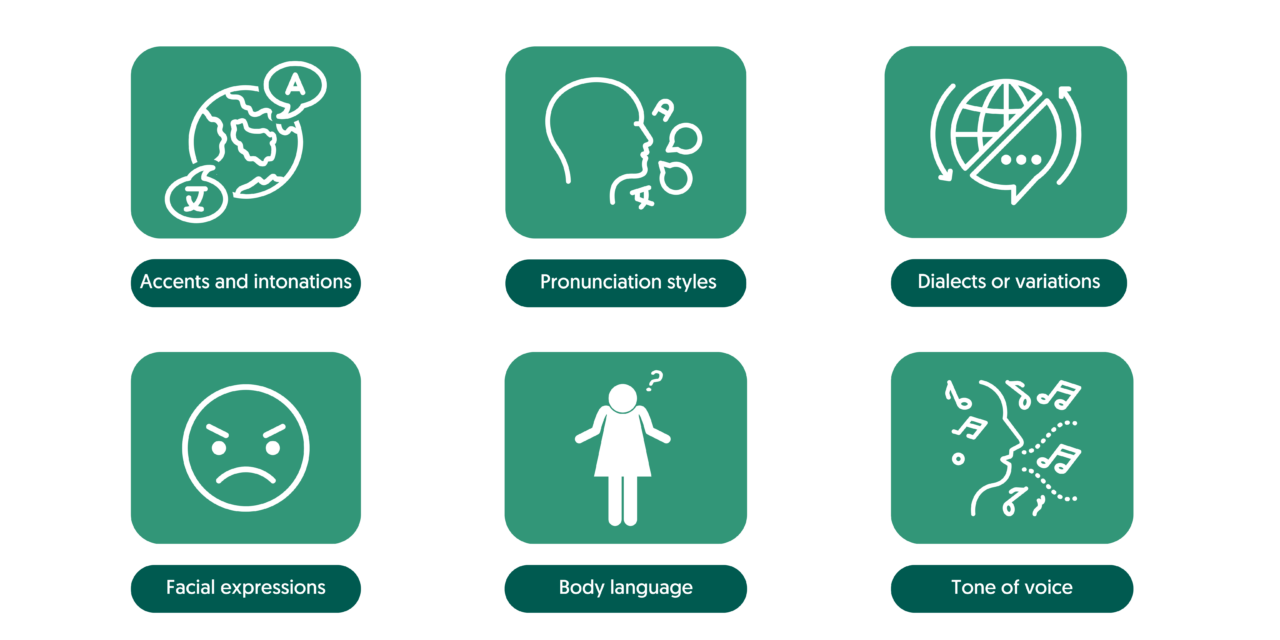
Incorporating these strategies into translator training enables students to hear a variety of pronunciation styles which can help them further refine their own speaking techniques. By developing an understanding of these elements, translators can more accurately convey meaning from one language to another. Finally, dubbing and subtitling also enable students to hear a variety of pronunciation styles, which can help them further refine their own techniques when speaking or writing in the target language. All in all, incorporating dubbing and subtitling into translator training programs offers numerous benefits for developing better translators.
Challenges Involved in Incorporating Dubbing and Subtitling into Translator Training Programs
While dubbing and subtitling offer many benefits to translator training programs, there are also some challenges to consider. For example, it can be difficult for students to understand the nuances of a language when relying only on dubbed or subtitled translations. Additionally, the accuracy of dubbing and subtitling is often dependent on the quality of the source material. Poorly written scripts or inaccurately translated subtitles can lead to confusion and frustration among students.

Furthermore, some languages may not have as many resources available for dubbing or subtitling as others, making it difficult for students to find materials that they can use in their translation practice. Finally, incorporating these strategies into translator training programs requires additional time and effort from instructors which could be seen as a challenge for some programs. Ultimately, while the incorporation of dubbing and subtitling into translator training can be beneficial, it is important to be aware of all of the potential challenges that may arise.
Incorporating Dubbing and Subtitling Into Translator Training Programs
In conclusion, incorporating dubbing and subtitling into translator training programs can provide numerous benefits such as helping students become more familiar with accents, dialects, body language, facial expressions and other visual cues that are often missed in written translations. However, there are also potential challenges that come with using these strategies such as understanding the nuances of a language, accuracy issues due to poor source material and additional time and resources needed for implementation.
Despite these possible hurdles, instructors can still leverage dubbing and subtitling to create engaging and effective learning experiences for their students. Ultimately, by taking all of this into consideration when selecting materials for translator training programs, instructors can ensure that their students receive the highest quality education experience.
Tips for Selecting Appropriate Materials for Dubbed or Subtitle-Based Translator Training
When selecting materials for dubbed or subtitle-based translator training it is important to keep certain tips in mind. First, look for materials that have professionally translated scripts and/or subtitles as this will ensure accuracy and reduce the potential for confusion. It is helpful to look for resources that contain a wide variety of accents or dialects in order to provide students with an opportunity to become familiar with different pronunciations. It is also important to make sure that the material being used is appropriate for all participants of the translator training program. Finally, consider using interactive tools like voice recognition software or translation races to make the learning process more engaging and enjoyable. By following these tips, instructors can help ensure their students receive a quality translator education experience.
Examples of Successful Dubbing and Subtitling Strategies for Translator Training
There have been many successful examples of using dubbing and subtitling in translator training programs. For instance, many universities use dubbed or subtitled films and television shows in their language classes to help students better understand regional accents and nuances within spoken language. Additionally, some programs have implemented interactive tools like voice recognition software to help students become comfortable with speaking the target language. This approach allows students to practice their own pronunciation and receive feedback on their accuracy in real-time.
Other successful strategies include using dubbing and subtitling to create original content for translator training programs such as “translation battles” or “translation races” where teams of students compete against each other to translate a text from one language into another. Ultimately, these examples demonstrate the potential for using dubbing and subtitling as effective tools for translator training.
How to Leverage Dubbing and Subtitling in Translator Training Programs
In conclusion, incorporating dubbing and subtitling into translator training programs can be an important tool for helping students better understand different accents and intonations as well as gain familiarity with body language, facial expressions and other visual cues. To successfully leverage these strategies during translator training sessions, instructors should look for professionally translated scripts or subtitles with different dialects that are appropriate for all participants.
Utilizing interactive tools such as speech-to-text software from Amberscript can help make the learning process more enjoyable and engaging for students. Ultimately, by properly using dubbing and subtitling in translator training programs, instructors can ensure that their students receive the highest quality education experience.
How transcription can help solve legal challenges
It’s no secret that legal transcription can be challenging. It requires accuracy, attention to detail, and a deep understanding of the nuances of the law. But for those willing to take on these difficult tasks, there are tremendous rewards. With legal transcription, you can create accurate documents quickly and efficiently while ensuring that all parties involved in a document have an accurate representation of the legal situation at hand. In this article, we’ll explore the challenges and opportunities associated with legal transcription as well as provide tips on how to tackle these obstacles head-on. We’ll also look at how companies are using legal transcription services to meet their unique needs and help streamline their operations. Let’s get started!
Table of contents
- Understanding legal challenges
- The role of transcriptions in legal proceedings
- Solving legal challenges with transcriptions
- Overcoming potential limitations and concerns
- Case studies and Success stories
Understanding legal challenges
Legal challenges permeate various aspects of society, encompassing a wide range of scenarios and circumstances. Individuals, businesses, and institutions often find themselves entangled in complex legal proceedings, requiring them to navigate a web of regulations, rights, and obligations. Such proceedings can be intricate, involving nuanced legal arguments, burdens of proof, and procedural requirements. Legal professionals rely on precise records to understand the facts, present arguments, and make informed decisions. Whether it is capturing witness testimonies, preserving courtroom dialogue, or documenting contractual terms, the quality of documentation significantly influences the outcome of legal cases.
Given the complexity of legal challenges, accurate and reliable documentation plays a pivotal role. Legal transcription involves more than merely transcribing a conversation verbatim. It requires understanding complex legal language and accurately transcribing it to create an accurate record. This can be difficult for those who are unfamiliar with the terminology, as the slightest mistake in transcription could have significant implications in a legal case.
It is also important to ensure that all transcripts meet court standards and rules of evidence. For example, certain documents may need to be presented with authentication or notarization for them to be accepted by a court. On top of this, there are often strict deadlines which must be met when filing legal documents, meaning that precise accuracy and quick turnaround times are paramount for successful legal transcription services.
In this context, transcription emerges as a powerful tool for addressing legal challenges. By converting spoken words into written text, transcription provides a means to capture, preserve, and analyze critical information. It enables legal professionals to refer back to precise accounts of verbal exchanges, ensuring accuracy and facilitating the resolution of disputes. In the following sections, we will explore the role of transcription in legal proceedings and delve into its potential benefits in overcoming legal challenges effectively.
How to choose: 5 Best Transcription Services for Attorneys and Law Firms
Discover the top 5 transcription services for attorneys and law firms. Streamline your workflow and enhance accuracy in legal documentation.
The role of transcriptions in legal proceedings
The role of transcription in legal proceedings is a crucial one. In most cases, transcription services are necessary to create an accurate and complete record of the court proceedings. These transcripts can then be used as evidence in court or for other types of legal challenges.
Transcriptionists must have a deep understanding of legal terminology and protocol in order to accurately transcribe testimony from court proceedings. They must also have knowledge of the rules governing document authentication and admissibility in order to ensure that their work meets all applicable requirements.
Transcriptions enable efficient record-keeping during court proceedings. Instead of relying solely on handwritten notes, legal professionals have access to a comprehensive text-based record, facilitating referencing and retrieval of information. This streamlined approach ensures that no crucial details are overlooked or forgotten. In addition to providing accurate records, transcription services can also help reduce costs related to trial preparation.
By providing timely transcripts, attorneys can save time and money by eliminating the need to transcribe lengthy court proceedings themselves. Furthermore, transcription services allow lawyers to review and prepare their cases more quickly, as they do not need to wait for a transcript of the proceedings in order to access key information. Having written transcripts means that lawyers can review testimonies, identify key points, and extract relevant information more efficiently. This aids in constructing stronger arguments, identifying inconsistencies, and ultimately contributing to the success of the legal case.
Types of legal transcriptions
-
Courtroom Transcription
Transcribing court proceedings helps create a comprehensive and accurate record of everything said in the courtroom. It assists in maintaining an official account of trials, hearings, and oral arguments, providing a reliable source for future reference.
-
Deposition Transcription
Depositions involve sworn testimonies taken outside the courtroom, typically in preparation for trial. Transcribing depositions enables attorneys to thoroughly analyze witness statements, identify key facts, and develop effective cross-examination strategies.
-
Hearing transcripts
Hearing transcripts are yet another type of courtroom transcript. They provide an accurate account of pre and post-trial hearings, which might include arraignments, bail hearings, plea bargain discussions, sentencing hearings, among others. These transcripts are key to capturing the procedural nuances that occur outside the main trial but significantly influence a case’s trajectory.
-
Legal Dictation Transcription
Lawyers often dictate legal documents, memos, or correspondence that require transcription. This allows them to communicate their thoughts, arguments, and instructions in a time-efficient manner, which can then be transformed into written text for further processing
Solving legal challenges with transcriptions
Transcription is a beneficial tool for attorneys, paralegals, legal administrators and other legal staff to help them overcome the obstacles that come with the day-to-day operations of a legal office. A transcription service can provide fast, accurate transcripts of courtroom proceedings, hearings, depositions or any other type of audio or video recordings. The speed and accuracy of these services allows lawyers to quickly review evidence and be better prepared for court cases. Additionally, transcribed documents can be used as reference material during trials or hearings.
Transcription ensures that court proceedings are accurately documented, capturing every word spoken during hearings, trials, and oral arguments. This verbatim record serves as a reliable reference, resolving disputes, clarifying statements, and ensuring that the facts are accurately represented. Legal professionals can rely on transcriptions to review testimonies, identify crucial details, and make informed decisions based on an accurate record of what transpired in the courtroom.
Transcription is also a great way to improve client relationships by providing transcripts of client meetings or phone conversations for review. This helps attorneys stay organized and ensure accuracy in legal documents. Furthermore, these services can provide document storage solutions so clients have an easy way to store important records securely.

Overcoming potential limitations and concerns
While legal transcription offers numerous benefits in addressing legal challenges, it also presents some challenges. To make sure the transcriptions are accurate, it is important that legal professionals who use transcription services understand any potential limitations of the technology and how these can be managed to ensure success.
Transcription accuracy
Legal documentation typically requires a high degree of accuracy in order to maintain its integrity. Most transcription services provide accuracy guarantees, but there may be occasions where errors creep in due to background noise or incorrect spelling. In such cases, it is important to review the document and make corrections as necessary. Implementing quality control measures, such as human proofreading or advanced speech recognition technology, can help enhance accuracy and minimize errors. Regular training and monitoring of transcriptionists can also contribute to maintaining high standards of precision.
Impact of Automated Transcription Tools
Transcription services are often used for urgent documents that require quick turnaround times. It is important to make sure the provider can meet your deadlines and provide reliable results. Automated transcription tools, powered by artificial intelligence, have become increasingly prevalent and, while they offer speed and convenience, their accuracy and reliability may vary. Legal professionals should then exercise caution when relying solely on automated transcription tools, as errors or misinterpretations can occur.
Privacy and Confidentiality Issues
Legal documents often contain sensitive or confidential information which should be protected to maintain privacy. To safeguard privacy and maintain confidentiality, it is important to check that the transcriptions service you use employs robust security measures to protect this data, such as encryption, two-factor authentication, and regular backups of data stored on their servers.

Get a customized offer
Request a quote for your transcription needs
By understanding these potential limitations and concerns when using a transcription service, legal professionals can be confident that their transcripts will be accurate and secure. Careful consideration of these factors also ensures that the end product meets all relevant legal requirements.
Case Studies and success stories
The application of transcription services in the legal field has yielded numerous success stories, showcasing the positive impact it can have on addressing legal challenges. Let’s explore a few compelling case studies that demonstrate how transcription has played a pivotal role in achieving favorable outcomes:
Resolving Disputes with Accurate Transcriptions
In a complex civil litigation case involving conflicting contractual interpretations, transcription services proved instrumental in resolving the dispute. The verbatim transcriptions of negotiation meetings, recorded telephone conversations, and email exchanges provided an accurate record of the parties’ communications. The clarity and precision of transcribed evidence facilitated an amicable resolution, ensuring both parties’ interests were respected and minimizing further legal proceedings.
Strengthening Litigation Strategy through Deposition Transcriptions
In a high-stakes personal injury lawsuit, transcription services proved invaluable during the deposition stage. Transcribing witness testimonies allowed the legal team to meticulously analyze statements, identify inconsistencies, and extract critical information. These transcriptions played a pivotal role in building a robust litigation strategy, enabling the attorneys to effectively challenge opposing witnesses, present compelling arguments, and ultimately secure a favorable settlement for their client.
Facilitating Legal Research and Precedent Identification
A team of legal researchers faced the daunting task of analyzing a vast body of case law to identify relevant precedents for a landmark constitutional challenge. Transcription services were employed to convert court judgments and oral arguments into text. This transformed the previously time-consuming and tedious research process into a more efficient one. The ability to search and extract specific references within the transcriptions accelerated the identification of pertinent precedents, contributing to a stronger legal argument and increasing the likelihood of success.



















